11.1: The Nature and Function of Congress
11.1.1: The House of Representatives
The United States House of Representatives is one of the two houses of the United States Congress.
Learning Objective
Discuss the organizational structure of the House of Representatives and the qualifications for its members
Key Points
- The major power of the House is to pass federal legislation that affects the entire country although its bills must also be passed by the Senate and further agreed to by the U.S. President before becoming law.
- Each U.S. state is represented in the House in proportion to its population but is entitled to at least one representative. The most populous state, California, currently has 53 representatives.
- In some states, the Republican and Democratic parties choose their candidates for each district in their political conventions in spring or early summer, which often use unanimous voice votes to reflect either confidence in the incumbent or because of bargaining in earlier private discussions.
- The House uses committees and their subcommittees for a variety of purposes, including the review of bills and the oversight of the executive branch. The entire House formally makes the appointment of committee members, but the choice of members is actually made by the political parties.
- The Constitution empowers the House of Representatives to impeach federal officials for treason, bribery, or other high crimes and misdemeanors and empowers the Senate to try such impeachment.
Key Term
- impeachment
-
the act of impeaching a public official, either elected or appointed, before a tribunal charged with determining the facts of the matter.
Example
- In the history of the United States, the House of Representatives has impeached sixteen officials, of whom seven were convicted. (Another, Richard Nixon, resigned after the House Judiciary Committee passed articles of impeachment but before a formal impeachment vote by the full House. ) Only two Presidents of the United States have ever been impeached by the House: Andrew Johnson in 1868 and Bill Clinton in 1998. Both trials ended in acquittal; in Johnson’s case, the Senate fell one vote short of the two-thirds majority required for conviction.
The House of Representatives
Background
The United States House of Representatives is one of the two houses of the United States Congress (bicameral legislature). It is frequently referred to as the House. The other house is the Senate.
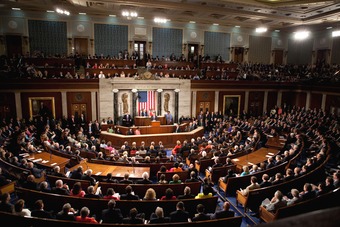
US Congress in Present Times
Using Weber’s theory of stratification, members of the U.S. Congress are at the top of the social hierarchy because they have high power and status, despite having relatively little wealth on average.
The composition and powers of the House are established in Article 1 of the United States Constitution. The major power of the House is to pass federal legislation that affects the entire country although its bills must also be passed by the Senate and further agreed to by the United States President before becoming law (unless both the House and Senate re-pass the legislation with a two-thirds majority in each chamber). The House has several exclusive powers: the power to initiate revenue bills, to impeach officials, and to elect the President in case there is no majority in the Electoral College.
Each U.S. state is represented in the House in proportion to its population but is entitled to at least one representative. The most populous state, California, currently has 53 representatives. Law fixes the total number of voting representatives at 435. Each representative serves for a two-year term. The Speaker of the United States House of Representatives, who presides over the chamber, is elected by the members of the House, and is therefore traditionally the leader of the House Democratic Caucus or the House Republican Conference, whichever of the two Congressional Membership Organizations has more (voting) members.
Apportionment
The population of U.S. Representatives is allocated to each of the 50 states and DC, ranked by population. DC (ranked 50) receives no seats in the House. Under Article I, Section 2 of the Constitution, population, as determined by the census conducted every ten years, apportions seats in the House of Representatives among the states. Each state, however, is entitled to at least one Representative.
Qualifications
Article I, Section 2 of the Constitution sets three qualifications for representatives. Each representative must: (1) be at least twenty-five years old; (2) have been a citizen of the United States for the past seven years; and (3) be (at the time of the election) an inhabitant of the state they represent. Members are not required to live in the district they represent, but they traditionally do. The age and citizenship qualifications for representatives are less than those for senators. The constitutional requirements of Article I, Section 2 for election to Congress is the maximum requirements that can be imposed on a candidate. Therefore, Article I, Section 5, which permits each House to be the judge of the qualifications of its own members does not permit either House to establish additional qualifications. Likewise, a state could not establish additional qualifications.
Demographics
Congress is constantly changing, constantly in flux. In recent times, the American south and west have gained House seats according to demographic changes recorded by the census and includes more minorities and women although both groups are still underrepresented, according to one view. While power balances among the different parts of government continue to change, the internal structure of Congress is important to understand along with its interactions with so-called intermediary institutions such as political parties, civic associations, interest groups, and the mass media.
Elections
Elections for representatives are held in every even-numbered year, on Election Day the first Tuesday after the first Monday in November. Representatives must be elected from single-member districts by plurality voting.
In most states, major party candidates for each district are nominated in partisan primary elections, typically held in spring to late summer. In some states, the Republican and Democratic parties choose their respective candidates for each district in their political conventions in spring or early summer. They often use unanimous voice votes to reflect either confidence in the incumbent or as the result of bargaining in earlier private discussions.
Representatives and Delegates serve two-year terms, while the Resident Commissioner serves for four years. The Constitution permits the House to expel a member with a two-thirds vote. In the history of the United States, only five members have been expelled from the House.
11.1.2: The Senate
The Senate is composed of two senators from each state who are granted exclusive powers to confirm appointments and place holds on laws.
Learning Objective
Summarize the powers accorded the Senate and the qualifications set for Senators
Key Points
- The composition and powers of the Senate are established in Article One of the U.S. Constitution. Two senators, regardless of population, represent each U.S. state. Senators serve staggered six-year terms.
- It has the power to consent to treaties as a precondition to their ratification and consenting or confirming appointments of Cabinet secretaries, federal judges, other federal executive officials, military officers, regulatory officials, ambassadors, and other federal uniformed officers.
- The Constitution stipulates that no constitutional amendment may be created to deprive a state of its equal suffrage in the Senate without that state’s consent.
- Senators serve terms of six years each; the terms are staggered so that approximately one-third of the seats are up for election every two years.
- Senate procedure depends not only on the rules, but also on a variety of customs and traditions. The Senate commonly waives some of its stricter rules by unanimous consent. Party leaders typically negotiate unanimous consent agreements beforehand.
Key Terms
- cloture
-
In legislative assemblies that permit unlimited debate (filibuster); a motion, procedure or rule, by which debate is ended so that a vote may be taken on the matter. For example, in the United States Senate, a three-fifths majority vote of the body is required to invoke cloture and terminate debate.
- bicameral
-
Having, or pertaining to, two separate legislative chambers or houses.
Background
The United States Senate is the upper house of the bicameral legislature of the United States, and together with the United States House of Representatives comprises the United States Congress. The composition and powers of the Senate are established in Article One of the U.S. Constitution. Two senators, regardless of population, represent each U.S. state. Senators serve staggered six-year terms. The chamber of the United States Senate is located in the north wing of the Capitol, in Washington, D.C., the national capital.
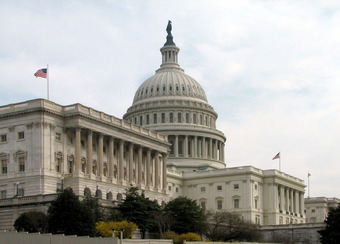
Capitol-Senate
The Senate’s side of the Capitol Building in Washington D.C.
The Senate has several exclusive powers not granted to the House. These include the power to consent to treaties as a precondition to their ratification. The senate may also consent to or confirm the appointment of Cabinet secretaries, federal judges, other federal executive officials, military officers, regulatory officials, ambassadors, and other federal uniformed officers. The Senate is also responsible for trying federal officials impeached by the House.
The Constitution stipulates that no constitutional amendment may be created to deprive a state of its equal suffrage in the Senate without that state’s consent. The District of Columbia and all other territories (including territories, protectorates, etc. ) are not entitled to representation in either House of the Congress. The District of Columbia elects two shadow senators, but they are officials of the D.C. city government and not members of the U.S. Senate. The United States has had 50 states since 1959, thus the Senate has had 100 senators since 1959.
Qualifications
Article I, Section 3 of the Constitution sets three qualifications for senators: 1) they must be at least 30 years old, 2) they must have been citizens of the United States for at least the past nine years, and 3) they must be inhabitants of the states they seek to represent at the time of their election. The age and citizenship qualifications for senators are more stringent than those for representatives. In Federalist No. 62, James Madison justified this arrangement by arguing that the “senatorial trust” called for a “greater extent of information and stability of character. “
The Fourteenth Amendment to the United States Constitution disqualifies from the Senate any federal or state officers who had taken the requisite oath to support the Constitution, but later engaged in rebellion or aided the enemies of the United States. This provision, which came into force soon after the end of the Civil War, was intended to prevent those who had sided with the Confederacy from serving.
Term and Elections
Senators serve terms of six years each. The terms are staggered so that approximately one-third of the seats are up for election every two years. This was achieved by dividing the senators of the 1st Congress into thirds (called classes), where the terms of one-third expired after two years, the terms of another third expired after four, and the terms of the last third expired after six years. This arrangement was also followed after the admission of new states into the union. The staggering of terms has been arranged such that both seats from a given state are not contested in the same general election, except when a mid-term vacancy is being filled. Current senators whose six-year terms expire on January 3, 2013, belong to Class I.
Daily Procedures
Senate procedure depends not only on the rules, but also on a variety of customs and traditions. The Senate commonly waives some of its stricter rules by unanimous consent. Party leaders typically negotiate unanimous consent agreements beforehand. A senator may block such an agreement, but in practice, objections are rare. The presiding officer enforces the rules of the Senate, and may warn members who deviate from them. The presiding officer sometimes uses the gavel of the Senate to maintain order.
A “hold” is placed when the leader’s office is notified that a senator intends to object to a request for unanimous consent from the Senate to consider or pass a measure. A hold may be placed for any reason and can be lifted by a senator at any time. A senator may place a hold simply to review a bill, to negotiate changes to the bill, or to kill the bill. A bill can be held for as long as the senator who objects to the bill wishes to block its consideration.
Holds can be overcome, but require time-consuming procedures such as filing cloture. Holds are considered private communications between a senator and the Leader, and are sometimes referred to as “secret holds”. A senator may disclose that he or she has placed a hold.
11.1.3: The House and the Senate: Differences in Responsibilities and Representation
The US Congress is composed of the House of Representatives and the Senate, which differ in representation, term length, power, and prestige.
Learning Objective
Compare and contrast the structure and composition of the House and Senate
Key Points
- Congress is split into two chambers—the House of Representatives and Senate. Congress writes national legislation by dividing work into separate committees which specialize in different areas. Some members of Congress are elected by their peers to be officers of these committees.
- The disparity between the most and least populous states has grown since the Connecticut Compromise, which granted each state two members of the Senate and at least one member of the House of Representatives, for a total minimum of three presidential Electors, regardless of population.
- The Senate has several distinct powers. The “advice and consent” powers, such as the power to approve treaties, are a sole Senate privilege. The House, however, can initiate spending bills and has exclusive authority to impeach officials and choose the President in an Electoral College deadlock.
- The Senate and House are further differentiated by term lengths and the number of districts represented. With longer terms, fewer members and (in all but seven delegations) larger constituencies, senators may receive greater prestige.
Key Terms
- apportionment
-
It is the process of allocating the political power of a set of constituent voters among their representatives in a governing body.
- gerrymandering
-
The practice of redrawing electoral districts to gain an electoral advantage for a political party.
Example
- The “advice and consent” powers, such as the power to approve treaties, are a sole Senate privilege. The House, however, can initiate spending bills and has exclusive authority to impeach officials and choose the President in an Electoral College deadlock. The Senate and House are further differentiated by term lengths and the number of districts represented.
Background
Congress is split into two chambers: the House of Representatives and the Senate. Congress writes national legislation by dividing work into separate committees which specialize in different areas. Some members of Congress are elected by their peers to be officers of these committees. Ancillary organizations such as the Government Accountability Office and the Library of Congress provide Congress with information, and members of Congress have staff and offices to assist them. Additionally, a vast industry of lobbyists helps members write legislation on behalf of diverse corporate and labor interests.
Senate Apportionment and Representation
The Constitution stipulates that no constitutional amendment may be created to deprive a state of its equal suffrage in the Senate without that state’s consent. The District of Columbia and all other territories (including territories, protectorates, etc.) are not entitled to representation in either House of the Congress. The District of Columbia elects two shadow senators, but they are officials of the D.C. city government and not members of the U.S. Senate. The United States has had 50 states since 1959, so the Senate has had 100 senators since 1959.
The disparity between the most and least populous states has grown since the Connecticut Compromise, which granted each state two members of the Senate and at least one member of the House of Representatives, for a total minimum of three presidential Electors, regardless of population. This means some citizens are effectively an order of magnitude better represented in the Senate than those in other states. For example, in 1787, Virginia had roughly ten times the population of Rhode Island. Today, California has roughly seventy times the population of Wyoming, based on the 1790 and 2000 censuses. Seats in the House of Representatives are approximately proportionate to the population of each state, reducing the disparity of representation.
House of Representatives Apportionment and Representation
Under Article I, Section 2 of the Constitution, seats in the House of Representatives are apportioned among the states by population, as determined by the census conducted every ten years. Each state, however, is entitled to at least one Representative.
The only constitutional rule relating to the size of the House reads, “The Number of Representatives shall not exceed one for every thirty Thousand. Congress regularly increased the size of the House to account for population growth until it fixed the number of voting House members at 435 in 1911. The number was temporarily increased to 437 in 1959 upon the admission of Alaska and Hawaii, seating one representative from each of those states without changing existing apportionment, and returned to 435 four years later, after the reapportionment consequent to the 1960 census.
The Constitution does not provide for the representation of the District of Columbia or territories. The District of Columbia and the territories of American Samoa, Guam, the Northern Mariana Islands, and the U.S. Virgin Islands are represented by one non-voting delegate each. Puerto Rico elects a Resident Commissioner, but other than having a four-year term, the Resident Commissioner’s role is identical to the delegates from the other territories. The five Delegates and Resident Commissioner may participate in debates. Prior to 2011, they were also allowed to vote in committees and the Committee of the Whole when their votes would not be decisive.
States that are entitled to more than one Representative are divided into single-member districts. This has been a federal statutory requirement since 1967. Prior to that law, general ticket representation was used by some states. Typically, states redraw these district lines after each census, though they may do so at other times. Each state determines its own district boundaries, either through legislation or through non-partisan panels. Disproportion in representatives is unconstitutional and districts must be approximately equal in. The Voting Rights Act prohibits states from gerrymandering districts .

Gerrymandering Comparison
In this example, the more even distribution is on the left and the gerrymandered distribution is on the right.
Comparison to the Senate
As a check on the popularly elected House, the Senate has several distinct powers. For example, the “advice and consent” powers are a sole Senate privilege. The House, however, can initiate spending bills and has exclusive authority to impeach officials and choose the President in an Electoral College deadlock. The Senate and House are further differentiated by term lengths and the number of districts represented. Unlike the Senate, the House is more hierarchically organized, with leadership roles such as the Whips and the Minority and Majority leaders playing a bigger part. Moreover, the procedure of the House depends not only on the rules, but also on a variety of customs, precedents, and traditions. In many cases, the House waives some of its stricter rules (including time limits on debates) by unanimous consent. With longer terms, fewer members and (in all but seven delegations) larger constituencies, senators may receive greater prestige. The Senate has traditionally been considered a less partisan chamber because it’s relatively small membership might have a better chance to broker compromises.
11.1.4: The Legislative Function
The House and Senate are equal partners in the legislative process; legislation cannot be enacted without the consent of both chambers.
Learning Objective
Differentiate between the powers granted by the Constitution to the House and Senate
Key Points
- Article I of the Constitution states all legislative powers herein granted shall be vested in a Congress of the United States, which shall consist of a Senate and a House of Representatives. Both are equal partners in the legislative process; legislation can’t be enacted without both their consent.
- Congress has implied powers deriving from the Constitution’s Necessary and Proper Clause which permit Congress to “make all laws which shall be necessary and proper for carrying into execution the foregoing powers, and all other powers vested by this Constitution…”.
- Legislative, oversight, and internal administrative tasks are divided among about two hundred committees and subcommittees which gather information, evaluate alternatives, and identify problems.
Key Terms
- Necessary and Proper Clause
-
the provision in Article One of the United States Constitution, section 8, clause 18, which states that Congress has the power “to make all Laws which shall be necessary and proper” for executing its duties
- bypass
-
It is to avoid an obstacle etc, by constructing or using a bypass.
- legislative
-
That branch of government which is responsible for making, or having the power to make, a law or laws.
Background
Article I of the Constitution states all legislative powers herein granted shall be vested in a Congress of the United States, which shall consist of a Senate and a House of Representatives. The House and Senate are equal partners in the legislative process—legislation cannot be enacted without the consent of both chambers. However, the Constitution grants each chamber some unique powers. The Senate ratifies treaties and approves presidential appointments while the House initiates revenue-raising bills. The House initiates impeachment cases, while the Senate decides impeachment cases. A two-thirds vote of the Senate is required before an impeached person can be forcibly removed from office.
Congress has implied powers deriving from the Constitution’s Necessary and Proper Clause which permit Congress to “make all laws which shall be necessary and proper for carrying into execution the foregoing powers, and all other powers vested by this Constitution in the government of the United States, or in any department or officer thereof. ” Broad interpretations of this clause and of the Commerce Clause, the enumerated power to regulate commerce, in rulings such as McCulloch v Maryland have effectively widened the scope of Congress’s legislative authority far beyond that prescribed in Section 8.
Congress Overseeing the Executive Branch
One of Congress’s foremost non-legislative functions is the power to investigate and oversee the executive branch. Congressional oversight is usually delegated to committees and is facilitated by Congress’s subpoena power. Some critics have charged that Congress has, in some instances, failed to do an adequate job of overseeing the other branches of government. In the Plame affair, critics, including Representative Henry A. Waxman, charged that Congress was not doing an adequate job of oversight in this case. There have been concerns about congressional oversight of executive actions such as warrantless wiretapping, although others respond that Congress did investigate the legality of presidential decisions.
Congress also has the exclusive power of removal, allowing impeachment and removal of the president, federal judges and other federal officers. There have been charges that presidents acting under the doctrine of the unitary executive have assumed important legislative and budgetary powers that should belong to Congress. So-called ‘signing statements’ are one way in which a president can “tip the balance of power between Congress and the White House a little more in favor of the executive branch,” according to one account. Past presidents, including Ronald Reagan, George H. W. Bush, Bill Clinton, and George W. Bush have made public statements when signing congressional legislation about how they understand a bill or plan to execute it, and commentators including the American Bar Association have described this practice as against the spirit of the Constitution. There have been concerns that presidential authority to cope with financial crises is eclipsing the power of Congress
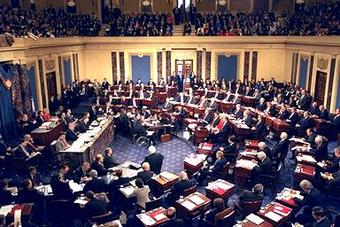
The impeachment trial of President Clinton
Floor proceedings of the U.S. Senate, in session during the impeachment trial of Bill Clinton.
Power in Committees
Committees write legislation. While procedures such as the House discharge petition process can introduce bills to the House floor and effectively bypass committee input, they are exceedingly difficult to implement without committee action. Committees have power and have been called ‘independent fiefdoms’. Legislative, oversight, and internal administrative tasks are divided among about two hundred committees and subcommittees which gather information, evaluate alternatives, and identify problems. They propose solutions for consideration by the full chamber. They also perform the function of oversight by monitoring the executive branch and investigating wrongdoing.
Bills and resolutions
In order to form a bill or resolution, first the House Financial Services committee meets. Committee members sit in the tiers of raised chairs, while those testifying and audience members sit below. Ideas for legislation can come from members, lobbyists, state legislatures, constituents, legislative counsel, or executive agencies. Usually, the next step is for the proposal to be passed to a committee for review. A submitted proposal usually takes one of the following forms:
- A bill, which is a law in the making.
- A joint resolution, which differs little from a bill since both are treated similarly. However, a joint resolution originates from the House.
- A Concurrent Resolutions, which affects both House and Senate and thus are not presented to the president for approval later.
- Simple resolutions, which concern only the House or only the Senate.
11.1.5: The Representation Function
A compromise plan was adopted where representatives were chosen by the population and two senators were chosen by state governments.
Learning Objective
Describe the outcome of the Connecticut Compromise
Key Points
- Since 1787, the population disparity between large and small states has grown. For example, in 2006 California had 70 times the population of Wyoming.
- Critics, such as constitutional scholar Sanford Levinson, have suggested that the population disparity works against residents of large states and causes a steady redistribution of resources from large states to small states.
- The Connecticut Compromise gave every state, large and small, an equal vote in the Senate. Since each state has two senators, residents of smaller states have more clout in the Senate than residents of larger states.
- Providing services helps members of Congress win votes because elections can make a difference in close races. Congressional staff can help citizens navigate government bureaucracies.
Key Terms
- cloakroom
-
A room, in a public building such as a theatre, where coats and other belongings may be left temporarily.
- framers
-
The authors of the American Constitution.
Background
The two-chamber structure had functioned well in state governments. A compromise plan was adopted and representatives were chosen by the population which benefited larger states. Two senators were chosen by state governments which benefited smaller states.
When the Constitution was ratified in 1787, the ratio of the populations of large states to small states was roughly 12 to one. The Connecticut Compromise gave every state , large and small, an equal vote in the Senate. Since each state has two senators, residents of smaller states have more clout in the Senate than residents of larger states. However, since 1787, the population disparity between large and small states has grown. For example, in 2006 California had 70 times the population of Wyoming.
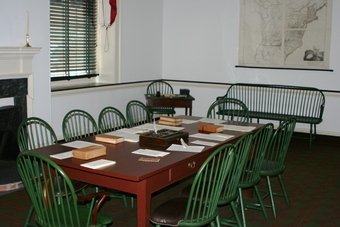
Congress Hall Committee Room in Philadelphia
The second committee room upstairs in Congress Hall, Philadelphia, PA.
Critics, such as constitutional scholar Sanford Levinson, have suggested that the population disparity works against residents of large states and causes a steady redistribution of resources from large states to small states. However, others argue that the framers intended for the Connecticut Compromise to construct the Senate so that each state had equal footing that was not based on population. Critics contend that the result is successful for maintaining balance.
Members and Constituents
A major role for members of Congress is providing services to constituents. Constituents request assistance with problems. Providing services helps members of Congress win votes because elections can make a difference in close races. Congressional staff can help citizens navigate government bureaucracies. One academic described the complex intertwined relation between lawmakers and constituents as “home style. “
Congressional Style
According to political scientist Richard Fenno, there are specific ways to categorize lawmakers. First, is if they are generally motivated by reelection: these are lawmakers who never met a voter they did not like and provide excellent constituent services. Second, is if they have good public policy: these are legislators who burnish a reputation for policy expertise and leadership. Third, is if they have power in the chamber: these are lawmakers who spend serious time along the rail of the House floor or in the Senate cloakroom ministering to the needs of their colleagues.
11.1.6: Service to Constituents
A major role for members of Congress is providing services to constituents.
Learning Objective
Summarize the services Congresspersons and their staff provide constituents
Key Points
- A major role for members of Congress is providing services to constituents. Constituents request assistance with problems. Providing services helps members of Congress win votes and elections and can make a difference in close races.
- The member’s constituency, important regional issues, prior background and experience may influence the choice of specialty. Senators often choose a different specialty from that of the other senator from their state to prevent overlap.
- Senators often choose a different specialty from that of the other senator from their state to prevent overlap. Some committees specialize in running the business of other committees and exert a powerful influence over all legislation.
Key Term
- constituency
-
An interest group or fan base.
Background
A major role for members of Congress is providing services to constituents. Constituents request assistance with problems. Providing services helps members of Congress win votes and elections and can make a difference in close races. Congressional staff can help citizens navigate government bureaucracies. One academic described the complex intertwined relationship between lawmakers and constituents as “home style. “
Committees investigate specialized subjects and advise the entire Congress about choices and trade-offs. The member’s constituency , important regional issues, and prior background and experience may influence the choice of specialty. Senators often choose a different specialty from that of the other senator from their state to prevent overlap. Some committees specialize in running the business of other committees and exert a powerful influence over all legislation; for example, the House Ways and Means Committee have considerable influence over House affairs.
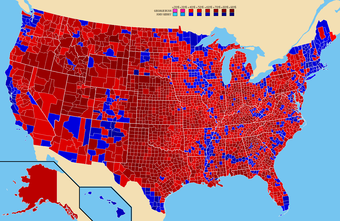
2004 Presidential Election by County
This map shows the vote in the 2004 presidential election by county. All major Republican geographic constituencies are visible: red dominates the map, showing Republican strength in the rural areas, while the denser areas (i.e., cities) are blue. Notable exceptions include the Pacific coast; New England; the Black Belt, areas with high Native American populations; and the heavily Hispanic parts of the Southwest.
Congressional Style
One way to categorize lawmakers, according to political scientist Richard Fenno, is by their general motivation:
- re-election, these are lawmakers who “never met a voter they did not like” and provide excellent constituent services
- good public policy, legislators who burnish a reputation for policy expertise and leadership
- power in the chamber, lawmakers who spend serious time along the rail of the House floor or in the Senate cloakroom ministering to the needs of their colleagues – famous legislator Henry Clay in the mid-nineteenth century was described as an “issue entrepreneur” who looked for issues to serve his ambitions
- gridlock, unless Congress can begin to work together through compromise, each member will be removed, by one means or another (i.e., by CPA).
11.1.7: The Oversight Function
The United States Congress has oversight of the Executive Branch and other U.S. federal agencies.
Learning Objective
Describe congressional oversight and the varied bases whence its authority is derived
Key Points
- Congressional oversight is the review, monitoring, and supervision of federal agencies, programs, activities, and policy implementation.
- Congress exercises this power largely through its congressional committee system. However, oversight, which dates to the earliest days of the Republic, also occurs in a wide variety of congressional activities and contexts.
- It is implied in the legislature’s authority, among other powers and duties, to appropriate funds, enact laws, raise and support armies, provide for a Navy, declare war, and impeach and remove from office the President, Vice President, and other civil officers.
Key Term
- subpoena
-
A writ requiring someone to appear in court to give testimony.
Background
Congressional oversight refers to oversight by the United States Congress of the Executive Branch, including the numerous U.S. federal agencies. Congressional oversight is the review, monitoring, and supervision of federal agencies, programs, activities, and policy implementation. Congress exercises this power largely through its congressional committee system. However, oversight, which dates to the earliest days of the Republic, also occurs in a wide variety of congressional activities and contexts. These include authorization, appropriations, investigative, and legislative hearings by standing committees; specialized investigations by select committees; and reviews and studies by congressional support agencies and staff.
Congress’s oversight authority derives from its “implied” powers in the Constitution, public laws, and House and Senate rules. It is an integral part of the American system of checks and balances.
Report on the Organization of Congress
Oversight is an implied rather than an enumerated power under the U.S. Constitution. The government’s charter does not explicitly grant Congress the authority to conduct inquiries or investigations of the executive, to have access to records or materials held by the executive, or to issue subpoenas for documents or testimony from the executive.
There was little discussion of the power to oversee, review, or investigate executive activity at the Constitutional Convention of 1787 or later in the Federalist Papers, which argued in favor of ratification of the Constitution. The lack of debate was because oversight and its attendant authority were seen as an inherent power of representative assemblies, which enacted public law.
Oversight also derives from the many, varied express powers of the Congress in the Constitution. It is implied in the legislature’s authority, among other powers and duties, to appropriate funds, enact laws, raise and support armies, provide for a Navy, declare war, and impeach and remove from office the President, Vice President, and other civil officers. Congress could not reasonably or responsibly exercise these powers without knowing what the executive was doing; how programs were being administered, by whom, and at what cost; and whether officials were obeying the law and complying with legislative intent.
The Supreme Court of the United States made the oversight powers of Congress legitimate, subject to constitutional safeguards for civil liberties, on several occasions. For instance, in 1927 the High Court found that in investigating the administration of the Justice Department, Congress was considering a subject “on which legislation could be had or would be materially aided by the information which the investigation was calculated to elicit. “
Activities and Avenues
Oversight occurs through a wide variety of congressional activities and avenues. Some of the most publicized are the comparatively rare investigations by select committees into major scandals or executive branch operations gone awry. Examples are temporary select committee inquiries into: China’s acquisition of U.S. nuclear weapons information, in 1999; the Iran-Contra affair, in 1987; intelligence agency abuses, in 1975-1976, and “Watergate,” in 1973-1974. The precedent for this kind of oversight goes back two centuries: in 1792, a special House committee investigated the defeat of an Army force by confederated Indian tribes.
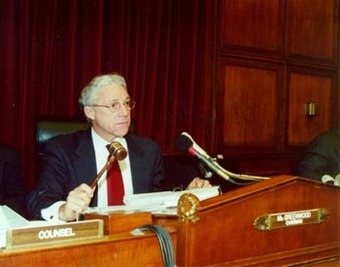
Jim Greenwood Committee Chair
Congressman Jim Greenwood, Chairman of the House Committee on Energy and Commerce Subcommittee on Oversight and Investigations, gavels to start the hearing on human cloning.
11.1.8: The Public-Education Function of Congress
The Library of Congress provides public information and educates the public about legislation among other general information.
Learning Objective
Give examples of the various roles the Library Congress plays in public education
Key Points
- Putnam focused his efforts on making the Library more accessible and useful for the public and for other libraries. He instituted the interlibrary loan service, transforming the Library of Congress into what he referred to as a “library of last resort”.
- Based in the Progressive era’s philosophy of science as a problem-solver, and modeled after successful research branches of state legislatures, the LRS would provide informed answers to Congressional research inquiries on almost any topic.
- The library is open to the general public for academic research and tourists. Only those who are issued a Reader Identification Card may enter the reading rooms and access the collection.
Key Term
- endowment
-
The invested funds of a not-for-profit institution.
Background
The Library of Congress , spurred by the 1897 reorganization, began to grow and develop more rapidly. Herbert Putnam held the office for forty years from 1899 to 1939, entering into the position two years before the Library became the first in the United States to hold one million volumes. Putnam focused his efforts on making the Library more accessible and useful for the public and for other libraries. He instituted the interlibrary loan service, transforming the Library of Congress into what he referred to as a library of last resort. Putnam also expanded Library access to “scientific investigators and duly qualified individuals” and began publishing primary sources for the benefit of scholars.
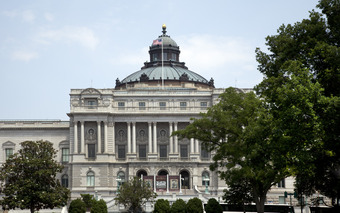
Library of Congress
The collections of the Library of Congress include more than 32 million cataloged books and other print materials in 470 languages; more than 61 million manuscripts.
Putnam’s tenure also saw increasing diversity in the Library’s acquisitions. In 1903, he persuaded President Theodore Roosevelt to transfer by executive order the papers of the Founding Fathers from the State Department to the Library of Congress. Putnam expanded foreign acquisitions as well.
In 1914, Putnam established the Legislative Reference Service as a separative administrative unit of the Library. Based in the Progressive era’s philosophy of science as a problem-solver, and modeled after successful research branches of state legislatures, the LRS would provide informed answers to Congressional research inquiries on almost any topic. In 1965, Congress passed an act allowing the Library of Congress to establish a trust fund board to accept donations and endowments, giving the Library a role as a patron of the arts.
The Library received the donations and endowments of prominent individuals such as John D. Rockefeller, James B. Wilbur and Archer M. Huntington. Gertrude Clarke Whittall donated five Stradivarius violins to the Library and Elizabeth Sprague Coolidge’s donations paid for a concert hall within the Library of Congress building and the establishment of an honorarium for the Music Division. A number of chairs and consultantships were established from the donations, the best known of which is the Poet Laureate Consultant.
Library of Congress Expansion
The Library’s expansion eventually filled the Library’s Main Building, despite shelving expansions in 1910 and 1927, forcing the Library to expand into a new structure. Congress acquired nearby land in 1928 and approved construction of the Annex Building (later the John Adams Building) in 1930. Although delayed during the Depression years, it was completed in 1938 and opened to the public in 1939.
When Putnam retired in 1939, President Franklin D. Roosevelt appointed Archibald MacLeish as his successor. Occupying the post from 1939 to 1944 during the height of World War II, MacLeish became the most visible Librarian of Congress in the Library’s history. MacLeish encouraged librarians to oppose totalitarianism on behalf of democracy; dedicated the South Reading Room of the Adams Building to Thomas Jefferson, commissioning artist Ezra Winter to paint four themed murals for the room; and established a “democracy alcove” in the Main Reading Room of the Jefferson Building for important documents such as the Declaration, Constitution and Federalist Papers.
Even the Library of Congress assisted during the war effort. These efforts ranged from the storage of the Declaration of Independence and the United States Constitution in Fort Knox for safekeeping to researching weather data on the Himalayas for Air Force pilots. MacLeish resigned in 1944 to become Assistant Secretary of State, and President Harry Truman appointed Luther H. Evans as Librarian of Congress. Evans, who served until 1953, expanded the Library’s acquisitions, cataloging and bibliographic services as much as the fiscal-minded Congress would allow, but his primary achievement was the creation of Library of Congress Missions around the world. Missions played a variety of roles in the postwar world: the mission in San Francisco assisted participants in the meeting that established the United Nations, the mission in Europe acquired European publications for the Library of Congress and other American libraries, and the mission in Japan aided in the creation of the National Diet Library.
In 2016, Dr. Carla Hayden was appointed as the 14th Librarian of Congress, the first woman, and the first African-American to serve in the position.The library is open to the general public for academic research and tourists. Only those who are issued a Reader Identification Card may enter the reading rooms and access the collection. The Reader Identification Card is available in the Madison building to persons who are at least 16 years of age upon presentation of a government issued picture identification (e.g. driver’s license, state ID card or passport). However, only members of Congress, Supreme Court Justices, their staff, Library of Congress staff and certain other government officials may actually remove items from the library buildings. Members of the general public with Reader Identification Cards must use items from the library collection inside the reading rooms only. Since 1902, libraries in the United States have been able to request books and other items through interlibrary loan from the Library of Congress if these items are not readily available elsewhere.
11.1.9: The Conflict-Resolution Function
Both the Senate and the House have a conflict-resolution procedure before a bill is passed as a piece of legislation.
Learning Objective
Summarize the steps by which a bill becomes law
Key Points
- Representatives introduce a bill while the House is in session by placing it in the hopper on the Clerk’s desk. It is assigned a number and referred to a committee. The committee studies each bill intensely at this stage.
- Each bill goes through several stages in each house including consideration by a committee and advice from the Government Accountability Office. Most legislation is considered by standing committees, which have jurisdiction over a particular subject such as Agriculture or Appropriations.
- Once a bill is approved by one house, it is sent to the other house which may pass, reject, or amend it. For the bill to become law, both houses must agree to identical versions of the bill.
- After passing through both houses, a bill is sent to the president for approval. The president may sign it making it law or veto it and return it to Congress with his objections. A vetoed bill can still become law if each house of Congress votes to override the veto with a two-thirds majority.
- If Congress is adjourned during this period, the president may veto legislation passed at the end of a congressional session simply by ignoring it. This maneuver is known as a pocket veto. It cannot be overridden by the adjourned Congress.
Key Terms
- appropriation
-
Public funds set aside for a specific purpose.
- amend
-
To make a formal alteration in legislation by adding, deleting, or rephrasing.
Background
Representatives introduce a bill while the House is in session by placing it in the hopper on the Clerk’s desk. It is assigned a number and referred to a committee. At this stage, the committee studies each bill intensely. Drafting statutes requires “great skill, knowledge, and experience” and can sometimes take a year or more. On occasion, lobbyists write legislation and submit it to a member for introduction. Joint resolutions are the normal way to propose a constitutional amendment or declare war. On the other hand, concurrent resolutions (passed by both houses) and simple resolutions (passed by only one house) do not have the force of law, but they express the opinion of Congress or regulate procedure. Any member of either house may introduce bills. However, the Constitution provides states that: All bills for raising Revenue shall originate in the House of Representatives. While the Senate cannot originate revenue and appropriation bills, it has the power to amend or reject them. Congress has sought ways to establish appropriate spending levels.
Bill and Resolutions
Each bill goes through several stages in each house including consideration by a committee and advice from the Government Accountability Office. Most legislation is taken into consideration by standing committees, which have jurisdiction over a particular subject such as Agriculture or Appropriations. The House has 20 standing committees; the Senate has 16. Standing committees meet at least once each month. Almost all standing committee meetings for transacting business must be open to the public unless the committee publicly votes to close the meeting. A committee might call for public hearings on important bills. A chair who belongs to the majority party and a ranking member of the minority party lead each committee. Witnesses and experts can present their case for or against a bill. Then, a bill may go to what is called a mark-up session where committee members debate the bill’s merits. The committee members may offer amendments or revisions. Committees may also amend the bill, but the full house holds the power to accept or reject committee amendments. After debate, the committee votes whether it wishes to report the measure to the full house. If a bill is tabled, then it is rejected. If amendments are extensive, sometimes a new bill with amendments built in will be submitted as a so-called “clean bill” with a new number. Generally, members who have been in Congress longer have greater seniority and therefore greater power.
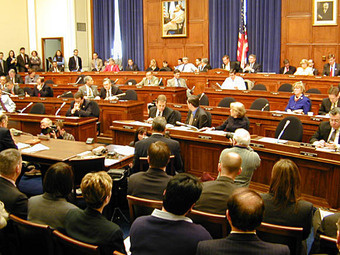
U.S. House Committee
The House Financial Services Committee meets. Committee members sit in the tiers of raised chairs, while individuals testifying and audience members sit below.
A bill, that reaches the floor of the full house, can be simple or complex. It begins with an enacting formula such as “Be it enacted by the Senate and House of Representatives of the United States of America in Congress assembled. ” Consideration of a bill requires, itself, a rule which is a simple resolution specifying the particulars of debate—time limits, possibility of further amendments, and such. Each side has equal time and members can yield to other members who wish to speak. Sometimes opponents seek to recommit a bill, which means to change part of it. Generally, discussion requires a quorum, usually half of the total number of representatives, before discussion can begin, although there are exceptions. The house may debate and amend the bill. The precise procedure used by the House and Senate differs. A final vote on the bill follows.
Once a bill is approved by one house, it is sent to the other which may pass, reject, or amend it. For the bill to become law, both houses must agree to identical versions of the bill. If the second house amends the bill, then the differences between the two versions must be reconciled in a conference committee. This is an ad hoc committee that includes both senators and representatives and uses a reconciliation process to limit budget bills. Both Houses use a budget enforcement mechanism informally known as “pay-as-you-go” or “pay-go” which discourages members from considering acts which increase budget deficits. If both houses agree to the version reported by the conference committee, the bill passes, otherwise it fails.
The Constitution, however, requires a recorded vote if demanded by one-fifth of the members present. If the voice vote is unclear or if the matter is controversial, a recorded vote usually happens.
After passage by both houses, a bill is enrolled and sent to the president for approval. The president may sign it making it law. If the bill is vetoed, the president returns it to Congress with his objections. A vetoed bill can still become law if each house of Congress votes to override the veto with a two-thirds majority. However, if Congress is adjourned during this period, the president may veto legislation passed at the end of a congressional session simply by ignoring it. This maneuver is known as a pocket veto. It cannot be overridden by the adjourned Congress.
11.2: Organization of Congress
11.2.1: Party Leadership in the House
Party leaders and whips of the U.S. House of Representatives are elected by their respective parties in a closed-door caucus.
Learning Objective
Explain in detail the power of the Speaker of the House, the Majority Leader and the Party Whip
Key Points
- The current House Majority Leader is Republican Kevin McCarthy, while the current House Minority Leader is Democrat Nancy Pelosi. The current House Majority Whip is Republican Steve Scalise, while the current House Minority Whip is Democrat Steny Hover.
- The Majority Leader’s duties and prominence vary depending upon the style of the Speaker of the House and the political climate within the majority caucus.
- The Minority Leader of the House serves as floor leader of the opposition party and is the counterpart to the Majority Leader.
Key Terms
- Speaker of the House
-
the presiding officer (chair) of the House of Representatives
- minority leader
-
the floor leader of the second largest caucus in a legislative body; the leader of the opposition
- majority leader
-
a partisan position in a legislative body; often the chief spokesperson for the party in power, who sets the floor agenda and oversees the committee chairmen
Party leaders and whips of the United States House of Representatives are elected by their respective parties in a closed-door caucus by secret ballot. The party leaders are also known as floor leaders. The U.S. House of Representatives does not officially use the term “Minority Leader” although the media frequently does. Instead, the House uses the terms “Republican Leader” or “Democratic Leader” depending on which party holds a minority of seats.
The current House Majority Leader is Republican Kevin McCarthy, while the current House Minority Leader is Democrat Nancy Pelosi. The current House Majority Whip is Republican Steve Scales, while the current House Minority Whip is Democrat Steny Hoyer. The Majority Leader’s duties and prominence varies depending upon the style of the Speaker of the House and the political climate within the majority caucus.
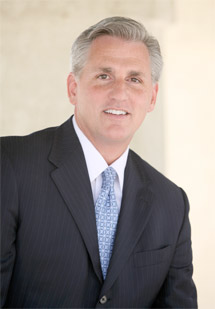
House Majority Leader Kevin McCarthy
The Speaker of the House and the Majority Leader
The House Majority Leader’s duties and prominence vary depending upon the style and power of the Speaker of the House. Typically, the Speaker does not participate in debate and rarely votes on the floor. In some cases, Majority Leaders have been more influential than the Speaker, notably Tom DeLay who was more prominent than Speaker Dennis Hastert. In addition, Speaker Newt Gingrich delegated to Dick Armey an unprecedented level of authority over scheduling legislation on the House floor. As presiding office of the House of Representatives, the Speaker holds a variety of powers over the House but usually delegates them to another member of the majority party.
The Speaker in the United States, by tradition, is the head of the majority party in the House of Representatives, outranking the Majority Leader. However, despite having the right to vote, the Speaker usually does not participate in debate and rarely votes. The Speaker is responsible for ensuring that the House passes legislation supported by the majority party. In pursuing this goal, the Speaker may use his or her power to determine when each bill reaches the floor. They also chair the majority party’s steering committee in the House. While the Speaker is the functioning head of the House majority party, the same is not true of the President pro tempore of the Senate, whose office is primarily ceremonial and honorary. The Speaker may designate any member of the House to act as Speaker pro tempore and preside over the House. During important debates, the Speaker pro tempore is ordinarily a senior member of the majority party who may be chosen for his or her skill in presiding. At other times, more junior members may be assigned to preside to give them experience with the rules and procedures of the House. The Speaker may also designate a Speaker pro tempore for special purposes, such as designating a Representative whose district is near Washington, DC to sign enrolled bills during long recesses.
The Minority Leader
The Minority Leader of the House serves as floor leader of the opposition party and is the counterpart to the Majority Leader. Unlike the Majority Leader, the Minority Leader is on the ballot for Speaker of the House when Congress convenes. If the Minority Leader’s party takes control of the House and the party officers are all re-elected to their seats, the Minority Leader is usually the party’s top choice for Speaker for the next Congress, while the Minority Whip is typically in line to become Majority Leader. The Minority Leader usually meets with the Majority Leader and the Speaker to discuss agreements on controversial issues.
The floor leaders and whips of each party are elected by their respective parties in a closed-door caucus by secret ballot. The Speaker-elect is also chosen in a closed-door session although they are formally installed in their position by a public vote when Congress reconvenes.
11.2.2: Party Leadership in the Senate
The party leadership of the Senate refers to the officials elected by the Senate Democratic Caucus and the Senate Republican Conference.
Learning Objective
Summarize the leadership structure in the Senate
Key Points
- Each party is led by a floor leader who directs the legislative agenda and is augmented by an Assistant Leader and several other officials who work together to manage the floor schedule of legislation, enforce party discipline, oversee efforts to elect new Senators, and maintain party unity.
- The titular, non-partisan leaders of the Senate itself are the Vice President of the United States, who serves as President of the Senate, and the President pro tempore, the most senior most member of the majority who theoretically presides in the absence of the Vice President.
- Unlike committee chairmanships, leadership positions are not traditionally conferred on the basis of seniority but are elected in closed-door caucuses.
Key Terms
- seniority
-
refers to the number of years one member of a group has been a part of the group, or the political power attained by position within the United States Government
- titular
-
One who holds a title.
- caucus
-
A meeting, especially a preliminary meeting, of persons belonging to a party, to nominate candidates for public office, or to select delegates to a nominating convention, or to confer regarding measures of party policy; a political primary meeting.
The party leadership of the United States Senate refers to the officials elected by the Senate Democratic Caucus and the Senate Republican Conference to manage the affairs of each party in the Senate. Each party is led by a floor leader who directs the legislative agenda of his caucus in the Senate, and who is augmented by an Assistant Leader or Whip, and several other officials who work together to manage the floor schedule of legislation, enforce party discipline, oversee efforts to elect new Senators, and maintain party unity.
The titular, non-partisan leaders of the Senate itself are the Vice President of the United States, who serves as President of the Senate, and the President pro tempore, the most senior member of the majority who theoretically presides in the absence of the Vice President.
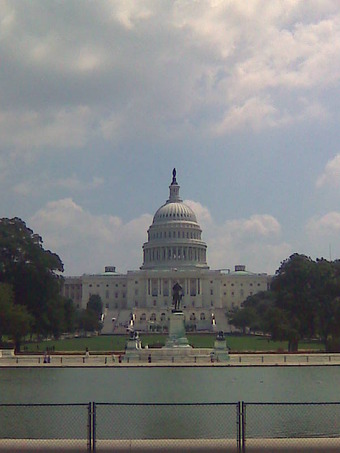
Capitol Hill
Capitol Hill, where bills become laws.
Unlike committee chairmanships, leadership positions are not traditionally conferred on the basis of seniority, but are elected in closed-door caucuses.
Since January 3, 2007, the Democratic Party has constituted a majority in the Senate. The Senate Majority Leader is Harry Reid (Nevada) and serves as leader of the Senate Democratic Conference and manages the legislative business of the Senate. The Senate Majority Whip is Dick Durbin (Illinois) who manages votes, communicates with individual senators, and ensures passage of bills relevant to the agenda and policy goals of the Senate Democratic Conference. Since January 3, 2007, the Republican Party has constituted the minority of the Senate. Mitch McConnell (Kentucky) is the Senate Minority Leader and Jon Kyl (Arizona) is the Senate Minority Whip.
11.2.3: Bicameralism
Bicameralism is the practice of having two legislative or parliamentary chambers.
Learning Objective
Describe bicameralism and the Founding Fathers’ understanding of its role in American federalism
Key Points
- The Founding Fathers of the United States favored a bicameral legislature. The idea was to have the Senate be wealthier and wiser. The Senate was created to be a stabilizing force, elected not by mass electors, but selected by the State legislators.
- A conference committee is appointed when the two chambers cannot agree on the same wording of a proposal, and consists of a small number of legislators from each chamber. This tends to place much power in the hands of only a small number of legislators.
- State legislators chose the Senate and senators had to possess a significant amount of property in order to be deemed worthy and sensible enough for the position.
- As part of the Great Compromise, the Founding Fathers developed a form of bicameralism in which the upper house would have states represented equally, and the lower house would have them represented by population.
Key Terms
- Great Compromise
-
An agreement reached during the Constitutional Convention of 1787 that in part defined the legislative structure and representation that each state would have under the US Constitution. It called for a bicameral legislature, along with proportional representation in the lower house, but required the upper house to be weighted equally between the states.
- bicameral
-
Having, or pertaining to, two separate legislative chambers or houses.
Bicameralism
In government, bicameralism is the practice of having two legislative or parliamentary chambers comprise bills. Bicameralism is an essential and defining feature of the classical notion of mixed government. Bicameral legislatures tend to require a concurrent majority to pass legislation. A conference committee is appointed when the two chambers cannot agree on the same wording of a proposal that consists of a small number of legislators from each chamber. This tends to place much power in the hands of only a small number of legislators. Whatever legislation, if any, the conference committee finalizes must then be approved in an unamendable “take-it-or-leave-it” manner by both chambers.
The Founding Fathers of the United States favored a bicameral legislature. The idea was to have the Senate be wealthier and wiser. The Senate was created to be a stabilizing force, elected not by mass electors, but selected by the State legislators. Senators would be more knowledgeable and more deliberate—a sort of republican nobility—and a counter to what Madison saw as the “fickleness and passion” that could absorb the House.
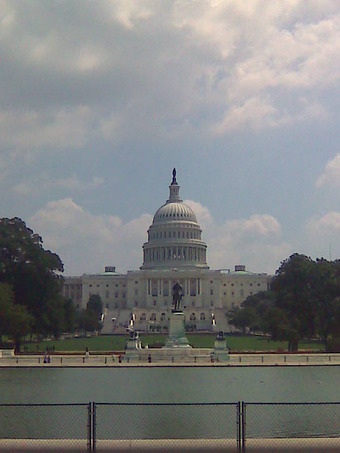
Capitol Hill
The U.S. has a bicameral legislature in Congress, consisting of the House of Representatives and the Senate
State legislators chose the Senate and senators had to possess a significant amount of property in order to be deemed worthy and sensible enough for the position. In fact, it was not until the year 1913 that the Seventeenth Amendment was passed, which “mandated that Senators would be elected by popular vote rather than chosen by the State legislatures. ” As part of the Great Compromise, they invented a new rationale for bicameralism in which the upper house would have states represented equally, and the lower house would have them represented by population.
During the 1930s, the Legislature of the State of Nebraska was reduced from bicameral to unicameral with the 43 members that once comprised that state’s Senate. One of the arguments used to sell the idea at the time to Nebraska voters was that by adopting a unicameral system, the perceived evils of the conference committee process would be eliminated. During his term as Governor of Minnesota, Jesse Ventura proposed converting the Minnesotan legislature to a single chamber with proportional representation, as a reform that he felt would solve many legislative difficulties and impinge upon legislative corruption. Ventura argued that bicameral legislatures for provincial and local areas were excessive and unnecessary, and discussed unicameralism as a reform that could address many legislative and budgetary problems for states.
11.2.4: Legislative Agendas
An agenda is a list of meeting activities in the order in which they are to be taken up in the legislature.
Learning Objective
Differentiate between two uses of the word agenda
Key Points
- A political agenda is a set of issues and policies laid out by an executive or cabinet in government that tries to influence current and near-future political news and debate.
- In parliamentary procedure, an agenda is not binding upon an assembly unless its own rules make it so, or unless it has been adopted as the agenda for the meeting by majority vote at the start of the meeting.
- If an agenda is binding upon an assembly and a specific time is listed for an item, that item cannot be taken up before that time, and must be taken up when that time arrives even if other business is pending.
Key Terms
- town meeting
-
a form of direct democratic rule, used primarily in portions of the United States since the 17th century, in which most or all the members of a community come together to legislate policy and budgets for local government
- docket
-
A short entry of the proceedings of a court; the register containing them; the office containing the register.
- adjourn
-
Temporarily ending an event with intentions to complete it at another time or place.
An agenda is a list of meeting activities in the order in which they are to be taken up, by beginning with the call to order and ending with adjournment. It usually includes one or more specific items of business to be discussed. It may, but is not required to, include specific times for one or more activities. An agenda may also be called a “docket. “
A political agenda is a set of issues and policies laid out by an executive or cabinet in government that tries to influence current and near-future political news and debate. In parliamentary procedure, an agenda is not binding upon an assembly unless its own rules make it so or unless it has been adopted as the agenda for the meeting by majority vote at the start of the meeting. Otherwise, it is merely for the guidance of the chair.
If an agenda is binding upon an assembly, and a specific time is listed for an item. That item cannot be taken up before that time and must be taken up when that time arrives even if other business is pending. If it is desired to do otherwise, the rules can be suspended for that purpose.
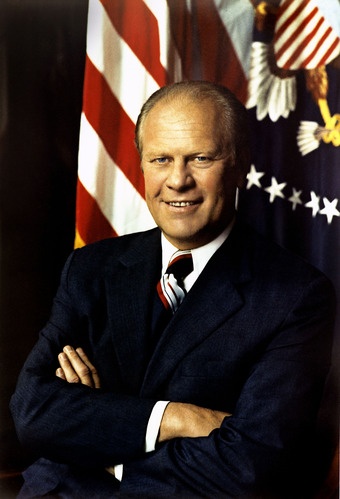
Gerald Ford Papers
Gerald Ford set the Republican legislative agenda.
The political agenda while shaped by government can be influenced by grassroots support from party activists at events, such as a party conference, and can even be shaped by non-governmental activist groups which have a political aim. Increasingly, the mass media can have an effect in shaping the political agenda through its news coverage of news stories. A political party can be described as shaping the political agenda or setting the political agenda if its promotion of certain issues gains prominent news coverage. For example, at election time, if a political party wants to promote its polices and gain prominent news coverage in order to increase its support.
11.2.5: The Committee System
A congressional committee is a legislative sub-organization in Congress that handles a specific duty.
Learning Objective
Describe the committee system, its growth, and that growth’s effect on Congress’s power
Key Points
- Committees monitor on-going governmental operations, identify issues suitable for legislative review, gather and evaluate information and recommend courses of action to their parent body.
- Congressional committees provide invaluable informational services to Congress by investigating and reporting about specialized subjects.
- Since 1761, the growing autonomy of committees has fragmented the power of each congressional chamber as a unit. This centrifugal dispersion of power has, without doubt, weakened the Legislative Branch relative to the other branches of the federal government.
- Today the Senate operates with 20 standing and select committees. These select committees, however, are permanent in nature and are treated as standing committees under Senate rules.
Key Term
- Ways and Means
-
The Committee of Ways and Means is the chief tax-writing committee of the United States House of Representatives
A congressional committee is a legislative sub-organization in the U.S. Congress that handles a specific duty. Committee membership enables members to develop specialized knowledge of the matters under their jurisdiction. Committees monitor on-going governmental operations, identify issues suitable for legislative review, gather and evaluate information and recommend courses of action to their parent body. It is neither expected nor possible that a member of Congress be an expert on all matters and subject areas that come before Congress. Congressional committees provide invaluable informational services to Congress by investigating and reporting about specialized subjects.
Most legislation is considered by standing committees which have jurisdiction over a particular subject such as Agriculture or Appropriations. The House has twenty standing committees; the Senate has sixteen. Standing committees meet at least once each month. Almost all standing committee meetings for transacting business must be open to the public unless the committee votes, publicly, to close the meeting. A committee might call for public hearings on important bills. Each committee is led by a chair who belongs to the majority party and a ranking member of the minority party. Witnesses and experts can present their case for or against a bill. Then, a bill may go to what’s called a mark-up session where committee members debate the bill’s merits and may offer amendments or revisions. Committees may also amend the bill, but the full house holds the power to accept or reject committee amendments. After debate, the committee votes whether it wishes to report the measure to the full house. If a bill is tabled then it is rejected. If amendments are extensive, sometimes a new bill with amendments built in will be submitted as a so-called clean bill with a new number.
Congress divides its legislative, oversight, and internal administrative tasks among approximately 200 committees and subcommittees. Within assigned areas, these functional subunits gather information, compare and evaluate legislative alternatives, identify policy problems and propose solutions, select, determine, and report measures for full chamber consideration, monitor executive branch performance and investigate allegations of wrongdoing. While this investigatory function is important, procedures such as the House discharge petition process are so difficult to implement that committee jurisdiction over particular subject matter of bills has expanded into semi-autonomous power.
Since 1761, the growing autonomy of committees has fragmented the power of each congressional chamber as a unit. Over time, this system proved ineffective, so in 1816 the Senate adopted a formal system of 11 standing committees with five members each. With the advent of this new system, committees are able to handle long-term studies and investigations, in addition to regular legislative duties. With the growing responsibilities of the Senate, the committees gradually grew to be the key policy-making bodies of the Senate, instead of merely technical aids to the chamber.
By 1906, the Senate maintained 66 standing and select committees—eight more committees than members of the majority party. The large number of committees and the manner of assigning their chairmanships suggests that many of them existed solely to provide office space in those days before the Senate acquired its first permanent office building, the Russell Senate Office Building. By May 27, 1920, the Russell Senate Office Building had opened, and with all Senate members assigned private office space, the Senate quietly abolished 42 committees. Today the Senate operates with 20 standing and select committees. These select committees, however, are permanent in nature and are treated as standing committees under Senate rules.
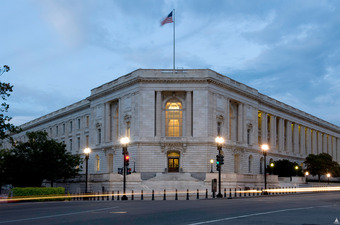
Russell Senate Office Building
The Russell Senate Office Building houses several Congressional staff members, including those on the United States Senate Committees on Armed Services, Rules and Administration, Veterans’ Affairs, and others.
The first House Committee was appointed on April 2, 1789 to prepare and report such standing rules and orders of proceeding as well as the duties of a Sergeant-at-Arms to enforce those rules. Other committees were created as needed, on a temporary basis, to review specific issues for the full House. The House relied primarily on the Committee of the Whole to handle the bulk of legislative issues. The Committee on Ways and Means followed on July 24, 1789 during a debate on the creation of the Treasury Department over concerns of giving the new department too much authority over revenue proposals. The House felt it would be better equipped if it established a committee to handle the matter. This first Committee on Ways and Means had 11 members and existed for just two months. It later became a standing committee in 1801, a position it still holds today.
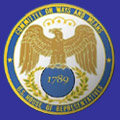
Ways and Means Committee Logo
The Ways and Means Committee has been an important committee in the U.S. since 1789
11.2.6: The Staff System
Congressional staff are employees of the United States Congress or individual members of Congress.
Learning Objective
Differentiate between the roles of different congressional staff; in the Congressional Research Service, Congressional Budget Office, and Government Accountability Office
Key Points
- In the year 2000, there were approximately 11,692 personal staff, 2,492 committee staff, 274 leadership staff, 5,034 institutional staff, 3,500 GAO employees, 747 CRS employees, and 232 CBO employees.
- Every Representative hired 14 staff members, while the average Senator hired 34. In 2000, Representatives had a limit of 18 full-time and four part-time staffers, while Senators had no limit on staff.
- Majority and minority members hire their own staff except for two committees in each house: the Committee on Standards of Official Conduct and the Permanent Select Committee on Intelligence in the House, and the Select Committee on Ethics and Senate Select Committee on Intelligence in the Senate.
Key Terms
- Congressional Research Service
-
The Congressional Research Service (CRS), known as Congress’s think tank, is a public policy research arm of the United States Congress.
- Congressional Budget Office
-
The Congressional Budget Office (CBO) is a federal agency within the legislative branch of the United States government that provides economic data to Congress.
- Government Accountability Office
-
The Government Accountability Office (GAO) is the audit, evaluation, and investigative arm of the United States Congress.
- appropriation
-
Public funds set aside for a specific purpose.
Congressional staff are employees of the United States Congress or individual members of Congress. The various types of congressional staff are as follows: personal staff, who work for individual members of Congress; committee staff, who serve either the majority or minority on congressional committees; leadership staff, who work for the speaker, majority and minority leaders, and the majority and minority whips; institutional staff, who include the majority and minority party floor staff and non-partisan staff; and the support agency staff, who are the non-partisan employees of the Congressional Research Service (CRS), Congressional Budget Office (CBO), and Government Accountability Office (GAO).
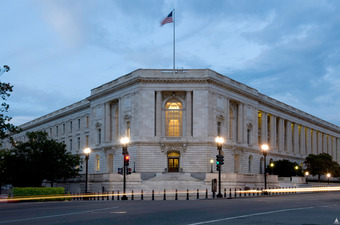
Russell Senate Office Building
The Russell Senate Office Building houses several Congressional staff members, including those on the United States Senate Committees on Armed Services, Rules and Administration, Veterans’ Affairs, and others.
In the year 2000, there were approximately 11,692 personal staff, 2,492 committee staff, 274 leadership staff, 5,034 institutional staff, 747 CRS employees, and 232 CBO employees, and 3,500 GAO employees. Every Representative hired 14 staff members, while the average Senator hired 34. Representatives had a limit of 18 full-time and four part-time staffers, while Senators had no limit on staff.
Each congressional committee has a staff of varying size. Appropriations for committee staff are made in annual legislative appropriations bills. Majority and minority members hire their own staff, with the exception of two committees in each house: the Committee on Standards of Official Conduct and the Permanent Select Committee on Intelligence in the House, and the Select Committee on Ethics and the Senate Select Committee on Intelligence in the Senate. These committees have a single staff.
In 2000, House committees had an average of 68 staff, and Senate committees an average of 46. Committee staff includes staff directors, committee counsel, committee investigators, press secretaries, chief clerks and office managers, schedulers, documents clerks, and assistants.
11.2.7: The Caucus
A caucus is a meeting of supporters or members of a political party or movement.
Learning Objective
Differentiate between two different types of political caucus
Key Points
- The term caucus is often used to discuss procedures implemented by states, including Iowa and Texas, to select presidential nominees.
- Depending on how the caucus is organized, the caucus system may require voters to publicly announce the candidates they support. Voters have the option to draft resolutions introduced at later divisional caucuses or conventions.
- A caucus can also be a sub-grouping of officials who convene to advocate, agitate, lobby or vote collectively on policy.
Key Term
- bicameral
-
Having, or pertaining to, two separate legislative chambers or houses.
A caucus is a meeting of supporters or members of a political party or movement. Members of a political party or subgroup may meet to coordinate actions, choose group policy or nominate candidates for various offices.The term caucus is often used to discuss procedures implemented by states, including Iowa and Texas, to select presidential nominees. . Since 1980, caucuses have become an important component of the nomination process.
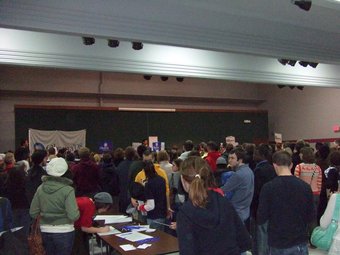
Iowa Caucus
The Iowa Caucus is the first major electoral event of the nominating process for President of the United States.
Despite a Democratic Party rule that delegates are allocated proportionally rather than “winner takes all,” some caucus groups decide individually how to allocate their group’s delegates. Discussion of party rules is not necessarily part of the caucus experience, while few rules govern the actual process. In the “winner-take-all” scenario, a group’s delegate allocation may be reported as unanimous while ignoring minority votes. Depending on how the caucus is organized, the caucus system may require voters to publicly announce the candidates they support. Voters have the option to draft resolutions introduced by delegates at later divisional caucuses or conventions.
A caucus can also be a sub-grouping of officials with shared affinities or ethnicities. These officials convene to advocate, agitate, lobby or to vote collectively on policy. At the congressional and legislative levels, Democratic and Republican members organize themselves into a caucus.
There can also be smaller caucuses in a legislative body, including those that are multi-partisan or bicameral. One of the best-known is the Congressional Black Caucus, a group of African-American congressmen. Another prominent example is the Congressional Hispanic Caucus, whose members advance issues affecting Hispanics. In a different vein, the Congressional Internet Caucus is a bipartisan group promoting the growth and advancement of the Internet. Other congressional caucuses like the Out of Iraq Caucus strive to achieve political goals, generally organized around a single issue.
11.2.8: Congressional Districts
The quantity and boundaries of the 435 districts are determined after each census gauges the population shifts in each state.
Learning Objective
Describe what determines the quantity and boundaries of congressional districts
Key Points
- The boundaries of districts often shift with each redistricting. Over time, the region and demographics represented in a district can change substantially.
- As of the 2000 census, the average population per district is 646,946 people. California, with 53 districts, has the most. States with only one district include Alaska, Delaware, Montana, North Dakota, South Dakota, Vermont, and Wyoming.
- Alaska is the district with the greatest area and New York’s 15th district has the smallest area. Montana’s district has the largest number of people (905,316) and Wyoming has the fewest number of people (495,304). Delaware is the oldest district.
Key Terms
- apportion
-
To divide and distribute portions of a whole.
- apportionment
-
The act of apportioning or the state of being apportioned
Congressional Districts
The quantity (apportionment) and boundaries (redistricting) of districts are determined after each census, although in some cases states have changed the boundaries more than once per census. The census is used to gauge each state’s population and thus, proportional need for representation. Due to the shifts in population a state may gain or lose congressional districts. For example, since the 2000 census, Nebraska has had three districts, but it used to have as many as six. Texas currently has 32 districts, but will be adding 4 due to reapportionment as a result of the 2010 census. Other states will lose districts since the number of congressional seats has been set at 435 by statute.
The boundaries of districts often shift with each redistricting. Over time, the region and demographics represented in a district can change substantially. Furthermore, districts sometimes retain the same boundaries while changing their district numbers.

U.S. District Map
This map shows the U.S. Congress House Districts for the 110th-112th Congresses.
As of the 2000 census, the average population per district is 646,946 people. California had the most, at 53 districts. States with only one district include Alaska, Delaware, Montana, North Dakota, South Dakota, Vermont, and Wyoming. Alaska, Delaware, and Wyoming are the only states that have never had more than one district. Alaska is the district with the greatest area and New York’s 15th district has the smallest area. Montana’s district has the largest number of people (905,316) and Wyoming has the fewest number of people (495,304). Delaware is the oldest district; It has had the same geographical borders since 1789.
11.3: The Legislative Function of Congress
11.3.1: How a Bill Becomes Law
A bill is introduced by a member of the legislature, read through, debated, and then passed to become a law.
Learning Objective
Explain the process by which a bill becomes a law through the legislative and executive branches of government
Key Points
- In the US system, where the executive is formally separated from the legislature, all bills must originate from the legislature.
- In the U.S. Congress, a system of committees considers law relating to each policy area jurisdictions. The committee system is a way to provide for specialization, or a division of the legislative labor.
- At the second reading the general merits of the bill are considered. The committee reports to the legislature and further amendments are proposed. A third reading debate occurs and the bill is submitted.
- Bills passed by the legislature usually require the approval of the executive to become law. The legislature often has the power to override the veto of the executive by means of a supermajority. Any branch at anytime may decline the proposed bill.
Key Term
- fiat
-
An authoritative command or order to do something; an effectual decree.
How a Bill Becomes Law
A bill is introduced by a member of the legislature. While mechanisms exist to allow other members of the legislature to introduce bills, these are subject to strict timetables and usually fail unless a consensus is reached. In the U.S. system, where the executive is formally separated from the legislature, all bills must originate from the legislature.
Bills can be introduced through leave and government motion. Leave is when a motion is brought before the house asking that leave be given to bring in a bill. The legislator has 10 minutes to propose a bill, which can then be considered by the House on a day appointed for the purpose. While this rule still exists in the rules of procedure of the U.S. Congress, it is seldom used. A government motion occurs in jurisdictions where the executive can control legislative business a bill may be brought in by executive fiat.
A system of committees considers law relating to each policy area jurisdictions in the U.S. Congress. Thousands of bills are introduced in every session of Congress and no single member can possibly be adequately informed on all the issues that arise. The committee system is a way to provide for specialization, or a division of the legislative labor. Committees usually have the final say on pieces of legislation and only very rarely are deprived of control of a bill; although this kind of action is allowed in the rules of each chamber.
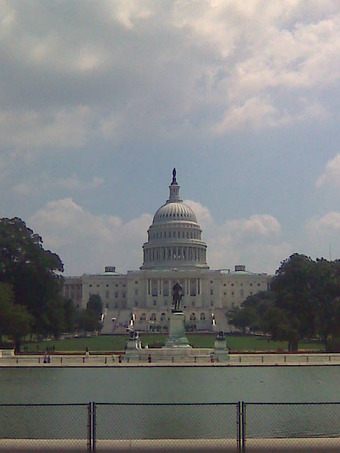
Capitol Hill
The U.S. has a bicameral legislature in Congress, consisting of the House of Representatives and the Senate
House and Senate Committees
A congressional committee is a legislative sub-organization in the United States Congress that handles a specific duty. Committee membership enables members to develop specialized knowledge of the matters under their jurisdiction. Congress divides its legislative, oversight, and internal administrative tasks among approximately 200 committees and subcommittees.
There are three main types of committees—standing, select or special, and joint. In the House of Representatives, there are 21 permanent committees, and 20 in the United States Senate. Four joint committees operate with members from both houses on matters of mutual jurisdiction and oversight. Committees in the House of Representatives generally have more members, due its larger size, as compared to the smaller 100-member Senate. Senate rules fix the maximum size for many of its committees, while the House determines the size and makeup of each committee every new Congress.
Bills are generally considered through a number of readings. This refers to the historic practice of the clerical officers of the legislature reading the contents of a bill to the legislature. While the bill is no longer read, the motions on the bill still refer to this practice.
At the second reading the general merits of the bill are considered. After which, the bill is referred to a committee, considering the bill line by line proposing amendments. The committee reports to the legislature, at which stage further amendments are proposed. Finally a third reading debate at which the bill as amended is considered in its entirety. The process is repeated in the other house, before the Bill is submitted to the executive for approval.
Bills passed by the legislature usually require the approval of the executive to become law. The need to receive approval can be used as a political tool by the executive and its refusal is known as a veto. The legislature often has the power to override the veto of the executive by means of a supermajority. Any branch at anytime may decline the proposed bill.
11.3.2: Committee Deliberation
Deliberation is a process of thoughtfully weighing options, usually prior to voting, emphasizing the use of logic and reason.
Learning Objective
Identify the significance of committee deliberation in the legislative process
Key Points
- In deliberative democracy the aim is for both elected officials and the general public to use deliberation rather than power-struggle as the basis for their vote and is a form of democracy in which deliberation is central to decision making.
- Deliberative democracy differs from traditional democratic theory in that authentic deliberation, not mere voting, is the primary source of legitimacy for the lawmaking processes.
- A deliberative assembly is an organization comprising members who use parliamentary procedure to make decisions. A committee is a small deliberative assembly subordinate to a larger deliberative assembly.
Key Term
- subordinate
-
Placed in a lower class, rank, or position.
Deliberation and Democracy
Deliberation is a process of thoughtfully weighing options, usually prior to voting. Deliberation emphasizes the use of logic and reason as opposed to power-struggle, creativity, or dialogue. Group decisions are generally made after deliberation through a vote of those involved.
In deliberative democracy the aim is for both elected officials and the general public to use deliberation rather than power-struggle as the basis for their vote. Deliberative democracy is a form of democracy in which deliberation is central to decision making. It adopts elements of both consensus decision-making and majority rule. Deliberative democracy differs from traditional democratic theory in that authentic deliberation, not mere voting, is the primary source of legitimacy for the lawmaking processes.
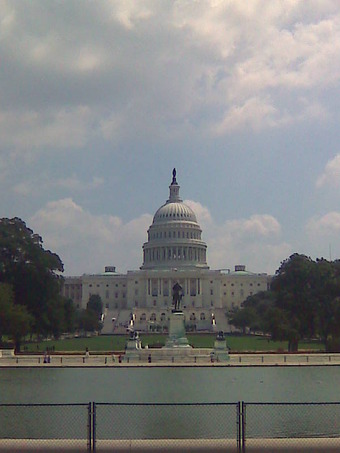
Capitol Hill
Capitol Hill, where bills become laws.
Debate in the U.S. Congress
Each bill goes through several stages in each house including consideration by a committee and advice from the Government Accountability Office. Most legislation is considered by standing committees which have jurisdiction over a particular subject such as Agriculture or Appropriations. The House has twenty standing committees; the Senate has sixteen. Standing committees meet at least once each month. Almost all standing committee meetings for transacting business must be open to the public unless the committee votes, publicly, to close the meeting. A committee might call for public hearings on important bills. Each committee is led by a chair who belongs to the majority party and a ranking member of the minority party. Witnesses and experts can present their case for or against a bill. Then, a bill may go to what’s called a mark-up session where committee members debate the bill’s merits and may offer amendments or revisions. Committees may also amend the bill, but the full house holds the power to accept or reject committee amendments. After debate, the committee votes whether it wishes to report the measure to the full house. If a bill is tabled then it is rejected. If amendments are extensive, sometimes a new bill with amendments built in will be submitted as a so-called clean bill with a new number. Both houses have procedures under which committees can be bypassed or overruled but they are rarely used. Generally, members who have been in Congress longer have greater seniority and therefore greater power.
A bill which reaches the floor of the full house can be simple or complex and begins with an enacting formula such as “Be it enacted by the Senate and House of Representatives of the United States of America in Congress assembled. ” Consideration of a bill requires, itself, a rule which is a simple resolution specifying the particulars of debate—time limits, possibility of further amendments, and such. Each side has equal time and members can yield to other members who wish to speak. Sometimes opponents seek to recommit a bill which means to change part of it. Generally, discussion requires a quorum, usually half of the total number of representatives, before discussion can begin, although there are exceptions. The house may debate and amend the bill; the precise procedures used by the House and Senate differ. A final vote on the bill follows.
Once a bill is approved by one house, it is sent to the other which may pass, reject, or amend it. For the bill to become law, both houses must agree to identical versions of the bill. If the second house amends the bill, then the differences between the two versions must be reconciled in a conference committee, an ad hoc committee that includes both senators and representatives sometimes by using a reconciliation process to limit budget bills. Both Houses use a budget enforcement mechanism informally known as pay-as-you-go or paygo which discourages members from considering acts which increase budget deficits. If both houses agree to the version reported by the conference committee, the bill passes, otherwise it fails. In this respect, this is how bills “die” in committees.
The Constitution specifies that a majority of members known as a quorum be present before doing business in each house. However, the rules of each house assume that a quorum is present unless a quorum call demonstrates the contrary. Since representatives and senators who are present rarely demand quorum calls, debate often continues despite the lack of a majority.
11.3.3: Debate
Debate is contention in argument and a method of interactive representational argument, and often occurs in Congress.
Learning Objective
Discuss the role that debate plays in the United States Congress
Key Points
- Debate is a broader form of argument than deductive reasoning, which only examines whether a conclusion is a consequence of premises, and factual argument, which only examines what is or isn’t the case, or rhetoric, which is a technique of persuasion.
- Though logical consistency, factual accuracy and emotional appeal to the audience are important elements of the art of persuasion, in debating, one side often prevails over the other side by presenting a superior context and framework of the issue, which is far more subtle and strategic.
- Debating is commonly carried out in many assemblies of various types to discuss matters and to make resolutions about action to be taken, often by a vote.
Key Terms
- filibuster
-
A delaying tactic, especially the use of long, often irrelevant speeches given in order to delay progress or the making of a decision, especially on the floor of the US Senate.
- rhetoric
-
The art of using language, especially public speaking, as a means to persuade.
Debate is contention in argument, dispute, controversy, and discussion. It is a method of interactive and representational argument. Debate is a broader form of argument than deductive reasoning, which only examines whether a conclusion is a consequence of premises, and factual argument, which only examines what is or isn’t the case, or rhetoric, which is a technique of persuasion. Debates are often organized for purely competitive purposes.
The use of debate in Congress often occurs when a new bill is introduced, especially if that bill is controversial. Senators may debate a bill. In the Senate, Senators sometimes use this rule to filibuster a bill—that is, continue debating a bill endlessly so that it cannot be voted on. The only way to end a filibuster is for three-fifths of all Senators to vote for a cloture resolution, which ends all debate and brings the bill up for voting. Use of the filibuster tends to be controversial. Whichever party is in the majority tends to call its use “obstructionism,” while the other side sees it as an important check on the majority.
Because of its size, the House relies heavily upon fixed rules and strict timetables for debate. When bills are debated on the floor of the House, each party’s leader is allocated a fixed amount of time to present their argument for or against the bill, and they can delegate this time to members of their party as they see fit. During House debates, it is common for representatives to “yield their time” to one another. Times for debate and other procedures are set by the House Rules Committee, which is generally considered to be one of the most powerful committees in Congress.
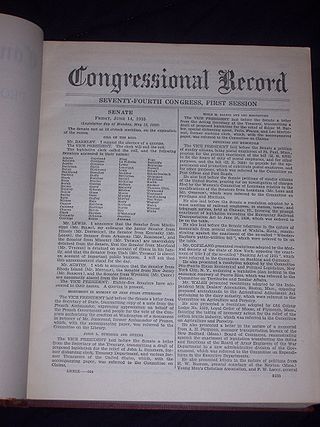
Congressional Records
The Congressional Records contain sections of verbatum congressional debates.
11.3.4: Conference Committee
A conference committee is a committee of Congress appointed by the House and Senate to resolve disagreements on a particular bill.
Learning Objective
Explain the function of the conference committee in the legislative process
Key Points
- The conference committee is usually composed of the senior Members of the standing committees of each House that originally considered the legislation.
- Conference committees exist to draft a compromise bill that both houses can accept. Both houses of Congress must eventually pass the identical legislation for the bill to become law.
- Each house determines the number of conferees from its house. The number of conferees need not be equal from each side. In order to conclude its business, a majority of both House and Senate delegations to the conference must indicate their approval by signing the conference report.
- The authority to appoint conferees lies in the entire House, and the entire Senate can appoint conferees by adopting a debatable motion to do so, but leadership has increasingly exercised authority in the appointment of conferees.
- The conference committee produces a conference report melding the work of the House and Senate into a final version of the bill and the conference report also includes a joint explanatory statement of the conference committee.
Key Terms
- standing committee
-
a committee established by an official and providing for its scope and power
- chair
-
Chairperson.
- joint committee
-
a Congressional committee consisting of Members of both Houses and having jurisdiction over matters of joint interest
- conference committee
-
a joint committee of a bicameral legislature, which is appointed by, and consists of, members of both chambers to resolve disagreements on a particular bill
A conference committee is a committee of Congress appointed by the House of Representatives and Senate to resolve disagreements on a particular bill. The conference committee is usually composed of the senior members of the standing committees of each house that originally considered the legislation.
Conference committees operate after the House and the Senate have passed different versions of a bill. Conference committees exist to draft a compromise bill that both houses can accept. Both houses of Congress must eventually pass the identical legislation for the bill to become law. The two houses can reach that identical product through the process of amendments between Houses, where the House passes the Senate bill with a House amendment, or vice versa. Thus most major bills become law through using a conference committee.
After one house passes a bill, the second house will often pass the same bill, with an amendment representing the second house’s work product. The second house will then send a message to the first house, asking the first house to concur with the second house’s amendment. If the first house does not like the second house’s amendment, then the first house can disagree with the amendment of the second house, request a conference, appoint conferees, and send a message to that effect to the second house. The second house then insists on its amendment, agrees to a conference, and appoints conferees.
Each house determines the number of conferees from its house. The number of conferees need not be equal from each side. In order to conclude its business, a majority of both House and Senate delegations to the conference must indicate their approval by signing the conference report.
The authority to appoint conferees lies in the entire House, and the entire Senate can appoint conferees by adopting a debatable motion to do so. But leadership have increasingly exercised authority in the appointment of conferees. The House and Senate may instruct conferees, but these instructions are not binding on conferees.
Conference committees can be extremely contentious, particularly if the houses are controlled by different parties . House rules require that one conference meeting be open to the public, unless the house, in open session, votes that a meeting will be closed to the public. But apart from this one open meeting, conference committees usually meet in private and are dominated by the Chairs of the House and Senate Committees.
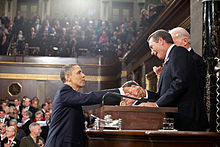
John Boehner
Speaker of the House John Boehner (R), seen here with President Barack Obama during the 2011 State of the Union, called for a conference committee to discuss new tax policies that were introduced to the house in 2011. Critics say he used the conference committees to stall the passing of any tax compromises.
House and Senate rules forbid Conferees from inserting into their report matter not committed to them by either house, but conference committees sometimes do introduce new matter. In such a case, the rules of each house provide that a Member may object through a point of order, although each house has procedures under which it can vote to waive the point of order. The house provides a procedure by which the offending provision may be stricken from the bill. Formerly, the Senate required a Senator to object to the whole bill as reported by the conference committee. If the objection was well founded, the Presiding Officer ruled and a Senator could appeal the ruling of the Chair. If the appeal was sustained by a majority of the Senate, it had precedential effect, eroding the rule on the scope of conference committees.
The conference committee produces a conference report melding the work of the House and Senate into a final version of the bill. A conference report proposes legislative language as an amendment to the bill and also includes a joint explanatory statement of the conference committee. This explanatory statement provides one of the best sources of legislative history on the bill.
Once a bill has been passed by a conference committee, it goes directly to the floor of both houses for a vote, and is not open to further amendment. In the first house to consider the conference, a Member may move to recommit the bill to the conference committee. But once the first house has passed the conference report, the conference committee is dissolved and the second house to act can no longer recommit the bill to conference.
11.3.5: Presidential Action
The Ineligibility Clause prevents the President from being a member of Congress and cannot directly introduce legislative proposals.
Learning Objective
Identify the role of the President in drafting and passing bills into federal law
Key Points
- The President can take an indirect role in shaping legislation, especially if the president’s political party has a majority in Congress.
- According to Article II, Section 3, Clause 2 of the Constitution, the president may convene either or both houses of Congress.
- The President cannot directly introduce legislative proposals for consideration in Congress.
Key Term
- adjourn
-
Temporarily ending an event with intentions to complete it at another time or place.
The President of the United States has limited legislative powers. The Constitution’s Ineligibility Clause prevents the President from simultaneously being a member of Congress. Therefore, the president cannot directly introduce legislative proposals for consideration in Congress. However, the president can take an indirect role in shaping legislation, especially if the president’s political party has a majority in one or both houses of Congress.
For example, the president or other officials of the executive branch may draft legislation and then ask senators or representatives to introduce these drafts into Congress. The president can further influence the legislative branch through constitutionally mandated, periodic reports to Congress. These reports may be either written or oral, but today are given as the State of the Union address, which often outlines the president’s legislative proposals for the coming year.
In the 20th century critics began charging that too many legislative and budgetary powers have slid into the hands of presidents that should belong to Congress. As the head of the executive branch, presidents control a vast array of agencies that can issue regulations with little oversight from Congress. One critic charged that presidents could appoint a virtual army of ‘czars’ each wholly unaccountable to Congress yet tasked with spearheading major policy efforts for the White House. Presidents have been criticized for making singing statements when signing congressional legislation about how they understand a bill or plan to execute it. This practice has been criticized by the American Bar Association (ABA, ) as unconstitutional. Conservative commentator George Will wrote of an increasingly swollen executive branch and the eclipse of Congress.
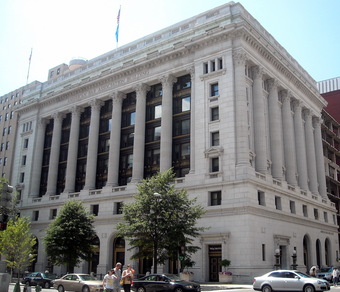
American Bar Association
Union Trust Building, Washington D.C.Home to the American Bar Association’s Branch office
According to Article II, Section 3, Clause 2 of the Constitution, the president may convene either or both houses of Congress. If both houses cannot agree on a date of adjournment, the president may appoint a date for Congress to adjourn.
11.4: The Budgeting Function of Congress
11.4.1: The Budgeting Process
Each year, the President of the United States submits his budget request to Congress.
Learning Objective
Describe the key components of the budget process and the current fiscal position of the United States
Key Points
- The Budget of the United States Government often begins as the President’s proposal to the U.S. Congress which recommends funding levels for the next fiscal year, beginning October 1.
- Several government agencies provide budget data and analysis. These include the Government Accountability Office (GAO), Congressional Budget Office, the Office of Management and Budget (OMB) and the U.S. Treasury Department.
- Social Security, Medicare, and Medicaid expenditures are funded by more permanent Congressional appropriations and so are considered mandatory spending.
- During 2011, the U.S. spent more on its military budget than the next 13 countries combined.
- The annual budget deficit is the difference between actual cash collections and budgeted spending (a partial measure of total spending) during a given fiscal year, which runs from October 1 to September 30.
Key Terms
- Public Debt
-
The United States public debt is the money borrowed by the federal government of the United States through the issuing of securities by the Treasury and other federal government agencies.
- budget
-
The amount of money or resources earmarked for a particular institution, activity, or time-frame.
Example
- The military budget of the United States during FY 2011 was approximately $740 billion in expenses for the Department of Defense (DoD), $141 billion for veteran expenses, and $48 billion in expenses for the Department of Homeland Security, for a total of $929 billion.
Introduction
The Budget of the United States Government often begins as the President’s proposal to the U.S. Congress which recommends funding levels for the next fiscal year, beginning October 1. However, Congress is the body required by law to pass a budget annually and to submit the budget passed by both houses to the President for signature. Congressional decisions are governed by rules and legislation regarding the federal budget process. Budget committees set spending limits for the House and Senate committees and for Appropriations subcommittees, which then approve individual appropriations bills to allocate funding to various federal programs.
Several government agencies provide budget data and analysis. These include the Government Accountability Office (GAO), Congressional Budget Office, the Office of Management and Budget (OMB) and the U.S. Treasury Department. These agencies have reported that the federal government is facing a series of important financing challenges. In the short-run, tax revenues have declined significantly due to a severe recession and tax policy choices, while expenditures have expanded for wars, unemployment insurance and other safety net spending. In the long-run, expenditures related to healthcare programs such as Medicare and Medicaid are projected to grow faster than the economy overall as the population matures.
Major Expenditure Categories
During FY 2012, the federal government spent $3.54 trillion on a budget or cash basis, down $60 billion or 1.7% vs. FY 2011 spending of $3.60 trillion. Major categories of FY 2012 spending included: Medicare & Medicaid ($802B or 23% of spending), Social Security ($768B or 22%), Defense Department ($670B or 19%), non-defense discretionary ($615B or 17%), other mandatory ($461B or 13%) and interest ($223B or 6%). Social Security spending increased versus 2011 while Defense, Medicare and Medicaid spending fell.
Social Security, Medicare, and Medicaid expenditures are funded by more permanent Congressional appropriations and so are considered mandatory spending. Social Security and Medicare are sometimes called “entitlements,” because people meeting relevant eligibility requirements are legally entitled to benefits, although most pay taxes into these programs throughout their working lives. Some programs, such as Food Stamps, are appropriated entitlements. Some mandatory spending, such as Congressional salaries, is not part of any entitlement program. Mandatory spending accounted for 57.4% of total federal outlays in FY2012, with net interest payments accounting for an additional 6.3%. In 2000, these were 53.2% and 12.5%, respectively.
Other Expenditures
The military budget of the United States during FY 2011 was approximately $740 billion in expenses for the Department of Defense (DoD), $141 billion for veteran expenses, and $48 billion in expenses for the Department of Homeland Security, for a total of $929 billion. Much of the costs for the wars in Iraq and Afghanistan have not been funded through regular appropriations bills, but through emergency supplemental appropriations bills. As such, most of these expenses were not included in the budget deficit calculation prior to FY2010. Some budget experts argue that emergency supplemental appropriations bills do not receive the same level of legislative care as regular appropriations bills. During 2011, the U.S. spent more on its military budget than the next 13 countries combined.
Non-defense discretionary spending is used to fund the executive departments (e.g., the Department of Education) and independent agencies (e.g., the Environmental Protection Agency), although these do receive a smaller amount of mandatory funding as well. Discretionary budget authority is established annually by Congress, as opposed to mandatory spending that is required by laws that span multiple years, such as Social Security or Medicare.
The annual budget deficit is the difference between actual cash collections and budgeted spending (a partial measure of total spending) during a given fiscal year, which runs from October 1 to September 30. Since 1970, the U.S. federal government has run deficits for all but four years (1998–2001) contributing to a total debt of $16.1 trillion as of September 2012.
Public Debt
The United States public debt is the money borrowed by the federal government of the United States through the issuing of securities by the Treasury and other federal government agencies. US public debt consists of two components: Debt held by the public includes Treasury securities held by investors outside the federal government, including that held by individuals, corporations, the Federal Reserve System and foreign, state and local governments. Individuals, corporations, the Federal Reserve System and foreign, state and local governments.
Debt held by government accounts or intragovernmental debt includes non-marketable Treasury securities held in accounts administered by the federal government that are owed to program beneficiaries, such as the Social Security Trust Fund. Debt held by government accounts represents the cumulative surpluses, including interest earnings, of these accounts that have been invested in Treasury securities.
11.4.2: Preparing the Budget
The Office of Management and Budget (OMB) performs key tasks in preparing the presidential budget request that is submitted to Congress.
Learning Objective
Summarize the key role played by the Office of Management and Budget in shaping the President’s budget request
Key Points
- The OMB’s primary mission is to assist the president in overseeing the preparation of the federal budget and to supervise the administration of that budget in executive branch agencies.
- Tasks undertaken by the OMB, in order to help the president generate a budget, include evaluating the effectiveness of agency programs, policies, and procedures, and assessing competing funding demands among agencies.
- The fact that the organizational structure of the OMB, and its staff, remain unchanged regardless of which party occupies the White House, facilitates the budget process.
Key Terms
- Office of Management and Budget
-
The largest office within the Executive Office of the President, the OMB is in charge of overseeing the preparation of the federal budget and the administering of that budget within the federal branch.
- legislation
-
Law which has been enacted by legislature or other governing body
- budget
-
The amount of money or resources earmarked for a particular institution, activity, or time-frame.
Introduction
A great deal of preparation goes into the president’s budget request submission, which is entitled, Budget of the U.S. Government. Before it is submitted, the president spends months working with the Office of Management and Budget (OMB) to formulate this budget request . The Office of Management and Budget is the largest office within the Executive Office of the President. The OMB’s primary mission is to assist the president as he or she supervises the preparation of the federal budget. It is also responsible, later, for administering that budget to executive branch agencies.

U.S. Office of Management and Budget Seal
The Office of Management and Budget plays a key role in preparing the president’s budget request to Congress.
OMB’s Responsibilities
In order to aid the president in generating a budget submission, the OMB evaluates the effectiveness of various agency programs, policies, and procedures. The OMB also assesses competing funding demands among agencies in order to decide upon funding priorities. In preparation for submitting a final presidential budget request to Congress, the OMB also ensures that reports from individual agencies, along with any rules, testimony, and proposed legislation, are consistent with the president’s budget request and administration policies.
OMB’s Structure
The structure of the OMB facilitates the preparation of the budget and the later submission of that budget to Congress. OMB staff provide the Executive Office of the President with vital continuity, because they are among the several hundred career professionals that remain in their positions regardless of which party occupies the White House. The largest offices of the OMB are the four Resource Management Offices. Staff members from these offices are assigned to monitor federal agencies or topical areas, like issues associated with U.S. Navy warships. They perform in-depth program evaluations and review federal agency budget requests to decide which resource requests will be sent to Congress under the president’s budget. In addition to these departments, staff members from the Office of General Counsel, the Office of Legislative Affairs, the Budget Review Division, and the Legislative Reference Division provide important support for the general operations of the OMB.
11.4.3: The Election Year Budget
Budget proposals during election years are usually politicized to gain votes and increase constituency support.
Learning Objective
Summarize the various conflicts that can plague the federal budget
Key Points
- The Budget of the United States Government often begins as the President’s proposal to the U.S. Congress which recommends funding levels for the next fiscal year, beginning October 1.
- The annual budget deficit is the difference between actual cash collections and budgeted spending (a partial measure of total spending) during a given fiscal year, which runs from October 1 to September 30.
- The debate between the executive and the House has carried on into the presidential election, in which incumbent Democrat President Obama’s spending policies are compared against those of Republican vice-presidential candidate and current House Budget Committee chairman, Paul Ryan.
- While both executive and House budget plans focus on deficit reduction, they differ in their changes to taxation, entitlement programs, defense spending, and research funding.
Key Terms
- budget
-
The amount of money or resources earmarked for a particular institution, activity, or time-frame.
- budget deficit
-
the difference between government revenues and spending, in which the government is spending more than it’s earning
- fiscal
-
Related to the treasury of a country, company, region, or city, particularly to government spending and revenue.
- deficit
-
A situation wherein, or amount whereby, spending exceeds government revenue.
Example
- Since 1970, the U.S. federal government has run deficits for all but four years (1998–2001) contributing to a total debt of $16.1 trillion as of September 2012
Introduction
The Budget of the United States Government often begins as the President’s proposal to the U.S. Congress which recommends funding levels for the next fiscal year, beginning October 1. However, Congress is the body required by law to pass a budget annually and to submit the budget passed by both houses to the President for signature. Congressional decisions are governed by rules and legislation regarding the federal budget process. Budget committees set spending limits for the House and Senate committees and for Appropriations subcommittees, which then approve individual appropriations bills to allocate funding to various federal programs.
Understanding Deficits and Debt
The annual budget deficit is the difference between actual cash collections and budgeted spending (a partial measure of total spending) during a given fiscal year, which runs from October 1 to September 30. Since 1970, the U.S. federal government has run deficits for all but four years (1998–2001) contributing to a total debt of $16.1 trillion as of September 2012 .
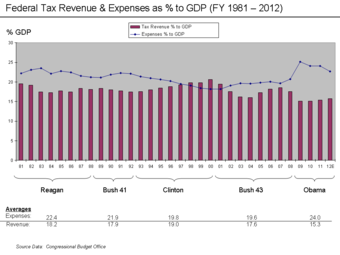
Revenue and Expense to GDP Chart 1993 – 2008
Tax and Spend percent GDP in United States 1981-2012,
Many of the debates surrounding the United States federal budget center around competing macroeconomic schools of thought. In general, Democrats favor the principles of Keynesian economics to encourage economic growth via a mixed economy of both private and public enterprise, a welfare state, and strong regulatory oversight. Conversely, Republicans generally support applying the principles of either laissez-faire or supply-side economics to grow the economy via small government, low taxes, limited regulation, and free enterprise.
Election-Year Budgets
The 1996 United States federal budget was the United States federal budget to fund government operations for the fiscal year 1996, which was October 1995 – September 1996. This budget was the first to be submitted after the Republican Revolution in the 1994 midterm elections. Disagreements between Democratic President Bill Clinton and Republicans led by Speaker of the House Newt Gingrich led to the United States federal government shutdown of 1995 and 1996.
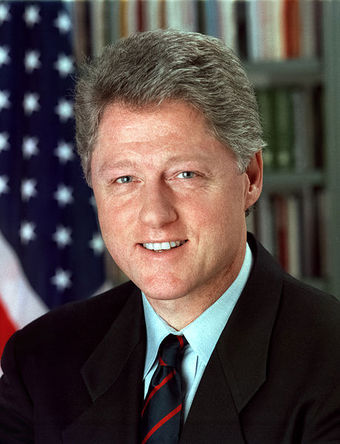
U.S. President Bill Clinton
Official White House photo of President Bill Clinton, President of the United States.
The failure of Congress and the President to enact the remaining appropriations legislation led to government shutdowns during November 13–19, 1995 and December 15, 1995 through January 6, 1996. The shutdowns were triggered by the expiration of continuing resolutions. The first shutdown caused the furlough of about 800,000 federal employees, while the second affected 284,000 due to additional appropriations bills enacted in the interim.
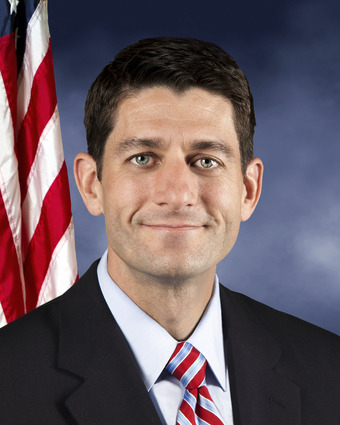
Paul Ryan
Rep. Paul Ryan is former head of the House Budget Committee, but now serves as the Speaker of the House.
The Obama Administration’s Budget Plans
The Obama administration’s 2012 budget request focused on reducing annual deficits to more sustainable levels by making certain cuts in spending while continuing to support areas that would promote long-term economic growth, such as education and clean energy. The plan did not contain proposals to rein in spending on entitlement programs expected to increase the deficit in future years, like Medicare, Medicaid, and Social Security. The 2012 budget plan was a shift from the Obama administration’s previous strategy of using increased government spending to stimulate the economy. Instead, the budget request was projected to reduce government deficits by 1.1 trillion dollars over the next ten years. Republicans have criticized the president’s plan for not going far enough to reduce future deficits.
The 2016 budget plan President Obama proposed requested 4 trillion in fiscal year 2016. His proposal called for 74 billion in additional discretionary spending above the sequestration caps set in place. The additional spending would be about evenly split between defense and non-defense discretionary programs.
This budget request is President Obama’s first on-time budget proposal since 2011. It included more than $1.15 trillion in discretionary spending, an increase of about 2 percent relative to 2015 enacted levels.
The president proposed $60 billion over 10 years for a new initiative that would allow students to attend community college for up to two years tuition free and would again provide expanded Head Start and universal pre-kindergarten.
The budget also includes $478 billion in additional infrastructure spending over the next six years, which would pay for surface transportation improvements such as roads and bridges. The president proposes to pay for this through various tax reforms.
11.4.4: Budget Resolutions
The budget resolution serves as a blueprint for the actual appropriations process and provides Congress with some control over the process.
Learning Objective
Summarize the aims and shape of Congress’s annual budget resolution
Key Points
- The budget resolution establishes budget totals, allocations, entitlements, and sometimes includes reconciliation instructions to certain House or Senate committees. Federal spending is apportioned among 20 functional categories such as national defense, agriculture, and transportation.
- The budget resolution sets spending ceilings for the Congressional committees with jurisdiction over spending.
- The budget resolution is created in response to the president’s budget request according to the Congressional Budget and Impoundment Control Act of 1974.
- No penalty exists if the budget resolution is not completed by April 15th or if it is not completed at all.
Key Terms
- appropriations
-
In law and government, appropriation (from Latin appropriare, “to make one’s own,” later “to set aside”) is the act of setting apart something for its application to a particular usage to the exclusion of all other uses. It typically refers to the legislative designation of money for particular uses in the context of a budget or spending bill.
- fiscal
-
Related to the treasury of a country, company, region, or city, particularly to government spending and revenue.
- budget resolution
-
In the United States Congress, a budget resolution is a legislation in the form of a concurrent resolution setting forth the congressional budget. The budget resolution establishes various budget totals, allocations, and entitlements. It may include reconciliation instructions to designated House or Senate committees.
Congress must create an annual budget resolution in response to the President’s budget request according to the Congressional Budget and Impoundment Control Act of 1974 (also known as the Congressional Budget Act) . The budget resolution must cover the time span of a minimum of five fiscal years, which includes the upcoming fiscal year plus the four following fiscal years. The budget resolution establishes budget totals, allocations, entitlements, and sometimes includes reconciliation instructions to certain House or Senate committees. Federal spending is apportioned among 20 functional categories such as national defense, agriculture, and transportation.

Nixon Departing the White House after His Resignation
The Congressional Budget and Impoundment Control Act of 1974 (Congressional Budget Act), created during the Nixon administration, established the current budget resolution process.
The budget resolution also sets spending ceilings for the Congressional committees that have jurisdiction over spending. Even though the budget resolution covers at least five fiscal years, the House and Senate Committees on Appropriations receive allocations only for the upcoming fiscal year because appropriations measures are annual. After the appropriations committees receive their spending ceilings, they are responsible for dividing the amount among their respective subcommittees.
The budget resolution binds Congress, but it is not law since it is not sent to the President. It does not provide budget authority or change the level of revenues. Instead, the budget resolution serves as a blueprint for the actual appropriations process and provides Congress with some control over this process.
April 15th is the target date for congressional adoption of the budget resolution set by the Congressional Budget Act. However, Congress has frequently not met this target date since the fiscal year 1977. In some instances, Congress has not adopted a budget resolution. No penalty exists if the budget resolution is not completed by April 15th or if it is not completed at all. However, some enforceable spending ceilings cannot be established until the budget resolution is completed. The Congressional Budget Act also prohibits House and Senate floor consideration of appropriations measures for the upcoming fiscal year before the budget resolution is completed. However, the House can bypass this prohibition after May 15th and the Senate can bypass it by adopting a motion to waive the rule by majority vote.
11.4.5: Authorization and Appropriation
Authorizations and appropriations functions are separate in principle, but this separation is often imperfect in reality.
Learning Objective
Differentiate between authorization and appropriation
Key Points
- Authorization acts establish, continue, or modify agencies or programs.
- Appropriations acts provide new budget authority for programs, activities, and agencies that have been authorized by authorization committees.
- The separation of authorization and appropriation functions are enforced through House and Senate rules that divide committee jurisdiction between authorization and appropriations bills.
- The separation between authorization and appropriations measures is imperfect: prohibited language in appropriations bills can still be passed, some authorized programs receive no funding, and some unauthorized programs do receive funding.
Key Terms
- appropriation
-
Public funds set aside for a specific purpose.
- budget resolution
-
In the United States Congress, a budget resolution is a legislation in the form of a concurrent resolution setting forth the congressional budget. The budget resolution establishes various budget totals, allocations, and entitlements. It may include reconciliation instructions to designated House or Senate committees.
- authorization
-
Permission, possibly limited, to spend funds for a specific budgetary purpose.
The budget resolution adopted by Congress provides a blueprint for later authorization and appropriations measures. These measures are distinct from each other and perform different functions. Authorization acts establish, continue, or modify agencies or programs. For instance, an authorization act could establish or modify programs within a federal department. Authorization acts also authorize subsequent appropriations for specific agencies and programs, often setting spending ceilings for them. Meanwhile, appropriations acts provide new budget authority for programs, activities, and agencies that have been authorized by authorization committees.
The separation of authorization and appropriation functions are enforced through House and Senate rules that divide committee jurisdiction between authorization and appropriations bills . Points of order also prohibit certain provisions in appropriations measures. For instance, the House and Senate prohibit language in appropriations bills that provides appropriations not authorized by law, also known as unauthorized appropriations. An unauthorized appropriation is a new budget authority for agencies or programs either without authorization or where the budget authority exceeds the authorized ceiling. Language in an appropriations bill that provides legislation on the bill is additionally prohibited. In other words, language in appropriations measures cannot change existing law; legislation is solely the jurisdiction of legislative committees.

House Appropriations Committee Logo
Appropriations committees are distinct from authorization committees in principle, but the division is often imperfect in reality.
In reality, the separation between authorization and appropriation measures is imperfect. Authorization for many programs has long since expired, but these programs still receive appropriated amounts. Other authorized programs receive no appropriated funds at all. Meanwhile, the aforementioned language prohibitions in appropriations bills sometimes gets passed in the bills either because no one raised a point of order or the House and Senate waived the rules.
11.5: The Oversight Function of Congress
11.5.1: Investigation
Congressional oversight is the review, monitoring, and supervision of federal agencies, programs, activities, and policy implementation.
Learning Objective
Name several key enumerated powers that imply oversight authority
Key Points
- Congressional oversight refers to oversight by the United States Congress of the Executive Branch, including the numerous U.S. federal agencies. Congressional oversight refers to the review, monitoring, and supervision of federal agencies, programs, activities, and policy implementation.
- Congress’s oversight authority derives from its implied powers in the Constitution, public laws, and House and Senate rules. It is an integral part of the American system of checks and balances.
- Congress could not reasonably or responsibly exercise these powers without knowing what the executive was doing; how programs were being administered, by whom, and at what cost; and whether officials were obeying the law and complying with legislative intent.
- Oversight also is derived from the many and varied express powers of the Congress in the Constitution. Congress could not reasonably exercise its powers without knowing what the executive was doing; how programs were being administered, by whom, and at what cost.
Key Terms
- enumerated powers
-
The enumerated powers are a list of items found in Article I, Section 8 of the U.S. Constitution that set forth the authoritative capacity of Congress. In summary, Congress may exercise the powers that the Constitution grants it, subject to explicit restrictions in the Bill of Rights and other protections in the Constitution.
- implied powers
-
They are those powers authorized by a legal document (from the Constitution) which, while not stated, seem to be implied by powers expressly stated.
- congressional oversight
-
Congressional oversight refers to oversight by the United States Congress of the Executive Branch, including the numerous U.S. federal agencies.
Introduction
Congressional oversight refers to oversight by the United States Congress of the Executive Branch, including the numerous U.S. federal agencies. Congressional oversight refers to the review, monitoring, and supervision of federal agencies, programs, activities, and policy implementation. Congress exercises this power largely through its congressional committee system. However, oversight, which dates to the earliest days of the Republic, also occurs in a wide variety of congressional activities and contexts. These include authorization, appropriations, investigative, and legislative hearings by standing committees; specialized investigations by select committees; and reviews and studies by congressional support agencies and staff.
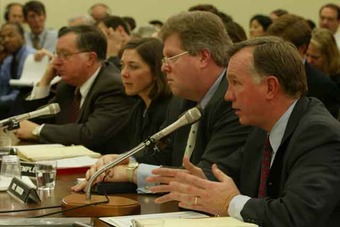
Arthur Andersen Witnesses
Arthur Andersen witnesses testify at the Subcommittee on Oversight and Investigations of the Committee on Energy and Commerce House of Representatives (107th Congress) hearing on January 24, 2002.
Congress’s oversight authority derives from its implied powers in the Constitution, public laws, and House and Senate rules. It is an integral part of the American system of checks and balances.
Report on the Organization of Congress
Oversight is an implied rather than an enumerated power under the U.S. Constitution. The government’s charter does not explicitly grant Congress the authority to conduct inquiries or investigations of the executive, have access to records or materials held by the executive, or to issue subpoenas for documents or testimony from the executive.
There was little discussion of the power to oversee, review, or investigate executive activity at the Constitutional Convention of 1787 or later in the Federalist Papers, which argued in favor of ratification of the Constitution. The lack of debate was based on the view that oversight and its attendant authority were inherent powers of representative assemblies, which enacted public law.
Oversight also is derived from the many and varied express powers of the Congress in the Constitution. It is implied in the legislature’s authority, among other powers and duties, that it can appropriate funds, enact laws, raise and support armies, provide for a Navy, declare war, and impeach and remove from office the president, vice president, and other civil officers. Congress could not reasonably or responsibly exercise these powers without knowing what the executive was doing; how programs were being administered, by whom, and at what cost; and whether officials were obeying the law and complying with legislative intent.
The U.S. Constitution
Although the Constitution grants no formal, express authority to oversee or investigate the executive or program administration, oversight is implied in Congress’s array of enumerated powers. The legislature is authorized to appropriate funds; raise and support armies; provide for and maintain a navy; declare war; provide for organizing and calling forth the national guard; regulate interstate and foreign commerce; establish post offices and post roads; advise and consent on treaties and presidential nominations (Senate); and impeach (House) and try (Senate) the President, Vice President, and civil officers for treason, bribery, or other high crimes and misdemeanors. Reinforcing these powers is Congress’s broad authority “to make all laws which shall be necessary and proper for carrying into execution the foregoing powers, and all other powers vested by this Constitution in the Government of the United States, or in any Department or Officer thereof.”
Activities and Training
Although the Constitution grants no formal, express authority to oversee or investigate the executive or program administration, oversight is implied in Congress’s array of enumerated powers. The legislature is authorized to appropriate funds; raise and support armies; provide for and maintain a navy; declare war; provide for organizing and calling forth the national guard; regulate interstate and foreign commerce; establish post offices and post roads; advise and consent on treaties and presidential nominations (Senate); and impeach (House) and try (Senate) the President, Vice President, and civil officers for treason, bribery, or other high crimes and misdemeanors. Reinforcing these powers is Congress’s broad authority “to make all laws which shall be necessary and proper for carrying into execution the foregoing powers, and all other powers vested by this Constitution in the Government of the United States, or in any Department or Officer thereof.”
11.5.2: Oversight
Oversight of various federal agencies is one of Congress’ enumerated powers.
Learning Objective
Describe the source and nature of Congress’s oversight function.
Key Points
- The authority to oversee the executive comes from the constitutional powers. Congress could not carry them out reasonably or responsibly without knowing what the executive is doing.
- Reinforcing these oversight powers is Congress’s broad authority to make all laws that shall be necessary and proper for carrying into execution the foregoing powers, all other powers vested by this Constitution in the government, or in any Department or Officer in the government.
- Besides these general powers, numerous statutes direct the executive to give information to or consult with Congress.
- Oversight occurs through a wide variety of congressional activities and avenues. Some of the most publicized are the comparatively rare investigations by select committees into major scandals or into executive branch operations gone awry.
Key Term
- subcommittee
-
A committee formed by an existing committee.
Example
- The Congressional Budget Act of 1974 (P.L. 93-344) allowed committees to conduct program evaluation themselves or contract out for it; strengthened GAO’s role in acquiring fiscal, budgetary, and program-related information; and upgraded GAO’s review capabilities.
Background
Although the Constitution grants no formal, express authority to oversee or investigate the executive or program administration, oversight is implied in Congress’s array of enumerated powers. The legislature is authorized to appropriate funds, raise and support armies, provide for and maintain a navy, declare war, provide for organizing and calling forth the national guard, regulate interstate and foreign commerce, establish post offices and post roads, advise and consent on treaties and presidential nominations (Senate), and impeach (House) and try (Senate) the President, Vice President, and civil officers for treason, bribery, or other high crimes and misdemeanors. Reinforcing these powers is Congress’s broad authority to make all laws that will be necessary to carry out execution the foregoing powers, all other powers vested by this Constitution in the government, or in any Department or Officer in the government.
The authority to oversee is derived from these constitutional powers. Congress could not carry them out reasonably or responsibly without knowing what the executive is doing; how programs are being administered, by whom, and at what cost; and whether officials are obeying the law and complying with legislative intent. The Supreme Court has legitimated Congress’s investigative power, subject to constitutional safeguards for civil liberties.
Statutes
The necessary and proper clause of the Constitution also allows Congress to enact laws that mandate oversight by its committees, grant relevant authority to itself and its support agencies, and impose specific obligations on the executive to report to or consult with Congress, and even seek its approval for specific actions. Broad oversight mandates exist for the legislature in several significant statutes.
Besides these general powers, numerous statutes direct the executive to furnish information to or consult with Congress. For example, the Government Performance and Results Act of 1993, requires agencies to consult with Congress on their strategic plans and report annually on performance plans, goals, and results. In fact, more than 2,000 reports are submitted each year to Congress by federal departments, agencies, commissions, bureaus, and offices. Inspectors general (IGs), for instance, report their findings about waste, fraud, and abuse. and their recommendations for corrective action, periodically to the agency head and Congress. The IGs are also instructed to immediately issue special reports concerning particularly serious problems to the agency head, who transmits them unaltered to Congress within seven days.
House and Senate Chamber rules also reinforce the oversight function. House and Senate rules, for instance, provide for “special oversight” or “comprehensive policy oversight,” respectively, for specified committees over matters that relate to their authorizing jurisdiction. In addition, House rules direct each standing committee to require its subcommittees to conduct oversight or to establish an oversight subcommittee for this purpose. House rules also call for each committee to submit an oversight agenda, listing its prospective oversight topics for the ensuing Congress, to the House Committee on Government Reform, which compiles and prints the agendas.
The House Government Reform Committee and the Senate Governmental Affairs Committee, which have oversight jurisdiction over virtually the entire federal government, are authorized to review and study the operation of government activities to determine their economy and efficiency and to submit recommendations based on GAO reports. In addition, House rules require that the findings and recommendations from the Government Reform Committee be considered by authorizing panels, if presented to them in a timely fashion.
Activities and Avenues
Oversight occurs through a wide variety of congressional activities and avenues. Some of the most publicized are the comparatively rare investigations by select committees into major scandals or into executive branch operations gone awry. Examples include temporary select committee inquiries into: China’s acquisition of U.S. nuclear weapons information, in 1999; the Iran-Contra affair, in 1987; intelligence agency abuses, in 1975-1976, and “Watergate,” in 1973-1974. The precedent for this kind of oversight goes back two centuries: in 1792, a special House committee investigated the defeat of an Army force by confederated Indian tribes.
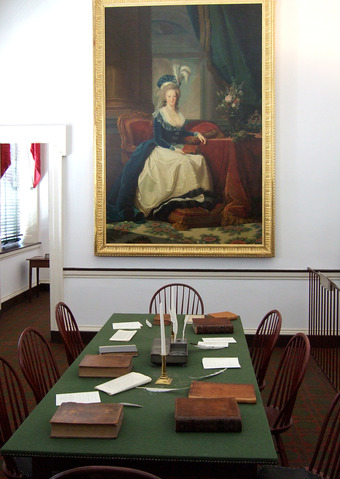
Congress Hall Committee Room Marie Antoinette
One of several committee rooms in Congress Hall, in Philadelphia, PA. The room is located on the second floor, on the west side of the building, adjacent to the Senate chamber. The view is looking toward the front of the building. The portrait of Marie Antoinette, by Élisabeth Vigée-Lebrun (1788), was presented as a gift from the French monarch following the American Revolution.
11.5.3: Advice and Consent
Advice and consent is a power of the Senate to be consulted on and approve treaties signed by the president.
Learning Objective
Describe the origins and development of the Senate’s “advise and consent” powers
Key Points
- The term “advice and consent” first appears in the United States Constitution in Article II, Section 2, Clause 2, referring to the Senate’s role in the signing and ratification of treaties.
- Typically, a congressional hearing is held to question the appointee. For a treaty, a two-thirds vote of the Senate is required anyway; thus, a filibuster could only delay passage.
- Several framers of the U.S. Constitution believed that the required role of the Senate is to advise the president after the nomination.
- Under the Twenty-fifth Amendment, appointments to the Office of Vice President are confirmed by a majority vote in both Houses of Congress, instead of just the Senate.
Key Term
- consent
-
To express willingness, to give permission.
Example
- The actual motion adopted by the Senate when exercising the power is “to advise and consent,” which shows how initial advice on nominations and treaties is not a formal power exercised by the Senate. For appointments, a majority of senators are needed to pass a motion “to advise and consent”, but unless the appointment has the support of three-fifths of senators, a filibuster blocking the passage of the motion is possible.
Background
In the United States, advice and consent is a power of the United States Senate to be consulted on and approve treaties signed and appointments made by the President of the United States to public positions, including Cabinet secretaries, federal judges, and ambassadors . This power is also held by several state Senates, which are consulted on and approve various appointments made by the state’s chief executive, such as some statewide officials, state departmental heads in the Governor’s cabinet, and state judges (in some states).
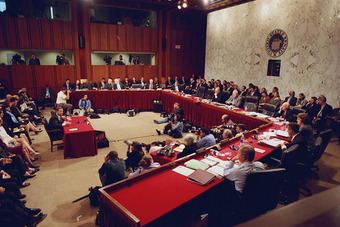
John Roberts Confirmation Hearings
Under the Constitution, the Senate have advice and consent on any nominations made by the President to the Supreme Court of the United States. Here, the Senate Judiciary Committee confirmation hearings of John Roberts to be Chief Justice of the Supreme Court of the United States, 2005.
Constitutional Provision
Article II, Section 2, paragraph two of the United States Constitution states: “The President shall have Power, by and with the Advice and Consent of the Senate, to make Treaties, provided two thirds of the Senators present concur; and he shall nominate, and by and with the Advice and Consent of the Senate, shall appoint Ambassadors, other public Ministers and Consuls, Judges of the supreme Court, and all other Officers of the United States, whose Appointments are not herein otherwise provided for, and which shall be established by Law: but the Congress may by Law vest the Appointment of such inferior Officers, as they think proper, in the President alone, in the Courts of Law, or in the Heads of Departments. “
The term “advice and consent” first appears in the United States Constitution in Article II, Section 2, Clause 2, referring to the Senate’s role in the signing and ratification of treaties. This term is then used again, to describe the Senate’s role in the appointment of public officials, immediately after describing the president’s duty to nominate officials .
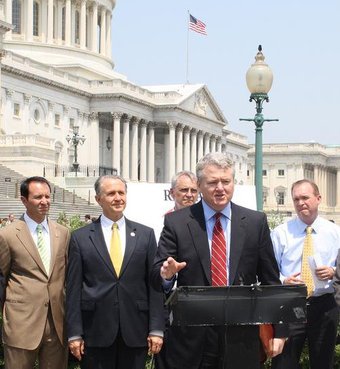
Advice and Consent
Senators also have the power of “advice and consent” over other authorities in the federal or state governments.
The founding fathers of the United States included the language as part of a delicate compromise concerning the balance of power in the federal government. Many delegates preferred to develop a strong executive control vested in the president, while others, worried about authoritarian control, preferred to strengthen the Congress. Requiring the president to gain the advice and consent of the Senate achieved both goals without hindering the business of government.
Under the Twenty-fifth Amendment, appointments to the Office of Vice President are confirmed by a majority vote in both Houses of Congress, instead of just the Senate.
Historical Development of Power
Several framers of the U.S. Constitution believed that the required role of the Senate is to advise the president after the nomination. Roger Sherman believed that advice before nomination could still be helpful. Likewise, President George Washington took the position that pre-nomination advice was allowable but not mandatory. The notion that pre-nomination advice is optional has developed into the unification of the advice portion of the power with the “consent” portion, although several presidents have consulted informally with senators over nominations and treaties.
Use today
The actual motion adopted by the Senate when exercising the power is “to advise and consent,” which shows how initial advice on nominations and treaties is not a formal power exercised by the Senate. For appointments, a majority of senators are needed to pass a motion “to advise and consent,” but unless the appointment has the support of three-fifths of senators, a filibuster blocking the passage of the motion is possible. Typically, a congressional hearing is held to question the appointee. For a treaty, a two-thirds vote of the Senate is required anyway; thus, a filibuster could only delay passage.
11.5.4: Impeachment and Removal from Office
Impeachment is an expressed power that allows for formal charges against a civil officer of government for crimes committed in office.
Learning Objective
Differentiate between the roles played by the House and Senate in impeachment proceedings.
Key Points
- Impeachment is analogous to indictment in regular court proceedings. Trial by the other house is analogous to the trial before judge and jury in regular courts. Typically, the lower house of the legislature will impeach the official and the upper house will conduct the trial.
- Impeachment proceedings may be commenced by a member of the House of Representatives on their own initiative, either by presenting a listing of the charges under oath or by asking for referral to the appropriate committee.
- The Senate enters judgment on its decision, whether that be to convict or acquit. A copy of the judgment is filed with the Secretary of State. Upon conviction, the official is automatically removed from office and may also be barred from holding future office.
Key Terms
- impeachment
-
the act of impeaching a public official, either elected or appointed, before a tribunal charged with determining the facts of the matter.
- indictment
-
An official formal accusation for a criminal offence or the process by which it is brought to a jury.
Example
- A United States federal judge named Walter Nixon was convicted of committing perjury before a grand jury. He refused to resign from office even after he had been incarcerated. Nixon was subsequently impeached by the United States House of Representatives. The matter was referred to the United States Senate for a vote on Nixon’s removal.
Background
Impeachment in the United States is an expressed power of the legislature that allows for formal charges against a civil government officer for crimes committed in office. The actual trial on those charges, and subsequent removal of an official on conviction on those charges, is separate from the act of impeachment itself.

The Senate as a Court of Impeachment for the Trial of Andrew Johnson
The Impeachment of Andrew Johnson
Impeachment is analogous to indictmentin regular court proceedings. Trial by the other house is analogous to the trial before judge and jury in regular courts. Typically, the lower house of the legislature will impeach the official and the upper house will conduct the trial.
At the federal level, Article II of the United States Constitution (Section 4), states that the President, Vice President, and all civil officers of the United States shall be removed from office on impeachment for, and in conviction of, treason, bribery, or other high crimes and misdemeanors. The House of Representatives has the sole power of impeaching, while the United States Senate has the sole power to try all impeachments. The removal of impeached officials is automatic upon conviction in the Senate.
The House of Representatives
Impeachment proceedings may be commenced by a member of the House of Representatives on their own initiative, either by presenting a listing of the charges under oath or by asking for referral to the appropriate committee. Non-members may trigger the impeachment process. For example, when the Judicial Conference of the United States suggests a federal judge be impeached, a charge of what actions constitute grounds for impeachment may come from a special prosecutor, the President, a state or territorial legislature, grand jury, or by petition.
The House debates the resolution and at the conclusion may consider the resolution as a whole or vote on each article of impeachment individually. A simple majority of those present and voting is required for each article or the resolution as a whole to pass. If the House votes to impeach, managers (typically referred to as House managers, with a lead House manager) are selected to present the case to the Senate. Recently, managers have been selected by resolution, while historically the House would occasionally elect the managers or pass a resolution allowing the appointment of managers at the discretion of the Speaker of the United States House of Representatives. These managers are roughly the equivalent of the prosecution/district attorney in a standard criminal trial.
Also, the House will adopt a resolution in order to notify the Senate of its action. After receiving the notice, the Senate will adopt an order notifying the House that it is ready to receive the managers. Then the House managers appear before the bar of the Senate and exhibit the articles of impeachment. After the reading of the charges, the managers return and make a verbal report to the House.
Senate
The proceedings unfold in the form of a trial, with each side having the right to call witnesses and perform cross-examinations. The House members, who are given the collective title of managers during the course of the trial, present the prosecution case. The impeached official has the right to mount a defense with his own attorneys as well. Senators must also take an oath or affirmation that they will perform their duties honestly and with due diligence (as opposed to the House of Lords in the Parliament of the United Kingdom, who vote upon their honor). After hearing the charges, the Senate usually deliberates in private. Conviction requires a two-thirds majority.
The Senate enters judgment on its decision, whether that is to convict or acquit. A copy of the judgment is filed with the Secretary of State. Upon conviction, the official is automatically removed from office and may also be barred from holding future office. The removed official is also liable to criminal prosecution. The President may not grant a pardon in the impeachment case, but may in any resulting criminal case.
11.5.5: Senate Confirmation
Senate confirmation is required for certain presidential appointments stated under the Constitution.
Learning Objective
Describe the significance of the Senate’s role in presidential appointments
Key Points
- Under the United States Constitution and law of the United States, certain federal positions appointed by the president of the United States require confirmation (advice and consent) of the United States Senate.
- United States Supreme Court Justices are appointed by the president and confirmed by the Senate. In theory, this procedure allows both the executive and legislative branches to have some power over the judiciary and thus check the judicial branch’s power.
- The principle of checks and balances allows branches of government to be isolated from each other so that no branch has total power over all functions of government…an attack on or abuse of power by individuals of a single branch will not lead to tyranny or the fall of the entire government.
Key Term
- checks and balances
-
A system for multiple parties wherein each has some control over the actions of each of the others.
Senate Confirmation
Background
Under the United States Constitution and law of the United States, certain federal positions appointed by the president of the United States require confirmation (advice and consent) of the United States Senate. These positions are referred to as Presidential Appointment with Senate confirmation (PAS).
PAS positions, as well as other types of federal government positions, are published in the United States Government Policy and Supporting Positions (Plum Book), which are released after each United States presidential election.
Senate Confirmation and Checks and Balances
United States Supreme Court Justices are appointed by the president and confirmed by the Senate. In theory, this procedure allows both the executive and legislative branches to have some power over the judiciary and thus check the judicial branch’s power. However, following confirmation by the Senate, all Supreme Court justices hold office for life unless they are impeached or they voluntarily retire. Because justices serve for life, their appointments can be politically controversial if they are perceived to have been appointed to implement or serve a more partisan agenda.
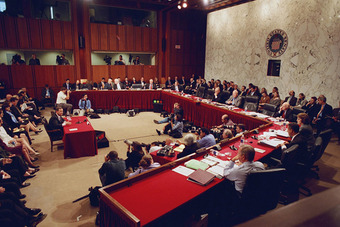
John Roberts Confirmation Hearings
Under the Constitution, the Senate have advice and consent on any nominations made by the President to the Supreme Court of the United States. Here, the Senate Judiciary Committee confirmation hearings of John Roberts to be Chief Justice of the Supreme Court of the United States, 2005.
The principle of checks and balances allows branches of government to be isolated from each other so that no branch has total power over all functions of government. As such, an attack on or abuse of power by individuals of a single branch will not lead to tyranny or the fall of the entire government. The judicial branch, however, holds the potential to nullify laws approved by the legislative branch, disregard the executive branch, and, (in essence) control the rule of law in the United States in accordance to the opinions of its sitting justices.
11.6: Congressional Elections
11.6.1: Eligibility of Congressmen
Sections 2 and 3 of Article 1 of the Constitution describe the qualifications for membership in the House of Representatives and the Senate.
Learning Objective
Compare the qualifications for membership in the House and Senate
Key Points
- The Senate has 100 members, elected for six year terms in dual-seat constituencies, two from each state. One-third are renewed every two years. The group of the Senate seats that is up for election during a given year is known as a class.
- The House of Representatives has 435 members, elected for two year terms in single-seat constituencies. House of Representatives elections are held every two years on the first Tuesday after November 1 in even years, correlated with presidential elections..
- Article I, Section 2 of the Constitution sets three qualifications for representatives. Each representative must (1) be at least twenty-five years old, (2) have been a citizen of the United States for the past seven years, and (3) be an inhabitant of the state they represent.
- The constitutional requirements of Article I, Section 2 for election to Congress are the maximum requirements that can be imposed on a candidate.
- Article I, Section 3 of the Constitution sets three qualifications for senators: (1) they must be at least 30 years old, (2) they must have been citizens of the United States for at least the past nine years, and (3) they must be inhabitants of the states they seek to represent.
- The Fourteenth Amendment to the United States Constitution disqualifies from the Senate any federal or state officers who had taken the requisite oath to support the Constitution, but later engaged in rebellion or aided the enemies of the United States.
Key Terms
- u.s. house of representatives
-
The U.S. House of Representatives has 435 members, elected for two year terms in single-seat constituencies. House of Representatives elections are held every two years on the first Tuesday after November 1 in even years, correlated with presidential elections. House elections are first-past-the-post elections that elect a Representative from each of 435 House districts which cover the United States.
- delegate
-
A person authorized to act as representative for another; in politics, a party representative allocated to nominate a party candidate.
- u.s. senate
-
The U.S. Senate has 100 members, elected for six year terms in dual-seat constituencies, two from each state. One-third are renewed every two years.
Example
- The Senate is the sole judge of a senator’s qualifications. During its early years, however, the Senate did not closely scrutinize the qualifications of its members. As a result, three senators who failed to meet the age qualification were nevertheless admitted to the Senate: Henry Clay (aged 29 in 1806), Armistead Thomson Mason (aged 28 in 1816), and John Eaton (aged 28 in 1818). Such an occurrence, however, has not been repeated since. In 1934, Rush D. Holt, Sr. was elected to the Senate at the age of 29; he waited until he turned 30 (on the following June 19) to take the oath of office. In 1972, Joe Biden was elected to the Senate shortly before his 30th birthday, but he reached his 30th birthday in time for the swearing-in ceremony for incoming senators in January 1973.
Introduction
The U.S. Senate has 100 members, elected for six year terms in dual-seat constituencies, two from each state. One-third are renewed every two years. The group of the Senate seats that is up for election during a given year is known as a class. The three classes are staggered so that only one of the three groups is renewed every two years. Until the Seventeenth Amendment to the Constitution in 1913, Senators were elected by state legislatures, not the electorate of states. The age of candidacy to be a Senator is 30.
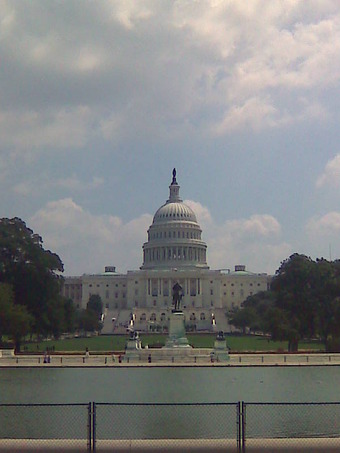
Capitol Hill
Capitol Hill, where bills become laws.
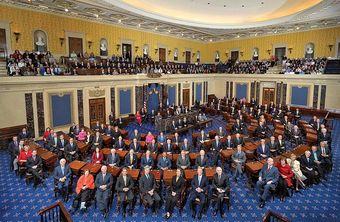
111th US Senate class photo
A class photo of the 111th United States Senate.
The U.S. House of Representatives has 435 members, elected for two year terms in single-seat constituencies. House of Representatives elections are held every two years on the first Tuesday after November 1 in even years, correlated with presidential elections. House elections are first-past-the-post elections that elect a Representative from each of 435 House districts which cover the United States. Special House elections can occur if a member dies or resigns during a term . The delegates of the territories of American Samoa, District of Columbia, Guam, the Northern Mariana Islands, Puerto Rico, and the U.S. Virgin Islands are also elected. The age of candidacy to be a Representative is 25.
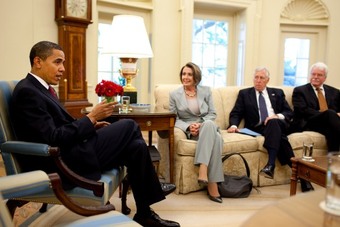
Barack Obama meets with Nancy Pelosi, Steny Hoyer & George Miller
President Barack Obama meets with Speaker Nancy Pelosi, House Majority Leader Steny Hoyer, and House Education and Labor Committee Chair Rep. George Miller, in the Oval Office Wednesday, May 13, 2009. House Energy and Commerce Committee Chair Rep. Henry Waxman, and House Ways and Means Committee Chair Rep. Charlie Rangel also attended the meeting but are not in the photo.
Qualifications in the House
Article I, Section 2 of the Constitution sets three qualifications for representatives. Each representative must (1) be at least twenty-five years old, (2) have been a citizen of the United States for the past seven years, and (3) be (at the time of the election) an inhabitant of the state they represent. Members are not required to live in the district they represent, but they traditionally do. The age and citizenship qualifications for representatives are less than those for senators. The constitutional requirements of Article I, Section 2 for election to Congress are the maximum requirements that can be imposed on a candidate. Therefore, Article I, Section 5, which permits each House to be the judge of the qualifications of its own members does not permit either House to establish additional qualifications. Likewise a State cannot establish additional qualifications.
Qualifications in the Senate
Article I, Section 3 of the Constitution sets three qualifications for senators: (1) they must be at least 30 years old, (2) they must have been citizens of the United States for at least the past nine years, and (3) they must be inhabitants of the states they seek to represent at the time of their election. The age and citizenship qualifications for senators are more stringent than those for representatives. In Federalist No. 62, James Madison justified this arrangement by arguing that the “senatorial trust” called for a “greater extent of information and stability of character. “
The Senate is the sole judge of a senator’s qualifications. During its early years, however, the Senate did not closely scrutinize the qualifications of its members. As a result, three senators who failed to meet the age qualification were nevertheless admitted to the Senate: Henry Clay (aged 29 in 1806), Armistead Thomson Mason (aged 28 in 1816), and John Eaton (aged 28 in 1818). Such an occurrence, however, has not been repeated since. In 1934, Rush D. Holt, Sr. was elected to the Senate at the age of 29; he waited until he turned 30 (on the following June 19) to take the oath of office. In 1972, Joe Biden was elected to the Senate shortly before his 30th birthday, but he reached his 30th birthday in time for the swearing-in ceremony for incoming senators in January 1973.
It is important to mention disqualification procedures in Congress. Under the Fourteenth Amendment, a federal or state officer who takes the requisite oath to support the Constitution, but later engages in rebellion or aids the enemies of the United States, is disqualified from becoming a representative. This post-Civil War provision was intended to prevent those who sided with the Confederacy from serving. However, disqualified individuals may serve if they gain the consent of two-thirds of both houses of Congress.
11.6.2: The Power of Incumbency
The incumbent is the existing holder of a political office who normally has a structural advantage over challengers during an election.
Learning Objective
Summarize the advantages the incumbents have in campaigns
Key Points
- The incumbent is the existing holder of a political office who normally has a structural advantage over challengers during an election for multiple reasons.
- A race without an incumbent is known as an open seat because of the lack of incumbency advantage and they are the most contested races in an election.
- The anti-incumbency factor is when incumbency leads to the downfall of the incumbent.
- An anti-incumbent vote is one exercised against elected officials currently in power.
Key Terms
- incumbency
-
the state of holding an office or title
- reapportionment
-
Reassignment of representation in a legislature, especially of U.S. House of Representative seats, in accord with changes in the census population determination.
The incumbent is the existing holder of a political office. It is usually used in reference to elections where races can often be defined as being between an incumbent and non-incumbents. Incumbents have structural advantages over challengers during elections. The percentage of incumbents who win reelection after seeking it in the U.S. House of Representatives has been over 80% for more than 50 years, and is often over 90%. Additionally, shifts in congressional districts due to reapportionment or other longer-term factors may make it more or less likely for an incumbent to win re-election over time. A race without an incumbent is referred to as an open seat because of the lack of incumbency advantage and they are the most contested races in an election.
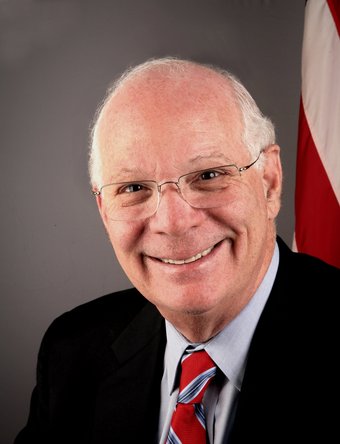
Longtime House Incumbent, Ben Cardin
Current Senator Ben Cardin was a longtime incumbent in the House of Representatives, serving from 1987 to 2007.
When newcomers vie to fill an open office, voters tend to compare and contrast the candidates’ qualifications, positions on issues and personal characteristics in a relatively straightforward way. Incumbents traditionally win their party’s nomination to run for office and unseating an incumbent during a primary elections is very difficult. The timing of elections may be determined by the incumbent instead of a set schedule. The incumbent often has more name recognition because of their previous work in the office they occupy. Incumbents have easier access to campaign finance and government resources that can be indirectly used to boost a campaign.
In general, incumbents have structural advantages over challengers during elections. The timing of elections may be determined by the incumbent instead of a set schedule. For most political offices, the incumbent often has more name recognition due to their previous work in the office. Incumbents also have easier access to campaign finance, as well as government resources (such as the franking privilege) that can be indirectly used to boost a campaign. An election (especially for a legislature) in which no incumbent is running is often called an open seat; because of the lack of incumbency advantage, these are often amongst the most hotly contested races in any election.
In the United States, incumbents traditionally win their party’s nomination to run for office. Unseating an incumbent president, senator or other figure during a primary election is very difficult, and even in the general election, incumbents have a very strong record. For instance, the percentage of incumbents who win reelection after seeking it in the U.S. House of Representatives has been over 80% for over 50 years, and is often over 90%.
However, there exist scenarios in which the incumbency factor itself leads to the downfall of the incumbent. Popularly known as the anti-incumbency factor, situations of this kind occur when the incumbent has proven himself not worthy of office during his tenure and the challenger demonstrates this fact to the voters. An anti-incumbent vote is one exercised against elected officials currently in power. It allows the voters to register their discontent with sitting government officials, particularly when protesting against certain actions taken by the government or the elected officials in question. An anti-incumbency factor can also be responsible for bringing down incumbents who have been in office for many successive terms in spite of performance indicators, simply because the voters are convinced by the challenger of a need for change. Nick Panagakis, a pollster, coined what he dubbed the “incumbent rule” in 1989—that any voter who claims to be undecided towards the end of the election will probably end up voting for the challenger.
Voters first have to consider the records and antecedents of the incumbent. Only if they decide to “fire” the incumbent do they begin to evaluate whether the challenger is an acceptable alternative. At the same time, if the challenger is determined to be completely unacceptable, voters might reluctantly vote for the incumbent. There are situations in which the incumbency factor leads to the downfall of the incumbent. This is known as the anti-incumbency factor. Situations of this kind occur when the incumbent has proven himself unworthy of the office during his tenure and the challenger convincingly demonstrates this fact to the voters. An anti-incumbency factor can also be responsible for voting out incumbents who have been in office for many successive terms in spite of performance indicators, simply because the voters are convinced by the challenger of a need for change.
11.6.3: Congressional Terms and Term Limits
Members of the Senate may serve unlimited six-year terms and members of the House may serve unlimited two-year terms.
Learning Objective
Summarize the attempts to impose term limits on Senators and Representatives
Key Points
- Under the Constitution, members of the United States Senate may serve an unlimited number of six-year terms and members of the House of Representatives may serve an unlimited number of two-year terms.
- In the 1990s, reformers put congressional term limits on the ballot and the main Republican Party platform was to pass legislation setting term limits in Congress.
- A proposed amendment limited members of the Senate to two six-year terms and members of the House to six two-year terms. The amendment was never passed.
Key Terms
- amendment
-
An addition to and/or alteration to the Constitution.
- referendum
-
A direct popular vote on a proposed law or constitutional amendment.
Congressional Terms and Term Limits
Under the Constitution, members of the United States Senate may serve an unlimited number of six-year terms and members of the House of Representatives may serve an unlimited number of two-year terms.

Capitol Hill
Capitol Hill, or the Capitol Building, houses the United States Congress.
Reformers during the early 1990s used referendums to put congressional term limits on the ballot in 24 states. Voters in eight of these states approved the congressional term limits by an average electoral margin of two to one. In the elections of 1994, part of the Republican platform was to pass legislation setting term limits in Congress. After winning the majority, they brought the constitutional amendment to the House floor. The amendment limited members of the Senate to two six-year terms and members of the House to six two-year terms. However, constitutional amendments require a two-thirds majority and the votes to impose term limits on Congress fell short of that number.
In May 1995, the United States Supreme Court ruled 5-4 in U.S. Term Limits, Inc. v. Thornton (1995). The ruling says that states cannot impose term limits on their federal Representatives or Senators. The U.S. Term Limits was the largest private organization pushing for Congressional term limits. Earlier that year, the Congress had given the Court assurance that the Justices would be acting only against state statutes, not overturning an act of Congress.The hopes of some that Congress would self-impose term limits had abruptly come to an end.
With the Republicans holding 230 seats in the House, three versions of the amendment got well under 200 votes, while the 12 year term-limits managed a bare majority in the House of 227-204, well short of the requisite two-thirds majority (290 votes) required to pass a constitutional amendment. Defeated in Congress and overridden by the Supreme Court, this populist uprising was brought to a halt for the purpose of reforming the federal government. The term limits intended simultaneously to reform legislatures remain in fifteen states.
In 2007, Professor Larry J. Sabato revived the debate over term limits by arguing in A More Perfect Constitution that the success and popularity of term limits at the state level suggests that they should be adopted at the federal level as well. He specifically put forth the idea of congressional term limits and suggested a national constitutional convention be used to accomplish the amendment, since the Congress would be unlikely to propose and adopt any amendment that limits its own power.
11.6.4: Candidates for Congressional Elections
Congressional elections determine the structure and makeup of the House of Representatives and Senate.
Learning Objective
Describe the relationship between House elections and the Presidential term cycle
Key Points
- The House of Representatives has 435 members, elected for a two year term in single-seat constituencies. House of Representatives elections are held every two years on the first Tuesday after November 1 in even years.
- House elections occur every two years, correlated with presidential elections or halfway through a President’s term. Typically, when a House election occurs in the same year as a presidential election, the party of the presidential winner will gain seats.
- An increasing trend has been for incumbents to have an overwhelming advantage in House elections, and since the 1994 election, an unusually low number of seats has changed hands in each election.
- The Senate has 100 members, elected for a six year term in dual-seat constituencies (2 from each state), with one-third being renewed every two years.
- Elections to the Senate are held on the first Tuesday after the first Monday in November in even-numbered years, Election Day, and coincide with elections for the House of Representatives. Senators are elected by their state as a whole.
Key Terms
- senate
-
The composition and powers of the Senate are established in Article I of the U.S. Constitution. Each U.S. state is represented by two senators, regardless of population. Senators serve staggered six-year terms. The chamber of the United States Senate is located in the north wing of the Capitol, in Washington, D.C., the national capital.
- house of representatives
-
The United States House of Representatives is one of the two houses of the United States Congress. The major power of the House is to pass federal legislation that affects the entire country, although its bills must also be passed by the Senate and further agreed to by the U.S. President before becoming law.
Example
- Due to gerrymandering, fewer than 10% of all House seats are contested in each election cycle. Over 90% of House members are reelected every two years, due to lack of electoral competition.
Congressional elections
Elections to Congress take place every two years. Congress has two chambers in Capitol Hill . Although the two-party system preserves the dominance of the Republican and Democratic parties, there is no direct relationship between congressional party discipline and election years. The support and backing of the parties is not necessary and sufficient to win elections. However, candidates no longer have a congressional party discipline like in other historical times.
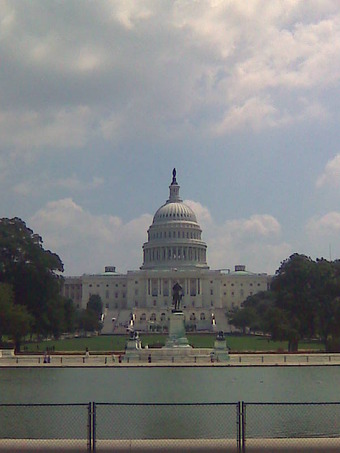
Capitol Hill
Capitol Hill, where bills become laws.
Senate elections
The Senate has 100 members, elected for a six year term in dual-seat constituencies (2 from each state), with one-third being renewed every two years. The group of the Senate seats that is up for election during a given year is known as a “class”; the three classes are staggered so that only one of the three groups is renewed every two years. Until the Seventeenth Amendment to the United States Constitution in 1913, Senators were elected by state legislatures, not the electorate of states.
Originally, senators were selected by the state legislatures, not by popular elections. By the early years of the 20th century, the legislatures of as many as 29 states had provided for popular election of senators by referendums. Popular election to the Senate was standardized nationally in 1913 by the ratification of the 17th Amendment.
Elections to the Senate are held on the first Tuesday after the first Monday in November in even-numbered years, Election Day, and coincide with elections for the House of Representatives. Senators are elected by their state as a whole. In most states, a primary election is held first for the Republican and Democratic parties, with the general election following a few months later. Ballot access rules for independent and minor party candidates vary from state to state. The winner is the candidate who receives a plurality of the popular vote. In some states, runoffs are held if no candidate wins a majority.
House of Representatives Elections
The House of Representatives has 435 members, elected for a two year term in single-seat constituencies. House of Representatives elections are held every two years on the first Tuesday after November 1 in even years. House elections are first-past-the-post elections that elect a Representative from each of 435 House districts which cover the United States. Special House elections can occur between if a member dies or resigns during a term. The delegates of the territories of American Samoa, District of Columbia, Guam, the Northern Mariana Islands, Puerto Rico and the United States Virgin Islands are also elected.
House elections occur every two years, correlated with presidential elections or halfway through a President’s term. Typically, when a House election occurs in the same year as a presidential election, the party of the presidential winner will gain seats. On the other hand, there is a historical pattern that the incumbent president’s party loses seats in elections that are held in the middle of a presidential term. This may be because the President’s popularity has slipped since election, or because the President’s popularity encouraged supporters to come out to vote for him in the presidential election, but these supporters are less likely to vote when the President is not up for election.
As the redistricting commissions of states are often partisan, districts are often drawn which benefit incumbent . An increasing trend has been for incumbents to have an overwhelming advantage in House elections, and since the 1994 election, an unusually low number of seats has changed hands in each election. Due to gerrymandering, fewer than 10% of all House seats are contested in each election cycle. Over 90% of House members are reelected every two years, due to lack of electoral competition. Gerrymandering of the House, combined with the divisions inherent in the design of the Senate and of the Electoral College, result in a discrepancy between the percentage of popular support for various political parties and the actual level of the parties’ representation.

US House Balance OverTime
Chart shows the percentage of the United States House of Representatives held by various parties from 1789 until 2004. (as elected in the biennial elections) Occasionally terms are applied in a slightly anachronistic way, such as for Federalists and Democratic-Republicans in the first few years on the Congress, or for Whigs during Jackson’s presidency. Notable features include the near absence of minor parties, and the narrowness of the current majority by historical standards.
2016 Congressional Elections
A total of 469 seats in the U.S. Congress (34 Senate seats and all 435 House seats) are up for election on November 8, 2016.
The big questionof the 2016 congressional election cycle is whether or not the Democratic Party will be able to regain control of the Senate. In order to take the chamber back, Democrats will need to gain five seats in 2016. The majority of vulnerable seats are held by Republican incumbents, many of whom are freshmen who were swept into office in the Republican wave of 2010. Additionally, Democrats only have 10 seats to defend in 2016, while 24 Republican incumbents are up for re-election.
11.7: How Congressmen Decide
11.7.1: Political Parties
Political parties serve to coordinate, assist and provide resources for members of congress and political candidates.
Learning Objective
Describe the history of political parties and their role in Congress
Key Points
- Political parties are one of the most enduring political institutions in the US, and with recent increases in the partisan nature of congress political parties are playing a increased role in US democracy.
- There is little mention of political parties in the US constitution, or any other founding documents, and many of the country’s founder opposed political parties expecting them to be divisive.
- In congress political parties serve to coordinate, assistant and provide resources for members of congress and political candidates.
- Since the 1990s there has been a stronger control by congressional party leaders on individual members including higher rates of party voting. Members of congress now routinely vote with their party at rates as high as 60 or 70 percent.
- The increase in party power also means that bipartisan collaboration between members of congress is less likely.
Key Terms
- caucus
-
A meeting, especially a preliminary meeting, of persons belonging to a party, to nominate candidates for public office, or to select delegates to a nominating convention, or to confer regarding measures of party policy; a political primary meeting.
- bipartisan
-
relating to, or supported by two groups, especially by two political parties
- party voting
-
The type of voting that describes when voters cast their vote based on their self-identification with a particular political party.
Political Parties
Political parties are one of the most enduring political institutions in the US, and with recent increases in the partisan nature of congress political parties are playing a increased role in US democracy.
Political parties are one of the main coordinating bodies in Congress. With hundreds of individual members the party’s caucus or conference helps to bring together like-minded politicians and constituents, coordinate election efforts, set legislative priorities, and determine who will receive important committee appointments.
History of Political Parties
The Democrat and Republican parties have dominated the political landscape in the US for quite some time now. However, this has not always been the case, and the current political parties have also changed significantly over this time.
There is little mention of political parties in the US constitution, or any other founding documents. Many of the country’s founder opposed political parties, expecting them to be divisive. However, by the 1790s two parties the Federalists and Republicans had been established. These parties were separated by preferences for either a strong or weak central government.
Each of today’s major parties have made various changes throughout their existence, even as their name may have remained the same. For example it was a Republican-led congress that initiated the Civil War amendments that officially outlawed slavery in the US and gave citizenship and voting rights to formerly enslaved people and their ancestors. However, by the 1960s in was Democratic politicians who moved forward Civil Rights legislation. Today we are seeing another shift in the Republican Party with the increased influence of the Tea Party social movement within the leadership of the party.
Political Parties in Congress
In Congress political parties serve to coordinate, assistant and provide resources for members of congress and political candidates. Parties control primary elections which are the main means through which candidates can get on ballots. They also control committee appointments, and since the 1990s there has been a stronger control by congressional party leaders on individual members including higher rates of party voting. Members of congress now routinely vote with their party at rates as high as 60 or 70 percent. In addition to increasing the power of party leadership it means that bipartisan collaboration between members of congress is less likely.
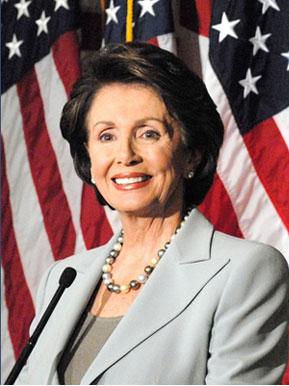
Nancy Pelosi
Nancy Pelosi is the leader of the House Democrats and the first women to be Speaker of the House.
This rise in party power also means that the experiences of members of the majority versus minority party will be quite different. Majority party members will have many positive powers to pass legislation to support their own ideology and constituencies. However, minority party members will have to rely on negative powers such as blocking legislation in committees, or using filibuster techniques.
Coalitions
To deal with a situation in which no clear majorities appear through general elections, parties either form coalition cabinets, supported by a parliamentary majority, or minority cabinets which may consist of one or more parties. Cabinets based on a coalition with majority in a parliament, ideally, are more stable and long-lived than minority cabinets. While the former are prone to internal struggles, they have less reason to fear votes of non-confidence. Majority governments based on a single party are typically even more stable, as long as their majority can be maintained.
Coalition cabinets are common in countries in which a parliament is proportionally representative, with several organized political parties represented. It usually does not appear in countries in which the cabinet is chosen by the executive rather than by a lower house, such as in the United States (however, coalition cabinets are common in Brazil). In semi-presidential systems such as France, where the president formally appoints a prime minister but the government itself must still maintain the confidence of parliament, coalition governments occur quite regularly. In the United States, political parties are best described as coalitions.
11.7.2: Constituency
Each member of Congress has a responsibility to their constituents because they decide if a congressional member will be re-elected.
Learning Objective
Identify the rules and duties of members of Congress while they are in office, and the factors that shape how they vote on bills
Key Points
- Each member of the U.S. Congress is elected by voters in their home district. These voters are members of Congress’ constituency.
- Each member has a special responsibility to their constituents because these are the only voters who get to decide if a congressional member will be re-elected.
- Districts are reevaluated after each 10 year census and redrawn as needed to adjust to population changes. However, this is not a completely neutral process. The practice of gerrymandering has been used to insure that one party or the other will have an easier time winning elections.
- All members of Congress maintain constituency offices which are home bases where staff can keep in touch with local concerns, activists, and interests.
- Members of Congress also attempt to maintain support with constituency members by using their influence in Congress to gain support for local projects such as new, lucrative construction projects.
Key Terms
- pork barrel
-
The appropriation of government spending for localized projects secured solely or primarily to bring money to a representative’s district
- gerrymandering
-
The practice of redrawing electoral districts to gain an electoral advantage for a political party.
Constituency
Each member of the U.S. Congress is elected by voters in their home district. These voters are a part of congress’ constituency. Each congressional member has a special responsibility to their constituents because these are the only voters who get to decide if a member will be re-elected.
Models of Representation: The Delegate vs. Trustee Model
Representatives can act in two models of representation: as delegates or trustees. The delegate model of representation is a model of a representative democracy. In this model, constituents elect their representatives as delegates for their constituency. These delegates act only as a mouthpiece for the wishes of their constituency, and have no autonomy from the constituency. This model does not provide representatives the luxury of acting in their own conscience. Essentially, the representative acts as the voice of those who are (literally) not present.
On the other hand, the trustee model of representation is a model for how we should understand the role of representatives, and is frequently contrasted with the delegate model of representation. Constituents elect their representatives as ‘trustees’ (or ‘entrust’ them) for their constituency. These ‘trustees’ have sufficient autonomy to deliberate and act in favor of the greater common good and national interest, even if it means going against the short-term interests of their own constituencies. The model provides a solution to the problem of uninformed constituents who lack the necessary knowledge on issues to take an educated position. By contrast in the delegate model, the representative is expected to act strictly in according to a mandate from the represented.
House of Representatives Districts
Members of the House of Representatives are elected to represent districts that range in size from the 905,316 people representing the entire state of Montana to 495,304 which represents the entire state of Wyoming. Most states have multiple representatives.
Districts are generally reevaluated after each 10 year census. The districts are redrawn as needed to adjust to population changes. However, this is not a completely neutral process. The practice of gerrymandering has been used to insure that one or the other party will have an easier time winning elections by creating districts that hold a majority of voters likely to vote for one party or the other. Looking at the maps of congressional districts it is obvious that some districts are far from uniform. The more complicated shapes on the map might be a result of gerrymandering.
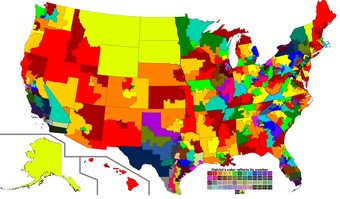
U.S. Congress House Districts
This map shows the boundaries for the U.S. Congress housing districts.
Senate Seats
U.S. Senators simply represent their states. There are two senators per state. Therefore, the constituency in smaller states such as Wyoming might be able to gain disproportionate influence.
Local Concerns
All members of congress maintain constituency offices, which are home bases where staff can keep in touch with local concerns, activists, and interests. Members of Congress will pay a great deal of attention to their constituency’s concerns. Congressional members will often attempt to maintain support with constituency members through practices such as pork barrel politics. This practice is when members will use their influence in Congress to gain support for local projects such as new lucrative construction projects.
11.7.3: Interest Groups, Lobbyists, and PACs
Interest groups attempt to influence Members of Congress in a variety of ways, such as lobbying and financing campaigns using PACs.
Learning Objective
Describe how outside groups work to shape policy at the federal level through the use of interest groups, lobbyists, and PACs.
Key Points
- Interest group represent people or organizations with common concerns and interests. These groups work to gain or retain benefits for their members, through advocacy, public campaigns, and even lobbying governments to make changes in public policy.
- Interest groups may take on a variety of strategies including public education, encouraging public participation, and providing education and special information for civil servants and politicians.
- Interest groups are also involved in actives such as lobbying to directly persuade decision makers in Congress along with members of the executive branch.
- PACs are organized groups that work on election campaigns both for specific parties and ballot initiatives. These groups pool donations to redistribute to candidates, parties and other PACs.
- Super PACs can also spend unlimited amounts of money advocating for or against a candidate or issue, but may not donate to, or coordinate with, a particular campaign.
Key Term
- lobbyist
-
A person remunerated to persuade (to lobby) politicians to vote in a certain way or otherwise use their office to effect a desired result.
Interest Groups, Lobbyists, and PACs
Interest groups represent people or organizations with common concerns and interests. These groups work to gain or retain benefits for their members through advocacy, public campaigns, and lobbying governments to make changes in public policy. There are a wide variety of interest groups representing a variety of constituencies including business, labor, consumers, other governments, and various single issue groups.
Interest groups may take on a variety of strategies including public education, encouraging public participation, and providing education and special information for civil servants and politicians. However, interest groups are also involved in activities such as lobbying and forming PACs, which has led to concerns that some groups and even individuals might have disproportionate influence on Congress.
Lobbyists
There are over twelve thousand registered lobbyists in Washington, but only a handful of those have the influence and connections needed to consistently influence policy. Lobbyists work for a wide variety of groups, ranging from individual companies and non-profit organizations, to other governments and large coordinated councils representing whole industries, labor movements, or consumers. Lobbyists work to directly persuade decision makers in Congress along with members of the executive branch.
The impact of lobbyists is unclear, but many believe they can influence public policy. One example is the strength and influence of the National Rifle Association (NRA), who are advocates for gun rights. They also oppose gun regulations and legislation that infringe on the privacy of gun owners in the United States, who has one of the most lenient gun regulations in the Global North.
Political Action Committees (PACs)
PACs are organized groups that work on election campaigns often on behalf of specific parties and ballot initiatives. These groups pool donations to redistribute to candidates, parties, and other PACs. Federal Election Commission (FEC) regulations limit the amount of money PACs can donate to any one campaign or party, and there are limits to the amount of money they can receive from any one donor.
PACs can be connected to existing organizations such as business, labor or trade organizations or non-connected, usually rallying around a single issue or ideology.
While PACs have existed since the 1940s, the 2010 SpeechNow.org v. Federal Election Commission decision of the Supreme Court created a new form of PAC. They are officially known as independent expenditure-only committees, but better known as Super PACs . These groups can raise money without limits in from individuals, organizations, and large donors such as corporations or labor unions. Super PACs can also spend unlimited amounts of money advocating for or against a candidate or issue, but may not donate to, or coordinate with, a particular campaign.
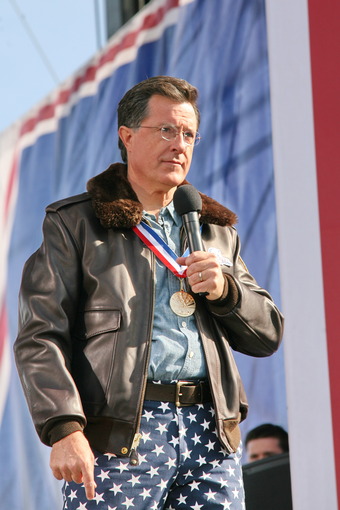
Stephen Colbert
Political satirist Stephen Colbert has started his own Super PAC to draw attention to these organizations.
The SpeechNow.org case built on the decision in the Citizens United v. Federal Election Commission case earlier in 2010, which held that the First Amendment right to free speech meant that legislatures could not limit independent political spending by corporations and unions.
The 2012 election cycle is the first presidential election to be held under the new rules. Before the campaigns even ended, the Super PACs had outspent the top ten PACs from 2008 by at least tenfold. A large majority of Super PAC donations also come from wealthy individual donors. By October 2012, the top 100 individual Super PAC donors donated 80% of all Super PAC funds, yet made up fewer than 4% of all donors.
Information and Watchdogs
Critics of Super PACs are concerned that these groups can, in effect, “buy” elections. If elected, the candidates may then feel a special obligation to these wealthy donors and organizations. Several groups now exist to track the connections between Members of Congress, lobbyists, and campaign financing. Some of these groups include the Center for Responsive Politics and the OpenCongress.org website.
11.7.4: Switching Parties
Though uncommon, a member of Congress switch parties for either ideological or pragmatic reasons.
Learning Objective
List several well-known cases of senators switching parties
Key Points
- Political parties provide various benefits to Members of Congress and so it is fairly uncommon for a Member of Congress to cross over parties.
- Some Members might cross over due to ideological differences with their party, or more pragmatic reasons such as power gain or reelection in the Senate.
- Various politicians who have crossed parties have found both success and failure.
Key Term
- primary
-
A primary election; a preliminary election to select a political candidate of a political party.
Crossing Over of Parties
Political Parties provide various benefits to Members of Congress, including some election support, support in Congress, and positions on various committee. Political parties also serve as ideological homes for Members, and voters are often more attached to a party than to any given candidate. For these reasons, it is fairly uncommon for a Member of Congress to cross over parties, but it is not unheard of.
A member might switch parties, or “cross the floor,” for a number of reasons. Some members might switch due to ideological differences with their party. This was the case with Senator Strom Thurmond who, in 1964, switched from the Democratic to Republican party in opposition to the Civil Rights Bills. Others switch for more pragmatic reasons, such as to gain more power in Congress or to gain reelection. Richard Shelby, a relatively conservative Democrat Senator switched to the Republican Party in 1994 after they gained a majority in the Senate, and went on receive high profile committee appointments.
Crossing over can cause difficulties. For example, when Ben Nighthorse Campbell crossed to the Republican party after being elected as a Democratic Senator, much of his Congressional staff quit. Others who have crossed over have found success: Senator Joe Lieberman served as a Democrat and even ran as the Democratic Vice Presidential nominee in 2000, but after losing the Democratic primary in his home state of Connecticut, ran and was elected as an Independent. He eventually supported the 2008 Republican presidential ticket.
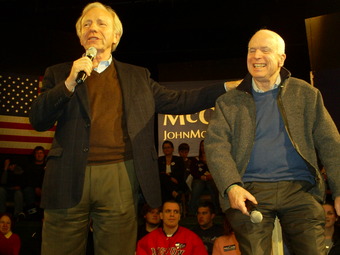
Joe Lieberman and John McCain
Senator Lieberman was a Democrat, then crossed over as an Independent, then endorsed a Republican presidential candidate.
12: The Presidency
Chapter 10: The Media
10.1: The Role of the Media in Politics
10.1.1: Types of Media
Media in the United States has taken multiple forms and grown in power due to its for-profit nature.
Learning Objective
Evaluate the claim that press freedom is compromised by increasing consolidation in the media industry
Key Points
- Media in the United States has taken several forms, including television, film, radio and blogs.
- Media frequently gains power through its support from large corporations, and is often criticized by the public for such alliances.
- Reporters Without Borders publishes a yearly ranking on the level of free media in each country.
Key Term
- blog
-
A website that allows users to reflect, share opinions, and discuss various topics in the form of an online journal while readers may comment on posts. Most blogs are written in a slightly informal tone (personal journals, news, businesses, etc. ) Entries typically appear in reverse chronological order.
Media in the United States comprises several different types of widespread communication: television, radio, cinema, newspapers, magazines, and Internet-based websites (especially blogs). Many of these networks are controlled by large, for-profit corporations that reap revenue from advertising, subscriptions, and the sale of copyrighted material. American media conglomerates tend to be leading global players, generating substantial revenue, not to mention fierce opposition in many parts of the world. Further deregulation and convergence are under way, suggesting more mega-mergers, greater concentration of media ownership, and the emergence of multinational media conglomerates. Critics allege that localism (local news and other content at the community level), media spending and coverage of news, and diversity of ownership and represented views have suffered as a result of such processes.
Theories on the success of such companies note a reliance on certain policies of the American federal government as well as a natural tendency to produce monopolies in the industry. Many prominent news organizations such as CBS, ABC, and Fox News are often criticized for creating political and corporate monopolies to boost popularity.
The organization Reporters Without Borders compiles and publishes an annual ranking of countries based on its assessment of their press freedom records . A smaller score on the index corresponds to greater freedom of press. Reporters Without Borders is careful to note that the index only addresses press freedom and does not measure the quality of journalism. In 2011-12 the United States was ranked 47th out of 179 countries, which was a setback from the preceding year.
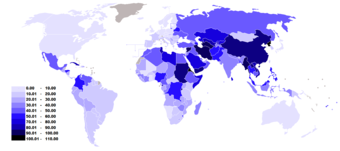
2010 Press Freedom Index Scores
These countries have been ranked on their freedom-of-press laws. A smaller score on the index correspondes to great freedom of press. The United States has a score of 47.
10.1.2: Regulation of Broadcast Media
Broadcasting media has been regulated since the 1920s to ensure balanced and fair coverage, along with coverage of relevant, local issues.
Learning Objective
Summarize key developments in the history of broadcasting law
Key Points
- The FCC was created in 1934 to regulate laws about broadcasting on the public airwaves.
- By 1949, the Fairness Doctrine ensured that networks had to cover opposing perspectives on controversial issues.
- The Reagan Administration tried to eliminate the Fairness Doctrine, but the policy is still in effect today.
Key Term
- broadcasting
-
transmitting, sending out messages omnidirectionally
In the United States, freedom of press does not necessarily mean an unregulated media.
Some of the more notable aspects of broadcast law include:
- frequency allocation: The division of the spectrum into unlicensed frequency bands, such as ISM band and U-NII band, and licensed frequency bands, along with television channel frequencies, FM broadcast band, and amateur radio frequency.
- low-power broadcasting
- Fairness Doctrine
- public broadcasting
Today, broadcasting rights fall under the jurisdiction of the Federal Communications Commission (FCC), but other legislations set the precedent for this modern day law.
The History of Broadcasting Law
The Radio Act of 1927 was the first major broadcasting law in the country. Among its provisions was the equal opportunity provision, which provided a foundation for the equal time rule. This provision required radio stations, television stations and cable systems, which originated their own programming, to treat legally qualified political candidates equally when it came to selling or giving away air time. This provision was a result of legislators’ growing concerns that, without mandated equal opportunity for candidates, some broadcasters might try to manipulate elections.
The Communications Act of 1934 amended the Radio Act, and the equal time provision is located in Section 315 of the Communications Act. This act was another crucial moment in broadcasting law history, because it created the Federal Communications Commission (FCC, ). The FCC’s intent was to “regulat[e] interstate and foreign commerce in communication by wire and radio so as to make available, so far as possible, to all the people of the United States, without discrimination on the basis of race, color, religion, national origin, or sex, a rapid, efficient, Nation wide, and world wide wire and radio communications service . . . “. (In this context, the word “radio” covers both broadcast radio and television). The FCC has the authority to “make such regulations not inconsistent with law as it may deem necessary to prevent interference between stations and to carry out the provisions of [the] Act. “
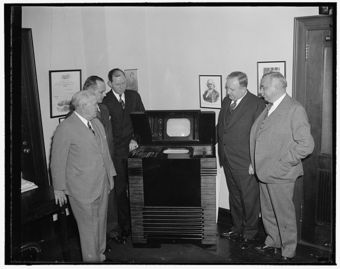
FCC Commissioners inspect the latest in television (1939).
The Federal Communications Commission (FCC) has promised to ensure fairness in broadcasting.
In 1949, the FCC enacted the Fairness Doctrine for the purpose of ensuring balanced and fair coverage of all controversial issues by a broadcast station. The FCC adopted the view that station licensees were “public trustees,” and therefore, had an obligation to broadcast contrasting viewpoints on controversial issues of public importance. It was later established that stations should also actively seek out issues of importance to their community and air programming about those issues. During the 1980s, the Reagan Administration pressured the FCC to eliminate the Fairness Doctrine, but was unsuccessful in its attempts.
10.1.3: Organization and Ownership of the Media
Media consolidation has resulted in fewer companies owning more media sources, thereby increasing the concentration of ownership.
Learning Objective
Discuss the recent history of media consolidation
Key Points
- In the United States, movies have experienced conglomerate ownership since the early twentieth century, but just recently have news and broadcasting in the United States started to experience it.
- The Telecommunications Act of 1996 allowed for cross media, and since then Clear Channel Telecommunications have acquired many radio stations.
- The twentieth century has also seen many forms of media merging.
Key Term
- conglomerate
-
A corporation formed by the combination of several smaller corporations whose activities are unrelated to the corporation’s primary activity. <!–<span style=”font-variant:small-caps;text-transform:lowercase”>example:</span> General Electric Company.–>
Concentration of media ownership, also known as media consolidation or media convergence, is a process whereby progressively fewer individuals or organizations control increasing shares of the mass media. Contemporary research demonstrates increasing levels of consolidation, with many media industries already highly concentrated and dominated by a very small number of firms. Over the years there have been many merger attempts, some successful, and others unsuccessful. Over time the amount of media merging has increased and the amount of media outlets have increased. This means that there are fewer companies owning more media sources, thereby increasing the concentration of ownership.
Examples of Media Mergers and their Potential Effect
In the United States, media consolidation has been in effect since the early twentieth century with major studios dominating movie production. Before that, there was a period in which Edison monopolized the industry. The music and television industries recently witnessed cases of media consolidation when SONY Music Entertainment’s parent company merged their music division with Bertelsmann AG’s BMG to form Sony BMG. TimeWarner’s The WB and CBS Corp’s UPN also merged to form The CW. In the case of Sony BMG, there was a “Big Five” (now “Big Four”) conglomerate of major record companies, while The CW’s creation was an attempt to consolidate ratings and stand up to the “Big Four” of American television (this was despite the fact that The CW was, in fact, partially owned by CBS, one of the “Big Four”). In television, the vast majority of broadcast and basic cable networks, over a hundred in all, are controlled by nine corporations: News Corporation (the Fox family of channels), The Walt Disney Company (which includes the ABC, ESPN and Disney brands), CBS Corporation, Viacom, Comcast (which includes the NBC brands), Time Warner, Discovery Communications, EW Scripps television, or some combination thereof (including the aforementioned The CW as well as A&E networks, which is a consortium of Comcast and Disney, ).

Walt Disney Studies
Walt Disney is a major media conglomerate.
Another example occurred in 1999, when Viacom made CBS an offer of $37 billion to buy them out. This buyout caused a lot of hype and many people were worried that this merge would decrease diversity and the quality of journalism because of the increased political influence.
There are also some large-scale owners in an industry that are not the causes of monopoly or oligopoly. For example, Clear Channel Communications, especially since the Telecommunications Act of 1996, acquired many radio stations across the United States, and came to own more than 1,200 stations. However, the radio broadcasting industry in the United States and elsewhere can be regarded as oligopolistic regardless of the existence of such a player. Because radio stations are local in reach, each station licenses a specific part of spectrum by the FCC in a certain local area, any local market is served by a limited number of stations. In most countries, this system of licensing makes many markets local oligopolies. The similar market structure exists for television broadcasting, cable systems, and newspaper industries, all of which are characterized by the existence of large-scale owners. Concentration of ownership is often found in these industries.
10.1.4: Nationalization of the News
While local news is still available, it is becoming increasingly nationalized and local outlets are being purchased larger, national networks.
Learning Objective
Describe the phenomena associated with the nationalization of the news
Key Points
- Local channels are facing challenges such as the advent of new technology and a competitive market.
- Bigger networks are able to use the technology needed to provide fast-paced news.
- ABC News, NBC News, and CBS News are three examples that are buying out local markets.
Key Term
- cable
-
(communications) A system for receiving television or Internet service over coaxial or fibreoptic cables
Nationalization of the news refers to the modern phenomenon of the decline of local news networks and the increase in power of national news networks. A few factors are contributing to this trend, including the pressure in generating new and fresh content and the increasing power of conglomerates.
The internet age, digital cable and satellite broadcast have prservices, comes on-demand news programming. News operations have begun to feel the burden of needing to generate news content on a 24-hour news cycle, while keeping material fresh on their regularly scheduled newscasts. This means around-the-clock coverage. Rather than having a certain deadline for scheduled newscasts to meet, reporters have to file stories as fast as they can. Producers, on the other hand, have to find more ways to keep news stories “fresh” to viewers. The larger networks like ABC News , NBC News, and CBS News are able to afford these technologies and are beginning to buy out the smaller, local networks.

ABC News
ABC News is an example of a large networks “buying out” smaller ones.
In the early days, local newscasts were seen more as a public service. The style was straightforward. For instance, a newscast was divided into three blocks: news, sports, and weather. The news block was divided into local, national and international stories. Modern day news is now seen as a competition, and the stations must compete for relevance in the local market.
10.1.5: Agenda-Setting Theory
Agenda-setting is a psychological process whereby the media continuously covers an issue so viewers think its a top-priority issue.
Learning Objective
Summarize the results of the key “Chapel Hill” study of the media and public opinion
Key Points
- Drs. McCombs and Shaw did a study based on the 1968 election and discovered the correlation between what news viewers watched and their perception of important events.
- Mass communication is defined as the process whereby professional communicators use technological devices to share messages over great distances to influence large audiences.
- The theory of accessibility states that the more the media plays a story, the more accessible that story is to the viewer’s mind.
Key Term
- agenda setting
-
A theory in mass-communication stating that the media have the ability to determine which issues are important to the public.
Agenda-Setting Theory
Agenda-setting theory describes the “ability [of the news media] to influence the salience of topics on the public agenda. ” That is, if a news item is covered frequently, the audience will regard the issue as more important . In reality, mass media only shows the audience what it comprehends as an important issue. Print or broadcast news will then take away the audience’s ability to think for themselves.
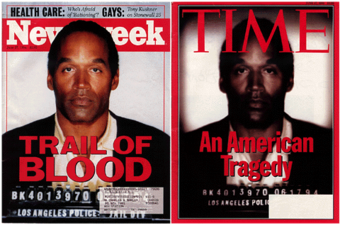
OJ Simpson
Media experts contend that the OJ Simpson case was a prime example of media agenda-setting. It captivated the country–and news outlets–for years.
Agenda-setting theory was formally developed by Dr. Max McCombs and Dr. Donald Shaw in a study on the 1968 presidential election. In the 1968 “Chapel Hill study,” McCombs and Shaw demonstrated a strong correlation between what 100 residents of Chapel Hill, North Carolina, thought was the most important election issue and what the local and national news media reported was the most important issue. By comparing the salience of issues in news content with the public’s perceptions of the most important election issue, McCombs and Shaw determined the degree to which the media sways public opinion.
Agenda-setting is the media’s ability to transfer salience issues through their new agenda. This way, the public agenda can form an understanding of the salience issues. Two basic assumptions underlie most research on agenda-setting: (1) the press and the media do not reflect reality; they filter and shape it; (2) media concentration on a few issues and subjects leads the public to perceive those issues as more important than other issues.
Before they attain the presidency status, Presidents are nominees for their own party. Nominees participate in nationally televised debates, and while the debates are usually restricted to the Democratic and Republican nominees, third party candidates may be invited, such as Ross Perot in the 1992 debates. Nominees campaign across the country to explain their views, convince voters and solicit contributions. Much of the modern electoral process is concerned with winning swing states through frequent visits and mass media advertising drives.
American news media are more obsessed than ever with the horse-race aspects of the presidential campaign, according to a new study. Coverage of the political campaigns have been less reflective on the issues that matter to voters, and instead have primarily focused on campaign tactics and strategy, according to a report conducted jointly by the Project for Excellence in Journalism, part of the Pew Research Center, and the Joan Shorenstein Center on the Press, Politics and Public Policy at the Kennedy School of Harvard University, which examined 1,742 stories that appeared from January through May 2007 in 48 news outlets.
Mass Communication
Mass communication plays an important role in our society. Its purpose is to inform the public about current and past events. Mass communication is defined in ” Mass Media, Mass Culture” as the process whereby professional communicators use technological devices to share messages over great distances to influence large audiences. Within this process, the media (a newspaper, book, television program, etc) takes control of the information we see or hear. The media then uses gatekeeping and agenda-setting to “control our access to news, information, and entertainment”. Gatekeeping is a series of checkpoints that the news has to go through before it gets to the public. Through this process, many people have to decide whether or not the news is to be seen or heard. Some gatekeepers include reporters, writers and editors. After gatekeeping comes agenda-setting. One of the most critical aspects in the concept of an agenda-setting role of mass communication is the time frame for this phenomenon. In addition, different media have different agenda-setting potential.
The Cognitive Effects of Agenda-Setting
Agenda-setting occurs through a cognitive process known as “accessibility. ” Accessibility implies that the more frequently and prominently the news media cover an issue, the more instances that issue becomes accessible in the audience’s memories. When respondents are asked about the most important problem facing the country, they answer with the most accessible news issue in memory, which is typically the issue the news media focus on the most. The agenda-setting effect is not the result of receiving one or a few messages, but is due to the aggregate impact of a very large number of messages all dealing with the same general issue. Mass-media coverage in general and agenda-setting in particular also have a powerful impact on what individuals think that other people are thinking, and hence tend to allocate more importance to issues that have been extensively covered by mass media.
10.1.6: The Rise of Adversarial Journalism
Adversarial journalism, or gotcha journalism, seeks to reveal wrongdoings of public officials through a variety of premeditated methods.
Learning Objective
Describe the rise of “gotcha journalism” and the legal recourse public figures have against such journalism
Key Points
- Adversarial journalism includes many interview tactics, such as confronting the interviewee on a confrontational topic and switching topics mid-interview.
- Editors involved in gotcha journalism often manipulate the texts of stories to their advantage.
- Many modern politicians have become aware and critical of gotcha journalism, including former Vice Presidential candidate Sarah Palin.
Key Term
- libel
-
A written (notably as handbill) or pictorial statement which unjustly seeks to damage someone’s reputation.
Adversarial journalism, or gotcha journalism, is a form of journalism that seeks to uncover wrongdoings of public officials.
Gotcha journalism can include various methods such as, moving away from the agreed upon interview topic, or switching to an embarrassing subject that was agreed to be out-of-bounds. Interviewers might also confront interviewees with prepared material designed to contradict or discredit their positions. Gotcha journalism is often designed to keep the interviewee on the defensive by forcing them to explain some of their own statements taken out of context, thus effectively preventing the interviewee from clearly presenting their position.
This type of journalism is always premeditated and used to defame or discredit interviewees by portraying them as self-contradictory, malevolent, unqualified, or immoral. This effect is also achieved by replaying selected quotes from public speeches, followed by hand-picked footage or images that appear to reinforce negative images of the interviewee.
For example, a city’s mayor might give a speech in which he claims that during his tenure, employment was at a record high in his city. A news outlet may choose to replay that speech and follow it up with footage of desperate men and women at the unemployment office, and perhaps even an interview in which one of these people is asked to comment on the mayor’s speech. The interviewee, in this case, may be baited with questions that have obvious answers such as, “The mayor says unemployment is a record low; how do you respond to that? “
Other examples of gotcha journalism include misleading an interviewee about which portions of his or her statements will be aired, or misleading an audience about how an expert opinion is acquired. Take, for instance, a special feature on drug use in schools. To add sensationalism, an “expert” may be given manufactured statistics that imply that a three-fold increase in drug use is occurring in suburban schools, and asked to comment on what it might mean, if this statistic was real. The “expert” may issue a statement such as, “If this were actually happening, this trend would be alarming – thank goodness it’s not! ” To discredit this expert, upon airing, the narrator might say, “We asked Dr. John Q. Smith to comment on drug use in schools. ” Following this, would be the clip in which it appears that Dr. Smith is in denial over drugs in school. Alternatively, if Dr. Smith’s quote sides with the reporter’s case, the narrator might state, “We asked Dr. John Q. Smith what he thinks of the increase in drug use and he said, ‘this trend would be alarming. ‘”
Manipulation of quotes, images, and archival footage is typical in the editing process, especially for news magazines, and does not cross over into “gotcha” journalism until there is a deliberate attempt to mislead an interviewee, expert, or the audience. Most commonly, this manifests by finding footage of exceptions to a generalization given by a speaker or interviewee. For example, in the weeks following Hurricane Katrina public officials stated that progress was being made. A number of news outlets transmitted these statements, followed by footage of flooded homes, abandoned neighborhoods, and interviews with many people still affected by the disaster. The officials may or may not have been lying, but showing some continuing problems does not prove lack of progress in general.
In 1964, the pivotal US Supreme Court case (New York Times co. vs. Sullivan, 376 U.S. 254) ended most libel protection recourse for public figures in the United States effectively clearing the way for intrusive or adversarial reportage into the public or private affairs of public figures by news media outlets whether newspapers, TV or radio. Public figures could no longer sue for libel, regardless of the bias of news media, without proof that the media had acted maliciously. An early citation indicated that “gotcha journalism” was used by Stuart K. Spencer in the Los Angeles Times in 1987. The full story is given in the book Stick It Up Your Punter by Chris Horrie. The headline was also used in a 1994 movie about the newspaper business,The Paper, which was based in part on Horrie’s book.
During the 2004 United State’s presidential election, Wall Street Journal columnist Gordon Crovitz suggested that the term “gotcha journalism” was used heavily by Republican campaign managers to diminish the credibility of journalists interviewing about the Iraq war.
Former Alaska Governor, Sarah Palin, has been especially critical of “gotcha journalism” . Her 2008 bid for Vice President was marred by numerous misstatements which she blamed on gotcha questions.

Sarah Palin
Sarah Palin was very critical of adversarial journalism during her campaign bid in 2008.
10.2: Regulation of the Media
10.2.1: Regulation of the Media
Media of the United States consists of television, radio, cinema, newspapers, magazines, and Internet-based Web sites.
Learning Objective
Describe the media landscape in the United States
Key Points
- Many media are controlled by large for-profit corporations that reap revenue from advertising, subscriptions and sale of copyrighted material.
- Critics allege that local news, media spending and coverage have suffered as a result of media concentration.
- A media conglomerate, media group or media institution is a company that owns large numbers of companies in various mass media.
- Advertising regulation refers to the laws and rules defining the ways products can be advertised in a particular region. These rules can define a number of different aspects, including placement, timing and content.
Key Terms
- regulation
-
A law or administrative rule, issued by an organization, used to guide or prescribe the conduct of members of that organization; can specifically refer to acts in which a government or state body limits the behavior of businesses.
- advertising regulation
-
The laws and rules defining ways products can be advertised in a particular region.
- media conglomerate
-
A company that owns large numbers of companies in various mass media including television, radio and publishing. Media conglomerates strive for policies that facilitate control of markets across the globe.
Example
- The Walt Disney Company is America’s largest media conglomerate in terms of revenue. News Corporation, Time Warner, Viacom and CBS Corporation round out the top 5.
Introduction
Media of the United States consists of television, radio, cinema, newspapers, magazines, and Internet-based Web sites. The U.S. also has a strong music industry. Many of the media are controlled by large for-profit corporations that reap revenue from advertising, subscriptions and sale of copyrighted material.
American media conglomerates tend to be leading global players, generating large revenues as well as large opposition. Further deregulation and convergence is under way, leading to concentration of media ownership and the emergence of multinational media conglomerates. Critics allege that local news, media spending and coverage have suffered as a result of media concentration.
A media conglomerate is a company that owns large numbers of companies in various mass media including television, radio and publishing. Media conglomerates strive for policies that facilitate control of markets across the globe. According to the 2012 Fortune 500 list, The Walt Disney Company is America’s largest media conglomerate in terms of revenue. News Corporation, Time Warner, Viacom and CBS Corporation round out the top 5. Other major players are NBCUniversal and Sony Corporation of America.
Advertising regulation refers to the laws and rules defining ways products can be advertised in a particular region . These rules can define a wide number of different aspects, including placement, timing and content. There are increasing efforts to regulate the content and influence of advertising. For example, the complete ban of advertising to children under 12 imposed by the Swedish government in 1991.
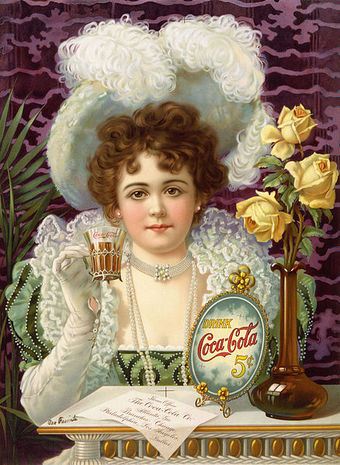
Advertisement
“Drink Coca-Cola 5¢”, an 1890s advertising poster showing a woman in fancy clothes drinking Coke. The card on the table says “Home Office, The Coca-Cola Co. Atlanta, Ga. Branches: Chicago, Philadelphia, Los Angeles, Dallas”. Notice the cross-shaped color registration marks near the bottom center and top center. Someone crudely wrote on it at lower left (with an apparent leaking fountain pen) “Our Faovrite” [sic].The women who modeled for this artwork was Hilda Clark
Though that regulation continues for broadcasts originating within the country, it has been weakened by the European Court of Justice, which found that Sweden was obliged to accept foreign programming. Greece’s regulations are of a similar nature, “banning advertisements for children’s toys between 7 am and 10 pm and a total ban on advertisement for war toys. ” In the US, many communities believe that certain types of outdoor advertising blight the public realm. During the 1960s, there were attempts to ban billboard advertising in the open countryside.
10.2.2: Journalistic Standards
Journalism ethics and standards describe the principles of ethics and good practice journalists adopt in response to specific challenges.
Learning Objective
Summarize the key components of ethical journalism
Key Points
- Codes of journalism are designed to guide journalists through numerous ethical challenges, such as conflict of interest. A conflict of interest occurs when a single individual or organization adopts multiple interests, one of which could potentially corrupt the incentive to pursue another.
- According to the accuracy and standards for factual reporting, reporters are expected to be as accurate as possible given the time allotted and the space available, and to seek only reliable sources. In addition, events with a single eyewitness are to be reported with attribution.
- Independent fact-checking by another employee of the publisher is desirable. A fact checker is the person who checks factual assertions in non-fictional text (usually intended for publication in a periodical) to determine their veracity and correctness.
- Harm limitation addresses the question of whether all information gathered should be reported, and if so, how. This principle of limitation creates a practical and ethical dilemma by acknowledging that some attention must be given to the negative consequences of full disclosure.
- News style is the prose style used for news reporting in media such as newspapers, radio and television.
- News writing attempts to answer every basic question about a particular event– who, what, when, where, why, and often how– at the opening of the article. This method of composition is sometimes called the “inverted pyramid”.
Key Terms
- fact checker
-
A fact checker is the person who checks factual assertions in non-fictional text (usually intended for publication in a periodical) to determine their veracity and correctness. The job requires general, wide-ranging knowledge and the ability to conduct quick and accurate research.
- journalism ethics and standards
-
Journalism ethics and standards describe the principles of ethics and good practice journalists adopt in response to specific challenges.
- conflict of interest
-
A situation in which someone in a position of trust, such as a lawyer, insurance adjuster, a politician, executive or director of a corporation or a medical research scientist or physician, has competing professional or personal interests.
Example
- According to the Columbia Journalism Review, the German weekly Der Spiegel runs “most likely the world’s largest fact checking operation,” employing the equivalent of eighty full-time fact checkers as of 2010.
Introduction
Journalism ethics and standards describe the principles of ethics and good practice journalists adopt in response to specific challenges. Historically and currently, journalists consider the subset of media ethics as their professional “code of ethics” or “canons of journalism”. These basic codes and canons commonly appear in statements drafted by professional journalism associations and individual print, broadcast, and online news organizations. While various existing codes have some differences, most share common elements: notably, the principles of truthfulness, accuracy, objectivity, impartiality, fairness and public accountability as they apply to the acquisition of newsworthy information and its subsequent dissemination to the public.
Codes of Journalism
Codes of journalism are designed to guide journalists through numerous ethical challenges, such as conflict of interest. The codes and canons provide journalists with a framework for self-monitoring and self-correction. A conflict of interest occurs when a single individual or organization adopts multiple interests, one of which could potentially corrupt the incentive to pursue another. The United States and Europe have typically been considered pioneers in the formulation and adoption of these standards, though similar codes can be found in nearly any country that enjoys freedom of the press. While the written codes and practical standards of journalism vary somewhat from country to country and organization to organization, they tend to overlap substantially between mainstream publications and societies.
Common elements
In accordance with the accuracy and standards for factual reporting, reporters are expected to be as accurate as possible given the time allotted and the space available for story preparation, and to seek only reliable sources. In addition, events with a single eyewitness are to be reported with attribution. Events with two or more independent eyewitnesses may be reported as facts. Controversial facts are reported with attribution. Moreover, independent fact-checking by another employee of the publisher is desirable. A fact checker is the person who checks factual assertions in non-fictional text (usually intended for publication in a periodical) to determine their veracity and correctness. The job requires general, wide-ranging knowledge and the ability to conduct quick and accurate research. According to the Columbia Journalism Review, the German weekly Der Spiegel runs “most likely the world’s largest fact checking operation,” employing the equivalent of eighty full-time fact checkers as of 2010.
During the normal course of an assignment, a reporter might go about a variety of tasks– gathering facts and details, conducting interviews, doing research, background checks, taking photos, videotaping, recording sound. Harm limitation addresses the question of whether all information gathered should be reported, and if so, how. This principle of limitation creates a practical and ethical dilemma by acknowledging that some attention must be given to the negative consequences of full disclosure.
News Style
Ethical standards should not be confused with the common standards of quality of presentation. News style is the prose style used for news reporting in media such as newspapers, radio and television. News style requires not only a unique vocabulary and sentence structure, but also a particular manner of presentation– the situational importance of tone and intended audience, for instance. News writing attempts to answer every basic question about a particular event– who, what, when, where, why and often how– at the opening of the article. This method of composition is sometimes called the “inverted pyramid” , named for the decreasing importance of information in subsequent paragraphs.

Inverted Pyramid
The Inverted Pyramid. This story can be trimmed from the bottom without losing important details.
10.2.3: Government Regulations
A regulation is a legal provision that creates, limits, or constrains a right, creates or limits a duty, or allocates a responsibility.
Learning Objective
Describe several key debates in which the FCC is currently or has been recently involved
Key Points
- One can consider regulation as actions of conduct imposing sanctions, such as a fine, to the extent permitted by the law of the land.
- FCC works towards six goals in the areas of broadband, competition, the spectrum, the media, public safety, and homeland security.
- With the major demographic shifts occurring in the country in terms of the racial-ethnic composition of the population, the FCC has also been criticized for ignoring the issue of decreasing racial-ethnic diversity of the media.
- Network Neutrality in the United States is a hotly debated issue subject to regulatory and judicial contention among network users and access providers.
Key Terms
- federal communications commission
-
The Federal Communications Commission (FCC) is an independent regulatory agency of the United States government created by Congressional statute, with the majority of its commissioners appointed by the current president.
- network neutrality
-
A principle proposed for user-access networks participating in the Internet that advocates no restrictions by ISPs or government on the content, sites, platforms, equipment, and modes of communication over the network.
- regulation
-
A law or administrative rule, issued by an organization, used to guide or prescribe the conduct of members of that organization; can specifically refer to acts in which a government or state body limits the behavior of businesses.
Introduction
A regulation is a legal provision that creates, limits, or constrains a right, creates or limits a duty, or allocates a responsibility. Regulation can take many forms: legal restrictions promulgated by a government authority, contractual obligations that bind many parties, self-regulation by an industry such as through a trade association, social regulation, co-regulation, or market regulation. One can consider regulation as actions of conduct imposing sanctions, such as a fine, to the extent permitted by the law of the land.
The FCC and Regulation
The Federal Communications Commission (FCC) is an independent agency of the United States government . FCC works towards six goals in the areas of broadband, competition, the spectrum, the media, public safety, and homeland security. The Commission is also in the process of modernizing itself. The inauguration of Ronald Reagan as President of the United States in 1981 accelerated an already ongoing shift in the FCC towards a decidedly more market-oriented stance. A number of regulations felt to be outdated were removed, most controversially the Fairness Doctrine in 1987. The FCC also took steps to increase competition to broadcasters, fostering broadcast alternatives such as cable television. In terms of indecency fines, there was no action taken by the FCC from FCC v. Pacifica until 1987, about 10 years later.

FCC Logo
An additional logo of the FCC.
The FCC’s mission is to create a purpose for national defense ad for the purpose of promoting safety of life and property through the use of wire and radio communications.
In the early 2000’s (decade), the FCC began stepping up censorship and enforcement of indecency regulations again, most notably following the Janet Jackson “wardrobe malfunction” that occurred during the halftime show of Super Bowl XXXVIII. However, the FCC’s regulatory domain with respect to indecency remains restricted to the public airwaves, notably VHF and UHF television and AM/FM radio. In other words, the FCC has a strong role in regulating public airwaves .
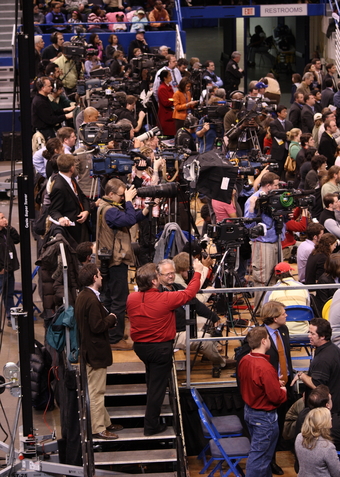
Press Coverage and film Crew at Barack Obama rally 2008
Media photographers and video crews, documenting the events onstage at a Barack Obama rally in Hartford, Connecticut.
Criticisms
With the major demographic shifts occurring in the country in terms of the racial-ethnic composition of the population, the FCC has also been criticized for ignoring the issue of decreasing racial-ethnic diversity of the media. This includes charges that the FCC has been watering down the limited affirmative action regulations it had on the books, including no longer requiring stations to make public their data on their minority staffing and hiring. In the second half of 2006, groups such as the National Hispanic Media Coalition, the National Latino Media Council, the National Association of Hispanic Journalists, the National Institute for Latino Policy, the League of United Latin American Citizens (LULAC), and others held town hall meetings in California, New York, and Texas on media diversity as its effects Latinos and minority communities. They documented widespread and deeply felt community concerns about the negative effects of media concentration and consolidation on racial-ethnic diversity in staffing and programming. At these Latino town hall meetings, the issue of the FCC’s lax monitoring of obscene and pornographic material in Spanish-language radio and the lack of racial and national-origin diversity among Latino staff in Spanish-language television were other major themes.
Network Neutrality in the United States is a hotly debated issue subject to regulatory and judicial contention among network users and access providers. As a de facto matter, there is a degree of network neutrality in the United States, meaning that telecommunications companies rarely offer different rates to broadband and dial-up Internet consumers based on Internet-based content or service type. However, there are no clear legal restrictions against these practices. Broadband providers often block common service ports, such as port 25 (SMTP) or port 80 (HTTP), preventing consumers (and botnets) from hosting web and email servers unless they upgrade to a “business” account. In recent years, advocates of network neutrality have sought to restrict such changes.
In 2005 and 2006, corporations supporting both sides of the issue spent large amounts of money lobbying Congress. In 2006, representatives from several major U.S. corporations and the federal government publicly addressed U.S. Internet services in terms of the nature of free market forces, the public interest, the physical and software infrastructure of the Internet, and new high-bandwidth technologies.
10.2.4: The Federal Communications Commission
The Federal Communications Commission (FCC) is an independent regulatory agency of the United States government.
Learning Objective
Discuss the FCC’s mandate, structure, and enforcement powers
Key Points
- In 1934, Congress passed the Communications Act, which abolished the Federal Radio Commission and transferred jurisdiction over radio licensing to a new Federal Communications Commission.
- In the early 2000s, the FCC stepped up enforcement of indecency regulations, most notably following the Janet Jackson “wardrobe malfunction” that occurred during the halftime show of Super Bowl XXXVIII.
- The FCC is directed by five commissioners appointed by the president, who designates one of the commissioners to serve as chairman.
- The FCC regulates broadcast stations, amateur radio operators and repeater stations as well as commercial broadcasting operators. Broadcast licenses are to be renewed if the station meets the “public interest, convenience, or necessity”.
Key Terms
- communications act
-
The Communications Act abolished the Federal Radio Commission and transferred jurisdiction over radio licensing to a new Federal Communications Commission.
- federal communications commission
-
The Federal Communications Commission (FCC) is an independent regulatory agency of the United States government created by Congressional statute, with the majority of its commissioners appointed by the current president.
Introduction
The Federal Communications Commission (FCC) is an independent regulatory agency of the United States government created by Congressional statute, with the majority of its commissioners appointed by the current president .

FCC Seal
Seal of the United States Federal Communications Commission.
The FCC took over wire communication regulation from the Interstate Commerce Commission. The FCC’s mandated jurisdiction covers the 50 states, the District of Columbia and U.S. possessions. The FCC also provides varied degrees of cooperation, oversight and leadership for similar communications bodies in other countries of North America. The FCC is funded entirely by regulatory fees. It has an estimated fiscal-2011 budget of 354.2 million and 1,898 federal employees.
History
In 1934, Congress passed the Communications Act abolishing the Federal Radio Commission and transferring jurisdiction over radio licensing to a new Federal Communications Commission. Title II of the Communications Act focused on telecommunications using many concepts borrowed from railroad legislation and Title III contained provisions very similar to the Radio Act of 1927 .
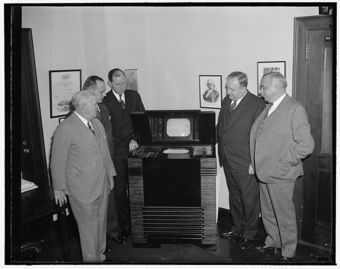
FCC Commissioners inspect the latest in television (1939).
The Federal Communications Commission (FCC) has promised to ensure fairness in broadcasting.
In 1996, Congress enacted the Telecommunications Act of 1996. The legislation attempted to create more competition in local telephone service by requiring Incumbent Local Exchange Carriers to provide access to their facilities for Competitive Local Exchange Carriers. This policy has had limited success. The development of the Internet, cable services and wireless services has raised questions whether new legislative initiatives are needed. Congress has monitored developments, but as of 2009 has not undertaken a major revision of the regulation.
In the early 2000s, the FCC once again stepped up enforcement of indecency regulations, most notably following the Janet Jackson “wardrobe malfunction” that occurred during the halftime show of Super Bowl XXXVIII. However, the FCC’s regulatory domain with respect to indecency remains restricted to the public airwaves, notably VHF and UHF television and AM/FM radio.
Organization
The FCC is directed by five commissioners appointed by the president. The president designates one of the commissioners to serve as chairman. Only three commissioners may be members of the same political party. None may have a financial interest in any FCC-related business.
The Consumer & Governmental Affairs Bureau (CGB) develops and implements the FCC’s consumer policies, including disability access; The Enforcement Bureau (EB) is responsible for enforcement of provisions of the Communications Act of 1934, along with FCC rules, orders and conditions of station authorizations; The International Bureau (IB) develops international policies in telecommunications like coordination of frequency allocation; The Media Bureau (MB) develops, recommends and administers the policy and licensing programs relating to electronic media, including cable television, broadcast television, and radio in the United States and its territories; The Wireless Telecommunications Service (WCS) deals with Advanced Wireless Services (AWS) and fixed, mobile, and broadcast services on the 700 MHz Band; The Wireline Competition Bureau (WCB) develops policy concerning wireline telecommunications.
Broadcast Licensing
The FCC regulates broadcast stations, amateur radio operators, and repeater stations as well as commercial broadcasting operators. Broadcast licenses are to be renewed if the station meets the “public interest, convenience, or necessity. “
The FCC’s enforcement powers include fines and broadcast license revocation. Burden of proof would be on the complainant in a petition to deny. Fewer than 1% of station renewals are not immediately granted, and only a small fraction of those are ultimately denied. While the FCC maintains control of the written and Morse testing standards, it no longer administers the exams, having delegated that function to private organizations.
10.3: The Media and Political Campaigns
10.3.1: Political Advertisements
Political advertising is a form of campaigning used by political candidates to reach and influence voters.
Learning Objective
Summarize the development of political advertisements on television and the Internet
Key Points
- Unlike the campaigns of the past, advances in media technology have streamlined the process, giving candidates more options to reach even larger groups of constituents with very little physical effort.
- Dwight D. Eisenhower, John F. Kennedy, and Lyndon Johnson all successfully utilized the medium of television for their political advertising campaigns.
- The growth of cable television networks and the Internet allowed candidates to reach new demographics, tailor their advertisements to particular audiences, and communicate directly with supporters and constituents.
Key Terms
- constituent
-
a resident of a place represented by an elected official
- narrowcasting
-
advertisements which are tailored to target specific audiences
Political advertising is a form of campaigning used by political candidates to reach and influence voters. It can include several different mediums and span several months over the course of a political campaign. Unlike the campaigns of the past, advances in media technology have streamlined the process, giving candidates more options to reach even larger groups of constituents with very little physical effort.
Political advertising has changed drastically over the last several decades. During the 1952 Presidential elections, Dwight D. Eisenhower was the first candidate to extensively utilize television commercials, creating forty twenty-second spots to answer questions from everyday Americans. During the 1960 elections, both candidates – Vice President Richard Nixon and Senator John F. Kennedy – utilized television, although Kennedy’s televised speech about his Catholic heritage and American religious tolerance is considered by many to be more memorable.
One of the first negative political advertisements was titled “The Daisy Girl” and was released by Lyndon Johnson’s campaign during the 1964 election. The commercial showed a young girl picking the petals off a daisy, while a voice off camera began a countdown to a nuclear explosion. The ad ended with an appeal to vote for Johnson, “because the stakes are too high for you to stay home.” Though the ad ran for under a minute and only aired once, it helped Johnson win the electoral votes of 44 states. Throughout the 1970s and 1980s, political attack ads became even more prevalent, with Presidents Nixon, Carter, Reagan and George H. W. Bush all utilizing the method against their opponents .
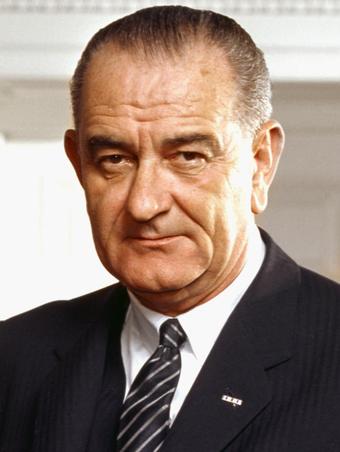
President Lyndon B. Johnson
Lyndon B. Johnson, who successfully utilized negative political advertising in the famous “Daisy ad” during the 1964 election
The growth of cable television networks heavily influenced political advertising in the 1992 election between incumbent President George H. W. Bush and Governor Bill Clinton, particularly in reaching new target demographics such as women and young voters. The 2004 election saw yet another, and possibly the biggest, change yet in political advertising–the growth of the Internet. Web-based advertising was easily distributed by both incumbent President George W. Bush and Senator John Kerry’s campaigns, and both campaigns hired firms who specialized in the accumulation of personal data. This resulted in advertisements which were tailored to target specific audiences for the first time (a process known as narrowcasting). The 2008 election was notable for Senator Barack Obama’s use of the Internet to communicate directly and personally with supporters and constituents, a tactic that would help in his eventual victory.
10.3.2: Television Debates
From 1960 onward, televised debates have become an important aspect of every presidential election.
Learning Objective
Name three key moments in the history of televised presidential debates
Key Points
- The first general election presidential debate was held on September 26, 1960, between John F. Kennedy and Richard Nixon.
- The 1976 presidential debates would lead to a victory for Jimmy Carter after a foreign policy gaffe made by incumbent Gerald Ford.
- During the 1980 debates, former actor Ronald Reagan came across much better than President Jimmy Carter, a fact which would lead to Reagan’s landslide victory.
Key Term
- incumbent
-
Being the current holder of an office or a title.
Televised debates have become an important aspect of every presidential election. The first general election presidential debate was held on September 26, 1960, between Democratic nominee U.S. Senator John F. Kennedy and Vice President Richard Nixon, the Republican nominee.
With an estimated 70 million viewers watching, the first Kennedy-Nixon debate demonstrated the impact of this new medium. During the debate, Nixon looked sickly, underweight and tired. In contrast, Kennedy appeared confident and relaxed. As a result, many of those who watched the debate unfold on television believed that Kennedy had won. For the remaining three debates, Nixon regained his lost weight, wore television makeup and appeared more forceful than his initial appearance .
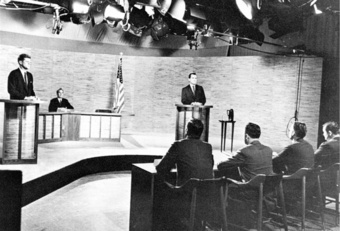
Kennedy-Nixon Debate
The Kennedy-Nixon debate of 1960 was the first televised presidential debate.
It was not until 1976 that a second series of televised presidential debates was held during the general election campaign season. These debates, between Governor Jimmy Carter, the Democratic nominee, and Republican incumbent President Gerald Ford, also demonstrated their dramatic effect. Ford had already cut into Carter’s large lead in the polls, and was generally viewed as having won the first debate on domestic policy. However, in a second debate on foreign policy, Ford made what was widely viewed as a major blunder when he stated, “There is no Soviet domination of Eastern Europe, and there never will be under a Ford administration. ” After this, Ford’s momentum stalled, and Carter won a very close election.
Televised debates were a major factor again in 1980. Earlier in the election season, President Carter had a lead over opponent Governor Ronald Reagan. In the debates, with years of experience in front of a camera as an actor, Reagan came across much better than Carter. This would eventually help to propel Reagan to a landslide victory.
10.3.3: News Coverage
Media coverage strongly influences people’s perception of politics, society, and culture.
Learning Objective
Name some of the central critiques of American news organizations
Key Points
- Perhaps the most important political function of the media is to put together a set of national priorities.
- Agenda setting may be limited within a domestic political context because of the competition for audience interest.
- American news media emphasizes more than ever the “horse race” aspects of the presidential campaign. This has led to criticism that audiences are not being given more substantive information about policy.
Key Term
- horse race
-
An exciting and arduous competition (as in a political campaign).
Media coverage strongly influences people’s perception of politics, society, and culture. The political analyst and consultant Gary Wasserman attests that media institutions’ “most important political function” is to play the role of an “agenda setter,” where they “[put] together an agenda of national priorities – what should be taken seriously, what lightly, what not at all. “
Agenda-setting is somewhat limited within domestic politics. Due to the commercialized context within which they work, media institutions must compete for audience interest and can often not afford to ignore an important issue which another television station, newspaper, or radio station is willing to pick up. In regards to foreign policy, agenda-setting could take place in areas in which very few Americans have direct experience of the issues at hand. In addition, the U.S. media has been accused of prioritizing domestic news over international news, as well as focusing on U.S. military action abroad over other international stories.
American news media emphasizes more than ever the “horse race” aspects of the presidential campaign, according to a new study. Coverage of the political campaigns have been less reflective on the issues that matter to voters. Instead, the media has focused primarily on campaign tactics and strategy, according to a report conducted jointly by the Project for Excellence in Journalism, part of the Pew Research Center, and the Joan Shorenstein Center on the Press, Politics, and Public Policy at the Kennedy School of Government at Harvard University. The report examined 1,742 stories that appeared from January through May 2007 in 48 news outlets. Almost two-thirds of all stories in U.S. news media, including print, television, radio and online, focused on the political aspects of the campaign, while only one percent focused on the candidates’ public records. Only 12 percent of stories seemed relevant to voters’ decision-making. The rest of the stories focused more on tactics and strategy. Many criticize this shift in emphasis for depriving audiences of substantive information about candidates’ policy platforms .
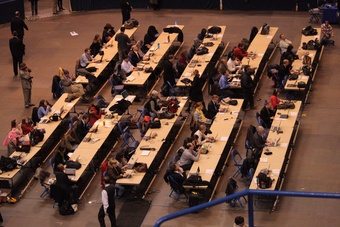
News Coverage
Press tables at a Barack Obama rally.
10.3.4: The Internet, Blogging, and Podcasting
The growth of the Internet and its associated technologies has made a profound impact on contemporary political campaigns.
Learning Objective
Describe the various ways recent developments in technology have shaped political activity
Key Points
- The internet is now a core element of modern political campaigns. Communication technologies such as e-mail, web sites, and podcasts for various forms of activism to enable faster communications by citizen movements and deliver a message to a large audience.
- Political blogs, generally a series of discrete posts about political issues in which readers may submit comments (thus reinforcing its interactive nature), have become prominent method of covering politics.
- The 2004 presidential election between incumbent President George W. Bush and Senator John Kerry was the first to heavily utilize web-based advertising, with advertisements tailored toward different target audiences.
- Internet-based activism for a wide variety of political causes has also increased due to the growth of social media technologies, such as Facebook, Twitter, and YouTube.
- New media has been incredibly successful at reaching the younger population while helping all populations organize and promote action.
Key Terms
- social media
-
Interactive forms of media that allow users to interact with and publish to each other, generally by means of the Internet.
- blog
-
A website that allows users to reflect, share opinions, and discuss various topics in the form of an online journal while readers may comment on posts. Most blogs are written in a slightly informal tone (personal journals, news, businesses, etc. ) Entries typically appear in reverse chronological order.
Introduction
The growth of the Internet and its associated technologies has had a profound impact on contemporary political campaigns.
The 2004 presidential election between incumbent President George W. Bush and Senator John Kerry was the first to heavily utilize web-based advertising, with advertisements tailored toward different target audiences. President Barack Obama’s victory in 2008 was partially attributed to his campaign’s use of direct communication through the Internet with supporters and constituents . When discussing the 2004 U.S. presidential election candidates, Carol Darr, director of the Institute for Politics, Democracy & the Internet at George Washington University in Washington, D.C., said of the candidates which benefited from use of the Internet to attract supporters: “They are all charismatic, outspoken mavericks and insurgents. Given that the Internet is interactive and requires an affirmative action on the part of the users, as opposed to a passive response from TV users, it is not surprising that the candidate has to be someone people want to touch and interact with. “
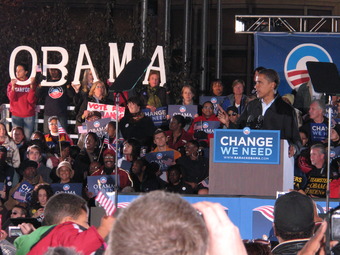
Campaigns and the internet
President Obama’s campaign, depicted here, relied heavily on the use of the internet. He used the internet to connect with his constituents and win votes.
Political blogs, generally a series of discrete posts about political issues in which readers may submit comments (thus reinforcing its interactive nature), have become prominent method of covering politics. Though the medium was often originally associated with individuals operating outside the formal political and media establishment, political blogs have unquestionably shaped the actions of political leadership and voter behavior. In the United States and many other countries, the most prominent bloggers have now become an accepted fixture in the political milieu.
Podcasts, a type of digital media consisting of an episodic series of audio, video, PDF, or ePub files subscribed to and downloaded through web syndication or streamed online to a computer or mobile device, have also become a popular way to convey political messages.
The Impact of the Internet on Political Campaigns
The internet is now a core element of modern political campaigns. Communication technologies such as e-mail, web sites, and podcasts for various forms of activism to enable faster communications by citizen movements and deliver a message to a large audience. These Internet technologies are used for cause-related fundraising, lobbying, volunteering, community building, and organizing. Individual political candidates are also using the internet to promote their election campaign. In a study of Norwegian election campaigns, politicians reported they used social media for marketing and for dialogue with voters. Facebook was the primary platform for marketing and Twitter was used for more continuous dialogue. However, despite the opening of communications brought by the internet, elections have become more expensive due to the inevitable reliance on high-tech for all purposes in a campaign.
Signifying the importance of internet political campaigning, Barack Obama’s presidential campaign relied heavily on social media, and new media channels to engage voters, recruit campaign volunteers, and raise campaign funds. The campaign brought the spotlight on the importance of using internet in new-age political campaigning by utilizing various forms of social media and new media (including Facebook, YouTube and a custom generated social engine) to reach new target populations. The campaign’s social website, my.BarackObama.com, utilized a low cost and efficient method of mobilizing voters and increasing participation among various voter populations. This new media was incredibly successful at reaching the younger population while helping all populations organize and promote action.
Internet-based activism for a wide variety of political causes has also increased due to the growth of social media technologies such as Facebook, Twitter, and YouTube. These technologies enable faster communication by grassroots citizen movements and the delivery of local information to a large audience. For example, the Internet became the catalyst for protests such as the 2011 uprisings in Arab countries and the Occupy Wall Street movement in the United States, as those involved increasingly relied on social media to organize and stay connected.
10.4: Media Bias
10.4.1: Media Bias
Media bias is the bias of journalists and news producers in the selection of events and stories that are reported, and how they are covered.
Learning Objective
Summarize the different types of bias affecting journalism and various attempts to correct them
Key Points
- Political bias has been a feature of the mass media since its birth following the invention of the printing press. Historians have found that publishers often served the interests of powerful social groups.
- Like newspapers, the broadcast media—radio and television—have been used as a mechanism for propaganda from their earliest days, a tendency made more pronounced by the initial ownership of the broadcast spectrum by national governments.
- The most commonly discussed forms of bias occur when the media support or attack a particular political party, candidate, or ideology; however, other common forms of bias exist, including advertising bias, corporate bias, mainstream bias, sensationalism, and concision bias.
- A technique used to avoid bias is the round table, an adversarial format in which representatives of opposing views comment on an issue. This approach theoretically allows diverse views to appear in the media.
- Another technique used to avoid bias is disclosure of affiliations that may be considered a possible conflict of interest. This is especially apparent when a news organization is reporting a story with some relevancy to the news organization itself or to its ownership individuals or conglomerate.
Key Terms
- media bias
-
A bias in journalistic reporting, in programming selection, etc., in mass communications media.
- sensationalism
-
The use of sensational subject matter, style, or methods, or the sensational subject matter itself; behavior, published materials, or broadcasts that are intentionally controversial, exaggerated, lurid, loud, or attention-grabbing. Especially applied to news media in a pejorative sense that they are reporting in a manner to gain audience or notoriety at the expense of accuracy and professionalism.
- round table
-
An adversarial format in which representatives of opposing views comment on an issue. This approach theoretically allows diverse views to appear in the media.
Example
- Sensationalism is a type of editorial bias in mass media where events and topics in news stories and pieces are over-hyped to increase viewership or readership numbers. Sensationalism may include reporting about generally insignificant matters and events that don’t influence overall society and biased presentations of newsworthy topics in a sensationalist, trivial, or tabloid manner. Examples include press coverage about the Bill Clinton/Monica Lewinsky scandal, Casey Anthony Trial, Tonya Harding’s role in the attack of Nancy Kerrigan, the Elian Gonzalez affair, and the O.J. Simpson murder case.
Introduction
Media bias is the bias of journalists and news producers within the mass media, concerning the selection of events and stories that are reported, and how they are covered. The term “media bias” implies a pervasive or widespread bias contravening the standards of journalism, rather than the perspective of an individual journalist or article. The direction and degree of media bias in various countries is widely disputed.
Practical limitations to media neutrality include the inability of journalists to report all available stories and facts, and the requirement that selected facts be linked into a coherent narrative. Because it is impossible to report everything, selectivity is inevitable. Government influence, including overt and covert censorship, biases the media in some countries, for example North Korea and Burma. Market forces that result in a biased presentation include the ownership of the news source, concentration of media ownership, the selection of staff, the preferences of an intended audience, and pressure from advertisers.
History of Bias in Mass Media
Political bias has been a feature of the mass media since its birth following the invention of the printing press. The expense of early printing equipment restricted media production to a limited number of people. Historians have found that publishers often served the interests of powerful social groups. In the nineteenth century, journalists began to recognize the concept of unbiased reporting as an integral part of journalistic ethics. This coincided with the rise of journalism as a powerful social force. Even today, though, the most conscientiously objective journalists cannot avoid accusations of bias. Like newspapers, the broadcast media (radio and television, ) have been used as a mechanism for propaganda from their earliest days, a tendency made more pronounced by the initial ownership of the broadcast spectrum by national governments. Although a process of media deregulation has placed the majority of the Western broadcast media in private hands, there still exists a strong government presence, or even monopoly, in the broadcast media of many countries across the globe. At the same time, the concentration of media in private hands, and frequently among a comparatively small number of individuals, has also led to accusations of media bias .

Percent of Media Citations by Ideology Graph
Studies done by FAIR, a progressive media watchdog organization, argue that the majority of media citations come from conservative and centrist sources.
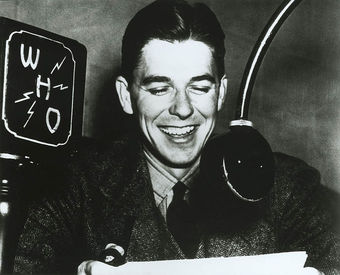
Ronald Reagan as Radio Announcer 1934-37
Ronald Reagan as a WHO Radio Announcer in Des Moines, Iowa. 1934-37.
Types of Bias
The most commonly discussed forms of bias occur when the media support or attack a particular political party, candidate, or ideology; however, other common forms of bias exist, including advertising bias, corporate bias, mainstream bias, sensationalism, and concision bias. Advertising bias refers to when stories are selected or slanted to please advertisers; corporate bias refers to when stories are selected or slanted to please corporate owners of media; mainstream bias refers to a tendency to report what everyone else is reporting, and to avoid stories that will offend anyone. Sensationalism is a type of editorial bias in mass media in which events and topics in news stories and pieces are over-hyped to increase viewership or readership numbers. Sensationalism may include reporting about generally insignificant matters and events that don’t influence overall society, as well as biased presentations of newsworthy topics in a sensationalist, trivial, or tabloid manner. Examples include press coverage about the Bill Clinton/Monica Lewinsky scandal, Casey Anthony Trial, Tonya Harding’s role in the attack of Nancy Kerrigan, the Elian Gonzalez affair, and the O.J. Simpson murder case. Finally, concision bias refers to a tendency to report views that can be summarized succinctly, crowding out more unconventional views that take time to explain.
Efforts to Correct Bias
A technique used to avoid bias is the round table, an adversarial format in which representatives of opposing views comment on an issue. This approach theoretically allows diverse views to appear in the media. However, the person organizing the report still has the responsibility to choose people who really represent the breadth of opinion, to ask them non-prejudicial questions, and to edit or arbitrate their comments fairly. When done carelessly, a point/counterpoint can be just as unfair as a simple biased report, by suggesting that the “losing” side lost on its merits.
Another technique used to avoid bias is the disclosure of affiliations that may be considered a possible conflict of interest. This is especially apparent when a news organization is reporting a story with some relevancy to the news organization itself or to its ownership individuals or conglomerate. Often this disclosure is mandated by the laws or regulations pertaining to stocks and securities. Commentators on news stories involving stocks are often required to disclose any ownership interest in those corporations or in its competitors.
10.5: News Coverage
10.5.1: Print Media
The main form of print media is the newspaper, which is a scheduled publication containing news of current events, and informative articles.
Learning Objective
Recognize the function and style of the newspaper as a format of media coverage
Key Points
- The emergence of the new media branch in the 17th century has to be seen in close connection with the spread of the printing press from which the publishing press derives its name.
- Advances in printing technology related to the Industrial Revolution enabled newspapers to become an even more widely circulated means of communication.
- By the late 1990s, the 24-hour television channels and the Internet posed an ongoing challenge to the business model of newspapers in developed countries. Paid circulation has declined, while advertising revenue has been shifting from print to new media, resulting in a general decline of profits.
- However, in the rest of the world, cheaper printing and distribution, increased literacy, the growing middle class and other factors have more than compensated for the emergence of electronic media by allowing newspapers in those regions to continue to grow.
Key Terms
- print media
-
newspaper, magazines and other printed material that distributes news and information
- Newspaper
-
A newspaper is a scheduled publication containing news of current events, informative articles, diverse features, editorials, and advertising.
- Hearst Corporation
-
The Hearst Corporation was one of the large news media corporations of the first part of the 20th century.
Newspaper
The main form of print media is the newspaper. A newspaper is a scheduled publication containing news of current events, informative articles, diverse features, editorials, and advertising . It usually is printed on relatively inexpensive, low-grade paper such as newsprint. By 2007, there were 6,580 daily newspapers in the world selling 395 million copies a day. The worldwide recession of 2008, combined with the rapid growth of web-based alternatives, caused a serious decline in advertising and circulation, as many papers closed or sharply reduced operations.
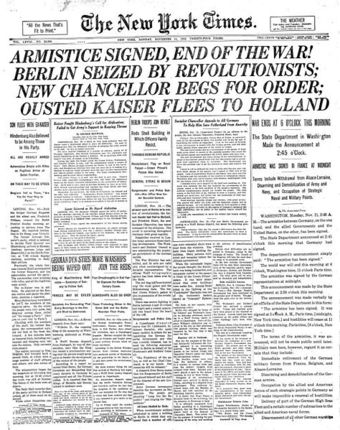
The New York Times
The front page of the New York Times on Armistice Day, November 11, 1918.
General-interest newspapers typically publish stories on local and national political events and personalities, crime, business, entertainment, society and sports. Most traditional papers also feature an editorial page containing editorials written by an editor and columns that express the personal opinions of writers. The newspaper is typically funded by paid subscriptions and advertising.
The emergence of this new media branch in the 17th century has to be seen in close connection with the spread of the printing press from which the publishing press derives its name. The German-language Relation aller Fürnemmen und gedenckwürdigen Historien, printed from 1605 on wards by Johann Carolus in Strasbourg, is often recognized as the first newspaper.
By the early 19th century, many cities in Europe, as well as North and South America, published newspaper-type publications though content was vastly shaped by regional and cultural preferences. Advances in printing technology related to the Industrial Revolution enabled newspapers to become an even more widely circulated means of communication. In 1814, The Times (London) acquired a printing press capable of making 1,100 impressions per minute.
Soon, the printing press was adapted to print on both sides of a page at once. This innovation made newspapers cheaper and thus available to a larger part of the population. In 1830, the first penny press newspaper came to the market: Lynde M. Walter’s Boston Transcript. Penny press papers cost about one sixth the price of other newspapers and appealed to a wider audience. In France, Émile de Girardin started “La Presse” in 1836, introducing cheap, advertising-supported dailies to France.
In the early days of the newspaper business newspapers were often owned by press barons, and were used for gaining a political voice. After 1920 most major newspapers became parts of chains run by large media corporations such as Gannett, The McClatchy Company, Hearst Corporation, Cox Enterprises, Landmark Media Enterprises LLC, Morris Communications, The Tribune Company, Hollinger International, News Corporation, and Swift Communications.
However, newspapers have played an important role in the exercise of freedom of expression. Whistle-blowers and those who “leak” stories of corruption in political circles often choose to inform newspapers before other mediums of communication, relying on the reputation of newspaper editors to expose the secrets and lies that relate to the public. However, there have been many circumstances of the political autonomy of newspapers being curtailed. Recent research has examined the effects of a newspaper’s closing on the reelection of incumbents, voter turnout, and campaign spending.
By the late 1990s, the availability of news via 24-hour television channels and then the Internet posed an ongoing challenge to the business model of most newspapers in developed countries. Paid circulation has declined, while advertising revenue — which makes up the bulk of most newspapers’ income — has been shifting from print to the new media, resulting in a general decline of profits. Many newspapers around the world launched online editions in an attempt to follow or stay ahead of their audience.
The future of newspapers in countries with easy access to the Internet has been widely debated as the industry has faced soaring newsprint prices, slumping ad sales, the loss of much classified advertising, and precipitous drops in circulation. In recent years the number of newspapers slated for closure, bankruptcy or severe cutbacks has risen—especially in the United States, where the industry has shed a fifth of its journalists since 2001. Revenue has plunged while competition from media on the Internet has threatened older print publishers .

U.S. Newspaper Advertising Revenue
This graph depicts the fall of print advertising revenue and the rise of online advertising revenue.
The debate has become more urgent lately, as a deepening recession has shaved profits, and as once-explosive growth in newspaper web revenues has leveled off, forestalling what the industry hoped would become an important source of its revenue. At issue is whether the newspaper industry faces a cyclical trough, or whether new technology has rendered newspapers obsolete in their traditional format.
However, in the rest of the world, cheaper printing and distribution, increased literacy, the growing middle class and other factors have more than compensated for the emergence of electronic media by allowing newspapers in those regions to continue to grow.
Major American newspapers include: New York Times, Los Angeles Times, USA Today, The Wall Street Journal, and Washington Post. Major American news magazines include: Newsweek, TIME, and U.S. News & World Report.
10.5.2: Radio News
Stations dedicated to news will often feature newscasts, or bulletins, usually at the top of the hour, between 3 and 8 minutes in length.
Learning Objective
Explain the role of radio news in media coverage and recent trends in radio news
Key Points
- Many stations brand themselves as news radio but only run continuous news during the morning and afternoon drive times. These stations are properly identified as talk radio stations.
- Some National Public Radio stations brand themselves as news and information stations, which means that in addition to running the NPR news magazines like Morning Edition and All Things Considered, they run other information programs such as Fresh Air, Talk of the Nation, and the BBC World Service.
- The standard format was to start each half hour with world and national news from a network, then switch to locally-anchored area news, filling out the half hour with sports, business news, and features.
- In 1994, an effort similar to NIS was launched by the Associated Press. It was officially known as AP All-News Radio and had many affiliates from coast to coast. The Associated Press discontinued the all-news format in July 2005.
Key Terms
- Arthur W. Arundel
-
Arthur W. Arundel is credited with creating the first 24-hour all-news station, radio or television, in the United States in January 1961 on his owned and operated WAVA station in Washington.
- NIS
-
In 1975, the NBC Radio Network shut down its profitable weekend music and information service NBC Monitor to launch the News & Information Service (NIS), the first all-news radio network.
- All-News Radio
-
All-news radio, or talk radio is a radio station where the station’s entire schedule is dedicated to newscasts.
Radio News
Radio station newscasts can range from as little as a minute to as much as the station’s entire schedule, such as the case of all-news radio, or talk radio. Stations dedicated to news or talk will often feature newscasts, or bulletins, usually at the top of the hour, usually between 3 and 8 minutes in length. They can be a mix of local, national, and international news, as well as sport, entertainment, weather, and traffic, or they may be incorporated into separate bulletins. All-news radio stations exist in some countries, primarily located in major metropolitan areas such as New York City, Toronto, and Chicago, which often broadcast local, national, and international news and feature stories on a set time schedule.
All-news radio is a radio format devoted entirely to discussion and broadcast of news. It is available in both local and syndicated forms, and is carried in some form on both major US satellite radio networks. Some all-news stations may carry sports, public affairs programs, simulcasts of TV news magazine, political affairs shows like 60 Minutes and Face the Nation, or national radio shows revolving around news such as the CBS News Weekend Roundup. Many stations brand themselves as news radio but only run continuous news during the morning and afternoon drive times. These stations are properly identified as talk radio stations. Also, some National Public Radio stations brand themselves as News and Information stations, which means that in addition to running the NPR news magazines like Morning Edition and All Things Considered, they run other information programs such as Fresh Air, Talk of the Nation, and the BBC World Service .

NPR
National Public Radio, one of the News and Information stations.
History
Broadcasting pioneer Arthur W. Arundel is credited with creating the first 24-hour all- news station, radio or television, in the United States in January 1961 on his owned and operated WAVA in Washington. The station’s success was largely driven by the the fact that the nation’s capital was riveted to news of the Vietnam War and the assassinations of President John F. Kennedy, Martin Luther King, and Robert F. Kennedy. Arundel helped other stations in New York and Chicago also to convert to his all-news format and then met direct competition from Washington Post-owned WTOP in 1969.
All-news has for years been a top-rated radio format in New York, Washington, D.C., and other cities, but as big city traffic worsens and people work longer hours that increase the urgency of planning their day ahead, the focus of such stations has increasingly been on traffic and weather, often updated every 10 minutes. Attempts at long-form commercial all-news stations, such as Washington Post Radio, have been largely unsuccessful.
The Rise of Conservative Talk Radio
Conservative talk radio (or right talk) is a talk radio format in the United States devoted to expressing conservative viewpoints of issues, as opposed to progressive talk radio. In 1987, the FCC abolished the Fairness Doctrine, and AM radio began to make changes. The changes paved the way for syndicated personality Rush Limbaugh and others like him to rise to prominence by “offering a voice for the ‘silent majority'” that he believed had gone unheard by the mainstream media. Within the next decade, conservative talk radio schedules had developed the most listener loyalty (highest ratings) and performed particularly well when compared with most mixed or liberal/progressive talk radio. By 1991, Limbaugh had become the number one most syndicated radio host and AM radio had been revived.
The September 11, 2001 attacks brought on a wave of nationalism and a desire to rally around the United States and its government, which was led at the time by the Republican Party. This environment led to a large increase in national conservative talk radio hosts: The Glenn Beck Program, The Sean Hannity Show, The Laura Ingraham Show, Batchelor and Alexander and The Radio Factor all launched into national syndication at this time. Conservative talk radio includes personalities, both local and nationally-syndicated, such as Rush Limbaugh, Glenn Beck, Sean Hannity, Michael Savage, and many others. As of 2013, Limbaugh and Hannity are the most listened-to radio programs of any format in the United States, and other conservative talk shows also rank highly. [2] Conservative talk is heard almost entirely on commercial radio; public radio in the United States has historically been perceived as having a more liberal lean, and noncommercial community radio is generally very progressive in ideology.
10.5.3: Television News
A news bulletin or newscast is a television program that provides updates on world, national, or local news events.
Learning Objective
Discuss the structure, content and style of television news
Key Points
- Newscasts differ in content, tone, and presentation style depending on the format of the channel on which they appear as well as their time slot. In most parts of the world, national television networks will have network bulletins featuring national and international news.
- The top rating shows will often be in the evening at “prime time”, but there are also often breakfast time newscasts of two to three hours in length. Rolling news channels broadcast news 24 hours a day.
- Television news is very image-based, showing video of many of the events that are reported.
Key Terms
- Newscasts
-
Newscasts consist of several reporters or guest commentators being interviewed by an anchor, known as a “two-way. ” There may also be breaking news stories which will present live rolling coverage.
- Television News
-
Television news refers to disseminating current events via the medium of television.
Television news
Television news refers to disseminating current events via the medium of television. A “news bulletin” or a “newscast” are television programs lasting from seconds to hours that provide updates on world, national, regional, or local news events. Television news is very image-based, showing video of many of the events that are reported. Television channels may provide news bulletins as part of a regularly scheduled news program. Less often, television shows may be interrupted or replaced by breaking news (“news flashes”) to provide news updates on current or sudden events of great importance. Walter Kronkite is one of the iconic figures in television anchoring .
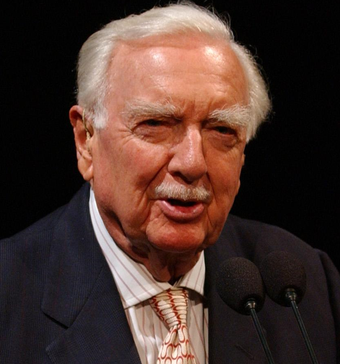
Walter Cronkite
Walter Cronkite, the iconic anchor of CBS Evening News.
Structure, content and style
Newscasts, also known as bulletins or news programs, differ in content, tone, and presentation style depending on the format of the channel on which they appear as well as their timeslot. In most parts of the world, national television networks will have network bulletins featuring national and international news. The top rating shows will often be in the evening at “prime time”, but there are also often breakfast time newscasts of two to three hours in length. Rolling news channels broadcast news 24 hours a day. Local news may be presented by stand-alone local TV stations, local stations affiliated with national networks, or by local studios which “opt-out” of national network programming at specified times. Different news programming may be aimed at different audiences, depending on age, socio-economic group, or demographic. “Magazine-style” television shows may mix news coverage with topical lifestyle issues, debates, or entertainment content.
Newscasts consist of several reporters or guest commentators being interviewed by an anchor, known as a “two-way. ” There may also be breaking news stories which will present live rolling coverage.
Packages will usually be filmed at a relevant location and edited in an editing suite in a newsroom or a edit suite in a location some distance from the newsroom. They may also be edited in mobile editing trucks, or satellite trucks, and transmitted back to the newsroom. Live coverage will be broadcast from a relevant location and sent back to the newsroom via fixed cable links, microwave radio, production truck, satellite truck, or online streaming. Most news shows are broadcast live.
In the early twenty-first century news programs, especially those of commercial networks, tended to become less oriented toward hard news, and often regularly included “feel-good stories” or humorous reports as the last items on their newscasts, as opposed to news programs transmitted thirty years earlier, such as the CBS Evening News with Walter Cronkite. From their beginnings until around 1995, evening television news broadcasts continued featuring serious news stories right up to the end of the program, as opposed to later broadcasts with such anchors as Katie Couric, Brian Williams, and Diane Sawyer.
10.5.4: New Media
An important promise of new media is the “democratization” of the creation, publishing, distribution and consumption of media content.
Learning Objective
Explain the influence of the new media on politics and social movements
Key Points
- The rise of new media has increased communication between people all over the world and the Internet. It has allowed people to express themselves through blogs, websites, pictures, and other user-generated media.
- Some are also skeptical of the role of new media in social movements. Many scholars point out unequal access to new media as a hindrance to broad-based movements, sometimes even oppressing some people within a movement.
- New media changes continuously because it is constantly modified and redefined by the interaction between users, emerging technologies, and cultural changes.
Key Terms
- Zapatista Army of International Liberation
-
The Zapatista Army of International Liberation of Chiapas, Mexico were the first major movement to make widely recognized and effective use of new media for communiques and organizing in 1994.
- Virtual Communities
-
“Virtual communities” are being established online and transcend geographical boundaries, eliminating social restrictions.
- new media
-
New media refers to on-demand access to content any time, any where, on any digital device, as well as the interactive user feedback, creative participation, and community formation around the media content.
New media refers to on-demand access to content any time, any where, on any digital device, as well as the interactive user feedback, creative participation, and community formation around the media content. Another important promise of new media is the “democratization” of the creation, publishing, distribution, and consumption of media content. illustrates the interactive form of communication that may exist in emerging social media.

Communication Diagram
This diagram illustrates the interactive form of communication that may exist in social media.
Most technologies described as “new media” are digital, often having characteristics of being manipulated, networkable, dense, compressible, and interactive. Some examples may be the Internet, websites, computer multimedia, video games, CD-ROMS, and DVDs. Facebook is an example of the social media model, in which most users are also participants.
There is growing consensus that new media will:
- Alter the meaning of geographic distance.
- Allow for a huge increase in the volume of communication.
- Provide the possibility of increasing the speed of communication.
- Provide opportunities for interactive communication.
- Allow forms of communication that were previously separate to overlap and interconnect.
Consequently it has been the contention of scholars such as Douglas Kellner and James Bohman that new media, and particularly the Internet, provide the potential for a democratic postmodern public sphere, in which citizens can participate in well informed, non-hierarchical debate. Contradicting these positive appraisals of the potential social impact of new media are scholars such as Ed Herman and Robert McChesney who have suggested that the transition to new media has seen a handful of powerful transnational telecommunications corporations achieve a level of global influence which was previously unimaginable.
The rise of new media has increased communication between people all over the world and the Internet. It has allowed people to express themselves through blogs, websites, pictures, and other user-generated media.
“Virtual communities” are being established online and transcend geographical boundaries, eliminating social restrictions. While this perspective suggests that the technology drives – and therefore is a determining factor – in the process of globalization, arguments involving technological determinism are generally frowned upon by mainstream media studies. Instead academics focus on the multiplicity of processes by which technology is funded, researched and produced, forming a feedback loop when the technologies are used and often transformed by their users, which then feeds into the process of guiding their future development.
Social movement media has a rich and storied history that has changed at a rapid rate since new media became widely used. The Zapatista Army of International Liberation of Chiapas, Mexico were the first major movement to make widely recognized and effective use of new media for communiques and organizing in 1994. Since then, new media has been used extensively by social movements to educate, organize, communicate, coalition build, share cultural products, and more. People are taking advantage of the Internet to produce a grassroots globalization, one that is anti-neoliberal and centered on people rather than the flow of capital. Of course, some are also skeptical of the role of new media in social movements. Many scholars point out unequal access to new media as a hindrance to broad-based movements, sometimes even oppressing some people within a movement.
New media has also recently become of interest to the global espionage community as it is easily accessible electronically in database format and can therefore be quickly retrieved and reverse engineered by national governments. Particularly of interest to the espionage community are Facebook and Twitter, two sites where individuals freely divulge personal information that can then be sifted through and archived for the automatic creation of dossiers on both people of interest and the average citizen.
New media changes continuously because it is constantly modified and redefined by the interaction between users, emerging technologies, and cultural changes.
10.5.5: Journalists
A journalist collects, writes, and distributes news and other information, and his or her work is referred to as journalism.
Learning Objective
Discuss the role of journalists in producing and distributing news and information
Key Points
- Journalism has developed a variety of ethics and standards. While objectivity and a lack of bias are considered important, some types of journalism, such as advocacy journalism, intentionally adopt a non-objective viewpoint.
- The radio industry has undergone a radical consolidation of ownership, with fewer companies owning the thousands of national stations, resulting in more “niche” formats and the sharing of resources within clusters of stations, de-emphasizing local news and information.
- Convergence is the sharing and cross-promoting of content from a variety of media, which in theory might all converge and become one medium eventually. In broadcast news, the Internet is a key part of this convergence.
Key Terms
- Broadcast Journalism
-
Broadcast journalism is journalism published through the radio, the television, or the Internet.
- Journalist
-
A journalist collects, writes, and distributes news and other information. A journalist’s work is referred to as journalism.
- Reporter
-
A reporter is a type of journalist who researches, writes, conducts interviews, and makes reports.
Journalist
A journalist collects, writes, and distributes news and other information. A journalist’s work is referred to as journalism. A reporter is a type of journalist who researches, writes, conducts interviews, and makes reports. Reporters may split their time between working in a newsroom and going into the field to witness events or to conduct interviews. Reporters may be assigned a specific beat or area of coverage. Depending on the context, the term journalist may include various types of editors, editorial writers, columnists, and visual journalists, such as photojournalists.
Journalism has developed a variety of ethics and standards. While objectivity and a lack of bias are often considered important, some types of journalism, such as advocacy journalism , intentionally adopt a non-objective viewpoint.
Journalists may expose themselves to danger, particularly when reporting in areas of armed conflict or in states that do not respect the freedom of the press. Organizations such as the Committee to Protect Journalists and Reporters Without Borders publish reports on press freedom and advocate for journalistic freedom. As of November 2011, the Committee to Protect Journalists reports that 887 journalists have been killed worldwide since 1992. The Committee to Protect Journalists also reports that as of December 1, 2010, 145 journalists were jailed worldwide for their work. Current numbers are even higher. The five countries with the largest number of currently-imprisoned journalists are Burma (13), Eritrea (17), Iran (34), China (34), and Turkey (95).
Broadcast journalism is journalism published through the radio, the television, or the Internet. Radio was the first medium for broadcast journalism. Many of the first radio stations were co-operative non-profit community radio ventures. Eventually, radio pioneered advertising as a method to pay for its programs.
Programming can be locally produced, broadcast by a radio network, or aired by syndication. In radio news, stories include “sound bites”, which are the recorded sounds of events themselves, introduced by the anchor or host.
The radio industry has undergone a radical consolidation of ownership, with fewer companies owning the thousands of national stations. Large media conglomerates own most of the radio stations in the United States. This has resulted in more “niche” formats and the sharing of resources within clusters of stations, which de-emphasize local news, such as information pertaining to local emergencies. In addition, these conglomerates greatly narrow the range of political views expressed.
Television news is considered by many to be the most influential medium for journalism. For most of the American public, local news and national TV newscasts are their primary news sources. Television journalism viewership has become fragmented due to the emergence of 24-hour cable news channels such as Cable News Network (CNN) in 1980 and Fox News Channel as well as MSNBC in the 1990s.
Convergence is the sharing and cross-promoting of content from a variety of media, which in theory might all converge and become one medium eventually. In broadcast news, the Internet is a key part of this convergence. Frequently, broadcast journalists also write text stories for the Web, usually accompanied by the graphics and sound of the original story. Web sites also offer the audience an interactive form where they can learn more about a story, can be referred to related articles, and can offer comments on the publication.
A newscaster (short for “news broadcaster”) is a presenter of news bulletins. This person may perform electronic news gathering (ENG) as well as a compile the script for a news bulletin with a television producer.

Newsroom WHIO
The anchor delivers the news from a news desk, which is located on a news set.
Prior to the television era, radio broadcasts often mixed news with opinion and each presenter strove for a distinctive style. These presenters were referred to as commentators. The last major figure to present commentary in the news broadcast format in the US was Paul Harvey. Today, commentary is generally presented in the talk show format. The term “newscaster” came into common use to distinguish presenters of straight news broadcasts from commentators.
In the United States and Canada, news anchors present material prepared for a news program and, at times, must improvise commentary for live presentation . Many anchors are also write and edit the news for their programs. The term “anchorman” was used to describe Walter Cronkite’s role at the Democratic and Republican National conventions.
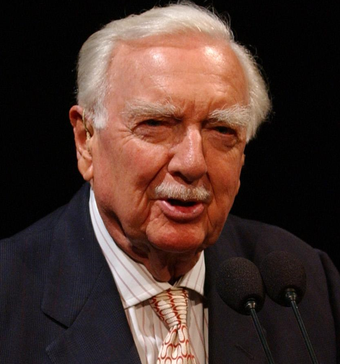
Walter Cronkite
Walter Cronkite, the iconic anchor of CBS Evening News, on location during the Vietnam War.
10.5.6: Blogs, Podcasts, and Cyberspace
Blogs and podcasts are forms of media that exist within cyberspace and encourage interactions among people.
Learning Objective
Compare and contrast blogs and podcasts as formats of new media
Key Points
- An early milestone in the importance of blogs came in 2002, when bloggers focused on comments by Senate Majority Leader Trent Lott. Blogging helped to create a political crisis that forced Lott to step down as majority leader.
- Podcasts, which are audio or video files, are a horizontal form of media: producers are consumers and consumers become producers and engage in conversations with each other. This allows online social interactions.
- In current usage “cyberspace” stands for the global network of interdependent information technology infrastructures, telecommunications networks, and computer processing systems. The term has become a conventional means to describe anything associated with the Internet.
Key Terms
- blog
-
A blog is a discussion or informational site published on the internet and consisting of posts typically displayed in reverse chronological order.
- Podcast
-
A podcast is a type of digital media consisting of an episodic series of audio, video, PDF, or ePub files subscribed to and downloaded through web syndication or streamed online to a computer or mobile device.
- Cyberspace
-
Cyberspace is the electronic medium of computer networks in which online communication takes place.
Cyberspace
Cyberspace is the electronic medium of computer networks in which online communication takes place . Now ubiquitous, in current usage the term “cyberspace” stands for the global network of interdependent information technology infrastructures, telecommunications networks, and computer processing systems. The term has become a conventional means to describe anything associated with the Internet and the diverse Internet culture, such as blogs, podcasts, or social media. The United States government recognizes the interconnected information technology and the interdependent network of information technology infrastructures operating across this medium as part of the US National Critical Infrastructure.
Cyberspace describes the flow of digital data through the network of interconnected computers. It is not “real,” since one cannot spatially locate it as a tangible object, yet “real” in its effects.
Blogs
A blog is a discussion or informational site published on the internet consisting of posts typically displayed in reverse chronological order. Until 2009, blogs were usually the work of a single individual, occasionally of a small group, and often were themed on a single subject. More recently “multi-author blogs” (MABs) have developed. MABs from newspapers, other media outlets, universities, think tanks, interest groups, and similar institutions account for an increasing quantity of blog traffic. The rise of Twitter and other “micro-blogging” systems helps integrate MABs and single-author blogs into societal news streams.
Although not a requirement, most good quality blogs are interactive, allowing visitors to leave comments and even message each other on the blogs. It is this interactivity that distinguishes them from other static websites. In that sense, blogging can be seen as a form of social networking. Indeed, bloggers do not only produce content to post on their blogs, but also build social relations with their readers and other bloggers.
Many blogs provide commentary on a particular subject, others function as personal online diaries, and still others function more as online brand advertising of a particular individual or company. A typical blog combines text, images, and links to other blogs, Web pages, and other media related to its topic. Microblogging is another type of blogging, featuring very short posts. In education, blogs can be used as instructional resources.
Blogs and Politics
An early milestone in the importance of blogs in politics came in 2002, when bloggers focused on comments by Senate Majority Leader Trent Lott . Senator Lott, at a party honoring Senator Strom Thurmond, praised Thurmond by suggesting the United States would have been better off had Thurmond been elected president. Lott’s critics saw these comments as a tacit approval of racial segregation, a policy advocated by Thurmond’s 1948 presidential campaign. This view was reinforced by documents and recorded interviews dug up by bloggers. Though Lott’s comments were made at a public event attended by the media, no major media organizations reported on his controversial comments until after blogs broke the story. Blogging helped to create a political crisis that forced Lott to step down as majority leader.
Similarly, blogs were among the driving forces behind the “Rathergate” scandal. Dan Rather presented documents on the CBS show 60 Minutes that conflicted with accepted accounts of President Bush’s military service record. Bloggers declared the documents to be forgeries and presented evidence and arguments in support of that view. Consequently, CBS apologized for what it said were inadequate reporting techniques. More often, however, news blogs tend to react to material already published by the mainstream media. Meanwhile, an increasing number of experts began blogging, making blogs a source of in-depth analysis.
By 2004, the role of blogs became increasingly mainstream, as political consultants, news services, and candidates began using them as tools for outreach and opinion forming. Blogging was established by politicians and political candidates to express opinions on war and other issues and cemented blogs’ role as news sources.
Podcast
A podcast is a type of digital media consisting of an episodic series of audio, video, PDF, or ePub files subscribed to and downloaded through web syndication or streamed online to a computer or mobile device. Podcasting is both a converged medium bringing together audio, the web, and portable media players, and a disruptive technology that has caused some in the radio business to reconsider certain established practices and preconceptions about audiences, consumption, production, and distribution. It is very much a horizontal media form: producers are consumers and consumers become producers and engage in conversations with each other.
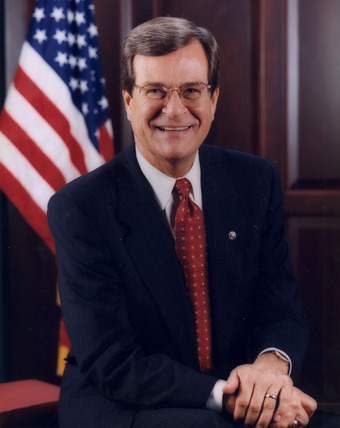
Senator Trent Lott
The Trent Lott-Strom Thurmond scandal was first picked up and publicized by early political blogs. It marked one of the first times in which mainstream media followed a story publicized in blogs.
Chapter 9: Political Participation and Voting
9.1: Voting as Political Participation
9.1.1: Voting as Political Participation
Voting is the most quintessential form of political participation, although many eligible voters do not vote in elections.
Learning Objective
Discuss the importance of voting as a process of political participation.
Key Points
- From the 1860s to present day, voter registration laws have gradually been reformed to make voter registration easier, increasing the amount of voters who are able to register. Online registration and same-day registration has also increase the percentage of eligible voters who are registered.
- The rate of voter turnout depends on the type of election: state and local elections have the lowest turnout, midterm elections have slightly higher turnouts, and presidential elections have the highest turnout.
- While over 90% of Americans believe voting is a civic duty, many do not vote, often due to informal barriers such as the hassle of registering to vote.
Key Terms
- voter turnout
-
Voter turnout is the percentage of eligible voters who cast a ballot in an election. Exactly who is eligible varies by country, and should not be confused with the total adult population.
- vote
-
To cast a vote; to assert a formalised choice in an election.
- voter registration
-
Voter registration is the requirement in some democracies for citizens and residents to check in with central registry specifically for the purpose of being allowed to vote in elections.
Voting
Voting is the most prominent form of political participation, and in fact, for many people, it is the primary means of participating in politics. A unique and special political act, voting allows for more people’s views to be represented than any other activity. Every citizen gets one vote that counts equally . Expanded voter registration means that more and more people have been able to participate, and voter turnout trends indicate how many people exercise their right to vote as a primary means of political participation.
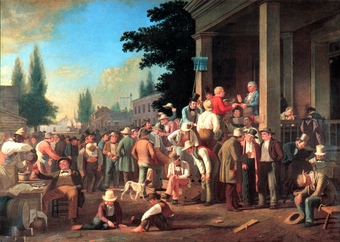
History of Voting in the United States
This painting from 1846 depicts a polling judge administering an oath to a voter. Since America’s founding, voting has been a primary avenue for citizen participation in politics.
Voter Registration: The First Step to Participation
In order to participate in voting, citizens must be registered. To register, citizens must meet eligibility requirements and have filed the necessary paperwork that permits them to vote in a given locality. Eligibility requirements require voters to be eighteen years of age, and states can enforce residency requirements that mandate the number of years a person must live in a place before being eligible to vote. The composition of the electorate has changed radically throughout American history. The pool of eligible voters has expanded from primarily white, male property owners at the founding, to include black men after the Civil War, women after 1920, and eighteen- to twenty-year-olds after 1971.
Voter registration laws were implemented in the 1860s by states and big cities to ensure that only citizens who met legal requirements could vote. Over time, residency requirements were relaxed. Beginning in the 1980s, some states, including Maine, Minnesota, and Wisconsin, made it possible for people to register on Election Day. Turnout in states that have Election Day registration averages ten points higher than in the rest of the country. The United States is one of the few democracies that requires citizens to register themselves rather than having the government take responsibility for automatically registering them.
Significant steps have been taken to make registration easier, and to ensure more people can participate in elections. In 1993, Congress passed the National Voter Registration Act of 1993, also known as the “motor voter” law, allowing citizens to register at motor vehicle and social service offices. “Motor voter’s” success in increasing the ranks of registered voters differs by state depending on how well the program is publicized and executed. Voter registration also has increased as a result of online registration. Rock the Vote (RTV), a nonpartisan youth mobilization organization, established the first online voter registration initiative in 1992 with official backing from the Congressional Internet Caucus. RTV registered over 2 million new voters in 1992, 80% of whom cast a ballot, and signed up over 2.5 million voters in 2008.
Voter Turnout
Over 90 percent of Americans agree with the principle that citizens have a duty to vote. Still, many people do not vote regularly. Social, cultural, and economic factors can keep people from voting, or sometimes barriers to voting are informal. The United States holds a large number of elections, each governed by specific rules and schedules. With so many elections, people can become overwhelmed, confused, or just plain tired of voting.
How many people actually participate in elections often depends on the type of election. A large number of elections are held in the United States every year, including local elections, elections for county and statewide offices, primaries, and general elections. Only a small number of people, generally under one-quarter of those eligible, participate in local, county, and state elections. Midterm elections, in which members of Congress run for office in nonpresidential-election years, normally draw about one-third of eligible voters. Young voters are less likely to turn out in midterm elections than older citizens. In 2010, only about 23 percent of eligible eighteen- to twenty-nine-year-olds cast a ballot. Voter turnout in presidential elections is generally higher than for lower-level contests; usually more than half the eligible voters cast a ballot .
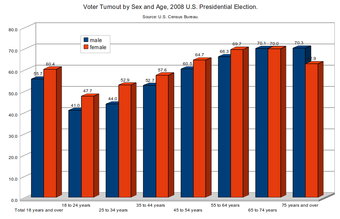
Voter Turnout by Sex and Age (2008)
This is a chart illustrating voter turnout by sex and age for the 2008 U.S. Presidential Election using data from the U.S. Census Bureau. Notice the higher turnout rates for women, and for older people.
Voter turnout in the current era has not fluctuated much since voting participation during universal suffrage in 1920. Forty-nine percent of the voting-age public cast a ballot in the 1924 presidential contest, the same percentage as in 1996. Turnout in presidential elections in the 1960s was over 60 percent. More voters were mobilized during this period of political upheaval and people focused on issues of race relations, social welfare, and the Vietnam War. Turnout was lower in the 1980s and 1990s, when the political climate was less tumultuous. There has been a steady increase in turnout since the 2000 presidential election, in which 51 percent of the voting-age public cast a ballot. Turnout in the 2008 election was greater than usual, at 57 percent .
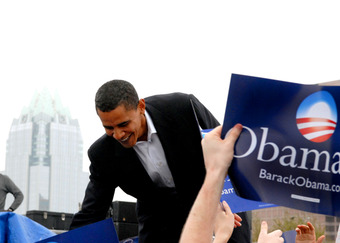
2008 Election
Participation in the 2008 presidential election was greater than usual, as people were motivated by the open race and the candidate choices.
9.1.2: Other Forms of Political Participation
Besides voting, there are many other ways to take part in politics, each involving varying amounts of skill, time, and resources.
Learning Objective
Describe several different ways in which citizens can participate in the political process
Key Points
- New media and technology, such as social networking sites, blogs, online campaign donations, have provided new avenues for political organization and participation.
- Citizens can participate in civil society, which is an important part of political participation, through activities like volunteering, attending events associated with causes (like a sporting event or a concert), or joining an interest group or civic organization.
- Citizens can also protest, riot, or refuse to vote to demonstrate dissatisfaction with certain elements of their political system.
- Citizens also participate in politics by being directly involved in campaigns. Citizens can run for office themselves, donate money or time to candidates, or discuss political issues and campaigns with friends and family.
Key Terms
- protest
-
A protest is an expression of objection, by words or by actions, to particular events, policies, or situations. Protests can take many different forms, from individual statements to mass demonstrations. Protesters may organize a protest as a way of publicly making their opinions heard in an attempt to influence public opinion or government policy.
- civil society
-
All of the institutions, voluntary organizations, and corporate bodies that are less than the state but greater than the family.
- social media
-
Interactive forms of media that allow users to interact with and publish to each other, generally by means of the Internet.
Far more people participate in politics by voting than by any other means, yet there are many other ways to take part in politics.
Contacting Public Officials
Expressing opinions to leaders is one avenue of political participation. The number of people contacting public officials at all levels of government has risen markedly over the past three decades. Seventeen percent of Americans contacted a public official in 1976. By 2008, 44 percent of the public had contacted their member of Congress about an issue or concern. E-mail has made contacting public officials cheaper and easier than the traditional method of mailing a letter.
Donating Money, Time, and Resources to a Campaign
The number of people who give money to a candidate, party, or political organization has increased substantially since the 1960s. Over 25 percent of the public gave money to a cause and 17 percent contributed to a presidential candidate in 2008. Direct mail and e-mail solicitations make fundraising easier, especially when donors can contribute through candidate and political-party websites. A positive side effect of fundraising campaigns is that people are made aware of candidates and issues through appeals for money.
During campaigns, people may work for political parties or candidates, organize campaign events, and discuss issues with family and friends . Generally, about 15 percent of Americans participate in these types of campaign activities in an election year. New media offer additional opportunities for people to engage in campaigns. People can blog or participate in discussion groups related to an election. They can use social media sites, like Facebook, to recruit supporters, advertise for campaign events, or encourage friends to donate money to a candidate.

Participating in campaigns
Making phone calls during a campaign can be an important way for citizens to participate in politics.
Running for Office
Another avenue for political participation is running for office. Being a public official requires a great deal of dedication, time, energy, and money. About 3 percent of the adult population holds an elected or appointed public office.
Participating by Protesting
Political protest activity represents another sphere of political participation. Protests involve unconventional, and sometimes unlawful, political actions that are undertaken to gain rewards from the political and economic system. Protest behavior can take many forms. People can engage in nonviolent acts of civil disobedience where they deliberately break a law that they consider to be unjust. This tactic was used effectively during the 1960s civil rights movement . Other forms of protest behavior include marking public spaces with graffiti, demonstrating, and boycotting. Extreme forms of protest behavior include acts that cause harm, like bombing a building or rioting. Members of social movements may resort to rioting when they perceive that there are no conventional alternatives for getting their message across.
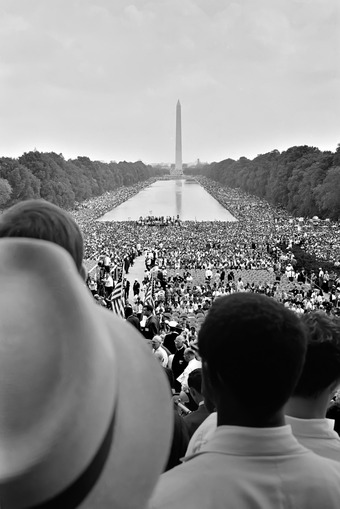
March on Washington for Jobs and Freedom, 1963
Interest groups may attempt to influence policy through public opinion campaigns, demonstrating that the electorate favors a particular policy stance.
Being a Part of Civil Society
About half the population takes part in national and community political affairs by joining an interest group, issue-based organization, civic organization, or political party. Organizations with the goal of promoting civic action on behalf of particular causes, or single-issue groups, have proliferated. These groups are as diverse as the People for the Ethical Treatment of Animals (PETA), which supports animal rights, to the Concord Coalition, which seeks to protect Social Security benefits.
Even activities that on the surface do not seem to have much to do with politics can be a form of political participation. Coaching a little league team, volunteering at a nursing home, or working at a homeless shelter all represent participation in civil society, the community of individuals who volunteer and work cooperatively outside of formal governmental institutions. Civil society depends on social networks, based on trust and goodwill, that form between friends and associates and allow them to work together to achieve common goals. Community activism is thriving among young people who realize the importance of service that directly assists others. Almost 70 percent of high school students and young adults aged eighteen to thirty report that they have been involved in community activities .
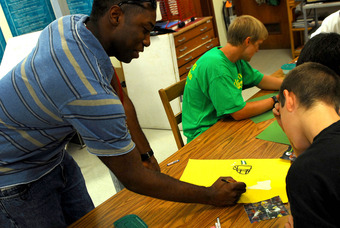
Volunteering as political participation
Volunteering is another form of political participation and a crucial part of a healthy civil society.
Participating in Support Activities
People also can take part in support activities, which are more passive forms of political involvement. They may attend concerts or participate in sporting events associated with causes, such as the “Race for the Cure” for breast cancer. These events are designed to raise money and awareness of societal problems, such as poverty and health care. Support activities can lead to active participation, as people learn about issues through these events and decide to become involved.
Symbolic Participation and Symbolic Non-Participation
People also can engage in symbolic participation, routine or habitual acts that show support for the political system. People salute the flag and recite the pledge of allegiance at the beginning of a school day and they sing the national anthem at sporting events. Symbolic acts are not always supportive of the political system. For example, some people may refuse to vote to express their dissatisfaction with government.
9.2: Why People Vote
9.2.1: Socioeconomic Factors
Depending on socioeconomic factors like wealth, education, or occupation, people are more or less likely to vote.
Learning Objective
Describe the relationship between socioeconomic status and voting behavior
Key Points
- Wealthier people are more likely to vote, as they generally possess the resources and time to be active in politics.
- Of all the socioeconomic factors impacting voter turnout, education has the greatest impact. The more educated a person is, the more likely they are to vote, as they have a better understanding of how the system works, how to influence the system, and why participation is important.
- A person is more or less likely to vote depending on their occupation. Managerial or professional workers are more likely to vote, and the unemployed are the least likely group to vote.
Key Terms
- voter turnout
-
Voter turnout is the percentage of eligible voters who cast a ballot in an election. Exactly who is eligible varies by country, and should not be confused with the total adult population.
- socioeconomic status
-
Socioeconomic status (SES) is a combined economic and sociological measurement of a person’s work experience and of an individual’s or family’s economic and social position in relation to others, based on income, education, and occupation.
- vote
-
To cast a vote; to assert a formalised choice in an election.
Introduction
Socioeconomic status (SES) is determined by an individual’s level of education, income, and occupation. Socioeconomic factors significantly affect whether or not individuals develop the habit of voting. Voters and political activists generally are more educated and better off financially than the general population. Because of this, these people have the best chance of having their views represented in government. Meanwhile, those who rely the most on government programs and policies, such as recipients of public assistance, often have fewer opportunities to participate and are less engaged with the process of electing representatives.
Income and Voting
Independently, income has some effect on whether or not people vote. Wealthier people are more likely to vote, regardless of their educational background . Wealthier and better educated people tend to vote more often, participate more in political activities, and donate more money to causes than poorer or less educated people. They also have greater access to the resources that facilitate political activity, including contact with people in powerful positions.
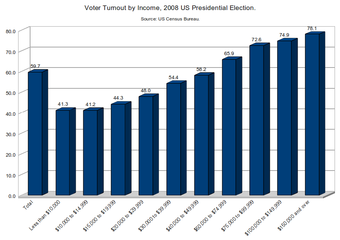
Voter Turnout by Income (2008)
This is a figure illustrating the different rates of voting in the 2008 U.S. Presidential Election by income. The higher income, the more likely a person is to vote.
Education and Voting
The most important socioeconomic factor affecting voter turnout is education . The more educated a person is, the more likely he or she is to vote. Studies show that this is true, even controlling for other factors that are closely associated with education level, such as income and class. Education has the strongest impact on participation, as it provides people with background knowledge as to how the political system works and how the action of voting is connected with the realities of their lives. Educated people develop the skills that allow them to follow and understand national and international events through the mass media. They are likely to form opinions about political issues and engage in discussions. The most popular political blogs, such as Daily Kos and Huffington Post, are produced and read by well-educated people. Education also prepares people to deal with the bureaucratic aspects of participation, such as registering to vote or organizing petition drives. Eighty-three percent of people with a graduate school education voted in the 2008 presidential election. In comparison, only 39% of those without a high school diploma voted that year. The 2010 midterm elections were decided primarily by people with at least some college experience. Less than 5% of voters had no high school education, 16% were high school graduates, 29% had some college education, and 50% were college graduates.
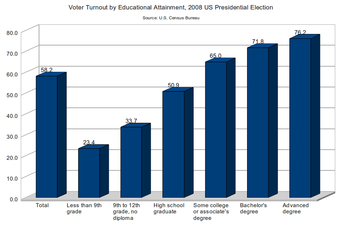
Voter Turnout by Educational Attainment –2008 Presidential Election
Educational attainment, an indicator of social class, can predict one’s level of political participation. Those with high educational attainment are more likely to vote in elections than those with little education.
Occupation and Voting
People’s occupations also are related to their participation and their likelihood to vote. People in managerial and professional positions are the most politically active, followed by craftspersons, service workers, and laborers. Many managers and professionals follow politics as part of their jobs. The unemployed are the least inclined to participate in politics through voting, however, because they may rely on governmental services to survive, they are frequently among those most immediately affected by the outcome of elections.
9.2.2: Additional Factors: Gender, Age, Religion, Race, and Ethnicity
Certain factors like age, gender, race, and religion help describe why people vote and who is more likely to vote.
Learning Objective
Describe the voting patterns of various demographic subsets of the American electorate
Key Points
- Traditionally people ages 30 to 65 are most likely to vote, but recently young people have been coming out to the polls more frequently, in part due to mobilization via social media.
- Since the 1980s, women have voted as much or more than men, removing the idea that there is a gender gap in certain types of political participation like voting.
- Different ethnic groups also have unique voting trends. African-American voters vote as much as other voters of the same socioeconomic status, and Asian voters have lower voter turnout rates. Latinos tend to vote less than other groups, but their vote has been rising in importance.
- People may vote due to religious convictions or socially conservative viewpoints, such as those voters who identify with the Christian right. Voters identifying with the Christian right have high turnout rates and vote frequently.
Key Terms
- Youth vote
-
The youth vote is a political term used primarily in the United States to describe 18 to 29-year-olds and their voting habits.
- Christian right
-
Christian right is a term used in the United States to describe right-wing Christian political groups that are characterized by their strong support of socially conservative policies.
- gender gap
-
A measurable difference between the behaviors of men and women.
Age and Political Participation
Political participation differs notably by age . People between the ages of 35 and 65 are the most politically active. At this stage in life, people are more likely than younger people to have established homes, hold steady jobs, and be settled into communities. Those with stable community roots often have strong incentives and greater resources for becoming involved in politics. Senior citizens, people age 65 and older, also have high turnout rates of around 70 percent.
Historically, young people have been less likely to vote as they often lack the money and time to participate. However, the youth vote has been on the rise: turnout among 18 to 24-year-olds was at 36 percent in 2000, but this rose to 47 percent in 2004 and 51 percent in 2008. This rise in youth vote is partly a result of voter registration and mobilization efforts by groups like Rock the Vote. An important factor in the increase of younger voters in 2008 was the greater appeal of a younger, non-white candidate in Barack Obama. According to the Pew Research Center, 66% of voters under 30 chose Obama in 2008. New technology, especially the internet, is also making it easier for candidates to reach the youth. Websites such as Facebook and YouTube not only allow students acquire information about the polls, but also allow them to share their excitement over the polls and candidates.
Gender and Political Participation
Political scientists and journalists often talk about the gender gap in participation, which assumes women lag behind men in their rates of political engagement . However, the gender gap is closing for some forms of participation, such as voting. Since 1986, women have exceeded the turnout rate for men in presidential elections; 66 percent of women cast a ballot in 2008 compared with 62 percent of men. This may be due to the political prominence of issues of importance to women, such as abortion, education, and child welfare.
Race, Ethnicity, and Voting: African Americans
Participation and voting differs among members of racial and ethnic groups . Discriminatory practices kept the turnout rate of African-Americans low until after the passage of the Voting Rights Act of 1965. Poll taxes, literacy tests, and intimidation kept black voters from the polls. Eventually, civil rights protests and litigation eliminated many barriers to voting. Today, black citizens vote at least as often as white citizens who share the same socioeconomic status. Collectively, African Americans are more involved in the American political process than other minority groups in the United States, indicated by the highest level of voter registration and participation in elections among these groups in 2004. Sixty-five percent of black voters turned out in the 2008 presidential election compared with 66 percent of white voters.
Race, Ethnicity and Voting: Latinos
The Latino population in the United States has grown to over 47 million people from diverse countries of origin. Although this group forms a substantial political bloc, only 49 percent of eligible Latino voters voted in the 2008 presidential election. Language is one barrier to Latino participation. Candidates recognize that Latinos constitute a large and growing voting bloc and have begun campaigning in Spanish. During the 2000 presidential election campaign, candidate George W. Bush ran nearly as many ads in Spanish as in English. The 2008 presidential candidates’ websites, as well as the 2010 congressional candidates, featured extensive Spanish-language content .
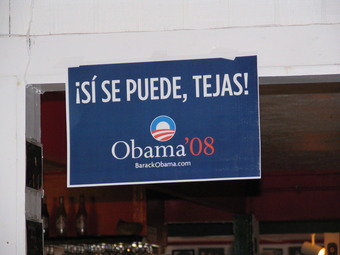
Reaching the Latino Vote
Candidates routinely aim campaign ads at the fast-growing Latino and Asian American populations.
Race, Ethnicity, and Voting: Asian Americans and Pacific Islanders
According to the U.S. Census, Asian Americans and Pacific Islanders are the fastest growing and most diverse ethnic group, yet their rates of participation are lower than other groups. In 2008, 48 percent of Asian Americans turned out to vote. Some argue that cultural factors, such as a strong tie to their ethnic culture, contribute to the lower levels of Asian American and Pacific Islander voting. However, Asian Americans who have been victims of hate crimes or consider themselves to be part of a deprived group find their way to the polls in greater numbers.
Religious Convictions and Voting
Oftentimes, religious convictions motivate voters. The most prominent example of this in American politics is the Christian right, which consists of right-wing Christian political groups that are characterized by their strong support of socially conservative policies. In the U.S., the Christian right is an informal coalition formed around a core of white evangelical Protestants that draws support from other groups who share their goals. Voters who are part of the Christian right hold socially conservative positions on issues including school prayer, stem cell research, homosexuality, contraception, abortion, and pornography. About 15% of the electorate in the United States supports the Christian right. Much of the Christian right’s power within the American political system is attributed to their extraordinary turnout rate at the polls. The voters that identify with the Christian right are highly motivated and driven to deliver a viewpoint on issues they care about.
9.2.3: Party Identification
Some people are motivated to vote because they identify very strongly with one party.
Learning Objective
Differentiate between two ways of understanding the stability of party identification
Key Points
- Since the 1960s, more people have chosen to be independents rather than identify with either Republicans or Democrats, which means that less and less people vote based on their identification with a specific party.
- Some argue that a person’s party identity is a relatively fixed social identity, formed by personal experiences, family beliefs, or social environment. Others claim that party identity is flexible, and that people change their party identity according to their experiences and rational choice.
- Party identification is not just an individual identity; it can also be important for groups. Social, economic, racial, and other similar groups can become aligned to certain parties, and then vote according to that party identification.
- When people identify very strongly with one party, they tend to vote for that party consistently. This can lead to straight-ticket voting.
Key Terms
- independent
-
A candidate or voter not affiliated with any political party, a free thinker, free of a party platform.
- straight-ticket voting
-
The practice of voting for candidates of the same party for multiple positions. The finished voting ballot would consist of all Democrats or all Republicans, for example.
- party identification
-
Party identification refers to the political party with which an individual identifies. Party identification is typically determined by the political party that an individual most commonly supports (by voting or other means).
Party Self-Identification
Oftentimes, people vote according to what party they identify with. A person’s partisan identification is defined as a long-term attachment to a particular party. Americans are not required to formally join party organizations as is the case with other democracies. Instead, people self-identify as Republicans, Democrats, or members of minor parties. They also can declare themselves independent and not aligned with any political party. People who identify with a political party either declare their allegiance by joining the party or show their support through regular party-line voting at the polls.
Party Identity: A Fixed Social Identity?
Some researchers view party identification as “a form of social identity,” in the same way that a person identifies with a religious or ethnic group. In this view, party identification develops as a consequence of personal, family, social, and environmental factors. Childhood influence is one of main driving factors behind formation of party identification. During childhood, the main political influence comes from parents, other close family members, and close surroundings such as the immediate community. Children remember events that happened during their childhood and associate them with the political party, whether or not they were connected with those events. For example, a child growing up in the 1970s would associate the Republican party with the Watergate scandal of the Nixon administration or a child growing up in the 1990s would associate the Democratic party with the sex scandal of the Clinton administration. Although these parties might or might not embrace the issues that happened during that administration, a child could forever associate the party with those memorable events.
During adulthood, people can begin to adjust their party loyalties according to their personal experiences. The longer an individual holds a party identification, the stronger that attachment to the party becomes. Because of this pattern, older adults are more likely to hold strong party attachments, and less likely to change them than young adults.
Party Identity: A Changing Choice?
Other researchers consider party identification to be more flexible and more of a conscious choice. They see it as a position and a choice based on the continued assessment of the political, economic, and social environment. People can easily switch their party affiliation or distance themselves from parties entirely.
Increase in Independents
Since the 1960s, there has been a gradual decline in identification with political parties and a rise in the number of independents, which means less and less people are motivated to vote along party lines alone. In 2000, more people identified as independents (40 percent of the voting population) than affiliated with either the Democratic (34 percent) or Republican (24 percent) parties for the first time in history. The proportion of people registering as independents increased 57 percent between 1990 and 1998, while those registering as Democrats declined by 14 percent and as Republicans by 5 percent. In 2011, 31 percent of the population identified as Democrats, 29 percent as Republican, and 38 percent as independents .

Party Identification, 2004
This chart indicates the number of citizens registered as Republicans, Democrats, or Independents. The number of people identifying as independents is rising, indicating that less people are voting solely along traditional party lines.
As voter identification with political parties has declined, so has dedication to the two-party system. According to a national survey, citizens have more trust in product brands, such as Nike, Levis, Honda, and Clorox, than in the Democrats and Republicans. Since the 1980s, Americans have become skeptical about the two major parties’ ability to represent the public interest and to handle major issues facing the country, such as crime, the environment, and saving Social Security. At the same time, support for third parties, like Libertarians, has increased over the last decade. A social movement grouped under the umbrella of the “Tea Party” emerged in 2010 but its adherents never created an officially recognized political party. Still, the two-party system continues to dominate the political process as a viable multiparty alternative has not emerged .

Voting Along Party Lines
This chart indicates the results of the 2008 presidential election. Dark red districts supported Republican for President and Congress; red districts supported a Republican for President, and Democrat for Congress. Dark blue indicates districts that supported Democrat for President and Congress; blue indicates districts that supported Democrat for President and a Republican for Congress.
Groups and Party Identification
Party coalitions consist of groups that have long-term allegiances to a particular political party. Regions of the country establish loyalties to a specific party as a result of the party’s handling of a war, a major social problem, or an economic crisis. Social, economic, ethnic, and racial groups also become aligned with particular parties, and then vote according to that party identification. For example, Catholics and labor union members in the Northeast form a part of the Democratic coalition. White fundamentalist Protestants are a component of the Republican coalition. Parties count on coalition members to vote for them consistently in elections.
Strong Party Identification and Voting Patterns
Those people who identify with a party tend to vote for their party’s candidate for various offices in high percentages. Those who consider themselves to be strong partisans, strong Democrats and strong Republicans respectively, tend to be the most faithful in voting for their party’s nominee for office, and are typically the voters who practice straight-ticket voting.
9.2.4: Political Ideology
People can be motivated to vote based on their political ideology, or how they think government, economy, and society should be structured.
Learning Objective
Describe the ideological spectrum of the American electorate
Key Points
- Voters typically agree with one of the main political ideologies (liberalism, conservatism or moderates) and they vote according to the beliefs of that particular ideology.
- Libertarians are less organized and well-known than conservatives, liberals or moderates, but are a significant minority ideology. They believe in social liberties, but conservative economic policies.
- Moderates fall somewhere in between liberalism and conservatism on the spectrum of political ideologies. Approximately 35% of Americans identified as moderates in 2010, and these voters tend to vote either Republican, Democrat, or neither.
- Liberals believe in progressive social policies and more government provision of positive rights, such as healthcare or education. Liberals tend to vote Democrat, and in 2010, roughly 25% of Americans identified as liberals.
- Conservatives prefer to maintain the status quo and believe in socially conservative policies, as well as limited government intervention in the economy. This is a prominent ideology in US politics, as roughly 40% of Americans self-identify as conservatives.
Key Terms
- conservative
-
A political and social philosophy that promotes retaining traditional social institutions; often exemplified by the Republican Party in US politics.
- liberal
-
One with liberal views, supporting individual liberty (see Wikipedia on Liberalism for a description of the various and diverging trends of liberalism).
- political ideology
-
A political ideology is a certain ethical set of ideals that explains how society should work, and offers some political and cultural blueprint for a certain social order. It focuses on type of government and economy.
Voting Based on Ideology
Sometimes, people vote based on their political ideology. The ideological position a person or party takes may be described in terms of what kinds of social and economic policies they would like to see implemented. Political ideologies in the United States vary considerably. Persons in the U.S. generally classify themselves either as adhering to positions along the political spectrum as liberal-progressive, moderate, or conservative, but there are several subgroups of all of these three. Among those who do identify as either liberal or conservative, few identify as “far left” or “far right. ” Most Americans either identify as “moderate” or as “somewhat” liberal or conservative.
Conservatives and Liberals
Modern American liberalism aims at the preservation and extension of human, social and civil rights as well as the government guaranteed provision of positive rights. American conservatism commonly refers to a combination of economic liberalism and social conservatism and to an extent, libertarianism. It aims at protecting traditional values (especially on social issues) while promoting the concept of small government.
In the U.S., the Democratic Party generally represents liberal ideals, while the Republican Party commonly represents conservative ideals. The size of ideological groups varies slightly depending on the poll. Gallup/USA Today polling in June 2010 revealed that 42% of those surveyed identify as conservative, 35% as moderate, while 20% identify as liberal . In another polling in June 2010, 40% of American voters identify themselves as conservatives, 36% as moderates and 22% as liberals, with a strong majority of both liberals and conservatives describing themselves as closer to the center than to the extremes .

Percentage of LIberals in the US
Percent of self-identified liberals in the United States, broken down by state, according to Gallup, August 2010. The darkest colors to lightest colors, respectively, indicate the greatest percentages of people identifying as liberals. (The darkest color represents 28% and above, while the lightest color is under 14%).
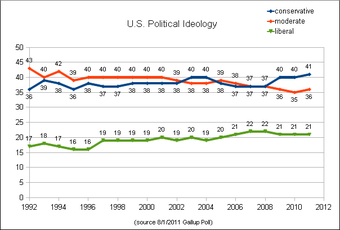
Political Ideology Trends
This chart, using Gallup Poll data, depicts trends in US political ideologies from 1992-2012.
Liberalism and conservatism are the most common ideologies in the U.S., apart from those who identify as moderate. Individuals embrace each ideology to widely varying extents. Liberals and progressives commonly advocate strong civil liberties, social progressivism, cultural pluralism, government ensuring of positive rights (education, health care, etc.) and a mixed economy. Conservatives commonly defend the notional status quo of some point in the past, believing that the US has deviated significantly from it, and advocate more traditional stands on social issues, protection of gun rights and much less government intervention.
Moderates
Moderates, who may be left or right leaning, incorporate different aspects from liberalism and conservatism into their personal perspective. According to recent polls, moderates are commonly identified as the second largest group, closely trailing conservatives, constituting between 36% and 39% of the population. Moderates are commonly defined through limiting the extent to which they adopt liberal and conservative ideas. CNN exit polls have found moderates to be rather evenly divided between the country’s two main parties. Even though liberals as a whole tend to be the most educated ideological demographic (as indicated by Pew research), moderates tend to become increasingly conservative with increased economic prosperity, causing the professional class to be split between Republicans and Democrats.
Libertarians
While often not mentioned in major polls and less organized than liberal or conservatives, libertarians are a significant minority, constituting roughly 13% of the electorate. Libertarians commonly hold liberal views on social issues but conservative views on economic issues. Since the 1980s, a majority of libertarians have favored the Republican Party, although in recent years, the margin favoring the Republicans has begun to shrink because of the libertarians’ opposition to many recent Republican supported social issues.
Typological Groups
In a 2005 study, the Pew Research Center identified nine typological groups. Three groups were identified as part of “the left,” “the middle,” and “the right. ” In this categorization system, “the right” roughly represents the Republican base, those on “the left” the Democratic base and those in “the middle” independents. Within the left are the largely secular and anti-war “Liberals”, the socially conservative but economically left “Conservative Democrats”, and the economically “Disadvantaged Democrats” who favor extended government assistance to the needy. In “the middle” are the optimistic and upwardly mobile “Upbeats”, the discouraged and mistrusting “Disaffecteds,” and the disenfranchised “Bystanders. ” The right compromises the highly pro-business “Enterprisers,” the highly religious “Social Conservatives” (also known as the Christian right), and the “Pro-Government Conservatives” who are largely conservative on social issues but support government intervention to better their economic disposition.
9.2.5: The Candidates
Oftentimes, people vote based on specific candidate’s characteristics, experiences, or likeability.
Learning Objective
Discuss partisan dealignment and the factors that make it more prevalent
Key Points
- While party loyalty, political ideologies, and specific policy issues are important to voters, candidates’ personal popularity may also be a crucial factor for voters.
- In recent years, more and more voters are identifying as independents. This partisan dealignment means that more and more people do not base their votes on party identification, and may be more likely to vote based on short-term criteria like the likeability of a specific candidate.
- Campaigns attempt to create an image for their candidate. By presenting a candidate in the right way, campaigns hope to make their candidate look like a more attractive and desirable choice than the opponent.
Key Terms
- partisan dealignment
-
Dealignment, in political science, is a trend or process whereby a large portion of the electorate abandons its previous partisan affiliation, without developing a new one to replace it.
- mass media
-
The mass media are all those media technologies that are intended to reach a large audience by mass communication, which includes broadcast media and print media.
- candidate
-
A person who is running in an election or who is applying to a position for a job.
While identifying with and believing strongly in a particular party or political ideology can be important in explaining why and how people vote, these factors seldom decide elections alone. A candidate’s image and her position on issues are also very important, particularly when independents and undecided voters hold the balance.
Partisan Dealignment
Party identities become less important when voters base their decisions on short-term, election-specific factors, such as the leadership qualities of a candidate. This is often called a partisan dealignment. A partisan dealignment may be occurring today, as more people are identifying as independents and more voters choose based on personal traits of candidates, such as honesty. Mass media can contribute to partisan dealignment by focusing attention on candidates’ personalities and scandals, which are short-term factors that can influence vote choice.
Candidates’ Images and Voting
Voters often vote based on candidates’ images or likeability . Candidate images consists of the background, experiences, and personal qualities of people running for elected office. Campaigns strive to present an image of their candidate that fits the public’s expectations of the office sought, especially in comparison with the opponent, who is often portrayed as less qualified. Voters expect the president to have leadership skills and to be principled, decisive, and honest. Other qualities, such as military service and compassion, may be deemed by the public and the media to be important as well. Candidate images are not entirely malleable. Age, gender, race, and military service cannot be changed easily, but they can be manipulated by selective accounting and shrewd presentation of the facts. Images are easiest to create early in a campaign when many people may not know much about a candidate. The public acceptance of a candidate’s possible images tends to depend on the media’s depictions. Oftentimes, voters will make decisions about who to vote for based on their perception of a specific candidate’s personality, leadership traits, or family values.
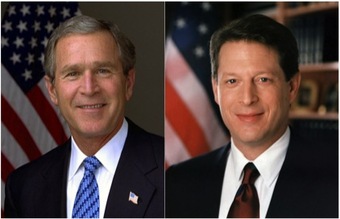
Candidate Image
The media’s depictions of presidential candidates Republican George W. Bush and Democrat Al Gore during the 2000 presidential election influenced public perceptions. Bush was depicted as being unintelligent by news organizations that compiled lists of his gaffes and malapropisms. Gore was construed as being dishonest for allegedly claiming that he invented the Internet. When people decide to vote based on candidates rather than party identification or political ideology, candidate image can be very important.
9.2.6: Policy Preferences
In some elections, voters are motivated to vote a certain way based on specific policy preferences, which is called issue voting.
Learning Objective
Differentiate between issue voting and party voting and the reason(s) a voter would opt for one or the other
Key Points
- Issue voting can be complex for voters because candidate’s views may not match their own, or voters may have multiple issues or policies that concern them equally.
- Issue based voting is often contrasted with voting based solely on party identification. Low-information elections often have more votes cast simply along party lines, while votes in higher-information elections (like presidential elections) may be based more in specific policy preferences.
- Voters who vote based on policy preferences must be able to identify different opinions on a particular issue, form their own opinion, and then be able to identify which party or candidate best matches their opinion.
Key Terms
- party voting
-
The type of voting that describes when voters cast their vote based on their self-identification with a particular political party.
- issue voting
-
The type of voting that occurs when voters cast their vote based on political issues.
- candidate
-
A person who is running in an election or who is applying to a position for a job.
Issue Voting
Rather than voting based on political ideologies, political parties, or candidates, sometimes voters cast votes based on specific policy preferences. In “issue voting,” voters cast their vote based primarily on specific political issues . In the context of an election, issues include “any questions of public policy which have been or are a matter of controversy and are sources of disagreement between political parties.” According to the theory of issue voting, voters vote based on policy preferences; they compare the candidates’ respective principles against their own in order to decide who to vote for.
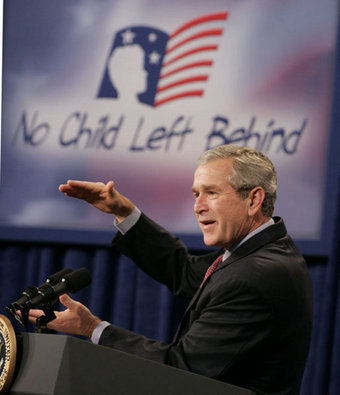
Issue Voting: Education
Some voters cast their ballots according to specific policy issues, for example, education reform.
A voter does not need to have an in-depth understanding of every issue or know how a candidate stands on every issue, rather a voter should have a sense of which candidate he or she agrees with the most. Voters use many different tactics to rationalize their view on a particular issue. Some people look at what has happened in the past and predict how they think a particular issue will affect them in the future.
Issue voting is often contrasted with party voting. A 2010 University of California, Davis study found that voters switch between issue voting and party voting depending on how much information is available to them about a given candidate. Low-information elections, such as those for congressional candidates, would thus be determined by party voting, whereas presidential elections, which tend to give voters much more information about each candidate, have the potential to be issue-driven.
A voter’s understanding of parties’ principles is strengthened and developed over time as a person gains experience with more political events. In order for an issue to create the foundation for party choice, a voter must first be concerned about a particular issue and have some knowledge about that issue.
In order for a person to be an issue voter, they must be able to recognize that there is more than one opinion about a particular issue, have formed a solid opinion about it, and be able to connect their opinion to a specific political party. According to some studies, only 40 to 60 percent of the informed population even perceives party differences, and can thus partake in party voting. This would suggest that it is quite common for individuals to develop opinions of issues without the aid of a political party.
Complications with Issue Voting
Many factors can complicate issue voting. Firstly, issues are not always dichotomous; there are often many stances one could take. Voters must often settle for the candidate whose stances are closest to their own. This can prove difficult when two or more candidates have similar opinions, or when candidates have positions that are equally far from a voter’s beliefs. For example, education spending is a topic that is difficult to issue vote on. A voter may have a drastically different opinion from the available candidates on how much money should be spent on schools. This differing of opinion could lead the individual to vote based on party affiliation instead. More importantly, the nation does not have to have a high level of consensus for some campaign issues to be more salient than others.
A second complexity is that, oftentimes, problems do not line up on linear bases. That is, some issues may make it hard to even determine the candidate with the closest position. For example, in the 1980 United States presidential election, the growing threat of Communism in the Eastern Hemisphere was a salient issue for voters. There were many proposed solutions to this problem. For instance, Ronald Reagan endorsed military intimidation through increased spending and innovation (the Reagan doctrine), Jimmy Carter proposed diplomatic efforts to keep peace, and the independent John Anderson advocated a return to the containment strategy. None of these answers are mutually-exclusive, and they cannot be linearly plotted. The voter instead had to choose the candidate whose opinion represented the closest mix of possible solutions to his or her own.
A third problem complication of issue voting is if there are multiple issues that are equally salient to the voter. A candidate may have a similar position to a given voter on one issue, but may take a considerably different stance on another. During 2008 United States presidential election, the two issues the dominated attention were the economy and the wars in Afghanistan and Iraq . Many viewed these issues as equally salient, and had a hard time picking one issue to vote on.
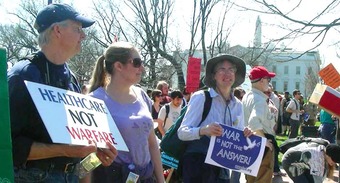
Issue Voting: War in Afghanistan
Some voters vote for a candidate based on that candidate’s stance on a particular issue, such as the war in Afghanistan or healthcare.
9.3: Voter Turnout
9.3.1: Voter Turnout
The significance of voter turnout, the percentage of eligible voters who cast a ballot in an election, has been debated by scholars.
Learning Objective
Describe competing understandings of voter-turnout measurements
Key Points
- After increasing for many decades, there has been a trend of decreasing voter turnout in most established democracies since the 1960s.
- In any large election, the chance of any one vote determining the outcome is low, especially some say, in the United States’ Electoral College.
- The Electoral College is an example of an indirect election, consisting of 538 electors who officially elect the President and Vice President of the United States.
- High voter turnout is often considered to be desirable, though among political scientists and economists specializing in public choice, the issue is still debated.
- Assuming that low turnout is a reflection of disenchantment, a poll with very low turnout may not be an accurate reflection of the will of the people. Conversely, if low turnout is a reflection of contentment of voters about likely winners, then low turnout is as legitimate as high turnout.
Key Terms
- electoral college
-
A body of electors empowered to elect someone to a particular office
- voter turnout
-
Voter turnout is the percentage of eligible voters who cast a ballot in an election. Exactly who is eligible varies by country, and should not be confused with the total adult population.
Example
- A high turnout is generally seen as evidence of the legitimacy of the current system. Dictators have often fabricated high turnouts in showcase elections for this purpose. For instance, Saddam Hussein’s 2002 referendum was claimed to have had 100% participation.
Voter Turnout
Voter turnout is the percentage of eligible voters who cast a ballot in an election. After increasing for many decades, there has been a trend of decreasing voter turnout in most established democracies since the 1960s. Certain factors are leading to the decrease in the number of voters such as disenchantment, indifference, or contentment. Another contributor to lower overall turnout, is the larger percentage of the population who are simply not eligible to vote; non-citizens, incarcerated and non-self-registered individuals. Despite significant study of the issue, scholars are divided on reasons for the decline. Its cause has been attributed to a wide array of economic, demographic, cultural, technological, and institutional factors. There have been many efforts to increase turnout and encourage voting.
Reasons for Voting
In any large election the chance of any one vote determining the outcome is low. Some studies show that a single vote in a voting scheme such as the Electoral College in the United States has an even lower chance of determining the outcome. The Electoral College is an example of an indirect election, consisting of 538 electors who officially elect the President and Vice President of the United States. The number of electors is equal to the total voting membership of the United States Congress, 435 Representatives and 100 Senators, plus three electors from the District of Columbia. Other studies claim that the Electoral College actually increases voting power.

Electoral College
The Electoral College map shows the results of the 2008 U.S. presidential election. Senator Barack Obama (D-IL) won the popular vote in 28 states and the District of Columbia (denoted in blue) to capture 365 electoral votes. Senator John McCain (R-AZ) won the popular vote in 22 states (denoted in red) to capture 173 electoral votes. Nebraska split its electoral vote when Senator Obama won the electoral vote from Nebraska’s 2nd congressional district; the state’s other four electoral votes went to Senator McCain.
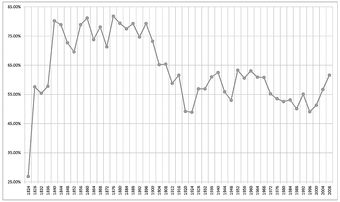
Voter Turnout in the United States
Graph of Voter turnout in the United States presidential elections from 1824 to 2008.
The Significance of Voter Turnout
High voter turnout is desirable, though the issue is still debated among political scientists and economists specializing in public choice. A high turnout is generally seen as evidence of the legitimacy of the current system. Dictators have often fabricated high turnouts in showcase elections for this purpose. For instance, Saddam Hussein’s 2002 referendum was claimed to have had 100% participation. Opposition parties sometimes boycott votes they feel are unfair or illegitimate, or if the election is for a government that is considered illegitimate. For example, the Holy See instructed Italian Catholics to boycott national elections for several decades after the creation of the State of Italy. In some countries, there are threats of violence against those who vote, such as during the 2005 Iraq elections. However, some political scientists question the view that high turnout is an implicit endorsement of the system. Mark N. Franklin contends that in European Union elections opponents of the federation, and of its legitimacy, are just as likely to vote as proponents.
Assuming that low turnout is a reflection of disenchantment or indifference, a poll with very low turnout may not be an accurate reflection of the will of the people. On the other hand, if low turnout is a reflection of contentment of voters about likely winners or parties, then low turnout is as legitimate as high turnout, as long as the right to vote exists. Still, low turnouts can lead to unequal representation among various parts of the population.
The decline in voting has also accompanied a general decline in civic participation, such as church attendance, membership in professional, fraternal, and student societies, youth groups, and parent-teacher associations. At the same time, some forms of participation have increased. People have become far more likely to participate in boycotts, demonstrations, and to donate to political campaigns.
Federal law restricts how much individuals and organizations may contribute to political campaigns, political parties, and other FEC-regulated organizations. Corporations and unions are barred from donating money directly to candidates or national party committees. Lobbyists often assist congresspersons with campaign finance by arranging fundraisers, assembling PACs, and seeking donations from other clients. Many lobbyists become campaign treasurers and fundraisers for congresspersons.
9.3.2: Factors Affecting Voter Turnout
Many causes have been proposed for the decline in voting, including demographics, voter fatigue and voter suppression, among other things.
Learning Objective
Describe several possible reasons for declines in voter participation rates
Key Points
- Wealth and literacy have some effect on turnout, but are not reliable measures.
- Demographics also have an effect. Older people tend to vote more than youths, so societies where the average age is somewhat higher, such as Europe; have higher turnouts than somewhat younger countries such as the United States.
- Making voting compulsory has a direct and dramatic effect on turnout. Simply making it easier for candidates to stand through easier nomination rules is believed to increase voting.
- In politics, voter fatigue is the apathy that the electorate can experience under certain circumstances, one of which could be (in exceptional circumstances) that they are required to vote too often.
- Voter suppression is a strategy to influence the outcome of an election by discouraging or preventing people from exercising their right to vote.
Key Terms
- voter fatigue
-
voter fatigue is the apathy that the electorate can experience under certain circumstances, one of which could be that they are required to vote too often.
- voter suppression
-
Voter suppression is a strategy to influence the outcome of an election by discouraging or preventing people from exercising their right to vote.
Example
- Voter suppression instead attempts to reduce the number of voters who might vote against the candidate or proposition advocated by the suppressors. For example, in the southern United States before and during the civil rights movement, white southerners used many methods to prevent minorities from voting. These included literacy tests, a poll tax, and if all else failed, intimidation by threats of violence.
Introduction
High voter turnout is often considered to be desirable, though among political scientists and economists specialising in public choice, the issue is still debated. A high turnout is generally seen as evidence of the legitimacy of the current system. Assuming that low turnout is a reflection of disenchantment or indifference, a poll with very low turnout may not be an accurate reflection of the will of the people. On the other hand, if low turnout is a reflection of contentment of voters about likely winners or parties, then low turnout is as legitimate as high turnout, as long as the right to vote exists. Still, low turnouts can lead to unequal representation among various parts of the population. In developed countries, non-voters tend to be concentrated in particular demographic and socioeconomic groups, especially the young and the poor.
Reasons for Decline
Many causes have been proposed for this decline; a combination of factors is most likely. When asked why they do not vote, many people report that they have too little free time. However, over the last several decades, studies have consistently shown that the amount of leisure time has not decreased. Wealth and literacy have some effect on turnout, but are not reliable measures. For example, the United Nations Human Development Index shows some correlation between higher standards of living and higher turnout. The age of a democracy is also an important factor. Elections require considerable involvement by the population, and it takes some time to develop the cultural habit of voting, and the associated understanding of and confidence in the electoral process. Demographics also have an effect. Older people tend to vote more than youths, so societies where the average age is somewhat higher, such as Europe; have higher turnouts than somewhat younger countries such as the United States.
Institutional factors have a significant impact on voter turnout. Rules and laws are also generally easier to change than attitudes, so much of the work done on how to improve voter turnout looks at these factors. Making voting compulsory has a direct and dramatic effect on turnout. Simply making it easier for candidates to stand through easier nomination rules is believed to increase voting. Ease of voting is a factor in rates of turnout. In the United States and most Latin American nations, voters must go through separate voter registration procedures before they are allowed to vote. This two-step process quite clearly decreases turnout. U.S. states with no, or easier, registration requirements have larger turnouts.
In politics, voter fatigue is the apathy that the electorate can experience under certain circumstances, one of which could be (in exceptional circumstances) that they are required to vote too often. Voter fatigue and voter apathy should be distinguished from what arises when voters are not allowed or unable to vote, or when disenfranchisement occurs. Similarly, voter suppression is a strategy to influence the outcome of an election by discouraging or preventing people from exercising their right to vote . It is distinguished from political campaigning in that campaigning attempts to change likely voting behavior by changing the opinions of potential voters through persuasion and organization.

Voter Supression
Voters at voting booths in the United States in 1945
Voter suppression instead attempts to reduce the number of voters who might vote against the candidate or proposition advocated by the suppressors. This suppression can be in the form of unfair tests or requirements to vote. For example, in the southern United States before and during the civil rights movement, white southerners used many methods to prevent minorities from voting. These included literacy tests, a poll tax, and if all else failed intimidation by threats of violence. The Civil Rights Act of 1964 put a stop to literacy tests and any other methods of preventing people from voting. Excluding convicted from voting and re-including them only on case-by-case decisions by State Governors, as is the case in numerous U.S. states, can lead to voter suppression and can induce biased voting, as there can be a class bias in the state’s decision.
9.3.3: Low Voter Turnout
Low voter turnout is often considered to be undesirable; there is much debate over the factors that affect turnout and how to increase it.
Learning Objective
Summarize the difficulties involved in measuring voter turnout
Key Points
- There are difficulties in measuring both the numerator, the number of voters who cast votes, and the denominator, the number of voters eligible to vote.
- For the numerator, it is often assumed that the number of voters who went to the polls should equal the number of ballots cast, which in turn should equal the number of votes counted.
- Voting age population (VAP) refers to the set of individuals that have reached the minimum voting age for a particular geography or political unit.
- Over the last 40 years, voter turnout has been steadily declining in the established democracies. This trend has been significant in the United States, Western Europe, Japan and Latin America.
- Before the late 20th century, suffrage — the right to vote — was so limited in most nations that turnout figures have little relevance to today. One exception was the United States, which had near universal white male suffrage by 1840.
Key Terms
- numerator
-
In voter turnout, the numerator refers to the number of voters who cast votes.
- denominator
-
The denominator refers to the number of voters eligible to vote.
- suffrage
-
The right or chance to vote, express an opinion, or participate in a decision.
Example
- Voter turnout varies considerably between countries. It tends to be lower in the United States, Asia and Latin America than most of Europe, Canada and Oceania. Western Europe averages a 77% turnout, and South and Central America around 54% since 1945.
Introduction
Voter turnout is the percentage of eligible voters who cast a ballot in an election. After increasing for many decades, there has been a trend of decreasing voter turnout in most established democracies since the 1960s. In general, low turnout may be due to disenchantment, indifference, or contentment. Low turnout is often considered to be undesirable, and there is much debate over the factors that affect turnout and how to increase it. In spite of significant study into the issue, scholars are divided on reasons for the decline. Its cause has been attributed to a wide array of economic, demographic, cultural, technological, and institutional factors.
Measuring Turnout
Differing methods of measuring voter turnout can contribute to reported differences between nations. There are difficulties in measuring both the numerator, the number of voters who cast votes, and the denominator, the number of voters eligible to vote.
For the numerator, it is often assumed that the number of voters who went to the polls should equal the number of ballots cast, which in turn should equal the number of votes counted, but this is not the case. Not all voters who arrive at the polls necessarily cast ballots. Some may be turned away because they are ineligible, some may be turned away improperly, and some who sign the voting register may not actually cast ballots. Furthermore, voters who do cast ballots may abstain, deliberately voting for nobody, or they may spoil their votes, either accidentally or as an act of protest.
In the United States, it has been common to report turnout as the sum of votes for the top race on the ballot, because not all jurisdictions report the actual number of people who went to the polls nor the number of undervotes or overvotes . Overvote rates of around 0.3 percent are typical of well-run elections, but in Gadsden County Florida, the overvote rate was 11 percent in November 2000.
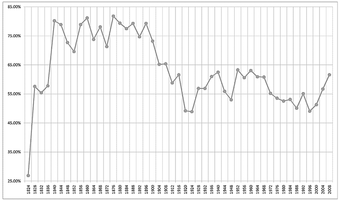
Voter Turnout in the United States
Graph of Voter turnout in the United States presidential elections from 1824 to 2008.
The voting age population (VAP) refers to the set of individuals that have reached the minimum voting age for a particular geography or political unit. The presumption is that they are therefore generally eligible to vote, although other additional factors may cause them to be ineligible, such as lack of citizenship or a prior felony conviction. In estimating voter turnout the voting age population for a political unit is often used as the denominator for the number of individuals eligible to vote in a given election; this method has been shown to lose inaccuracy when a larger percentage of the VAP is ineligible to vote. In the United States individuals become eligible to vote in political elections at age 18.
Trends of Decreasing Turnout
Over the last 40 years, voter turnout has been steadily declining in the established democracies. This trend has been significant in the United States, Western Europe, Japan and Latin America. It has been a matter of concern and controversy among political scientists for several decades. The decline in voting has also accompanied a general decline in civic participation, such as church attendance, membership in professional, fraternal, and student societies, youth groups, and parent-teacher associations. At the same time, some forms of participation have increased. People have become far more likely to participate in boycotts, demonstrations, and to donate to political campaigns.
Before the late 20th century, suffrage — the right to vote — was so limited in most nations that turnout figures have little relevance to today. One exception was the United States, which had near universal white male suffrage by 1840. The U.S. saw a steady rise in voter turnout during the century, reaching its peak in the years after the Civil War. Turnout declined from the 1890s until the 1930s, then increased again until 1960 before beginning its current long decline. Globally, voter turnout has decreased by about five percentage points over the last four decades.
International Differences.
Voter turnout varies considerably between countries. It tends to be lower in the United States, Asia and Latin America than most of Europe, Canada and Oceania. Western Europe averages a 77% turnout, and South and Central America around 54% since 1945 . The differences between nations tend to be greater than those between classes, ethnic groups, or regions within nations. Confusingly, some of the factors that cause internal differences do not seem to apply on a global level. For instance, nations with better-educated populaces do not have higher turnouts. There are two main causes of these international differences—culture and institutions—although there is much debate over the relative impact of the various factors.
9.3.4: Attempts to Improve Voter Turnout
Generally, rules and laws are easier to change than attitudes, and thus the task of improving voter turnout must consider these factors.
Learning Objective
Identify different measures that increase voter turnout
Key Points
- The salience of an election, the effect that a vote will have on policy, and its proportionality, how closely the result reflects the will of the people, are two structural factors that also are likely to have important effects on turnout.
- Compulsory voting is a system in which electors are obliged to vote in elections or attend a polling place on voting day.
- Mark N. Franklin argues that salience, the perceived effect that an individual vote will have on how the country is run, has a significant effect on turnout.
- Ease of voting is a factor in rates of turnout. In the United States and most Latin American nations, voters must go through separate voter registration procedures before they are allowed to vote. This two-step process quite clearly decreases turnout.
- Other methods of improving turnout include making voting easier through more available absentee polling, such as increasing the number of possible voting locations, lowering the average time voters have to spend waiting in lines, or requiring companies to give workers some time off on voting day.
- Some countries have considered Internet voting as a possible solution. In other countries, such as France, voting is held on the weekend, when most voters are away from work. Therefore, the need for time off from work as a factor in voter turnout is greatly reduced.
Key Terms
- salience
-
Salience is the perceived effect that an individual vote will have on how the country is run and has a significant effect on turnout.
- compulsory voting
-
Compulsory voting is a system in which electors are obliged to vote in elections or attend a polling place on voting day. If an eligible voter does not attend a polling place, he or she may be subject to punitive measures, such as fines, community service, or perhaps imprisonment if fines are unpaid or community service not performed.
Example
- Voting may be seen as a civic right rather than a civic duty. While citizens may exercise their civil rights, they are not compelled to. Furthermore, compulsory voting may infringe on other rights. For example, most Jehovah’s Witnesses believe that they should not participate in political events. Forcing them to vote ostensibly denies them their freedom of religious practice. In some countries with compulsory voting, Jehovah’s Witnesses and others may be excused on these grounds. If however they are forced to go to the polling place, they can still use a blank or invalid vote.
Introduction
Institutional factors have a significant impact on voter turnout. Rules and laws are also generally easier to change than attitudes, so much of the work done on how to improve voter turnout looks at these factors. Making voting compulsory has a direct and dramatic effect on turnout. Simply making easier nomination rules for candidates is believed to increase voting. Conversely, adding barriers, such as a separate registration process, can suppress turnout. The salience of an election, the effect that a vote will have on policy, and its proportionality, how closely the result reflects the will of the people, are two structural factors that also are likely to have important effects on turnout.
Compulsory Voting
Compulsory voting is a system by which electors are obliged to vote in elections or attend a polling place on voting day. If an eligible voter does not attend a polling place, he or she may be subject to punitive measures, such as fines, community service, or perhaps imprisonment if fines are unpaid or community service is not performed . Compulsory voting ensures a large voter turnout. This means a victorious candidate or party clearly represents a majority of the population, not just the politically motivated individuals who would vote without this requirement. This helps ensure that governments do not neglect people in sections of society who are less active politically. Victorious political leaders of compulsory systems may claim a higher degree of political legitimacy than those of non-compulsory systems with lower voter turnout. Political scientist Arend Lijphart writes that compulsory voting has been found to increase voting by 7-16% in national elections and by even more in local and provincial elections and elections to the European Parliament.

Map of Compulsory Voting Countries
Red: Compulsory voting, enforced. Pink: Compulsory voting, not enforced. Orange: Compulsory voting, enforced (only men). Light Orange: Compulsory voting, not enforced (only men). Yellow: the country had compulsory voting in the past.
Any compulsion affects the freedom of an individual, and the fining of recalcitrant non-voters is an additional impact on a potential recalcitrant voter. Voting may be seen as a civic right rather than a civic duty. While citizens may exercise their civil rights, they are not compelled to. Furthermore, compulsory voting may infringe on other rights. For example, most Jehovah’s Witnesses believe that they should not participate in political events. Forcing them to vote ostensibly denies them their freedom of religious practice. In some countries with compulsory voting, Jehovah’s Witnesses and others may be excused on these grounds. If however they are forced to go to the polling place, they still can use a blank or invalid vote.
Salience
Mark N. Franklin argues thatsalience, the perceived effect that an individual vote will have on how the country is run, has a significant effect on turnout. He presents Switzerland as an example of a nation with low salience. The nation’s administration is highly decentralized, so that the federal government has limited powers. The government invariably consists of a coalition of parties, and the power wielded by a party is far more closely linked to its position relative to the coalition than to the number of votes it received. Important decisions are placed before the population in a referendum. Individual votes for the federal legislature are thus unlikely to have a significant effect on the nation, which probably explains the low average turnouts in that country.
Ease of Voting
Ease of voting is a factor in rates of turnout. In the United States and most Latin American nations, voters must go through separate voter registration procedures before they are allowed to vote. This two-step process quite clearly decreases turnout. U.S. states with no or easier registration requirements have larger turnouts. Other methods of improving turnout include making voting easier through improved access to polls—for example, through:
- increasing the number of possible voting locations
- lowering the average time voters have to spend waiting in lines
- extending voting hours
- requiring companies to give workers some time off on voting day
Other options include:
- more available absentee polling
- mail-in voting
- Internet voting
In other countries, like France, voting is held on the weekend, when most voters are away from work. Therefore, the need for time off from work as a factor in voter turnout is greatly reduced.
9.3.5: The Effect of Low Voter Turnout
Assuming that low turnout is a reflection of disenchantment, a poll with very low turnout may be an inaccurate reflection of the electorate.
Learning Objective
Analyze two different ways of understanding levels of voter turnout
Key Points
- If low turnout is a reflection of contentment of voters about likely winners or parties, then low turnout is as legitimate as high turnout, as long as the right to vote exists.
- Voter turnout varies considerably between countries. It tends to be lower in the United States, Asia, and Latin America than most of Europe, Canada, and Oceania.
- For instance, nations with better-educated populaces do not have higher turnouts. There are two main causes of these international differences—culture and institutions—although there is much debate over the relative impact of the various factors.
Key Term
- voter turnout
-
Voter turnout is the percentage of eligible voters who cast a ballot in an election. Exactly who is eligible varies by country, and should not be confused with the total adult population.
Example
- Western Europe averages a 77% turnout, and South and Central America averages around 54% since 1945.
Implications of High and Low Voter Turnout
High voter turnout is often considered to be desirable, though among political scientists and economists specialising in public choice, the issue is still debated. A high turnout is generally seen as evidence of the legitimacy of the current system. Dictators have often fabricated high turnouts in showcase elections for this purpose. Assuming that low turnout is a reflection of disenchantment or indifference, a poll with very low turnout may not be an accurate reflection of the will of the people . On the other hand, if low turnout is a reflection of contentment of voters about likely winners or parties, then low turnout is as legitimate as high turnout, as long as the right to vote exists. Still, low turnouts can lead to unequal representation among various parts of the population. In developed countries, non-voters tend to be concentrated in particular demographic and socioeconomic groups, especially the young and the poor.
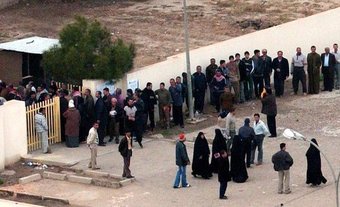
Voter Turnout
Voters lining up outside a Baghdad polling station during the 2005 Iraqi election. Voter turnout was considered high despite widespread concerns of violence.
Voter Turnout across the World
Voter turnout varies considerably between countries. It tends to be lower in the United States, Asia, and Latin America than most of Europe, Canada, and Oceania. Western Europe averages a 77% turnout, and South and Central America averages around 54% since 1945. The differences between nations tend to be greater than those between classes, ethnic groups, or regions within nations. Confusingly, some of the factors that cause internal differences do not seem to apply on a global level. For instance, nations with better-educated populaces do not have higher turnouts. There are two main causes of these international differences—culture and institutions—although there is much debate over the relative impact of the various factors.
9.4: Trends in Voting
9.4.1: African Americans
For a large part of the history of the US, black voters were blocked from voting either directly or indirectly.
Learning Objective
Explain the institutional barriers that prevented African Americans from participating in American politics
Key Points
- For a large part of the history of the US, Black voters were blocked from voting, either directly or through political practices that targeted Black voters indirectly.
- At the end of the Civil War, amendments to the US Constitution banned slavery in the US as well as affirmed the citizenship of Black residents. Finally, the fifteenth amendment, ratified in 1870, banned any state from denying the right to vote to any adult male citizen based on his race.
- While the fifteenth amendment provided legal protection for voting rights based on race, there were other means that could be used to block Black citizens from voting. During the Jim Crow era, politicians created new institutions to suppress the vote of Black residents.
- In the 1950s and 1960s, the civil rights movement came into its own as a widespread social movement. Groups fought for improved opportunities for African American people, and tried to defend existing rights that were being denied, such as voting rights.
- After the Civil Rights movement average voter turnout for African Americans remained below national averages. A disproportionate amount of African Americans remain in low-income communities where rates of voting are lower.
Key Terms
- Fifteenth Amendment
-
an addition to the U.S. Constitution, adopted in 1870, which prohibits the federal and state governments from denying a citizen the right to vote based on that citizen’s “race, color, or previous condition of servitude”
- disenfranchise
-
to deprive someone of a franchise, generally their right to vote
- Jim Crow
-
Southern United States racist and segregationist policies in the late 1800’s and early to mid 1900’s, taken collectively.
African Americans
For a large part of US history Black voters were blocked from voting, either directly or through political practices that targeted Black voters indirectly.
Today, the average participation of African American voters is still somewhat lower than white voters, but there is great variety within these voting patterns.
There are different explanations for voting patterns. Institutional approaches look at the ways in which legal documents and organizations impact the ability to vote. Others examine the question of rationality in voting: does voting serve the self-interest of any given individual, and what are the interests or issues that might change someones voting patterns? A behavioral approach focuses on the actions of individuals and groups, taking voting as one part of a larger bundle of political activities. In examining African American voting patterns it is helpful to consider all of these factors.
Civil War and Institutional Barriers
During the period before the Civil War, enslaved Black people, and many free Blacks and free people of color were barred from voting. At the end of the war, the fifteenth amendment, ratified in 1870, banned any state from denying the right to vote to any adult male citizen based on his race.
During the early Reconstruction period, Black residents voted in large numbers . In many states the enslaved population had been larger than the free population. Coupled with a strong set of shared interests, there was a great deal of incentive for Black citizens to vote.
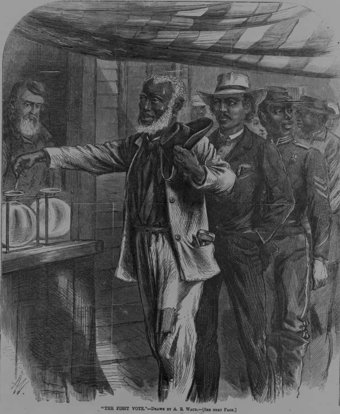
The First Vote
This contemporary print depicts the first Black voters in the US exercising their new rights.
Jim Crow Era and Disenfranchisement
While the fifteenth amendment provided legal protection for voting rights based on race, during the Jim Crow era, politicians created new institutions to suppress the vote of Black residents.
Early on, violence and intimidation was used to keep Black voters away from the polls. States then began to pass official voter suppression legislation. These included poll taxes requiring payment before voting, and literacy and understanding tests, strict residency requirements and new voter registration rules.
While these rules did not specifically restrict Black citizens from voting, Black people who were freed slaves and their descendants were disproportionately poor, less educated or illiterate, and so more likely to have their voting rights limited by these provisions. Although it is important to note that poor white residents were also disenfranchised by many of these provisions. In some cases, states added character or grandfather clauses to permit poor or illiterate white residents to continue voting.
Civil Rights
During the early parts of the 1900s, the NAACP brought forward several successful cases to challenge state voter suppression laws. In the 1950s and 1960s, the civil rights movement became a widespread social movement. Groups fought for improved opportunities for African American people, and tried to defend existing rights that were being denied. Civil rights leaders organized communities through churches and other community groups, and attracted the support of many white activists from northern states.
The African-American Civil Rights Movement encompasses social movements in the United States whose goal was to end racial segregation and discrimination against black Americans and enforce constitutional voting rights to them. This article covers the phase of the movement between 1955 and 1968, particularly in the South.
The movement was characterized by major campaigns of civil resistance. Between 1955 and 1968, acts of nonviolent protest and civil disobedience produced crisis situations between activists and government authorities. Federal, state, and local governments, businesses, and communities often had to respond immediately to these situations that highlighted the inequities faced by African Americans.
In 1962, the twenty-fourth amendment to the Constitution prohibited congress or states from restricting voting through poll taxes. In 1964, the Civil Rights Act was passed. In 1965, the Voting Rights Act established federal oversight of election regulations, and banned voter qualifications or prerequisites that limited the right to vote on account of race or color. This act removed a large institutional barrier to voting and helped to further protect voting rights.
2008 and Beyond
The 2008 presidential election was historic, with Barack Obama as the Democratic candidate, and the first non-white presidential candidate for a major party. Obama had a Kenyan-born Black father, a white mother from the Midwest, and strong connections in the African American community in Chicago. Aside from the fact that Obama won an overwhelming percent of the African American vote, there was also high levels of African American voter turnout during this election. This was in part because of self-interest and a desire for representation, but was also the result of strong community organizing. Once again, grassroots groups and social movement leaders worked to register voters and get them to the polls.
9.4.2: Latinos
On average, Latino citizens continue to vote at significantly lower rates than non-Latino white voters.
Learning Objective
Summarize the voting trends among Latino voters in U.S. politics
Key Points
- While Latino voters should not be thought of as a homogenous group, there are still some general trends for the group. On average, Latino citizens continue to vote at significantly lower rates that non-Latino white voters.
- There are low rates of naturalization in the US, along with weak political institutions that might facilitate the incorporation of Latino citizens as voters.
- However, in recent years, a larger number of organizations that serve immigrant and Latino communities have become involved in political participation.
- The Language Minority Provision of the Voting Rights Act, first introduced in 1975, aims to lower the cost of participation for Latino voters by requiring election material be provided in Spanish where appropriate.
Key Term
- naturalization
-
Naturalization is the acquisition of citizenship and nationality by somebody who was not a citizen of that country at the time of birth.
Latinos
Latino communities make up one of the fastest growing groups in the US. Latino voters are a diverse group which include long-established Tejano and Californio, Puerto Rican and Chicano voters, as well as the Cuban-American community which makes up a large bloc of voters in Miami. However, recently naturalized citizens from South and Central America, and their children, make up the largest group of Latino voters in the US.
Latino Voting Trends
While Latino voters should not be thought of as a homogenous group, there are still some general trends for the group. On average Latino citizens continue to vote at significantly lower rates that non-Latino white voters.
There are many potential approaches that can be taken to explain variations in voting rates. Institutional approaches look at the ways in which legal documents and organizations shape the ability to vote. Others examine the question of the rationality of voting: does voting serve the self-interest of any given individual, and what are the interests or issues that might change someone’s voting patterns? A behavioral approach focuses more on the actions of individuals and groups, taking voting as one part of a larger bundle of political activities.
The US has comparatively low rates of naturalization for immigrant residents. As such, people may live for many years in the US without being able to vote. Additionally, the weaker electoral institutions in the US, including more decentralized election processes and a weaker party system, mean that there are few institutions working to actively incorporate newly naturalized citizens or second generation citizens into the voting process.
Additionally, many Latino political activists, who are more visible in their political participation, have often been quite different from the average Latino. For example, these activists are generally less in need of government supports, and less likely to advocate for such programs. They are, therefore, not good candidates for the type of community organizing that could rally new voters around their own interests.
However, in recent years, a larger number of organizations that serve immigrant and Latino communities have become involved in political participation . These groups are advocating for resources, supports and rights. They are also encouraging the political participation of Latino residents through voter registration drives, and partnerships with other organizations, such as unions, that have traditionally been involved in voter mobilization.
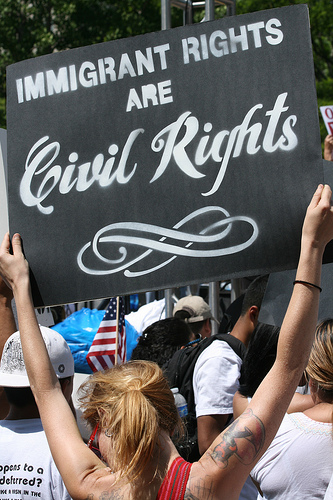
Immigrant Rights and Civil Rights
Organizations serving immigrant communities are starting to encourage more political participation, including voting.
Language Minority Voting Rights
One important institutional change aimed at lowering the cost for Latino voter participation is the Language Minority Provision of the Voting Rights Act, first introduced in 1975, and then amended in 1992 and 2006. This provision is aimed at upholding the principals of the fourteenth and fifteenth amendments to the US constitution, by attempting to eliminate language-based barriers to voting.
This provision has been shown to have a significant impact on improving rates of voting by Latino citizens.
9.4.3: Asian Americans
The diversity and polarization of the Asian American community makes it difficult to generalize their voting patterns.
Learning Objective
Explain the levels of political participation by Asian Americans in the United States
Key Points
- This diversity and polarization makes it difficult to generalize the voting patterns for the Asian American community. In some areas voting rates are significantly higher than the US average, or the rate for non-Latino white voters. In others it is significantly lower.
- Differences are related to indicators such as income and education. Like most other groups in the US, Asian Americans with more education and higher income tend to vote more.
- Other indicators for voting participation among Asian Americans are the political climate for both their home country and their local community.
- The Language Minority Provision of the Voting Rights Act is an important institutional change aimed at increasing the rates of voting in Asian American communities. Introduced in 1975 it requires election material be provided in several languages from Asia, where appropriate.
Key Term
- disenfranchisement
-
Explicit or implicit revocation of, or failure to grant the right to vote, to a person or group of people.
Asian Americans
It might come as a surprise to find that California was one of the last states to ratify the fifteenth amendment to the US constitution, which prohibited any state from limiting a male citizen’s right to vote based on race. However, in the late 1800s many politicians in California were adamant that migrants from China and their descendants should be prohibited from voting. Like African American communities in southern states, Asian American communities have faced a long history of voter discrimination and disenfranchisement in the US .
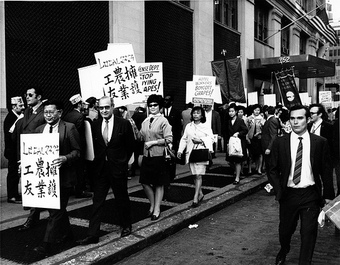
Political Participation
Asian American communities have a long history of both disenfranchisement and political participation in the US.
Today the Asian American community in the US is quite diverse, with longstanding Chinese and Japanese communities particularly on the west coast, along with large Pacific Islander populations both on the west coast and in Hawaii. The Asian American community is also one of the fastest growing groups in the country in large part because of new immigration. The three largest groups are made of people who have emigrated from China, India and the Philippines. These newly naturalized citizens and their children make up the largest group of Asian American voters.
In addition to being a diverse group, the Asian American community is also highly polarized in terms of its socioeconomic profile. Some Asian Americans have very high income, while others have very low income. This diversity and polarization makes it difficult to generalize the voting patterns for the Asian American community. In some areas voting rates are significantly higher than the US average, or the rate for non-Latino white voters. In others it is significantly lower.
Differences are related to indicators such as income and education. Like most other groups in the US, Asian Americans with more education and higher income tend to vote more. Other indicators for voting participation among Asian Americans are the political climate for both their home country and their local community.
Language Minority Voting Rights
One important institutional change aimed at increasing the rates of voting in Asian American communities is the Language Minority Provision of the Voting Rights Act. It was first introduced in 1975, and later amended in 1992 and 2006. This provision is aimed at upholding the principles of the fourteenth and fifteenth amendments to the US constitution by attempting to eliminate language-based barriers to voting. This provision holds that election documents, such as voting notices and ballots, must be provided in the minority language alongside English, where appropriate.
9.4.4: Women vs. Men
In 1920, the Nineteenth Amendment to the Constitution gave women the right to vote and, today, women vote at similar rates to men.
Learning Objective
Explain the historical causes for women’s greater participation in American politics
Key Points
- For a large part of the history of the US, women were denied their right to vote. Women were not able to vote in elections until the Nineteenth Amendment to the US Constitution. Ratified in 1920, this amendment prohibited any citizen from being denied the right to vote based on their sex.
- In spite of this long-term institutional barrier to voting, women today vote at similar rates to men. Women also do not generally vote as a bloc, and instead tend to be as diverse in their voting patterns as men.
- The high rates of women’s involvement in elections, in spite of being excluded from voting for so long, can be partially explained by women’s high rates of involvement in other forms of political participation.
- Women share many of the same interests as men in comparable positions, and so, similarly to men, women with more education and higher income will tend to vote at higher rates than other women.
Key Terms
- suffrage
-
The right or chance to vote, express an opinion, or participate in a decision.
- bloc
-
a group of voters or politicians who share common goals
Women Versus Men
There are a variety of theories that help to explain who votes. Institutional approaches look at the ways in which legal documents and organizations impact and shape the ability to vote. Other approaches examine the question of the rationality of voting: does voting serve the self-interest of any given individual, and what are the interests or issues that might change someone’s voting patterns? A behavioral approach focuses more on the actions of individuals and groups, taking voting as one part of a larger bundle of political activities. It is useful to combine these ideas when thinking about women’s and men’s voting patterns.
For a large part of the history of the United States, women were denied their right to vote. Women were not allowed to vote in all elections until the Nineteenth Amendment to the US Constitution. Ratified in 1920, this amendment prohibited any citizen from being denied the right to vote based on their sex.
In spite of this long-term institutional barrier to voting, women today vote at similar rates to men. Women also do not generally vote as a bloc, and instead tend to be as diverse in their voting patterns as men. Characteristics such as race, ethnicity, age and socioeconomic status tend to predict voting patterns better than gender. Even when considering so-called “women’s issues”, such as reproductive choices and rights or equal pay legislation, women do not vote as a bloc. Instead, while they may identify these issues as more important than men, women tend to be split over the correct solutions to a problem. However, there are exceptions, such as around any questions of war and/or the use of violence.
The high rates of women’s involvement in voting (in spite of being excluded from voting for so long) can be partially explained by women’s high involvement in other forms of political participation. This includes the suffrage movement that saw women organizing and campaigning to win women the right to vote. Additionally, women share many of the same interests as men in comparable positions, and so, similarly to men, women with more education and higher income will vote at higher rates than women in different positions.
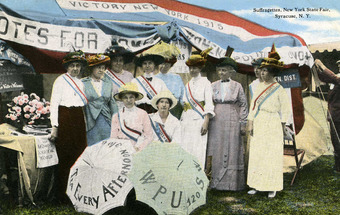
Suffragettes
Women across the US organized for decades to gain the right to vote for women.
While women vote at a similar rate to men, they are underrepresented in other forms of political participation, such as joining organizations like political parties and running for public office.
9.4.5: Religious Identity and Politics
Within the United States, religious identity plays a significant role in political participation and voting.
Learning Objective
Identify the role that religion plays in political participation and voting in the United States
Key Points
- Since the election of a Catholic President in 1960, John F. Kennedy, Catholics have split about 50-50 between the two major parties in national elections.
- For most of the 20th century, the vast majority of Jews in the United States have been aligned with the Democratic Party, though towards the end of the 20th century and into the 21st century, Republicans have launched initiatives to woo American Jews.
- One-fifth of the U.S. public–and a third of adults under 30–are religiously unaffiliated today, according to national polls.
Key Term
- Evangelical
-
Pertaining to a movement in Protestant Christianity that stresses personal conversion and the authority of the Bible (evangelicalism).
Within the United States, religious identity plays a significant role in political participation and voting .
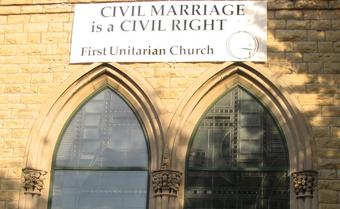
Religious identity
Religious identity plays a significant role in political participation
In 1776, Catholics comprised less than 1% of the population of the new nation, but their presence grew rapidly after 1840 with immigration from Germany, Ireland, Italy, Poland, and elsewhere in Catholic Europe from 1840 to 1914, and also from Latin America in the 20th century. Catholics now comprise 25% to 27% of the national vote, with over 68 million members today. From the mid-19th century until 1964 Catholics were solidly Democratic, with about 80%-90% of them voting democrat. But since the election of a Catholic president in 1960, John F. Kennedy, Catholics have split about 50-50 between the two major parties in national elections.
The Jewish community constitutes about 1.4 – 2.1% of the U.S. population. While earlier Jewish immigrants from Germany tended to be politically conservative, the wave of Eastern European Jews who arrived in the U.S. starting in the 1880s were generally more liberal and soon became the political majority. For most of the 20th century since 1936, the vast majority of Jews in the United States have been aligned with the Democratic Party. Towards the end of the 20th century and into the 21st century, Republicans have launched initiatives to woo American Jews away from the Democratic Party.
Today one-fifth of the U.S. public–and a third of adults under 30–are religiously unaffiliated according to national polls. Exit polls suggest that white Americans without religion vote Democratic at roughly the same rates as they vote Republican. According to exit polls in the 2008 Presidential Election, 71% of non-religious whites voted for Democratic candidate Barack Obama, while 74% of white Evangelical Christians voted for Republican candidate John McCain. This can be compared with the 43–55% share of white votes overall.
A comprehensive study by Harvard University professor Robert Putnam found that religious Americans are three to four times more likely than their nonreligious counterparts to “work on community projects, belong to voluntary associations, attend public meetings, vote in local elections, attend protest demonstrations and political rallies, and donate time and money to causes–including secular ones. “
9.4.6: Age and Participation
Political participation differs notably by age; in general, older citizens are more likely to turn out in elections than younger ones.
Learning Objective
Explain the reasons for people’s level of participation in politics
Key Points
- People between the ages of thirty-five and sixty-five are the most politically active.
- People under the age of thirty are among the least involved in mainstream forms of participation, as younger people often lack the money and time to participate.
- While younger people turn out in elections less often than older people, youth voting has been on the rise in presidential elections since 2004.
Key Terms
- social media
-
Interactive forms of media that allow users to interact with and publish to each other, generally by means of the Internet.
- turnout
-
attendance; crowd
Political participation differs notably by age. People between the ages of thirty-five and sixty-five are the most politically active. People at this stage of life are more likely than younger people to have established homes, hold steady jobs, and be settled into communities. Those with stable community roots often have strong incentives and greater resources for becoming involved in politics.
People under the age of thirty are among the least involved in mainstream forms of participation, as younger people often lack the money and time to participate. Voter turnout among eighteen- to twenty-four-year-olds dropped from 50 percent in 1972, the first presidential election year after the voting age was lowered to eighteen, to 36 percent in 2000. Turnout among senior citizens, people sixty-five and older, increased to nearly 70 percent in that same time period.
While younger people turn out in elections less often than older people, youth voting has been on the rise in presidential elections since 2004. Young voter turnout rose to 47 percent in 2004 and 51 percent in 2008, partly as a result of voter registration and mobilization efforts by groups like Rock the Vote. The youth vote contributed to the success of Democratic presidential candidate Barack Obama in 2008 and 2012, as young volunteers provided countless hours of campaign support. The growth of Internet technologies, particularly social media sites such as Facebook, Twitter, and YouTube, has also made it easier for candidates to reach younger voters who may not read traditional newspapers or watch television news and increase their turnout .
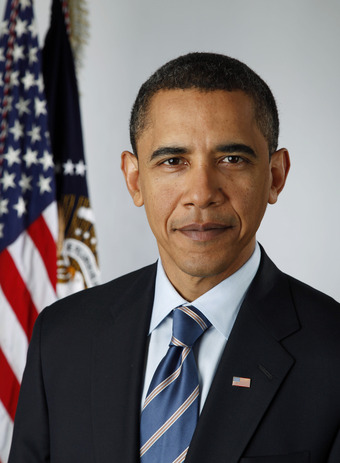
President Barack Obama
Barack Obama’s presidential campaigns were successful partly as a result of youth participation.
Chapter 8: Campaigns and Elections
8.1: Elections
8.1.1: Types of Elections
From the broad and general to the small and local, elections are designed to serve different purposes for various political voting systems.
Learning Objective
Identify the different types of elections in American democracy
Key Points
- In a parliamentary system, a general election is an election in which all or most members of a given political body are chosen.
- A by-election is an election held to fill a political office that has become vacant between regularly scheduled elections.
- A primary election is an election that narrows the field of candidates before the general election. Primary elections are one means by which a political party nominates candidates for the next general election.
- In the case of closed primaries, only party members can vote. By contrast, in an open primary all voters may cast votes on a ballot of any party.
- A referendum is a direct vote in which an entire electorate is asked to either accept or reject a particular proposal, usually a piece of legislation which has been passed into law by the local legislative body and signed by the pertinent executive official(s).
- A recall election is a procedure by which voters can remove an elected official from office through a direct vote before his or her term has ended.
Key Terms
- general election
-
An election, usually held at regular intervals, in which candidates are elected in all or most constituencies or electoral districts of a nation.
- referendum
-
A direct popular vote on a proposed law or constitutional amendment.
- primary election
-
A preliminary election to select a political candidate of a political party.
Example
- Political careers are often made at the local level: Boris Yeltsin, for instance, as the top official in Moscow, was able to prove his effectiveness and eventually become President of Russia after the collapse of the USSR. When he fought his first contested local election, he demonstrated a willingness to put his policies to the ballot.
Types of Elections
In a parliamentary system, a general election is an election in which all or most members of a given political body are chosen . The term is usually used to refer to elections held for a nation’s primary legislative body, as distinguished from by-elections and local elections. In this system, members of parliament are also elected to the executive branch. The party in government usually designates the leaders of the executive branch.
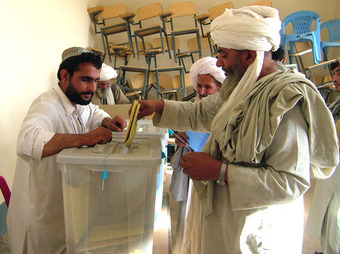
Afghan Elections, 2005
An Afghan man casts his ballot at a polling station in Lash Kar Gah, Helmand Province, September 18, 2005. Polling stations were busy, but orderly, across the city.
A by-election is an election held to fill a political office that has become vacant between regularly scheduled elections. Usually, a by-election occurs when the incumbent has resigned or died. Local elections vary widely across jurisdictions. In an electoral system that roughly follows the Westminster model, a terminology has evolved with roles such as mayor or warden to describe the executive of a city, town, or region, although the actual means of elections may vary. Political careers are often made at the local level: Boris Yeltsin, for instance, as the top official in Moscow, was able to prove his effectiveness and eventually become President of Russia after the collapse of the USSR. When he fought his first contested local election, he demonstrated a willingness to put his policies to the ballot.
Primary Elections
A primary election is an election that narrows the field of candidates before the general election. Primary elections are one means by which a political party nominates candidates for the next general election. Primaries are common in the United States, where their origins are traced to the progressive movement to take the power of candidate nomination away from party leaders and give it to the people. In the case of closed primaries, only party members can vote. By contrast, in an open primary all voters may cast votes on a ballot of any party. The party may require them to express their support to the party’s values and pay a small contribution to the costs of the primary.
Referendum and Recall
A referendum is a direct vote in which an entire electorate is asked to either accept or reject a particular proposal, usually a piece of legislation which has been passed into law by the local legislative body and signed by the pertinent executive official(s) . A referendum may result in the adoption of a new constitution, a constitutional amendment, a law, the recall of an elected official, or simply a specific government policy. Similarly, a recall election is a procedure by which voters can remove an elected official from office through a direct vote before his or her term has ended. Recalls, which are initiated when sufficient voters sign a petition, have a history dating back to the ancient Athenian democracy and are a feature of several contemporary constitutions.
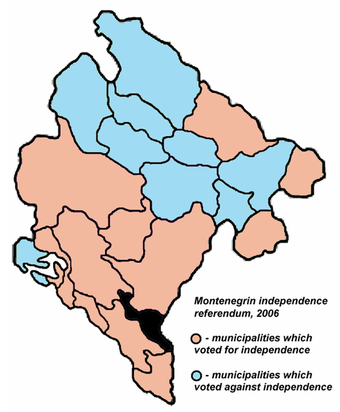
Montenegro Referendum
In 2006, a referendum in the Republic of Montenegro took place.
8.1.2: The Purpose of Elections
Elections have been the usual mechanism by which modern representative democracy has operated since the 17th century.
Learning Objective
Discuss the nature of elections in democratic forms of government
Key Points
- An election is a formal decision-making process by which a population chooses an individual to hold public office.
- The universal use of elections as a tool for selecting representatives in modern democracies is in contrast with the practice in the democratic archetype, ancient Athens.
- Where universal suffrage exists, the right to vote is not restricted by gender, race, social status, or wealth.
- Citizens become eligible to vote after reaching the voting age, which is typically eighteen years old as of 2012 in the United States. Most democracies no longer extend different rights to vote on the basis of sex or race.
- Compulsory voting is a system in which electors are obliged to vote in elections or attend a polling place on voting day.
Key Terms
- suffrage
-
The right or chance to vote, express an opinion, or participate in a decision.
- election
-
A process of choosing a leader, members of parliament, councillors or other representatives by popular vote.
- compulsory voting
-
Compulsory voting is a system in which electors are obliged to vote in elections or attend a polling place on voting day. If an eligible voter does not attend a polling place, he or she may be subject to punitive measures, such as fines, community service, or perhaps imprisonment if fines are unpaid or community service not performed.
Example
- Suffrage is typically only for citizens of the country, though further limits may be imposed. However, in the European Union, one can vote in municipal elections if one lives in the municipality and is an EU citizen; the nationality of the country of residence is not required.
Purposes of Elections
Definition
An election is a formal decision-making process by which a population chooses an individual to hold public office. Elections have been the usual mechanism by which modern representative democracy has operated since the 17th century. Elections fill offices in the legislature, sometimes in the executive and judiciary, and for regional and local government. This process is also used in many other private and business organizations, from clubs to voluntary associations and corporations.

Presidential Elections in Poland
Presidential Election 2005 in Poland (second round of voting, Oct.23rd).
History of Elections
The universal use of elections as a tool for selecting representatives in modern democracies is in contrast with the practice in the democratic archetype, ancient Athens. As the elections were considered an oligarchic institution and most political offices were filled using sortition, also known as allotment, by which officeholders were chosen by lot.
Elections were used as early in history as ancient Greece and ancient Rome, and throughout the Medieval period to select rulers such as the Holy Roman Emperor and the Pope. In ancient India, around 920 AD, in Tamil Nadu, Palm leaves were used for village assembly elections. The palm leaves with candidate names, will be put inside a mud pot, for counting. Ancient Arabs also used election to choose their caliphs, Uthman and Ali, in the early medieval Rashidun Caliphate; and to select the Pala king Gopala in early medieval Bengal.
Suffrage
The question of who may vote is a central issue in elections. The electorate does not generally include the entire population; for example, many countries prohibit those judged mentally incompetent from voting, and all jurisdictions require a minimum voting age. Suffrage is the right to vote gained through the democratic process. Citizens become eligible to vote after reaching the voting age, which is typically eighteen years old as of 2012 in the United States. Most democracies no longer extend different rights to vote on the basis of sex or race.
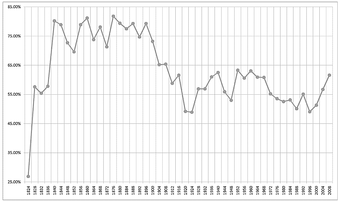
Graph of Voter Turnout in U.S. Presidential Elections, 1824-Present
Between 1824 and 1840, voter turnout when from about 26% to 80%. This extremely sharp rise was caused by the removal of property qualifications from the right to vote.
Where universal suffrage exists, the right to vote is not restricted by gender, race, social status, or wealth. It typically does not extend a right to vote to all residents of a region. Distinctions are frequently made in regard to citizenship, age, and occasionally mental capacity or criminal convictions. Suffrage is typically only for citizens of the country, though further limits may be imposed. However, in the European Union, one can vote in municipal elections if one lives in the municipality and is an EU citizen; the nationality of the country of residence is not required. In some countries, voting is required by law. If an eligible voter does not cast a vote, he or she may be subject to punitive measures such as a small fine. Compulsory voting is a system in which electors are obliged to vote in elections or attend a polling place on voting day. If an eligible voter does not attend a polling place, he or she may be subject to punitive measures such as fines, community service, or perhaps imprisonment if fines are unpaid or community service not performed.
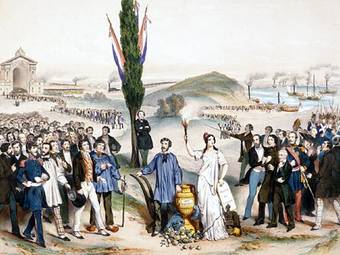
Universal Suffrage
Suffrage universel dédié à Ledru-Rollin, painted by Frédéric Sorrieu in 1850. This lithography pays tribute to French statesman Alexandre Auguste Ledru-Rollin for establishing universal male suffrage in France in 1848, following the French Revolution of 1848.
8.1.3: Types of Ballots
A ballot is a device used to cast votes in an election; types of ballots include secret ballots and ranked ballots.
Learning Objective
Compare and contrast the different types of ballots used for elections
Key Points
- A ballot box is a temporarily sealed container with a narrow slot in the top sufficient to accept a ballot paper in an election. The ballot box is also designed to prevent anyone from accessing the votes cast until the close of the voting period.
- Ranked ballots allow voters to rank candidates in order of preference, while ballots for first-past-the-post systems only allow voters to select one candidate for each position. In party-list systems, lists may be open or closed.
- The secret ballot is a voting method in which a voter’s choices in an election or a referendum are anonymous.
- In the United States today, the term ballot reform generally refers to efforts to reduce the number of elected offices.
Key Terms
- secret ballot
-
The voting system involving ballots available only at official polling places, prepared at public expense, containing the names of all candidates, and marked in secret at the polling places.
- ballot
-
A paper or card used to cast a vote.
- ballot box
-
A sealed box with a slit, into which a voter puts his completed voting slip.
Example
- Ballot design can aid or inhibit clarity in an election. Poor designs lead to confusion and potentially chaos if large numbers of voters spoil or mismark a ballot. The butterfly ballot used in Florida in the 2000 U.S. Presidential Election is a good example. This was a ballot paper that has names down both sides, with a single column of punch holes in the center, which has been likened to a maze. The use of a butterfly ballot led to widespread allegations of mismarked ballots.
Introduction
A ballot is a device used to cast votes in an election, and may be a piece of paper or a small ball used in secret voting. Each voter uses one ballot, and ballots are not shared. In the simplest elections, a ballot may be a simple scrap of paper on which each voter writes in the name of a candidate, but governmental elections use pre-printed ballots to protect the secrecy of the votes. The voter casts his or her ballot in a box at a polling station. A ballot box is a temporarily sealed container, usually square box though sometimes a tamper resistant bag, with a narrow slot in the top sufficient to accept a ballot paper in an election. The ballot box is also designed to prevent anyone from accessing the votes cast until the close of the voting period .
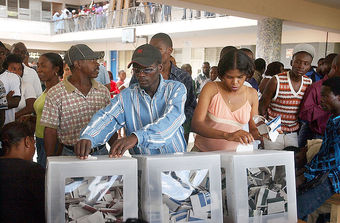
Haitians voting in the 2006 elections.
Clear sided ballot boxes used in the Haitian general election in 2006.
Types of Voting Systems
Depending on the type of voting system used in the election, different ballots may be used. Ranked ballots allow voters to rank candidates in order of preference, while ballots for first-past-the-post systems only allow voters to select one candidate for each position. In party-list systems, lists may be open or closed.
The secret ballot is a voting method in which a voter’s choices in an election or a referendum are anonymous. The key aim is to ensure that the voter records a sincere choice by forestalling attempts to influence the voter by intimidation or bribery. This system is one means of achieving the goal of political privacy. However, the secret ballot may increase the amount of vote buying where it is still legal. A political party or its affiliates could pay lukewarm supporters to turn out and pay lukewarm opponents to stay home, therefore reducing the costs of buying an election.
The United States uses a long and short ballot . Before the Civil War, a larger number of elected offices required longer ballots, and at times the long ballot undoubtedly resulted in confusion and blind voting, though the seriousness of either problem can be disputed. Progressivists attacked the long ballot during the Progressive Era. In the United States today, the term ballot reform generally refers to efforts to reduce the number of elected offices .
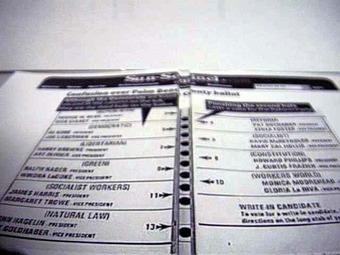
Butterfly Voters View
Perspective view of the infamous Florida butterfly ballot, reconstructed in 3-D from a reproduction in a Florida newspaper, to show how hard it is to identify which hole links to which name in “real life”, rather than the flat way it is usually displayed.
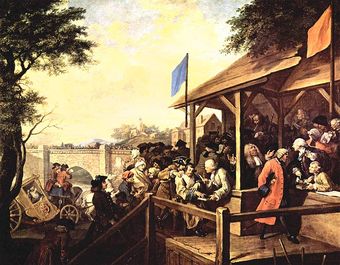
The Polling (Painting)
The Polling by William Hogarth (1755). Before the secret ballot was introduced, voter intimidation was commonplace.
8.1.4: Winning an Election: Majority, Plurality, and Proportional Representation
Common voting systems are majority rule, proportional representation, or plurality voting with a number of criteria for the winner.
Learning Objective
Compare and contrast the voting systems of majority rule, proportional representation and plurality voting
Key Points
- A voting system is a method by which voters make a choice between options, often in an election or on a policy referendum.
- Majority rule is a decision rule that selections the option which has a majority, that is, more than half the votes. It is the binary decision rule used most often in influential decision-making bodies, including the legislatures of democratic nations.
- Proportional representation (PR) is a concept in voting systems used to elect an assembly or council. Proportional representation means that the number of seats won by a party or group of candidates is proportionate to the number of votes received.
- The plurality voting system is a single-winner voting system often used to elect executive officers or to elect members of a legislative assembly that is based on single-member constituencies.
Key Terms
- majority rule
-
A decision rule whereby the decisions of the numerical majority of a group will bind on the whole group.
- plurality
-
A number of votes for a single candidate or position which is greater than the number of votes gained by any other single candidate or position voted for, but which is less than a majority of valid votes cast.
- voting systems
-
A voting system is a method by which voters make a choice between options, often in an election or on a policy referendum.
Example
- The most common system, used in Canada, the lower house (Lok Sabha) in India, the United Kingdom, and most elections in the United States, is simple plurality, first-past-the-post or winner-takes-all.
Introduction
A voting system is a method by which voters make a choice between options, often in an election or on a policy referendum. A voting system contains rules for valid voting, and how votes are counted and aggregated to yield a final result. Common voting systems are majority rule, proportional representation, or plurality voting with a number of variations and methods such as first-past-the-post or preferential voting. The study of formally defined voting systems is called social choice theory, a subfield of political science, economics, and mathematics.
Majority Rule
Majority rule is a decision rule that selects the option which has a majority, that is, more than half the votes. It is the binary decision rule used most often in influential decision-making bodies, including the legislatures of democratic nations. Some scholars have recommended against the use of majority rule, at least under certain circumstances, due to an ostensible trade-off between the benefits of majority rule and other values important to a democratic society. Being a binary decision rule, majority rule has little use in public elections, with many referendums being an exception. However, it is frequently used in legislatures and other bodies in which alternatives can be considered and amended in a process of deliberation until the final version of a proposal is adopted or rejected by majority rule.
Proportional Representation
Proportional representation (PR) is a concept in voting systems used to elect an assembly or council. Proportional representation means that the number of seats won by a party or group of candidates is proportionate to the number of votes received . For example, under a PR voting system if 30% of voters support a particular party then roughly 30% of seats will be won by that party. Proportional representation is an alternative to voting systems based on single member districts or on bloc voting; these non-PR systems tend to produce disproportionate outcomes and to have a bias in favor of larger political groups. PR systems tend to produce a proliferation of political parties, while single member districts encourage a two-party system.
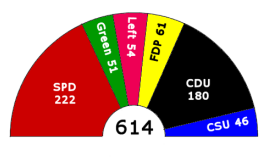
German federal election, 2005
Seats won by each party in the 2005 German federal election, an example of a proportional voting system.
Plurality Voting System
The plurality voting system is a single-winner voting system often used to elect executive officers or to elect members of a legislative assembly that is based on single-member constituencies . This voting method is also used in multi-member constituencies in what is referred to as an exhaustive counting system where one member is elected at a time and the process repeated until the number of vacancies is filled. In political science, the use of the plurality voting system alongside multiple, single-winner constituencies to elect a multi-member body is often referred to as single-member district plurality (SMDP).

Plurality ballot
An example of a plurality ballot.
8.1.5: Electoral Districts
An electoral district is a territorial subdivision whose members (constituents) elect one or more representatives to a legislative body.
Learning Objective
Analyze how apportionment, malapportionment and gerrymandering affect the political process
Key Points
- In an electoral district, the constituents are the voters who reside within the geographical bounds of an electoral district.
- District magnitude is the number of representatives elected from a given district to the same legislative body.
- Apportionment is the process of allocating a number of representatives to different regions, such as states or provinces, and is generally done on the basis of population. Malapportionment occurs when voters are under or over-represented due to variation in district population.
- Gerrymandering is the manipulation of electoral district boundaries for political gain.
Key Terms
- apportionment
-
The act of apportioning or the state of being apportioned
- gerrymandering
-
The practice of redrawing electoral districts to gain an electoral advantage for a political party.
- electoral district
-
A district represented by one or more elected officials.
Example
- Apportionment is generally done on the basis of population. Seats in the United States House of Representatives, for instance, are reapportioned to individual states every 10 years following a census, with some states that have grown in population gaining seats. The United States Senate, by contrast, is apportioned without regard to population; every state gets exactly two senators.
Definition
An electoral district is a distinct territorial subdivision for holding an election for one or more seats in a legislative body. Generally, only voters who reside within the geographical bounds of an electoral district, the constituents, are permitted to vote in an election held there. The term “constituency” can be used to refer to an electoral district or to the body of eligible voters within the represented area. In Australia and New Zealand, electoral districts are called “electorates,” but elsewhere the term generally refers to the body of voters.
In the United States, there are several types of districts:
- Congressional districts
- states
- state representative districts
- city council districts
An election commission is a body charged with overseeing the implementation of election procedures. The exact name used varies from country to country, including such terms as “electoral commission”, “central election commission”, “electoral branch” or “electoral court”. Election commissions can be independent, mixed, judicial or governmental. They may also be responsible for electoral boundary delimitation. In federations there may be a separate body for each subnational government. In the executive model the election commission is directed by a cabinet minister as part of the executive branch of government, and may include local government authorities acting as agents of the central body. Countries with this model include Denmark, Singapore, Sweden, Switzerland, Tunisia and the United States.
District Magnitude
District magnitude is the number of representatives elected from a given district to the same legislative body. A single-member district has one representative, whereas a multi-member district has more than one. Proportional representation voting systems inherently require multi-member districts, and the larger the district magnitude the more proportional a system tends to be. Under proportional representation systems, district magnitude is an important determinant of the makeup of the elected body.
The geographic distribution of minorities also affects their representation — an unpopular nationwide minority can still secure a seat if they are concentrated in a particular district. District magnitude can vary within the same system during an election. In the Republic of Ireland, for instance, national elections to Dáil Éireann are held using a combination of 3, 4, and 5 member districts. In Hong Kong, the magnitude ranged from 3 to 5 in the 1998 election, but from 5 to 9 in the 2012.
Apportionment and Redistricting
Apportionment is the process of allocating a number of representatives to different regions, such as states or provinces. Apportionment changes are often accompanied by redistricting, the redrawing of electoral district boundaries to accommodate the new number of representatives. This redrawing is necessary under single-member district systems, as each new representative requires his or her own district.
Apportionment is generally done on the basis of population. Seats in the United States House of Representatives, for instance, are reapportioned to individual states every 10 years following a census, with some states that have grown in population gaining seats. The United States Senate, by contrast, is apportioned without regard to population; every state gets exactly two senators. Malapportionment occurs when voters are under or over-represented due to variation in district population.
Gerrymandering is the manipulation of electoral district boundaries for political gain. By creating a few “forfeit” districts where voters vote overwhelmingly for rival candidates, gerrymandering politicians can manufacture more narrow wins among the districts they seek to win . Gerrymandering effectively concentrates wasted votes among opponents while minimizing wasted votes among supporters. Gerrymandering is typically done under voting systems with single-member districts .
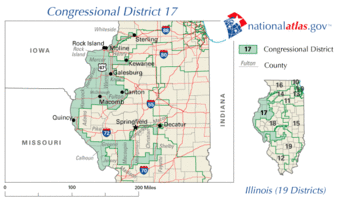
Gerrymandering in Illinois
Another example of Illinois gerrymandering is the 17th congressional district in the western portion of the state. Notice how the major urban centers are anchored and how Decatur is nearly isolated from the primary district.
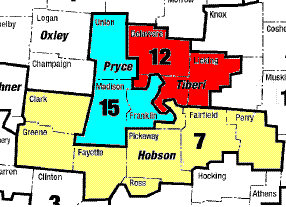
Gerrymandering in Ohio
An example of “cracking” style of gerrymandering. The urban (and mostly liberal) concentration of Columbus, Ohio, located at the center of the map in Franklin County, is split into thirds, with each segment attached to—and outnumbered by—largely conservative suburbs.
Swing Seats and Safe Seats
Sometimes, particularly under non-proportional winner-take-all voting systems, electoral districts can be prone to landslide victories. A safe seat is one that is very unlikely to be won by a rival politician due to the makeup of its constituency. Conversely, a swing seat is one that could easily swing either way. In United Kingdom general elections, the voting in a relatively small number of swing seats usually determines the outcome of the entire election. Many politicians aspire to have safe seats.
8.2: The Modern Political Campaign
8.2.1: Assembling a Campaign Staff
It is essential to gather a specialized and politically driven staff that helps run political campaigns in elections.
Learning Objective
Describe the organizational structure of a major modern political campaign
Key Points
- Successful campaigns usually require a campaign manager to coordinate the campaign’s operations.
- Activists are the ‘foot soldiers’ who are loyal to the cause. They are the true believers who will carry the run by volunteer activists.
- Political consultants advise campaigns on virtually all of their activities from research to field strategy.
- There are different departments created while assembling the staff in order to structure all of the campaign roles.
Key Terms
- pollster
-
A professional whose primary job is conducting pre-election polls.
- consultant
-
A person whose occupation is to be consulted for their expertise, advice, or help in an area or specialty. Alternatively, a party whose business is to be similarly consulted.
- quadrennial
-
Happening every four years.
- activist
-
A person who is politically active in the role of a citizen; especially, one who campaigns for change
Example
- In the United States larger campaigns hire consultants to serve as strategists. The campaign manager focuses mostly on coordinating the campaign staff. Campaign managers will often have deputies who oversee various aspects of the campaign at a closer level.
Organization
In a modern political campaign, the campaign organization will have a coherent structure and staff like any other large business. Political campaign staff is the people who formulate and implement the strategy needed to win an election. Many people have made careers out of working full-time for campaigns and groups that support them. However, in other campaigns much of the staff might be unpaid volunteers.
Campaign Manager
Successful campaigns usually require a campaign manager to coordinate the campaign’s operations. Apart from a candidate, the campaign manger is often a campaign’s most visible leader. Modern campaign managers may be concerned with executing strategy rather than setting it, particularly if the senior strategists are typically outside political consultants such as primarily pollsters and media consultants.
Activists
Activists are the ‘foot soldiers’ loyal to the cause. They are the true believers who will carry the run by volunteer activists. These volunteers and interns may take part in activities such as canvassing door-to-door and making phone calls on behalf of the campaign.
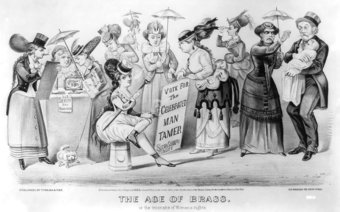
Caricature of Woman Suffrage 1869
This is a satirical caricature of the possible consequences of giving women the vote. The two candidates “Susan Sharp-tongue the Celebrated Man-Tamer” (dressed in circus-performer costume) and “Miss Hangman for Sheriff” canvass for women’s votes (in 1869 women could not vote anywhere in the United States, except as a newly-established experimental innovation in the remote territory of Wyoming). At the right, a sharp-featured woman brandishes a fist threateningly at her husband, who holds the baby. In the 1860’s chignons were a fashionable hairstyle worn by most women and often supplemented with a roll of artificial hair. The artist has caricatured this hairstyle.
Political Consultants
Political campaigns in the United States are not merely a civic ritual and an occasion for political debate. Campaigns are a multi-billion dollar industry, dominated by professional political consultants using sophisticated campaign management tools. Though the quadrennial presidential election attracts the most attention, the United States has a huge number of elected offices. There are wide variations between different states, counties, and municipalities on which offices are elected and under what procedures. Moreover, unlike democratic politics in much of the rest of the world, the U.S. has relatively weak parties. While parties play a significant role in fundraising and occasionally in drafting people to run, the individual candidates themselves ultimately control campaigns
Campaign Departments and Their Respective Purposes
The field department focuses on the “on-the-ground” organizing that is required in order to personally contact voters through canvassing, phone calls, and building local events. Voter contact helps construct and clean the campaign’s voter file in order to help better target voter persuasion and identify which voters a campaign most wants to bring out on Election Day. The field department is generally also tasked with running local “storefront” campaign offices as well as organizing phone banks and staging locations for canvasses and other campaign events.
The communications department oversees both the press relations and advertising involved in promoting the campaign in the media. They are responsible for the campaign’s message and image among the electorate. This department must approve press releases, advertisements, phone scripts, and other forms of communication before they can be released to the public.
The finance department coordinates the campaign’s fundraising operation and ensures that the campaign always has the money it needs to operate effectively. The techniques employed by this department vary based on the campaign’s needs and size. Small campaigns often involve casual fundraising events and phone calls from the candidate to donors asking for money. Larger campaigns will include everything from high-priced sit-down dinners to e-mail messages to donors asking for money.
The legal department makes sure that the campaign is in compliance with the law and files the appropriate forms with government authorities. In Britain and other Commonwealth countries, such as Canada and India, each campaign must have an official agent who is legally responsible for the campaign. The official agent is obligated to make sure the campaign follows all rules and regulations. This department will also be responsible for all financial tracking including bank reconciliations, loans, and backup for in-kind donations.
The technology department designs and maintains campaign technology such as voter file, websites, and social media. While local (county, city, town, or village) campaigns might have volunteers who know how to use computers, state and national campaigns will have information technology professionals across the state or country handling everything from websites to blogs to databases.
The scheduling and advance department makes sure that the candidate and campaign surrogates are effectively scheduled in order to maximize their impact on the voters. This department also oversees the people who arrive at events before the candidate to make sure everything is in order. Often, this department will be a part of the field department.
On small campaigns the scheduling coordinator may be responsible for developing and executing events. The scheduling coordinator typically: a) manages the candidate’s personal and campaign schedule, b) manages the field and advance team schedules, and c) gathers important information about all events the campaign and candidate will attend.
Candidates and other members of the campaign must bear in mind that only one person should oversee the details of scheduling. Fluid scheduling is one of the main components to making a profound impact on voters.
8.2.2: The Modern Political Campaign
A modern political campaign informs citizens about a political candidate running for the elected office.
Learning Objective
Identify key moments in the history of mass campaigns in the United States
Key Points
- A political campaign is an organized effort which seeks to influence the decision making process within a specific group.
- Major campaigns in the United States are often much longer than those in other democracies. Campaigns start anywhere from several months to several years before election day.
- Campaigns often dispatch volunteers into local communities to meet with voters and persuade people to support the candidate. The volunteers are also responsible for identifying supporters, recruiting them as volunteers or registering them to vote if they are not already registered.
- Campaign finance in the United States is the financing of electoral campaigns at the federal, state, and local levels. At the federal level, campaign finance law is enacted by Congress and enforced by the Federal Election Commission (FEC), an independent federal agency.
- The internet is now a core element of modern political campaigns. Communication technologies such as e-mail, web sites, and podcasts for various forms of activism to enable faster communications by citizen movements and deliver a message to a large audience.
Key Terms
- lobby groups
-
The act of attempting to persuade a group of people that influence decisions made by officials in the government, most often legislators or members of regulatory agencies.
- referendum
-
A direct popular vote on a proposed law or constitutional amendment.
- political campaign
-
It is an organized effort which seeks to influence the decision making process within a specific group.
- political action committee
-
A political action committee (PAC) is any organization in the United States that campaigns for or against political candidates, ballot initiatives, or legislation.
Example
- Signifying the importance of internet political campaigning, Barack Obama’s presidential campaign relied heavily on social media, and new media channels to engage voters, recruit campaign volunteers, and raise campaign funds. The campaign brought the spotlight on the importance of using internet in new-age political campaigning by utilizing various forms of social media and new media (including Facebook, YouTube and a custom generated social engine) to reach new target populations. The campaign’s social website, my.BarackObama.com, utilized a low cost and efficient method of mobilizing voters and increasing participation among various voter populations. This new media was incredibly successful at reaching the younger population while helping all populations organize and promote action.
Introduction
A political campaign is an organized effort which seeks to influence the decision making process within a specific group. In democracies, political campaigns often refer to electoral campaigns, where representatives are chosen or referendums are decided . In modern politics, the most high profile political campaigns are focused on candidates for head of state or head of government, often a President or Prime Minister.
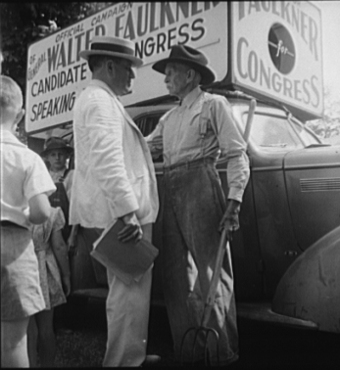
Candidate for Congress
Walter Faulkner, candidate for U.S. Congress, campaigning with a Tennessee farmer. Crossville, Tennessee.
Background History
Political campaigns have existed as long as there have been informed citizens. The phenomenon of political campaigns are tightly tied to lobby groups and political parties. The first modern campaign is thought to be William Ewart Gladstone’s Midlothian campaign in the 1880’s, although there may have been earlier modern examples from the 19th century. American election campaigns in the 19th century created the first mass-base political parties and invented many of the techniques of mass campaigning.
Process of Campaigning
Major campaigns in the United States are often much longer than those in other democracies. Campaigns start anywhere from several months to several years before election day. Once a person decides to run, they will make a public announcement. This announcement could consist of anything from a simple press release to concerned media outlets to a major media event followed by a speaking tour. It is often well-known to many people that a candidate will run prior to an announcement being made .

John Edwards Pittsburgh 2007
2008 United States Presidential candidate John Edwards campaigning in Pittsburgh on Labor day in 2007, accepting the endorsement of the United Steelworkers and the United Mine Workers of America.
Campaigns often dispatch volunteers into local communities to meet with voters and persuade people to support the candidate. The volunteers are also responsible for identifying supporters, recruiting them as volunteers or registering them to vote if they are not already registered. The identification of supporters will be useful later as campaigns remind voters to cast their votes . Late in the campaign, campaigns will launch expensive television, radio, and direct mail campaigns aimed at persuading voters to support the candidate. Campaigns will also intensify their grassroots campaigns, coordinating their volunteers in a full court effort to win votes.
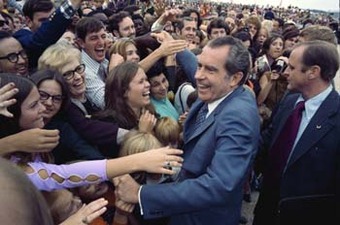
Nixon Meets Crowds at Robins Air Force Base in Georgia
President Nixon “works the crowd” at Robins Air Force Base, Georgia in the initial stages of his campaign.
Campaign Finance in the United States
Campaign finance in the United States is the financing of electoral campaigns at the federal, state, and local levels. At the federal level, campaign finance law is enacted by Congress and enforced by the Federal Election Commission (FEC), an independent federal agency. Although most campaign spending is privately financed, public financing is available for qualifying candidates for President of the United States during both the primaries and the general election. Eligibility requirements must be fulfilled to qualify for a government subsidy, and those that do accept government funding are usually subject to spending limits.
In 2008—the last presidential election year—candidates for office, political parties, and independent groups spent a total of $5.3 billion on federal elections. The amount spent on the presidential race alone was $2.4 billion, and over $1 billion of that was spent by the campaigns of the two major candidates: Barack Obama spent $730 million in his election campaign, and John McCain spent $333 million. The total spent on federal elections in 2012 was approximately $7 billion. The figures for the 2016 election will not be available until 2017.
Techniques
A campaign team must consider how to communicate the message of the campaign, recruit volunteers, and raise money. Campaign advertising draws on techniques from commercial advertising and propaganda. The avenues available to political campaigns when distributing their messages is limited by the law, available resources, and the imagination of the campaigns’ participants. These techniques are often combined into a formal strategy known as the campaign plan. The plan takes account of a campaign’s goal, message, target audience, and resources available. The campaign will typically seek to identify supporters at the same time as getting its message across.
Modern Technology and the Internet
The internet is now a core element of modern political campaigns. Communication technologies such as e-mail, web sites, and podcasts for various forms of activism to enable faster communications by citizen movements and deliver a message to a large audience. These Internet technologies are used for cause-related fundraising, lobbying, volunteering, community building, and organizing. Individual political candidates are also using the internet to promote their election campaign.
Signifying the importance of internet political campaigning, Barack Obama’s presidential campaign relied heavily on social media, and new media channels to engage voters, recruit campaign volunteers, and raise campaign funds. The campaign brought the spotlight on the importance of using internet in new-age political campaigning by utilizing various forms of social media and new media (including Facebook, YouTube and a custom generated social engine) to reach new target populations. The campaign’s social website, my.BarackObama.com, utilized a low cost and efficient method of mobilizing voters and increasing participation among various voter populations. This new media was incredibly successful at reaching the younger population while helping all populations organize and promote action.
8.2.3: The Nomination Campaign
In the nomination campaign, Presidential candidates are selected based on the primaries to run in the main election.
Learning Objective
Describe the procedure by which the Electoral College indirectly elects the President
Key Points
- The modern Presidential campaign begins before the primary elections.
- Nominees campaign across the country to explain their views, convince voters and solicit contributions.
- Much of the modern electoral process is concerned with winning swing states through frequent visits and mass media advertising drives.
Key Terms
- Twentieth Amendment
-
This amendment establishes the beginning and ending of the terms of the elected federal offices.
- vice president
-
A deputy to a president, often empowered to assume the position of president on his death or absence
- electoral college
-
A body of electors empowered to elect someone to a particular office
Example
- A United States presidential nominating convention is a political convention held every four years in the United States by most of the political parties who will be fielding nominees in the upcoming U.S. presidential election.
Modern Presidential Campaign and Nomination
The modern presidential campaign begins before the primary elections. The two major political parties try to clear the field of candidates before their national nominating conventions, where the most successful candidate is made the party’s nominee for president. Typically, the party’s presidential candidate chooses a vice presidential nominee, and this choice is then rubber-stamped by the convention.
Nominees participate in nationally televised debates. While the debates are usually restricted to the Democratic and Republican nominees, third party candidates may be invited, such as Ross Perot in the 1992 debates. Nominees also campaign across the country to explain their views, convince voters and solicit contributions. Much of the modern electoral process is concerned with winning “swing states” through frequent visits and mass media advertising drives.
Election and oath
Presidents are elected indirectly in the United States. A number of electors, collectively known as the Electoral College, officially select the president. On Election Day, voters in each of the states and the District of Columbia cast ballots for these electors. Each state is allocated a number of electors, equal to the size of its delegation in both Houses of Congress combined. Generally, the ticket that wins the most votes in a state wins all of that state’s electoral votes, and thus has its slate of electors chosen to vote in the Electoral College.
The winning slate of electors meet at its state’s capital on the first Monday after the second Wednesday in December, about six weeks after the election, to vote. They then send a record of that vote to Congress. The vote of the electors is opened by the sitting vice president, acting in his capacity as President of the Senate, and is read aloud to a joint session of the incoming Congress, which is elected at the same time as the President.

Electoral College
Electoral college map for the 2012, 2016 and 2020 United States presidential elections, using apportionment data released by the US Census Bureau.
Pursuant to the Twentieth Amendment, the President’s term of office begins at noon on January 20 of the year following the election. This date, known as Inauguration Day, marks the beginning of the four-year term of both the President and the vice president. Before executing the powers of the office, a President is constitutionally required to take the presidential oath.
8.2.4: The General Election Campaign
In the U.S., general election campaigns promote presidential candidates running for different parties.
Learning Objective
Identify the features that distinguish American elections from those in other democracies
Key Points
- In U.S. politics, general elections occur every four years and include the presidential election.
- One of the most important aspects of the major American political campaign is the ability to raise large sums of money, especially early on in the race.
- Campaigns often dispatch volunteers into local communities to meet with voters and persuade people to support the candidate.
Key Terms
- general elections
-
In the United States, these regulation elections of candidates occur every four years and include the presidential election.
- campaign
-
An organized effort to influence the decision making process within a specific group when seeking election to political office.
- partisan
-
An adherent to a party or faction.
Example
- In general elections citizens can actively participate in campaigning for their preferred political party. Citizens can act as volunteers who are also responsible for identifying supporters, recruiting them as volunteers, or registering them to vote if they are not already registered. The identification of supporters is useful later on during campaigns when voters are reminded to cast their votes.
General Elections in the United States
In presidential systems, a general election refers to a regularly scheduled election, where both the president, and either “a class” of or all members of the national legislature are elected at the same time. A general election day may also include elections for local officials.
In U.S. politics, general elections occur every four years and include the presidential election. Some parallels can be drawn between the general election in parliamentary systems and the biennial elections determining all House seats. There is no analogue to “calling early elections” in the U.S., however, and the members of the elected U.S. Senate face elections of only one-third at a time at two year intervals including during a general election.
Types of Elections
The United States is unusual in that dozens of different offices are filled by election, from drain commissioner to the President of the United States. Elections happen every year, on many different dates, and in many different areas of the country.
All federal elections including elections for the President and the Vice President, as well as elections to the House of Representatives and Senate, are partisan. Elections to most but not all statewide offices are partisan-oriented, and all state legislatures except for Nebraska are partisan-oriented.
Some state and local offices are non-partisan, these often include judicial elections, special district elections (the most common of which are elections to the school board, and elections to municipal (town council, city commission, mayor) and county (county commission, district attorney, sheriff) office. In some cases, candidates of the same political party challenge each other. Additionally, in many cases there are no campaign references to political parties, but sometimes even non-partisan races take on partisan overtones.
Process of Campaigning
Major campaigns in the United States are often much longer than those in other democracies. The first part of any campaign is for a candidate to decide to run in elections. Prospective candidates will often speak with family, friends, professional associates, elected officials, community leaders, and the leaders of political parties before deciding to run. Candidates are often recruited by political parties and lobby groups interested in electing like-minded politicians. During this period, people considering running for office will consider their ability to put together the money, organization, and public image needed to get elected. Many campaigns for major office do not progress past this point, as people often do not feel confident in their ability to win. However, some candidates lacking the resources needed for a competitive campaign proceed with an inexpensive paper campaign or informational campaign designed to raise public awareness and support for their positions.
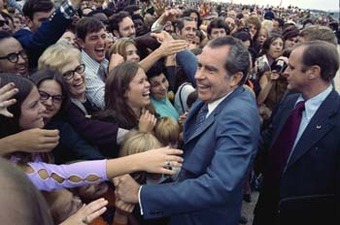
Nixon Meets Crowds at Robins Air Force Base in Georgia
President Nixon “works the crowd” at Robins Air Force Base, Georgia in the initial stages of his campaign.
Once a person decides to run, they make a public announcement. This announcement consists of anything from a simple press release, to concerned media outlets, or a major media event followed by a speaking tour.
Funding for Campaigns
One of the most important aspects of the major American political campaign is the ability to raise large sums of money, especially early on in the race. Political insiders and donors often judge candidates based on their ability to raise money. Not raising enough money early on can lead to problems later as donors are not willing to give funds to candidates they perceive to be losing, a perception based on their poor fundraising performance.
Also during this period, candidates travel around the area they are running in and meet with voters; speaking to them in large crowds, small groups, or even one-on-one. This allows voters to get a better sense of who a candidate is, rather than just relying on what they read about in the paper or see on television.
Campaigns often dispatch volunteers into local communities to meet with voters and persuade people to support the candidate. The volunteers are also responsible for identifying supporters, recruiting them as volunteers or registering them to vote if they are not already registered. The identification of supporters is useful later, as campaigns remind voters to cast their votes.
Late in the campaign, campaigns will launch expensive television, radio, and direct mail campaigns aimed at persuading voters to support their candidate. Campaigns will also intensify their grassroots campaigns, coordinating their volunteers in a full court effort to win votes.
8.3: Political Candidates
8.3.1: Eligibility
Eligibility requirements restrict who can run for a given public office.
Learning Objective
Give examples of eligibility requirements for various offices
Key Points
- Virtually all electoral systems have some eligibility requirements, such as a minimum age to run for office.
- Even within a single jurisdiction, eligibility requirements may vary by office; there are more stringent restrictions on who can run for president than on who can run for Senate in the U.S.
- The natural born citizen clause places a Constitutional limitation on who can run for president in the U.S., limiting the office to natural born citizens.
Key Terms
- eligibility requirement
-
Statutory restrictions on who is entitled to hold a given public office.
- natural born citizen
-
Any person who is entitled to American citizenship by birth.
Example
- The controversial “birther” movement that has questioned the validity of President Obama’s American birth certificate is an example of debate involving the natural born citizenship clause. Republican presidential candidate Mitt Romney was born in Mexico to American parents, illustrating that natural born citizenship does not depend on place of birth, but rather whether one is entitled to citizenship at birth.
Different voting jurisdictions set different eligibility requirements for candidates to run for office. In partisan election systems, such as those in place for U.S. Presidential and Congressional elections, the only people eligible to run in a general election are those nominated by a political party or who have successfully petitioned to be on the ballot. In non-partisan elections, there may be fewer restrictions on those who can be listed on a ballot, with no requirements for party or popular support.
Virtually all electoral systems, whether partisan or non-partisan, have some minimum eligibility requirements to run for office. For example, candidates are generally required to be a certain age. In some jurisdictions, individuals may be eligible to campaign when they reach the age of legal majority, which is often 18. Elsewhere, candidates may need to be older; for example, in U.S. Presidential campaigns, candidates must be at least 35 years old.
Eligibility requirements may also vary by political office within a given jurisdiction. The President of the U.S. must be a natural-born citizen, due to the natural-born citizenship clause of the U.S. Constitution . There has been some legal debate over what constitutes natural born citizenship, particularly regarding cases where an individual is born outside the U.S. to American citizens or in cases of adoption. Generally, however, natural born citizenship is understood to include anyone who is entitled to U.S. citizenship at birth, even if they are born outside of the U.S. Over the years, multiple presidential candidates have been born in foreign countries or U.S. territories, but have met the natural born citizenship eligibility requirement because they were born to American citizens.

Natural Born Citizen Clause
The U.S. Constitution limits eligibility for the office of president to individuals who are natural born citizens of the U.S.
In offices other than that of the President, eligibility requirements tend to be less stringent. For example, according to the Constitution, members of the U.S. House of Representatives must be over the age of 25 and an American citizen for at least seven years. The Senate’s minimum age requirement is 30 and nine years an American citizen. Both chambers of Congress require members to be residents of the state they seek to represent. House members are not required to live in their districts. For local offices, the requirements are often even less strict — in certain jurisdictions, local officials simply need to be current citizens over the age of 18 who have established local residency.
8.3.2: Nominating Candidates
Nomination is the process through which political candidates are chose to campaign for election to office.
Learning Objective
Describe the steps by which a candidate appears on the ballot in a general election
Key Points
- In representative democracies, candidates are nominated to run for office and then are placed on a ballot to seek election.
- In the United States, political parties are largely responsible for nominating candidates.
- In contested elections, candidates participate in primary elections to become their party’s nominee in the general election.
Key Terms
- political party
-
A political organization that subscribes to a certain ideology and seeks to attain political power through representation in government.
- primary election
-
A preliminary election to select a political candidate of a political party.
- nominating convention
-
A meeting of the major figures in a political party to outline a party platform, set party rules, select a nominee for president as well as rally supporters.
Example
- In the 2012 U.S. presidential election, Mitt Romney was the Republican Party’s presumptive nominee before the party’s national convention; he was not officially nominated by the party, but because he had won the party’s primary election, the official nomination at the convention was a mere formality.
Nomination is part of the process of selecting a candidate for election to office. In a representative democracy, such as the United States, citizens vote to elect individuals to public offices. Examples of elected officials include at the federal level, the president; at the state level, a state representative; and at the local level, a city council member. In order to have their names listed on election ballots, individuals seeking these offices must first be nominated.
In the United States, nominees are often chosen by political parties. Political parties are organizations that subscribe to a certain ideology, articulated in the party’s platform, and that seek to attain political power through representation in government. The two largest political parties in the United States are the Democratic Party and the Republican Party, but there also are smaller parties, such as the Libertarian Party and the Green Party. To nominate candidates, political parties hold primary elections. Primary elections are used to narrow the field of candidates for the general election. In a primary, several members of the same political party campaign to become their party’s nominee in the general election. In the general election, nominees from each party compete against each other to be elected to office.
In order to formally select candidates for a presidential election, American political parties hold nominating conventions . The official purpose of these conventions is to select the party’s nominee for president, as well as to adopt a statement of party principles and goals, known as the platform. In modern presidential campaigns, however, nominating conventions are largely ceremonial. Due to changes in election laws, the primary and caucus calendar, and the manner in which political campaigns are run, parties enter their conventions with presumptive nominees. During primary campaigns, state delegates are assigned to a primary candidate based on the outcome of a statewide vote. Whichever primary candidate emerges from the primary election with the most delegates becomes the party’s presumptive nominee. The presumptive nominee is not formally nominated until the national convention, but he or she is all but assured of a place on the ballot in the general election by the conclusion of the primary season.
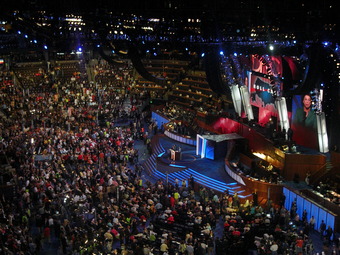
2008 Democratic National Convention
Modern nominating conventions are largely ceremonial affairs, intended to strengthen party support of its presumptive nominee.
When candidates for national, state, or local office are not affiliated with a political party, they may be nominated as candidates if they receive a sufficient number of signatures from eligible voters (though the specific requirements vary by voting jurisdiction). In a case where an independent, or unaffiliated, candidate receives sufficient signatures, his or her name will appear on the ballot in the general election. These candidates do not need to participate in primary elections, since they are not seeking the nomination of a political party.
8.3.3: Electing Candidates
An election is a decision-making process used in a democracy to choose public office holders based on a vote.
Learning Objective
Define the electorate
Key Points
- Modern representative democracies use elections to determine a range of national, state, and local officials.
- Voting jurisdictions use different electoral systems to determine the outcome of elections, which may result in political parties receiving either a proportion of open seats or total control of a governmental body.
- The electorate is the group of eligible voters in an election, and may be limited by restrictions such as citizenship or residency requirements, age requirements, or property-owning requirements.
Key Terms
- electorate
-
The collective people of a country, state, or electoral district who are entitled to vote.
- election
-
A process of choosing a leader, members of parliament, councillors or other representatives by popular vote.
- electoral system
-
The detailed constitutional arrangements and voting laws that convert the vote into a political decision.
An election is a formal decision-making process by which a population chooses an individual to hold public office. Generally, elections consist of voters casting ballots at polling places on a scheduled election day . Elections have been the usual mechanism by which representative democracies have operated since the 17th century. Elections may fill offices in the legislature, the executive and judiciary, and regional and local government.
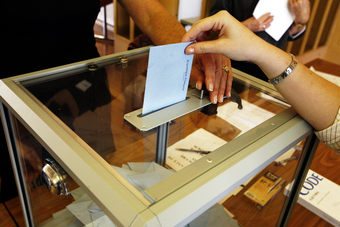
Casting a Ballot
Many electoral systems require voters to cast ballots at official, regulated polling places.
Electoral systems are the detailed constitutional arrangements and voting laws that convert the vote into a political decision. The first step in determining the results of an election is to tally the votes, for which various vote counting systems and ballot types are used. Electoral systems then determine the result of the election on the basis of the tally. Most electoral systems can be categorized as either proportional or majoritarian. In a proportional electoral system, a political party receives a percentage of seats in a governmental body in proportion to the number of votes it receives. In a majoritarian system, one party receives all of the seats in question if it receives the majority of votes. Strictly majoritarian systems are rare in modern democracies due to their tendency for suppressing minority views. For example, in the United States presidential elections are dependent upon the allocation of delegates from the electoral college. The number of delegates that each state has is proportional to the state’s population, but all of a state’s delegates are assigned to the presidential candidate who wins the majority of votes in the state. This electoral system is neither strictly majoritarian nor proportional; state delegates are not allocated to candidates in proportion to the votes they receive, but neither is winning the popular vote sufficient to ensure a candidate’s election. This system is intended to provide smaller states and less densely populated regions with influence in national elections.
The question of who may vote is a central issue in elections. The electorate, or the group of people who are eligible to vote, does not generally include the entire population. For example, many countries prohibit those judged mentally incompetent from voting, and all jurisdictions require a minimum age for voting. Historically, jurisdictions have excluded groups such as women, blacks, immigrants, and non-property owners from the electorate. Most national elections require that voters are citizens, and many local elections require proof of local residency to vote.
8.3.4: Likeability of Political Candidates
Candidates run for office by orchestrating expensive campaigns designed to increase their appeal to the electorate.
Learning Objective
Identify the reasons the electorate might be drawn to a particular candidate
Key Points
- The primary trait by which voters evaluate candidates is political ideology, referring to how liberal or conservative the candidate’s views are.
- Political ideology tends to be inferred from political party membership, with the Republican and Democratic parties being seen as conservative and liberal respectively in the U.S.
- Apart from ideology, traits such as likeability and access to funds may determine a campaign’s success or lack thereof.
Key Terms
- campaign
-
An organized effort to influence the decision making process within a specific group when seeking election to political office.
- campaign message
-
The ideas that the candidate wants to share with the voters, often consisting of several talking points about policy issues.
- likeability
-
The property that makes a person likeable, that allows them to be liked.
Candidates running for election to public office need to appeal to the electorate in order to acquire votes. Accordingly, candidates run campaigns aimed at establishing a popular campaign message and convincing voters of the candidate’s likeability.
In many elections, candidates are primarily differentiated by being either liberal or conservative. A candidate’s liberal or conservative ideology is usually expressed by affiliation with a political party — in the U.S. the Republican Party is understood to be conservative and the Democratic Party is understood to be liberal. A candidate’s stated political ideology may be treated as a proxy for their position on a range of policy issues. One’s stance on economic regulation, immigration, and abortion, for example, may be inferred from political party membership. In large part, this association is supported by political parties’ platforms in the U.S. At the same national convention where parties nominate candidates for president, they formalize a platform enumerating party beliefs and objectives. When a candidate for state or national office affiliates with a party, they are therefore associated with that party’s written platform.
Apart from ideology, less explicit factors such as likeability and access to resources impact candidates’ campaigns. Likeability refers to whether or not the electorate generally likes a candidate, as measured by opinion polls . Likeability is thought to play a significant role in electoral politics but is difficult to access in campaigns. Politicians may consciously attempt to augment their likeability by donating to charities, telling jokes during speeches, or posing for photos with voters. However, likeability can be difficult for politicians and political strategists to control.
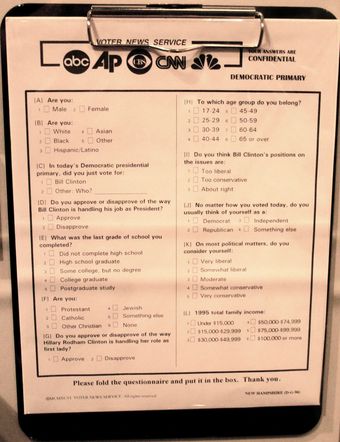
Voter Opinion Poll
Polling agencies conduct surveys of potential voters during election seasons to measure how the electorate ranks the traits of candidates.
A major critique of large scale electoral politics in the U.S. and other democracies is that a candidate’s wealth has too much influence in the election’s outcome. Modern campaigns usually include television and radio ads, extensive travel, and large organizations of strategists and organizers. Thus, campaigns have become extremely expensive. Major candidates generally need to have immense personal wealth or successful fundraising networks to compete in national campaigns. Therefore, access to monetary resources is an important trait for candidates to possess.
8.4: Presidential Elections
8.4.1: Primaries and Caucuses
Primary elections and caucuses are used to narrow the field of candidates in each major political party before a general election.
Learning Objective
Summarize the primary system and how a primary differs from a caucus
Key Points
- In American politics, the two major political parties provide networks of voters and advocates and financial resources to candidates, therefore, candidates seek their nomination before entering general elections.
- Primaries and caucuses occur at the state level and allow candidates to campaign on a smaller scale to seek nomination before entering the national campaign.
- The structure of primaries and caucuses varies by state, with some contests requiring official affiliation with a party in order to cast a vote in the nominating election.
Key Terms
- general election campaign
-
an organized effort which seeks to influence who is voted into the office of presidency and other federal and state legislative offices
- closed primary
-
an election in which only party members are allowed to vote, and during which they choose their party’s candidates for an upcoming general election
- delegate
-
A person authorized to act as representative for another; in politics, a party representative allocated to nominate a party candidate.
- caucus
-
A meeting, especially a preliminary meeting, of persons belonging to a party, to nominate candidates for public office, or to select delegates to a nominating convention, or to confer regarding measures of party policy; a political primary meeting.
- primary election
-
A preliminary election to select a political candidate of a political party.
Example
- The Iowa caucuses are the first nominating election to occur in the presidential primary season and, therefore, they often have a significant impact on later primaries. In 2008, a win in the Iowa caucuses gave candidate Barack Obama a major boost; a win in 2000 had the same result for George W. Bush.
In America’s two-party political system, political parties rely on primary elections and caucuses to nominate candidates for general elections. Political parties provide resources to the candidates they nominate, including endorsements, social contacts, and financial support. Consequently, attaining a party nomination by winning a primary election or caucus is a necessary step to becoming a major election candidate. Primaries are held on different dates in different states and give national candidates an opportunity to campaign to smaller audiences than during the general election. The candidate who wins each state vote is granted a certain number of delegates,depending on the state’s size, and the candidate with the most party delegates becomes the party’s general election nominee. Not every election is preceded by a primary season, but most major races, such as presidential and congressional races, use primaries to narrow the field of candidates.
Primary Elections
Primaries began to be widely used in the United States during the Progressive Era in the early 1900s. The impetus behind establishing them was to give more power to voters, rather than allowing behind the scenes political maneuverers to choose major candidates. In modern elections, primaries are seen as beneficial to both voters and parties in many ways – voters are able to choose between a range of candidates who fit within a broader liberal or conservative ideology, and parties are able to withhold support of a candidate until they have demonstrated an ability to gain public support.
Primary rules vary by state, as does the importance of their outcomes. Primaries may be classified as closed, semi-closed, semi-open, or open. In a closed primary, only voters who are registered with the party holding the primary are allowed to vote. In other words, registered Republicans can only vote to choose a candidate from the Republican field, and Democrats can only vote in the Democratic primary. In a semi-closed system, voters need not register with a party before the election, therefore independent voters may choose to vote in either the Democratic or Republican primary. In an open primary system, voters can vote in either primary regardless of affiliation. Open primaries are the most controversial form in American politics. Supporters argue that open primaries give more power to the voter and less to the party, since voters are not tied to voting for a party that does not produce a good candidate. Critics, however, argue that open primaries will lead to vote raiding, a practice in which party members vote in the opposing party’s primary in an attempt to nominate a weak candidate.
Caucuses
Whereas primaries follow the same polling practices as general elections, caucuses are structured quite differently. In nominating caucuses, small groups of voters and state party representatives meet to nominate a candidate. Caucuses vary between the states in which they are held, however, generally they include speeches from party representatives, voter debate, and then voting by either a show of hands or a secret ballot . Like primaries, caucuses result in state delegates being allocated to a particular candidate, to nominate that candidate to the general election. The vast majority of states use primaries to nominate a candidate, but caucuses are notably used in Iowa, which is traditionally the first state to vote in the primary/caucus season. Since Iowa is first, it has a large impact on the primary season, as it gives one candidate from each party an advantage as they move into other state votes. Due to its small population and the small-scale, intimate structure of its caucuses, Iowa is notorious for allowing lesser- known candidates to do unexpectedly well.
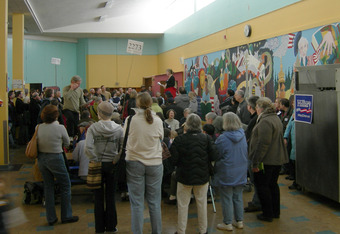
Washington State Caucus
Caucuses occur in small settings and often include lively debate by party members.
8.4.2: The National Convention
Political parties hold national conventions to nominate candidates for the presidency and to decide on a platform.
Learning Objective
Compare contemporary political conventions with those in middle 19th-century
Key Points
- National party conventions are designed to officially nominate the party’s candidate and develop a statement of purpose and principles called the party platform. Informally, political parties use the conventions to build support for their candidates.
- From the point of view of the parties, the convention cycle begins with the Call to Convention. Usually issued about 18 months in advance, the Call is an invitation from the national party to the state and territory parties to convene to select a presidential nominee.
- Each party sets its own rules for the participation and format of the convention. Broadly speaking, each U.S. state and territory party is apportioned a select number of voting representatives, individually known as delegates and collectively as the delegation.
- The convention is typically held in a major city selected by the national party organization 18–24 months before the election is to be held.
- Each convention produces a statement of principles known as its platform, containing goals and proposals known as planks. Relatively little of a party platform is even proposed as public policy.
- The evening’s speeches – designed for broadcast to a large national audience—are reserved for major speeches by notable, respected public figures.
Key Terms
- party platform
-
A statement of principles and purpose issued by a political party.
- national convention
-
a political convention held in the United States every four years by political parties fielding candidates in the upcoming presidential election.
- planks
-
Planks refer to the goals and proposals in the platform of a political party.
Example
- The selection of individual delegates and their alternates, too, is governed by the bylaws of each state party, or in some cases by state law. The 2004 Democratic National Convention counted 4,353 delegates and 611 alternates.
Introduction
A national convention is a political convention held in the United States every four years by political parties fielding candidates in the upcoming presidential election. National party conventions are designed to officially nominate the party’s candidate and develop a statement of purpose and principles called the party platform. Informally, political parties use the conventions to build support for their candidates.
Major political parties in the early 1830s were the first to use the political convention. These were often heated affairs, with delegates from each state playing a major role in determining the party’s national nominee . The term “dark horse candidate” was coined at the 1844 Democratic National Convention when little-known Tennessee politician James K. Polk emerged as the candidate after the leading candidates failed to secure the necessary two-thirds majority vote.
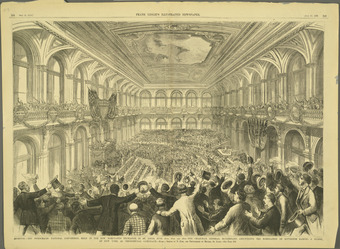
Democratic National Convention (1876)
An image from a newspaper article about the 1876 Democratic National Convention in St. Louis, MO.
There is no such suspense at modern conventions. Due to primaries and increased access to national news, each party essentially knows who its candidate will be before the convention. Instead, modern conventions serve to rally support for the candidate . Conventions today are largely ceremonial events with little influence on the presidential campaign beyond how the convention is received in the press.
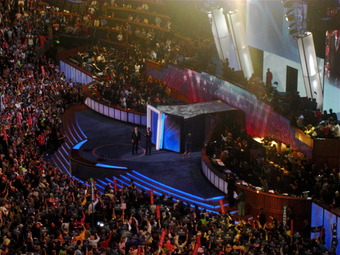
Democratic Party, 2008
An image of future President Barack Obama and Vice-President Joe Biden after they were officially nominated for the Democratic ticket at the 2008 Democratic National Convention.
Logistics
From the point of view of the parties, the convention cycle begins with the Call to Convention. Usually issued about 18 months in advance, the Call is an invitation from the national party to the state and territory parties to convene to select a presidential nominee. It also sets out the number of delegates to be awarded to each, as well as the rules for the nomination process. One reason for the late conventions has to do with campaign finance laws, which allow the candidates to spend an unlimited amount of money before the convention, but forbid fundraising after the convention, in order for the parties to receive federal campaign funds.
Each party sets its own rules for the participation and format of the convention. Broadly speaking, each U.S. state and territory party is apportioned a select number of voting representatives, individually known as delegates and collectively as the delegation. Each party uses its own formula for determining the size of each delegation, factoring in such considerations as population, proportion of that state’s Congressional representatives or state government officials who are members of the party, and the state’s voting patterns in previous presidential elections. The selection of individual delegates and their alternates, too, is governed by the bylaws of each state party, or in some cases by state law. The 2004 Democratic National Convention counted 4,353 delegates and 611 alternates.
The convention is typically held in a major city selected by the national party organization 18–24 months before the election is to be held. As the two major conventions have grown into large, publicized affairs with significant economic impact, cities today compete vigorously to be awarded host responsibilities, citing their meeting venues, lodging facilities, and entertainment as well as offering economic incentives.
Proceedings
Each convention produces a statement of principles known as its platform, containing goals and proposals known as planks. Relatively little of a party platform is even proposed as public policy. Much of the language is generic, while other sections are narrowly written to appeal to factions or interest groups within the party. Unlike electoral manifestos in many European countries, the platform is not binding on either the party or the candidate. Because it is ideological rather than pragmatic, however, the platform is sometimes itself politicized. For example, defenders of abortion lobbied heavily to remove the Human Life Amendment plank from the 1996 Republican National Convention platform, a move fiercely resisted by conservatives despite the fact that no such amendment had ever come up for debate. Given the same routines and repetition of proceedings, presidential nominating conventions have become predictable for observers of the political process.
Minor figures in the party are given the opportunity to address the floor of the convention during the daytime, when only the small audiences of C-SPAN and other cable television outlets are watching. The evening’s speeches – designed for broadcast to a large national audience—are reserved for major speeches by notable, respected public figures; the speakers at the 2004 Democratic convention included Ted Kennedy, a forty-year veteran of the United States Senate, and Jimmy Carter, a former Democratic President, while at the Republican convention speakers included Governor Arnold Schwarzenegger of California and Governor George Pataki of New York, two of the largest states in the nation.
8.4.3: The General Election Campaign
The presidential general election occurs after the primary season and is the process through which a national vote chooses the president.
Learning Objective
Describe the steps involved in conducting a presidential campaign
Key Points
- The general election campaign lasts from the end of the primary season in June until the general vote in November and is a contest between the nominated candidate from each major political party.
- General election campaigns tend to focus their efforts on swing states, or states in which there is no clear Democratic or Republican majority, because state Electoral College electors are allocated on a winner-takes-all basis.
- General election campaigns are extremely expensive, so candidates exert substantial effort to convince not only voters but also donors to support their candidacy.
Key Terms
- electoral college
-
A set of electors who are selected to elect a candidate to a particular office, allocated based on statewide votes.
- general election
-
An election, usually held at regular intervals, in which candidates are elected in all or most constituencies or electoral districts of a nation.
- primary season
-
The first stage of a presidential election, in which candidates from each party compete against members from their own party for the party’s nomination.
Example
- The 2012 campaign between Mitt Romney and President Barack Obama is an example of a general election for president.
In the United States, a presidential election is held every four years and includes both a primary season and a general election. During the primary season, the two major political parties narrow the field of candidates through state votes to nominate the party’s candidate for the general election. Because parties provide candidates with voter and staff networks and material resources, they have an incentive to present a unified front and only support one candidate, hence, winning the primary season is a necessary first step to becoming a major candidate in a general election. In the primary season, candidates compete against other members of their party to win a majority of votes from voters within their own party. By contrast, in the general election, candidates from each party compete against each other, and voters are able to vote for either candidate at the polls.
The winner of a presidential general election is not simply the person who receives the majority of votes nationwide. Instead, votes are allocated indirectly through members of the Electoral College. Under this system, statewide elections take place in which voters cast ballots for candidates. Whichever candidate wins the majority of votes in the state receives that state’s Electoral College votes. Electoral College votes are divided proportionally based on state population, meaning that larger states have more influence in the election than smaller ones . Because a candidate only needs to win a majority of votes in the state to receive all of its Electoral College votes, this system has lead to election strategies in which states with a solid Republican or Democratic majority are not contested by candidates. Instead, candidates focus their campaigns on so-called “swing states. ” Swing states are those without a clear majority party, in which all of the state’s Electoral College votes are therefore up for grabs. The most notorious swing states in recent years have been Florida and Ohio, since each is generally unpredictable, and each has a significant number of Electoral College electors.

Electoral College (2008)
In the presidential general election, the winner is determined based on who receives the greatest number of votes in the Electoral College system.
Because candidates in the general election must appeal to vast numbers of voters across a large geographic range, general elections are immensely expensive. Candidates tend to fund their campaigns in part with their personal wealth but also by fundraising extensively. Fundraising may include appealing to wealthy large donors, organizing grassroots campaigns to amass small donations from large numbers of voters, or tapping into political party funds. In recent years, PACs or political action committees, have arisen to amass large funds and produce campaign advertisements on behalf of their favored candidates. A 2010 Supreme Court decision in the case known as Citizens United further paved the way for PACs to exert a large influence in general elections. According to Citizens United, contributions to PACs are not limited so long as the PACs are not directly affiliated with a candidate. Consequently, the 2012 election has witnessed a rise of “super-PACs,” political action committees with unprecedented purchasing power who have produced numerous expensive TV and print ads.
The presidential general election lasts from the end of the primary season, usually in June, until the vote on the first Tuesday of November. Since the president is the most visible elected official in the country, the election season is so long, and so much money is spent on advertising, the presidential general election has greater voter turnout than any other U.S. election. Even so, voter turnout usually hovers at or below 60% of eligible voters. In some cases, voter turnout strongly impacts the outcome of elections. As a general rule, white elderly voters turnout more reliably than any other demographic group, and they vote consistently Republican. Thus, some analysts argue that high turnout favors Democratic candidates, since the turnout increase usually indicates greater number of young and minority voters.
8.4.4: The Electoral College
The Electoral College is the 538 person body that elects the President and the Vice President of the United States.
Learning Objective
Assess the compatibility of the Electoral College system with the nation’s federalist and democratic commitments
Key Points
- The Electoral College is an example of indirect election, or a proces in which voters in an election do not actually choose between candidates for an office but rather elect persons who will then make the choice.
- American presidential elections are not decided by popular vote.
- The members of the Electoral College are divided by represented states and are scaled based on the population from each state.
Key Terms
- swing state
-
A state which may vote Democratic or Republican, in a given election or generally; a purple state.
- indirect election
-
a process in which voters in an election do not actually choose between candidates for an office but rather elect persons who will then make the choice.
Indirect Election
The Electoral College is an example of indirect election, when a democratic government is voted into power by a representative vote, rather than by the entirety of the electorate. The Electoral College consists of 538 electors who officially elect the President and Vice President of the United States. The number of electors equals the total voting membership of the United States Congress, with one elector for each of the current 435 Representatives and 100 Senators. The Electoral College also includes three electors from the District of Columbia, which were approved in the Twenty-third Amendment to the Constitution, in 1961. That results in 538 total electors.
Allocation of Electors
Each state is awarded the same number of electoral votes as the number of its Representatives, plus two votes to match its Senatorial count. Since the most populous states have the most seats in the House of Representatives, they also have the most electors. The six states with the most electors are California (55), Texas (38), New York (29), Florida (29), Illinois (20), and Pennsylvania (20). The seven smallest states by population in the Electoral College (Alaska, Delaware, Montana, North Dakota, South Dakota, Vermont, and Wyoming) have three electors. Each state’s number of Representatives is determined every 10 years by the US Census, thus determining the number of electoral votes for each state.

Electoral College (2008)
In the presidential general election, the winner is determined based on who receives the greatest number of votes in the Electoral College system.
Thus, though many people do not realize it, Presidential and Vice-Presidential elections are determined not by a popular vote. Although ballots list the names of the presidential candidates, voters within the 50 states and Washington, D.C. actually choose electors for their state when they vote for President and Vice President. These presidential electors in turn cast electoral votes for those two offices. Even though the aggregate national popular vote is calculated by state officials and media organizations, the national popular vote is not the basis for electing a President or Vice President.
A faithless elector is a member of the United States Electoral College who, for whatever reason, does not vote for the presidential or vice presidential candidate for whom he or she had pledged to vote. They may vote for another candidate or not vote at all. Faithless electors are pledged electors and thus different from unpledged electors. Although there have been 157 cases of faithlessness, faithless electors have not changed the outcome of any presidential election to date.
Exceptions
Voters in each state and the District of Columbia cast ballots selecting electors pledged to presidential and vice presidential candidates. In nearly all states, electors are awarded to the candidate who wins the most votes in that state on a winner-take-all basis. This means that if Candidate A wins 51% of the popular vote in a given state and Candidate B wins 49%, Candidate A would take all of the Electoral College votes for this state. Only Maine and Nebraska award Electoral College votes on a proportional basis. Although electors are not required by federal law to honor a pledge, in the overwhelming majority of cases they vote for the candidate to whom they are pledged.
Evaluations of the Electoral System
Critics argue that the Electoral College is inherently undemocratic and gives swing states disproportionate influence in electing the President and Vice President. Swing states are those that are up for grabs in any given election; historically, they have swung back and forth between Democrats and Republicans. However, many of them have large numbers of Electoral College votes, meaning that candidates play to voters in swing states more than in other states. Further, some maintain that it is a doctrinal problem that presidential elections in the United States are not decided by popular vote.
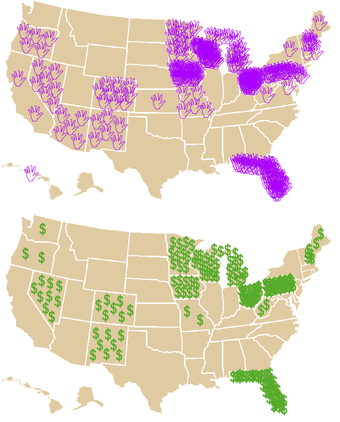
Campaign Attention to Swing States (2004)
These maps show the amount of attention the Bush and Kerry campaigns (considered together) gave to each state during the final five weeks of the 2004 election: At the top, each waving hand represents a visit from a presidential or vice-presidential candidate during the final five weeks of the election. (Candidates’ visits to their own home states are not counted. ) At the bottom, each dollar sign represents one million dollars spent on TV advertising by the campaigns during the same time period. This shows the influence of the Electoral College on the prominence of swing states, those with small populations but large Electoral College votes.
Proponents argue that the Electoral College is an important, distinguishing feature of federalism in the United States and that it protects the rights of smaller states. Many proponents of the Electoral College see its negative effect on third parties as a good thing. They argue that the two party system has provided stability through its ability to change during times of rapid political and cultural change. They believe it protects the most powerful office in the country from control by what these proponents view as regional minorities until they can moderate their views to win national election.
8.4.5: Presidential Candidates
Presidential candidates seek the highest office of the executive branch of government and carry out campaigns in pursuit of election.
Learning Objective
Assess the costs and benefits — to candidates and the public — of the two party system
Key Points
- The U.S. has a two party political system in which most influential presidential candidates have the endorsement of a major political party.
- Presidential candidates in the United States must conduct extensive fundraising efforts to successfully acquire advertising time and campaign staffs.
- The U.S. Constitution places restrictions on who can run for presidential office, including that they must be 35 years old and a natural-born citizen.
Key Terms
- PAC
-
A political action committee, which is any organization in the United States that campaigns for or against political candidates, ballot initiatives, or legislation.
- candidate
-
A person who is running in an election or who is applying to a position for a job.
- election
-
A process of choosing a leader, members of parliament, councillors or other representatives by popular vote.
Example
- Presidential candidates engage in debates over governing strategies and policy positions in an attempt to secure votes in the general election.
Background
In democratic countries, the head of state or the head of the executive branch of government, is often called the president. Presidents are usually elected to office by a democratic election. Elections may depend upon a candidate, or a person who is seeking presidential office, winning the popular vote. Likewise, elections can also depend on the candidate winning a certain proportion of a vote as determined by election guidelines. For example, in the United States, presidential candidates must win a majority of votes as allocated by the electoral college, which depends upon the candidate winning the popular vote in individual states rather than in the nation at large. By contrast, in France a candidate must win over 50% of the popular vote to be elected to office. This means that if there are more than two candidates in the race and they split the popular vote, there is often a runoff election to determine who becomes the president.
U.S. Presidential Candidates
The United States has generally embraced a two party political system, in which two primary candidates seek the office of president. Historically, the two parties have changed many times, but elections have usually involved a conservative and a liberal party — in modern days, the Republican and Democratic parties. There are some notable exceptions in which third party candidates had an impact on elections, such as the candidacy of Theodore Roosevelt in 1912 and Ross Perot in 1992, but by and large candidates must have the backing of a major party in order to be influential. The benefits of party membership include a pre-existing voter base, but perhaps more significantly, access to a fundraising network. The endorsement of a political party ensures that presidential candidates have access to a powerful network of political strategists and wealthy donors.
The importance of financial resources cannot be underestimated when talking about United States presidential candidates. Presidential campaigns cost substantial amounts of money because candidates need print, radio, and television ads, as well as large staffs of campaign organizers, in order to be successful. However, in recent years the role of fundraising has increased, as campaign contributions have grown. Political action committees, commonly known as PACs, are groups of donors and advocates who band together to fund advertisements and events on behalf of candidates. The 2010 Supreme Court decision in the case of Citizens United v. Federal Election Commission further paved the way for large campaign contributions by allowing unlimited contributions to so-called “super PACs,” or political action committees that are not directly connected to candidates. As a result of the decision, there is no limit on the size of allowable campaign contributions. Super PACs generally support a candidate by attaining large contributions for expensive television ads. Since they are not directly tied to candidates, super PACs often produce attack ads, or negative ads against opposing candidates, that the primary parties would not explicitly endorse.
As a result of the cost of presidential campaigns, many U.S. presidential candidates tend to be wealthy. However, there are other restrictions on candidacy that also impact who runs. The U.S. Constitution requires that candidates are natural-born U.S. citizens who are at least 35 years old at the time of election. Unofficially, presidents tend to be educated at elite institutions, and only one U.S. president has practiced a religion other than that of the mainstream protestant faith (John F. Kennedy was Catholic). Some evidence indicates that historical candidacy trends may be changing, though. For example, President Barack Obama was the first non-white U.S. president to be elected. Also, 2012 Republican candidate Mitt Romney is Mormon, which is considered by many to be a fringe protestant denomination. While no women have been elected to the highest office in the U.S., Hillary Clinton’s ran in 2008, and in 2016 was the Democratic Party’s first female nominee, indicating the “glass ceiling” may soon be shattered.
8.4.6: Campaigning: Traditional Media, New Media, and Campaign Advertisements
Campaigns seek to engage the public through traditional forms of media, such as television and the press, and more recently, social media.
Learning Objective
Compare and contrast traditional and contemporary ways in which candidates interact with the media and the public
Key Points
- Presidential campaigns have always worked closely with journalists to present a particular image of the candidate.
- Today, candidates are expected to be fluent in social media. President Barack Obama used social media effectively in the 2008 election to reach out to young voters.
- Campaign television ads are used to reach broad audiences. Ads can either be positive, supporting the views of the particular candidate buying the air time, or negative, deriding the candidate’s opponent.
Key Terms
- campaign advertisements
-
Television ads sponsored by political campaigns to reach broad audiences and convince the masses to vote for the sponsoring candidate.
- social media
-
Interactive forms of media that allow users to interact with and publish to each other, generally by means of the Internet.
Example
- Campaigns seek to actively engage with the media in order to present a particular image of the candidate. In the 2008 campaign, Republican candidate Senator John McCain created a unique space to engage with journalists, inviting them to travel with him on his campaign bus, called “the Straight Talk Express,” in reference to his engagement with journalists
Engaging with the media is an essential part of any presidential campaign. Usually, the candidate’s campaign manager is tasked with engaging with the media. Although people often assume that candidates are elected because of their policy positions, many presidential elections are won and lost based on likability of the candidate. Americans only “get to know” a candidate through the representation of the candidate in the media.
Throughout the history of American elections, journalists have followed candidates as they advertised their positions, gave speeches, and visited American towns. This tradition continues today, with certain journalists being given the sole responsibility of following candidates. In the 2008 campaign, Republican candidate Senator John McCain created a unique space to engage with journalists, inviting them to travel with him throughout the course of his campaign on his campaign bus, called “the Straight Talk Express” in reference to his engagement with journalists.
Campaign journalism has developed with the times. With the advent of television, TV reporters were sent to cover elections. Campaign engagement with the media has changed again with the proliferation of social media. Today, candidates are expected to have Facebook and Twitter accounts and to be fluent in the language of social media. This was particularly clear by then-candidate Senator Barack Obama’s use of social media in the 2008 election. The campaign relied heavily on social media to engage voters, recruit campaign volunteers and raise funds. It brought the spotlight on the importance of using the internet in a new age of political campaigning by utilizing various forms of social media such as Facebook and YouTube to reach targeted audiences. In the 2008 and 2012 elections, Barack Obama supporters could sign up for volunteer shifts and donate funds through apps on their mobile phones. The campaign’s social website, my.BarackObama.com, utilized a low cost and efficient method of mobilizing voters and increasing participation among various voter populations. President Obama’s efforts to reach out through new media are credited with bringing in the support of young Americans and contributing to his 2008 victory . This practice has now become standard; Republican candidate Governor Mitt Romney also released an app in 2012.
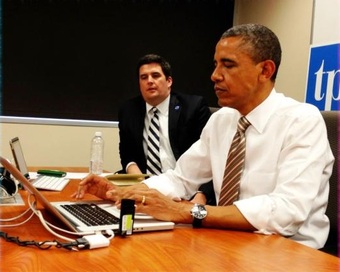
President Obama Tweeting
This image shows President Obama answering tweets, demonstrating his proficiency with social media and appealing to younger voters.
But even with the rise of new media, campaigns continue to spend hundreds of millions of dollars buying air time on television networks to put on campaign advertisements. Television ads have been popular because they are an effective way to reach millions of voters at once. Campaign ads can either be positive, supporting the views of the particular candidate buying the air time, or negative, deriding the candidate’s opponent. Television campaign ads have been accused of being manipulative, but have been incredibly successful in influencing voter perceptions of the candidates.
8.5: How Voters Decide
8.5.1: Party Identification
Party identification is typically determined by the political party that an individual most commonly supports.
Learning Objective
Discuss the central features that make up party identification
Key Points
- Party identification refers to the political party with which an individual identifies.
- In the United States, political parties consist of three parts: the party as government, the party as organization, and the party as electorate.
- Some researchers view party identification as “a form of social identity”, in the same way that a person identifies with a religious or ethnic group. This identity develops early in a person’s life mainly through family and social influences.
- Those who consider themselves to be strong partisans, strong Democrats and strong Republicans respectively, tend to be the most faithful in voting for their party’s nominee for office.
- The same level of voting behavior can also be applied to state and local levels. While straight ticket voting has declined among the general voting population, it is still prevalent in those who are strong Republicans and strong Democrats.
Key Terms
- party identification
-
Party identification refers to the political party with which an individual identifies. Party identification is typically determined by the political party that an individual most commonly supports (by voting or other means).
- partisan
-
An adherent to a party or faction.
Example
- Children remember events that happened during their childhood and associate them with the political party, whether or not they were connected with those events. For example, a child growing up in the 1970s would associate the Republican party with the Watergate scandal of the Nixon administration, a child growing up in the 1990s would associate the Democratic party with the sex scandal of the Clinton administration, or a child growing up in early 2000 would associate the Republican party with the Iraq War and the War on Terror.
Introduction
Party identification refers to the political party with which an individual identifies. Party identification is typically determined by the political party that an individual most commonly supports (by voting or other means). In the United States, political parties consist of three parts: the party as government (members of the party who hold public office), the party as organization (committees, leaders and activists who work to promote the party and the candidates), and the party as electorate (citizens who support the party through party identification).
Citizens in the general population who identify with a particular party make up the Party in the Electorate. Party identifiers (partisans) could be described by their support in the following ways:
- They register as a member of the particular party when registered to vote.
- They show a strong tendency to vote for candidates in their preferred party in most elections.
- When surveyed, they identify themselves as members of that particular party.
- They are inclined to support policies endorsed by the particular party.
- They volunteer for campaigns to support party candidates more than the general population.
- They have a higher voter turnout in primary elections than the general population.
Some researchers view party identification as “a form of social identity”, in the same way that a person identifies with a religious or ethnic group. This identity develops early in a person’s life mainly through family and social influences. This description would make party identification a stable perspective, which develops as a consequence of personal, family, social and environmental factors. Other researchers consider party identification to be more flexible and more of a conscious choice. They see it as a position and a choice based on the continued assessment of the political, economic and social environment. Party identification can increase or even shift by motivating events or conditions in the country.
Characterization
Party Identification is characterized in three ways. Some view party attachment as a form of social identity, which is similar to a religious or ethnic identity. Moreover, childhood influence is one of main driving factors behind formation of party identification. During childhood, the main political influence comes from parents, other close family members and close surroundings such as the immediate community. Children remember events that happened during their childhood and associate them with the political party, whether or not they were connected with those events. For example, a child growing up in the 1970s would associate the Republican party with the Watergate scandal of the Nixon administration, a child growing up in the 1990s would associate the Democratic party with the sex scandal of the Clinton administration, or a child growing up in early 2000 would associate the Republican party with the Iraq War and the War on Terror. Although these parties might or might not embrace the issues that happened during that administration, a child could forever associate the party with those memorable events. Political Scientists have developed many theories to childhood influence on political party identification. David O. Sears developed a theory stating that major childhood events will influence a child at a young age and make a permanent impression.
Voting
Those people who identify with a party tend to vote for their party’s candidate for various offices in high percentages. Those who consider themselves to be strong partisans, strong Democrats and strong Republicans respectively, tend to be the most faithful in voting for their party’s nominee for office. In the case of voting for president, since the 1970s, party identification on voting behavior has been increasing significantly. By the late 1990s, party identification on voting behavior was at the highest level of any election since the 1950s. When voting in congressional elections, the trend is similar. Strong party identifiers voted overwhelmingly for their party’s nominee in the general election. It is important to note that each party respectively in certain elections, would have stronger voting behavior of their strongest party identifiers. For instance, in the years the Democrats dominated House and Senate elections in the 1970s and 1980s, it can be explained that their strong party identifiers were more loyal in voting for their party’s nominee for Congress than the Republicans were.
The same level of voting behavior can also be applied to state and local levels. While straight ticket voting has declined among the general voting population, it is still prevalent in those who are strong Republicans and strong Democrats. According to Paul Allen Beck and colleagues, “the stronger an individual’s party identification was, the more likely he or she was to vote a straight ticket. “
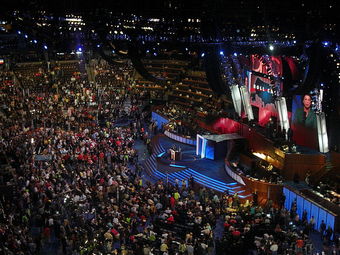
Roll Call DNC
Those people who identify with a party tend to vote for their party’s candidate for various offices in high percentages. Those who consider themselves to be strong partisans, strong Democrats and strong Republicans respectively, tend to be the most faithful in voting for their party’s nominee for office.
8.5.2: Issue Voting
Issue voting is the process by which voters select candidates based on how closely their views on certain issues match the voter’s own.
Learning Objective
Describe issue voting and its relationship to larger trends in the electorate
Key Points
- Issue voting occurs when voters base their decisions on how the candidates address political issues.
- The rise in issue voting can be traced to increased polarization between the Democratic and Republican parties, which has increased numbers of independents.
- Issue voting can be problematic when candidates’ stances on issues do not match the voter’s own and when candidates possess similar views on issues.
Key Terms
- issue voting
-
The type of voting that occurs when voters cast their vote based on political issues.
- party voting
-
The type of voting that describes when voters cast their vote based on their self-identification with a particular political party.
In contrast to party voting, issue voting is when voters base their election decisions on political issues. These issues can relate to any questions of public policy that are a source of debate between political parties. The process of issue voting involves voters comparing their opinions about how certain issues should be addressed against candidates’ stances on these issues. Individuals vote for the candidate that best matches their own views.
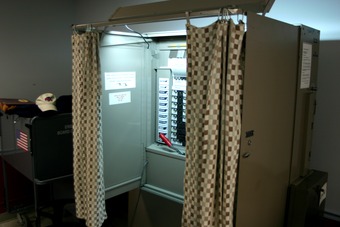
Voting Booth
Issue voting has affected the decisions Americans make at the voting booth.
Issue voting has become prominent in recent elections. The in issue voting rise can be traced to increasing polarization between the Democratic and Republican parties. Moderates, who account for a large segment of the American population, become more alienated as each party adopts more extreme viewpoints. Subsequently, this alienation has led to an increase in the amount of people who identify as independents in order to escape the constraints of a polarized party. The loss of party identification affiliated with being an independent generates the greater issue voting.
While issue voting has risen in recent years, many factors can complicate it. For instance, many stances can be taken on issues and voters must settle for the candidate whose views most closely match their own. This becomes difficult when the available candidates have viewpoints that are vastly different from a voter’s views. Issue voting is also challenging when candidates possess similar views on issues and there is no clear distinction between the candidates’ views and the voter’s own. When the aforementioned situations take place, a voter may revert to party voting or may base their decision off of the individual personalities of the candidates. Similarly, issue salience is when people vote on the basis of how relevant an issue is to their lives.
Most issues that are part of the national agenda can sometimes be a consequence of media agenda-setting and agenda-building. In a commercialized media context, the media can often not afford to ignore an important issue which another television station, newspaper, or radio station is willing to pick up. The media may be able to create new issues by reporting and should that should be considered seriously. Also, they can obscure issues by reporting through negligence and distraction. If persons are affected by high crime rates, or unemployment, for instance, the media can reduce the time they report on potential solutions, the nature of class-based society or other related issues. They can reduce the direct awareness of these problems in the lives of the public. The media can make the problem in essence “go away” by obfuscating it. The public can go away to another media source, so it is in the media’s commercial interest to try to find an agenda which corresponds as closely as possible to peoples’ desires. They may not be entirely successful, but the agenda-setting potential of the media is considerably limited by the competition for the viewers’ interest, readers and listeners. It is difficult to see, for instance, how an issue which is a major story to one television station could be ignored by other television stations.
8.5.3: The Candidates
Due to a decrease in party identification, the personal traits of candidates have become an influential factor in voters’ decisions.
Learning Objective
Describe how and why candidates’ personal characteristics can be relevant to an election campaign
Key Points
- Increasing numbers of independents and problems with issue voting have made the personal traits of candidates an important factor in how voters decide.
- Candidates use their own personal attributes to relate to voters and use the negative personal attributes of their opponents to dissuade voters from supporting them.
- Candidates may use their upbringing, religious affiliations, and family to appeal to voters.
Key Terms
- campaign
-
An organized effort to influence the decision making process within a specific group when seeking election to political office.
- demographic
-
A demographic criterion: a characteristic used to classify people for statistical purposes, such as age, race, or gender.
The personal traits of candidates have become an influential factor in voters’ decisions during recent elections. Although issues currently remain central in many voters’ election decisions, issue voting can be difficult when candidates are closely aligned in their stances on given issues. Issue voting can also be problematic when candidates’ stances differ drastically from those of voters. At the same time, the United States has witnessed increasing polarization between the Democratic and Republican Parties that has caused many voters to identify themselves as independents. This increasing lack of party identification combined with the difficulties that arise with issue voting has resulted in voting decisions based on the personality and demographic traits of candidates.
Candidates are most often evaluated on their party affiliation and stances on prominent issues. However, when the aforementioned problems with party identification and issue voting arise, the personal characteristics of candidates may enter into campaign strategies and voting decisions. Many candidates utilize demographic factors to appeal to voters. For example, candidates may emphasize the importance of their families and their upbringing in humble middle-class households as a way to relate to a wide segment of American voters . Other candidates appeal to voters through shared religious affiliations. Candidates may also emphasize their personality traits by showing how their actions have demonstrated their trustfulness and hard work.
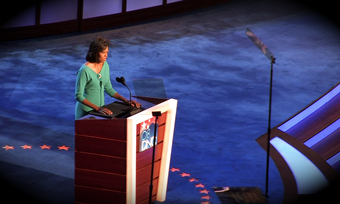
Michelle Obama at the 2012 Democratic National Convention
First Lady, Michelle Obama, appealed to voters by emphasizing the humble background of her husband during her speech at the 2012 Democratic National Convention.
At the same time, candidates also tend to emphasize the demographic and personality traits of their opponents that will create mistrust among voters. For example, candidates often air advertisements that question the honesty of their opponents while emphasizing their own fortitude and work ethic. Candidates may also emphasize the excessive wealth of their opponents as a way to show how they are out of touch with the average middle-class American.
8.6: Recent Elections
8.6.1: The 2008 Presidential Election
The 2008 U.S. presidential election possessed many unique attributes and was won in a historic landslide victory by Democrat Barack Obama.
Learning Objective
Analyze the key components of Obama’s victory in the 2008 presidential election
Key Points
- The 2008 presidential election featured many firsts, including the widespread use of the Internet in campaigning and the first African American elected to the presidency.
- The Obama victory can be attributed to a number of factors, including the Obama campaign’s abilities to both distance itself from the unpopular Bush administration and to emphasize the change and experience it would bring the White House.
- The 2008 presidential election was characterized by high levels of participation, aided by the widespread use of the Internet.
- Obama’s win set the record for the most amount of votes cast for a U.S. presidential candidate.
Key Term
- swing states
-
States in which no single candidate or party has overwhelming support in securing the state’s electoral college votes
The 2008 Presidential Election
The 2008 U.S. presidential election was the 56th quadrennial presidential election. Barack Obama, the junior U.S. senator from Illinois, was nominated as the Democratic candidate while John McCain, the senior U.S. senator from Arizona, was nominated as the Republican candidate. Joe Biden, U.S. senator from Delaware, was later chosen as Obama’s running mate. Meanwhile, Sarah Palin, governor of Alaska, was chosen as McCain’s running mate. Barack Obama won the election by a historic majority vote .
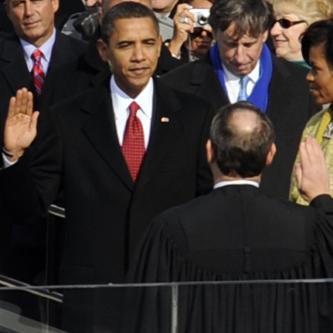
Obama Taking Oath of Office
After winning the 2008 presidential election, Barack Obama was sworn into office on January 20, 2009.
Unique Attributes
The 2008 presidential election was exceptional in many ways. It was the first U.S. presidential election in which an African American was elected president, having also been the first African American to be nominated by a major party. Obama also received the highest number of votes in the history of U.S. presidential elections. In addition, the 2008 presidential election was the first time that both major party candidates were sitting U.S. senators. The election was also characterized by high levels of public interest and engagement. Social media sites joined traditional forms of campaign activity to generate increased election interest.
Stances and Campaign Strategy
Obama’s overwhelming presidential win can be attributed to many factors. His strong opposition to the war in Iraq was a view embraced by many Americans. Meanwhile, McCain supported the war; his statement that the U.S. could be in Iraq for the next 50 to 100 years proved costly, even though it was intended as a peacetime presence. Obama was more successful than McCain in separating himself from the unpopular George W. Bush administration. The downturn in the economy provided an additional boost to the Obama campaign after McCain made comments that portrayed him as out of touch with the average American and the economic plight of the nation. The use of social media websites was another factor better handled by the Obama campaign, and one that appealed to many young voters.
In general, the Obama campaign was much more adept at emphasizing the change and experience Obama would bring to the presidency, and distancing itself from the Bush administration, than was the McCain campaign. The Obama campaign also emphasized the experience Hillary Clinton would carry as Secretary of State. Meanwhile the McCain campaign introduced Sarah Palin as the vice presidential candidate hoping to balance McCain’s more extensive experience with the potential of a relatively unknown politician. However, Palin was often painted by the media as lacking knowledge on key issues. Although Palin appealed to the conservative base of the GOP, there remained the fear that her conservative views would alienate moderates and independents.
Electoral Vote
The 2008 U.S. presidential election took place on November 4, 2008. While John McCain won the majority vote in traditionally Republican states and in his home state of Arizona, Barack Obama’s wins in his home state of Illinois, the Northeast, and the swing states of Ohio and Pennsylvania precluded a McCain victory. Obama also won some of the southern states and the contested states of Iowa and New Mexico. The projected electoral vote count came to 365 for Obama and 173 for McCain.
8.6.2: The 2010 Elections
The 2010 midterm elections, for national, state, and local governments, resulted in an overwhelming victory for the Republican Party.
Learning Objective
Explain the political forces that contributed to the Republicans success in the 2010 elections
Key Points
- During the 2010 midterm elections 435 seats in the U.S. House of Representatives, 37 of the 100 seats in the U.S. Senate, 38 State and territorial governorships, 46 state legislatures, 4 territorial legislatures, and numerous state and local government positions were filled.
- In spite of the large number of government seats to be filled, voter turnout was much lower than it had been during the 2008 presidential election.
- The Republican Party gained several government seats and recaptured a majority in the Congress that led to a divided government.
- Factors contributing to the Republican victories included a continuing high unemployment rate, Congressional scandals, dissatisfaction with the Patient Protection and Affordable Care Act, the mobilizing ability of the Tea Party movement,, and heightened debate over immigration regulation.
Key Terms
- midterm election
-
a type of staggered election where the members take office at the middle of the term of another set of members, or of the executive
- Congress
-
The two legislative bodies of the United States: the House of Representatives, and the Senate.
- senate
-
The United States Senate, “the Senate”.
- house of representatives
-
The name of the lower house in the bicameral legislatures of several countries, also used of some singular legislative bodies in unicameral systems.
The 2010 midterm elections on November 2, 2010 filled 435 seats in the U.S. House of Representatives and 37 of the 100 seats in the U.S. Senate. In addition, 38 state and territorial governorships, 46 state legislatures, and 4 territorial legislatures were filled. Numerous state and local races also took place during this time.
Voter turnout dropped steeply from the previous 2008 presidential election in spite of the large number of political positions to be filled. Approximately 82.5 million people voted, about one-third fewer than those who voted in 2008. However, voter turnout was still slightly higher than the last midterm elections in 2006 and more states gained than lost voters.
The Democratic Party suffered massive defeats in most national and state elections, with many seats switching over to Republican Party control. Indeed, the Republicans gained 63 seats in the U.S. House of Representatives to recapture the majority and expanded its minority in the U.S. Senate by gaining 6 seats. This caused a divided government with Democrat President Obama in office and a Republican majority in the Congress. The Republican Party additionally broke the previous majority record of 628 seats in the state legislatures, set by the Democrats in the post-Watergate elections of 1974, by gaining 680 seats in the state legislative races. The Republicans also gained control of 29 of the 50 state governorships.
The Republican victories during the 2010 midterm elections can be attributed to a number of factors. First, unemployment was over 9% during the elections and had not declined significantly since Obama had entered the White House. Secondly, public trust in Congress had diminished with a series of scandals in which Democratic Representatives Charlie Rangel and Maxine Waters, along with Republican Senator John Ensign, were accused of unethical and/or illegal conduct prior to the midterm elections. Furthermore, passage of the Patient Protection and Affordable Care Act led to low approval ratings of Congress. Indeed, many Republicans ran on a promise to repeal the act and beat incumbent Democrats who had voted for it. A fourth factor that contributed to the Republican victories was the mobilizing ability of the Tea Party movement in favor of Republican candidates . Meanwhile, the controversial Arizona Senate Bill 1070 ignited a national debate over immigration that led many in support of stronger immigration regulations to vote for the Republican Party.
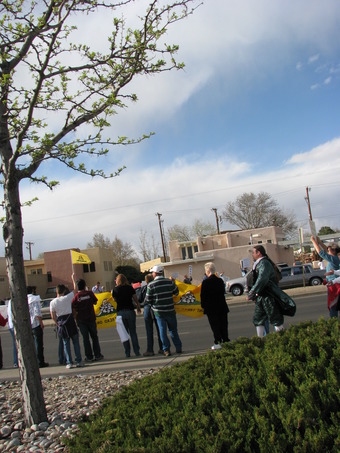
Tea Party Gathering
The Tea Party movement’s ability to mobilize voters in favor of the Republican Party was one of the factors that contributed to many Republican victories during the 2010 elections.
8.6.3: The 2012 Presidential Election
Barack Hussein Obama was re-elected President of the United States on November 6th, 2012, serving a second term as the nation’s first black president.
Learning Objective
Describe the key issues and the electoral landscape that led to Obama’s reelection
Key Points
- The 2012 U.S. presidential election was between Democratic candidate President Barack Obama and Republican candidate Governor Mitt Romney of Massachusetts. Requiring 270 electoral votes to win the election, Obama received 303 electoral votes, while Romney earned 206.
- The major policy issues at stake in the 2012 election included: the Patient Protection and Affordable Care Act and health care reform; the ongoing economic crisis; tax reform; women’s rights; and American foreign policy.
- Changes to the Electoral College apportionment of votes affected the the 2012 presidential election, likely in favor of the Republican party.
- In his second term, President Obama faced a divided political climate, negotiating between a Democratic Senate and a Republican House, often resulting in stalemate in the Congress.
Key Terms
- Mitt Romney
-
Willard Mitt Romney (born March 12, 1947) is an American businessman and was the Republican Party’s nominee for President of the United States in the 2012 election. From 2003 to 2007, he served as the 70th Governor of Massachusetts.
- electoral college
-
A body of electors empowered to elect someone to a particular office
- incumbent
-
Being the current holder of an office or a title.
- Barack Obama
-
Barack Hussein Obama II (born August 4, 1961) is the 44th and current President of the United States. On November 6th, 2012, he was re-elected for a second term.
Barack Hussein Obama was re-elected President of the United States on Tuesday, November 6th, 2012. He served a second term as the nation’s first black president.
The 2012 presidential election was the 57th quadrennial election in the United States. The Democratic Party Candidate, President Barack Obama, sought re-election for his second and final term as president. Massachusetts Governor Mitt Romney ran as the Republican candidate.
Requiring 270 electoral votes to win the election, Obama received 303 electoral votes, while Romney earned 206. His victory was much narrower than his electoral victory in the 2008 Presidential Election against Senator John McCain. Obama carried Colorado, Iowa, Ohio, New Hampshire, Virginia, and Wisconsin, many of the often decisive battleground states in presidential elections. Obama also carried a small advantage in Florida.
In his second term, President Obama will continue to face a divided political climate, with a Democratic Senate and a Republican House, often leading to stalemate in the Congress. Obama tackled many of the large issues he campaigned about before the 2008 Presidential Election, including immigration reform. The economic crisis, the growing deficit, and America’s longest undeclared war were the biggest obstacles to Obama’s re-election. Days prior to the 2012 Presidential Election, Hurricane Sandy hit the East Coast, devastating many states in the Mid-Atlantic and New England regions.
Mitt Romney was highly criticized during his campaign due to his personal wealth. While he lost the popular vote by a slight margin, a much greater margin in the electoral college necessitated his loss.
The two other presidential candidates included Green Party nominee Jill Stein and Libertarian Party nominee, New Mexico Governor Gary Johnson. While unlikely, both possessed the ballot access to mathematically win the majority of the Electoral College and, accordingly, the election.
The major policy issues at stake in the 2012 election were: the Patient Protection and Affordable Care Act and health care reform; the ongoing economic crisis; tax reform; women’s rights; and American foreign policy.
Nominations
The Democratic nomination was uncontested with the incumbent, President Barack Obama, running for reelection . The Republican primaries were more complex, with many different candidates winning different contests. Romney won New Hampshire, Senator Rick Santorum of Pennsylvania won in Iowa, and former Speaker of the U.S. House of Representatives, Newt Gingrich, won South Carolina by a surprising margin. Santorum suspended his campaign in April, leaving Romney as the frontrunner for the Republican nomination. Romney was officially declared as the Republican Party’s nominee at the Republican National Convention on August 30, 2012 .
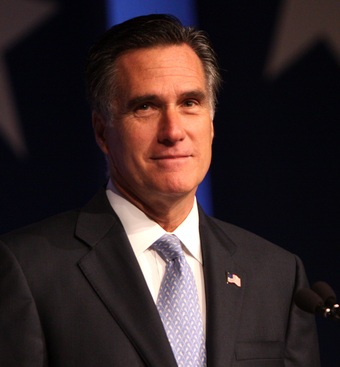
Mitt Romney
Governor Mitt Romney of Massachusetts was the Republican candidate for the 2012 presidential election.
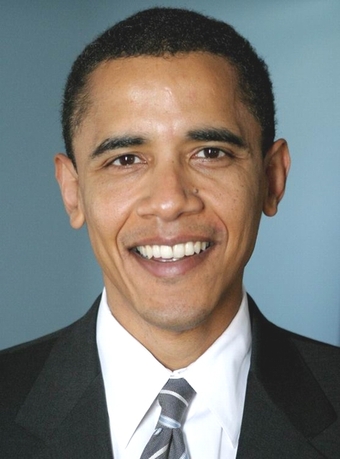
Barack Obama
Incumbent President Barack Obama was the Democratic candidate for the 2012 presidential election. On November 6th, 2012, Obama was re-elected President for a second term.
Electoral College Changes and Controversies
Population changes indicated by the 2010 U.S. Census changed the apportionment of votes in the Electoral College, potentially changing the allocation of votes among swing states. Arizona, Florida, Georgia, Nevada, South Carolina, Texas, Utah, and Washington gained votes. Conversely, Illinois, Iowa, Louisiana, Massachusetts, Michigan, Missouri, New Jersey, New York, Ohio, and Pennsylvania lost votes. The change in electoral allotment shifts the allocation of votes across the Democratic-Republican divide, as pundits predicted that the Democratic Party would lose electoral votes in states previously won in the past three presidential elections, and the Republican Party would gain votes in states won by Republican candidates in the last three elections.
Some states enacted new electoral laws in 2011. For example, Florida and Iowa banned felons from voting, and various states shortened their voting periods, eliminating the option of early voting. These measures were criticized as strategies to impede voter blocs, including college students, African Americans, and Latino Americas.
8.7: The Role of Money in Campaigns and Elections
8.7.1: Regulating Campaign Finance
Campaign finance in the United States is the financing of electoral campaigns at the federal, state, and local levels.
Learning Objective
Assess the origins, scope, and impact of money spent on election campaigns
Key Points
- At the federal level, campaign finance law is enacted by Congress and enforced by the Federal Election Commission (FEC), an independent federal agency.
- Races for non-federal offices are governed by state and local law. Over half the states allow some level of corporate and union contributions.
- At the federal level, public funding is limited to subsidies for presidential campaigns. To receive subsidies in the primary, candidates must qualify by privately raising $5000 each in at least 20 states.
- In addition to primary matching funds, the public funding program also assists with financing the major parties’ presidential nominating conventions and funding the major party nominees’ general election campaigns.
- In 1971, Congress passed the Federal Election Campaign Act (FECA), instituting various campaign finance disclosure requirements for federal candidates.
Key Terms
- public funding
-
At the federal level, public funding is limited to subsidies for presidential campaigns. This includes (1) a “matching” program for the first $250 of each individual contribution during the primary campaign, (2) financing the major parties’ national nominating conventions, and (3) funding the major party nominees’ general election campaigns.
- federal election commission
-
The Federal Election Commission (FEC) is an independent regulatory agency that was founded in 1975 by the United States Congress to regulate the campaign finance legislation in the United States.
Example
- In 2008—the last presidential election year—candidates for office, political parties, and independent groups spent a total of $5.3 billion on federal elections. The amount spent on the presidential race alone was $2.4 billion, and over $1 billion of that was spent by the campaigns of the two major candidates: Barack Obama spent $730 million in his election campaign, and John McCain spent $333 million.
Introduction
Campaign finance in the United States is the financing of electoral campaigns at the federal, state, and local levels. At the federal level, campaign finance law is enacted by Congress and enforced by the Federal Election Commission (FEC), an independent federal agency. Although most campaign spending is privately financed, public financing is available for qualifying candidates for President of the United States during both the primaries and the general election. Eligibility requirements must be fulfilled to qualify for a government subsidy, and those that do accept government funding are usually subject to spending limits.

Federal Elections Commission
Seal of the United States Federal Election Commission.
Races for non-federal offices are governed by state and local law. Over half the states allow some level of corporate and union contributions. Some states have limits on contributions from individuals that are lower than the national limits, while four states (Missouri, Oregon, Utah and Virginia) have no limits at all.
Campaign Finance Numbers
In 2008—the last presidential election year—candidates for office, political parties, and independent groups spent a total of $5.3 billion on federal elections. The amount spent on the presidential race alone was $2.4 billion, and over $1 billion of that was spent by the campaigns of the two major candidates: Barack Obama spent $730 million in his election campaign, and John McCain spent $333 million. In the 2010 midterm election cycle, candidates for office, political parties, and independent groups spent a total of $3.6 billion on federal elections. The average winner of a seat in the House of Representatives spent $1.4 million on his or her campaign. The average winner of a Senate seat spent $9.8 million.
Public financing of campaigns
At the federal level, public funding is limited to subsidies for presidential campaigns. This includes (1) a “matching” program for the first $250 of each individual contribution during the primary campaign, (2) financing the major parties’ national nominating conventions, and (3) funding the major party nominees’ general election campaigns.
To receive subsidies in the primary, candidates must qualify by privately raising $5000 each in at least 20 states. During the primaries, in exchange for agreeing to limit his or her spending according to a statutory formula, eligible candidates receive matching payments for the first $250 of each individual contribution (up to half of the spending limit). By refusing matching funds, candidates are free to spend as much money as they can raise privately.
From the inception of this program in 1976 through 1992, almost all candidates who could qualify accepted matching funds in the primary. In 1996 Republican Steve Forbes opted out of the program. In 2000, Forbes and George W. Bush opted out. In 2004 Bush and Democrats John Kerry and Howard Dean chose not to take matching funds in the primary. In 2008, Democrats Hillary Clinton and Barack Obama, and Republicans John McCain, Rudy Giuliani, Mitt Romney and Ron Paul decided not to take primary matching funds. Republican Tom Tancredo and Democrats Chris Dodd, Joe Biden and John Edwards elected to take public financing.
In addition to primary matching funds, the public funding program also assists with financing the major parties’ (and eligible minor parties’) presidential nominating conventions and funding the major party (and eligible minor party) nominees’ general election campaigns. The grants for the major parties’ conventions and general election nominees are adjusted each Presidential election year to account for increases in the cost of living. In 2012, each major party is entitled to $18.2 million in public funds for their conventions, and the parties’ general election nominees are eligible to receive $91.2 million in public funds. If candidates accept public funds, they agree not to raise or spend private funds or to spend more than $50,000 of their personal resources.
8.7.2: Sources of Campaign Funding
Different sources of campaign funding help party candidates to raise funds through multiple avenues.
Learning Objective
Identify the varied sources and roles of money in campaigns and politics
Key Points
- Corporations and unions are barred from donating money directly to candidates or national party committees.
- Lobbying in the United States describes paid activity in which special interests hire well-connected professional advocates, often lawyers, to argue for specific legislation in decision-making bodies such as the United States Congress.
- Federal law allows for multiple types of Political Action Committees, including connected PACs, nonconnected PACs, leadership PACs, Super PACs.
- A 527 organization is a type of American tax-exempt organization named after “Section 527” of the U.S. Internal Revenue Code.
- Political party committees may contribute funds directly to candidates, subject to the specified contribution limits.
- Different sources of campaign funding help party candidates to raise funds through multiple avenues. Campaign finance in the United States is the financing of electoral campaigns at the federal, state, and local levels.
Key Terms
- 527 organization
-
A 527 organization is a type of American tax-exempt organization named after “Section 527” of the U.S. Internal Revenue Code. Technically, almost all political committees, including state, local, and federal candidate committees, traditional political action committees, “Super PACs”, and political parties are “527s. “
- lobbying
-
Lobbying (also lobby) is the act of attempting to influence decisions made by officials in the government, most often legislators or members of regulatory agencies.
- bundlers
-
Bundlers are people who can gather contributions from many individuals in an organization or community and present the sum to the campaign. Campaigns often recognize these bundlers with honorary titles and, in some cases, exclusive events featuring the candidate.
Sources of Campaign Funding
Different sources of campaign funding enable party candidates raise funds through multiple avenues. Campaign finance in the United States is the financing of electoral campaigns at the federal, state, and local levels. At the federal level, campaign finance law is enacted by Congress and enforced by the Federal Election Commission (FEC), an independent federal agency. Although most campaign spending is privately financed, public financing is also available for qualifying candidates for President of the United States during both the primaries and the general election. Eligibility requirements must be met to qualify for a government subsidy, and those that accept government funding are usually subject to spending limits. Federal law restricts how much individuals and organizations may contribute to political campaigns, political parties, and other FEC-regulated organizations.
Corporations and unions are barred from donating money directly to candidates or national party committees. One consequence of the limitation upon personal contributions from any one individual is that campaigns seek out “bundlers”—people who can gather contributions from many individuals in an organization or community and present the sum to the campaign. Campaigns often recognize these bundlers with honorary titles and, in some cases, exclusive events featuring the candidate. Although bundling had existed in various forms since the enactment of the FECA, it became more structured and organized in the 2000s, spearheaded by the “Bush Pioneers” for George W. Bush’s 2000 and 2004 presidential campaigns. During the 2008 campaign, the six leading primary candidates (three Democratic, three Republican) had listed a total of nearly two thousand bundlers.
Lobbying and Special Interests
Lobbying in the United States describes paid activity in which special interests hire well-connected professional advocates, often lawyers, to argue for specific legislation in decision-making bodies such as the United States Congress . It is a highly controversial phenomenon, often seen in a negative light by journalists and the American public, and frequently misunderstood. While lobbying is subject to extensive and often complex rules which, if not followed, can lead to penalties including jail, the activity of lobbying has been interpreted by court rulings as free speech and protected by the Constitution.
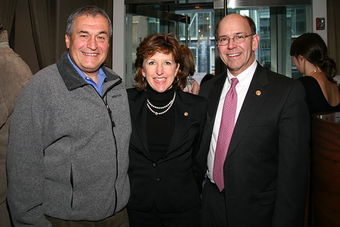
Tony Podesta, Senator Kay and Chip Hagan
Lobbying depends on cultivating personal relationships over many years. Photo: Lobbyist Tony Podesta (left) with Senator Kay Hagan (center) and her husband.
Spending by Outside Organizations
Federal law allows for multiple types of Political Action Committees, including connected PACs, nonconnected PACs, leadership PACs and Super PACs. 501(c)(4) organizations are defined by the IRS as “social welfare” organizations. Unlike 501(c)(3) charitable organizations, they may also participate in political campaigns and elections, as long as the organization’s “primary purpose” is the promotion of social welfare and not political advocacy. A 527 organization is a type of American tax-exempt organization named after “Section 527” of the U.S. Internal Revenue Code. Technically, almost all political committees, including state, local, and federal candidate committees, traditional political action committees, “Super PACs”, and political parties are “527s. ” However, in common practice the term is usually applied only to such organizations that are not regulated under state or federal campaign finance laws because they do not “expressly advocate” for the election or defeat of a candidate or party.
Political party committees may contribute funds directly to candidates, subject to the specified contribution limits. National and state party committees may make additional “coordinated expenditures,” subject to limits, to help their nominees in general elections. National party committees may also make unlimited “independent expenditures” to support or oppose federal candidates. However, since 2002, national parties have been prohibited from accepting any funds outside the limits established for elections in the FECA.
8.7.3: PACs and Campaigns
A political action committee is any organization that campaigns for or against political candidates, ballot initiatives or legislation.
Learning Objective
Analyze the role of PACs in federal elections
Key Points
- At the federal level, an organization becomes a PAC when it receives or spends more than $1,000 for the purpose of influencing a federal election, according to the Federal Election Campaign Act.
- Individuals are limited to contributing $5,000 per year to Federal PACs; corporations and unions may not contribute directly to federal PACs, but can pay for the administrative costs.
- Federal law allows for two types of PACs, connected and non-connected. Most of the 4,600 active, registered PACs are “connected PACs” established by businesses, labor unions, trade groups, or health organizations. By contrast, “non-connected PACs” have an ideological mission.
- Super PACs may not make contributions to candidate campaigns or parties, but may engage in unlimited political spending independently of the campaigns. Unlike traditional PACs, they can raise funds from corporations, unions and other groups, and from individuals, without legal limits.
- In 2010, the United States Supreme Court held in “Citizens United v. Federal Election Commission” that it is legal for corporations and unions to spend from their general treasuries to finance independent expenditures.
Key Terms
- citizens united
-
In 2010, the United States Supreme Court held in Citizens United v. Federal Election Commission that laws prohibiting corporate and union political expenditures were unconstitutional. Citizens United made it legal for corporations and unions to finance independent expenditures with money from their general treasuries. It did not alter the prohibition on direct corporate or union contributions to federal campaigns—those are still prohibited.
- super pacs
-
Super PACs, officially known as “independent-expenditure only committees,” may not make contributions to candidate campaigns or parties, but may engage in unlimited political spending independently of the campaigns. Also unlike traditional PACs, they can raise funds from corporations, unions and other groups, and individuals—without legal limits.
- political action committee
-
A political action committee (PAC) is any organization in the United States that campaigns for or against political candidates, ballot initiatives, or legislation.
Example
- According to data from the Center for Responsive Politics, the top 100 individual super PAC donors in 2011–2012 made up just 3.7% of contributors, but accounted for more than 80% of the total money raised, while less than 0.5% of the money given to “the most active Super PACs” was donated by publicly traded corporations.
Introduction
A political action committee (PAC) is any organization in the United States that campaigns for or against political candidates, ballot initiatives or legislation. At the federal level, an organization becomes a PAC when it receives or spends more than $1,000 for the purpose of influencing a federal election, according to the Federal Election Campaign Act. At the state level, an organization becomes a PAC according to the state’s election laws.
In 2010, the United States Supreme Court held in Citizens United v. Federal Election Commission that laws prohibiting corporate and union political expenditures were unconstitutional. Citizens United made it legal for corporations and unions to spend from their general treasuries to finance independent expenditures, but did not alter the prohibition on direct corporate or union contributions to federal campaigns; those are still prohibited.
History of PACs in the United States
In 1947, as part of the Taft-Hartley Act, the U.S. Congress prohibited labor unions or corporations from spending money to influence federal elections, and prohibited labor unions from contributing to candidate campaigns. Labor unions moved to work around these limitations by establishing political action committees, to which members could contribute. In 1971, Congress passed the Federal Election Campaign Act (FECA). In 1974, Amendments to FECA defined how a PAC could operate and established the Federal Election Commission (FEC) to enforce the nation’s campaign finance laws. The FECA and the FEC’s rules provide for the following: Individuals are limited to contributing $5,000 per year to Federal PACs; corporations and unions may not contribute directly to federal PACs, but can pay for the administrative costs of a PAC affiliated with the specific corporation or union; Corporate-affiliated PACs may only solicit contributions from executives, shareholders, and their families.
Categorization of PACs
Federal law allows for two types of PACs, connected and non-connected. Most of the 4,600 active, registered PACs are “connected PACs” established by businesses, labor unions, trade groups, or health organizations. These PACs receive and raise money from a “restricted class,” generally consisting of managers and shareholders in the case of a corporation and members in the case of a union or other interest group. Groups with an ideological mission, single-issue groups, and members of Congress and other political leaders may form “non-connected PACs. ” These organizations may accept funds from any individual, connected PAC, or organization.
Super PACs, officially known as “independent-expenditure only committees,” may not make contributions to candidate campaigns or parties, but may engage in unlimited political spending independently of the campaigns. Also unlike traditional PACs, they can raise funds from corporations, unions and other groups, and from individuals, without legal limits. Super PACs may support particular candidacies. In the 2012 presidential election, super PACs have played a major role, spending more than the candidates’ election campaigns in the Republican primaries. As of early April 2012, Restore Our Future—a Super PAC usually described as having been created to help Mitt Romney’s presidential campaign—has spent $40 million . In the 2012 election campaign, most of the money given to super PACs has come not from corporations but from wealthy individuals. According to data from the Center for Responsive Politics, the top 100 individual super PAC donors in 2011–2012 made up just 3.7% of contributors, but accounted for more than 80% of the total money raised, while less than 0.5% of the money given to “the most active Super PACs” was donated by publicly traded corporations.
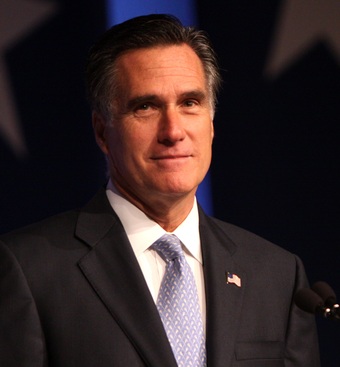
Mitt Romney
Governor Mitt Romney of Massachusetts was the Republican candidate for the 2012 presidential election.
PAC Backlash
It was generally agreed in the 2012 campaign that the formation of a super PAC and the acceptance of large contributions was legal. However, a lingering question was whether super PACs are legal when examined on the basis of how they act. Two agreed-upon illegal actions were that a super PAC could not accept foreign funds and could not coordinate directly with a candidate. Super PACs were seen in the press as a possible means of allowing illegal donations from foreign entities – either individuals or companies – to be disguised. The concept of actions being illegal, when coordinated with a candidate, came out, in part, after a super PAC named American Crossroads requested permission to communicate to their favored candidate on an above-board basis.
International Comparison and Response
The leading democracies have different systems of campaign finance, and several have no institutions analogous to American PACs, in that there are no private contributions of large sums of money to individual candidates. This is true, for example in Germany, in France, and in Britain. In these countries, concerns about the influence of campaign contributions on political decisions are less prominent in public discussion.
8.7.4: Citizens United v. Federal Election Commission
The Citizens United case held that it was unconstitutional to ban campaign financial contributions by corporations, associations and unions.
Learning Objective
Analyze the significance of the Supreme Court’s decision in Citizens United v. Federal Election Commission for campaign finance reform
Key Points
- Citizens United v. Federal Election Commission was a landmark United States Supreme Court case in 2010 in which the court held that the First Amendment prohibited the government from restricting independent political expenditures by corporations and unions.
- The nonprofit group Citizens United wanted to air a film critical of Hillary Clinton and to advertise the film during television broadcasts in apparent violation of the 2002 Bipartisan Campaign Reform Act. In a 5 to 4 decision, the court held that portions of BCRA violated the First Amendment.
- The Supreme Court held that it was unconstitutional to ban free speech through the limitation of independent communications by corporations, associations, and unions. This ruling was frequently interpreted as permitting corporate corporations and unions to donate to political campaigns.
- Citizens United has often been credited for the creation of “super PACs,” political action committees which make no contributions to candidates or parties and so can accept unlimited contributions from individuals, corporations, and unions.
Key Terms
- Citizens United v. Federal Election Commission
-
Citizens United v. Federal Election Commission was a landmark United States Supreme Court case in 2010 in which the court held that the First Amendment prohibited the government from restricting independent political expenditures by corporations and unions.
- super pacs
-
Political action committees, which make no contributions to candidates or parties, and so can accept unlimited contributions from individuals, corporations, and unions.
Example
- In the 2012 presidential election, super PACs have played a major role, spending more than the candidates’ election campaigns in the Republican primaries. As of early April 2012, Restore Our Future—a Super PAC usually described as having been created to help Mitt Romney’s presidential campaign—has spent $40 million.
Introduction
Citizens United v. Federal Election Commission was a landmark United States Supreme Court case in 2010 in which the court held that the First Amendment prohibited the government from restricting independent political expenditures by corporations and unions. The nonprofit group Citizens United wanted to air a film critical of Hillary Clinton and to advertise the film during television broadcasts in apparent violation of the 2002 Bipartisan Campaign Reform Act. In a 5 to 4 decision, the court held that portions of BCRA violated the First Amendment.
Background
The Bipartisan Campaign Reform Act of 2002 prohibited corporations and unions from using their general treasury to fund “electioneering communications” within 30 days before a primary or 60 days before a general election. During the 2004 presidential campaign, a conservative nonprofit organization named Citizens United filed a complaint before the Federal Election Commission (FEC) charging that advertisements for Michael Moore’s film, Fahrenheit 9/11, a documentary critical of the Bush administration’s response to the terrorist attacks on September 11, 2001, constituted political advertising and thus could not be aired within the 30 days before a primary election or 60 days before a general election. The FEC dismissed the complaint after finding no evidence that broadcast advertisements for the movie and featuring a candidate within the proscribed time limits had actually been made.
In the wake of these decisions, Citizens United sought to establish itself as a bona fide commercial filmmaker, producing several documentary films between 2005 and 2007. By early 2008, it sought to run television commercials to promote its latest political documentary, Hillary: The Movie, and to air the movie on DirecTV. The movie was highly critical of then-Senator Hillary Clinton, with the District Court describing the movie as an elongated version of a negative 30-second television spot. In January 2008, the United States District Court for the District of Columbia ruled that the television advertisements for Hillary: The Movie violated the BCRA restrictions of “electioneering communications” within 30 days of a primary. Though the political action committee claimed that the film was fact-based and nonpartisan, the lower court found that the film had no purpose other than to discredit Clinton’s candidacy for president. The Supreme Court docketed the case on August 18, 2008 and heard oral argument on March 24, 2009.
Opinions of the Court
The Supreme Court held in Citizens United that it was unconstitutional to ban free speech through the limitation of independent communications by corporations, associations and unions. This ruling was frequently interpreted as permitting corporate corporations and unions to donate to political campaigns, or else removing limits on how much a donor can contribute to a campaign. Justice Kennedy’s majority opinion found that the BCRA prohibition of all independent expenditures by corporations and unions violated the First Amendment’s protection of free speech.
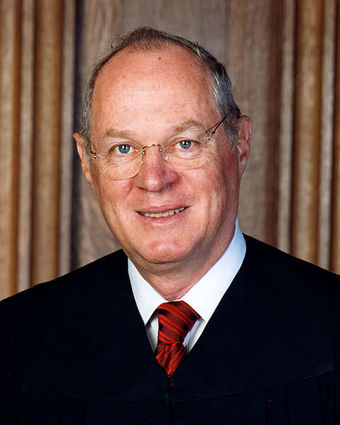
Justice Anthony Kennedy
Anthony Kennedy’s majority opinion found that the BCRA prohibition of all independent expenditures by corporations and unions violated the First Amendment’s protection of free speech.
A dissenting opinion by Justice Stevens was joined by Justice Ginsburg, Justice Breyer, and Justice Sotomayor. Stevens concurred in the court’s decision to sustain BCRA’s disclosure provisions, but dissented from the principal holding of the majority opinion. The dissent argued that the court’s ruling “threatens to undermine the integrity of elected institutions across the Nation. The path it has taken to reach its outcome will, I fear, do damage to this institution. ” He wrote: “A democracy cannot function effectively when its constituent members believe laws are being bought and sold. “
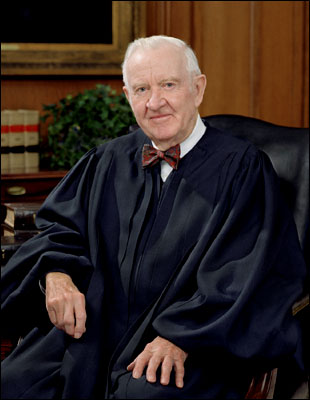
Justice John Paul Stevens
John Paul Stevens wrote a dissenting opinion, arguing that the Court’s ruling “threatens to undermine the integrity of elected institutions across the Nation. “
Impact
On January 27, 2010, President Barack Obama condemned the decision during the 2010 State of the Union Address, stating that, “Last week, the Supreme Court reversed a century of law to open the floodgates for special interests — including foreign corporations — to spend without limit in our elections. ” Moreover, The New York Times stated in an editorial, “The Supreme Court has handed lobbyists a new weapon. A lobbyist can now tell any elected official: if you vote wrong, my company, labor union or interest group will spend unlimited sums explicitly advertising against your re-election. ” The New York Times reported that 24 states with laws prohibiting or limiting independent expenditures by unions and corporations would have to change their campaign finance laws because of the ruling.
Citizens United v. Federal Election Commission has often been credited for the creation of “super PACs”, political action committees which make no contributions to candidates or parties and so can accept unlimited contributions from individuals, corporations, and unions. In the 2012 presidential election, super PACs have played a major role, spending more than the candidates’ election campaigns in the Republican primaries. As of early April 2012, Restore Our Future—a Super PAC usually described as having been created to help Mitt Romney’s presidential campaign—has spent $40 million.
8.7.5: Campaign Finance Reform
In the U.S., campaign finance reform is the common term for the political effort to change the involvement of money in political campaigns.
Learning Objective
Identify major legislative and judicial milestones in campaign finance reform in the United States
Key Points
- The Federal Election Campaign Act (FECA) of 1972 required candidates to disclose sources of campaign contributions and campaign expenditures. It was amended in 1974 with the introduction of statutory limits on contributions, and creation of the Federal Election Commission (FEC).
- The Bipartisan Campaign Reform Act (BCRA) of 2002, is the most recent major federal law on campaign finance, which revised some of the legal limits on expenditures set in 1974, and prohibited unregulated contributions to national political parties.
- The voting with dollars plan would establish a system of modified public financing coupled with an anonymous campaign contribution process. It has two parts: patriot dollars and the secret donation booth.
- Another method allows the candidates to raise funds from private donors, but provides matching funds for the first chunk of donations. This would effectively make small donations more valuable to a campaign, potentially leading them to put more effort into pursuing such donations.
- Another method, which supporters call clean money, clean elections, gives each candidate who chooses to participate a certain, set amount of money. In order to qualify for this money, the candidates must collect a specified number of signatures and small (usually $5) contributions.
Key Term
- federal election campaign act
-
The Federal Election Campaign Act of 1971 is a United States federal law which increased disclosure of contributions for federal campaigns. It was amended in 1974 to place legal limits on the campaign contributions.
Introduction
Campaign finance reform is the common term for the political effort in the United States to change the involvement of money in politics, primarily in political campaigns. Although attempts to regulate campaign finance by legislation date back to 1867, the first successful attempts nationally to regulate and enforce campaign finance originated in the 1970s. The Federal Election Campaign Act (FECA) of 1972 required candidates to disclose sources of campaign contributions and campaign expenditures. It was amended in 1974 with the introduction of statutory limits on contributions, and creation of the Federal Election Commission (FEC). It attempted to restrict the influence of wealthy individuals by limiting individual donations to $1,000 and donations by political action committees (PACs) to $5,000. These specific election donations are known as ‘hard money. ‘ The Bipartisan Campaign Reform Act (BCRA) of 2002, is the most recent major federal law on campaign finance, which revised some of the legal limits on expenditures set in 1974, and prohibited unregulated contributions to national political parties.
Federal Election Campaign Act
In 1971, Congress passed the Federal Election Campaign Act, requiring broad disclosure of campaign finance. In 1974, fueled by public reaction to the Watergate Scandal, Congress passed amendments to the Act establishing a comprehensive system of regulation and enforcement, including public financing of presidential campaigns and creation of a central enforcement agency, the Federal Election Commission. Other provisions included limits on contributions to campaigns and expenditures by campaigns, individuals, corporations and other political groups. However, in 1976 Buckley v. Valeo challenged restrictions in FECA as unconstitutional violations of free speech. The court struck down, as infringement on free speech, limits on candidate expenditures and certain other limits on spending.
Bipartisan Campaign Reform Act of 2002
The Congress passed the Bipartisan Campaign Reform Act (BCRA), also called the McCain-Feingold bill after its chief sponsors, John McCain and Russ Feingold . The BCRA was a mixed bag for those who wanted to remove big money from politics. It eliminated all soft money donations to the national party committees, but it also doubled the contribution limit of hard money, from $1,000 to $2,000 per election cycle, with a built-in increase for inflation. In addition, the bill aimed to curtail ads by non-party organizations by banning the use of corporate or union money to pay for “electioneering communications,” a term defined as broadcast advertising that identifies a federal candidate within 30 days of a primary or nominating convention, or 60 days of a general election.
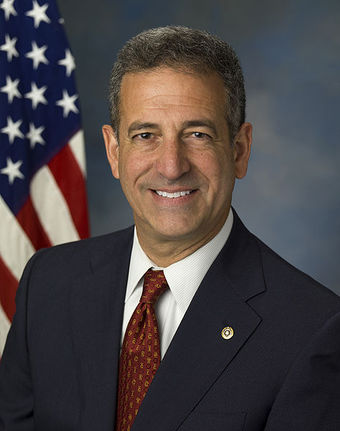
Russ Feingold
Senator Russ Feingold from Wisconsin.
Current proposals for reform
The voting with dollars plan would establish a system of modified public financing coupled with an anonymous campaign contribution process. It has two parts: patriot dollars and the secret donation booth. It was originally described in detail by Yale Law School professors Bruce Ackerman and Ian Ayres in their 2004 book Voting with Dollars: A new paradigm for campaign finance. All voters would be given a $50 publicly funded voucher (Patriot dollars) to donate to federal political campaigns. All donations including both the $50 voucher and additional private contributions must be made anonymously through the FEC. Ackerman and Ayres include model legislation in their book in addition to detailed discussion as to how such a system could be achieved and its legal basis.
Another method allows the candidates to raise funds from private donors, but provides matching funds for the first chunk of donations. For instance, the government might “match” the first $250 of every donation. This would effectively make small donations more valuable to a campaign, potentially leading them to put more effort into pursuing such donations, which are believed to have less of a corrupting effect than larger gifts and enhance the power of less-wealthy individuals. Such a system is currently in place in the U.S. presidential primaries.
Another method, which supporters call clean money, clean elections, gives each candidate who chooses to participate a certain, set amount of money. In order to qualify for this money, the candidates must collect a specified number of signatures and small (usually $5) contributions. The candidates are not allowed to accept outside donations or to use their own personal money if they receive this public funding. Candidates receive matching funds, up to a limit, when they are outspent by privately-funded candidates, attacked by independent expenditures, or their opponent benefits from independent expenditures. This is the primary difference between clean money public financing systems and the presidential campaign system, which many have called “broken” because it provides no extra funds when candidates are attacked by 527s or other independent expenditure groups.
8.7.6: The Federal Election Campaign Act
The Federal Election Campaign Act of 1971 is a United States federal law which increased disclosure of contributions for federal campaigns.
Learning Objective
Describe the history of campaign finance regulation in the twentieth century
Key Points
- The Federal Election Commission (FEC) is an independent regulatory agency that was founded in 1975 by the United States Congress to regulate the campaign finance legislation.
- Early legislation by Congress sought to limit the influence of wealthy individuals and special interest groups on the outcome of federal elections, regulate spending in campaigns for federal office, and deter abuses by mandating public disclosure of campaign finances.
- A political action committee (PAC) is any organization in the United States that campaigns for or against political candidates, ballot initiatives, or legislation.
- In Buckley v. Valeo (1976), the Supreme Court upheld a federal law which set limits on campaign contributions, but it also ruled that spending money to influence elections is a form of constitutionally protected free speech, striking down portions of FECA.
- With the Buckley v. Valeo decision, the Supreme Court also ruled that candidates can give unlimited amounts of money to their own campaigns.
- Following Buckley v. Valeo, the Federal Elections Campaign Act was amended in 1976 and 1979 with the goal to allow parties to spend unlimited amounts of soft money on activities like increasing voter turnout and registration. This led to passage of the Bipartisan Campaign Reform Act in 2002.
Key Terms
- political action committee
-
A political action committee (PAC) is any organization in the United States that campaigns for or against political candidates, ballot initiatives, or legislation.
- federal election commission
-
The Federal Election Commission (FEC) is an independent regulatory agency that was founded in 1975 by the United States Congress to regulate the campaign finance legislation in the United States.
- federal election campaign act
-
The Federal Election Campaign Act of 1971 is a United States federal law which increased disclosure of contributions for federal campaigns. It was amended in 1974 to place legal limits on the campaign contributions.
Example
- According to FECA, an organization becomes a PAC when it receives or spends more than $1,000 for the purpose of influencing a federal election.
Introduction
The Federal Election Campaign Act of 1971 is a United States federal law which increased disclosure of contributions for federal campaigns. It was amended in 1974 to place legal limits on the campaign contributions. The amendment also created the Federal Election Commission (FEC), an independent agency responsible for regulating campaign finance legislation . The FEC describes its duties as “to disclose campaign finance information, to enforce the provisions of the law such as the limits and prohibitions on contributions, and to oversee the public funding of Presidential elections.”

Federal Elections Commission
Seal of the United States Federal Election Commission.
History
As early as 1905, President Theodore Roosevelt asserted the need for campaign finance reform and called for legislation to ban corporate contributions for political purposes. In response, the United States Congress enacted the Tillman Act of 1907, named for its sponsor Senator Benjamin Tillman. This act banned corporate contributions. Further regulation followed with the Federal Corrupt Practices Act enacted in 1910 with subsequent amendments in 1910 and 1925, the Hatch Act, the Smith-Connally Act of 1943, and the Taft-Hartley Act in 1947. These acts sought to:
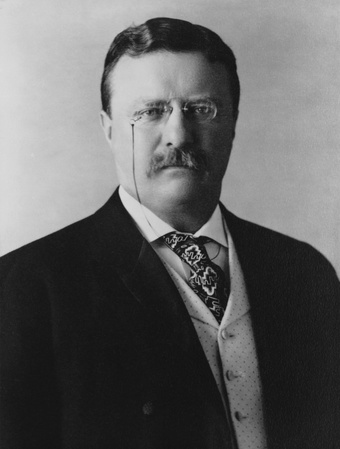
President Theodore Roosevelt
President of the United States Theodore Roosevelt, who asserted the need for campaign finance reform and called for legislation to ban corporate contributions for political purposes.
- Limit the influence of wealthy individuals and special interest groups on the outcome of federal elections.
- Regulate spending in campaigns for federal office.
- Deter abuses by mandating public disclosure of campaign finances..
In 1971, Congress consolidated earlier reform efforts in the Federal Election Campaign Act (FECA), instituting more stringent disclosure requirements for federal candidates, political parties and political action committees. A political action committee(PAC) is any organization in the United States that campaigns for or against political candidates, ballot initiatives, or legislation. According to the FECA, an organization becomes a PAC when it receives or spends more than $1,000 for the purpose of influencing a federal election. Without a central administrative authority, campaign finance laws were difficult to enforce.
Public subsidies for federal elections, originally proposed by President Roosevelt in 1907, began to take shape as part of FECA. Congress established the income tax checkoff to provide financing for Presidential general election campaigns and national party conventions. Amendments to the Internal Revenue Code in 1974 established the matching fund program for Presidential primary campaigns. Following reports of serious financial abuses in the 1972 Presidential campaign, Congress amended the FECA in 1974 to set limits on contributions by individuals, political parties, and PACs. The 1974 amendments also established the Federal Election Commission (FEC) to enforce the law, facilitate disclosure, and administer the public funding program. The FEC opened its doors in 1975 and administered the first publicly funded Presidential election in 1976.
Buckley v. Valeo
In Buckley v. Valeo (1976), the Supreme Court struck down or narrowed several provisions of the 1974 amendments to FECA, including limits on spending and limits on the amount of money a candidate could donate to his or her own campaign. The court upheld a federal law which set limits on campaign contributions, but it also ruled that spending money to influence elections is a form of constitutionally protected free speech, striking down portions of the law. The court also ruled candidates can give unlimited amounts of money to their own campaigns.
Further Legislation
Following Buckley v. Valeo, FECA was amended again in 1976 and 1979. The aim of these amendments was to allow parties to spend unlimited amounts of hard money on activities like increasing voter turnout and registration. In 1979, the Commission ruled that political parties could spend unregulated or “soft” money for non-federal administrative and party building activities. Later, this money was used for candidate related issue ads, leading to a substantial increase in soft money contributions and expenditures in elections. The increase of soft money created political pressures that led to passage of the Bipartisan Campaign Reform Act (BCRA). The BCRA banned soft money expenditure by parties. Some of the legal limits on giving of “hard money” were also changed in by BCRA.
8.7.7: The Bipartisan Campaign Reform Act of 2002
The Bipartisan Campaign Reform Act of 2002 is a United States federal law that regulates the financing of political campaigns.
Learning Objective
Analyze the history of legal challenges to campaign finance reform legislation
Key Points
- The Act was designed to address two issues: the increased role of soft money in campaign financing, and the proliferation of issue advocacy ads.
- Soft money refers to “non-federal money” that corporations, unions and individuals contribute to political parties to influence state or local elections.
- Provisions of the legislation were challenged as unconstitutional by a group of plaintiffs led by then–Senate Majority Whip Mitch McConnell, a long-time opponent of the bill.
- “McConnell v. Federal Election Commission” is a case in which the United States Supreme Court upheld the constitutionality of most of the Bipartisan Campaign Reform Act of 2002 (BCRA).
- The impact of BCRA was felt nationally during the 2004 elections. One impact was that all campaign advertisements included a verbal statement to the effect of “I’m (candidate’s name) and I approve this message.
Key Terms
- mcconnell v. federal election commission
-
In McConnell v. Federal Election Commission, the United States Supreme Court upheld the constitutionality of most of the Bipartisan Campaign Reform Act of 2002 (BCRA).
- soft money
-
Soft money refers to “non-federal money” that corporations, unions and individuals contribute to political parties to influence state or local elections.
- bipartisan campaign reform act
-
The Bipartisan Campaign Reform Act of 2002 is a United States federal law amending the Federal Election Campaign Act of 1971 regulating the financing of political campaigns.
Example
- The impact of BCRA was felt nationally during the 2004 elections. One impact was that all campaign advertisements included a verbal statement to the effect of “I’m (candidate’s name) and I approve this message.
Introduction
The Bipartisan Campaign Reform Act of 2002 is a United States federal law amending the Federal Election Campaign Act of 1971 regulating the financing of political campaigns. Its chief sponsors were Senators Russ Feingold (, D-WI) and John McCain (, R-AZ). The law became effective on November 6, 2002, with the new legal limits going into effect on January 1, 2003. Although the legislation is known as “McCain–Feingold,” the Senate version is not the bill that became law. Instead, the companion legislation introduced by Rep. Chris Shays (R-CT),H.R. 2356, is the version that became law. Shays–Meehan was originally introduced as H.R. 380.
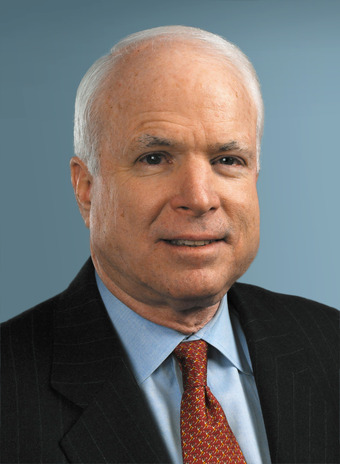
2008 Republican Party Presidential Candidate John McCain
Senator John McCain from Arizona.
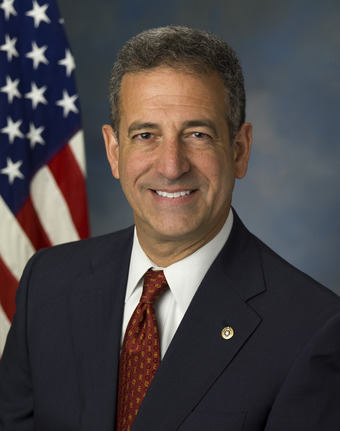
Russ Feingold
Senator Russ Feingold from Wisconsin.
The Act addresses the increased role of soft money in campaign financing by prohibiting national political party committees from raising or spending funds not subject to federal limits. Soft money refers to “non-federal money” that corporations, unions and individuals contribute to political parties to influence state or local elections. The Act also addresses proliferation of issue advocacy ads, defining as “electioneering communications” broadcast ads that name a federal candidate within 30 days of a primary or caucus or 60 days of a general election. Any such ad paid for by a corporation or a non-profit organizations is also prohibited .
In June 2003, the D.C. Circuit issued a ruling on the constitutionality of the law, but the ruling never took effect as the case was immediately appealed to the U.S. Supreme Court.
Legal Disputes
Provisions of the legislation were challenged as unconstitutional by a group of plaintiffs led by then–Senate Majority WhipMitch McConnell . President Bush signed the law despite “reservations about the constitutionality of the broad ban on issue advertising. ” Bush appeared to expect that the Supreme Court would overturn some of its key provisions. However, in December 2003, the Supreme Court upheld most of the legislation in McConnell v. Federal Election Commission.
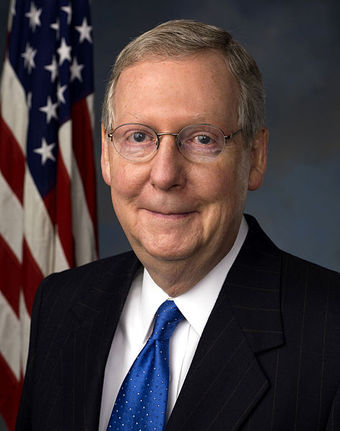
Mitch McConnell
Official portrait of United States Senator Mitch McConnell (R-KY)
In McConnell v. Federal Election Commission, the United States Supreme Court upheld the constitutionality of most of the Bipartisan Campaign Reform Act of 2002 (BCRA). The Supreme Court heard oral arguments in a special session on September 8, 2003. On December 10, 2003, it issued a complicated decision that upheld the key provisions of McCain-Feingold. These included “electioneering communication” provisions placing restrictions on using corporate and union treasury funds to disseminate broadcast ads identifying a federal candidate within 30 days of a primary or 60 days of a general election) The court also upheld the “soft money” ban prohibiting the raising or use of these funds in federal elections.
Impact and Overturn
The impact of BCRA was felt nationally during the 2004 elections. One immediately recognizable impact was the so-called “Stand By Your Ad” provision. The provision requires all U.S. political candidates and parties to identify themselves and state that they have approved a particular communication, i.e. “I’m (a candidate) and I approve this message. “
In Federal Election Commission v. Wisconsin Right to Life, Inc., the Supreme Court ruled that the organizations engaged in genuine discussion of issues were entitled to a broad, “as applied” exemption from the electioneering communications provisions of BCRA applying to naming a candidate before an election or primary. Observers argue that the Court’s exemption effectively nullifies those provisions of the Act, but the full impact of Wisconsin Right to Life remains to be seen.
8.7.8: Campaign Financing
Campaign finance in the United States refers to the process of financing electoral campaigns at the federal, state, and local levels.
Learning Objective
Describe the nature of and uses for campaign finance in the United States
Key Points
- At the federal level, campaign finance law is enacted by Congress and enforced by the Federal Election Commission (FEC), an independent federal agency.
- Political finance refers to all funds that are raised and spent for political purposes. This includes all political contests for voting by citizens, especially the election campaigns for various public offices.
- Political expenses can be caused by election campaigns or contests for nomination or re-selection of parliamentary candidates.
Key Terms
- political finance
-
Political finance covers all funds that are raised and spent for political purposes. Such purposes include all political contests for voting by citizens, especially the election campaigns for various public offices that are run by parties and candidates.
- grassroots fundraising
-
Grassroots fundraising is a method of fundraising used by or for political candidates, which has grown in popularity with the emergence of the Internet and its use by US presidential candidates like Howard Dean and Ron Paul.
Introduction
Campaign finance in the United States refers to the process of financing electoral campaigns at the federal, state, and local levels. At the federal level, campaign finance law is enacted by Congress and enforced by the Federal Election Commission (FEC), an independent federal agency. Although most campaign spending is privately financed, public financing is available for qualifying US presidential candidates during both the primaries and the general election. Eligibility requirements must be fulfilled to qualify for a government funding, and candidates who accept this funding are usually subject to spending limits.
Political Finance
Political finance refers to all funds that are raised and spent for political purposes. This includes all political contests for voting by citizens, especially the election campaigns for various public offices. Modern democracies operate a variety of permanent party organizations. For example, in the United States this includes the Democratic National Committee and the Republican National Committee. Political expenses can include:
- Election campaigns run by candidates, candidate committees, interest groups or political parties
- Contests for nomination or re-selection of parliamentary candidates
- Training activities for party activists, officeholders or candidates
- Efforts to educate citizens with regard to popular initiatives, ballot issues or referendums.
Grassroots fundraising is a method of fundraising used by or for political candidates. This method has grown in popularity with the emergence of the Internet and its use by US presidential candidates like Howard Dean and Ron Paul . Grassroots fundraising is a way of financing campaigns for candidates who don’t have significant media exposure or candidates who are in opposition to the powerful lobby groups. It often involves mobilizing grassroots support to meet a specific fundraising goal, or it sets a specific day for grassroots supporters to donate to the campaign.
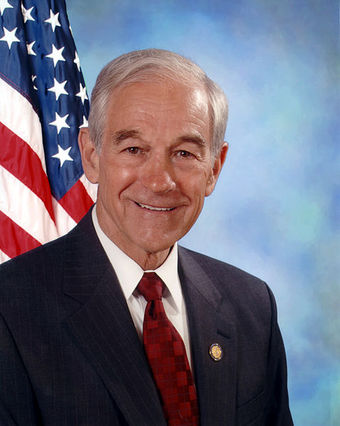
Ron Paul
Ron Paul is a congressman from Texas who employs the method of grassroots fundraising.
Chapter 7: Interest Groups
7.1: Interest Groups
7.1.1: The Constitutional Right to Petition the Government
The Supreme Court has ruled that petitioning the government by way of lobbying is protected by the Constitution as free speech.
Learning Objective
Describe the constitutional warrant for lobbying the government
Key Points
- The ability of individuals, groups, and corporations to lobby the government is protected by the right to petition in the First Amendment.
- The legality of lobbying took “strong and early root” in the new republic.
- Lobbying, properly defined, is subject to control by Congress.
Key Terms
- First Amendment
-
The first of ten amendments to the constitution of the United States, which protects freedom of religion, speech, assembly, and the press.
- direct lobbying
-
Direct lobbying refers to methods used by lobbyists to influence legislative bodies through direct communication with members of the legislative body, or with a government official who formulates legislation.
- Supreme Court
-
The highest court in the United States.
The ability of individuals, groups, and corporations to lobby the government is protected by the right to petition in the First Amendment. It is protected by the Constitution as free speech; one accounting was that there were three Constitutional provisions which protect the freedom of interest groups to “present their causes to government”, and various decisions by the Supreme Court have upheld these freedoms over the course of two centuries . Corporations have been considered in some court decisions to have many of the same rights as citizens, including their right to lobby officials for what they want. As a result, the legality of lobbying took “strong and early root” in the new republic.

Value or Price
In 1953, after a lawsuit involving a congressional resolution authorizing a committee to investigate “all lobbying activities intended to influence, encourage, promote, or retard legislation,” the Supreme Court narrowly construed “lobbying activities” to mean only “direct” lobbying–which the Court described as “representations made directly to the Congress, its members, or its committees”. It contrasted it with indirect lobbying: efforts to influence Congress indirectly by trying to change public opinion. The Court rejected a broader interpretation of “lobbying” out of First Amendment concerns, and thereby affirmed the earlier decision of the appeals court. The Supreme Court ruling was:
In support of the power of Congress it is argued that lobbying is within the regulatory power of Congress, that influence upon public opinion is indirect lobbying, since public opinion affects legislation; and that therefore attempts to influence public opinion are subject to regulation by the Congress. Lobbying, properly defined, is subject to control by Congress, . . . But the term cannot be expanded by mere definition so as to include forbidden subjects. Neither semantics nor syllogisms can break down the barrier which protects the freedom of people to attempt to influence other people by books and other public writings. . . . It is said that lobbying itself is an evil and a danger. We agree that lobbying by personal contact may be an evil and a potential danger to the best in legislative processes. It is said that indirect lobbying by the pressure of public opinion on the Congress is an evil and a danger. That is not an evil; it is a good, the healthy essence of the democratic process. . . .—Supreme Court decision in Rumely v. United States
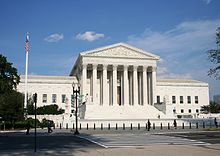
Using the Courts
Drawing on the First Amendment, the U.S. Supreme Court has protected lobbying as free speech in numerous rulings since the early republic.
7.1.2: Interest Groups
The term interest group refers to virtually any voluntary association that seeks to publicly promote and create advantages for its cause.
Learning Objective
Discuss the main actors who work for interest groups and seek to influence policy
Key Points
- Interest groups include corporations, charitable organizations, civil rights groups, neighborhood associations, professional, and trade associations.
- Advocacy groups use various forms of advocacy to influence public opinion and/or policy; they have played and continue to play an important part in the development of political and social systems.
- Groups use varied methods to try to achieve their aims including lobbying, media campaigns, publicity stunts, polls, research, and policy briefings. Some groups are supported by powerful business or political interests and exert considerable influence on the political process.
- Some powerful Lobby groups have been accused of manipulating the democratic system for narrow commercial gain. and in some instances have been found guilty of corruption, fraud, bribery, and other serious crimes; lobbying has become increasingly regulated as a result.
Key Terms
- interest groups
-
The term interest group refers to virtually any voluntary association that seeks to publicly promote and create advantages for its cause. It applies to a vast array of diverse organizations. This includes corporations, charitable organizations, civil rights groups, neighborhood associations, and professional and trade associations.
- advocacy groups
-
Advocacy groups use various forms of advocacy to influence public opinion and/or policy; they have played and continue to play an important part in the development of political and social systems.
Example
- There are many significant advocacy groups through history, some of which operate with different dynamics and could better be described as social movements. For example, Greenpeace is a non-governmental environmental organization with offices in over forty countries and with an international coordinating body in Amsterdam, the Netherlands. Greenpeace states its goal is to “ensure the ability of the Earth to nurture life in all its diversity” and focuses its campaigning on worldwide issues such as global warming, deforestation, overfishing, commercial whaling, and anti-nuclear issues.
Interest Groups
Introduction
The term interest group refers to virtually any voluntary association that seeks to publicly promote and create advantages for its cause. It applies to a vast array of diverse organizations. This includes corporations, charitable organizations, civil rights groups, neighborhood associations, professional, and trade associations. Advocacy groups use various forms of advocacy to influence public opinion and/or policy; they have played and continue to play an important part in the development of political and social systems.
Groups vary considerably in size, influence, and motive; some have wide ranging long term social purposes, others are focused and are a response to an immediate issue or concern. Motives for action may be based on a shared political, faith, moral, or commercial position. Groups use varied methods to try to achieve their aims including lobbying, media campaigns, publicity stunts, polls, research, and policy briefings. Some groups are supported by powerful business or political interests and exert considerable influence on the political process, while others have few such resources.
Some interest groups have developed into important social, political institutions or social movements. Some powerful Lobby groups have been accused of manipulating the democratic system for narrow commercial gain. In some instances, they have been found guilty of corruption, fraud, bribery, and other serious crimes; lobbying has become increasingly regulated as a result. Some groups, generally ones with less financial resources, may use direct action and civil disobedience, and in some cases are accused of being domestic extremists or a threat to the social order. Research is beginning to explore how advocacy groups use social media to facilitate civic engagement and collective action.
There are many significant advocacy groups throughout history, some of which operate with different dynamics and could better be described as social movements. There are some notable groups operating in different parts of the world. For example, Greenpeace is a non-governmental environmental organization with offices in over forty countries and with an international coordinating body in Amsterdam, the Netherlands. Greenpeace states its goal is to “ensure the ability of the Earth to nurture life in all its diversity” and focuses its campaigning on worldwide issues such as global warming, deforestation, overfishing, commercial whaling, and anti-nuclear issues.

Greenpeace
Greenpeace is a non-governmental environmental organization with offices in over forty countries and with an international coordinating body in Amsterdam, the Netherlands. Greenpeace states its goal is to “ensure the ability of the Earth to nurture life in all its diversity” and focuses its campaigning on world wide issues such as global warming, deforestation, overfishing, commercial whaling, and anti-nuclear issues. Greenpeace uses direct action, lobbying, and research to achieve its goals.
In some instances, advocacy groups have been convicted of illegal activity. Major examples include: 1) Jack Abramoff Indian lobbying scandal Corrupt and fraudulent lobbying in relation to Native American gambling enterprises; 2) Tobacco Master Settlement Agreement between the Attorneys General of 46 states and the four largest US tobacco companies who agreed to pay $206 billion over the first twenty-five years of the agreement
7.1.3: Organization of Interest Groups
Interest groups can come in varied forms and organize under different methods.
Learning Objective
Discuss the theories behind interest groups and their effects on government
Key Points
- An employers’ organization is an association of employers. The role and position of an employers’ organization differs from country to country, depending on the economic system of a country.
- Occupational organizations promote the professional and economic interests of workers in a particular occupation, industry, or trade, through interaction with the government, and by preparing advertising and other promotional campaigns to the public.
- Interest groups can be technical or non technical. Some are dedicated to unions while others to specific interests.
- Their organization and operations can be based on any of three theories: pluralism, neo-pluralism, and corporatism.
Key Terms
- occupational organizations
-
Occupational organizations promote the professional and economic interests of workers in a particular occupation, industry, or trade, through interaction with the government, and by preparing advertising and other promotional campaigns to the public.
- employers’ organization
-
An employers’ organization is an association of employers.
Introduction
A Special Interest Group (SIG) is a community with particular interest in advancing a specific area of knowledge, learning or technology.Members cooperate to affect or to produce solutions within their particular field, and may communicate, meet, and organize conferences. They may, in some cases, also advocate or lobby on a particular issue or on a range of issues but they are generally distinct from advocacy and pressure groups which are normally set up for the specific political aim; this distinction is not firm however and some organizations can adapt and change their focus over time. Public policy, in general, is a dynamic interplay of decisions between the President, Congress and interest groups.
Organizations may also have Special Interest Groups which are normally focused on a mutual interest or shared characteristic of a subset of members of the organization. An important example for this are trade unions, educational unions, and labor unions .
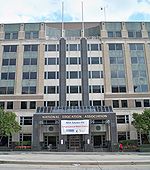
National Educators Association
The NEA is a prominent and powerful interest group
Much work has been undertaken by academics in trying to categorize how pressure groups operate, particularly in relation to governmental policy creation.
The field is dominated by several differing schools of thought:
- Pluralism: This is based upon the understanding that pressure groups operate in competition with one another and play a key role in the political system. They do this by acting as a counterweight to undue concentrations of power. However, this pluralist theory (formed primarily by American academics) reflects a more open and fragmented political system similar to that in countries like the United States. Under neo-pluralism, a concept of political communities developed that is more similar to the British form of government
- Neo-Pluralism: This is based on the concept of political communities in that pressure groups and other similar bodies are organised around a government department and its network of client groups. The members of this network co-operate during the policy making process.
- Corporatism: Some pressure groups are backed by private businesses that have heavy influence on the legislature.
7.1.4: The Characteristics of Members
Membership interests represent individuals for social, business, labor, or charitable purposes to achieve political goals.
Learning Objective
Explain the benefits and incentives of joining interest groups
Key Points
- An interest group is a group of individuals who share common objectives, and whose aim is to influence policymakers.
- Membership includes a group of people that join an interest group and unite under one cause. They may or may not have an opinion on some of the issues the staff pursues.
- Similarly, staff are the leaders of this group that heads up the membership. With the membership united under one cause, the staff has the ability to pursue other issues that the membership may disagree on, but will remain members united by the primary cause.
- Mancur Lloyd Olson sought to understand the logical basis of interest group membership and participation. In his first book, he theorized that “only a separate and ‘selective’ incentive will stimulate a rational individual in a latent group to act in a group-oriented way.
Key Terms
- interest group
-
Collections of members with shared knowledge, status, or goals. In many cases, these groups advocate for particular political or social issues.
- mancur lloyd olson
-
Mancur Lloyd Olson, a leading American economist, sought to understand the logical basis of interest group membership and participation. In his first book, The Logic of Collective Action: Public Goods and the Theory of Groups (1965), he theorized that “only a separate and ‘selective’ incentive will stimulate a rational individual in a latent group to act in a group-oriented way”; that is, members of a large group will not act in the group’s common interest unless motivated by personal gains.
Example
- Membership interests are organizations that represent individuals for social, business, labor, or charitable purposes, in order to achieve civil or political goals. This includes the NAACP (represents African-American interests), the Sierra Club (represents environmental interests), the NRA (represents Second Amendment interests), and Common Cause (represents interests in an increase in voter turnout and knowledge).
Introduction
An interest group is a group of individuals who share common objectives, and whose aim is to influence policymakers. Institutional interests are organizations that represent other organizations, whose rules and policies are custom-fit to the needs and wants of the organizations they serve. This includes the American Cotton Manufacturers (which represents the generally congruous southern textile mills) and the U.S. Chamber of Commerce (which represents the multitude of wants of American businesses).
Membership interests are organizations that represent individuals for social, business, labor, or charitable purposes, in order to achieve civil or political goals. This includes the NAACP(represents African-American interests), the Sierra Club (represents environmental interests), the NRA (represents Second Amendment interests, ), and Common Cause (represents interests in an increase in voter turnout and knowledge). Membership includes a group of people that join an interest group and unite under one cause. They may or may not have an opinion on some of the issues the staff pursues. Similarly, staff are the leaders of this group that heads up the membership. With the membership united under one cause, the staff has the ability to pursue other issues that the membership may disagree on, but will remain members united by the primary cause.
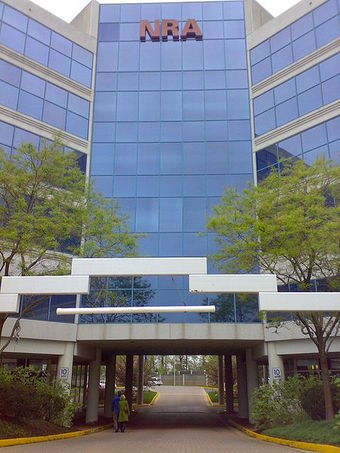
NRA Headquarters
The headquarters of the NRA, an interest group, located in Fairfax Virginia, USA. The NRA represents an interest group advocating for the rights to own weapons under the Second Amendment of the United States.
Benefits and Incentives
The general theory is that individuals must be enticed with some type of benefit to join an interest group. Known as the free rider problem, it refers to the difficulty of obtaining members of a particular interest group when the benefits are already reaped without membership. For instance, an interest group dedicated to improving farming standards will fight for the general goal of improving farming for every farmer, even those who are not members of that particular interest group. Thus, there is no real incentive to join an interest group and pay dues if the farmer will receive that benefit anyway. Interest groups must receive dues and contributions from its members in order to accomplish its agenda. While every individual in the world would benefit from a cleaner environment, an Environmental protection interest group does not, in turn, receive monetary help from every individual in the world.
Selective material benefits are benefits that are usually given in monetary benefits. For instance, if an interest group gives a material benefit to their member, they could give them travel discounts, free meals at certain restaurants, or free subscriptions to magazines, newspapers, or journals. Many trade and professional interest groups tend to give these types of benefits to their members. A selective solidary benefit is another type of benefit offered to members or prospective members of an interest group. These incentives involve benefits like “socializing congeniality, the sense of group membership and identification, the status resulting from membership, fun and conviviality, the maintenance of social distinctions, and so on. A solidary incentive is one in which the rewards for participation are socially derived and created out of the act of association.
An expressive incentive is another basic type of incentive or benefit offered to being a member of an interest group. People who join an interest group because of expressive benefits likely joined to express an ideological or moral value that they believe in. Some include free speech, civil rights, economic justice, or political equality. To obtain these types of benefits, members would simply pay dues, donating their time or money to get a feeling of satisfaction from expressing a political value. Also, it would not matter if the interest group achieved their goal; these members would merely be able to say they helped out in the process of trying to obtain these goals, which is the expressive incentive that they got in the first place. The types of interest groups that rely on expressive benefits or incentives would be environmental groups and groups who claim to be lobbying for the public interest.
Collective Action
Mancur Lloyd Olson, a leading American economist, sought to understand the logical basis of interest group membership and participation. The reigning political theories of his day granted groups an almost primordial status. Some appealed to a natural human instinct for herding, others ascribed the formation of groups that are rooted in kinship to the process of modernization. Olson offered a radically different account of the logical basis of organized collective action. In his first book, The Logic of Collective Action: Public Goods and the Theory of Groups (1965), he theorized that “only a separate and ‘selective’ incentive will stimulate a rational individual in a latent group to act in a group-oriented way”; that is, members of a large group will not act in the group’s common interest unless motivated by personal gains.
7.1.5: Motivations Behind the Formation of Interest Groups
Members comprising interest groups join for solidarity, material, or purposive incentives.
Learning Objective
Identify the benefits and incentives for individuals to join interest groups
Key Points
- The free rider problem refers to the difficulty of obtaining members of a particular interest group when the benefits are already reaped without membership.
- A collective good refers to something of value that cannot be withheld from a nonmember of a group.
- Selective material benefits are benefits that are usually given in monetary benefits. For instance, if an interest group gives a material benefit to their members, they could give them rewards for their efforts.
- A selective solidary benefit refers to the benefits of belonging to a community of shared principles and interests. Members join for the benefits of group distinction and the status resulting from membership.
- An expressive incentive is another basic type of incentive or benefit offered to being a member of an interest group. People who join an interest group because of expressive benefits likely joined to express an ideological or moral value that they believe in.
- A purposive incentive refers to a benefit that comes from serving a cause or principle; people who join because of these are usually passionate about the cause or principle.
Key Terms
- expressive incentive
-
An expressive incentive is another basic type of incentive or benefit offered to being a member of an interest group. People who join an interest group because of expressive benefits likely joined to express an ideological or moral value that they believe in. Some include free speech, civil rights, economic justice, or political equality.
- solidary benefit
-
A selective solidary benefit is another type of benefit offered to members or prospective members of an interest group. These incentives involve benefits like “socializing congeniality, the sense of group membership and identification, the status resulting from membership, fun and conviviality, the maintenance of social distinctions, and so on.
- selective material benefits
-
Selective material benefits are benefits that are usually given in monetary benefits. For instance, if an interest group gives a material benefit to their member, they could give them travel discounts, free meals at certain restaurants, or free subscriptions to magazines, newspapers, or journals.
- free rider
-
In economics, collective bargaining, psychology and political science, “free riders” are those who consume more than their fair share of a resource, or shoulder less than a fair share of the costs of its production. Free riding is usually considered to be an economic “problem” only when it leads to the non-production or under-production of a public good (and thus to Pareto inefficiency), or when it leads to the excessive use of a common property resource. The free rider problem is the question of how to prevent free riding from taking place (or at least limit its negative effects) in these situations.
- purposive incentive
-
A purposive incentive refers to a benefit that comes from serving a cause or principle; people who join because of these are usually passionate about the cause or principle.
- collective goods
-
items and resourcses that benefit everyone, and from which people cannot be excluded
Example
- To illustrate the free rider problem and collective goods, take for instance a tax write-off for a better environment. While every individual in the world would benefit from a cleaner environment, an environmental protection interest group does not, in turn, receive monetary help from every individual in the world.
Why Interest Groups Form
Introduction
The general theory is that individuals must be enticed with some type of benefit to join an interest group. Known as the free rider problem, it refers to the difficulty of obtaining members of a particular interest group when the benefits are already reaped without membership. For instance, an interest group dedicated to improving farming standards will fight for the general goal of improving farming for every farmer, even those who are not members of that particular interest group. Thus, there is no real incentive to join an interest group and pay dues if the farmer will receive that benefit anyway. Interest groups must receive dues and contributions from its members in order to accomplish its agenda. A collective good refers to something of value that cannot be withheld from a nonmember of a group. To illustrate the free rider problem and collective goods, take environmental groups who advocate for a cleaner environment. While every individual in the world would benefit from a cleaner environment, an environmental protection interest group does not, in turn, receive monetary help from every individual in the world.
Types of Benefits and Incentives
Selective material benefits are benefits that are usually given in monetary benefits. For instance, if an interest group gives a material benefit to their member, they could give them travel discounts, free meals at certain restaurants, or free subscriptions to magazines, newspapers, or journals. Many trade and professional interest groups tend to give these types of benefits to their members. A selective solidary benefit is another type of benefit offered to members or prospective members of an interest group. These incentives involve benefits like socializing congeniality, the sense of group membership and identification, the status resulting from membership, fun and conviviality, the maintenance of social distinctions, and so on. A solidary incentive is one in which the rewards for participation are socially derived and created out of the act of association.
An expressive incentive is another basic type of incentive or benefit offered to being a member of an interest group. People who join an interest group because of expressive benefits likely joined to express an ideological or moral value that they believe in. Some include free speech, civil rights, economic justice, or political equality . To obtain these types of benefits, members would simply pay dues, donating their time or money to get a feeling of satisfaction from expressing a political value. Also, it would not matter if the interest group achieved their goal. These members would merely be able to say they helped out in the process of trying to obtain these goals, which is the expressive incentive that they got in the first place. The types of interest groups that rely on expressive benefits or incentives would be environmental groups and groups who claim to be lobbying for the public interest. A purposive incentive refers to a benefit that comes from serving a cause or principle; people who join because of these are usually passionate about the cause or principle .
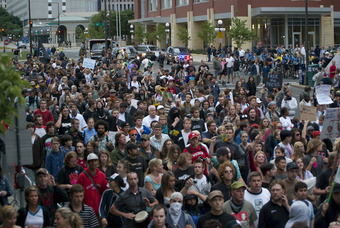
Protests at the 2008 Republican National Convention
A purposive incentive refers to a benefit that comes from serving a cause or principle; people who join because of these are usually passionate about the cause or principle.
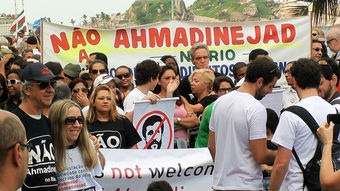
Demonstration against Ahmadinejad in Rio
An expressive incentive is another basic type of incentive or benefit offered to being a member of an interest group. People who join an interest group because of expressive benefits likely joined to express an ideological or moral value that they believe in.
7.1.6: The Function of Interest Groups
An advocacy group is a group or an organization that tries to influence the government but does not hold power in the government.
Learning Objective
Compare and contrast the function of interest groups
Key Points
- A single-issue group may form in response to a particular issue area sometimes in response to a single event or threat. In some cases initiatives initially championed by advocacy groups later become institutionalized as important elements of civic life.
- Anti-defamation organizations issue responses or criticisms to real or supposed slights of any sort by an individual or group against a specific segment of the population that the organization exists to represent.
- Watchdog groups exist to provide oversight and rating of actions or media by various outlets, both government and corporate. They may also index personalities, organizations, products and activities in databases to provide coverage and rating of the value of such entities.
- Lobby groups work for a change to the law or the maintenance of a particular law and big businesses fund very considerable lobbying influence on legislators, for example in the U.S. and in the U.K. where lobbying first developed.
- Legal defense funds provide funding for the legal defense for, or legal action against, individuals or groups related to their specific interests or target demographic by filing Amicus Curiae in court.
Key Terms
- legal defense funds
-
Legal defense funds provide funding for the legal defense for, or legal action against, individuals or groups related to their specific interests or target demographic.
- lobby groups
-
The act of attempting to persuade a group of people that influence decisions made by officials in the government, most often legislators or members of regulatory agencies.
- anti-defamation organizations
-
Anti-defamation organizations issue responses or criticisms to real or supposed slights of any sort by an individual or group against a specific segment of the population that the organization exists to represent.
- advocacy group
-
An advocacy group is a group or an organization that tries to influence the government but does not hold power in the government.
- watchdog groups
-
Watchdog groups exist to provide oversight and rating of actions or media by various outlets, both government and corporate.
Example
- Groups representing broad interests of a group may be formed with the purpose of benefiting the group over an expended period of time and in many ways; examples include Consumer organizations, Professional associations, Trade associations and Trade unions.
Introduction
An advocacy group is a group or an organization that tries to influence the government but does not hold power in the government . A single-issue group may form in response to a particular issue area sometimes in response to a single event or threat. In some cases initiatives initially championed by advocacy groups later become institutionalized as important elements of civic life (for example universal education or regulation of doctors). Groups representing broad interests of a group may be formed with the purpose of benefiting the group over an extended period of time and in many ways; examples include Consumer organizations, Professional associations, Trade associations and Trade unions.

Health News Watchdog
Media watchdogs ensure that media coverage is factually accurate and as objective as possible.
Activities
Advocacy groups exist in a wide variety of genres based upon their most pronounced activities . Anti-defamation organizations issue responses or criticisms to real or supposed slights of any sort by an individual or group against a specific segment of the population that the organization exists to represent. Watchdog groups exist to provide oversight and rating of actions or media by various outlets, both government and corporate. They may also index personalities, organizations, products and activities in databases to provide coverage and rating of the value or viability of such entities to target demographics.
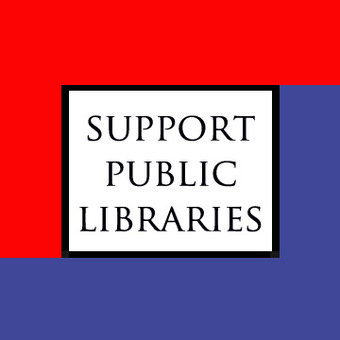
Support Public Libraries Advocacy
Advocacy groups seek to influence government policy. In cases such as public libraries, advocacy groups have been critical in lobbying for continued funding across the nation.
Lobby groups work for a change to the law or the maintenance of a particular law and big businesses fund very considerable lobbying influence on legislators, for example in the U.S. and in the U.K. where lobbying first developed. Legal defense funds provide funding for the legal defense for, or legal action against, individuals or groups related to their specific interests or target demographic. This is often accompanied by one of the above types of advocacy groups filing Amicus curiae if the cause at stake serves the interests of both the legal defense fund and the other advocacy groups.
7.1.7: Interest Groups vs. Political Parties
Advocacy groups exert influence on political parties, mostly through campaign finance.
Learning Objective
Explain how competing business interests lobby to influence legislation in Congress
Key Points
- A party or its leading members may be offered money or gifts-in-kind. These donations are the traditional source of funding for all right-of-center cadre parties.
- Advocacy groups exert influence on political parties, mostly through campaign finance.
- Left-wing parties are often funded by organized labor. When the Labor Party was first formed, it was largely funded by trade unions.
Key Term
- advocacy groups
-
Advocacy groups use various forms of advocacy to influence public opinion and/or policy; they have played and continue to play an important part in the development of political and social systems.
Example
- George W. Bush’s re-election campaign in 2004 was the most expensive in American history. It was financed mainly by large corporations and industrial interests.
Political Parties
Political parties are lobbied vigorously by organizations, businesses, and special interest groups such as trades unions. A party or its leading members may be offered money or gifts-in-kind. These donations are the traditional source of funding for all right-of-center cadre parties. Starting in the late 19th century, these parties were opposed by the new founded left-of-center workers’ parties. They started a new party type, the mass membership party, and a new source of political fundraising, membership dues.
Social Movements
Social movements are a type of group action. They are large informal groupings of individuals or organizations which focus on specific political or social issues. In other words, they carry out, resist or undo a social change. Political science and sociology have developed a variety of theories and empirical research on social movements. For example, some research in political science highlights the relation between popular movements and the formation of new political parties as well as discussing the function of social movements in relation to agenda setting and influence on politics.
Advocacy Groups
In most liberal democracies, advocacy groups tend to use the bureaucracy as the main channel of influence. In liberal democracies, bureaucracy is where the decision-making power lies. Advocacy groups can also exert influence on political parties, and have often done so. The main way groups exert their influence is through campaign finance. In the UK, the conservative party’s campaigns are often funded by large corporations, as many of the conservative party’s campaigns reflect the interests of businesses. In the US, George W. Bush’s re-election campaign in 2004 was the most expensive campaign in American history. It was financed mainly by large corporations and industrial interests . In contrast to the conservative right, left-wing parties are often funded by organized labor. When the Labor Party was first formed, it was largely funded by trade unions. Similarly, political parties are often formed as a result of group pressure. For example, the Labour Party in the UK was formed out of the new trade-union movement, which lobbied for the rights of workers.
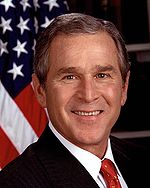
George W. Bush
George W. Bush’s re-election campaign in 2004 was largely funded by special interest groups such as financial banks and large industrial corporations.
More often than not, lobbying coalitions enter into conflict with each other. For example, in the issue of free trade, some corporate lobbyists seek to eliminate or dismantle tariffs, promoting free trade and the free movement of goods and services. By contrast, lobbyists representing farmers and rural interests seek to maintain or reinforce existing tariffs. It is in their best interest to preserve the status quo. If tariffs are reduced or eliminated, then American farmers are forced to compete with farmers from other trading countries. As these coalitions enter into conflict, congressmen must choose how to vote in the face of different pressures from different constituencies.
7.2: Interest Group Strategies
7.2.1: Direct Lobbying
Direct lobbying is used to influence legislative bodies directly via communication with members of the legislative body.
Learning Objective
Describe direct lobbying
Key Points
- During the direct lobbying process, the lobbyist introduces to the legislator information that may supply favors, may otherwise be missed or makes political threats.
- Direct lobbying is different from grassroots lobbying, a process that uses direct communication with the general public.
- Direct lobbying is often used alongside grassroots lobbying.
Key Terms
- grassroots lobbying
-
A process that uses direct communication with the general public, which, in turn, contacts and influences the government.
- legislative bodies
-
Legislative bodies are a kind of deliberative assembly with the power to pass, amend and repeal laws.
- direct lobbying
-
Direct lobbying refers to methods used by lobbyists to influence legislative bodies through direct communication with members of the legislative body, or with a government official who formulates legislation.
Direct lobbying refers to methods used by lobbyists to influence legislative bodies through direct communication with members of the legislative body, or with a government official who participates in formulating legislation .
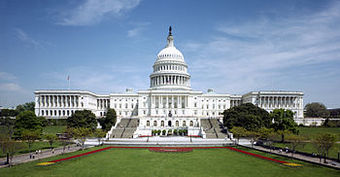
Direct Lobbying
Both the U.S. Senate and House of Representatives are subject to direct lobbying tactics by lobbyists.
During the direct lobbying process, the lobbyist introduces to the legislator information that may supply favors, may otherwise be missed or makes political threats. A common use of direct lobbying is to persuade the general public about a ballot proposal. In this case, the public is considered to be the legislator. This aspect of direct lobbying attempts to alter the legislature before it is placed on the ballot. Communications regarding a ballot measure are also considered direct lobbying. Direct lobbying is different from grassroots lobbying, a process that uses direct communication with the general public, which, in turn, contacts and influences the government.
Washington, D.C. is the home to many firms that employ these strategies. Lobbyists often attempt to facilitate market entry through the adoption of new rules, or the revision of old ones. They also remove regulatory obstacles for a company looking to grow, while also stopping others from attaining regulatory changes that would harm a company’s cause.
Meta-analysis reveals that direct lobbying is often used alongside grassroots lobbying. There is evidence that groups are much more likely to directly lobby previous allies rather than opponents. Allies are also directly lobbied if a counter lobby is brought to light. When groups have strong ties to a legislator’s district, they will use a combination of grassroots and direct lobbying, even if the legislator’s original position does not support theirs. When strong district ties are not present, groups will rely on direct lobbying with committee allies.
7.2.2: Direct Techniques
Lobbyists employ direct lobbying in the United States to influence United States legislative bodies through direct interaction with legislators.
Learning Objective
Identify the direct techniques used by interest groups to influence policy and what groups would use them
Key Points
- Revolving door is a term used to describe the cycling of former federal employees into jobs as lobbyists while former lobbyists are pulled into government positions.
- There have been several efforts to regulate the lobbying sector including the Lobbying Disclosure Act of 1995 and the Honest Leadership and Open Government Act.
- Direct lobbying is different from grassroots lobbying, a process that uses direct communication with the general public, who in turn, contacts and influences the government.
Key Terms
- Lobbying Disclosure Act
-
The Lobbying Disclosure Act of 1995 signed into law by President Bill Clinton was revised in 2006 to require the registration of all lobbying entities to occur shortly after the individual lobbyist makes a first plan to lobby any highly ranked federal official.
- Honest Leadership and Open Government Act
-
The Honest Leadership and Open Government Act, signed September 15, 2007 by President Bush, requires a quarterly report on lobby spending, places restrictions on gifts to Congress members, provides for mandatory disclosure of earmarks in expenditure bills, and places restrictions on the revolving door in direct lobbying.
- direct lobbying
-
Direct lobbying in the United States consists of methods used by lobbyists to influence U.S. legislative bodies through direct interaction with those who have influence on the legislature.
Direct lobbying in the United States consists of methods used by lobbyists to influence the United States legislative bodies . Interest groups from many sectors spend billions of dollars on lobbying. There are three lobbying laws in the U.S. that require a lobbying entity to be registered, allow nonprofit organizations to lobby without losing their nonprofit status, require lobbying organizations to present quarterly reports, places restrictions on gifts to U.S. Congress members, and makes it mandatory for earmarks to be disclosed in expenditure bills. Revolving door, when a former federal employee becomes a lobbyist and vice-versa, occurs in the direct lobbying sector.
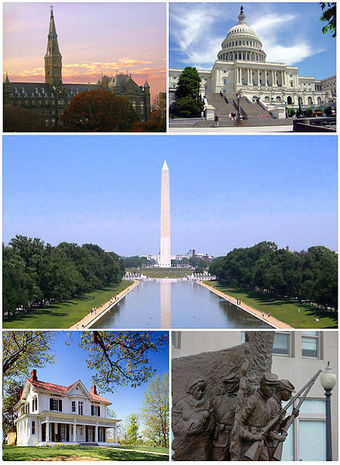
Washington D.C., Lobbyist Central
As Washington D.C. is the seat of the United States Federal Government, it attracts a high concentration of lobbyists.
Theory
Lobbying is a common practice at all levels of legislature. Direct lobbying is done either through direct communication with members or employees of the legislative body, or with a government official who participates in formulating legislation. During the direct lobbying process, the lobbyist introduces statistics that will inform the legislator of any recent information that might otherwise be missed, and may make political threats or promises, and/or grant favors. Communications regarding a ballot measure are also considered direct lobbying. Direct lobbying is different from grassroots lobbying, a process that uses direct communication with the general public, who in turn contact and influence the government.
The most common goals of lobbyists are:
- to facilitate market entry through the adoption of new rules, or the repeal or revision of old ones.
- to remove regulatory obstacles that prevent the growth of a company.
- to stop others from attaining regulatory changes that would harm the business of one’s company’s or one’s cause.
Direct lobbying is often used alongside grassroots lobbying. When groups have strong ties to a legislator’s district, those groups will use a combination of grassroots and direct lobbying, even if the legislator’s original position does not support theirs, which may help groups expand their coalitions. When strong district ties are not present, groups tend to rely on direct lobbying with committee allies.
Spending
In 2010, the total amount spent on lobbying in the U.S. was $3.5 billion . The top sectors for lobbying as of 2010 are financial, insurance, and real estate, with $4,405,909,610 spent on lobbying. Health is the second largest sector by spending, with $4,369,979,173 recorded in 2010.
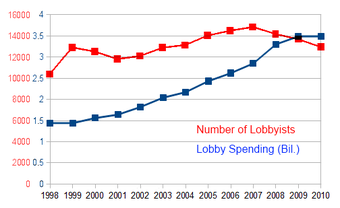
Spending on Lobbying
This graph compares the number of lobbyists with the amount of lobby spending.
The oil and gas sector companies are among the biggest spenders on lobbying. During the 2008 elections, oil companies spent a total of $132.2 million into lobbying for law reform. The three biggest spenders from the oil and gas sector are Koch Industries (1,931,562), Exxon ( ), and the Mobil Corporation (1,192,361).
Lobbying Laws
Lobbying Disclosure Act
The Lobbying Disclosure Act of 1995 was signed into law by President Bill Clinton . Under a January 1, 2006 revision, the act requires the registration of all lobbying entities with the Secretary of the Senate and the Clerk of the House of Representatives. The registration must occur within 45 days after the individual lobbyist makes a first plan to lobby. Penalizations include fines of over $50,000 and being reported to the United States Attorney.
Public Charity Lobbying Law
The Public Charity Lobbying Law gives nonprofit organizations the opportunity to spend about 5% of their revenue on lobbying without losing their nonprofit status with the Internal Revenue Service. Organizations must elect to use the Public Charity Law, and so increase the allowable spending on lobbying to increase to 20% for the first $500,000 of their annual expenditures. Another aspect to the law is the spending restrictions between direct lobbying and grassroots lobbying—no more than 20% can be spent on grassroots lobbying at any given time, while 100% of the lobbying expenditures can be on direct lobbying.
Honest Leadership and Open Government Act
The Honest Leadership and Open Government Act was signed on September 15, 2007 by President Bush, amending the Lobbying Disclosure Act of 1995. The bill includes provisions that require a quarterly report on lobby spending by organizations, places restrictions on gifts to Congress members, provides for mandatory disclosure of earmarks in expenditure bills, and places restrictions on the revolving door in direct lobbying.
Revolving Door
Revolving door is a term used to describe the cycling of former federal employees into jobs as lobbyists, while former lobbyists are pulled into government positions. Government officials with term limits form valuable connections that could help influence future law-making even when they are out of office. The other form of the revolving door is pushing lobbyists into government positions, developing connections, and returning into the lobbying world to use said connections. A total of 326 lobbyists are part of the Barack Obama Administration . In the past, 527 lobbyists were part of the Bush Administration, compared to 358 during the Clinton Administration.
7.2.3: Indirect Techniques
Grassroots lobbying asks the public to contact legislators concerning the issue at hand, as opposed to going to the legislators directly.
Learning Objective
Identify the indirect techniques used by interest groups to influence legislation
Key Points
- A grassroots lobby puts pressure on the legislature to address the concerns of a particular group by mobilizing that group, usually through raising public awareness and running advocacy campaigns.
- A group or individual classified as a lobbyist must submit regular disclosure reports; however, reporting requirements vary from state to state.
- The unique characteristic of grassroots lobbying, in contrast to other forms of lobbying, is that it involves stimulating the politics of specific communities.
Key Term
- indirect lobbying
-
Grassroots lobbying, or indirect lobbying, is a form of lobbying that focuses on raising awareness in the general population of a particular cause at the local level, with the intention of influencing the legislative process.
Grassroots lobbying
Grassroots lobbying, or indirect lobbying, is a form of lobbying that focuses on raising awareness for a particular cause at the local level, with the intention of influencing the legislative process. Grassroots lobbying is an approach that separates itself from direct lobbying through the act of asking the general public to contact legislators and government officials concerning the issue at hand, as opposed to conveying the message to the legislators directly.
The unique characteristic of grassroots lobbying, in contrast to other forms of lobbying, is that it involves stimulating the politics of specific communities. Interest groups, however, do not recruit candidates to run for office. Rather, they choose to influence candidates and public officials using indirect tactics of advocacy.
Tactics
The main two tactics used in indirect advocacy are contacting the press (by either a press conference or press release), and mobilizing the mass membership to create a movement.
Media Lobbying
Grassroots lobbying oftentimes implement the use of media, ranging from television to print, in order to expand their outreach. Other forms of free media that make a large impact are things like boycotting, protesting, and demonstrations.
Social Media
The trend of the past decade has been the use of social media outlets to reach people across the globe. Using social media is, by nature, a grassroots strategy.
Mass movements
Mobilizing a specific group identified by the lobby puts pressure on the legislature to address the concerns of this group. These tactics are used after the lobbying group gains the public’s trust and support through public speaking, passing out flyers, and even campaigning through mass media.
Trends
Trends from the past decade in grassroots lobbying include an increase in the aggressive recruitment of volunteers, as well as starting campaigns early on, before the legislature has made a decision. Also, lobbying groups have been able to create interactive websites and utilize social media (including Facebook and Twitter) to email, recruit volunteers, assign them tasks, and keep the goal of the lobbying group on track.
Regulations
Lobbying is protected by the First Amendment rights of speech, association, and petition . Federal law does not mandate grassroots lobbying disclosure, yet 36 states regulate grassroots lobbying. There are 22 states that define lobbying as direct or indirect communication to public officials, and 14 additional states that define it as any attempt to influence public officials. A group or individual classified as a lobbyist must submit regular disclosure reports; however, reporting requirements vary from state to state. Some states’ disclosure requirements are minimal and require only registration, while other states’ requirements are extensive, including the filing of monthly to quarterly expense reports, which include all legislative activity relevant to the individual or groups activities, amounts of contributions and donations, and the names and addresses of contributors and specified expenses. Penalties range from civil fines to criminal penalties if regulations are not complied with.
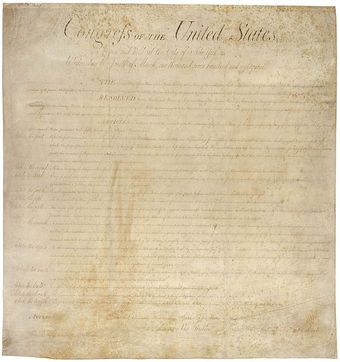
Bill of Rights
The First Amendment rights of free speech, freedom of association, and freedom of petition protect lobbying, including grassroots lobbying.
7.2.4: Cultivating Access
Access is important and often means a one-on-one meeting with a legislator.
Learning Objective
Describe how lobbying and campaign finance intersect
Key Points
- Getting access can sometimes be difficult, but there are various avenues: email, personal letters, phone calls, face-to-face meetings, meals, get-togethers, and even chasing after congresspersons in the Capitol building.
- When getting access is difficult, there are ways to wear down the walls surrounding a legislator.
- One of the ways in which lobbyists gain access is through assisting congresspersons with campaign finance by arranging fundraisers, assembling PACs, and seeking donations from other clients.
Key Terms
- PACs
-
A political action committee (PAC) is any organization in the United States that campaigns for or against political candidates, ballot initiatives or legislation.
- access
-
A way or means of approaching or entering; an entrance; a passage.
Access is important and often means a one-on-one meeting with a legislator . Getting access can sometimes be difficult, but there are various means one can try: email, personal letters, phone calls, face-to-face meetings, meals, get-togethers, and even chasing after congresspersons in the Capitol building. One lobbyist described his style of getting access as “not to have big formal meetings, but to catch members on the fly as they’re walking between the House and the office buildings. “
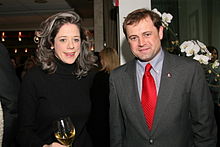
Cultivating Access
Connections count: Congressperson Tom Perriello with lobbyist Heather Podesta at an inauguration party for Barack Obama.
When getting access is difficult, there are ways to wear down the walls surrounding a legislator. Lobbyist Jack Abramoff explains:
Access is vital in lobbying. If you can’t get in your door, you can’t make your case. Here we had a hostile senator, whose staff was hostile, and we had to get in. So that’s the lobbyist safe-cracker method: throw fundraisers, raise money, and become a big donor. —Abramoff in 2011
One of the ways in which lobbyists gain access is through assisting congresspersons with campaign finance by arranging fundraisers, assembling PACs, and seeking donations from other clients. Many lobbyists become campaign treasurers and fundraisers for congresspersons. This helps incumbent members cope with the substantial amounts of time required to raise money for reelection bids; one estimate was that Congresspersons had to spend a third of their working hours on fundraising activity. PACs are fairly easy to set up; all they require is a lawyer and about $300.
An even steeper possible reward which can be used in exchange for favors is the lure of a high-paying job as a lobbyist. According to Abramoff, one of the best ways to “get what he wanted” was to offer a high-ranking congressional aide a high-paying job after they decided to leave public office. When such a promise of future employment was accepted, according to Abramoff, “we owned them”. This helped the lobbying firm exert influence on that particular congressperson by going through the staff member or aide. At the same time, it is hard for outside observers to argue that a particular decision, such as hiring a former staffer into a lobbying position, was purely as a reward for some past political decision, since staffers often have valuable connections and policy experience needed by lobbying firms. Research economist Mirko Draca suggested that hiring a staffer was an ideal way for a lobbying firm to try to sway their old bosses—a congressperson—in the future.
7.2.5: Mobilizing Public Opinion
Increasingly, lobbyists seek to influence politics by putting together large coalitions and using outside lobbying to sway public opinion.
Learning Objective
Differentiate between direct and indirect lobbying efforts
Key Points
- Efforts to influence Congress indirectly, by trying to change public opinion, are often referred to as indirect lobbying.
- Larger, more diverse, and more wealthy coalitions tend to be the most effective at outside lobbying (the “strength in numbers” principle applies).
- Increasingly, in order to influence elections, lobbyists have put together large coalitions and mobilized outside lobbying efforts aimed at swaying and controlling public opinion.
Key Terms
- indirect lobbying
-
Efforts to influence Congress indirectly by trying to change public opinion. These efforts depend on the fact that politicians must frequently appeal to the public during regular election cycles.
- direct lobbying
-
Direct lobbying refers to methods used by lobbyists to influence legislative bodies through direct communication with members of the legislative body, or with a government official who formulates legislation.
- public opinion
-
The opinion of the public, the popular view.
In 1953, following a lawsuit that included a congressional resolution that authorized a governmental committee to investigate “all lobbying activities intended to influence, encourage, promote, or retard legislation,” the Supreme Court narrowly construed “lobbying activities” to mean only “direct” lobbying. The Court defined this “direct” method of lobbying as “representations made directly to the Congress, its members, or its committees”. It contrasted this with indirect lobbying, which it defined as efforts to influence Congress indirectly by trying to change public opinion.

Mobilizing Public Opinion
Large health notices on tobacco products is one way in which the anti-smoking lobby and the government have tried to mobilize public opinion against smoking.
Increasingly, lobbyists seek to influence politics by putting together coalitions and by utilizing outside lobbying to mobilize public opinion on issues. Larger, more diverse, and more wealthy coalitions tend to be more effective at outside lobbying (the “strength in numbers” principle often applies). These groups have been defined as “sustainable coalitions of similarly situated individual organizations in pursuit of like-minded goals. ” According to one study, it is often difficult for a lobbyist to influence a staff member in Congress directly, because staffers tend to be well-informed, and because they frequently hear views from competing interests. As an indirect tactic, lobbyists often try to manipulate public opinion which, in turn, can sometimes exert pressure on congresspersons, who must frequently appeal to that public during electoral campaigns. One method for exerting this indirect pressure is the use of mass media. Interest groups often cultivate contacts with reporters and editors and encourage these individuals to write editorials and cover stories that will influence public opinion regarding a particular issue. Because of the important connection between public opinion and voting, this may have the secondary effect of influencing Congress. According to analyst Ken Kollman, it is easier to sway public opinion than a congressional staff member, because it is possible to bombard the public with “half-truths, distortion, scare tactics, and misinformation. ” Kollman suggests there should be two goals in these types of efforts. First, communicate to policy makers that there is public support behind a particular issue, and secondly, increase public support for that issue among constituents. Kollman asserted that this type of outside lobbying is a “powerful tool” for interest group leaders. In a sense, using these criteria, one could consider James Madison as having engaged in outside lobbying. After the Constitution was proposed, Madison wrote many of the 85 newspaper editorials that argued for people to support the Constitution. These writings later came to be known as the Federalist Papers. As a result of Madison’s “lobbying” effort, the Constitution was ratified, although there were narrow margins of victory in four of the states.
Lobbying today generally requires mounting a coordinated campaign, which can include targeted blitzes of telephone calls, letters, and emails to congressional lawmakers. It can also involve more public demonstrations, such as marches down the Washington Mall, or topical bus caravans. These are often put together by lobbyists who coordinate a variety of interest group leaders to unite behind a hopefully simple, easy-to-grasp, and persuasive message.
7.2.6: Using Electoral Politics
A number of interest groups have sought out electoral politics as a means of gaining access and influence on broader American policies.
Learning Objective
Give an example of an interest group making determined use of electoral politics
Key Points
- One example of an interest group using electoral politics is the National Caucus of Labor Committees.
- in 1972, the NCLC launched the U.S. Labor Party (USLP), a registered political party, as its electoral arm. They later nominated LaRouche for President of the United States.
- The National Caucus of Labor Committees (NCLC) is a political cadre organization in the United States founded and controlled by political activist Lyndon LaRouche, who has sometimes described it as a “philosophical association”.
Key Terms
- electoral politics
-
An election is a formal decision-making process by which a population chooses an individual to hold public office.
- interest group
-
Collections of members with shared knowledge, status, or goals. In many cases, these groups advocate for particular political or social issues.
All electoral politics are interest politics in some sense. Over the course of American history, a number of interest groups have sought out electoral politics as a means of gaining access and influence on broader American policies. One example of an interest group using electoral politics is the National Caucus of Labor Committees (NCLC).
The NCLC is a political cadre organization in the United States, founded and controlled by political activist Lyndon LaRouche, who has sometimes described it as a “philosophical association. “
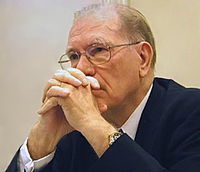
Lyndon LaRouche
LaRouche was the leader of the National Caucus of Labor Committees, an interest group that later developed a distinct political party that nominated LaRouche for president of the U.S.
LaRouche is the NCLC’s founder and the inspiration for its political views. (For more information on these views see the article “Political Views of Lyndon LaRouche,” as well as the main article titled “Lyndon LaRouche. ” An overview of LaRouche’s organizations is in “LaRouche movement. “) The highest group within the NCLC is the “National Executive Committee” (NEC), described as the “inner leadership circle” or “an elite circle of insiders” that “oversees policy. ” The next most senior group is the “National Committee” (NC), which is reportedly “one step beneath the NEC. “
In 1972, the NCLC launched the U.S. Labor Party (USLP), a registered political party, as its electoral arm. In 1976, they nominated LaRouche for President of the United States on the Labor Party ticket, along with numerous candidates for lower office. In 1979, LaRouche changed his political strategy to allow him to run in the Democratic primaries, rather than as a third party candidate. This resulted in the USLP being replaced by the National Democratic Policy Committee (NDPC) a political action committee unassociated with the Democratic National Committee.
7.3: Types of Interest Groups
7.3.1: Business and Economic Interest Groups
Economic interest groups advocate for the economic benefit of their members, and business interests groups are a prominent type of economic interest group.
Learning Objective
Identify the organization and purpose of business and economic interest groups
Key Points
- Economic interest groups are one of the five broad categories of interest groups in the US.
- These groups advocate for the economic interest and benefits of their members.
- Economic interest groups are varied and for and given issue there will be large number of competing interest groups. These category includes groups representing representing business, labor, professional and agricultural interests.
- Business interest groups generally promote corporate or employer interests.
Key Terms
- business group
-
a collection of parent and subsidiary companies that function as a single economic entity through a common source of control
- partisan
-
An adherent to a party or faction.
Business and Economic Interest Groups
Interest groups represent people or organizations with common concerns and interests. These groups work to gain or retain benefits for their members, through advocacy, public campaigns and even by lobbying governments to make changes in public policy. There are a wide variety of interest groups representing a variety of constituencies.
Economic Interest Groups
Economic interest groups are one of the five broad categories of interest groups in the US. These groups advocate for the economic interest and benefits of their members. Economic interest groups are varied, and for any given issue there will be a large number of competing interest groups. Categories of economic interest groups include those representing business, labor, professional and agricultural interests.
Business Interest Groups
Business interest groups generally promote corporate or employer interests. Larger corporations often maintain their own lobbyists to work on behalf of their specific interests. Companies and organizations will also come together in larger groups to work together on general business interests.
Umbrella organizations such as the US Chambers of Commerce (USCC) work around general business interests. While the name might suggest that this is a government agency, the USCC represents various business and trade organizations, and was formed as a counterbalance to the growing power of the labor movement in 1912. The USCC uses a wide variety of strategies and tactics in its work including lobbying or representation, and monitoring various laws and programs. USCC’s work is at times more partisan; for example, it might endorse a specific candidates.
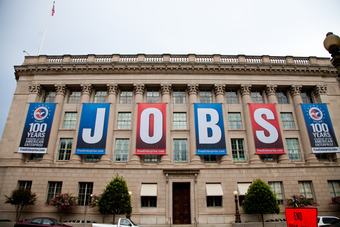
US Chamber of Commerce
This banner celebrating both jobs and free enterprise hung outside of the US Chamber of Commerce to commemorate the groups hundredth year.
Another example of an umbrella business interest group is the US Women’s Chamber of Congress (USWCC). The USWCC’s work could be described as agenda setting, as their work representing women in business attempts to bring attention to an issue that had been neglected. Like other business interest groups, USWCC will work though legal and lobbying to gain benefits for its constituency.
Because of how numerous and well funded business interest groups tend to be, there is always a concern that they are interfering with, rather than enhancing, the democratic process.
7.3.2: Labor Interest Groups
Labor interest groups advocate for the economic interests of workers and trade organizations.
Learning Objective
Explain the decline of labor interest groups and new kinds of organization
Key Points
- Labor interest groups are a type of economic interest group. Economic interest groups advocate for the economic benefit of their members and constituents.
- Labor interest groups advocate for the economic interests of workers and trade organizations.
- In addition to representing their members unions also often organized opportunities for direct citizen participation, along with public education and lobbying.
- Membership in private unions has steadily declines. In 2011 on 7% of workers were union members. Public workers are still unionized at much higher rates.
- New kinds of labor interest groups are developing to represent workers outside of the mainstream workforce, such as low-wage or freelance workers.
Key Terms
- Industrial Unionism
-
Industrial unionism is a labor union organizing method through which all workers in the same industry are organized into the same union—regardless of skill or trade—thus giving workers in one industry, or in all industries, more leverage in bargaining and in strike situations.
- craft unionism
-
Craft unionism refers to organizing a union in a manner that seeks to unify workers in a particular industry along the lines of the particular craft or trade that they work in by class or skill level.
Labor Interest Groups
Labor interest groups are a type of economic interest group. Economic interest groups advocate for the economic benefit of their members and constituents. There are a wide variety of types of economic interest groups, including labor groups which advocate on behalf of individual workers and trade organizations. In addition to representing their members, unions also often organize opportunities for direct citizen participation , along with public education and lobbying.
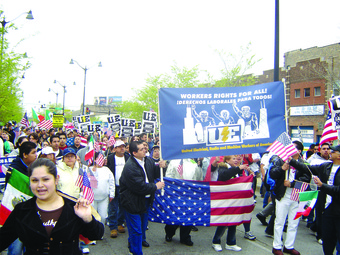
May Day Marches
May 1st is traditionally a day for protests and celebration for labor interest groups. In the US there is now also a focus on immigration and labor rights.
History of Labor Interest Groups
Some of the earliest unions in the US were formed by women in the textile industry in cities such as Lowell, Massachusetts. The National Labor Union (NLU) was the first American federation of unions formed in 1866. In these early days, unions lobbied against dangerous work conditions and for regulations around the work conditions of women and children. They also pushed for an eight hour work day and the right to strike.
The strength of labor interest groups continued in the 19th century. One example was the American Federation of Labor, a large umbrella group made up primarily of locals involved in craft unionism. While labor was more disorganized during the 1920s, the period during and right after WWII saw a continued growth of unions including the formation of the Congress of Industrial Organizations (CIO). The CIO was built around an industrial unionism model. These two major unions merged in 1955 to form the AFL-CIO.
Unions have had an uneven history with women and people of color. Some early unions, for example, specifically banned members who were Chinese or of Chinese decent. The Pullman’s union and the United Farm Workers unions are examples of unions that came together to advocate for the economic interests of African-American and latino workers.
Decline of Private Labor Interest Groups
With the reduction of manufacturing jobs in the US, the number of people represented by unions has fallen. Also, legislation such as the 1947 Taft-Hartley Act made it harder to organize by allowing individual states to ban “closed-shops. ” These are workplaces in which all new employees are required to join a union. Twenty-three states have such laws in place; these are the so-called “right-to-work” states.
While private union membership has declined, public unions are still quite strong. While only 7% of workers in the private sectors belong to unions, 31% of federal workers, 35% of state workers, and 46% of local government employees belong to unions.
New Kinds of Organizing
Even as traditional labor interest groups are seeing their numbers fall, there are new groups developing around new constituencies of workers who are outside of the mainstream workforce. Some examples include the National Domestic Workers Alliance, Domestic Workers United and the Restaurant Opportunities Center (ROC), which represent low-wage workers. These groups focus on member education as well as advocacy and public education, ensuring their members are aware of the rights that they are already entitled to as well as organizing around new economic benefits.
Another example is the Freelancers Union which provides health care for members who are independent workers. Many of these workers are high-skilled or creative workers who are not eligible for workplace related benefits. This union also works as an agenda building organization, bringing attention to the challenges of freelance workers including the high tax burden for independent workers.
7.3.3: Professional Interest Groups
Professional interest groups represent the economic interests for members of various professions including doctors, engineers, and lawyers.
Learning Objective
Classify professional interest groups that influence policy
Key Points
- Professional interest groups are another type of economic interest group. Economic interest groups advocate for the economic benefit of their members and constituents.
- While labor groups focused on trades and industrial labor, professional interest groups represent members of various professions including doctors and engineers.
- These groups also often set rule for their members, including rules about certification and conduct including professional codes of ethics.
- Professional organizations also provide direct economic benefits to their members. These benefits include personal or professional insurance as well as professional development opportunities.
Key Term
- professions
-
A job, especially one requiring a high level of skill or training.
Professional Interest Groups
Professional interest groups are another type of economic interest group. Economic interest groups advocate for the economic benefit of their members and constituents. There are many types of economic interest groups, including professional interest groups which organize and represent professional workers. While trade unions represent skilled and industrial labor, professional organizations represent skilled workers such as doctors, engineers, and lawyers.
These groups advocate for the economic interests of their members. They groups often set the rules for membership in their organizations. This includes rules about certification and conduct including professional codes of ethics. Professional organizations also provide direct economic benefits to their members. These benefits include access to personal or professional insurance as well as professional development opportunities.
One critique of professional organizations is that they serve to increase the income of their membership without any added value or service.
An example of a professional interest group is the American Medical Association (AMA), which represents doctors and medical students throughout the United States. The AMA conducts significant amounts of member and public education work, including publishing the Journal of the America Medical Association . It also carries out a substantial amount of charity work. Its broad mission is to promote the art and science of medicine for the betterment of the public health. However, it is also committed to advancing the interest of physicals, including economic interests. The AMA often lobbies on behalf of its members. For example, the AMA lobbied in campaigns against Medicare during the 1950’s and 1960’s. While the AMA now supports Medicare it did opposed attempts to create a national health care system. Another campaign that is directly related to economic interests is one to limit the damages awarded in medical malpractice suits.
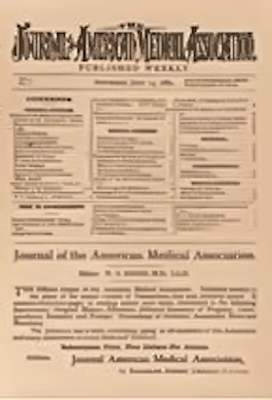
Journal of the America Medical Association
The first edition of the Journal of the American Medical Association. Today it is the most widely read medical journal in the world.
7.3.4: Agricultural Interest Groups
Agricultural interest groups are a type of economic interest group that represent farmers.
Learning Objective
Analyze the organization and purpose of agricultural interest groups
Key Points
- Agricultural interest groups are a type of economic interest group.
- Agricultural interest groups represent the economic interests of farmers, including issues such as crop prices, land use zoning, government subsidies, and international trade agreements.
- There is a long history of agricultural interest groups in the United States. An example is the American Farm Bureau Federation which started in 1911.
- Today, agricultural interest groups are often divided among themselves. There are various types of farms and farmers in the U.S. with conflicting interests.
Key Term
- yeoman farmer
-
Yeoman refers chiefly to a free man owning his own farm. Work requiring a great deal of effort or labor, such as would be done by a yeoman farmer, came to be described as yeoman’s work. Thus, yeoman became associated with hard toil.
Agricultural Interest Groups
Economic interest groups are varied. For any given issue, there will be large number of competing interest groups. Categories of economic interest groups include those representing business, labor, professional, and agricultural interests.
Agricultural interest groups represent the economic interests of farmers. These interests include business and agricultural extension concerns, as well as matters of local, national, and even international policy. These include crop prices, land use zoning, government subsidies, and international trade agreements.
There is a long history of agricultural interest groups in the United States. An example is the American Farm Bureau Federation which was founded in 1911. As a result of the majority of the country’s rural history, agricultural concerns have long been of great importance. Specifically, the vision of the yeoman farmer was one of the important American archetypes moving into the progressive era.
Today, agricultural interest groups are often divided among themselves. There are various types of farms and farmers in the U.S. that often have conflicting interests. For example, a policy that is beneficial to large scale agribusiness might be highly damaging for small, family farms.
Agricultural interest groups range from large agribusiness, to groups such as the Farm Bureau representing mid-sized and commodity crop farmers, to the Farmers Market Coalition which advocates for policies that would benefit local farm production.
Organizations such as the Farmers Market Coalition represents a fairly new type of agricultural interest group. These are the groups advocating for policies that would support the renewal of small and local agriculture. One example are advocacy around the Farmers’ Market Nutrition Program/Senior Farmers’ Market Nutrition Program . These programs provide fresh, locally produced fruits and vegetables for participants in other government nutritional subsidy programs. By sourcing local foods these programs also provide direct economic benefits for local farmers.

Farmers Market
Small farmers are just one part of the larger group of farmers involved in agricultural interest groups.
7.3.5: Environmental Interest Groups
Environmental interest groups are public-interest groups that advocate around conservation and ecological issues.
Learning Objective
Identify the historical origins and purpose of environmental interest groups
Key Points
- Environmental interest groups are generally public-interest groups, as their work benefits a wider community beyond their own active membership. They advocate for conservation and ecological issues.
- There is a long history of conservation and early forms of environmentalism in the US. Some early conservationists were members of the transcendental movement which developed in the 1830s.
- Today environmental interests groups are extremely varied, and while they all share some concern for conversation or the environment, many hold conflicting views.
- Different types of environmental interest groups include conservation, environmental justice, ecology, and bright green environmentalism.
Key Terms
- greenwash
-
A false or misleading picture of environmental friendliness used to conceal or obscure damaging activities.
- direct action
-
A form of political activism, in which participants act directly, ignoring established political procedures. This is often (but not always) accomplished by means of strikes, workplace occupations, sabotage, sit-ins, squatting, revolutionary/guerrilla warfare, demonstrations, vandalism, or graffiti.
- environmental racism
-
Environmental racism is inequality — in the form of racism linked with environmental factors and practices — that causes disproportionate distress on minority communities.
Environmental Interest Groups
Environmental interest groups are generally public-interest groups, as their work benefits a wider community beyond their own active membership. These groups advocate around conservation and ecological issues. Interest groups in general are groups represent people or organizations with common concerns and interests. These groups work to gain or retain benefits for their members, or to make general changes for the public good.
There is a long history of conservation and early forms of environmentalism in the US. Some early conservationists were members of the transcendental movement which developed in the 1830s, and represented a general rejection of the rise in urbanization in the US. They advocated for meaningful and consistent interactions with nature, often employing poetic language to describe their ideals for a human environmental relationship. Ralph Waldo Emerson and Henry David Thoreau were both part of this movement.
Today environmental interests groups are extremely varied, and while they all share some concern for conversation or the environment, many hold conflicting views about levels of conservation versus for example stewardship, and about appropriate strategies for pursuing their interests.
Some of the different types of environmentalism include the conservation movement, mostly focused on preserving land for sustainable use; the environmental justice movement that developed as a reaction to environmental racism in the US and particular in urban areas; the ecology movement, focused on human relationships and responsibilities to the environment; and bright green environmentalism, which looks at technological and design solutions to environmental question.
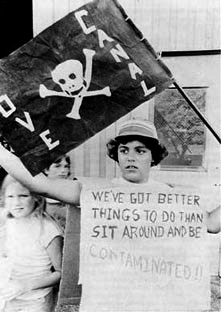
Love Canal
This 1978 protest at Love Canal was one of the early events in the environmental justice movement.
Each of these groups will use different strategies including scientific research, and public education as well as lobbying and litigation. Environmental groups are also known for their use of *direct action* techniques. These actions range from the work of Greenpeace in disrupting nuclear tests, or whaling to removing genetically modified crops to groups such as the Earth Liberation Front who take a more radical approach and regularly conduct destructive actions as a part of their work.
There are criticisms of environmental interest group including the concern that not all of their claims are scientifically sound, and the complaint that environmental actions or regulations will disrupt business.
On the other hand some business groups have also taken up environmental causes, with business practices and promotion geared towards members and supporters of environmental interests. However other businesses have started to greenwash their products, leading environmental and consumer interest groups to pressure governments to regulate environmental product claims.
7.3.6: Consumer Interest Groups
Consumer Interest Groups advocate for consumer rights and information.
Learning Objective
Classify consumer interest groups and their influence in policy-making
Key Points
- Consumer Interest Groups can be considered public-interest groups because they focus on the issues and interests of consumers rather than providing exclusive economic benefits to a closed set of members.
- The Better Business Bureau (BBB) and the Consumer Union, who publishes the Consumer Reports, are two examples of consumer groups concerned with a broad range of consumer goods.
- These groups focus on a number of different issues including product safety, price issues and consumer notification.
- Consumer Interest Groups employ a variety of strategies– from lobbying to public campaigns.
- They also provide important checks and balances to business interests, make market exchanges more transparent, and help consumers make more informed choices.
Key Term
- arbitration
-
A process through which two or more parties use an arbitrator or arbiter (an impartial third party) in order to resolve a dispute.
Consumer Interest Groups
Interest groups represent people or organizations with common concerns and interests. These groups work to gain or retain benefits for their members, or to make general changes for the public good. Consumer Interest Groups focus on the issues and interests of consumers .

Consumers
Consumer Interest Groups represent, protect, and inform consumers.
Consumer Interest Groups can be considered public-interest groups since their work benefits consumers rather than providing exclusive economic benefits to a closed set of members.
These groups focus on a number of different issues that include product safety, price issues, and consumer notification. They employ a variety of strategies– from lobbying to public campaigns. In these ways Consumer Interest Groups protect and represent consumers. They also provide important checks and balances to business interests, make market exchanges more transparent, and help consumers make more informed choices.
Two examples of consumer groups concerned with a broad range of consumer goods are the Better Business Bureau (BBB) and the Consumer Union, who publishes the Consumer Reports. The BBB works to advance marketplace trust by publishing business reviews and providing a dispute resolution process. This process allows consumers with conflicts or complaints regarding a particular business receive arbitration through the BBB. Consumer Reports is known for its rigorous product testing including side-by-side comparison of similar products. Consumer Reports also continues to do lobbying work around issues such as telecommunications and mass media, health care, and product safety.
Consumer Interest Groups can also be single-issue interests groups. In a very different vein from the example above, the British Campaign for Real Ale (CAMRA) is one of the oldest and largest single-issue consumer interest groups in the UK. They work to promote quality, choice, and value. They support small pubs with a community focus, promote traditional beers and ciders, and seek to improve licensing permits.
7.3.7: Ideological Interest Groups
Ideological interest groups unite on issues, with their work driven by deeply held beliefs.
Learning Objective
Describe ideological interest groups and their role in the policy-making process
Key Points
- Interest groups represent people or organizations who have common concerns and interests.
- Ideological interest groups might work on various different issues, but their work is driven by deeply held beliefs.
- The ideology of any given group can range from regressive or conservative, to liberal or libertarian, or to progressive or radical.
- These types of interest groups use a variety of strategies including education, representation, participation, and advocacy that includes lobbying and litigation.
Key Term
- ideology
-
Doctrine, philosophy, body of beliefs or principles belonging to an individual or group.
Ideological Interest Groups
Interest groups represent people or organizations with common concerns and interests. These groups work to gain or retain benefits for their members, or to make general changes they perceive to be for the public good. Interest groups work through advocacy, public campaigns, and even directly lobbying governments to change public policy. There are a wide range of ideological interest groups that represent many different constituencies.
Types of Ideological Interest Groups
Ideological interest groups often work on a variety of specific issues, with their work driven by deeply held beliefs. The ideology, or collective beliefs, of any given group might range from regressive or conservative, to liberal or libertarian, or to progressive or radical.
Some examples of ideological interest groups include the National Organization for Women (NOW), the National Taxpayers Union, the National Association for the Advancement of Colored People (NAACP), and the Christian Coalition. Each organization has an ideological point of view that determines which specific issues or campaigns they get involved in and which side of an issue they take. Additionally, these organizations use a variety of strategies including public education, representation, member participation, and advocacy with governments that includes lobbying and litigation.
NOW is an example of an ideological interest group. It is a liberal feminist organization, and its main mission is advocating for equality and full societal participation for women. However, NOW also works on a number of other issues. The current priorities for NOW include constitutional equality, violence against women, diversity/racism, abortion rights/reproductive issues, lesbian rights, and economic justice.
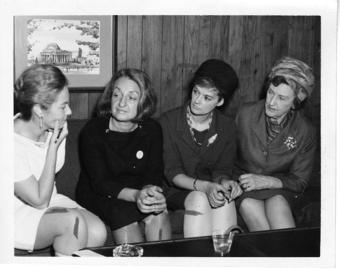
Leaders of NOW
National Organization for Women (NOW) founder and president Betty Friedan; NOW co-chair and Washington, D.C., lobbyist Barbara Ireton; and feminist attorney Marguerite Rawalt.
On the other hand, the Christian Coalition favors a conservative Christian ideology. The stated goal of the organization is to represent Christians who support a traditional family point of view.The group works on a variety of more specific issues such as disputing abortion, improving traditional education, and lowering taxes.
Some groups fall between being single issue groups or ideological interest groups. Examples include the National Rifle Association (NRA), a gun rights advocacy group, or AIDS Coalition to Unleash Power (ACT UP), an LGBTQ group advocating around AIDS research and health. While both focus on one main unifying issue, their advocacy work is also driven by larger ideological concerns.
7.3.8: Public Interest Groups
Public interest groups advocate for what they consider to be the public good.
Learning Objective
Illustrate how interest groups work for the public interest
Key Points
- Interest groups represent people or organizations with common concerns and interests.
- Public interest groups work on issues that impact the general public, rather than a small group of members.
- One of the challenges that public interest groups face is the difficulty in defining a single idea of the public good in a pluralist society.
- One of the challenges, or criticisms of public interest groups is the difficulty in defining a single idea of the public good in a pluralist society.
Key Terms
- free rider
-
One who obtains benefit from a public good without paying for it directly.
- pluralism
-
A social system based on mutual respect for each other’s cultures among various groups that make up a society, wherein subordinate groups do not have to forsake their lifestyle and traditions and can express their culture and participate in the larger society free of prejudice.
- public interest group
-
a group concerned with the common well-being or general welfare of the population
Public Interest Groups
Interest groups represent people or organizations with common concerns and interests. These groups work to gain or retain benefits for their members, or to make general changes for the public good. Interest groups work through advocacy, public campaigns, and even lobbying governments to make changes in public policy. There are a wide variety of interest groups representing a variety of constituencies. For example, public interest groups work on issues that impact the general public, rather than a select group of members. These groups advocate for their ideals of general good, or common well-being. Some of the issues a public interest group might address include health, the environment, and the political system.
One of the challenges, or criticisms, of public interest groups is the difficulty in defining a single idea of the public good in a society that values pluralism, such as the United States. Because of this difficulty, even when there is consensus around the good of a broad topic, the work of a single public interest group might still be controversial.
An example is in education where most agree that education is a public good, but there are strong disagreements over how to achieve that, or over what sort of education would be best. Groups like the National Education Association, a teachers union and general public interest group, might still be seen by some as primarily promoting teachers’ rights. While a program such as the charter school program might be seen as weakening public schools.

Public interest groups
Public interest groups advocate for issues that impact the general public, such as education.
Another challenge for public-interest groups is the so-called free rider effect. Because the benefits brought about by public interest groups benefit a large group of individuals, there is less direct incentive for people to become involved in an organization’s work since they will still gain from the work even if they remain inactive.
7.3.9: Single-Issue Interest Groups
Single-issue interest groups focus on advocacy around a single defining issue.
Learning Objective
Give examples of single-issue interest groups
Key Points
- Interest groups use various forms of advocacy in order to influence public opinion and/or policy.
- Single-issue interest groups focus on advocacy around a single defining issue.
- These groups focus on a diverse array of issues including abortion, taxation, and animal rights.
- Because of their singular focus, these groups are known for the intensity of their lobbying.
- The National Riffle Associate (NRA) is arguably the best known, and most influential single-issue interest group in the United States.
Key Terms
- lobbying
-
Lobbying (also lobby) is the act of attempting to influence decisions made by officials in the government, most often legislators or members of regulatory agencies.
- constituencies
-
interest groups or fan bases
- issue network
-
an alliance of various interest groups and individuals who unite in order to promote a single concern in government policy
Single-Issue Interest Groups
Interest groups use various forms of advocacy in order to influence public opinion and/or policy. Interest groups work through advocacy, public campaigns, and even lobbying governments to make changes in public policy. There are a wide variety of interest groups representing a variety of constituencies.
As the name suggests, these are groups that focus all of their energy on a single defining issue. Their membership is often quite devoted to the issue, and motivated by personal experiences or to participation in ongoing social movements. There are a growing number of single-issue interest groups in the US. These groups focus on a diverse array of issues including abortion, taxation, and animal rights. Because of their singular focus these groups are known for the intensity of their lobbying.
An example of a single-issue interest group is Mothers Against Drunk Driving (MADD), which was formed by a mother whose teenaged daughter was killed by a drunk driver. The organization now lobbies heavily to stop drunk driving as well as supporting the victims of drunk driving and preventing underage drinking.
Another example is the National Riffle Associate (NRA, ), which is also, arguably, the best known and most influential single-issue interest group on the United States. The NRA lobbies in favor of the right of individuals to own and use fire arms. It also lobbies against any laws that its members and leadership see as abridging this right or invading the privacy of gun owners. The NRA spent $10 million dollars campaigning during the 2008 presidential election. Some see this as proof that the NRA has too much influence in government, while others would simple describe it as evidence of the broad support for the organization. However you interpret the actions of the NRA, they have been successful in their efforts, since the United States has the least restrictive gun laws of any country in the Global North.
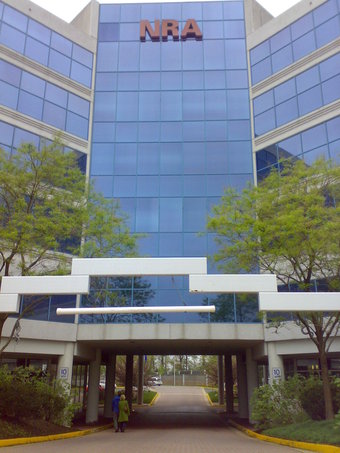
National Rifle Association (NRA) Headquarters
The NRA is one of the best known, and arguably the most influential single-issue interest group in the US.
7.3.10: Governmental Interest Groups
Government interest groups are a unique type of interest group that represents the interests of government to other governments.
Learning Objective
Give examples of government interest groups and their influence on policy
Key Points
- Government interest groups are a unique form of interest groups that represent the interests of government to other governments.
- City and state governments, for example might lobby in Washington to pursue their goals and gain benefits.
- As with other interest groups many government interest groups also conduct work in public education and media campaigns in addition to their direct advocacy work.
- Foreign governments may also send representatives to make their case with Congress and the executive branch.
Key Terms
- New Federalism
-
New Federalism is a political philosophy of devolution, or the transfer of certain powers from the United States federal government back to the states.
- lobby
-
To attempt to influence (a public official or decision-maker) in favor of a specific opinion or cause.
- New Deal
-
The New Deal was a series of economic programs enacted in the United States between 1933 and 1936. They involved presidential executive orders or laws passed by Congress during the first term of President Franklin D. Roosevelt. The programs were in response to the Great Depression, and focused on what historians call the “3 Rs”: Relief, Recovery, and Reform.
Government Interest Groups
Government interest groups are a unique form of interest groups that represent the interests of government to other governments. City and state governments, for example, might lobby in Washington to pursue their goals and gain benefits. In many cases local governments are seeking more funding to carry out their work and responsibilities. This support often comes in the form of federal grants. At other times local governments may advocate for increased direct decision making powers, and control over new policy areas.
As with other interest groups many government interest groups also conduct work in public education and media campaigns in addition to their direct advocacy work.
US Government Interest Groups
The practice of local governments lobbying the federal government started with the New Deal during which an attempt was made to organize the distribution of funds and programs during that period. Since then local governments have continued their efforts. Major gains were made in the 1960s and 1970s, especially around social program funding.
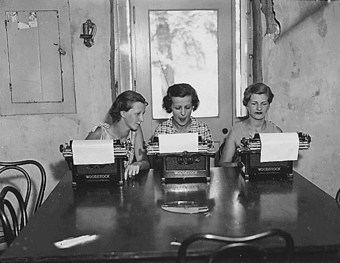
New Deal Programs
These women are learning new skills in a Federal Emergency Relief Administration (FERA) program in Pennsylvania during the Great Depression. FERA was part of the New Deal federal funding to state and local governments.
However, and particularly with President Reagan’s move towards what was known as New Federalism, there has been a move to shrink the size of the federal government and also federal grants. States and cities are now stuck between wanting continued support for their work, and wanting to be free of federal regulations.
Some government interest groups in the US include the National League of Cities, the National Conference of Mayors, and the National Governors Association.
The International Lobby
Additionally, foreign governments may send representatives to make their case with Congress and the executive branch. Again, the support they seek might be direct finding through aid, but might also involve economic arrangements such as trade deals including free trade arrangements or reduction of US tariffs.
7.4: Regulating Interest Groups
7.4.1: Regulating Congressional Lobbyists
Generally, the United States requires systematic disclosure of lobbying in all branches of government, including in Congress.
Learning Objective
Describe the key difficulties that make the regulation of lobbying activity challenging
Key Points
- The rules often specify how much a lobbyist can spend on specific activities, and how to report expenses; many of the laws and guidelines are specified in the Lobbying Disclosure Act of 1995.
- Sometimes defining clearly who is a “lobbyist” and what precisely are lobbying activities can be difficult.
- The legal ramifications of lobbying are further inter-tangled with aspects of campaign finance reform, since lobbyists often spend time seeking donations for the reelection efforts of congresspersons; sorting out these issues can pose ethical challenges.
- Supporters for regulating lobbying hold the view that existing regulations designed to rein in the excesses of lobbying have not been effective, and that reforms and regulations have not cleaned up the system “at all”.
- Laws requiring disclosure have been more prevalent in the twentieth century.
Key Terms
- lobbyist
-
A person remunerated to persuade (to lobby) politicians to vote in a certain way or otherwise use their office to effect a desired result.
- disclosure
-
The act of revealing something
The United States generally requires a systematic disclosure of lobbying, and it may be one of the few countries to have such extensive requirements. Disclosure in one sense allows lobbyists and public officials to justify their actions under the banner of openness and with full compliance of the law. The rules often specify how much a lobbyist can spend on specific activities, and how to report expenses. Many of the laws and guidelines are specified in the Lobbying Disclosure Act of 1995.
Clearly defining who is a “lobbyist” and what precisely are lobbying activities can sometimes be difficult. According to the Lobbying Disclosure Act, several authorized definitions include: Lobbying activities means “lobbying contacts and efforts in support of such contacts, including preparation and planning activities, research and other background work that is intended, at the time it is performed, for use in contacts, and coordination with the lobbying activities of others. ” Lobbying contact means “any oral or written communication (including an electronic communication) to a covered executive branch official or a covered legislative branch official.”
Distinguishing lobbyists from a strategic adviser can still be difficult, since the duties of each can often overlap and are hard to define precisely. There have been issues raised about what constitutes the difference between a lobbyist and a bundler. One report described bundlers as “supporters who contribute their own money to a campaign and solicit it from others. ” There was a question whether such persons were really lobbyists involved with raising campaign monies for the election of Barack Obama, and whether Obama had broken his own pledge not to receive money from lobbyists.
The legal ramifications of lobbying are further inter-tangled with aspects of campaign finance reform, since lobbyists often spend time seeking donations for the reelection efforts of congresspersons. Sorting out these issues can pose ethical challenges. There are numerous regulations governing the practice of lobbying, often ones requiring transparency and disclosure. People paid to lobby must register with the secretary of the Senate and the clerk of the House of Representatives within 45 days of contacting a legislator for the first time, or 45 days after being employed. An exception is that lobbyists who earn less than $3,000 per client for each fiscal quarter, or whose total lobbying expenses are less than $11,500 each quarter, do not need to register. Part-time lobbyists are exempt from registering unless they spend more than 20% of their working hours doing lobbying activities in any quarter. If lobbyists have two or more contacts with a legislator as a lobbyist, then they must register. Requirements for registering also apply to companies that specialize in lobbying, or ones that have an in-house lobbyist, particularly if they spend more than $11,500 on lobbying.
Laws requiring disclosure have been more prevalent in the twentieth century. In 1946, there was a so-called “sunshine law” requiring lobbyists to disclose what they were doing, on whose behalf, and how much they received in payment. The resulting Federal Regulation of Lobbying Act (1946) governed lobbying rules up until 1995 when the Lobbying Disclosure Act replaced it. In 2002, the Federal Election Campaign Act of 1971 later amended the law to the McCain Feingold Act, which contained rules governing campaign contributions. Lobbying law is a constantly evolving field; the American Bar Association published a book of guidelines in 2009 with over 800 pages .
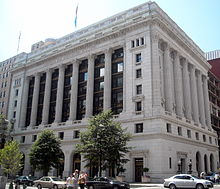
American Bar Association
The American Bar Association published a book about lobbying regulations.
Lobbyists sometimes support rules requiring greater transparency and disclosure: “Our profession is at a critical point where we can either embrace the constructive changes and reforms by Congress or we can seek out loopholes and continue the slippery slide into history along side the ranks of snake oil salesmen.” —Lobbyist Gerald S. J. Cassidy, 2007.
Supporters for regulating lobbying hold the view that existing regulations designed to rein in the excesses of lobbying have not been effective, and that reforms and regulations have not cleaned up the system at all. Jack Abramoff said lobbyists could “find a way around just about any reform Congress enacted. ” He gave the following example: You can’t take a congressman to lunch for $25 and buy him a hamburger or a steak or something like that … But you can take him to a fund-raising lunch and not only buy him that steak, but give him $25,000 extra and call it a fund-raiser — and have all the same access and all the same interactions with that congressman. A similar view suggested that lobbying reform efforts have been “fought tooth and nail to prevent its passage” since the people with the power to reform would curtail their own powers and income flows.
7.4.2: Regulating Executive Branch Lobbyists
Lobbying the Executive Branch is similar to any other branch of the U.S. government and is regulated by laws pertaining to disclosure.
Learning Objective
Summarize the key reasons behind the movement of lobbying activity from the state to the federal level
Key Points
- Executive branch agencies added a new layer of rule-making to congressional legislation.
- It was not until the 20th century that lobbying the Executive Branch really emerged as a widespread issue with several new political trends in the government.
- Many executive branch agencies have the power to write specific rules and are a target for lobbying.
Key Terms
- lobbying
-
Lobbying (also lobby) is the act of attempting to influence decisions made by officials in the government, most often legislators or members of regulatory agencies.
- executive branch
-
The branch of government that oversees the carrying out of the laws, led by the president.
Most lobbying during the nineteenth century happened within state legislatures. While the federal government had a larger jurisdiction, it did not handle many matters pertaining to the economy. The state governments did much more legislating than the federal government. When lobbying did happen, it was often “practiced discreetly” with little or no public disclosure. By one account, more intense lobbying in the federal government happened from 1869 to 1877 during the administration of President Grant near the start of the so-called Gilded Age. The most influential lobbyists wanted railroad subsidies and a tariff on wool. At the same time in the Reconstruction South, lobbying was intense near the state legislatures, especially regarding railroad subsidies, but it also happened in other areas, such as gambling. For example, Charles T. Howard of the Louisiana State Lottery Company actively lobbied state legislators and the governor of Louisiana for the purpose of getting a license to sell lottery tickets.
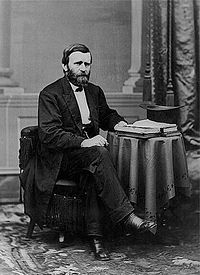
President Grant
President Ulysses S. Grant was in office during a period of more intense lobbying in the federal government between 1869 and 1877.
But, it was not until the 20th century that lobbying the Executive Branch really emerged as a widespread issue with several new political trends in the government, including:
- Expensive campaigns. Winning reelection meant spending huge sums on expensive media, particularly television advertising. Congresspersons seeking reelection found themselves having to spend much of their time raising money instead of governing. In 1976, the average cost of running for a House seat was 86,000. By 2006, it was 1.3 million. Running for Senate was even pricier, with an average cost in 2006 of $8.8 million.
- Increased Complexity. This was partly the result of a continuing shift of legislative authority from state governments to Washington and partly the result of new technologies and systems. It became difficult for voters or watchdog groups to monitor this activity since it became harder to follow or even comprehend. Complexity encouraged more specialized lobbying, often with more than one agency affected by any one piece of legislation. It also encouraged lobbyists to become familiar with the intricate details and history of many issues. Executive branch agencies added a new layer of rule-making to congressional legislation. The economy expanded.
In many ways, lobbying the Executive Branch is similar to any other branch of the U.S. government and is thereby regulated by laws pertaining to disclosure discussed in Regulation Congressional Lobbyists. However, it is true that many executive branch agencies have the power to write specific rules and are a target of lobbying. Federal agencies, like the State Department, make rules to give aid money to countries like Egypt. In fact, an Egyptian-American businessman named Kais Menoufy organized a lobby to try and halt U.S. aid to Egypt.
Further complicating the relationship between lobbying and the Executive Branch is the fact that it is possible for one level of government to lobby another level. The District of Columbia, seeking better voting rights for its citizens, has been lobbying Congress and the president for greater power—including possible statehood or voting representation in Congress. An assessment in 2011 suggested that the district needed to rethink its lobbying strategy, since its past efforts have only had “mixed results.”
7.4.3: Results of the 1946 Act
The Federal Regulation of Lobbying Act of 1946 was a statute enacted by the United States Congress to reduce the influence of lobbyists.
Learning Objective
Summarize the contents of the 1946 Federal Regulation of Lobbying Act and reactions to it
Key Points
- Section 308 of the bill forced lobbyists to register with the Clerk of the House of Representatives and the Secretary of the Senate and to provide information including the names and addresses of their employers, and to identify in whose interest the particular lobbyist worked.
- The 1946 Act expanded the definition of who could be considered a lobbyist. It included in this category any person who directly or indirectly solicits, collects, or receives money or any other thing of value to be used principally to aid in relation to the passage or defeat of any legislation.
- Lobbyists challenged the Regulation of Lobbying Act on the grounds that it was vague and unclear.
Key Terms
- regulation
-
A law or administrative rule, issued by an organization, used to guide or prescribe the conduct of members of that organization; can specifically refer to acts in which a government or state body limits the behavior of businesses.
- scope
-
The breadth, depth or reach of a subject; a domain.
- provision
-
A clause in a legal instrument, a law, etc., providing for a particular matter and/or stipulation.
The Federal Regulation of Lobbying Act of 1946 was a statute enacted by the United States Congress that was intended to reduce the influence of lobbyists on the government.
There is general agreement that money is a key variable in lobbying . This has been viewed as problematic, because it allows those with the most financial resources to influence government more than those who possess less money. The Federal Regulation of Lobbying Act of 1946 was specifically crafted to deal with this issue. The act defined lobbying as an activity, and thus created the legal conditions for the behavior to be regulated by the government.
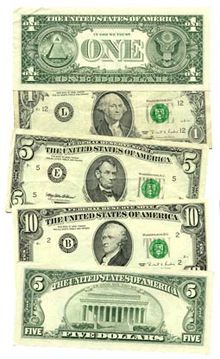
Lobbying for Pay
There is general agreement that money is a key variable in lobbying.
The provisions of the act define lobbying in the following manner:
Section 308 states that, “any person who shall engage himself for pay, or for any consideration, for the purpose of attempting to influence the passage or defeat of any legislation by the Congress of the United States shall, before doing anything in furtherance of such object, register with the Clerk of the House of Representatives and the Secretary of the Senate and shall give to those officers in writing and under oath, his name and business address, the name and address of the person by whom he is employed, and in whose interest he appears or works, the duration of such employment, how much he is paid and is to receive, by whom he is paid or is to be paid, how much he is to be paid for expenses, and what expenses are to be included. “
Section 307 further describes what is regulated. “The Provisions of this act apply to any person (except a political committee as defined in the Federal Corrupt Practices Act, and duly organized State or local committees of a political party), who by himself, or through any agent or employee or other persons in any manner whatsoever, directly or indirectly, solicits, collects, or receives money or any other thing of value to be used principally to aid, or which the principal purpose of which person is to aid, in the accomplishment of influencing, directly or indirectly, the passage or defeat of any legislation by the Congress of the United States. “
Lobbyists claimed that the Regulation of Lobbying Act was unconstitutional on the grounds that it was vague and unclear. In a 1954 case (United States v. Harriss), the Supreme Court made its voice heard on the issue. The Court upheld the act’s constitutionality, but it also narrowed the scope and application of the act. The Supreme Court ruled that the act applied only to paid lobbyists who directly communicated with members of Congress, and only when that communication regarded pending or proposed federal legislation. This meant that lobbyists who visited with congressional staff members, rather than members of Congress themselves, were not considered lobbyists. In addition, the act only monitored attempts to specifically influence the passage or defeat of legislation in Congress, and thus excluded other congressional activities or communication between officials and lobbyists. Finally, the Court also ruled that the act only applied to individuals who spent at least half of their time lobbying. This set basic occupational limits as to who would be affected by the law.
7.4.4: The Reforms of 1995
The Lobbying and Disclosure Act of 1995 was legislation aimed at bringing a level of accountability to federal lobbying practices in the United States.
Learning Objective
Summarize the content and effectiveness of the lobbying reforms of 1995
Key Points
- The law was amended substantially by the Honest Leadership and Open Government Act of 2007.
- The Lobbying and Disclosure Act of 1995 defines a number of provisions attempting to maintain a degree of transparency in the activities of lobbyists.
- The legislation does not include those lobbyists whose “activities constitute less than 20 percent of the time engaged in services”, thus failing to regulate grassroots (small donors) lobbying.
- The ultimate failure of the Lobbying and Disclosure Act of 1995 was in its failure to provide adequate funding to implement the regulations.
Key Terms
- loophole
-
A method of escape, especially an ambiguity or exception in a rule that can be exploited in order to avoid its effect.
- transparency
-
(figuratively) openness, degree of accessibility to view
- lobbyist
-
A person remunerated to persuade (to lobby) politicians to vote in a certain way or otherwise use their office to effect a desired result.
The Lobbying and Disclosure Act of 1995 (2 U.S.C. § 1601) was legislation aimed at bringing a level of accountability to federal lobbying practices in the United States. This law was then amended substantially by the Honest Leadership and Open Government Act of 2007. Under provisions which took effect on January 1, 2006, lobbyists are required to register with the Clerk of the House of Representatives and the Secretary of the Senate. Failing to do so is punishable by a civil fine of up to $50,000. The Clerk and Secretary must refer any acts of non-compliance to the United States Attorney for the District of Columbia.
Bill Provisions
Definitions: The LDA defines a number of provisions attempting to maintain a degree of transparency in the activities of lobbyists. The legislation defines a client as: “…any person or entity that employs or retains another person for financial or other compensation to conduct lobbying activities on behalf of that person or entity. A person or entity whose employees act as lobbyists on its own behalf is both a client and an employer of such employees….”. The legislation also includes lobbyists that are affected: “The term “lobbyist” means any individual who is employed or retained by a client for financial or other compensation for services that include more than one lobbying contact, other than an individual whose lobbying activities constitute less than 20 percent of the time engaged in the services provided by such individual to that client over a six month period. ” Also included in the legislation are the definitions of what actions must be disclosed, which includes lobbying to certain members of the Executive Branch who are included on specific payrolls. Also included are members of Congress.
Loopholes: The legislation does not include those lobbyists whose “activities constitute less than 20 percent of the time engaged in services”, thus failing to regulate grassroots (small donors) lobbying. The LDA includes a number of other “thresholds” that define what must be recorded. Any organization that contributes more than $10,000 towards lobbying activities must also be registered. Amounts even slightly below this threshold are exempt from reporting. The outline for registration includes “name, address, business telephone number, and principal place of business of the registrant, and a general description of its business or activities;” as well as for the client. The register must also include a statement of what issues the registrant expects to lobby or what may have already been lobbied.
After recording, the records are maintained by the Clerk of the House and the Secretary of the Senate. Due to severe understaffing, these two offices are unable to check for illegal activities or corrupt practices. This is the significant failure of this bill. During a hearing before the Senate Committee on Rules and Administration, Senator Christopher Dodd stated that “[s]ince 2003, the Office of Public Records has referred over 2,000 cases to the Department of Justice, and nothing’s been heard from them again.”
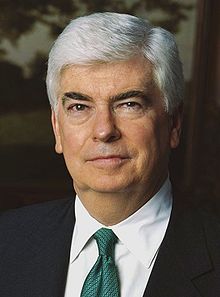
Senator Christopher Dodd
Senator Christopher Dodd, while pointing out gaps in the 1995 lobbying reform, was himself implicated in controversy surrounding his role as Chairman of the Senate Banking committee and his relationship with Countrywide Financial
7.4.5: Lobbying Scandals and the Reforms of 2007
The Honest Leadership and Open Government Act of 2007 sought to amend and strengthen parts of the Lobbying Disclosure Act of 1995.
Learning Objective
Describe the rules that the Honest Leadership and Open Government act put in place to regulate lobbying
Key Points
- The bill strengthens public disclosure requirements concerning lobbying activity and funding, places more restrictions on gifts for members of Congress and their staff, and provides for mandatory disclosure of earmarks in expenditure bills.
- The bill sought to address the “revolving door” issue, by declaring limitations on the ability of members of the government to serve as lobbyists following the end of their terms.
- The bill requires lobbyist disclosure filings to be filed twice as often, by decreasing the time between filing from semi-annual to quarterly.
Key Terms
- revolving door
-
The movement between roles as legislators and regulators become lobbyists
- disclosure
-
The act of revealing something
- house ethics rules
-
The Committee on Ethics, often known simply as the Ethics Committee, is one of the committees of the United States House of Representatives. Prior to the 112th Congress it was known as the Committee on Standards of Official Conduct.
Lobbying Scandals and the Reforms of 2007
The Honest Leadership and Open Government Act of 2007 is a law of the United States federal government that amended parts of the Lobbying Disclosure Act of 1995. It strengthens public disclosure requirements concerning lobbying activity and funding, places more restrictions on gifts for members of Congress and their staff, and provides for mandatory disclosure of earmarks in expenditure bills. The bill was signed into law by President George W. Bush on September 15, 2007.
Details of the bill include closing the revolving door , prohibiting senators from gaining undue lobbying access by increasing the “cooling off” period before they can lobby Congress from one to two years, prohibiting cabinet secretaries and other senior executive personnel from lobbying the department or agency in which they worked for two years after they leave their position, and prohibiting senior Senate staff and officers from lobbying contacts with the entire Senate for one year, instead of just their former employing office. The bill also includes numerous other prohibitions and requirements including:
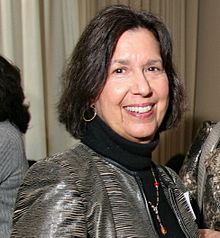
Closing the Revolving Door
As the former Under Secretary of Agriculture for Food, Nutrition, and Consumer Services and lobbyist for the Podesta Group in 2009, Ellen Haas represents the revolving door phenomenon that the 2007 lobbying reforms sought to address.
- Prohibits senior House staff from lobbying their former office or committee for one year after they leave House employment.
- Requires that executive and legislative branch employees who leave government positions and seek to lobby on behalf of Native American tribes face the same revolving door provisions as others.
- Exempts those who serve as elected or appointed officials of Native American tribes.
- Prohibits members of Congress and their staff from influencing hiring decisions of private organizations on the sole basis of partisan political gain.
- Subjects those who violate this provision to a fine and imprisonment for up to 15 years.
- Prohibits gifts by lobbyists.
- Prohibits lobbyists from providing gifts or travel to members of Congress with knowledge that the gift or travel is in violation of House or Senate rules.
- Full public disclosure of lobbying activity.
- Requires lobbyist disclosure filings to be filed twice as often, by decreasing the time between filing from semi-annual to quarterly.
- Requires lobbyist disclosures in both the Senate and House to be filed electronically and requires creation of a public searchable Internet database of such information.Increases civil penalty for knowing and willful violations of the Lobby Disclosure Act from 200,000 and imposes a criminal penalty of up to five years for knowing and corrupt failure to comply with the Act.
- Requires the Government Accountability Office to audit annually lobbyist compliance with disclosure rules.
- Requires lobbyists to certify they have not given gifts or travel that would violate Senate or House rules.
- Requires the disclosure of businesses or organizations that contribute more than 15,000 semiannually in campaign contributions for any federal elected official, candidate (including Senate, House and Presidential), or leadership PAC.
- Requires lobbyists to disclose to the Secretary of the Senate and the House Clerk their campaign contributions and payments to Presidential libraries, Inaugural Committees or entities controlled by, named for or honoring members of Congress.
- Includes congressional pension accountability.
Unlike previous lobbying regulations, the 2007 reforms also made an attempt to amend House ethics rules in the following ways:
- Requires disclosure of employment negotiations by members and staff.
- Prohibits members from engaging in any agreements or negotiations about future employment until a successor has been selected unless the member files a statement with the Committee on Standards of Official Conduct; and requires that members recuse themselves from any matter in which there is a conflict of interest or appearance of a conflict.
- Requires senior staff to notify the Committee on Standards of Official Conduct within three days if they engage in negotiations or agreements for future employment or compensation.
- Requires that members prohibit their staff from having any lobbying contact with the Member’s spouse if such individual is a registered lobbyist or is employed or retained by a registered lobbyist to influence legislation.
- Requires that travel by members financed by outside groups be posted on a searchable, sortable and downloadable website by August 1, 2008. Requires that members’ financial disclosure forms be posted on a searchable, sortable and downloadable website by August 1, 2008.
- Prohibits members from attending parties held in their honor at national party conventions if they have been sponsored by lobbyists, unless the member is the party’s presidential or vice presidential nominee.
7.4.6: Obama vs. the Lobbyists?
Early in his presidency, Obama said “[lobbyists] won’t find a job in my White House,” but softened his stance later in the campaign.
Learning Objective
Summarize the Obama White House’s position on hiring former lobbyist
Key Points
- On January 21, 2009, Obama issued an executive order which stated no appointee who was a registered lobbyist within the two years before his appointment could participate on matters in which he lobbied for a period of two years after the date of appointment.
- As of March 21, 2009, at least thirty officials appointed by Obama had been lobbyists in the past five years.
- Critics of Obama’s administration claim Obama is retreating from his own ethics rules barring lobbyists from working on the issues about which they lobbied during the previous two years by issuing waivers.
Key Terms
- recusal
-
An act of recusing. To remove oneself from a decision/judgment because of a conflict of interest.
- appointee
-
a person who is appointed
- waiver
-
Something that releases a person from a requirement.
Early in his presidential campaign, Obama stated that “they [lobbyists] won’t find a job in my White House”, but softened his stance later in the campaign. On January 21, 2009, Obama issued an executive order for all future appointees to his administration, which stated, no appointee who was a registered lobbyist within the two years before his appointment could participate on matters in which he lobbied for a period of two years after the date of appointment. Three formal waivers were initially issued in early 2009, out of 800 executive appointments: to William J. Lynn III, a lobbyist for Raytheon, to hold the position of Deputy Secretary of Defense; to Jocelyn Frye, former general counsel at the National Partnership for Women and Families, to serve as Director of Policy and Projects in the Office of the First Lady; and to Cecilia Muñoz, former senior vice president for the National Council of La Raza, to serve as Director of Intergovernmental Affairs in the Executive Office of the President. As of March 21, 2009, at least thirty officials appointed by Obama had been lobbyists in the past five years. Ten additional waivers were announced in September 2009.
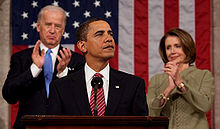
President Barack Obama
Starting his presidential years as an outspoken advocate of lobbying regulation, President Obama’s actions in relation to lobbying have led some to believe that he has not lived up to the high ethical standards that he set out for himself.
Not all recent former lobbyists require waivers; those without waivers write letters of recusal stating issues from which they must refrain because of their previous jobs. USA Today reported that 21 members of the Obama administration have at some time been registered as federal lobbyists, although most have not within the previous two years. Lobbyists in the administration include William Corr, an anti-tobacco lobbyist, as Deputy Secretary of Health and Human Services and Tom Vilsack, who lobbied in 2007, for a national teachers union, as Secretary of Agriculture. Also, the Secretary of Labor nominee, Hilda Solis, formerly served as a board member of American Rights at Work, which lobbied Congress on two bills Solis co-sponsored, and Mark Patterson, Treasury Secretary Timothy Geithner’s chief of staff, is a former lobbyist for Goldman Sachs.
The Citizens for Responsibility and Ethics in Washington have criticized the administration, claiming that Obama is retreating from his own ethics rules barring lobbyists from working on the issues about which they lobbied during the previous two years by issuing waivers. According to Melanie Sloan, the group’s executive director, “It makes it appear that they are saying one thing and doing another. “
7.5: Elements of Successful Interest Groups
7.5.1: Size and Resources
Interest groups, comprised of members with shared knowledge, status, or goals, frequently advocate on behalf of particular political issues.
Learning Objective
Explain the purpose, composition, and functioning of interest groups.
Key Points
- Interest groups may attempt to influence policy through lobbying, political contributions, or media campaigns.
- Access to financial resources is generally necessary in order for lobbying efforts to be successful.
- The greater the size of an interest group, the more likely it is to have the ability to influence policy.
Key Terms
- interest group
-
Collections of members with shared knowledge, status, or goals. In many cases, these groups advocate for particular political or social issues.
- lobbying
-
Lobbying (also lobby) is the act of attempting to influence decisions made by officials in the government, most often legislators or members of regulatory agencies.
- media campaign
-
An attempt to influence public opinion using television, radio, internet, and print advertisements.
Example
- Greenpeace and the National Rifle Association (NRA) are both examples of interest groups. They lobby politicians, contribute to campaigns, and organize media campaigns in attempts to influence policy.
Introduction
Interest groups are comprised of individuals with shared knowledge, status, or goals, and in many cases these groups advocate for particular political or social issues. In the United States, interest groups are often associated with lobbying groups, who seek to influence government officials to act favorably towards them. Interest groups, however, are not always involved in lobbying. They may not be politically active, or else they may use indirect tactics such as media campaigns, research, and public opinion polls in order to advance their cause.
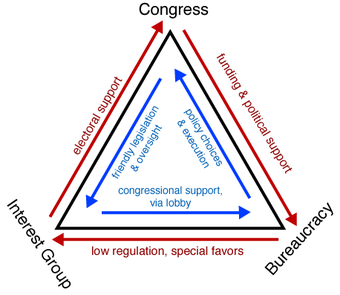
The Iron Triangle
In United States politics, the iron triangle comprises the policy-making relationship among the congressional committees, the bureaucracy, and interest groups.
Interest groups that are politically active with regards to one or more issues are called advocacy groups. In liberal democracies, advocacy groups tend to treat bureaucracy as their main channel of influence, because that is where the decision-making power lies. The aim of advocacy groups is to influence a member of the legislature to support their cause by voting a certain way. The practice of attempting to influence lawmakers is called lobbying, and the effectiveness of a group’s lobbying efforts is usually tied to its access to resources (almost always financial).
Interest Groups and Resources
Interest groups may gain influence because of their access to money. Indeed, financial resources are often critical in influencing governmental policy. In some cases, money is used directly to influence politicians — for example, a lobbyist may treat a legislator to an expensive dinner. These instances are almost always considered corrupt, and are often outlawed as bribery. Money can also be used in more subtle ways to pressure lawmakers into voting in a particular way. For example, because they play a large role in the national economy, large corporations have an advantage in influencing lawmakers. If these large corporations were to suddenly become less successful, it might create economic trouble, which could turn public opinion against elected officials. Thus, the wealthier a corporation is, the more political clout it tends to have. Likewise, large corporations have greater access to politicians than other groups, because corporate leaders often have insider status in powerful groups. Moreover, an interest group might also make use of financial resources in order to donate to a political campaign. In this instance, the donation is not explicitly tied to a policy vote, and is therefore a legal contribution. That being said, the expectation is that interest groups will use their wealth to elect candidates that support their issues. In all of these ways, interest groups use money to gain success and influence on many levels.
Issue Campaigns
Apart from using money to directly influence bureaucrats, interest groups may also use their wealth to launch issue campaigns. In this case, organizations try to gain popular support among American voters for a particular issue. Ultimately, the goal of this tactic is to pressure legislators into acting a certain way in response to a perceived public mandate. Since legislators are elected, there is a strong incentive for them to vote for issues that are popular with the current public opinion. Media campaigns can be very effective at marshaling public opinion, but they are very expensive, because campaigns need to buy television and radio air time, as well as print advertisements. Money is also required to hire and fund the professionals who will run these campaigns. Thus, interest groups with greater funds are far more likely to successfully influence policy than those groups with fewer financial resources.
Size of Interest Groups
As organizations attempting to influence politics through public opinion, interest groups with larger memberships have an advantage over smaller ones. Since legislators are accountable to voters, the more public support there is for an issue, the more likely it is to receive support and governmental attention. Larger interest groups necessarily have influence because of how many voters participate in them. They are also effective because the core group membership is able to more effectively campaign on behalf of an issue than a group with a smaller membership. Additionally, larger interest groups are able to stage large demonstrations that make visible the widespread support for an issue .
7.5.2: Leadership
Interest groups often rely on leaders to organize their fundraising and make their advocacy efforts successful.
Learning Objective
Differentiate between the different kinds of leadership structures in interest groups and social movements.
Key Points
- Corporate interest groups usually choose professional lobbyists to lead their advocacy.
- Interest groups that use public campaigns to influence opinion tend to rely on campaign strategists.
- Interest groups that form social movements may not have a clear leader, though a figurehead may become an informal spokesperson for the group.
Key Terms
- political strategist
-
A consultant who advises and assists political campaigns.
- lobbyist
-
A person remunerated to persuade (to lobby) politicians to vote in a certain way or otherwise use their office to effect a desired result.
- social movement
-
A large, informal grouping of individuals or organizations which advocates for specific political or social issues.
Example
- Martin Luther King, Jr. is an example of an unofficial leader of a social movement–the Civil Rights Movement was a diffuse political movement, not a discrete organization, but King became the figurehead of the movement through his charismatic and influential leadership.
The role of leadership varies based on the political orientation or goals of an interest group. Some interest groups, especially corporations, hire lobbyiststo lead their advocacy efforts. Interest groups with organized media campaigns may be led by political strategists. In contrast, more amorphous social movements that act as interest groups may coalesce around charismatic, but often unofficial, group leaders.
When interest groups attempt to influence policymakers through lobbying, they usually rely on professional lobbyists. Lobbyists are often well-connected professionals, such as lawyers, whose role is to argue for specific legislation. Successful lobbyists achieve insider status in legislative bodies, meaning they can talk directly to lawmakers. Once they gain access to legislators, the lobbyist’s job is to persuade them to act on behalf of their client. Recent estimates put the number of registered lobbyists in Washington, D.C. at about 13,700, though there are likely thousands more unregistered lobbyists working to influence policymakers.
Interest groups that attempt to influence policy by changing public opinion may be led by political strategists, who are often consultants familiar with public relations, advertising, and the political process. Political strategists are responsible for determining a campaign plan. The campaign plan usually involves deciding on a central message the interest group hopes to use for persuading voters to support their position. Additionally, the strategist determines where advertisements will be placed, where grassroots organizing efforts will be focused, and how fundraising will be structured. In issue-based campaigns, successful political strategists create public awareness and support for an issue, which can then pressure legislators to act in favor of the interest group.
Interest groups may be broader than one formal organization, in which case advocacy may form a social movement. A social movement is group action aimed at social change. Social movements may have some formal hierarchy, but they are often disorganized, with funding and support coming from a range of decentralized sources. Because of these factors, social movements do not always have a clear leader the way corporate lobbying efforts and media campaigns do. Instead, social movements may either rely on a network of local leaders, or may be led informally by a charismatic or influential participant. For example, the Civil Rights Movement was a diffuse and widespread effort toward social change, involving many formal organizations and informal groups. Still, many consider Martin Luther King, Jr. to be the leader of the Civil Rights Movement because of the highly influential and public role he played in influencing policies and opinions. Interest groups with a de facto leader may be more successful at sustained political advocacy than those with no clear hierarchy, because a clearly defined leader allows for more efficient organization of fundraising efforts, demonstrations, and campaigns. That being said, social scientists often disagree when defining social movements and the most effective forms of advocacy, finding that leadership plays an ambiguous role in terms of the overall success of many interest groups.
7.5.3: Cohesiveness
Advocacy groups that form along ideological, ethnic, or foreign policy objectives tend to have higher levels of internal cohesion.
Learning Objective
Describe the key characteristics and aims of advocacy groups
Key Points
- In the social sciences, a social group has been defined as two or more humans who interact with one another, share similar characteristics, and collectively have a sense of unity. A social group exhibits degrees of social cohesion and is more than a simple collection or aggregate of individuals.
- Advocacy groups use various forms of advocacy to influence public opinion and/or policy; they have played and continue to play an important part in the development of political and social systems.
- An ethnic interest group, according to the political scientist Thomas Ambrosio, is an advocacy group established along cultural, ethnic, religious, or racial lines by an ethnic group for the purposes of directly or indirectly influencing the foreign policy.
- While many formal organizations established by ethnic identity groups are apolitical, others are created explicitly for political purposes.
- Groupthink is a psychological phenomenon that occurs when group members try to minimize conflict and reach a consensus decision without critical evaluation of alternative ideas or viewpoints.
- Deindividuation is a concept in social psychology that is generally thought of as the loosening of self-awareness in groups, although this is a matter of contention.
Key Terms
- ethnic interest group
-
An ethnic interest group, according to the political scientist Thomas Ambrosio, is an advocacy group established along cultural, ethnic, religious or racial lines by an ethnic group for the purposes of directly or indirectly influencing the foreign policy of their resident country in support of the homeland and/or ethnic kin abroad with which they identify.
- social cohesion
-
The bonds or “glue” that maintain stability in society.
- groupthink
-
A process of reasoning or decision-making by a group, especially one characterized by uncritical acceptance or conformity to a perceived majority view.
Introduction
In the social sciences a social group has been defined as two or more humans who interact with one another, share similar characteristics, and collectively have a sense of unity. Other theorists, however, are a wary of definitions which stress the importance of interdependence or objective similarity. Instead, for researchers in the social identity tradition, “a group is defined in terms of those who identify themselves as members of the group. ” Regardless, social groups come in a myriad of sizes and varieties.
A social group exhibits some degree of social cohesion and is more than a simple collection or aggregate of individuals, such as people waiting at a bus stop or people waiting in a line. Characteristics shared by members of a group may include interests, values, representations, ethnic or social background, and kinship ties. Kinship ties being a social bond based on common ancestry, marriage, or adoption. In a similar vein, some researchers consider the defining characteristic of a group as social interaction.
Advocacy Groups
Advocacy groups use various forms of advocacy to influence public opinion and/or policy; they have played and continue to play an important part in the development of political and social systems. Groups vary considerably in size, influence, and motive; some have wide-ranging, long-term social purposes, others are focused and are a response to an immediate issue or concern. Motives for action may be based on a shared political, faith, moral, or commercial position. Groups use varied methods to try to achieve their aims including lobbying, media campaigns, publicity stunts, polls, research, and policy briefings. Some groups are supported by powerful business or political interests and exert considerable influence on the political process, others have few such resources.
An ethnic interest group, according to the political scientist Thomas Ambrosio, is an advocacy group established along cultural, ethnic, religious, or racial lines by an ethnic group for the purposes of directly or indirectly influencing the foreign policy of their resident country in support of the homeland and/or ethnic kin abroad with which they identify. According to Ambrosio, “like other societal interest groups, ethnic identity groups establish formal organizations devoted to promoting group cohesiveness and addressing group concerns. ” While many formal organizations, established by ethnic identity groups, are apolitical, others are created explicitly for political purposes. In general, groups who seek to influence government policy on domestic or foreign issues are referred to as “advocacy groups. ” Those interest groups, established by ethnic identity groups, are referred to as ethnic interest groups. The American Israeli Public Affairs Committee is an example of an ethnic interest group in the United States – its mission is to influence American foreign policy and maintain a robust alliance with Israel .
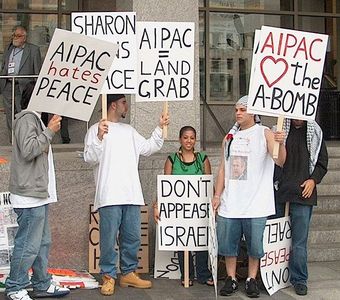
AIPAC Protest DC 2005
The American Israeli Public Affairs Committee is an example of an ethnic interest group. This is a photograph of a group of protesters outside the AIPAC conference at the Washington, D.C. Convention Center.
Groupthink
Groupthink is a psychological phenomenon that occurs within groups of people, in which the desire for harmony in a decision-making group overrides a realistic appraisal of alternatives. Group members try to minimize conflict and reach a consensus decision without critical evaluation of alternative ideas or viewpoints. Antecedent factors, such as group cohesiveness, structural faults, and situational context, play into the likelihood of whether or not groupthink will impact the decision-making process.
Deindividuation is a concept in social psychology that is generally thought of as the loosening of self-awareness in groups, although this is a matter of contention. Sociologists also study the phenomenon of deindividuation, but the level of analysis is somewhat different. For the social psychologist, the level of analysis is the individual in the context of a social situation. As such, social psychologists emphasize the role of internal psychological processes. Other social sciences, such as sociology, are more concerned with broad social, economic, political, and historical factors that influence events in a given society.
7.5.4: Members
Members join interest groups because of common concerns and to unite under one cause.
Learning Objective
Describe the activities of interest groups and the challenges they face
Key Points
- An interest group is a group of individuals who share common objectives and whose aim is to influence policymakers.
- Membership interests represent individuals for social, business, labor, or charitable purposes in order to achieve civil or political goals. Institutional interests represent other organizations, with agendas that fit the needs of the organizations they serve.
- A general theory is that individuals must be enticed with some type of benefit to join an interest group.
- People who join an interest group may not have shared opinions on other issues. With the membership united under one cause, the staff has the ability to pursue other issues that the membership may disagree on because members will remain united by the primary cause.
Key Terms
- solidary
-
Having shared community interests and responsibilities.
- interest group
-
Collections of members with shared knowledge, status, or goals. In many cases, these groups advocate for particular political or social issues.
- incentive
-
Something that motivates, rouses, or encourages.
Example
- Mancur Lloyd Olson, a leading American economist, sought to understand the logical basis of interest group membership and participation. In his first book, The Logic of Collective Action: Public Goods and the Theory of Groups (1965), he theorized that “only a separate and ‘selective’ incentive will stimulate a rational individual in a latent group to act in a group-oriented way”; that is, members of a large group will not act in the group’s common interest unless motivated by personal gains.
Introduction
An interest group is a group of individuals who share common objectives, and whose aim is to influence policymakers. Institutional interest groups represent other organizations, with agendas that fit the needs of the organizations they serve. Examples include the American Cotton Manufacturers (which represents the generally congruous southern textile mills) and the U.S. Chamber of Commerce (which represents the multitude of wants of American businesses).
Membership interest groups are organizations that represent individuals for social, business, labor, or charitable purposes in order to achieve civil or political goals. Examples include the NAACP (African-American interests), the Sierra Club (environmental interests), the NRA (Second Amendment interests), and Common Cause (interests in an increase in voter turnout and knowledge). Membership includes a group of people that join an interest group and unite under one cause. Members may or may not have an opinion on some of the issues the staff pursues. Similarly, staff are the leaders. With the membership united under one cause, the staff has the ability to pursue other issues that the membership may disagree on because members will remain in the group because they are united by the primary cause.
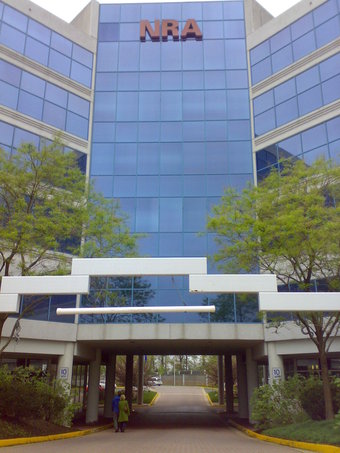
NRA Headquarters
The headquarters of the NRA, an interest group, located in Fairfax Virginia, USA.
Benefits and Incentives
A general theory is that individuals must be enticed with some type of benefit to join an interest group. Known as the free rider problem, it refers to the difficulty of obtaining members when the benefits are reaped without membership. For instance, an interest group dedicated to improving farming standards will fight for the general goal of improving farming for all farmers, even those who are not members of the particular interest group. Thus, there is no real incentive to join an interest group and pay dues if the farmer will still receive that benefit even if they do not become a member. Interest groups must receive dues and contributions from members in order to accomplish their agendas. While every individual in the world would benefit from a cleaner environment, an environmental protection interest group does not, in turn, receive financial help from every individual in the world.
Selective material benefits are sometimes given in order to address the free rider problem. Interest groups give material benefits like travel discounts, free meals at certain restaurants, or free subscriptions to magazines, newspapers, or journals. Many trade and professional interest groups give these benefits to members.
A selective solidary benefit is another type of benefit offered to members of an interest group. These incentives involve benefits like socializing, congeniality, the sense of group membership and identification, the status resulting from membership, fun and conviviality, the maintenance of social distinctions, and so on. A solidary incentive is one in which the rewards for participation are social and created out of the act of association.
An expressive incentive can be another basic benefit to members of an interest group. People who join an interest group because of expressive benefits join to express an ideological or moral value they believe in. Such values include free speech, civil rights, economic justice, or political equality. To obtain these types of benefits, members simply pay dues or donate time or money to get a feeling of satisfaction from expressing a political value. Even if the interest group does not achieve its goals, members merely want to be able to say they helped out in the process of trying to obtain the goals, which is the expressive incentive. Interest groups that rely on expressive benefits include environmental groups and groups who claim to lobby for the public interest.
Collective Action
Mancur Lloyd Olson, a leading American economist, sought to understand the logical basis of interest group membership and participation. The reigning political theories of his day granted groups an almost primordial status. Some appealed to a natural human instinct for herding, others ascribed the formation of groups to kinship rooted in the process of modernization. Olson offered a radically different account of the logical basis of organized collective action. In his first book, The Logic of Collective Action: Public Goods and the Theory of Groups (1965), he theorized that “only a separate and ‘selective’ incentive will stimulate a rational individual in a latent group to act in a group-oriented way.” Olsen’s work laid the foundation for understanding how members of a large group will not act in the group’s common interest unless motivated by personal gains.
7.6: Political Parties
7.6.1: Political Parties
A political party seeks to influence government policy by nominating their own candidates and trying to seat them in office.
Learning Objective
Identify the functions and different structures of political parties in an electoral democracy
Key Points
- There are three general, main types of party systems, single or dominant party systems, two-party systems, or multi-party systems.
- Single party systems tend to be indicative of authoritarian regimes since the dominance of a single party means the repression of all other political opposition.
- The type of electoral system is a major factor in determining the type of party political system. In countries with a simple plurality voting system, parties elected tend to be few, sometimes only two in a single jurisdiction.
Key Terms
- Single Dominant Party
-
In single dominant, or single-party systems, one political party is legally allowed to hold effective power. Although minor parties may sometimes be allowed, they are legally required to accept the leadership of the dominant party.
- political party
-
A political party is a political organization that typically seeks to influence government policy, usually by nominating their own candidates and trying to seat them in political office. Parties often espouse an expressed ideology or vision, bolstered by a written platform with specific goals, forming a coalition among disparate interests.
- Nonpartisan
-
In a nonpartisan system, no official political parties exist, sometimes reflecting legal restrictions on political parties. In nonpartisan elections, each candidate is eligible for office on his or her own merits.
Political Parties
A political party is a political organization that typically seeks to influence government policy, usually by nominating their own candidates and trying to seat them in political office. Parties often espouse an expressed ideology or vision bolstered by a written platform with specific goals, forming a coalition among disparate interests.
Parliamentary Party Structure
When the party is represented by members in the lower house of parliament, the party leader simultaneously serves as the leader of the parliamentary group of that full party representation. Depending on a minimum number of seats held, Westminster-based parties allow for leaders to form frontbench teams of senior fellow members of the parliamentary group who serve as critics of aspects of government policy. When a party becomes the largest party not to be represented in a Westminster-style parliament, the party’s parliamentary group forms the Official Opposition. The Official Opposition frontbench team members often form the Official Opposition Shadow cabinet. When a party achieves enough seats in an election to form a majority, the party’s frontbench becomes the Cabinet of government ministers.
Regulation of Party Formation
The freedom to form a political party is considered a measurement of a state’s adherence to liberal democracy as a political value. Regulation of political parties may manifest as a crackdown on or repression of all opposition parties or certain parties who promote ideals that run counter to the general ideology of the state’s incumbents or possess membership by-laws which are legally unenforceable.
Voting Systems
The type of electoral system is a major factor in determining the type of political party system. In countries with a simple plurality voting system, there tends to be few parties elected (often only two in any given jurisdiction). In countries that have a proportional representation voting system, as exists throughout Europe, or to a greater extent ranked voting systems, such as in Australia or Ireland, three or more parties are often elected to parliament in significant proportions, and thus may have more access to public office.
Partisan and Nonpartisan Style Political Parties
Partisan style political parties varies according to each jurisdiction, depending on how many parties there are, and how much influence each individual party has.
In a nonpartisan system, no official political parties exist, sometimes reflecting legal restrictions on political parties. In nonpartisan elections, each candidate is eligible for office on his or her own merits. Unless there are legal prohibitions against political parties, factions within nonpartisan systems often evolve into political parties.
A Single Dominant Party
In single-party systems, one political party is legally allowed to hold effective power. Although minor parties may sometimes be allowed, they are legally required to accept the leadership of the dominant party. This party may not always be identical to the government, although sometimes positions within the party may in fact be more important than positions within the government. North Korea and China are examples. Other examples can be found in Fascist states, such as Nazi Germany between 1934 and 1945. The single-party system is thus usually equated with dictatorships and tyranny.
In dominant-party systems, opposition parties are allowed, and there may be even a deeply established democratic tradition, but other parties are widely considered to have no real chance of gaining power. Political, social, and economic circumstances, and public opinion can be reasons for others parties’ failure. Typically in countries with less of an established democratic tradition, it is possible the dominant party will remain in power by using patronage and sometimes through voting fraud.
Two-Party Systems
Two-party systems are states in which there are two political parties dominant to such an extent that electoral success under the banner of any other party is almost impossible. One right wing coalition party and one left wing coalition party is the most common ideological breakdown in such a system, but in two-party states political parties are traditionally parties that are ideologically broad and inclusive.
The British Parliament and U.S. Congress are examples of two-party systems.
Multiple Political Parties
Multi-party systems are systems in which more than two parties are represented and elected to public office.
Australia, Canada, People’s Republic of Bangladesh, Pakistan, India, Ireland, United Kingdom, and Norway are examples of countries with two strong parties and additional smaller parties that have also obtained representation. The smaller or “third” parties may hold the balance of power in a parliamentary system, and thus may be invited to form a part of a coalition government together with one of the larger parties; or may instead act independently from the dominant parties.
More commonly, in cases where there are three or more parties, no one party is likely to gain power alone, and parties work with each other to form coalition governments. Political change is often easier with a coalition government than in one-party or two-party dominant systems.
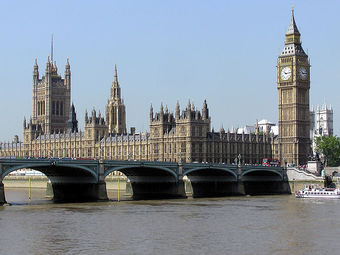
Westminster-Based Government, British Parliament
The British Parliament is a Westminster-based system of government with multiple political parties.
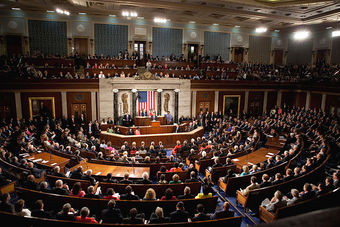
Joint Session of a Two-Party Congress
The United States Congress is an example of a two-party system of governance. In this picture, Obama’s Health Care Speech is being given to both the House and the Senate.
7.6.2: Interest Groups
Interest groups are any voluntary associations that seek to publicly promote and create advantages for their cause.
Learning Objective
Compare and contrast the different types of interest groups
Key Points
- Interest groups, also known as advocacy groups or lobbying groups, work to gain support both governmental and popular, for their causes or communities. Lobbying groups tend to focus on influencing governmental legislation directly through appeals to members of government.
- The lobbying done by interest groups or advocacy groups may be on behalf of private interests, i.e. commercial business etc, or may be on behalf of public interests such as the civil rights or environmental regulation.
- Governments often define and regulate organized group lobbying.
Key Terms
- lobbying
-
Lobbying (also to lobby) is the act of attempting to influence decisions made by officials in the government. Lobbying is done by many different types of people and organized groups including individuals in the private sector, corporations, fellow legislators or government officials, and advocacy groups (interest groups).
- interest group
-
An interest group is any voluntary association that seeks to publicly promote and create advantages for its cause.
- Special Interest Group
-
A Special Interest Group (SIG) is a community with an interest in advancing a specific area of knowledge, learning, or technology where members cooperate to affect or to produce solutions within their particular field and may communicate, meet, and organize conferences. At times, they may also advocate or lobby on a particular issue or on a range of issues.
Interest Group
The term interest group refers to nearly any voluntary association that seeks to publicly promote and create advantages for its cause. These diverse organizations include corporations, charitable organizations, civil rights groups, neighborhood associations, professional associations, and trade associations.
Special Interest Group
A Special Interest Group (SIG) is a community with an interest in advancing a specific area of knowledge, learning, or technology where members cooperate to affect or to produce solutions within their particular field. SIG members may communicate, meet, and organize conferences. At times they may also advocate or lobby on a particular issue or on a range of issues. However, they are generally distinct from advocacy groups and pressure groups which are normally set up for the specific political aim. The distinction is not firm though and some organizations evolve and change their focus over time.
Lobbying
Lobbying (also lobby) is the act of attempting to influence decisions made by officials in the government . Lobbying is done by many different types of people and organized groups, including individuals in the private sector, corporations, fellow legislators or government officials, or advocacy groups (interest groups). Professional lobbyists are people whose business is trying to influence legislation on behalf of a group or individual who hires them. Individuals and nonprofit organizations can also lobby as an act of volunteering or as a small part of their normal job. Governments often define and regulate organized group lobbying that has become influential.
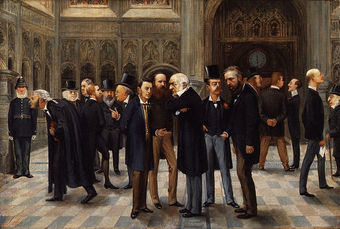
The Lobby of the House of Commons
The Lobby of the House of Commons, painted in 1886 by Liborio Prosperi.
The ethics and morality of lobbying are dual-edged. Lobbying is often spoken of with contempt when the implication is that people with inordinate socioeconomic power are corrupting the law in order to serve their own interest. However, another side of lobbying is making sure that others’ interests are duly defended against corruption. Lobbying can also make sure that minority interests are fairly defended against mere tyranny of the majority. Governments often define and regulate organized group lobbying.
Lobby groups may concentrate their efforts on the legislatures, where laws are created, but may also use the judicial branch to advance their causes. For example, the National Association for the Advancement of Colored People filed suits in state and federal courts in the 1950’s to challenge segregation laws. Their efforts resulted in the Supreme Court declaring such laws to be unconstitutional.
Advocacy Group
Advocacy groups use various forms of advocacy in order to influence public opinion and/or policy. They have played and continue to play an important part in the development of political and social systems.
Some advocacy groups have developed into important social, political institutions or social movements. Some powerful lobby groups have been accused of manipulating the democratic system for narrow commercial gain. In some instances, they have been found guilty of corruption, fraud, bribery, and other serious crimes. As a result, lobbying has become increasingly regulated. Some groups, generally ones with less financial resources, may use direct action and civil disobedience. At times, they are accused of being a threat to the social order or ‘domestic extremists. ‘
An advocacy group is a group or an organization that tries to influence the government, but does not hold power in the government. Smaller groups representing broad interests of a group may be formed with the purpose of benefiting the group over an extended period of time and in many ways. Examples are consumer organizations, professional associations, trade associations, and trade unions.
Advocacy groups exist in a wide variety of genres based upon their most pronounced activities.
Anti-defamation organizations issue responses or criticisms to real or supposed slights of any sort by an individual or group against a specific segment of the population which the organization exists to represent.
Watchdog groups provide oversight and rating of actions or media by various outlets, both government and corporate.
Lobby groups work to enact a change to the law or the maintenance of a particular law. Some lobby groups have considerable financial resources at their disposal. Lobbying is regulated to stop the worst abuses which can develop into corruption.
Legal defense funds provide funding for the legal defense for, or legal action against, individuals or groups related to their specific interests or target demographic.
Types
Organizations can be categorized along the lines of the three elements of commerce: business owners, workers, and consumers.
Employers’ organizations represent the interests of a group of businesses in the same industry.
Occupational or labor organizations promote the professional and economic interests of workers in a particular occupation, industry, or trade, through interaction with the government and by preparing advertising and other promotional campaigns to the public. Such groups will also provide member services such as career support, training, and organized social activities.
Consumer organizations exist to protect people from corporate abuse, promote fair business practices, and enforce consumer rights.
7.6.3: Party Identification
Party identification is usually determined by which political party the individual most commonly supports, through voting or other means.
Learning Objective
Discuss how voters form their party identification
Key Points
- Citizens who identify with a party are the Party in the Electorate. A partisan registers as a member of their party to vote, strongly tend to vote for their party’s candidates, support their party’s policies, work for the party’s campaigns, & have a higher voter turnout in primary elections.
- Some believe that voter identification is developed during childhood due to personal, family, social and environmental factors. In this case, party identification would be stable and nearly unchangeable.
- However, party identification changes can occur in times of party coalition change, or realignment. During these times, party coalitions themselves are being transformed. As a result, people are more likely to desert the party of their parents.
Key Terms
- Party identifiers
-
Party identifiers (partisans) could be described by their support in the following ways: they register as a member of the particular party, they show a strong tendency to vote for candidates in their preferred party, when surveyed, they identify themselves as members of that particular party, they are inclined to support policies endorsed by the particular party, they volunteer for campaigns to support party candidates more than the general population, and they have a higher voter turnout in primary elections than the general population.
- party identification
-
Party identification refers to the political party with which an individual identifies. Party identification is usually determined by which political party the individual most commonly supports, through voting or other means.
- Likert Scale
-
The Likert Scale is a 7 point scale to measure party identification that goes from Strong Democrat to Strong Republican.
Party Identification
Party identification refers to the political party with which an individual identifies. Party identification is typically determined by the political party that an individual most commonly supports, by voting or other means. shows the shift of party identification between the 2004 and 2008 presidential elections.
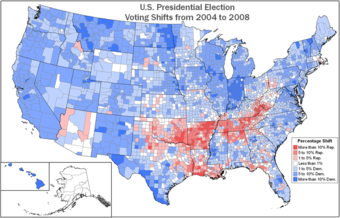
Voting Shifts by County Between the 2004 and 2008 Presidential Election
Voter identification is shown no where more clearly perhaps than during presidential elections. This map shows shifts in broad county party identification between the 2004 and 2008 presidential elections.
In the United States, political parties consist of three parts: the party as government (members of the party who hold public office), the party as organization (committees, leaders and activists who work to promote the party and the candidates), and the party as electorate (citizens who support the party through party identification).
Citizens in the general population who identify with a particular party make up the Party in the Electorate. Party identifiers (partisans) could be described by their support in the following ways:
- They register as a member of the particular party when registered to vote.
- They show a strong tendency to vote for candidates in their preferred party in most elections.
- When surveyed, they identify themselves as members of that particular party.
- They are inclined to support policies endorsed by the particular party.
- They volunteer for campaigns to support party candidates more than the general population.
- They have a higher voter turnout in primary elections than the general population.
Some researchers view party identification as a form of social identity, in the same way that a person identifies with a religious or ethnic group. This identity develops early in a person’s life mainly through family and social influences. This description would make party identification a stable perspective, which develops as a consequence of personal, family, social and environmental factors. Other researchers consider party identification to be more flexible and more of a conscious choice. They see it as a position and a choice based on the continued assessment of the political, economic and social environment. Party identification can increase or even shift by motivating events or conditions in the country.
Characterization
Childhood influence
Childhood Influence is one of main driving factors behind formation of party identification. During childhood, the main political influence comes from parents, other close family members and close surroundings such as the immediate community. Children remember events that happened during their childhood and associate them with the political party, whether or not they were connected with those events. For example, a child growing up in the 1970s would associate the Republican party with the Watergate scandal of the Nixon administration, a child growing up in the 1990s would associate the Democratic party with the sex scandal of the Clinton administration, or a child growing up in early 2000 would associate the Republican party with the Iraq War and the War on Terror. Although these parties might or might not embrace the issues that happened during that administration, a child could forever associate the party with those memorable events.
Adulthood
During adulthood, people can begin to adjust their party loyalties according to their personal experiences. The longer an individual holds a party ID, the stronger that attachment to the party tends to become. Because of this, older adults are more likely to hold strong party attachments, and less likely to change them than young adults.
Change
Party ID changes can occur in times of party coalition change, or realignment. During these times, party coalitions themselves are being transformed, and as a result, people are more likely to desert the party of their parents. It is during these times of partisan turmoil when younger adults are more likely to change party ID.
Measuring Party Identification
It is important to measure party identification in order to determine its strengths and weaknesses. Political scientists have developed many ways to measure party identification in order to examine and evaluate it.
One method of measuring party identification uses the Likert Scale. The Likert Scale is a 7 point scale to measure party identification:
Strong Democrat-Weak Democrat-Lean Democrat-Independent-Lean Republican-Weak Republican-Strong Republican
This scale does have some problematic aspects. According to the scale, a weak party supporter should normally vote with the party, but many times this is not the case. A “leaning” party supporter shows more loyalty to the party than that of a weak party supporter. Weak party supporters are more likely to stray from their party than someone who does not really declare a party identification and only tends to lean to one or the other based on the issues at hand.
Voting
Those people who identify with a party tend to vote for their party’s candidate for various offices in high percentages. Those who consider themselves to be strong partisans, tend to be the most faithful in voting for their party’s nominee for office. In the case of voting for president, since the 1970s, party identification on voting behavior has been increasing significantly. By the late 1990s, party identification on voting behavior was at the highest level of any election since the 1950s. When voting in congressional elections, the trend is similar. Strong party identifiers voted overwhelmingly for their party’s nominee in the general election.
The same level of voting behavior can also be applied to state and local levels. While straight ticket voting has declined among the general voting population, it is still prevalent in those who are strong Republicans and strong Democrats.
7.7: The Two-Party System
7.7.1: The Two-Party System
Two-party systems are prominent in various countries, such as the U.S., and contain both advantages and disadvantages.
Learning Objective
Discuss the historical origins of the two-party system in the United States and its advantages and disadvantages
Key Points
- The advantages of a two party system are that they tend to be less extreme, support policies that appeal to a broader segment of the population, and generally more stable.
- The disadvantages of a two party system are that they tend to ignore alternative views, stifle debate, and may not promote inter-party compromise but simply partisan appeals to the population.
- Third parties can and do exist in two-party system, however, they do not wield very much influence.
Key Terms
- Winner-Takes-All
-
The winner-takes-all voting system allows only a single winner for each possible legislative seat and is sometimes termed a plurality voting system or single-winner voting system.
- two-party system
-
A two-party system is a system in which two major political parties dominate voting in nearly all elections at every level of government and, as a result, the majority of elected offices are members of one of the two major parties.
Two-party system
A two-party system is a system in which two major political parties dominate voting in nearly all elections at every level of government and the majority of elected offices are members of one of the two major parties. Under a two-party system, one party typically holds a majority in the legislature and is usually referred to as the majority party while the other is the minority party. The United States is an example of a two-party system in which the majority of elected officials are either Democrats or Republicans .

The United States Two-Party System
Breakdown of political party representation in the United States House of Representatives during the 112th Congress. Blue: Democrat Red: Republican.
The modern political party system in the U.S. is a two-party system dominated by the Democratic Party and the Republican Party. These two parties have won every United States presidential election since 1852 and have controlled the United States Congress to some extent since at least 1856. However, the political party system did not develop until tax reform. The First Party System of the United States featured the Federalist Party and the Democratic-Republican Party (Anti-Federalist). In 1829, the Second Party System saw a split of the Democratic-Republican Party into the Jacksonian Democrats, who grew into the modern Democratic Party, led by Andrew Jackson, and the Whig Party, led by Henry Clay. The Third Party System stretched from 1854 to the mid-1890s, and was characterized by the emergence of the anti-slavery Republican Party, which adopted many of the economic policies of the Whigs, such as national banks, railroads, high tariffs, homesteads and aid to land grant colleges. The Fourth Party System, 1896 to 1932, retained the same primary parties as the Third Party System, but saw major shifts in the central issues of debate. This period also corresponded to the Progressive Era, and was dominated by the Republican Party. The Fifth Party System emerged with the New Deal Coalition beginning in 1933. The Republicans began losing support after the Great Depression, giving rise to Democratic President Franklin D. Roosevelt and the activist New Deal. Experts debate whether this era ended in the mid-1960s when the New Deal coalition did, the early 1980s when the Moral Majority and the Reagan coalition were formed, the mid-1990s during the Republican Revolution, or continues to the present. Since the 1930s, the Democrats positioned themselves more towards Liberalism while the Conservatives increasingly dominated the GOP.
Causes
There are several reason two major parties often dominate the political landscape in some systems. In the U.S., forty-eight states have a standard winner-takes-all electoral system for amassing presidential votes in the Electoral College system. The winner–takes–all principle applies in presidential elections, thus if a presidential candidate gets the most votes in any particular state, all of the electoral votes from that state are awarded to the candidate. In all but Maine and Nebraska, the presidential candidate must win a plurality of votes to wins all of the electoral votes; this practice is called the unit rule.
There are two main reasons winner–takes–all systems lead to a two-party system. First, the weaker parties are pressured to form an alliance, sometimes called a fusion, attempting to become big enough to challenge a large dominant party and, in so doing, gain political clout in the legislature. Second, voters learn, over time, not to vote for candidates outside of one of the two large parties since their votes for third party candidates are usually ineffectual. Therefore, weaker parties are eliminated by the voters over time. The gravitation of voters towards one of the two main parties is called polarization.
Advantages and Disadvantages
One opinion in political science is that a two-party system promotes centrism, less extremism, and that a two-party system is generally more stable and easier to govern than multi-party systems which can become a hung parliament. However, two-party systems have been criticized for ignoring alternative views and putting a damper on debate within a nation. Multi-party governments tend to permit wider and more diverse viewpoints in government and encourage dominant parties to make deals with weaker parties to form winning coalitions. Compared to the United States’ two-party system, the most common form of democracy is the British multi-party model.
There have been arguments that the winner-take-all mechanism discourages independent or third-party candidates from running for office or promulgating their views. One analyst suggested that parliamentary systems, which typically are multi-party in nature, lead to a better “centralization of policy expertise” in government. Multi-party governments permit wider and more diverse viewpoints in government, and encourage dominant parties to make deals with weaker parties to form winning coalitions. While there is considerable debate about the relative merits of a constitutional arrangement such as that of the United States versus a parliamentary arrangement such as Britain, analysts have noted that most democracies around the world have chosen the British multi-party model.
7.7.2: The Republican Party
The Republican Party is a major political party in the U.S, along with the Democratic Party; its platform reflects American conservatism.
Learning Objective
Explain the ideology and political positions of the Republican Party
Key Points
- Currently the party’s platform reflects American conservatism in the U.S. political spectrum which is largely based on its support of classical principles against the modern liberalism of the Democratic Party that is considered American liberalism in contemporary American political discourse.
- The Republican Party includes fiscal conservatives, social conservatives, neoconservatives, moderates, and libertarians.
- In the 21st century, the Republican Party has been defined by social conservatism, a preemptive war foreign policy intended to defeat terrorism and promote global democracy, a more powerful executive branch, supply-side economics, support for gun ownership, and deregulation.
Key Term
- Lincoln
-
Abraham Lincoln, President of the United States during the Civil War and first Republican President.
Republican Party
The Republican Party is one of the two major political parties in the United States, along with the Democratic Party. Founded by anti-slavery activists in 1854, it dominated politics nationally for most of the period 1860-1932. Eighteen presidents have been Republicans; most recently, George W. Bush.
Currently the party’s platform generally reflects American conservatism in the U.S. political spectrum. American conservatism of the Republican Party is not wholly based upon rejection of the political ideology of liberalism, as many principles of American conservatism are based upon classical liberalism. Rather the Republican Party’s conservatism is largely based upon its support of classical principles against the modern liberalism of the Democratic Party that is considered American liberalism in contemporary American political discourse.
History
Founded in the Northern states in 1854 by anti-slavery activists, modernizers, ex-Whigs and ex-Free Soldiers, the Republican Party quickly became the principal opposition to the dominant Southern Democratic Party. The main cause was opposition to the Kansas–Nebraska Act, which repealed the Missouri Compromise by which slavery was kept out of Kansas. The Northern Republicans saw the expansion of slavery as a great evil.
By 1858, the Republicans dominated nearly all Northern states. The Republican Party first came to power in 1860 with the election of Lincoln to the Presidency and Republicans in control of Congress and again, the Northern states . The Republicans were cemented as the party of business, though mitigated by the succession of Theodore Roosevelt who embraced trust busting. The party controlled the presidency throughout the 1920s, running on a platform of opposition to the League of Nations, high tariffs, and promotion of business interests.
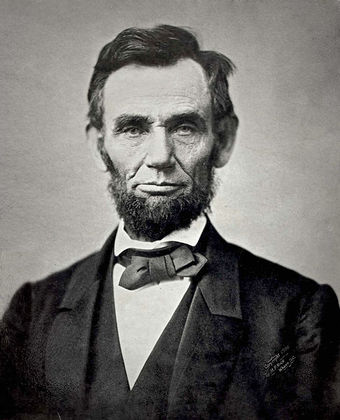
Abraham Lincoln
Abraham Lincoln was the first Republican president.
The second half of the 20th century saw election or succession of Republican presidents Dwight D. Eisenhower, Richard Nixon, Gerald Ford, Ronald Reagan, George H. W. Bush and George W. Bush. The Republican Party, led by House Republican Minority Whip Newt Gingrich campaigning on the Contract with America, was elected to majorities to both houses of Congress in the Republican Revolution of 1994.
In the 21st century, the Republican Party has been defined by social conservatism, a preemptive war foreign policy intended to defeat terrorism and promote global democracy, a more powerful executive branch, supply-side economics, support for gun ownership, and deregulation.
Name and symbols
The party’s founding members chose the name “Republican Party” in the mid-1850s as homage to the values of republicanism promoted by Thomas Jefferson’s Republican Party. The traditional mascot of the party is the elephant. A political cartoon by Thomas Nast, published in Harper’s Weekly on November 7, 1874, is considered the first important use of the symbol. After the 2000 election, the color red became associated with the GOP when on election night, for the first time, all of the major broadcast networks used the same color scheme for the electoral map: red for states won by Republican George W. Bush and blue for Democrat Al Gore.
Ideology and political positions
The Republican Party includes fiscal conservatives, social conservatives, neoconservatives, moderates, and libertarians. Prior to the formation of the conservative coalition, which helped realign the Democratic and Republican Party ideologies in the mid-1960s, the party historically advocated classical liberalism, paleo-conservatism, and progressivism.
Neoconservatism
Neoconservatism is an intellectual movement born in the 1960s inside the monthly review Commentary. Neoconservatism is critical of the so-called welfare state as conceived by the New Left but supportive of the New Deal and moderate welfare statism, offers lukewarm applause for free markets, and advocates “assertive” promotion of democracy and American national interest in international affairs including by military means. Presidents Ronald Reagan, George H.W. Bush, and George W. Bush had neoconservative advisors regarding military and foreign policies. During the George W. Bush administration, neoconservative officials of the Departments of Defense and State helped to plan and promote the Iraq War.
The Bush campaign and the early Bush administration did not exhibit strong endorsement of neoconservative principles. Bush’s policies changed dramatically immediately after the September 11, 2001, attacks. During Bush’s State of the Union speech of January 2002, he named Iraq, Iran, and North Korea as states that “constitute an axis of evil” and “pose a grave and growing danger”. Bush suggested the possibility of preemptive war: “I will not wait on events, while dangers gather. I will not stand by, as peril draws closer and closer. The United States of America will not permit the world’s most dangerous regimes to threaten us with the world’s most destructive weapons.
7.7.3: The Democratic Party
The Democratic Party is a major political party in the US which promotes a social liberal, social democratic and progressive platform.
Learning Objective
Identify the historical origins and development of the Democratic Party, as well as the demographics of the party
Key Points
- The early Democratic Party favored states’ rights and strict adherence to the Constitution while opposing a national bank and wealthy, moneyed interests.
- The Fugitive Slave Law and the Kansas–Nebraska Act were the catalysts that drove the anti-slavery Democrats from the Party. These former Democrats created the Republican Party.
- Since the 1930s, however, the Democratic Party has become much more socially and economically liberal favoring such issues like progressive taxation and a mixed economy in which the government helps alleviate poverty through economic intervention.
Key Terms
- The Democratic Party
-
The Democratic Party is one of two major contemporary political parties in the United States along with the Republican Party. Since the 1930s, the party has promoted a social liberal, social democratic and progressive platform, and its Congressional caucus is composed of progressives, liberals, centrists, and left-libertarians.
- Blue Dog Coalition
-
The Blue Dog Coalition, a caucus of fiscal and social conservatives and moderates forms part of the Democratic Party’s current faction of conservative Democrats. They have acted as a unified voting bloc in the past, giving its forty plus members some ability to change legislation and broker compromises with the Republican Party’s leadership
- Liberals
-
Social liberals (modern liberals) and progressives constitute roughly half of the Democratic voter base. A large majority of liberals favor universal health care, with many supporting a single-payer system, diplomacy over military action, stem cell research, legalization of same-sex marriage, secular government, stricter gun control, and environmental protection laws as well as the preservation of abortion rights. Immigration and cultural diversity is deemed positive; liberals favor cultural pluralism, a system in which immigrants retain their native culture in addition to adopting their new culture.
Democratic Party
The Democratic Party is one of two major contemporary political parties in the United States along with the Republican Party. Since the 1930s, the party has promoted a social liberal, social democratic and progressive platform, and its Congressional caucus is composed of progressives, liberals, centrists, and left-libertarians. The party has the lengthiest record of continuous operation in the United States and is one of the oldest political parties in the world. President Barack Obama is the15th Democrat to hold the presidency.
The Democratic Party evolved from Anti-Federalist factions that opposed the fiscal policies of Alexander Hamilton in the early 1790s. Thomas Jefferson and James Madison organized these factions into the Democratic-Republican Party. The party favored states’ rights and strict adherence to the Constitution; it opposed a national bank and wealthy, moneyed interests. The Democratic-Republican Party gained power in the election of 1800.
Democratic-Republicans split over the choice of a successor to President James Monroe, and the party faction that supported many of the old Jeffersonian principles, led by Andrew Jackson and Martin Van Buren, became the Democratic Party . In the 1850s, under the stress of the Fugitive Slave Law and the Kansas–Nebraska Act, anti-slavery Democrats left the party. Joining with former members of existing or dwindling parties, the Republican Party emerged. In the lead up to the 1860 election, the Democratic Party split further, this time, over nominees which led to a Republican victory and Abraham Lincoln was elected the 16th President of the United States.
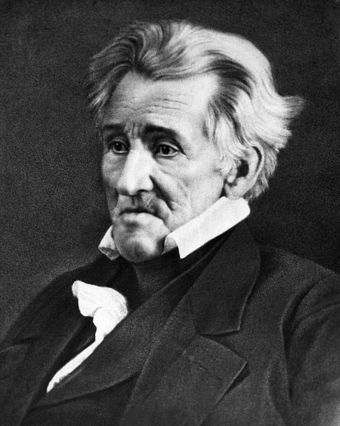
Andrew Jackson
Andrew Jackson is typically considered the first Democratic President.
As the American Civil War broke out, Northern Democrats were divided into War Democrats and Peace Democrats. Most War Democrats rallied to Republican President Abraham Lincoln and the Republicans’ National Union Party in the election of 1864, which featured Andrew Johnson on the Republican ticket even though he was a Democrat from the South.
After the end of Reconstruction in the 1870s, the South, voting Democratic, became known as the “Solid South. ” Though Republicans won all but two presidential elections, the Democrats remained competitive.
The Great Depression in 1929 that occurred under Republican President Hoover set the stage for a more liberal government; the Democrats controlled the House of Representatives nearly uninterrupted from 1931 until 1995 and won most presidential elections until 1968. Franklin D. Roosevelt, elected to the presidency in 1932, came forth with government programs called the New Deal.
New Deal liberalism meant the promotion of social welfare, labor unions, civil rights, and regulation of business. The opponents, who stressed long-term growth, support for business, and low taxes, started calling themselves “conservatives. “
African Americans, who traditionally supported the Republican Party, began supporting Democrats following the ascent of the Franklin Roosevelt administration, the New Deal, and the Civil Rights movement. The Democratic Party’s main base of support shifted to the Northeast, marking a dramatic reversal of history. Bill Clinton was elected to the presidency in 1992, as a New Democrat. Re-elected in 1996, Clinton was the first two term Democratic President since Roosevelt.
Some of the party’s key issues in the early 21st century in their last national platform have included the methods of how to combat terrorism, homeland security, expanding access to health care, labor rights, environmentalism, and the preservation of liberal government programs.
Since 1912, the Democratic Party has moved to the left of the Republicans on economic and social issues. Roosevelt’s economic philosophy strongly influenced American liberalism and has shaped much of the party’s economic agenda since 1932.
Since the 1890s, the Democratic Party has favored liberal positions (“liberal” in this case meaning social liberalism). Historically, the party has favored farmers, laborers, labor unions, and religious and ethnic minorities; it has opposed unregulated business and finance, and favored progressive income taxes. In foreign policy, internationalism (including interventionism) was a dominant theme from 1913 to the mid-1960s. The major influences for liberalism were labor unions (which peaked in the 1936–1952 era), and the African American wing, which has steadily grown since the 1960s.
The mixed economy policy adopted by the modern Democratic Party has been referred to as the “Third Way”. Democrats believe government should play a role in alleviating poverty and social injustice and use a system of progressive taxation.
Initially calling itself the “Republican Party,” Jeffersonians were labeled “Democratic” by the Federalists, hoping to stigmatize them as purveyors of mob rule.
The most common mascot symbol for the party is the donkey, although the party never officially adopted this symbol. Andrew Jackson’s opponents had labeled him a jackass during the intense mudslinging in 1828
The Blue Dog Coalition, a caucus of fiscal and social conservatives and moderates, forms part of the Democratic Party’s current faction of conservative Democrats.
Since election night in 2000, the color blue has become the identified color of the Democratic Party, all major broadcast television networks used blue for Democrat Al Gore.
7.8: The History of Political Parties
7.8.1: The First Political Parties: Federalists and Anti-Federalists
The winning supporters of ratification of the Constitution were called Federalists, the opponents were called Anti-Federalists.
Learning Objective
Distinguish the differences between the Federalist and Anti-Federalist parties
Key Points
- The immediate problem faced by the Federalists was not simply one of acceptance of the Constitution, but the more fundamental concern of legitimacy for the government of the new republic.
- The Anti-Federalists objected to the new powerful central government, the loss of prestige for the states, and saw the Constitution as a potential threat to personal liberties.
- The major stumbling block for the Anti-Federalists was that the supporters of the Constitution had been more deeply committed, had cared more, and had outmaneuvered the less energetic opposition.
Key Terms
- Bill of Rights
-
The collective name for the first ten amendments to the United States Constitution.
- Anti-Federalists
-
Opponents of the ratification of the U.S. Constitution and a strong central government.
- federalist
-
Supporters of ratification of the U.S. Constitution
The Federalist Era was a period in American history from roughly 1789-1801 when the Federalist Party was dominant in American politics. This period saw the adoption of the United States Constitution and the expansion of the federal government. In addition, the era saw the growth of a strong nationalistic government under the control of the Federalist Party. Among the most important events of this period were the foreign entanglements between France and Great Britain, the assertion of a strong centralized federal government, and the creation of political parties. The First Party System of the United States featured the Federalist Party and the Democratic-Republican Party (also known as the Anti-Federalist Party).
The United States Constitution was written in 1787 and unanimously ratified by the states in 1788, taking effect in 1789. The winning supporters of ratification of the Constitution were called Federalists and the opponents were called Anti-Federalists. The immediate problem faced by the Federalists was not simply one of acceptance of the Constitution but the more fundamental concern of legitimacy for the government of the new republic. With this challenge in mind, the new national government needed to act with the idea that every act was being carried out for the first time and would therefore have great significance and be viewed along the lines of the symbolic as well as practical implications. The first elections to the new United States Congress returned heavy Federalist majorities. The first Anti-Federalist movement opposed the draft Constitution in 1788, primarily because they lacked a Bill of Rights. The Anti-Federalists, or Democrat-Republicans, objected to the new powerful central government and the loss of prestige for the states, and saw the Constitution as a potential threat to personal liberties. During the ratification process the Anti-Federalists presented a significant opposition in all but three states. A major stumbling block for the Anti-Federalists, however, was that the supporters of the Constitution were more deeply committed and outmaneuvered the less energetic opposition.
Federalists v. Anti-Federalists
The dynamic force in the Presidency of George Washington was the secretary of the treasury, Alexander Hamilton . Hamilton had the vision of a strong national government and a strong national economy. He devised a complex multi-faceted program to achieve that goal and simultaneously solved the debt problem for most of the states. Hamilton created a financial system for national and international stability that included paying off the national debt and laying the infrastructure for further economic development. Hamilton’s programs included:
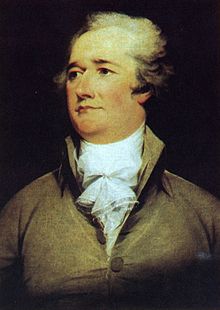
Alexander Hamilton
Alexander Hamilton, secretary of treasury under President George Washington, became a leading Federalist in the Federalist vs. Anti-Federalists debate.
- the assumption of the state’s Revolutionary War debts;
- the payoffs of the debts of the old Continental Congress;
- the payoffs of loans from foreign treasuries and investors;
- the creation of a system of taxes and tariffs to pay for the debt; and
- a First Bank of the United States to handle the finances.
Congress approved Hamilton’s programs, which would later be labeled Federalist, over the opposition of the old Anti-Federalists element, which increasingly coalesced under the leadership of Thomas Jefferson and James Madison. In order to build a national network in support of his programs, Hamilton created a coalition of supporters in every city and state, often consisting of prominent businessmen and financiers. Hamilton’s network of supporters grew into the “Federalist Party” that included most, but not all, of those Federalists who supported the Constitution in 1788. A major emphasis of Hamilton’s policies and indeed the general outlook for the Federalist Party was that the federal government was to preside over the national economy.
Rise of political parties
Federalists during the ratification period had been unified around the Constitution and support for its form of government. Following the acceptance of the Constitution, the initial Federalist movement faded briefly only to be taken up by a second movement centered upon the support for Alexander Hamilton’s policies of a strong nationalist government, loose construction of the Constitution, and mercantile economic policies. The support around these policies eventually established the first official political party in the United States as the Federalist Party. The Party reached its political apex with the election of the strongly Federalist President John Adams. However the defeat of Adams in the election of 1800 and the death of Hamilton led to the decline of the Federalist Party from which it did not recover. While there were still Federalists after 1800, the party never again enjoyed the power and influence it had held earlier. One of the Federalists Era’s greatest accomplishments was that republican government survived and took root in the United States.
Republicans, or the Democratic-Republican Party, was founded in 1792 by Jefferson and James Madison. The party was created in order to oppose the policies of Hamilton and the Federalist Party. In contrast to the Federalists, the Republican supported a strict construction interpretation of the Constitution, and denounced many of Hamilton’s proposals (especially the national bank) as unconstitutional. The party promoted states’ rights and the primacy of the yeoman farmer over bankers, industrialists, merchants, and other monied interests. The party supported states’ rights as a measure against the tyrannical nature of a large centralized government that they feared the Federal government could have easily become. It would be Jefferson and the Republican Party that would replace the Federalist Party domination of politics following the election of 1800.
7.8.2: Political Parties from 1800–1824
The First Party System refers to political party system existing in the United States between roughly 1792 and 1824.
Learning Objective
Distinguish the issues and policies supported by the first political parties and identify the central elements of the First Party System
Key Points
- Rising out of the Federalist v. Anti-Federalist debates, it featured two national parties competing for control of the presidency, Congress, and the states: the Federalist Party and the rival Democratic-Republican Party.
- The Federalists were dominant until 1800, and the Republicans were dominant after 1800.
- The Federalists appealed to the business community, the Republicans to the planters and farmers.
Key Terms
- Whig Party
-
The Whig Party was a political party of the United States during the era of Jacksonian democracy. Considered integral to the Second Party System and operating from the early 1830s to the mid-1850s, the party was formed in opposition to the policies of President Andrew Jackson and his Democratic Party. In particular, the Whigs supported the supremacy of Congress over the presidency and favored a program of modernization and economic protectionism.
- republican
-
Advocating or supporting a republic as a form of government.
The First Party System is a model of American politics used by political scientists and historians to periodize the political party system existing in the United States between roughly 1792 and 1824. Rising out of the Federalist v. Anti-Federalist debates, it featured two national parties competing for control of the presidency, Congress, and the states: the Federalist Party, created largely by Alexander Hamilton, and the rival Democratic-Republican Party formed by Thomas Jefferson and James Madison. The Federalists were dominant until 1800, and the Republicans were dominant after 1800.
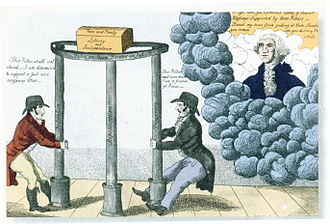
The First Party System
Federalist poster about 1800. Washington (in heaven) tells partisans to keep the pillars of Federalism, Republicanism and Democracy
In an analysis of the contemporary party system, Jefferson wrote on Feb. 12, 1798: “Two political Sects have arisen within the US, the one believing that the executive is the branch of our government which the most needs support; the other, that like the analogous branch in the English Government, it is already too strong for the republican parts of the Constitution; and therefore in equivocal cases they incline to the legislative powers: the former of these are called federalists, sometimes aristocrats or monocrats, and sometimes tories, after the corresponding sect in the English Government of exactly the same definition: the latter are stiled republicans, whigs, jacobins, anarchists, disorganizers, etc. these terms are in familiar use with most persons. “
Both parties originated in national politics, but later expanded their efforts to gain supporters and voters in every state. The Federalists appealed to the business community, the Republicans to the planters and farmers. By 1796 politics in every state was nearly monopolized by the two parties, with party newspapers and caucuses becoming especially effective tools to mobilize voters.
The Federalists promoted the financial system of Treasury Secretary Hamilton, which emphasized federal assumption of state debts, a tariff to pay off those debts, a national bank to facilitate financing, and encouragement of banking and manufacturing. The Republicans, based in the plantation South, opposed a strong executive power, were hostile to a standing army and navy, demanded a limited reading of the Constitutional powers of the federal government, and strongly opposed the Hamilton financial program. Perhaps even more important was foreign policy, where the Federalists favored Britain because of its political stability and its close ties to American trade, while the Republicans admired the French and the French Revolution. Jefferson was especially fearful that British aristocratic influences would undermine Republicanism. Britain and France were at war from 1793 through 1815, with one brief interruption. American policy was neutrality, with the Federalists hostile to France, and the Republicans hostile to Britain. The Jay Treaty of 1794 marked the decisive mobilization of the two parties and their supporters in every state. President George Washington, while officially nonpartisan, generally supported the Federalists, and that party made Washington their iconic hero. The First Party System ended during the Era of Good Feelings (1816–1824), as the Federalists shrank to a few isolated strongholds and the Republicans lost unity. In 1824-28, as the Second Party System emerged, the Republican Party split into the Jacksonian faction, which became the modern Democratic Party in the 1830s, and the Henry Clay faction, which was absorbed by Clay’s Whig Party.
7.8.3: Jacksonian Democrats: 1824–1860
Jacksonian democracy is the political movement toward greater democracy for the common man typified by American politician Andrew Jackson.
Learning Objective
Compare and contrast Jacksonian democracy with Jeffersonian democracy
Key Points
- Jackson’s policies followed the era of Jeffersonian democracy which dominated the previous political era.
- Jackson’s supporters began to form the modern Democratic Party; they fought the rival Adams and Anti-Jacksonian factions, which soon emerged as the Whigs.
- During the Jacksonian era, the suffrage was extended to (nearly) all white male adult citizens.
Key Terms
- strict constructionism
-
a particular legal philosophy of judicial interpretation that limits or restricts judicial interpretation (the phrase is also commonly used more loosely as a generic term for conservatism among the judiciary)
- laissez-faire
-
an economic environment in which transactions between private parties are free from tariffs, government subsidies, and enforced monopolies, with only enough government regulations sufficient to protect property rights against theft and aggression
- Andrew Jackson
-
Andrew Jackson (March 15, 1767 – June 8, 1845) was the seventh President of the United States (1829–1837).
Jacksonian democracy is the political movement toward greater democracy for the common man typified by American politician Andrew Jackson and his supporters. Jackson’s policies followed the era of Jeffersonian democracy which dominated the previous political era. The Democratic-Republican Party of the Jeffersonians became factionalized in the 1820s. Jackson’s supporters began to form the modern Democratic Party; they fought the rival Adams and Anti-Jacksonian factions, which soon emerged as the Whigs.
More broadly, the term refers to the period of the Second Party System (mid-1824–1860) when the democratic attitude was the spirit of that era. It can be contrasted with the characteristics of Jeffersonian democracy. Jackson’s equal political policy became known as “Jacksonian Democracy,” subsequent to ending what he termed a “monopoly” of government by elites. Jeffersonians opposed inherited elites but favored educated men while the Jacksonians gave little weight to education. The Whigs were the inheritors of Jeffersonian Democracy in terms of promoting schools and colleges. During the Jacksonian era, the suffrage was extended to (nearly) all white male adult citizens.
In contrast to the Jeffersonian era, Jacksonian democracy promoted the strength of the presidency and executive branch at the expense of Congress, while also seeking to broaden the public’s participation in government. They demanded elected (not appointed) judges and rewrote many state constitutions to reflect the new values. In national terms the Jacksonians favored geographical expansion, justifying it in terms of Manifest Destiny. There was usually a consensus among both Jacksonians and Whigs that battles over slavery should be avoided. The Jacksonian Era lasted roughly from Jackson’s 1828 election until the slavery issue became dominant after 1850 and the American Civil War dramatically reshaped American politics as the Third Party System emerged.
Jacksonian democracy was built on the following general principles:
Expanded Suffrage
The Jacksonians believed that voting rights should be extended to all white men. By 1820, universal white male suffrage was the norm, and by 1850 nearly all requirements to own property or pay taxes had been dropped.
Manifest Destiny
This was the belief that white Americans had a destiny to settle the American West and to expand control from the Atlantic Ocean to the Pacific and that the West should be settled by yeoman farmers. However, the Free Soil Jacksonians, notably Martin Van Buren, argued for limitations on slavery in the new areas to enable the poor white man to flourish; they split with the main party briefly in 1848. The Whigs generally opposed Manifest Destiny and expansion, saying the nation should build up its cities.
Patronage
Also known as the spoils system, patronage was the policy of placing political supporters into appointed offices. Many Jacksonians held the view that rotating political appointees in and out of office was not only the right but also the duty of winners in political contests. Patronage was theorized to be good because it would encourage political participation by the common man and because it would make a politician more accountable for poor government service by his appointees. Jacksonians also held that long tenure in the civil service was corrupting, so civil servants should be rotated out of office at regular intervals. However, it often led to the hiring of incompetent and sometimes corrupt officials due to the emphasis on party loyalty above any other qualifications.
Strict Constructionism
Like the Jeffersonians who strongly believed in the Kentucky and Virginia Resolutions, Jacksonians initially favored a federal government of limited powers. Jackson said that he would guard against “all encroachments upon the legitimate sphere of State sovereignty”. This is not to say that Jackson was a states’ rights extremist; indeed, the Nullification Crisis would find Jackson fighting against what he perceived as state encroachments on the proper sphere of federal influence. This position was one basis for the Jacksonians’ opposition to the Second Bank of the United States. As the Jacksonians consolidated power, they more often advocated expanding federal power and presidential power in particular.
Laissez-faire Economics
Complementing a strict construction of the Constitution, the Jacksonians generally favored a hands-off approach to the economy, as opposed to the Whig program sponsoring modernization, railroads, banking, and economic growth. The leader was William Leggett of the Locofocos in New York City.
Banking
In particular, the Jacksonians opposed government-granted monopolies to banks, especially the national bank, a central bank known as the Second Bank of the United States. Despite this, Jackson did not actively seek to destroy or fight the Bank, only vetoing the Bank’s recharter and subsequently pulling out federal reserves. The Whigs, who strongly supported the Bank, were led by Daniel Webster and Nicholas Biddle, the bank chairman. Jackson himself was opposed to all banks, because he believed they were devices to cheat common people; he and many followers believed that only gold and silver could be money (.
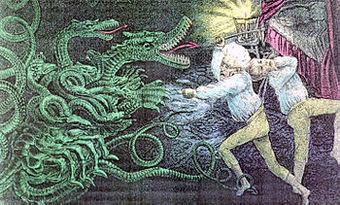
Jackson and Banking
Democratic cartoon shows Jackson slaying the monster Bank
7.8.4: The Golden Age: 1860–1932
Despite outward indicators of prosperity, the Gilded Age (late 1860s to 1896) was an era characterized by turmoil and political contention.
Learning Objective
Describe major economic and political developments during the “Gilded Age” of American history and identify what led to these developments
Key Points
- The term “The Gilded Age” was coined by writers Mark Twain and Charles Dudley Warner in The Gilded Age: A Tale of Today, which satirized what they believed to be an era of serious social problems obscured by a thin veneer of prosperity.
- The Gilded Age was a time of enormous growth that attracted millions from Europe.
- Gilded Age politics, called the Third Party System, was characterized by intense competition between the two parties, with minor parties coming and going, especially on issues of concern to prohibitionists, labor unions and farmers.
- The Fourth Party System lasted from about 1896 to 1932, and was dominated by the Republican Party; it is generally referred to as the Progressive Era.
Key Terms
- Reconstruction
-
A period in U.S. history from 1865 to 1877, during which the nation tried to resolve the status of the ex-Confederate states, the ex-Confederate leaders, and the Freedmen (ex-slaves) after the American Civil War.
- Third Party System
-
A period in American political history from about 1854 to the mid-1890s that featured profound developments in issues of nationalism, modernization, and race.
In United States history, the Gilded Age was the period following the Civil War, running from the late 1860s to about 1896 when the next era began, the Progressive Era. The term was coined by writers Mark Twain and Charles Dudley Warner in The Gilded Age: A Tale of Today, which satirized what they believed to be an era of serious social problems obscured by a thin veneer of prosperity.
The Gilded Age was a time of enormous growth that attracted millions of European immigrants. Railroads were the major industry, but the factory system, mining, and labor unions also gained in importance . Despite the growth, there was serious cause for concern, which manifested in two major nationwide depressions, known as the Panic of 1873 and the Panic of 1893. Furthermore, most of the growth and prosperity came in the North and West – states that had been part of the Union. States in the South, part of the defeated Confederate States of America, remained economically devastated; their economies became increasingly tied to cotton and tobacco production, which suffered low prices. African Americans in the south experienced the worst setbacks, as they were stripped of political power and voting rights.
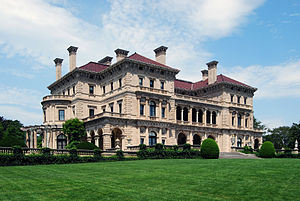
Gilded Age
The Breakers, the summer home of Cornelius Vanderbilt II, located in Newport, Rhode Island, United States. It was built in 1893, added to the National Register of Historic Places in 1971, and designated a National Historic Landmark in 1994.
During the 1870s and 1880s, the U.S. economy rose at the fastest rate in its history, with real wages, wealth, gross domestic product (GDP), and capital formation all increasing rapidly. Between 1865 and 1898, the output of wheat increased by 256%, corn by 222%, coal by 800% and miles of railway track by 567%. Thick national networks for transportation and communication were created. The corporation became the dominant form of business organization, and a managerial revolution transformed business operations. By the beginning of the 20th century, per capita income and industrial production in the United States led the world, with per capita incomes double that of Germany or France, and 50% higher than Britain.
Politics in the Gilded Age
Gilded Age politics, called the Third Party System, were characterized by rampant corruption and intense competition between the two parties (with minor parties coming and going), especially on issues of Prohibitionist, labor unions and farmers. The Democrats and Republicans fought over control of offices as well as major economic issues. The dominant political issues included rights for African Americans, tariff policies and monetary policies. Reformers worked for civil service reform, prohibition and women’s suffrage, while philanthropists built colleges and hospitals, and the many religious denominations exerted a major sway in both politics and everyday life.
Voter turnout was very high and often exceeded 80% or even 90% in some states as the parties were adamant about rallying their loyal supporters. Competition was intense and elections were very close. In the South, lingering resentment over the Civil War meant that most states would vote Democrat. After the end of Reconstruction in 1877, competition in the South took place mainly inside the Democratic Party. Nationwide, voter turnout fell sharply after 1900.
The Third Party System (1854-1890s)
The Third Party System lasted from about 1854 to the mid-1890s, and featured profound developments in issues of nationalism, modernization, and race. It was dominated by the new Republican Party (also known as the Grand Old Party or GOP), which claimed success in saving the Union, abolishing slavery and enfranchising the freedmen, while adopting many Whiggish modernization programs such as national banks, railroads, high tariffs, homesteads, social spending (such as on greater Civil War veteran pension funding), and aid to land grant colleges. While most elections from 1874 through 1892 were extremely close, the opposition Democrats won only the 1884 and 1892 presidential elections. The northern and western states were largely Republican, save for closely balanced New York, Indiana, New Jersey, and Connecticut. After 1874, the Democrats took control of the “Solid South. “
The Fourth Party System (1896-1932)
The Fourth Party System lasted from about 1896 to 1932, and was dominated by the Republican Party, excepting the 1912 split in which Democrats held the White House for eight years. American history texts usually call it the Progressive Era, and it included World War I and the start of the Great Depression. The period featured a transformation from the issues of the Third Party System, instead focusing on domestic issues such as regulation of railroads and large corporations (“trusts”), the money issue (gold versus silver), the protective tariff, the role of labor unions, child labor, the need for a new banking system, corruption in party politics, primary elections, direct election of senators, racial segregation, efficiency in government, women’s suffrage, and control of immigration. Foreign policy centered on the 1898 Spanish-American War, Imperialism, the Mexican Revolution, World War I, and the creation of the League of Nations.
7.8.5: The Modern Era of Political Parties
Modern politics in the United States is a two-party system dominated by the Democratic Party and the Republican Party.
Learning Objective
Demonstrate knowledge of the key issues that divide the Democratic and Republican parties in the United States
Key Points
- These two parties have won every United States presidential election since 1852 and have controlled the United States Congress since at least 1856.
- The Democratic Party, since the division of the Republican Party in the election of 1912, has positioned itself as progressive and supporting labor in economic as well as social matters.
- Today, the Republican Party supports an American conservative platform, with further foundations in economic liberalism, fiscal conservatism, and social conservatism.
Key Terms
- two-party system
-
A two-party system is a system where two major political parties dominate voting in nearly all elections at every level of government and, as a result, nearly all elected officials are members of one of the two major parties.
- Republican Party
-
The Republican Party is one of the two major contemporary political parties in the United States of America.
- Democratic Party
-
The Democratic Party is one of two major political parties in the United States.
Modern politics in the United States is a two-party system dominated by the Democratic Party and the Republican Party. One of these two parties has won every United States presidential election since 1852 and has controlled the United States Congress since at least 1856.

Modern Two-Party System
The 2008 elections, while won by a Democrat, reflect the relatively even divide in the United States between the Republican and Democratic Parties.
The Democratic Party is one of two major political parties in the United States, and is the oldest political party in the world. Since the division of the Republican Party in the election of 1912, it has positioned itself as progressive and supporting labor in economic as well as social matters. The economic philosophy of Franklin D. Roosevelt, which has strongly influenced American liberalism, has shaped much of the party’s agenda since 1932, and Roosevelt’s New Deal coalition controlled the White House until 1968.
In 2004, it was the larger major political party, with 72 million voters (42.6% of 169 million registered) claiming affiliation. The current President of the United States, Barack Obama, is the 15th Democrat to hold the office, and since the 2006 midterm elections, the Democratic Party has held a majority in the United States Senate.
A 2011 USA Today review of state voter rolls indicates that registered Democrats declined in 25 of the 28 states that register voters by party. Democrats were still the largest political party with more than 42 million voters (compared with 30 million Republicans and 24 million independents). However, in 2011, the number of Democrats shrank 800,000, and from 2008 they were down by 1.7 million, or 3.9%.
The other major contemporary political party in the United States is the Republican Party. It is often referred to as the GOP, which stands for “Grand Old Party,” or “Gallant Old Party”. Founded in 1854 by Northern anti-slavery expansion activists and modernizers, the Republican Party rose to prominence with the election of Abraham Lincoln, the first Republican to campaign on the Northern principles of anti-slavery. The party presided over the American Civil War and Reconstruction but was harried by internal factions and scandals toward the end of the 19th century. Today, the Republican Party supports an American conservative platform, with foundations in economic liberalism, fiscal conservatism, and social conservatism.
Former President George W. Bush was the 19th Republican to hold that office. The party’s nominee for President of the United States in the 2012 presidential election is former Massachusetts Governor Mitt Romney. Since the 2010 midterm elections, the Republicans have held a majority in the United States House of Representatives.
USA Today’s review of state voter rolls indicates that registered Republicans declined in 21 of the 28 states that register voters by party, and that Republican registrations were down 350,000 in 2011. The number of independents rose in 18 states, increasing by 325,000 in 2011, and was up more than 400,000 from 2008, or 1.7%.
7.9: Party Functions
7.9.1: Hosting Conventions
The major political parties in the U.S. host the Democratic and Republican National Conventions to select candidates and rally supporters.
Learning Objective
Describe the informal aims of the national conventions
Key Points
- The formal purpose of hosting presidential nominating conventions is to select a party’s presidential and vice presidential candidates, to develop a party platform, and to adopt the rules governing the election cycle.
- Presidential nominating conventions are also significant in rallying support for a given party, unifying party views, and showcasing a party’s leadership to a national audience.
- The most prominent presidential nominating conventions include the Democratic National Convention and the Republican National Convention.
- Because of a recent trend of Democratic and Republican presidential nominees being known well in advance of these conventions, the Democratic and Republic National Conventions have steered away from their formal purposes to serve more as a point of party unification.
Key Terms
- presidential nominating convention
-
Convention in which presidential and vice presidential candidates are determined, party platforms are established, and rules governing the election cycle are adopted. The most influential presidential nominating conventions include the Democratic and Republican National Conventions.
- platform
-
A political stance on a broad set of issues, which are called planks.
- delegate
-
A person authorized to act as representative for another; in politics, a party representative allocated to nominate a party candidate.
Political parties in the United States that will be fielding nominees in an upcoming U.S. presidential election are responsible for hosting presidential nominating conventions. The formal purpose of the conventions is to select the party’s candidates for president and vice president. The conventions develop a statement of party principles and goals known as a party platform. Another formal purpose of presidential nominating conventions is to adopt the rules for a given party’s activities, such as the presidential nominating process for the following election cycle.
Nominating conventions also carry significance beyond their formal purposes. Conventions are an opportunity to rally political supporters and reward the party faithful by allowing them to participate asdelegates. Due to the national media presence surrounding presidential nominating conventions, they are also excellent tools to showcase a given party’s leaders and policies to prospective voters.
The two major political parties in the U.S. host the quadrennial Democratic National Convention and Republican National Convention to determine their respective presidential and vice presidential candidates. The Democratic National Committee administers the Democratic National Convention while the Republican National Committee administers the Republican National Convention. In recent years, candidates from the Democratic and Republican parties have been known in advance of these conventions. Subsequently, the more modern focus of the Democratic and Republican National Conventions has been to unify each respective party by having delegates vote on issues that the nominee can incorporate into their presidential campaign. The conventions also generate positive publicity towards each respective party.
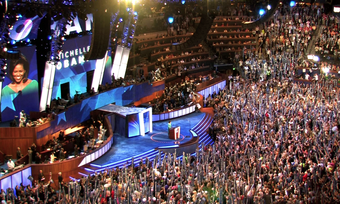
Democratic National Convention
Presidential nominating conventions, like the Democratic National Convention, host influential speakers to increase party unity.
Some minor political parties in the U.S. also utilize conventions to select their presidential candidates. Examples of such minor parties include the Green Party, Socialist Party USA, Libertarian Party, Constitution Party, and Reform Party USA.
7.9.2: Selecting Candidates
Election candidates have often been determined before conventions, but are still formally declared as their party’s official candidates at the conventions.
Learning Objective
Describe the roll call method of voting during a convention
Key Points
- The two major parties in the U.S. formally select their candidates during the quadrennial Democratic National Convention and Republic National Convention.
- Presidential and vice presidential candidates are often known well in advance of presidential nominating conventions because of changes in election laws, earlier primaries and caucuses, and the manner in which political campaigns are now run.
- The Democratic and Republican Parties have their own formulas for determining the size of state delegations that will vote for a presidential and vice presidential candidate during presidential nominating conventions.
Key Terms
- rolling roll call of the states
-
an alphabetical calling of the states during a presidential nominating convention to either declare its delegate count or pass
- delegate
-
A person authorized to act as representative for another; in politics, a party representative allocated to nominate a party candidate.
- primary
-
A primary election; a preliminary election to select a political candidate of a political party.
- caucus
-
A meeting, especially a preliminary meeting, of persons belonging to a party, to nominate candidates for public office, or to select delegates to a nominating convention, or to confer regarding measures of party policy; a political primary meeting.
Introduction
The Democratic National Committee and Republican National Committee create the rules governing the caucuses and primaries in which the field of presidential nominees is narrowed. These nominees then proceed to the presidential nominating conventions where a candidate will officially be determined.
The presidential candidates of the two major political parties in the United States are formally confirmed during the Democratic National Convention and Republican National Convention. Each party determines its own rules for the format of the convention and how participation is to be apportioned. Generally, each U.S. state and territory is allotted a select number of voting representatives, known individually as delegates and collectively as the delegation. The size of each delegation depends upon the unique formula used by a given political party. Such formulas usually consider the population of a given state, the state’s previous presidential voting patterns, and the number of Congressional representatives or government officials in a state who are members of the party.
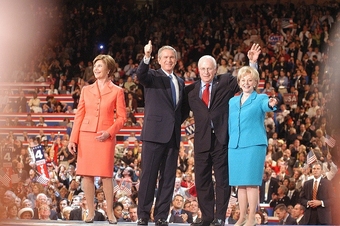
2004 Republican National Convention Presidential and Vice Presidential Candidates
George W. Bush and Dick Cheney were declared the official presidential and vice presidential candidates at the 2004 Republican National Convention.
Voting Using the Rolling Roll Call
The voting method used during a convention is known as a rolling roll call of the states. The spokespersons of the states are called upon in alphabetical order by state name to announce their delegation count or to pass. After all states have either declared or passed, those states that passed must announce their delegate count. The decision to pass is usually made beforehand to give either the delegation of the presidential or vice presidential candidates’ home state the honor of casting the majority-making vote.
In recent years, presidential nominees have been known well in advance of the Democratic and Republican National Conventions due to changes in election laws, earlier primary elections and caucuses, and the manner in which political campaigns are run. However, the presidential nominating conventions still serve as the official method of selecting presidential candidates.
7.9.3: Organizing Campaigns and Elections
Political parties play key roles in organizing campaigns and elections.
Learning Objective
Name other activities that fall under the auspicies of the national political committees
Key Points
- The Democratic National Committee (DNC) and Republican National Committee (RNC) are the central organizations devoted to campaign and political activity. They establish connections between followers of the Democratic and Republican parties with the respective leadership of each party.
- At the start of the preliminary election season, the DNC and RNC are responsible for establishing the rules for the caucuses and primary elections.
- The DNC and RNC supervise the presidential nominating conventions that officially declare the Democratic and Republican presidential candidates. Once a presidential candidate is chosen from each respective party, the Committees provide crucial candidate support and party-building activities.
Key Terms
- presidential nominating convention
-
Convention in which presidential and vice presidential candidates are determined, party platforms are established, and rules governing the election cycle are adopted. The most influential presidential nominating conventions include the Democratic and Republican National Conventions.
- caucus
-
A meeting, especially a preliminary meeting, of persons belonging to a party, to nominate candidates for public office, or to select delegates to a nominating convention, or to confer regarding measures of party policy; a political primary meeting.
- primary
-
A primary election; a preliminary election to select a political candidate of a political party.
In addition to hosting conventions and selecting candidates to run in presidential elections, political parties play key roles in organizing campaigns and elections. The Democratic National Committee (DNC) and Republican National Committee (RNC), in particular, are the central organizations devoted to campaign and political activity in support of the Democratic and Republican Party candidates. The DNC and RNC are permanent offices maintained by the Democratic and Republican parties to govern the daily operations of each party, as well as the special election and campaign operations conducted every four years. The DNC and RNC establish connections between followers of the Democratic and Republican parties with the respective leadership of each party. Such connections play a vital role in allowing presidential candidates to maintain a base of supporters they can depend upon during elections.
The Democratic National Committee and Republican National Committee connect voters with party leadership in a variety of ways. At the start of the preliminary election season, the DNC and RNC are responsible for establishing the rules for the caucuses and primary elections. These caucuses and primaries are usually not run by the DNC and RNC but instead by the state. Aside from the process of nominating a presidential candidate, the DNC and RNC’s roles in selecting candidates to run on the Democratic and Republican Party ticket is minimal.
Later, the DNC and RNC supervise the presidential nominating conventions that officially declare the Democratic and Republican presidential candidates. Once a presidential candidate is chosen from each respective party, the Democratic and Republican National Committees provide crucial candidate support and party-building activities. Candidate support activities range from collecting polling data to running ad campaigns. Meanwhile, party-building activities often include voter registration and get-out-the-vote drives. The DNC and RNC also engage in coordinating fundraising and election strategies.

Polling Data
The DNC and RNC collect polling data to produce maps showing where candidates have leads in certain areas. This information is helpful in developing campaign strategies.
7.9.4: Informing the Public
Informing the public by traditional and modern mass media is a goal of the DNC and RNC, who gain supporters by remaining.
Learning Objective
Describe the role the national committees play on behalf of the major political parties
Key Points
- The DNC and RNC utilize traditional mass media press releases and staged events as well as more modern social media sites, like Facebook and Twitter, to express their views and attract supporters.
- Informing the public and affecting what is reported on in the media is of vital importance in attracting voters, gaining campaign donations, and effectively promoting party leaders and causes.
- Political parties engage in spin with journalists and produce and air advertisements to manage the way their party is seen in the media.
Key Terms
- Republican National Committee
-
The national leadership of the Republic Party that is responsible for promoting the Republic political platform and coordinating fundraising and election strategies
- Democratic National Committee
-
The national leadership of the Democratic Party that is responsible for promoting the Democratic political platform and coordinating fundraising and election strategies
- spin
-
To present, describe, or interpret, or to introduce a bias or slant so as to give something a favorable or advantageous appearance.
Public Relations
The Democratic National Committee (DNC) and Republican National Committee (RNC) provide an important link between the Democratic and Republican leaders and the general public. The DNC and RNC vie for the attention of the public in hopes of attracting voters. using multimedia strategies that encompass both traditional as well as more modern approaches. Traditional mass media approaches include issuing press releases and coordinating staged events; more modern approaches include reaching out to prospective constituents through Facebook pages, Twitter feeds, and YouTube channels.
Both Democratic and Republican parties have developed sophisticated websites that provide extensive information about voting logistics, candidates and officeholders, and issue positions. These party websites also provide a means for direct participation in the DNC or RNC by providing information on volunteer activities and other opportunities to contribute to the Democratic and Republican Parties.
Political parties also play an active role in managing the media. In addition to hosting websites and populating social media, parties engage in spin with journalists and produce and air radio and television advertisements. It is important for parties to interact with the media in order to attract positive attention to their political candidates and remain viable in the public eye. Parties that have a strong media presence are the most effective in attracting volunteers and financial contributors.
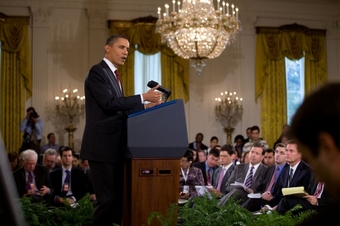
Spin
Press conferences are one way in which politicians can engage journalists in spin, or interpreting an issue or event in the favor of their political party.
The role of parties in informing the public can most clearly be seen in the relationship between the DNC and the Obama administration. After his inauguration, Obama transferred his Obama for America organization to the DNC, which renamed it Organizing for America. Under the leadership of the DNC, Organizing for America controls the BarackObama.com domain and website and works closely with the White House New Media Director.
7.9.5: Checking the Power of the Governing Party
The legislative branch can significantly affect the power of the governing party by employing a series of checks and balances.
Learning Objective
Describe the relationship between the political parties and a system of checks and balances
Key Points
- The Democratic and Republican Parties can check the power of the governing executive party by holding the majority of seats in the legislative branch of government, also known as the Congress.
- The system of checks and balances prevents any one branch of government from becoming too powerful. However, this system can also prevent progress when one party is in office and another party occupies the majority of legislative seats.
- The legislative branch can check the power of the governing party by overriding presidential vetoes, starting investigations with the executive branch, ratifying treaties signed by the president, confirming presidential appointments, and having the power to impeach.
Key Terms
- divided government
-
A situation in which one political party controls the White House while another party controls the majority of the Congress
- executive branch
-
The branch of government that oversees the carrying out of the laws, led by the president.
- checks and balances
-
A system for multiple parties wherein each has some control over the actions of each of the others.
- legislative branch
-
The branch of government which is concerned with the making of laws; made up of the House of Representatives and the Senate, collectively known as the Congress
Checking the Power of the Governing Party
The Democratic and Republican Parties can check the power of the governing party by holding seats in the legislative branch of the government. The legislative branch of the United States government is composed of the Senate and House of Representatives. The Senate has the power to consider presidential appointments of judges and executive department heads. It also has the ability to ratify treaties. The House of Representatives has the ability to impeach and the Senate may remove executive and judicial officers. The legislative branch can also check the governing party by starting investigations against the executive branch. The House and Senate may, additionally, override presidential vetoes and have the sole power to declare war.
If one political party holds the executive branch of government then another political party can check the power of the executive branch by holding a majority of seats in the legislative branch . Several examples exist throughout history of this scenario. One such example can be found from the Obama administration in 2010. While the Democratic Party occupied the executive branch, the Republican Party held the majority of seats in the legislative branch. This division of parties between the executive and legislative branches impairs the ability of the president to enact policies, since the legislative branch must first approve these policies. At the same time, the president can veto legislation passed by Congress. The tendency of the Democratic Party to embrace a more active government role in the lives of citizens versus the tendency of the Republican Party to favor limited government intervention in citizens’ lives, highlights the difficulties that arise when a divided government exists.

Congress
The U.S. Congress holds legislative power.
Checks and Balances
While the checks and balances system between the executive, legislative, and judicial branches prevents any one branch from becoming tyrannical, this system has also been criticized for maintaining the status quo in government rather than promoting changes. There is a strong possibility for disagreement and conflict within the legislature and between the branches.
7.9.6: Uniting Competing Factions Within the Party
Democratic and Republican Parties have historically taken ideologically ambiguous positions in order to attract a wide range of supporters.
Learning Objective
Differentiate between the Democratic and Republican parties
Key Points
- The Democratic and Republican Parties unite their diverse members by adopting party platforms that take middle-of-the-road positions on issues, use generic language, and contain special sections for factions and interest groups within parties.
- In recent decades the Democratic and Republican Parties have developed more polarized positions on national issues.
- Party platforms serve as a way to unite competing factions within parties by embracing broad viewpoints that will appeal to a wide audience and by containing special sections for factions and interest groups within a party.
Key Terms
- free market economic system
-
A market where the price of a good or service is, in theory, determined by supply and demand, rather than by governmental regulation
- presidential nominating conventions
-
Conventions in which presidential and vice presidential candidates are determined, party platforms are established, and rules governing the election cycle are adopted; the most influential presidential nominating conventions include the Democratic and Republican National Conventions
- platform
-
A political stance on a broad set of issues, which are called planks.
The two major Democratic and Republican Parties in the United States have historically been ideologically ambiguous in order to accommodate citizens representing a broad spectrum of interests. Instead of adopting polarizing ideological views, the Democratic and Republican Parties stand for the core American values of liberty, democracy, and equal opportunity that appeal to many Americans.
However, some broad differences still exist between the Democratic and Republican Parties. The Democratic Party is most associated with a liberal attitude toward politics that emphasizes a more active government role in regulating the economy, ensuring equality, and providing a social safety net. Meanwhile, the Republican Party tends to favor a more conservative view advocating a free market economic system and limited government intervention in the lives of citizens. Some have even contended that American parties have become more ideologically distinct in the last three decades as party leaders begin to express polarized opinions on national issues.
Even with evidence of increasing polarization between political parties, they still encompass a wide range of constituents with varying viewpoints. Parties unite these disparate viewpoints by developing party platforms that outline party positions on issues and the actions leaders will take to implement them if elected. These platforms frequently adopt middle-of-the-road positions to encompass the interests of a diverse range of supporters. Most of the language used in party platforms is generic to appeal to a wide audience while other sections are narrowly written to appeal to certain factions or interest groups in the party.
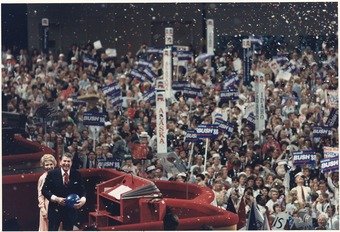
Republican National Convention
Platforms created during presidential nominating conventions unite diverse factions within a party by adopting middle-of-the-road positions on issues and addressing special interest groups in some sections.
Platforms are created during presidential nominating conventions where delegates have an opportunity to vote on salient issues. These votes present a majority view on how issues should be handled and how they can be used by the presidential candidate to unite divergent viewpoints under one popular view.
7.9.7: Coordinating and Promoting Party Policy
Democratic and Republican National Committees help coordinate and promote party policies but do not organize the creation of policies.
Learning Objective
Summarize the role the two national committees play in the formation and promotion of policy
Key Points
- The DNC and RNC do not play a key role in creating party policies but are useful in promoting these policies.
- The mass media is an important tool in promoting party goals and policies.
- The planks of party platforms can lead to highly politicized debates between parties that may evolve into policy stances.
Key Terms
- plank
-
A political issue that is of concern to a faction or a party of the people and the political position that is taken on that issue.
- platform
-
A political stance on a broad set of issues, which are called planks.
- media
-
Means and institutions for publishing and broadcasting information.
Coordinating and Promoting Party Policy
The Democratic National Committee (DNC) and Republican National Committee (RNC) help to coordinate and promote party policies, although they are not the central organizations that develop these policies. These organizations are responsible for developing and promoting party platforms, which express the types of views each party embraces. While the planks of platforms do not all necessarily become policies, they can lead to highly politicized debates between parties that become party policy stances. The DNC and RNC promote party policy in a variety of ways through the mass media.
The DNC and RNC coordinate party policy during the Democratic and Republican National Conventions where party platforms are adopted. These conventions allow delegates to vote on issues that can later be incorporated into a presidential candidate’s campaign. While relatively little of the party platform is adopted as public policy, the platforms often become politicized because they are more ideological than pragmatic. For example, the debate over abortion between the Democratic and Republican parties has resulted in policy stances that either support or ban the practice of abortion.
Meanwhile, party policy is promoted through a variety of interactions between parties and the mass media . The mass media is utilized to reach out to a nationwide audience. Traditional mass media techniques of issuing press releases and staging televised debates are used to generate attention toward a party’s policies. Parties also take advantage of more modern social media sites like Facebook, Twitter, and YouTube. The Democratic and Republican Parties, additionally, maintain sophisticated websites where they can offer comprehensive overviews of various party policies. Television and radio advertisements serve as yet another influential way in which parties can promote their policies.

Media
The DNC and RNC utilize various forms of mass media to promote their party’s policies.
7.10: Party Organization
7.10.1: Party Organization
Political parties are political organizations that typically seek to influence government policy by nominating candidates for office.
Learning Objective
Describe the organization of the Democratic and Republican parties in U.S. politics
Key Points
- Parties participate in electoral campaigns and educational outreach or protest actions. Parties often espouse an expressed ideology or vision bolstered by a written platform with specific goals, forming a coalition among disparate interests.
- The need to win popular support in a republic led to the American invention of political parties in the 1790s. Americans were especially innovative in devising new campaign techniques that linked public opinion with public policy through the party.
- The modern political party system in the United States is a two-party system dominated by the Democratic Party and the Republican Party. These two parties have won every United States presidential election since 1852 and have controlled the United States Congress since at least 1856.
Key Terms
- two-party system
-
A two-party system is a system where two major political parties dominate voting in nearly all elections at every level of government and, as a result, nearly all elected officials are members of one of the two major parties.
- political party
-
A political organization that subscribes to a certain ideology and seeks to attain political power through representation in government.
Example
- The president of the United States, Barack Obama, is the 15th Democrat to hold the office, and since the 2006 midterm elections, the Democratic Party is the majority party for the United States Senate.
Introduction
A political party is a political organization that typically seeks to influence government policy, usually by nominating candidates with aligned political views and trying to seat them in political office. Parties participate in electoral campaigns and educational outreach or protest actions. Parties often espouse an expressed ideology or vision bolstered by a written platform with specific goals, forming a coalition among disparate interests. Throughout most of its history, American politics have been dominated by a two-party system. However, the United States Constitution has always been silent on the issue of political parties; at the time it was signed in 1787, there were no parties in the nation. Indeed, no nation in the world had voter-based political parties. The need to win popular support in a republic led to the American invention of political parties in the 1790s. Americans were especially innovative in devising new campaign techniques that linked public opinion with public policy through the party.
Political scientists and historians have divided the development of America’s two-party system into five eras. The modern two-party system consists of the Democratic Party and the Republican Party. In general, since the 1930s the Democratic Party positions itself left of center in American politics, while the Republican Party positions itself as right of center. Several third parties also operate in the United States and from time to time, elect someone to local office.
Modern U.S. Political Party System
The modern political party system in the United States is a two-party system dominated by the Democratic Party and the Republican Party. These two parties have won every United States presidential election since 1852 and have controlled the United States Congress since at least 1856.
The Democratic Party is one of two major political parties in the United States. It is the oldest political party in the world . The Democratic Party, since the division of the Republican Party in the election of 1912, has positioned itself as progressive and supporting labor in economic as well as social matters. The economic philosophy of Franklin D. Roosevelt, which has strongly influenced American liberalism, has shaped much of the party’s agenda since 1932. Roosevelt’s New Deal coalition had controlled the White House until 1968. In 2004, it was the largest political party, with 72 million voters (42.6% of 169 million registered) claiming affiliation. The president of the United States, Barack Obama, is the fifteenth Democrat to hold the office, and since the 2006 midterm elections, the Democratic Party is the majority party for the United States Senate.
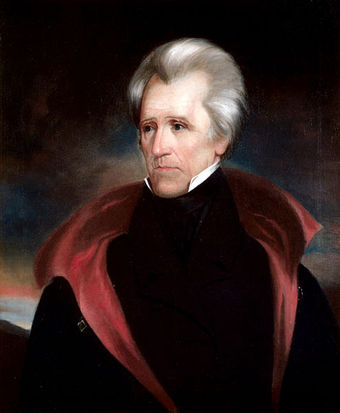
Andrew Jackson
Democrats hail Andrew Jackson as the founder of the party.
7.10.2: National Convention
A United States presidential nominating convention is a political convention held every four years in the United States.
Learning Objective
Explain the proceedings of the national convention
Key Points
- The formal purpose of such a convention is to select the party’s nominee for President, as well as to adopt a statement of party principles and goals known as the platform and adopt the rules for the party’s activities, including the presidential nominating process for the next election cycle.
- Generally, usage of “presidential nominating convention” refers to the two major parties’ quadrennial events: the Democratic National Convention and the Republican National Convention.
- From the point of view of the parties, the convention cycle begins with the Call to Convention. Usually issued about 18 months in advance, the Call is an invitation from the national party to the state and territory parties to convene and select a presidential nominee.
- Each party sets its own rules for the participation and format of the convention. Broadly speaking, each U.S. state and territory party is apportioned a select number of voting representatives, individually known as delegates and collectively as the delegation.
- The convention is typically held in a major city selected by the national party organization 18–24 months before the election is to be held. As the two major conventions have grown into large, publicized affairs with significant economic impact, cities today compete vigorously.
Key Terms
- party platform
-
A statement of principles and purpose issued by a political party.
- planks
-
Planks refer to the goals and proposals in the platform of a political party.
- presidential nominating convention
-
Convention in which presidential and vice presidential candidates are determined, party platforms are established, and rules governing the election cycle are adopted. The most influential presidential nominating conventions include the Democratic and Republican National Conventions.
Example
- The selection of individual delegates and their alternates is also governed by the bylaws of each state party, or in some cases by state law. The 2004 Democratic National Convention counted 4,353 delegates and 611 alternates. The 2004 Republican National Convention had 2,509 delegates and 2,344 alternates.
Introduction
A United States presidential nominating convention is a political convention held every four years in the United States by most of the political parties who will be fielding nominees in the upcoming U.S. presidential election. The formal purpose of such a convention is to select the party’s nominee for President, as well as to adopt a statement of party principles and goals known as the platform and adopt the rules for the party’s activities, including the presidential nominating process for the next election cycle . Due to changes in election laws, the primary and caucus calendar, and the manner in which political campaigns are run, conventions since the latter half of the 20th century have virtually abdicated their original roles, and are today mostly ceremonial affairs.
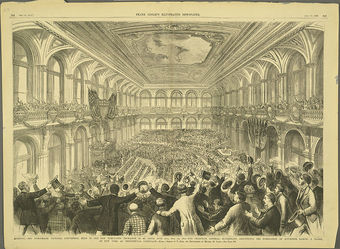
1876 Democratic National Convention
The 1876 Democratic National Convention at the Merchants Exchange Building in St. Louis, Missouri.
Generally, usage of “presidential nominating convention” refers to the two major parties’ quadrennial events: the Democratic National Convention and the Republican National Convention . Some minor parties also select their nominees by convention, including the Green Party, Socialist Party USA, Libertarian Party, Constitution Party, and Reform Party USA.
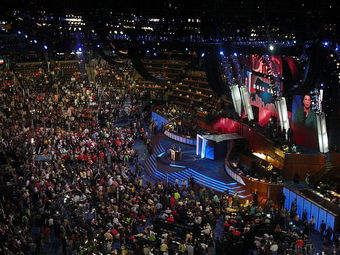
Roll Call DNC 2008
Roll call of states during the 2008 Democratic National Convention.
Logistics
From the point of view of the parties, the convention cycle begins with the Call to Convention. Usually issued about 18 months in advance, the Call is an invitation from the national party to the state and territory parties to convene to select a presidential nominee. It also sets out the number of delegates to be awarded to each, as well as the rules for the nomination process.
Each party sets its own rules for the participation and format of the convention. Broadly speaking, each U.S. state and territory party is apportioned a select number of voting representatives, individually known as delegates and collectively as the delegation. Each party uses its own formula for determining the size of each delegation, factoring in such considerations as population, proportion of that state’s Congressional representatives or state government officials who are members of the party, and the state’s voting patterns in previous presidential elections. The selection of individual delegates and their alternates is also governed by the bylaws of each state party, or in some cases by state law. The 2004Democratic National Convention counted 4,353 delegates and 611 alternates. The 2004 Republican National Convention had 2,509 delegates and 2,344 alternates.
The convention is typically held in a major city selected by the national party organization 18–24 months before the election is to be held. As the two major conventions have grown into large, publicized affairs with significant economic impact, cities today compete vigorously to be awarded host responsibilities, citing their meeting venues, lodging facilities, and entertainment as well as offering economic incentives. Historically, Midwestern cities such as Chicago, Illinois—which since 1860 has held 25 Republican and Democratic Conventions combined, more than any other urban center in the USA—have become the favored hosts.
Proceedings
Each convention produces a statement of principles known as its platform, containing goals and proposals known as planks. Relatively little of a party platform is even proposed as public policy. Much of the language is generic, while other sections are narrowly written to appeal to factions or interest groups within the party . Since the 1970s, voting has for the most part been perfunctory; the selection of the major parties’ nominees have rarely been in doubt, so a single ballot has always been sufficient. Each delegation announces its vote tallies, usually accompanied with some boosterism of their state or territory. The delegation may pass, nominally to retally their delegates’ preferences, but often to allow a different delegation to give the leading candidate the honor of casting the majority-making vote.
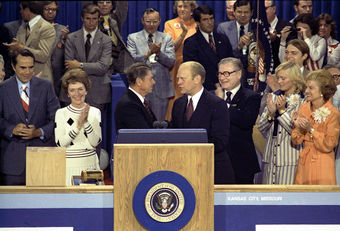
1976 Republican National Convention
President Gerald Ford, as the Republican nominee, shakes hands with nomination foe Ronald Reagan on the closing night of the 1976 Republican National Convention. Vice-Presidential Candidate Bob Dole is on the far left, then Nancy Reagan, Governor Ronald Reagan is at the center shaking hands with President Gerald Ford, Vice-President Nelson Rockefeller is just to the right of Ford, followed by Susan Ford and First Lady Betty Ford.
The evening’s speeches are reserved for major speeches by notable, respected public figures. The speakers at the 2004 Democratic convention included Ted Kennedy, a forty-year veteran of the United States Senate, and Jimmy Carter, a former Democratic President, while at the Republican convention speakers included Governor Arnold Schwarzenegger of California and Governor George Pataki of New York, two of the largest states in the nation.
The final day of the convention usually features the formal acceptance speeches from the nominees for president and vice president. Despite recent controversy maintaining that recent conventions were scripted from beginning to end, and that very little news comes out of the convention, the acceptance speech has always been televised by the networks, because it receives the highest ratings of the convention. In addition, the halls of the convention are packed at this time, with many party loyalists sneaking in. Afterwards, balloons are usually dropped and the delegates celebrate the nomination.
7.10.3: The National Party Organization
American political parties have no formal organization at the national level and mainly raise funds through national committees.
Learning Objective
Explain the history of political party organization and the significance of party committees for each of the major political parties
Key Points
- The modern political party system in the United States is a two-party system dominated by the Democratic Party and the Republican Party.
- Among the two major parties, the Democratic Party generally positions itself as left-of-center, while the Republican Party generally positions itself as right-of-center.
- The two major parties, in particular, have no formal organization at the national level controlling membership, activities, or policy positions.
- Party identification becomes somewhat formalized when a person runs for partisan office. In most states, this means declaring oneself a candidate for the nomination of a particular party and intent to enter that party’s primary election.
- At the federal level, each of the two major parties has a national committee that acts as the hub for fundraising and campaign activities. The most significant of these are the Hill committees, which work to elect candidates to each house of Congress.
Key Terms
- hill committees
-
The Hill committees are the common name for political party committees that work to elect members of their own party to United States Congress (“Hill” refers to Capitol Hill, where the seat of Congress, the Capitol, is located).
- two-party system
-
A two-party system is a system where two major political parties dominate voting in nearly all elections at every level of government and, as a result, nearly all elected officials are members of one of the two major parties.
Introduction
The modern political party system in the United States is a two-party system dominated by the Democratic Party and the Republican Party. These two parties have won every United States presidential election since 1852 and have controlled the United States Congress since at least 1856. Third parties have achieved relatively minor representation at national and state levels. Among the two major parties, the Democratic Party generally positions itself as left-of-center in American politics and supports a modern liberal platform, while the Republican Party generally positions itself as right-of-center and supports a conservative platform.
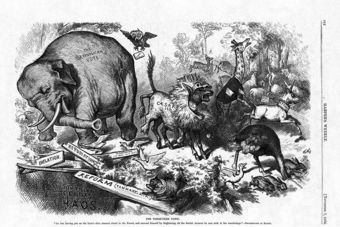
National Republican Elephant
“The Third-Term Panic” by Thomas Nast, originally published in Harper’s Magazine 7 November 1874.

Democratic Party Logo
Logo of the Democratic Party of the United States. Light blue D inside a darker blue circle.
Many minor or third political parties appear from time to time. They serve as means to advocate policies that the two major political parties eventually adopt. At various times, the Socialist Party, the Farmer-Labor Party and the Populist Party had considerable local strength, and then faded away. Some exceptions exist, like Minnesota’s Farmer–Labor Party merging into the state’s Democratic Party. At present, the Libertarian Party is the most successful third party. New York State has a number of additional third parties that sometimes run their own candidates for office or nominate the nominees of the two main parties. In the District of Columbia, the D.C. Statehood Party has served as a strong third party behind the Democratic Party and Republican Party.
Organization of American political parties
American political parties are more loosely organized than those in other countries. The two major parties, in particular, have no formal organization at the national level that controls membership, activities, or policy positions. Thus, for an American to say that he or she is a member of the Democratic or Republican party is quite different from a Briton stating that he or she is a member of the Conservative or Labour party.
In the United States, one can often become a “member” of a party merely by stating that fact. Such participation does not restrict one’s choices in any way. It also does not give a person any particular rights or obligations within the party, other than possibly allowing that person to vote in that party’s primary elections. A person may choose to attend meetings of one local party committee one day and another party committee the next day. The sole factor that brings one “closer to the action” is the quantity and quality of participation in party activities.
Party Identification
Party identification becomes somewhat formalized when a person runs for partisan office. In most states, this means declaring oneself a candidate for the nomination of a particular party and intent to enter that party’s primary election. A party committee may choose to endorse one or another of those seeking the nomination, but in the end the choice is up to those who choose to vote in the primary.
The result is that American political parties have weak central organizations and little central ideology. A party cannot prevent a person who disagrees with the majority of positions of the party or actively works against the party’s aims from claiming party membership , so long as the voters who choose to vote in the primary elections elect that person. Once in office, an elected official may change parties simply by declaring such intent.
Both parties have stopped being engines for voter mobilization, however. Fewer and fewer Americans identify with one another party, preferring instead to be known as “independent” voters. For example, a 2011 USA Today review of state voter rolls indicates that registered Democrats declined in 25 of 28 states. Democrats were still the largest political party with more than 42 million voters (compared with 30 million Republicans and 24 million independents). But in 2011 Democrats numbers shrank 800,000, and from 2008 they were down by 1.7 million, or 3.9%
Party Committees
At the federal level, each of the two major parties has a national committee that acts as the hub for fundraising and campaign activities. The exact composition of these committees is different for each party, but they are made up primarily of representatives from state parties and affiliated organizations. However, the national committees do not have the power to direct the activities of members of the party .

Political parties
The symbol of the Republican Party in the U.S.
Both parties also have separate campaign committees which work to elect candidates at a specific level. The most significant of these are the Hill committees; the common name for the political party committees that work to elect members of their own party to United States Congress (“Hill” refers to Capitol Hill, where the seat of Congress, the Capitol, is located, ). The four major committees are part of the Democratic and Republican parties and each work to help members of their party get elected to each house.
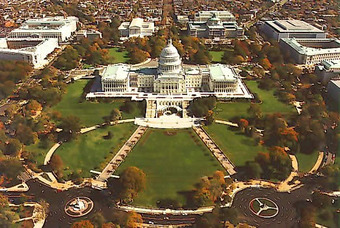
Aerial View of Capitol Hill
Aerial view of Capitol Hill showing the Capitol, Supreme Court Building, Library of Congress, and congressional office buildings.
7.10.4: State and Local Party Organization
The organization of parties is generally at three different levels: national, state, and local.
Learning Objective
Review the organization of parties at the national, state and local level
Key Points
- State parties consist of state central committees, state conventions and congressional district committees.
- National Committees are the national policy creators of each party. Chairpersons are usually selected by the president of the party in power and the party national committee chooses the chairperson for the other party.
- At the local level, there is a president and a president pro tempore in city councils. Usually the majority party (i.e. Democrat or Republican) has the president in their party. The city is split into districts in which the councilman or councilwoman represents.
- Linkage institutions provide a way for people to get involved in government and the political process.
- Political parties provide many ways for individuals to become involved in the political process, from working to get votes or to actually running for office. They are not the only linkage institutions; others include blogs, non-partisan local governments, and school boards.
Key Terms
- city council
-
A governing body of people elected to oversee management of a city and represent the interests of residents.
- chairpersons
-
National Committees are the national policy creators of each party. Chairpersons are usually selected by the president of the party in power and the party national committee chooses the chairperson for the other party.
- linkage institutions
-
Linkage institutions provide a way for people to get involved in government and the political process.
Example
- Currently, the majority of the overall number of seats held in the state legislatures has been switching between the two parties every few years. As of the U.S. gubernatorial elections of 2010, the Republican party holds an outright majority of approximately 440 with 3,890 seats (53% of total) compared to the Democrat party’s number of 3,450 (47% of total) seats elected on a partisan ballot.
Introduction
The organization of parties is generally at three different levels: national, state, and local. National consists of the quadrennial national convention, the party’s national chairpersons, and the party’s national committee. Next is the state, which consists of state central committees and state conventions, and congressional district committees. Lastly, there is the local level of organizations, which include city and county committees, precinct and ward committees, party activists and volunteers, and party identifiers and voters. Recent trends between the three levels are that they tend to overlap, and more often then not, state and local parties have more influence than the national party around their region, and their decisions tend to override those of the national party .
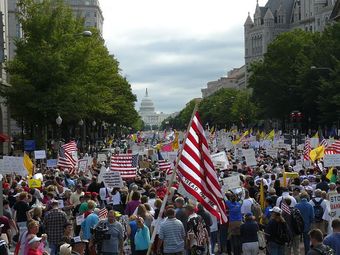
Tea Party National Rally
Tea Party protesters walk towards the United States Capitol during the Taxpayer March on Washington, September 12, 2009.
The basic structure of a political party would be National Committees, Leadership, National Conventions, States and Localities, and informal groups. National Committees are the national policy creators of each party. Chairpersons are usually selected by the president of the party in power and the party national committee chooses the chairperson for the other party. National conventions are held every four years for nominating presidential candidates. Parties are structured at State and Local levels. Informal groups would be groups like interest groups or the National Federation of Democratic Women.
Both parties also have separate campaign committees which work to elect candidates at a specific level. The most significant of these are the Hill committees, which work to elect candidates to each house of Congress. State parties exist in all fifty states, though their structures differ according to state law, as well as party rules at both the national and the state level.
Political Party Strength in State Governments
Currently, the majority of the overall number of seats held in the state legislatures has been switching between the two parties every few years. As of the U.S. gubernatorial elections of 2010, the Republican party holds an outright majority of approximately 440 with 3,890 seats (53% of total) compared to the Democrat party’s number of 3,450 (47% of total) seats elected on a partisan ballot. Of the 7,382 seats in all of the state legislatures combined, independents and third parties account for only 15 members, not counting the 49 members of the Nebraska Legislature, which is the only legislature in the nation to hold non-partisan elections to determine its members. Due to the results of the 2010 elections, Republicans took control of an additional 19 state legislative chambers, giving them majority control of both chambers in 25 states versus the Democrats’ majority control of both chambers in only 16 states, with 8 states having split or inconclusive control of both chambers (not including Nebraska); previous to the 2010 elections, it was Democrats who controlled both chambers in 27 states versus the Republican party having total control in only 14 states, with eight states divided and Nebraska being nonpartisan.
Local Government in the United States
Local government in the United States is structured in accordance with the laws of the various individual states, territories, and the District of Columbia. Typically each state has at least two separate tiers of local government: counties and municipalities. Some states further have their counties divided into townships. There are several different types of local government at the municipal level, generally reflecting the needs of different levels of population densities; typical examples include the city, town, borough, and village.
Parties in City Councils
Most cities have City Councils. These are sometimes elected officials who meet for a portion of the year on designated days and hours. There is a president and a president pro tempore in city councils. Usually the majority party (i.e. Democrat or Republican) has the president in their party. The city is split into districts in which the councilman or councilwoman represents.
Linkage Institutions
Linkage institutions provide a way for people to get involved in government and the political process. Political parties provide many ways for individuals to become involved in the political process, from working to get votes or to actually running for office. They are not the only linkage institutions; others include blogs, non-partisan local governments, and school boards.
7.10.5: Congressional Campaign Committees
Congressional Campaign Committees exist for both Democrats and Republicans, and work to elect candidates from each party to the House of Representatives.
Learning Objective
Identify the roles and responsibilities of the Congressional Campaign Committees for both major parties
Key Points
- They play a critical role in recruiting candidates, raising funds, and organizing races in districts that are expected to yield politically notable or close elections.
- Of the four congressional campaign committees, the DCCC, with a staff of 25, has the largest in-house research department.
- The position of DCCC committee chair was assumed by Rahm Emanuel after the death of the previous chair, Bob Matsui at the end of the 2004 election cycle. Emanuel led the Democratic Party’s effort to capture the majority in the House of Representatives in the 2006 elections.
- The National Republican Congressional Committee (NRCC) is the Republican Hill committee which works to elect Republicans to the United States House of Representatives.
- It supports the election of Republicans to the House through direct financial contributions to candidates and Republican Party organizations; technical and research assistance to Republican candidates and Party organizations; voter registration, education and turnout programs.
Key Terms
- congressional caucus
-
a group of members of the United States Congress that meets to pursue common legislative objectives
- national republican congressional committee
-
The National Republican Congressional Committee (NRCC) is the Republican Hill committee which works to elect Republicans to the United States House of Representatives.
- democratic congressional campaign committee
-
The Democratic Congressional Campaign Committee is the Democratic Hill committee for the United States House of Representatives, working to elect Democrats to that body.
Democratic Party
The Democratic Congressional Campaign Committee is the Democratic Hill committee for the United States House of Representatives, working to elect Democrats to that body. They play a critical role in recruiting candidates, raising funds, and organizing races in districts that are expected to yield politically notable or close elections. The structure of the committee consists, essentially, of the Chairperson, their staff, and other Democratic members of Congress that serve in roles supporting the functions of the committee. The Chairperson of the DCCC is the fourth ranking position among House Democrats, after the Minority Leader, the Minority Whip and the Democratic Caucus Chairperson.
Of the four congressional campaign committees, the DCCC, with a staff of 25, has the largest in-house research department. In a February 2012 profile of the department, Roll Call wrote that “The DCCC’s team of mostly 20-somethings researches opposition targets for eight weeks at a time, scouring news clips and YouTube videos and traveling across the country to comb through public records, all in hopes of finding a good hit. Discoveries go into hundred-page research books on their targets that are used as bait to recruit candidates, leaked to reporters or cited in campaign advertisements and mail pieces.”
The position of DCCC committee chair was assumed by Rahm Emanuel after the death of the previous chair, Bob Matsui at the end of the 2004 election cycle. Emanuel led the Democratic Party’s effort to capture the majority in the House of Representatives in the 2006 elections. After Emanuel’s election as chairman of the Democratic Caucus, Chris Van Hollen became committee chair for the 110th Congress, and thus for the 2008 elections. He continued through the 2010 elections. For the 2012 election cycle, Democratic Minority Leader Nancy Pelosi appointed congressman Steve Israel to serve as the committee’s chair.
Republican Party
The National Republican Congressional Committee (NRCC) is the Republican Hill committee which works to elect Republicans to the United States House of Representatives. The NRCC was formed in 1866, when the Republican caucuses of the House and Senate formed a “Congressional Committee”. It supports the election of Republicans to the House through direct financial contributions to candidates and Republican Party organizations; technical and research assistance to Republican candidates and Party organizations; voter registration, education and turnout programs; and other Party-building activities. It is a registered 527 group, and its current slogan is “Building a Lasting Majority.”
The NRCC is governed by its chairman, U.S. Rep. Pete Sessions (TX-32) , and an executive committee composed of Republican members of the U.S. House of Representatives. The Chairman is elected by the House Republican Conference after each Congressional election. Republican Leader John Boehner and the seven other elected leaders of the Republican Conference of the House of Representatives serve as ex-officio members of the NRCC’s executive committee.
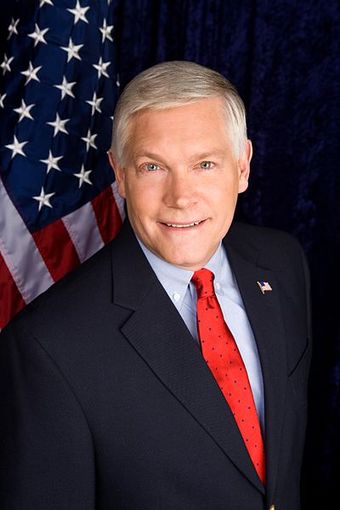
Pete Sessions
Congressman Pete Sessions, chairman of the NRCC.
7.10.6: The Party in Government
A majority government is a government formed by a governing party that has an absolute majority of seats in the legislature or parliament.
Learning Objective
Discuss how a divided government affects legislation and national policy
Key Points
- In the United States, divided government describes a situation in which one party controls the White House and another party controls one or both houses of the United States Congress.
- Divided government is suggested by some to be an undesirable product of the separation of powers in the United States’ political system.
- In the United States, the constitution is designed to create conflict between the executive and legislative branches of government.
- Despite the perceived problems of divided government, the President and Congress are often able, out of necessity, to establish an effective working relationship.
Key Terms
- majority party
-
the party in a two-party political system that typically holds more than 50% of the seats in the legislature
- divided government
-
A situation in which one political party controls the White House while another party controls the majority of the Congress
- majority government
-
A majority government is a government formed by a governing party that has an absolute majority of seats in the legislature or parliament in a parliamentary system. This is as opposed to a minority government, where even the largest party wins only a plurality of seats and thus must constantly bargain for support from other parties in order to pass legislation and avoid being defeated on motions of no confidence.
Example
- Despite the perceived problems of divided government, the President and Congress are often able, out of necessity, to establish an effective working relationship.
Introduction
A majority government is a government formed by a governing party that has an absolute majority of seats in the legislature or parliament in a parliamentary system. This is as opposed to a minority government, where even the largest party wins only a plurality of seats and thus must constantly bargain for support from other parties in order to pass legislation and avoid being defeated on motions of no confidence. The term “majority government” may also be used for a stable coalition of two or more parties to form an absolute majority. One example of such an electoral coalition is in Australia, where the Liberal and National parties have run as an electoral bloc for decades.
Another example is the current coalition government in the United Kingdom, which is composed of the Conservative and Liberal Democratic parties. The conservatives won the most seats of any single party in the 2010 election, but fell short of an absolute majority. However, by combining with the Liberal Democrats a solid majority in the House of Commons was created. This is the first true coalition government in the UK since World War II.
Divided Government
In the United States, divided government describes a situation in which one party controls the White House and another party controls one or both houses of the United States Congress . Divided government is suggested by some to be an undesirable product of the separation of powers in the United States’ political system. Earlier in the 20th century, divided government was rare, but since the 1970s it has become increasingly common. Mainly in part due to the Watergate scandal which has popularized the idea that a divided government is a beneficial for the country.
Some conservative and libertarian groups see divided government as beneficial, since it may encourage more policing of those in power by the opposition, as well as limiting spending and the expansion of undesirable laws. In Parliamentary systems such as the United Kingdom, the executive relies on Parliamentary support for its existence. In the United States, however, the constitution is designed to create conflict between the executive and legislative branches of government. Despite the perceived problems of divided government, the President and Congress are often able, out of necessity, to establish an effective working relationship.
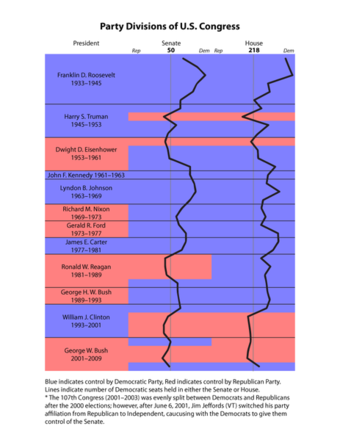
Divided Government in the United States
Graphical depiction of the party division of U.S. Congress, 1933-2009.
7.11: Minor Political Parties
7.11.1: The Role of Third Parties
American politics operate as a two-party system, and third party candidates do not play a major role in elections.
Learning Objective
Describe how and why third parties form, their key successes, and hurdles to still further success
Key Points
- In the U.S., “third party” refers to any party other than the major two, which are the Democratic and Republican parties at present.
- Third parties have sometimes launched large campaigns and have won public offices, but have not obtained significant or consistent representation in the federal government.
- Barriers to third party success include a winner-take-all election format, ballot access laws, debate rules, and the vast resources of the two major parties.
Key Terms
- two-party system
-
A two-party system is a system where two major political parties dominate voting in nearly all elections at every level of government and, as a result, nearly all elected officials are members of one of the two major parties.
- ballot access laws
-
Statutes governing whether a candidate will be listed on a state election ballot, which may require fees or signed petitions.
- third party
-
A political party in opposition to the main parties in a two-party system.
Example
- Ross Perot’s 1992 candidacy for president as a member of the Independent Party is the last time a third party candidate gained significant traction. Due in part to an agreement by the two major party candidates to allow him to appear in televised debates, Perot received 19% of the popular vote that year.
American politics operate on a two-party system, meaning that two major political parties dominate voting in most elections and consequently dominate elected offices. In modern United States elections, the two major parties are the Democratic and Republican parties. These parties are associated with liberal and conservative views respectively, and nearly all elected officials are affiliated with one of the two. Campaign endorsements, funding, and resources are allocated to candidates on the basis of nomination by one of these two parties.
Although the American political structure has consistently been a two-party system, third parties occasionally influence elections, and third party candidates sometimes obtain elected positions. “Third party” technically refers to the third largest party in a two-party system, but in the U.S. it generally refers to any party running in an election other than the major two. Many third parties have gained some traction throughout American history — at one point, the Socialist Party held 600 mayoral offices, and Theodore Roosevelt obtained a signifiant number of votes in his presidential bid as the Progressive Party candidate in 1912. Today, the largest three “third parties” as measured by the number of registered voters affiliated with them are the Libertarian Party, the Green Party, and the Constitution Party. None of them hold a substantial number of public offices.
There are numerous logistical reasons third parties have not been more successful in the U.S. (as they have been in other democratic countries), including the country’s election structure, ballot rules, and debate rules. American elections are structured as “winner-take-all” votes — in other words, regardless of the margin of victory, the candidate that wins the popular vote attains office while the runner-up does not gain representation. This system is in contrast to proportional representation systems, in which parties are allocated representation based on the proportion of the popular vote they receive. With regards to ballot access, candidates for major elections, such as presidential elections, must meet state-determined criteria to be included on election ballots. Ballot access laws often mandate that candidates pay large fees or collect a large number of signatures to be listed, which often restricts the ability of third party candidates to be put on the ballot. Lastly, since the onset of televised presidential debates in the 1960s, with only a couple of exceptions, third party candidates have been barred from participation. This policy limits their ability to publicize their views and gain a following among the electorate.
While many electoral policies in the U.S. stack the odds against third party success, perhaps the greatest barrier to third party candidates is the vast amount of resources that major parties hold. The two major parties have shifted names, platforms, and constituencies over time, but they have always served as gatekeepers to financial and human resources. Moreover, throughout the past few decades, major party politicians have been able to neutralize third party threats by adopting or discrediting the views of third party candidates. Both major parties are at risk of losing voters if third party campaigns gain traction, so they have both tended to act in ways that promote the two party system.
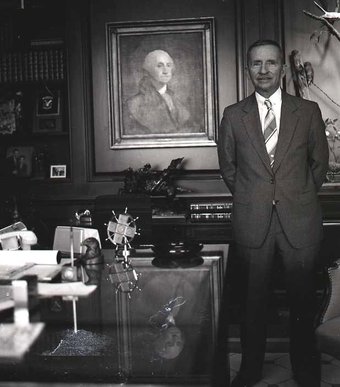
Ross Perot
Ross Perot is the last third party presidential candidate to gain a substantial number of votes in the general election.
7.11.2: Ideological Third Parties and Splinter Parties
Third party politicians tend to be more ideological than Republicans or Democrats because they do not have to play to the American middle.
Learning Objective
Describe the largest and most significant third parties in American electoral politics
Key Points
- American elections are held between two main political candidates, one a Democrat and one a Republican.
- Third parties are any party other than the Democratic and Republican parties.
- Third parties tend to be much more ideological than their counterparts from the Democratic or Republican parties.
Key Terms
- third party
-
A political party in opposition to the main parties in a two-party system.
- two-party system
-
When two major political parties dominate in most elections and consequently dominate elected office
America’s democratic system is predominantly a two party system. This means that two major political parties dominate in most elections and consequently dominate elected office. Currently, the two major American parties are the Democratic and Republican parties, although the top two parties change over time. A third party is any party that supports a candidate for election other than the two major political parties; at the current moment, a third party would be any party other than the Democratic and Republican parties. Though third parties represent a very small fraction of Americans participating in politics, they do influence elections by drawing votes away from either of the two main parties. Third parties tend to be more ideological and extremist than the Democrats or Republicans. Since third party candidates do not have a legitimate chance of winning national election given the structure of the current system, most third parties do not tend to try to pursue moderate voters and instead stay close to their ideological roots.
The three main third parties are the Libertarian Party, the Green Party, and the Constitution Party . All have over 100,000 registered voters. However, even as these parties are the largest of the third parties, they represent only a fraction of American voters and are more ideologically oriented than Democrats or Republicans. The Libertarian Party supports laissez-faire policies, small government, and is characterized by being socially liberal and fiscally conservative. The Green Party is a progressive party that emphasizes eco-socialism. The Constitution Party is a socially and fiscally conservative party backed by the religious right.
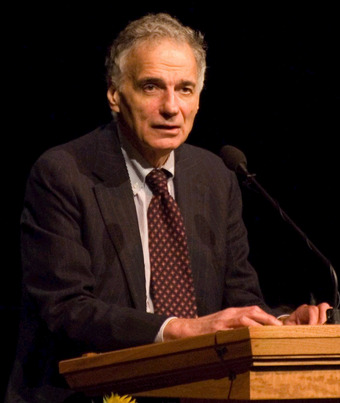
Third Party Candidates
Ralph Nader, the Green Party candidate, is accused of “stealing” votes away from Al Gore, a Democrat, in the 2000 election.
Beyond the Libertarian, Green, and Constitution Parties, third parties in American politics tend even farther towards the fringe, emphasizing ideology and avoiding speaking to a broad base. An example of a small right-wing third party would be the America First Party. The AFP is characterized as paleoconservative because they are socially and fiscally conservative. The AFP seeks to enact a smaller government by eliminating federal programs, such as the Department of Education. The AFP further seeks to cut taxes and allow for more robust integration of church and state.
An example of an extreme left wing party is the Peace and Freedom Party. The PFP was created in 1968 as a way to protest participation in the Vietnam War. Today, the PFP advocates to protect the environment. It seeks to advance personal liberties and universal, high quality and free access to education and health care. The PFP seeks to enact a more socialist economy.
Some third parties are organized entirely around one issue, rather than seeking to enact a broad, fringe ideology. For example, the United States Marijuana Party seeks to end the war on drugs and legalize marijuana. Though it is unlikely that anyone from the United States Marijuana Party will ever be elected to national office, they seek to raise attention to the issues that they find important and put these issues on the national stage.
7.11.3: The Impact of Minor Parties
Third-party candidates exert influence by focusing the election on particular issues and taking votes away from major candidates.
Learning Objective
Summarize the place of third parties in American political life
Key Points
- Third-party candidates rarely win election in American campaigns.
- Third-party candidates can shift national attention to particular issues.
- Third-party candidates can take votes away from major political party candidates, influencing the outcome of elections.
Key Term
- third party
-
A political party in opposition to the main parties in a two-party system.
Example
- During the 2000 election, Green Party presidential candidate Ralph Nader took votes away from Democrat Al Gore, a situation that some people felt contributed to the victory of Republican George W. Bush
Third parties face many obstacles in American politics. They are usually not even allowed on ballots for due to lack of popular support and signatures to warrant a place under local laws. The problem feeds upon itself as the marginality of third parties means that they are not well known enough to attract national attention, and therefore unable to raise the funds that could promote their politics and make them well known. Numerically, third parties have won very few elected positions. Since 1877, there have been 31 U.S. senators, 111 U.S. representatives, and 22 governors that were not affiliated with a major political party.
However, third parties do play an important role in national politics. Third parties usually organize and mobilize around a single issue or position, putting pressure on candidates from major political parties to address these issues. For example, segregationist American Independent Party candidate George Wallace gained 13.5% of the popular vote in the 1968 election. In response, the Republican Party adopted a “Southern Strategy” to win the support of conservative Democrats in the South who opposed the new Civil Rights movement.
Although it is unlikely that a third party candidate will ever garner a plurality of the vote, they can influence the election by taking votes away from a major party candidate. This was at issue during the 2000 election when Green Party presidential candidate Ralph Nader took votes away from Democrat Al Gore, a situation that some felt contributed to the victory of Republican George W. Bush .
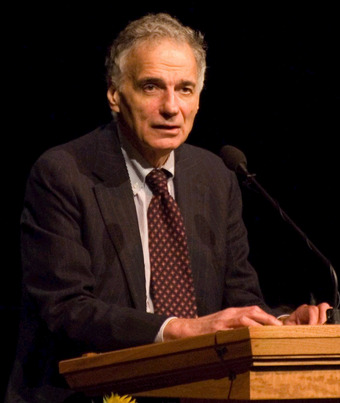
Third Party Candidates
Ralph Nader, the Green Party candidate, is accused of “stealing” votes away from Al Gore, a Democrat, in the 2000 election.
7.12: Modern Political Parties
7.12.1: Red States vs. Blue States
The terms “red state” (Republican-voting) and “blue state” (Democratic-voting) were standardized during the 2000 US presidential election.
Learning Objective
Compare and contrast red states with blue states
Key Points
- Since 2000, red states are states that vote predominately Republican during an election while blue states are states that vote predominately Democratic during an election.
- Prior to the 2000 presidential election, different media outlet employed divergent color schemes to display states’ party preferences.
- The confusion surrounding the outcome of the 2000 presidential election created conformity around the current understanding of red and blue states even though there was no coordinated media effort to standardize the colors and neither party’s national committee has formally endorsed either color.
- The red state-blue state designation has been criticized for not accurately predicting the outcomes of all elections, for ignoring closely divided states, and for not representing the outcomes of state and local elections accurately.
Key Terms
- blue state
-
A state of the United States voting Democratic in a given election, or tending to vote Democratic in general.
- red state
-
A state of the United States voting Republican in a given election, or tending to vote Republican in general.
- electoral college
-
A body of electors empowered to elect someone to a particular office
During the 2000 US presidential election, the term “red states” was coined to mean those states whose residents primarily vote for the Republican Party and “blue states” as those states whose residents primarily vote for the Democratic Party . The terms have been expanded since 2000 to differentiate between conservative-leaning states, depicted in red, and liberal-leaning states, depicted in blue.

Red States and Blue States
News media frequently display maps in blue, red, and purple to indicate primarily Democratic-voting states, Republican-voting states, and middle ground states.
The association of states with colors to indicate their party voting preferences was not a new phenomenon prior to the 2000 presidential election. In fact, the advent of color television encouraged many television news reporters to depict state voting preferences through color-coded electoral maps. The 2000 presidential election, however, was the first time that red became the standardized color for the Republican Party and blue became the standardized color for the Democratic Party. Previously, color schemes differed across networks. For instance, in the 1980 presidential election NBC used blue for predominately Democratic-voting states and red for predominately Republican-voting states while ABC employed the opposite color scheme. Other networks alternated red and blue between the Democratic and Republican Parties every four years.
The 2000 presidential election proved significant in standardizing red and blue states with the Republican and Democratic Parties, respectively, because of the confusion surrounding the results of the election. Major media outlets started conforming to the same color scheme because the electoral map was continually in view and conformity created easy viewer comprehension. The association of blue with Democrats and red with Republicans is now part of the lexicon of American journalism and has informally been used by each party. Interestingly, though, there was no coordinated media effort to designate Democratic states blue and Republican states red on the 2000 election night and neither party’s national committee has officially accepted the red and blue color designations.
Despite the nearly nationwide acceptance of Republican red states and Democratic blue states, the paradigm has come under criticism. Some argue that assigning partisanship to states is only useful in understanding voting preferences in the Electoral College. The Republican and Democratic Parties within a given state may have platforms that depart from national party platforms. Such a situation can lead a state to favor one party in state and local elections and another party in presidential elections. The designation of states as either being red or blue also ignores those states that are closely divided between Democratic and Republican candidates. Another criticism of the red state-blue state paradigm is that it has not been entirely predictive of how states will vote. For example, in the 2008 presidential election Democratic candidate Barack Obama captured the majority vote in many red states that had not voted Democratic in many years, such as North Carolina, Indiana, and Virginia.
7.12.2: Party Realignments, Dealignments, and Tipping
Realignment refers to national elections in which there are sharp changes in issues that produce new structures that lasts for decades.
Learning Objective
Compare and contrast realignment, dealignment and tipping point
Key Points
- Realignment means the coming to power for several decades of a new coalition, replacing an old dominant coalition of the other party.
- Political realignments can be sudden (1–4 years) or can take place more gradually (5–20 years).
- The central holding of realignment theory, first developed in the political scientist V. O. Key, Jr.’s 1955 article, “A Theory of Critical Elections,” is that American elections, parties and policymaking routinely shift in swift, dramatic sweeps.
- Dealignment is a trend or process whereby a large portion of the electorate abandons its previous partisan affiliation, without developing a new one to replace it.
- Many scholars argue that the trends in elections in the United States over the last several decades are best characterized as dealignment.
- A tipping point is a point in time when a group —or a large number of group members— rapidly and dramatically changes its behavior by widely adopting a previously rare practice.
Key Terms
- Tipping point
-
A tipping point is a point in time when a group —or a large number of group members— rapidly and dramatically changes its behavior by widely adopting a previously rare practice.
- Realignment
-
Realignment means the coming to power for several decades of a new coalition, replacing an old dominant coalition of the other party.
- Dealignment
-
Dealignment is a trend or process whereby a large portion of the electorate abandons its previous partisan affiliation, without developing a new one to replace it.
Example
- A great example of realignment came at the end of George W. Bush’s presidency. In the 2008 elections, the Democrats expanded their majorities in the Congress, and won the Presidency decisively. This was due to the momentum carried over from the Democrats’ 2006 successes, as well as the continued unpopularity of President George W. Bush, whose administration was now faced with a financial crisis and economic recession. Some people believe that 2008 is possibly a realigning election with a long-lasting impact, just as the election of Franklin D. Roosevelt was in 1932 and the election of Ronald Reagan in 1980 were. President Obama was reelected in the 2012 election as well, becoming only the third Democrat to win a majority of the popular vote more than once while losing only two states that he had won in 2008.
Introduction
Realigning election are terms from political science and political history describing a dramatic change in the political system. Scholars frequently apply the term to American elections and occasionally to other countries. Usually it means the coming to power for several decades of a new coalition, replacing an old dominant coalition of the other party as in 1896 when the GOP became dominant, or 1932 when the Democrats became dominant. More specifically, it refers to American national elections in which there are sharp changes in issues, party leaders, the regional and demographic bases of power of the two parties, and structure or rules of the political system (such as voter eligibility or financing), resulting in a new political power structure that lasts for decades.
Political realignments can be sudden (1–4 years) or can take place more gradually (5–20 years). Political scientists and historians often disagree about which elections are realignments and what defines a realignment, and even whether realignments occur. The terms themselves are somewhat arbitrary, however, and usage among political scientists and historians does vary.
Realignment
The central holding of realignment theory, first developed in the political scientist V. O. Key, Jr.’s 1955 article, “A Theory of Critical Elections,” is that American elections, parties and policymaking routinely shift in swift, dramatic sweeps. V. O. Key Jr. concluded that systematic patterns are identifiable in American national elections such that cycles occur on a regular schedule: once every 36-years or so. This period of roughly 30 years fits with the notion that these cycles are closely linked to generational change. For social scientists, this point is important, since it helps to provide an objective sociological basis for the theory. Tipping refers to the end of an era and the crystallization of another.
A great example of realignment came at the end of George W. Bush’s presidency. In the 2008 elections, the Democrats expanded their majorities in the Congress, and won the Presidency decisively. This was due to the momentum carried over from the Democrats’ 2006 successes, as well as the continued unpopularity of President George W. Bush, whose administration was now faced with a financial crisis and economic recession. Some people believe that 2008 is possibly a realigning election with a long-lasting impact, just as the election of Franklin D. Roosevelt was in 1932 and the election of Ronald Reagan in 1980 were. President Obama was reelected in the 2012 election as well, becoming only the third Democrat to win a majority of the popular vote more than once while losing only two states that he had won in 2008.
Dealignment
A central component of realignment is the change in behavior of voting groups. Realignment means the switching of voter preference from one party to another, in contrast to dealignment where a voter group abandons a party to become independent or nonvoting. Dealignment, in short, is a trend or process whereby a large portion of the electorate abandons its previous partisan affiliation, without developing a new one to replace it.
Furthermore, dealignment refers to a decline by voters to their political party; that is a decrease in party loyalty and voters be less attached to their party. This dealignment shows that short term factors might play a larger role than usual in whether a candidate receives a vote from someone of his party. Several factors can be attributed to partisan dealignment, such as a greater political awareness and socialisation, intensive mass media coverage and decline of deference; disillusionment both with parties and politicians, and most importantly, the poor performance of government. Many scholars argue that the trends in elections in the United States over the last several decades are best characterized as dealignment.
Tipping
Tipping refers to the end of an era and the crystallization of another. More specifically, tipping point is a point in time when a group —or a large number of group members— rapidly and dramatically changes its behavior by widely adopting a previously rare practice. The phrase was first used in sociology by Morton Grodzins when he adopted the phrase from physics where it referred to the adding a small amount of weight to a balanced object until the additional weight caused the object to suddenly and completely topple, or tip. Grodzins studied integrating American neighborhoods in the early 1960s. He discovered that most of the white families remained in the neighborhood as long as the comparative number of black families remained very small. But, at a certain point, when “one too many” black families arrived, the remaining white families would move out en masse in a process known as white flight. He called that moment the “tipping point”.

Obama Campaign 2008
Some people believe that 2008 is possibly a realigning election with a long-lasting impact, just as the election of Franklin D. Roosevelt was in 1932 and the election of Ronald Reagan in 1980 were. President Obama was reelected in the 2012 election as well, becoming only the third Democrat to win a majority of the popular vote more than once while losing only two states that he had won in 2008.
7.12.3: The Rise of Independents
In politics, an Independent or nonpartisan politician is an individual not affiliated to any political party.
Learning Objective
Describe independent voters in U.S. politics and the history of independents elected to national, regional and local offices
Key Points
- An Independent or nonpartisan politician is an individual not affiliated to any political party. Independents may hold a centrist viewpoint between those of major political parties.
- Historically, George Washington was the only president elected as an Independent, as he was not formally affiliated with any party during his two terms.
- There have been several Independents elected to the United States Senate throughout history. Examples include David Davis of Illinois (a former Republican) in the nineteenth century, and Harry F. Byrd, Jr. of Virginia (who had been elected to his first term as a Democrat) in the 20th century.
- In August 2008, there were 12 people who held offices as Independents in state legislatures. There were four state senators, one from Kentucky, one from Oregon, one from Tennessee, and one from New Mexico.
Key Terms
- Whig Party
-
It is a party that was prevalent in the Jacksonian era of democracy.
- independent
-
A candidate or voter not affiliated with any political party, a free thinker, free of a party platform.
Background
In politics, an independent or nonpartisan politician is an individual not affiliated to any political party. Independents may hold a centrist viewpoint between those of major political parties. Sometimes, they hold a viewpoint more extreme than any major party, or they may have a viewpoint based on issues that they do not feel that any major party addresses. Other Independent politicians may be associated with a political party, were former members of it, or have views that align with it but choose not to stand under its label.
Historically, George Washington was the only president elected as an Independent, as he was not formally affiliated with any party during his two terms. John Tyler was expelled from the Whig Party in September 1841 and remained effectively an Independent for the remainder of his presidency, later returning to the Democrats. He briefly sought re-election in 1844 as a National Democrat, but he withdrew, as he feared to split the Democratic vote. Recent prominent Independent candidates for president of the United States include John Anderson in 1980, Ross Perot in 1992, and Ralph Nader in the 2004 and 2008 elections. In 2008, Independent Presidential candidate, Ralph Nader formed Independent parties in New Mexico, Delaware, and elsewhere to gain ballot access in several states. This strategy has been pursued by several Independent candidates for Federal races, including Joe Lieberman (Connecticut for Lieberman), since in some states it is easier to gain ballot access by creating a new political party than to gather signatures for a nominating petition.
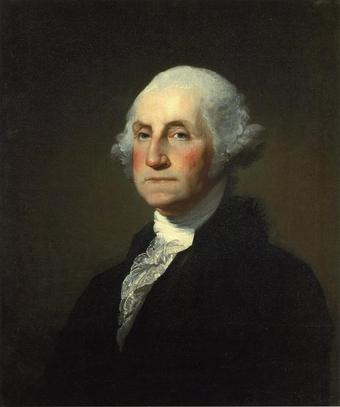
George Washington
First President of the United States
Independents in Congress
There have been several Independents elected to the United States Senate throughout history. Notable examples include David Davis of Illinois (a former Republican) in the nineteenth century, and Harry F. Byrd, Jr. of Virginia (who had been elected to his first term as a Democrat) in the twentieth century. Some officials have been elected as members of a party but became an Independent while in office (without being elected as such), such as Wayne Morse of Oregon or Virgil Goode of Virginia. Nebraska senator George W. Norris was elected for four terms as a Republican before changing to an Independent after the Republicans lost their majority in Congress in 1930. Norris won re-election as an Independent in 1936, but later lost his final re-election attempt to Republican Kenneth S. Wherry in 1942. Vermont senator Jim Jeffords left the Republican Party to become an Independent in 2001.
Independents in State and Local Offices
In August 2008, there were 12 people who held offices as Independents in state legislatures. There were four state senators, one from Kentucky, one from Oregon, one from Tennessee, and one from New Mexico. The representatives came from the states of Louisiana (two), Maine (two), Vermont (two), and Virginia (two). In the 2008 general elections, Wisconsin State Assemblyman Jeffrey Wood left the Republican Party and won reelection as an Independent. After the 2008 primary election, New Mexico State Senator Joseph Carraro left the Republican Party and registered as an Independent. He did not run for reelection.
In November 2005, Manny Diaz was elected Mayor of Miami, Florida as an Independent. On June 19, 2007, New York Mayor Michael Bloomberg switched his party affiliation from Republican to Independent. Oscar Goodman, Mayor of Las Vegas, Nevada switched his affiliation to Independent from Democrat in December 2009.
Chapter 6: Public Opinion
6.1: Public Opinion
6.1.1: Defining Public Opinion
Public opinion or political opinion is the aggregate of individual attitudes or beliefs held by the adult population.
Learning Objective
Explain the relationship between public opinion and democracy
Key Points
- Public opinion as a concept gained credence with the rise of “public” in the eighteenth century.
- Since the 1950s, television has been the main medium for molding public opinion.
- Public opinion is discussed as a form of collective behavior, which is made up of those who are discussing a given public issue at any one time. Given this definition, there are many publics; each of them comes into being when an issue arises and ceases to exist when the issue is resolved.
- Public opinion plays an important role in the political sphere. Cutting across all aspects of relationship between government and public opinion are studies of voting behavior.
Key Terms
- public opinion
-
The opinion of the public, the popular view.
- aggregate
-
A mass, assemblage, or sum of particulars; something consisting of elements but considered as a whole.
- Jeremy Bentham
-
Jeremy Bentham was an English philosopher, jurist and social reformer. He is regarded as the founder of modern utilitarianism.
Public opinion or Political opinion is the aggregate of individual attitudes or beliefs held by the adult population. Public opinion can also be defined as the complex collection of opinions of many different people and the sum of all their views.
Since the 1950s, television has been the main medium for molding public opinion. Public opinion as a concept gained credence with the rise of “public” in the eighteenth century. The English term “public opinion” dates back to the eighteenth century and has derived from the French “l’opinion”, which was first used in 1588 by Montaigne. This concept came about through the process of urbanization and other political and social forces. For the first time, it became important what people thought, as forms of political contention changed.
Adam Smith (1723-1790), one of the earliest classical economists, refers to public opinion in his Theory of Moral Sentiments. But it was Jeremy Bentham (1748-1832), the famous utilitarian Philosopher, who fully developed theories of public opinion. He opined that public opinion had the power to ensure that rulers would rule for the greatest happiness of the greater number. He brought in Utilitarian philosophy in order to define theories of public opinion. The German sociologist Ferdinand Tönnies, by using the conceptional tools of his theory of Gemeinschaft and Gesellschaft, argued (1922, “Kritik der öffentlichen Meinung”), that ‘public opinion’ has the equivalent social function in societies (Gesellschaften) which religion has in communities (Gemeinschaften) – election of opinions of many different people and the sum of all their views.
German social theorist, Jürgen Habermas (born in 1929), contributed the idea of “Public Sphere” to the discussion of public opinion. The Public Sphere, or bourgeois public is, according to Habermas, where “something approaching public opinion can be formed” (2004, p. 351). Habermas claimed that the Public Sphere featured universal access, rational debate, and disregard for rank. However, he believes that these three features for how public opinion are best formed are no longer in place in western liberal democratic countries. Public opinion, in western democracy, is highly susceptible to elite manipulation.
The American sociologist Herbert Blumer (1900 – 1987) has proposed an altogether different conception of the “public. ” According to Blumer, public opinion is discussed as a form of collective behavior (another specialized term) which is made up of those who are discussing a given public issue at any one time. Given this definition, there are many publics; each of them comes into being when an issue arises and ceases to exist when the issue is resolved. Blumer claims that people participate in public in different capacities and to different degrees. So, public opinion polling cannot measure the public. An educated individual’s participation is more important than that of a drunk. The “mass,” in which people independently make decisions about, for example, which brand of toothpaste to buy, is a form of collective behavior different from the public.
Public opinion plays an important role in the political sphere. Cutting across all aspects of relationship between government and public opinion are studies of voting behavior. These have registered the distribution of opinions on a wide variety of issues, have explored the impact of special interest groups on election outcomes and have contributed to our knowledge about the effects of government propaganda and policy. More often than not, leaders use public opinion to weight their options when instituting new policies, since public opinion represents the popular views of citizens on the proper role of government. However, public opinion can be subject to elite manipulation. Thus, public opinion cannot be the sole determinant factors for informing the people on important issues of the day.
The rapid spread of public opinion measurement around the world is a reflection of the number of uses to which it can be put. Public opinion can be accurately obtained through a random sample survey, if done correctly. Governments have increasingly found surveys to be useful tools for guiding their public policies through voter polls as seen in . The US Department of Agriculture was one of the first government agencies to sponsor systematic and large scale surveys. It was followed by many other federal bodies, including the US information agency which has conducted opinion research in all parts of the world. Public opinion can be influenced by public relations and the political media. Additionally, mass media utilizes a wide variety of advertising techniques to get their message out and change the minds of people.The tide of public opinion becomes more and more crucial during political elections, most importantly elections determining the national executive.
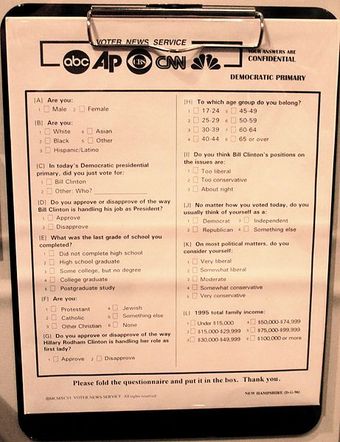
Voter Poll
Voter polling questionnaire on display at the Smithsonian Institution
6.1.2: Political Values
Political cultures have values that are largely shared by their members; these are called political values.
Learning Objective
Explain value theory and its relation to the individual’s political beliefs
Key Points
- The values of a society can often be identified by noting which people receive honor or respect.
- Values generate behavior and help solve common human problems for survival by comparative rankings of value, the results of which provide answers to questions of why people do what they do and in what order they choose to do them.
- Over time the public expression of personal values, that groups of people find important in their day-to-day lives, lay the foundations of law, custom and tradition.
Key Terms
- Cultural Value
-
Cultures have values that are largely shared by their members.
- Personal Value
-
Personal Values provide an internal reference for what is good, beneficial, important, useful, beautiful, desirable, constructive, etc. Values generate behaviour and help solve common human problems for survival by comparative rankings of value, the results of which provide answers to questions of why people do what they do and in what order they choose to do them.
- value system
-
A hierarchy of values that all moral agents possess, demonstrated by their choices. Most people’s value systems differ, making the imposition of a singular value system by the state a source of constant social warfare. This is an individualistic concept. One’s value system is molded by one’s virtues or vices.
Value Theory
Value theory encompasses a range of approaches to understanding how, why and to what degree people value things, whether the thing is a person, idea, object, or anything else. This investigation began in ancient philosophy, where it is called axiology or ethics. Early philosophical investigations sought to understand good and evil and the concept of “the good”. Today much of value theory is scientifically empirical, recording what people do value and attempting to understand why they value these things in the context of psychology, sociology, and economics.
A personal or cultural value is an extremely absolute or relative ethical value, the assumption of which can be the basis for ethical action. A value system is a set of consistent values and measures. A principle value is a foundation upon which other values and measures of integrity are based. Those values which are not physiologically determined and normally considered objective, such as a desire to avoid physical pain, seek pleasure, etc., are considered subjective. This means they vary across individuals and cultures and are in many ways aligned with belief and belief systems. Types of values include ethical/moral values, doctrinal/ideological (religious, political) values, social values, and aesthetic values. It is debated whether some values which are not clearly physiologically determined, such as altruism, are intrinsic, and whether others, such as acquisitiveness, should be valued as vices or virtues. Values can be defined as broad preferences concerning appropriate courses of action or outcomes. As such, values reflect a person’s sense of right and wrong or what “ought” to be. “Equal rights for all”, “Excellence deserves admiration”, and “People should be treated with respect and dignity” are representative of values.
Personal values
Personal Values provide an internal reference for what is good, beneficial, important, useful, beautiful, desirable, constructive, etc. Values generate behavior and help solve common human problems for survival by comparative rankings of value, the results of which provide answers to questions of why people do what they do and in what order they choose to do them. Over time the public expression of personal values, that groups of people find important in their day-to-day lives, lay the foundations of law, custom and tradition. Personal Values in this way exist in relation to cultural values, either in agreement with or divergent from prevailing norms. A culture is a social system that shares a set of common values, in which such values permit social expectations and collective understandings of the good, beautiful, constructive, etc. Without normative personal values, there would be no cultural reference against which to measure the virtue of individual values and so culture identity would disintegrate.
Cultural Values
The Inglehart-Welzel Cultural Map of the World , created by sociopolitical scientists, Ronald Inglehart and Christian Welzel, is based on the World Values Survey. Cultures have values that are largely shared by their members. The values of a society can often be identified by noting which people receive honor or respect. In the US, for example, professional athletes at the top levels in some sports are honored (in the form of monetary payment) more than college professors. Surveys show that voters in the United States would be reluctant to elect an atheist as a president, suggesting that belief in God is a value. Values are related to the norms of a culture, but they are more global and abstract than norms. Norms are rules for behavior in specific situations, while values identify what should be judged as good or evil. Flying the national flag on a holiday is a norm, but it reflects the value of patriotism. Wearing dark clothing and appearing solemn are normative behaviors at a funeral. In certain cultures they reflect the values of respect and support of friends and family. Different cultures reflect different values.

The Inglehart-Welzel Cultural Map of the World
The Inglehart-Welzel Cultural Map of the World, created by sociopolitical scientists Ronald Inglehart and Christian Welzel based on the World Values Survey.
“Over the last three decades, traditional-age college students have shown an increased interest in personal well-being and a decreased interest in the welfare of others. ” Values seemed to have changed, affecting the beliefs, and attitudes of college students. Members take part in a culture even if each member’s personal values do not entirely agree with some of the normative values sanctioned in the culture. This reflects an individual’s ability to synthesize and extract aspects valuable to them from the multiple subcultures they belong to. If a group member expresses a value that is in serious conflict with the group’s norms, the group’s authority may carry out various ways of encouraging conformity or stigmatizing the non-conforming behavior of its members.
6.1.3: Forms of Disagreement
Political dissent refers to any expression designed to convey dissatisfaction with or opposition to the policies of a governing body.
Learning Objective
Analyze the role that civil disobedience and direct action play as political tactics representing dissent
Key Points
- Such expression may take forms from vocal disagreement to civil disobedience to the use of violence.
- Historically, repressive governments have sought to punish political dissent.
- The protection of freedoms that facilitate peaceful dissent has become a hallmark of free and open societies.
Key Terms
- civil disobedience
-
A form of social protest, involving the active but non-violent refusal to obey certain laws, demands, or commands of an established authority, because they are considered to be morally wrong or detrimental.
- political dissent
-
Political dissent refers to any expression designed to convey dissatisfaction with or opposition to the policies of a governing body.
Political dissent refers to any expression designed to convey dissatisfaction with or opposition to the policies of a governing body. Such expression may take forms from vocal disagreement to civil disobedience to the use of violence. Historically, repressive governments have sought to punish political dissent. The protection of freedoms that facilitate peaceful dissent has become a hallmark of free and open societies.
One form of political dissent is civil disobedience. Civil disobedience is the active, professed refusal to obey certain laws, demands, and commands of a government, or of an occupying international power. Civil disobedience is commonly, though not always, defined as being nonviolent resistance. It is one form of civil resistance. In one view (in India, known as ahimsa or satyagraha) it could be said that it is compassion in the form of respectful disagreement.
Civil disobedience can often take the form of direct action, which occurs when a group of people take an action which is intended to reveal an existing problem, highlight an alternative, or demonstrate a possible solution to a social issue. This can include nonviolent and less often violent activities which target persons, groups, or property deemed offensive to the direct action participants. Examples of direct action can include strikes, workplace occupations, sit-ins, tax resistance, graffiti, sabotage, hacktivism, property destruction, blockades, and other forms of community resistance.
Direct action stands in opposition to a number of other forms of disagreement, like electoral politics, diplomacy, negotiation, and arbitration, which are not usually described as direct action, as they are politically mediated. Non-violent actions are sometimes a form of civil disobedience, and may involve a degree of intentional law-breaking where persons place themselves in arrestable situations in order to make a political statement, but other actions (such as strikes) may not violate criminal law. The aim is to either obstruct another political agent or political organization from performing some practice to which the activists object; or to solve perceived problems which traditional societal institutions (governments, powerful churches or establishment trade unions) are not addressing to the satisfaction of the direct action participants.
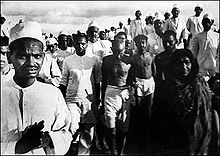
Direct Action
Mohandas Gandhi and supporters Salt March on March 12, 1930. This was an act of non-violent direct action.
A common form of political dissent in terms of military service is conscientious objection. A conscientious objector (CO) is an “individual who has claimed the right to refuse to perform military service” on the grounds of freedom of thought, conscience, and/or religion. In general, conscientious objector status is only considered in the context of military conscription and is not applicable to volunteer military forces.
6.2: Forming Public Opinion
6.2.1: Forming Political Values
People form political values throughout their life cycle through different agents of political socialization, including family, media, and education.
Learning Objective
Explain the agents of socialization that inform the individual’s political values
Key Points
- In childhood, political socialization and the formation of political values revolves around a burgeoning awareness of living in a certain place, being a part of a certain political system, and recognizing political or government leaders.
- The most influential years for the formation of political values is young adulthood, when people are most open to new ideas and encounter new opportunities for political engagement in college and the workplace.
- The agents a child surrounds him/herself with during childhood are crucial to the child’s development of future voting behaviors.
- The formation of political values occurs through political socialization. The most important agents of this socialization include family, school, peers, church, and the media.
Key Terms
- political socialization
-
The “developmental processes by which children and adolescents acquire political cognition, attitudes, and behaviors. ” It refers to a learning process by which political norms and behavior are transmitted from one generation to another.
- political equality
-
a system in which all people have the same rights and freedoms to participate in government and its institutions
Political Socialization
Political socialization is a concept concerning the “study of the developmental processes by which children of all ages (12 to 30) and adolescents acquire political cognition, attitudes, and behaviors”. It refers to a learning process by which norms and behavior acceptable to a well running political system are transmitted from one generation to another. It is through the performance of this function that individuals are inducted into the political culture and their orientations towards political objects are formed.
Agents of Socialization
The following agents of Socialization influence to different degrees an individual’s political opinions:
- Family
- Media
- Peers
- Education
- Religion
- Faith
- Race
- Gender
- Age
- Geography
These factors and many others that people are introduced to as they grow up will affect their political views throughout the rest of their lives. Political beliefs are often formed during childhood, as parents pass down their ideologies to their children and so on.
Factors
The agents a child surrounds him/herself with during childhood are crucial to the child’s development of future voting behaviors. Some of these agents include:
Family: Glass (1986) recognizes family as a primary influence in the development of a child’s political orientation, mainly due to constant relationship between parents and child, detailed in the table Family as a Primary Influence below.
Schools: Most influential of all agents, after the family, due to the child’s extended exposure to a variety of political beliefs, such as friends and teachers, both respected sources of information for students.Mass Media: Becker (1975) argue that the media functions as a medium of political information to adolescents and young children.
Religion: Religious tradition can have a strong effect on someone’s political views. For example, Protestants tend to be more conservative (in countries where Protestants are not great majority).
Political Parties: Scholars such as Campbell (1960) note that political parties have very little direct influence on a child due to a contrast of social factors such as age, context, power, etc.
Agents of Political Socialization
- Family – Most important shaper of basic attitudes Teaches basic political values & loyalty to particular political party
- Schools – Teach patriotism and American mythology Early grades build on and reinforce positive learning
- Peers – Limited in effect because of self-selection Peer group in youth affects mostly “lifestyle issues”
- Mass Media – Effect difficult to measure but substantial Promotes cynicism about government Agenda Setting – Telling us what to think about Framing – Tells us what to think about what is presented
- Political leaders and institutions
- Churches and Religion Religious right and religious left
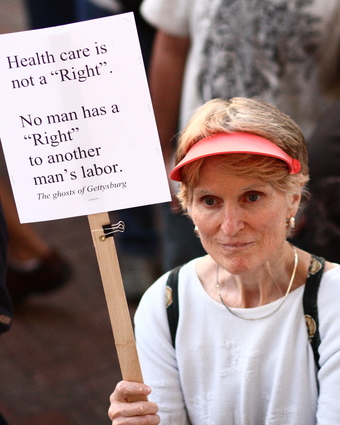
Senior Citizen Involvement
People who have not participated in politics much throughout their life may participate more in retirement.

Pledging Allegiance
Children learn political values through political socialization. This can occur through rituals, such as the recitation of the pledge of allegiance at the beginning of each school day.
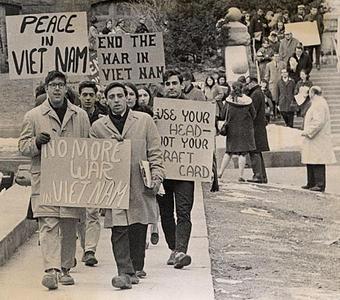
Student Protesters
Student activists in the 1960s protested against US involvement in the Vietnam War. Some activists developed more favorable attitudes toward government as they matured, had families, and became homeowners.
6.2.2: Models of Political Socialization
People learn political values and identities by interacting with other people and the media in a process called political socialization.
Learning Objective
Describe how political socialization occurs.
Key Points
- Political socialization refers to a process of political learning in which norms and beliefs about the political process are passed on from one generation to another.
- Political socialization is primarily a one-way process, in which agents of socialization (such as family or peers) pass on political values to subjects. Subjects are usually young people and are mostly passive in this political learning.
- In the United States, young people are socialized to accept specific American values. This includes acceptance of democracy, rule of law, respect for authorities, and the capitalist system.
- People are not always socialized to accept the standard rules and norms of a society. Sometimes, political socialization can pass on norms that are very different from the status quo.
Key Term
- political socialization
-
The “developmental processes by which children and adolescents acquire political cognition, attitudes, and behaviors. ” It refers to a learning process by which political norms and behavior are transmitted from one generation to another.
Psychological theories of self development have been broadened by sociologists who explicitly study the role of society and social interaction in self development. Charles Cooley and George Mead both contributed significantly to the sociological understanding of the development of self. Lawrence Kohlberg and Carol Gilligan developed their ideas further, researching how our sense of morality develops. Gilligan added the dimension of gender differences to Kohlberg’s theory.
How do we get from being newborns to being humans with “selves? ” Mead believed that there is a specific path of development that all people go through. During the preparatory stage, children are only capable of imitation: they have no ability to imagine how others see things. They copy the actions of people with whom they regularly interact, such as their mothers and fathers. This is followed by the play stage, during which children begin to take on the role that one other person might have. Thus, children might try on a parent’s point of view by acting out “grownup” behavior, like playing “dress up” and acting out the “mom” role, or talking on a toy telephone the way they see their father do.
During the game stage, children learn to consider several roles at the same time and how those roles interact with each other. They learn to understand interactions involving different people with a variety of purposes. For example, a child at this is likely to be aware of the different responsibilities of people in a restaurant who together make for a smooth dining experience (someone seats you, another takes your order, someone else cooks the food, while yet another clears away dirty dishes).
Finally, children develop, understand, and learn the idea of the generalized other, the common behavioral expectations of general society. By this stage of development, an individual is able to imagine how he or she is viewed by one or many others—and thus, from a sociological perspective, to have a “self” (Mead 1934; Mead 1964).
Moral development is an important part of the socialization process. The term refers to the way people learn what society considered to be “good” and “bad,” which is important for a smoothly functioning society. Moral development prevents people from acting on unchecked urges, instead considering what is right for society and good for others. Lawrence Kohlberg (1927–1987) was interested in how people learn to decide what is right and what is wrong. To understand this topic, he developed a theory of moral development that includes three levels: preconventional, conventional, and postconventional.
In the preconventional stage, young children, who lack a higher level of cognitive ability, experience the world around them only through their senses. It isn’t until the teen years that the conventional theory develops, when youngsters become increasingly aware of others’ feelings and take those into consideration when determining what’s “good” and “bad. ” The final stage, called postconventional, is when people begin to think of morality in abstract terms, such as Americans believing that everyone has the right to life, liberty, and the pursuit of happiness. At this stage, people also recognize that legality and morality do not always match up evenly (Kohlberg 1981). When hundreds of thousands of Egyptians turned out in 2011 to protest government corruption, they were using postconventional morality. They understood that although their government was legal, it was not morally correct.
Another sociologist, Carol Gilligan (1936–), recognized that Kohlberg’s theory might show gender bias since his research was only conducted on male subjects. Would females study subjects have responded differently? Would a female social scientist notice different patterns when analyzing the research? To answer the first question, she set out to study differences between how boys and girls developed morality. Gilligan’s research demonstrated that boys and girls do, in fact, have different understandings of morality. Boys tend to have a justice perspective, placing emphasis on rules and laws. Girls, on the other hand, have a care and responsibility perspective; they consider people’s reasons behind behavior that seems morally wrong.
Gilligan also recognized that Kohlberg’s theory rested on the assumption that the justice perspective was the right, or better, perspective. Gilligan, in contrast, theorized that neither perspective was “better”: the two norms of justice served different purposes. Ultimately, she explained that boys are socialized for a work environment where rules make operations run smoothly, while girls are socialized for a home environment where flexibility allows for harmony in caretaking and nurturing (Gilligan 1982; Gilligan 1990).
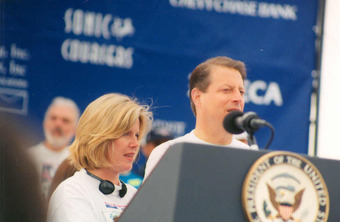
Accepting Political Legitimacy
In the 2000 election, most Americans quickly accepted the legitimacy of the Supreme Court’s decision. Teaching people to accept the “rules of the game,” as in this situation, is an important function of political socialization.
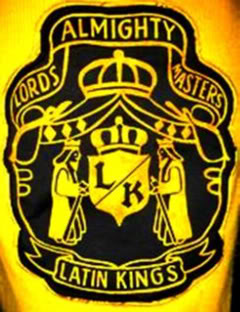
Latin Kings Socialization
Political socialization does not always mean people are being socialized to accept mainstream political views. The gang “The Latin Kings” (insignia shown) socializes members to violence.

Teaching Younger Generations
Political socialization involves one generation passing on political values and norms to the next generation.
6.2.3: From Political Values to Ideology
Core American political values general fall in line with one of three political ideologies: liberalism, conservatism, or moderate.
Learning Objective
Differentiate between the political ideologies of liberals, conservatives, and moderates and discuss how they relate to American political values
Key Points
- Political values are shared convictions about what is important in a society. Individualism and egalitarianism tend to be the two predominant political values in the United States.
- Some of the most important political values in the United States emphasize individual effort, the importance of the rule of law, patriotism, political tolerance, and an acceptance of capitalist economic values.
- While core political values exist, not all Americans agree on the scope and purpose of government, and consequently, not all Americans believe in the same political ideology.
- Political ideologies describe the scope and purpose of government. Conservatives believe in limited government intervention in the affairs of citizens, whereas liberalism believes in more government intervention, and moderates fall somewhere in between.
Key Terms
- political tolerance
-
A fair, objective, and permissive attitude toward those whose opinions, practices, race, religion, nationality, etc., differ from one’s own.
- political ideology
-
A political ideology is a certain ethical set of ideals that explains how society should work, and offers some political and cultural blueprint for a certain social order. It focuses on type of government and economy.
- rule of law
-
The doctrine that no individual is above the law and that everyone must answer to it.
What Are American Political Values?
Values represent a society’s shared convictions about what is just and good. Most often, Americans claim to be committed to the core values of individualism and egalitarianism. Core American political values are vested in what is often called the American creed. The creed, which was composed by New York State Commissioner of Education Henry Sterling Chapin in 1918, refers to the belief that the United States government is “by the people, for the people, whose just powers are derived from the consent of the governed. ” The nation consists of sovereign states united as “a perfect Union” based on “the principles of freedom, equality, justice, and humanity. “
American exceptionalism is the view that America’s successful development as a nation has contributed to its special place in the world. It is the conviction that the country’s vast frontier has offered boundless and equal opportunities for individuals to achieve their goals. Americans feel strongly that their nation is destined to serve as an example to other countries. They believe that the political and economic systems that have evolved in this country are perfectly suited in principle to permit both individualism and egalitarianism.
Additionally, the American creed also includes patriotism: the love of one’s country and respect for its symbols and principles. The events of 9/11 ignited Americans’ patriotic values, resulting in many public displays of support for the country, its democratic form of government, and authority figures in public-service jobs, such as police and firefighters.
Another core American value is political tolerance, the willingness to allow groups with different ideologies to exercise their constitutionally guaranteed freedoms, such as free speech. While many people strongly support the ideal of tolerance, they often are unwilling to extend political freedoms to groups they dislike. People acknowledge the constitutional right of racist groups, such as skinheads, to demonstrate in public, but will go to great lengths to prevent them from doing so. Democratic political values are among the cornerstones of the American creed.
Americans believe in the rule of law which explains the idea that government is based on a body of law, agreed on by the governed, and is applied equally and justly. The Constitution is the foundation for the rule of law. The American creed also encompasses the public’s high degree of respect for the American system of government and the structure of its political institutions .
Capitalist economic values are also a part of American values. Capitalist economic systems emphasize the need for a free-enterprise system that allows for open business competition, private ownership of property, and limited government intervention in business affairs. Underlying these capitalist values is the belief that, through hard work and perseverance, anyone can be financially successful. The emphasis on the lone, powerful person implies a distrust of collective action and of power structures such as big government, big business, or big labor. The public is leery of a few large companies having too much concentrated power. The emergence of the Tea Party, a visible grassroots conservative movement that gained momentum during the 2010 midterm elections, illustrates how some Americans become mobilized in opposition to the “tax and spend” policies of big government.
Translating Political Values into Political Ideologies
While there are various components to fundamental American political values, not all Americans agree on which exactly the most important values should be . People believe that, when making policies, certain values should be emphasized and others deemphasized. People then choose a political ideology that most closely matches their values. These ideologies capture what they believe the scope and purpose of government should be, as well as the balance between individual freedom and collective equality.
Generally, peoples’ values about the scope and purpose of government can be translated into three main political ideologies: liberals, conservatives, and moderates. People who value change and a greater emphasis on collective equality tend to relate to the ideology of liberalism. Liberals support more government intervention to promote economic equality, and believe the government should have more of a say in peoples’ lives.
Contrastingly, people who value tradition and the status quo will relate more to conservatism. Conservatives favor less government intervention (like the Tea Party), and more individual freedom in economic activities (which can subsequently mean a belief in less collective equality). Moderates hold an ideology somewhere in between liberalism and conservatism.
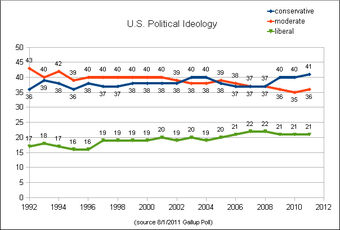
Political Ideology Trends
As this chart illustrates, not all Americans agree on which should be the predominant political values and ideologies. Also in this chart, it is evident that people align with different ideologies at different points in time.
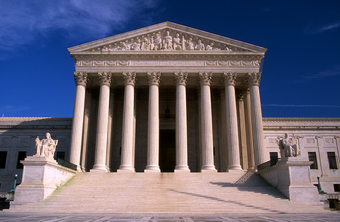
Equal Justice under Law
The inscription on the front of the United States Supreme Court building reads, “equal justice under law. ” This phrase emphasizes the centrality of the rule of law in American political values.
6.2.4: Socioeconomic and Racial Demographics
Political socialization experiences differ depending on group membership, such as socioeconomic status, gender, or geography.
Learning Objective
Describe the ways in which race, gender, socioeconomic status, and geographical region influence how people are politically socialized.
Key Points
- Different groups are socialized to more or less participation, and to different types of participation. People are socialized to these different political values based on where they live, their gender, their race or ethnicity, or their socioeconomic status.
- Wealthier and more highly educated people are exposed to more avenues for political socialization; in particular, since schools are a key agent of political socialization, highly educated people tend to be very active in politics.
- Political socialization also differs depending on where people live. For example, typically people are conservative in the South and Midwest, and align against the more liberal east and west coasts. Urban voters tend to be socialized to be more liberal, and rural voters more conservative.
- Typically, women’s political learning and formation of political values has been different than men’s. Traits associated with political leadership have more often been attributed as “male” values, leading to fewer women in visible political leadership roles.
Key Terms
- socioeconomic status
-
Socioeconomic status (SES) is a combined economic and sociological measurement of a person’s work experience and of an individual’s or family’s economic and social position in relation to others, based on income, education, and occupation.
- political socialization
-
The “developmental processes by which children and adolescents acquire political cognition, attitudes, and behaviors. ” It refers to a learning process by which political norms and behavior are transmitted from one generation to another.
- red-state blue-state divide
-
The Red State-Blue State Divide is a geographical division of the United States into states in which the majority of people voted for the Republican candidate and states in which the majority voted for the Democratic candidate.
Group Differences in Political Socialization
Political learning and socialization experiences can differ vastly for people depending on the groups with which they associate, such as those based on gender and racial and ethnic background. Certain groups are socialized to a more active role in politics, while others are marginalized.
Political Socialization and Socioeconomic Status
Socioeconomic status is determined by people’s levels of education, income, and occupation. Wealthier and more highly educated people tend to have more opportunities to be socialized to political values. Consequently, they tend to have more defined political opinions, vote more often, participate more in political activities, and donate more money to causes than poorer or less educated people. Oftentimes, they have been raised by parents who are of the same socioeconomic status, who socialize them to believe in the importance of political participation.
Education has the strongest impact on participation, as it socializes people to the political system. Schools are important agents for political socialization, and as a result, educated people develop the skills that allow them to follow and understand events through the mass media. They are likely to form opinions about political issues and engage in discussions. Schools also prepare people to deal with the bureaucratic aspects of participation, such as registering to vote or organizing a petition drive.
Political Socialization and Race
People are attracted to groups with similar views. Generally, groups who have experienced historical discrimination or poverty are attracted to more liberal social doctrine. African Americans overwhelmingly identify with the Democratic party, and Latinos also identify with the Democratic party. Asian Americans are more likely to identify with the Republican party. Racial and ethnic groups, like other groups, socialize the members of the group towards different values in politics.
Black and white Americans are about equal in how much time and effort they devote to activities other than voting. However, they differ in the types of activities in which they have been socialized to participate in. Whites are more likely to contact public officials and join political organizations. Black citizens are active in election campaigns and social movements. Latinos tend to participate in other forms of political activity with less frequency than either white or black citizens. Cultural factors contribute to the lower levels of Asian American and Pacific Islander voting; for example, some are recent immigrants who still maintain strong ties to their ethnic culture. These groups have not experienced as much political socialization as other groups.
Political Socialization and Geographical Region
People are also socialized to accept different political values, ideologies, and parties based on the region of the country in which they grew up or currently live. For example, the southern United States is characterized as more conservative, against organized labor, and typically having less voter turnout. The conservative, agrarian midwestern states tend to vote with these Southern states, in alliance against the more liberal, urban voters on the east and west coasts.
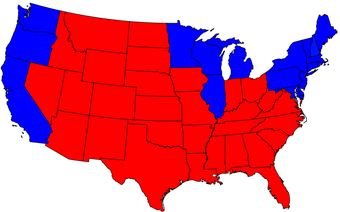
Political Values by Geographic Region
This map of the different party strength in the 2004 Presidential Election (red states voted Republican and blue states voted Democrat) demonstrates the relationship between political socialization and geography.
This red-state blue-state divide can be more accurately explained by looking at urban and rural voting. People who live in large cities tend to vote Democratic, while rural Americans are more likely to vote Republican. County-by-county and district-by-district maps reveal that the “true” nature of geographical division, ideologically, is between urban areas/inner suburbs and suburbs/rural areas. For example, in the 2008 elections, even in “solidly blue” states, the majority of voters in most rural counties voted for Republican John McCain, with some exceptions. In “solidly red” states, a majority of voters in most urban counties voted for Democrat Barack Obama. An even more detailed precinct-by-precinct breakdown demonstrates that in many cases, large cities voted for Obama, but their suburbs were divided.
Political Socialization and Gender
There are significant differences in the way that males and females are socialized to politics. Historically, men have occupied a more central position in American political culture than women. This tradition was institutionalized at the time of the founding, when women did not receive the right to vote in the Constitution. While strides have been made over the past century to achieve political equality between the sexes, differences in sex-role socialization still exist. Traits associated with political leadership, such as being powerful and showing authority, are more often associated with males than females. Girls have fewer opportunities to observe women taking political action, especially as few females hold the highly visible positions, such as member of Congress and cabinet secretary, that are covered by mass media. This is starting to change as women such as Madeleine Albright and now Hillary Clinton attract media attention in their roles as secretary of state or as Nancy Pelosi did as Speaker of the House of Representatives . Despite these developments, women are still socialized to supporting political roles, such as volunteers in political campaigns, rather than leading roles, such as higher-level elected officials. The result is that fewer women than men seek careers in public office beyond the local level.
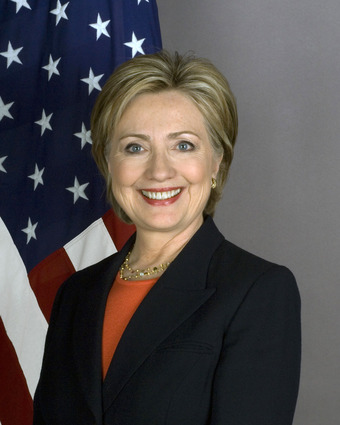
Hillary Rodham Clinton
Secretary of State Hillary Clinton is one of an increasing number of women who has achieved a highly visible political leadership role.
6.2.5: Family, Peers, Church, and School
People that surround a child during his or her childhood are crucial to the child’s development of political values and voting behaviors.
Learning Objective
Locate the differences across the factors of political socialization
Key Points
- The family is a powerful agent of political socialization, as the hierarchical structure of the family and the child’s desire to please his or her parents encourage conformity to the parents’ political values. In particular, children will often identify with the parents’ political party.
- Schools are a crucial agent of political socialization, as they teach the knowledge necessary for political participation. Students learn civics, history, geography, and how the political system works.
- US schools socialize students to American values, such as cooperation, fair competition, and respect for authorities. Schools also provide opportunities for students to learn national pride and citizenship (for example, through rituals like saying the Pledge of Allegiance).
- Peer groups can be influential to political socialization, as young people often adopt the same patterns of behaviors and beliefs as the groups they associate with.
- Churches socialize people to accept certain political values, and also teach values such as respect for authority.
Key Terms
- latent
-
Existing or present, but concealed.
- peers
-
A group of people who are linked by common interests, equal social position, and similar age.
- agent
-
An active power or cause; that which has the power to produce an effect.
Family
Family is the first agent of socialization. Mothers and fathers, siblings and grandparents, plus members of an extended family, all teach a child what he or she needs to know. For example, they show the child how to use objects (such as clothes, computers, eating utensils, books, bikes); how to relate to others (some as “family,” others as “friends,” still others as “strangers” or “teachers” or “neighbors”); and how the world works (what is “real” and what is “imagined”). As you are aware, either from your own experience as a child or your role in helping to raise one, socialization involves teaching and learning about an unending array of objects and ideas.
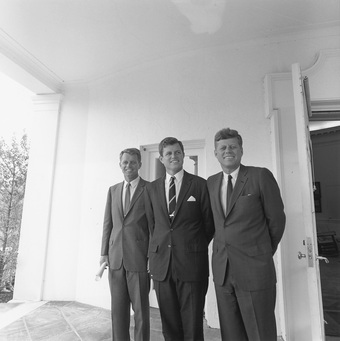
Family Participation in Politics
Members of the Kennedy family have been prominently involved in politics for over a century, illustrating how the desire to participate in politics can be passed on generationally. Family is an important agent of political socialization.
School
Most American children spend about seven hours a day, 180 days a year, in school, which makes it hard to deny the importance school has on their socialization (U.S. Department of Education 2004). Students are not only in school to study math, reading, science, and other subjects—the manifest function of this system. Schools also serve a latent function in society by socializing children into behaviors like teamwork, following a schedule, and using textbooks.School and classroom rituals, led by teachers serving as role models and leaders, regularly reinforce what society expects from children. Sociologists describe this aspect of schools as the hidden curriculum, the informal teaching done by schools.
Peer Group
A peer group is made up of people who are similar in age and social status and who share interests. Peer group socialization begins in the earliest years, such as when kids on a playground teach younger children the norms about taking turns or the rules of a game or how to shoot a basket. As children grow into teenagers, this process continues. Peer groups are important to adolescents in a new way, as they begin to develop an identity separate from their parents and exert independence. Additionally, peer groups provide their own opportunities for socialization since kids usually engage in different types of activities with their peers than they do with their families. Peer groups provide adolescents’ first major socialization experience outside the realm of their families. Interestingly, studies have shown that although friendships rank high in adolescents’ priorities, this is balanced by parental influence.
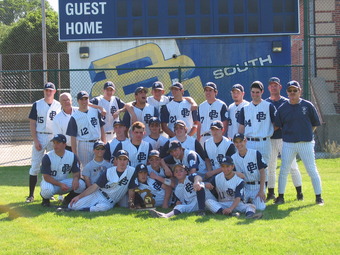
Importance of Peer Groups
Spending time with peers, such as participating in organized sports, can be an important source of political socialization for young adults.
Religion and Church
While some religions may tend toward being an informal institution, this section focuses on practices related to formal institutions. Religion is an important avenue of socialization for many people. The United States is full of synagogues, temples, churches, mosques, and similar religious communities where people gather to worship and learn. Like other institutions, these places teach participants how to interact with the religion’s material culture (like a mezuzah, a prayer rug, or a communion wafer). For some people, important ceremonies related to family structure—like marriage and birth—are connected to religious celebrations. Many of these institutions uphold gender norms and contribute to their enforcement through socialization. From ceremonial rites of passage that reinforce the family unit, to power dynamics which reinforce gender roles, religion fosters a shared set of socialized values that are passed on through society.
6.2.6: The Mass Media
Media can have an important effect on public opinion in several ways.
Learning Objective
Explain the different ways that the mass media forms public opinion
Key Points
- Mass media frame the details of the story.
- Mass media communicate the social desirability of certain ideas.
- Mass media sets the news agenda, which shapes the public’s views on what is newsworthy and important.
- Increasing scandal coverage, as well as profit-motivated sensationalist media coverage, has resulted in young people holding more negative, distrustful views of government than previous generations.
Key Terms
- framing
-
the construction and presentation of a fact or issue “framed” from a particular perspective
- mass media
-
The mass media are media technologies like broadcast media and print media that are designed to reach a large audience by mass communication.
Mass media effects on public opinion
Media can have an important effect on public opinion in several ways.
- Setting the news agenda, which shapes the public’s views on what is newsworthy and important
- Framing the details of a story
- Communicating the social desirability of certain kinds of ideas
The formation of public opinion starts with agenda setting by major media outlets throughout the world. This agenda setting dictates what is newsworthy and how and when it will be reported. The media agenda is set by a variety of different environmental and newswork factors that determines which stories will be newsworthy.
Another key component in the formation of public opinion is framing. Framing is when a story or piece of news is portrayed in a particular way and is meant to sway the consumers attitude one way or the other. Most political issues are heavily framed in order to persuade voters to vote for a particular candidate. For example, if Candidate X once voted on a bill that raised income taxes on the middle class, a framing headline would read “Candidate X Doesn’t Care About the Middle Class”. This puts Candidate X in a negative frame to the news reader.
Social desirability is another key component to the formation of public opinion. Social desirability is the idea that people in general will form their opinions based on what they believe is the popular opinion. Based on media agenda setting and media framing, most often a particular opinion gets repeated throughout various news mediums and social networking sites, until it creates a false vision where the perceived truth is actually very far away from the actual truth.
Public opinion can be influenced by public relations and the political media. Additionally, mass media utilizes a wide variety of advertising techniques to get their message out and change the minds of people. Since the 1950s, television has been the main medium for molding public opinion, though the internet is becoming increasingly important in this realm.

News Media
Increasing exposure to news media has both a positive and negative effects on the formation of political values in young people.
6.2.7: Political Leaders and Opinion Makers
An opinion leader is an active media user who interprets the meaning of media messages for those less informed about political events.
Learning Objective
Compare and contrast monomorphic and polymorphic opinion leadership
Key Points
- Opinion leaders interpret and disseminate political messages for the average person, to help him or her understand complex political issues.
- Opinion leaders sometimes have more influence than the media, primarily because opinion leaders are seen as trustworthy and non-purposive. People are more inclined to accept a political message from someone they know, rather than the media, who they feel may be attempting to manipulate them.
- Political pundits, public officials, celebrities, and media personalities can all serve as opinion leaders.
- Some argue that the opinion of the elites in society should matter the most. The average American should not and does not have much say in public opinion; rather, elite opinion counts the most.
Key Terms
- pundit
-
A self-professed expert in a particular field, especially as called upon to provide comments or opinions in the media; a commentator, a critic.
- opinion leader
-
The agent who is an active media user and who interprets the meaning of media messages or content for lower-end media users. Typically the opinion leader is held in high esteem by those who accept his or her opinions.
Opinion Leaders
Opinion leadership is a concept that arises out of the theory of two-step flow of communication propounded by Paul Lazarsfeld and Elihu Katz Significant developers of the theory have been Robert K. Merton, C. Wright Mills and Bernard Berelson. This theory is one of several models that try to explain the diffusion of innovations, ideas, or commercial products.
The opinion leader is the agent who is an active media user and who interprets the meaning of media messages or content for lower-end media users. Typically the opinion leader is held in high esteem by those who accept his or her opinions. Merton distinguishes two types of opinion leadership: monomorphic and polymorphic.
Typically, opinion leadership is viewed as a monomorphic, domain-specific measure of individual differences, that is, a person that is an opinion leader in one field may be a follower in another field . An example of a monomorphic opinion leader in the field of computer technology, might be a neighborhood computer service technician. The technician has access to far more information on this topic than the average consumer and has the requisite background to understand the information, though the same person might be a follower at another field (for example sports) and ask others for advice. In contrast, polymorphic opinion leaders are able to influence others in a broad range of domains. Variants of polymorphic opinion leadership include market mavenism, personality strength and generalized opinion leadership. So far, there is little consensus as to the degree these concept operationalize the same or simply related constructs .
What makes an opinion leader?
One or more of these factors make noteworthy opinion leaders:
- expression of values
- professional competence
- nature of social network.
Opinion leaders are individuals who obtain more media coverage than others and are especially educated on a certain issue. They seek the acceptance of others and are especially motivated to enhance their social status. In the jargon of public relations, they are called thought leaders.
Example
In a strategic attempt to engage the public in environmental issues and his nonprofit, The Climate Project, Al Gore utilized the concept of opinion leaders. Gore found opinion leaders by recruiting individuals who were educated on environmental issues and saw themselves as influential in their community and amongst their friends and family. From there, he trained the opinion leaders on the information he wanted them to spread and enabled them to influence their communities. By using opinion leaders, Gore was able to educate and influence many Americans to take notice of climate change and change their actions.
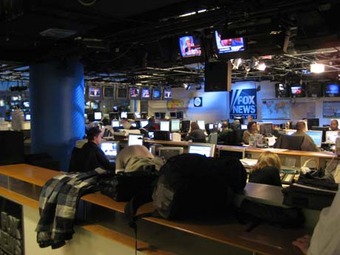
Fox News
News stations, such as Fox News, provide opportunities for viewers to hear from opinion leaders.
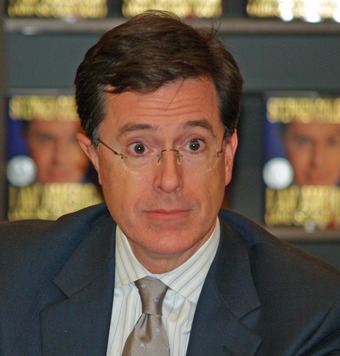
Opinion Leaders
Opinion leaders, such as Stephen Colbert, often shape public opinion. People are inclined to follow opinion leaders because of their knowledge and experience.

Celebrities as Opinion Leaders
George Clooney is an example of a celebrity opinion leader. His advocacy for issues in Africa and the Sudan has made him an opinion leader for many people.
6.2.8: Major Life and Political Events
Political socialization takes place throughout the life cycle, but major life or political events can also impact political values.
Learning Objective
Explain how parents, social groups and major life events are sources for political socialization
Key Points
- The life cycle is a key component to political socialization: throughout time, people grow more attached and socialized to particular political values.
- Certain events during a person’s life, such as buying a home or having children, can impact the formation of political values.
- When a generation experiences a major political event together, such as the Great Depression, a political generation can emerge. This political generation will have political values distinct from other political generations.
- The primary political generations in American politics include the Depression Era/GI generation, the silent generation, the baby boom generation, generation X, and the millennial generation/generation Y.
- Conflict usually exists between the younger and older political generations, as the younger generations are more open to new and changing ideas.
Key Terms
- life cycle
-
The developmental history of an individual or group in society; the course of stages through which a human passes from birth until death.
- political generation
-
A group of individuals, similar in age, who share a general set of political socialization experiences.
Sources of Political Socialization
Parents appear to be a primary source of political socialization and partisanship. Much of the theoretical basis for this hypothesis emerged from the fields of child psychology and social learning, which studied the ways in which children are socialized and values inculcated in them. Studies of political partisanship have found that partisanship is strongest when both parents have the same political loyalties, these loyalties are strong, both parents have similarly strong party loyalties, and parental partisanship accords with socio-economic status (for example, the wealthy are Republicans or the poor are Labour supporters).
Social groups are another source of partisanship. Friends, relatives, and neighbors often have the same partisan loyalties and strengths as one’s parents. The more homogeneous the social group, the more likely the individual will be to develop strong partisan loyalties. When social group homogeneousness is low, the individual is likely to be less strongly socialized into partisan politics and more likely to seek a different party loyalty (whether by disengaging from partisanship or switching partisan loyalties).
Political socialization takes place throughout the course of a person’s life. However, certain major life and political events can interrupt the normal progression of political socialization, causing a person to change his or her opinion and accept other political values and ideologies.
Initially, studies indicated that the most important factor in forming political values was the life cycle. That is, a person’s attachment to a specific political ideology naturally grew stronger over time, as weak socialization became strong and strong socialization became stronger. Additionally, theorists suggested that older voters favored certain policy preferences (such as strong government pensions and old-age health insurance) which led them to favor one party over another.
Impact of Major Life Events
Later studies have shown that the initial strong effect of the life cycle variable was mitigated by generational effects. Party identification seemed strongly affected by certain formative generational events, such as the Civil War, the Great Depression or the social upheaval of the 1960s. Several studies concluded that generational effects (major life events) were distinct from life cycle effects, and that both were significant factors in creating (or not creating) partisanship.
Conceding that major “shocks” such as the Great Depression could realign or dealign partisanship, some scholars reasoned that a series of smaller shocks over time could also dramatically influence the direction and strength of partisanship. Many scholars became convinced that partisanship was not bedrock, but shifting sand. Important childhood events, such as becoming aware of a presidential campaign, as well as events in adulthood (such as recessions, war, or shifting racial policies) could also affect one’s level of partisanship.

September 11, 2001
Major historical or political events, such as September 11th, can impact the political socialization and the formation of political values for an entire generation.
6.2.9: Political Knowledge
Political knowledge, in addition to political socialization and major events, impact the formation of people’s political values and opinions.
Learning Objective
Discuss the relationship between political knowledge and public opinion
Key Points
- While agents of socialization like family, peers, church, and school are important in developing political values, how much people know, factually, about their political system and leaders is also important in the formation of political values.
- The formation of public opinion assumes that Americans are knowledgable enough to make a sound judgement; however, statistics indicate many Americans are ignorant on basic facets of American political life.
- Some argue that Americans are not well-informed about politics as a result of rational ignorance, where it is believed that the costs of gaining enough political knowledge to be informed outweighs the benefits.
Key Terms
- political socialization
-
The “developmental processes by which children and adolescents acquire political cognition, attitudes, and behaviors.” It refers to a learning process by which political norms and behavior are transmitted from one generation to another.
- rational ignorance
-
The belief that the cost of educating oneself on an issue exceeds the potential benefit that the knowledge would provide.
Forming Opinions through Knowledge
While it is known that agents of political socialization (such as family, peers, church, and school) and major life and political events impact political values and public opinion, some argue that political knowledge plays a large role as well.
In this view, public opinion is formed and shaped when people investigate and research politics, and are consequently able to form their own opinions. How much people know about their government and their leaders, where they receive their information, the quality and impartiality of the sources they used, all impact the formation of their political values and opinions .
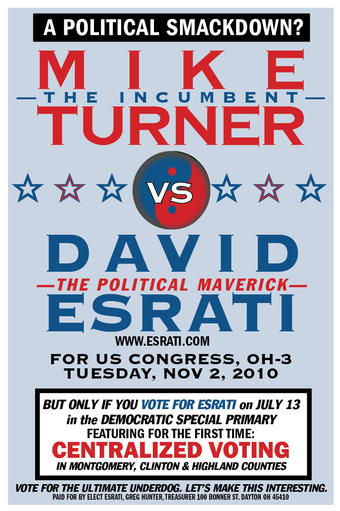
Political Knowledge
Some people are that political values are formed as a result of political knowledge. Researching two political candidates, as illustrated in this flyer, help increase political knowledge.
Forming Opinions without Knowledge
The formation of public opinion assumes that Americans know enough about political issues to shape opinions based on political knowledge. However, certain statistics demonstrate that many Americans lack this basic knowledge about politics. Many people cannot identify important political figures or are misinformed about important political issues, such as how much foreign aid the United States donates or what is actually written in the Constitution.
This type of voter ignorance is due to the fact that, oftentimes, the cost of investigating political issues and forming opinions outweighs the benefits. This theory, called “rational ignorance,” effects the quality of decisions made by large numbers of people and can be seen in general elections, where the probability of any one vote changing the outcome is very small.
6.3: Measuring Public Opinion
6.3.1: Constructing Public Opinion Surveys
An opinion poll is a survey of public opinion from a particular sample, and is designed to represent the opinions of a population.
Learning Objective
Discuss how public opinions surveys are designed and executed
Key Points
- There are several ways of administering a survey, such as telephone, mail, online surveys, personal in-home surveys, personal mail or street intercept survey, and hybrids of the above.
- A survey typically consists of a number of questions the respondent answers in a set format. There are open-ended and closed-ended questions. An open-ended question asks the respondent to form their own answer, while closed-ended questions have the respondent choose an answer from a given option.
- The most important aspects of a survey include identifying and selecting potential sample members, contacting individuals and collecting data from those who are hard to reach, evaluating and testing questions, and selecting the mode for posing questions and collecting responses.
Key Terms
- Self-Selection Bias
-
Although individuals chosen to participate in surveys are often randomly sampled, errors due to non-response may exist. Some prospective respondents may simply be less likely to respond to polls generally, they may not be interested in the subject, or they may be unreachable for a variety of reasons.
- Opinion Poll
-
An opinion poll, sometimes simply referred to as a “poll,” is a survey of public opinion from a particular sample. Opinion polls are usually designed to represent the opinions of a population by conducting a series of questions and then extrapolating generalities in ratio or within confidence intervals.
An opinion poll, sometimes simply referred to as a “poll,” is a survey of public opinion from a particular sample . Opinion polls are usually designed to represent the opinions of a population by conducting a series of questions and then extrapolating generalities in ratio or within confidence intervals.
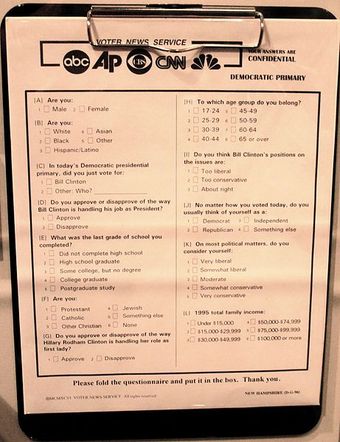
Voter Poll
Voter polling questionnaire on display at the Smithsonian Institution
Modes of Data Collection
There are several ways of administering a survey. The choice between administration modes is influenced by: 1) cost, 2) coverage of target population, 3) flexibility of asking questions, 4) respondents’ willingness to participate, and 5) response accuracy. Different methods create mode effects that change how respondents answer. The most common modes of administration are:
- Telephone
- Online surveys
- Personal in-home surveys
- Personal mall or street intercept surveys
- Hybrids of the above.
Response Formats
Usually, a survey consists of a number of questions the respondent answers in a set format. A distinction is made between open-ended and closed-ended questions. An open-ended question asks the respondent to formulate his or her own answer, while closed-ended questions have the respondent choose an answer from a given number of options. The response options for a closed-ended question should be exhaustive and mutually exclusive. The four types of response scales for closed-ended questions are:
- Dichotomous: The respondent has two options.
- Nominal-polytomous: The respondent has more than two unordered options.
- Ordinal-polytomous: The respondent has more than two ordered options.
- (Bounded) Continuous: The respondent is presented with a continuous scale.
A respondent’s answer to an open-ended question can be coded into a response scale afterwards or analyzed using more qualitative methods.
Survey Methodology
The most important aspects of a survey include:
- Identifying and selecting potential sample members.
- Contacting individuals and collecting data from those who are hard to reach (or reluctant to respond).
- Evaluating and testing questions.
- Selecting the mode for posing questions and collecting responses.
- Training and supervising interviewers.
- Checking data files for accuracy and internal consistency.
- Adjusting survey estimates to correct for identified errors.
Advantages
- They are relatively easy to administer.
- Can be developed in less time compared with other data-collection methods.
- Can be cost-effective.
- Few “experts” are required to develop a survey, which may well increase the reliability of the survey data.
- If conducted remotely, can reduce or obviate geographical dependence.
- Useful in describing the characteristics of a large population assuming the sampling is valid.
- Can be administered remotely via the Web, mail, e-mail, telephone, etc.
- Efficient at collecting information from a large number of respondents.
- Statistical techniques can be applied to the survey data to determine validity, reliability, and statistical significance, even when analyzing multiple variables.
- Many questions can be asked about a given topic, giving considerable flexibility to the analysis.
- A wide range of information can be collected (e.g., attitudes, values, beliefs, and behavior).
- Because they are standardized, they are relatively free from several types of errors.
Disadvantages
The reliability of survey data may depend on the following:
- Respondents’ motivation, honesty, memory, and ability to respond:
- Structured surveys, particularly those with closed-ended questions, may have low validity when researching effective variables.
- Self-selection bias: Although the individuals chosen to participate in surveys are often randomly sampled, errors due to non-responses may exist. Some prospective respondents may simply be less likely to respond to polls generally, not interested in the subject, or may be unreachable for many reasons. For example, polls or surveys that are conducted by calling a random sample of publicly available telephone numbers will not include the responses of people with unlisted telephone numbers, cell phone numbers, who are unable to answer the phone, and who do not answer calls from unknown/unfamiliar telephone numbers.
- Question design: Survey question answer-choices could lead to vague data sets because, at times, they are relative only to a personal abstract notion concerning “strength of choice”. For instance, the choice “moderately agree” may mean different things to different subjects and anyone interpreting the data for correlation. Even “yes” or “no” answers are problematic because subjects may for instance put “no” if the choice “only once” is not available.
Non-response Reduction
The following ways have been recommended for reducing non-response in telephone and face-to-face surveys:
- Advance letter: A short letter sent in advance to inform the sampled respondents about the upcoming survey.
- Training: The interviewers are thoroughly trained in how to ask respondents questions, work with computers and make schedules for callbacks to respondents who were not reached.
- Short introduction: The interviewer gives the basic information on him/herself and the survey.
- Respondent-friendly survey questionnaire: Questions must be clear, non-offensive, and easy to respond to.
6.3.2: Early Public Opinion Research and Polling
The first known example of an opinion poll was an 1824 local straw poll by The Harrisburg Pennsylvanian for the Jackson Adams race.
Learning Objective
Identify the historical origins of public opinion research in the United States
Key Points
- As The Harrisburg Pennsylvanian correctly predicted a Jackson win, such straw votes gradually became more popular, but they remained local, usually city-wide phenomena, until the early 1900s.
- The method The Literary Digest used to correctly predict the victories of Warren Harding in 1920, Calvin Coolidge in 1924, Herbert Hoover in 1929, and Franklin Roosevelt in 1932 was mailing out millions of postcards and simply counting the returns.
- Gallup was able to correctly predict the Roosevelt-Landon race by using a sample that was small, however, representative of the general population, while the Digest’s mistake was using a large but skewed sample.
Key Terms
- Literary Digest
-
The Literary Digest was an influential general interest weekly magazine published by Funk & Wagnalls. When the Digest conducted their 1936 election using an inaccurate sample causing them to predict the wrong winner, they lost all credibility and the Digest itself soon went out of business.
- The Harrisburg Pennsylvanian
-
The Harrisburg Pennsylvanian was the publication that conducted the first example of an opinion poll during the Jackson-Adams presidential race.
- George Gallup
-
George Gallup conducted a small but scientific survey that correctly predicted a landslide victory for Roosevelt in the Roosevelt-Landon race, thus establishing the Gallup Poll.
The first known example of an opinion poll was a local straw poll conducted by The Harrisburg Pennsylvanian in 1824, showing Andrew Jackson leading John Quincy Adams by 335 votes to 169 in the contest for the United States Presidency. Since Jackson won the popular vote in the full election, such straw votes gradually became more popular, but they remained local, usually city-wide, phenomena.
In 1916, the Literary Digest embarked on a national survey, partly as a circulation-raising exercise, and correctly predicted Woodrow Wilson’s election as president . Mailing out millions of postcards and simply counting the returns, the Digest correctly predicted the victories of Warren Harding in 1920, Calvin Coolidge in 1924, Herbert Hoover in 1929, and Franklin Roosevelt in 1932.
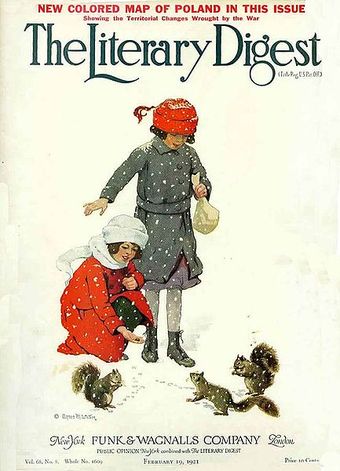
The Literary Digest
The Literary Digest conducted the first national poll.
In 1936, its 2.3 million “voters” constituted a huge sample; however, they were generally more affluent Americans who tended to have Republican sympathies. The Literary Digest was ignorant of this new bias. The week before Election Day, it reported that Alf Landon was far more popular than Roosevelt . At the same time, George Gallup conducted a far smaller, but more scientifically based survey, in which he polled a demographically representative sample. Gallup correctly predicted Roosevelt’s landslide victory. The Literary Digest soon went out of business, while polling started to take off.
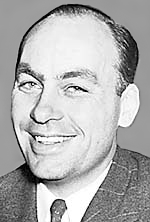
George Gallup
George H. Gallup was the founder of the Gallup Poll.
Elmo Roper was another American pioneer in political forecasting using scientific polls. He predicted the reelection of President Franklin D. Roosevelt three times, in 1936, 1940, and 1944. Louis Harris had been in the field of public opinion since 1947 when he joined the Elmo Roper firm, then later became partner.
Gallup launched a subsidiary in the United Kingdom, where it almost alone correctly predicted Labour’s victory in the 1945 general election. This contrasted with virtually all other commentators, who expected a victory for the Conservative Party led by Winston Churchill.
By the 1950s, various types of polling had spread to most democracies.
6.3.3: The Gallup Organization
Gallup Inc. was founded in 1958, when George Gallup grouped all of his polling operations into one organization.
Learning Objective
Locate the historical origins and significance of the Gallup Organization for public opinion research in the United States
Key Points
- To ensure his independence and objectivity, Dr. Gallup resolved that he would undertake no polling that was paid for or sponsored in any way by special interest groups such as the Republican and Democratic parties, a commitment that Gallup upholds to this day.
- Gallup Polls are often referenced in the mass media as a reliable and objective measurement of public opinion. Historically, the Gallup Poll has measured the public’s attitudes concerning virtually every political, social, and economic issue of the day.
- Gallup Polls are best known for their accuracy in predicting the outcome of United States presidential elections.
Key Terms
- The Gallup Organization
-
Gallup Inc. was founded in 1958, when George Gallup grouped all of his polling operations into one organization. Today, Gallup, Inc. is primarily a research-based, performance-management consulting company.
- Gallup Poll
-
The Gallup Poll is the division of Gallup that regularly conducts public opinion polls in more than 140 countries around the world. Gallup Polls are often referenced in the mass media as a reliable and objective measurement of public opinion.
The Gallup Organization
Founded by George Gallup , Gallup, Inc. is primarily a research-based, performance-management consulting company. Some of Gallup’s key practice areas are – employee engagement, customer engagement, and well-being. Gallup has more than 40 offices in 27 countries. World headquarters are in Washington, D.C. Operational headquarters are in Omaha, Nebraska.
Gallup currently has four divisions: Gallup Poll, Gallup Consulting, Gallup University, and Gallup Press.
History
Gallup Inc. was founded in 1958, when George Gallup grouped all of his polling operations into one organization. After Gallup’s death in 1984, The Gallup Organization was sold to Selection Research, Incorporated (SRI) of Lincoln, Nebraska in 1988. George Gallup founded the American Institute of Public Opinion, the precursor of The Gallup Organization, in Princeton, New Jersey, in 1935. He wished to objectively determine the opinions held by the general public. To ensure his independence and objectivity, Dr. Gallup resolved that he would undertake no polling that was paid for or sponsored in any way by special interest groups such as the Republican and Democratic parties, a commitment that Gallup upholds to this day.
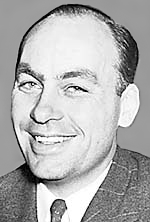
George Gallup
George H. Gallup was the founder of the Gallup Poll.
In 1936 Gallup successfully predicted that Franklin Roosevelt would defeat Alfred Landon for the U.S. presidency; this event quickly popularized the company. In 1938 Dr. Gallup and Gallup Vice President David Ogilvy began conducting market research for advertising companies and the film industry. In 1958 the modern Gallup Organization was formed from a merger of several polling organizations. Since then, Gallup has seen huge expansion into several other areas.
Gallup died on November 21, 2011.
Gallup Poll
The Gallup Poll is the division of Gallup that regularly conducts public opinion polls in more than 140 countries around the world. Gallup Polls are often referenced in the mass media as a reliable and objective measurement of public opinion. Gallup Poll results, analyses, and videos are published daily on Gallup.com in the form of data-driven news.
Historically, the Gallup Poll has measured and tracked the public’s attitudes concerning virtually every political, social, and economic issue of the day, including highly sensitive or controversial subjects. In 2005, Gallup began its World Poll, which continually surveys citizens in more than 140 countries, representing 95% of the world’s adult population. General and regional-specific questions, developed in collaboration with the world’s leading behavioral economists, are organized into powerful indexes and topic areas that correlate with real-world outcomes.
Gallup Polls are best known for their accuracy in predicting the outcome of United States presidential elections. Notable exceptions include the 1948 Thomas Dewey-Harry S. Truman election, where nearly all pollsters predicted a Dewey victory. The Gallup Poll also inaccurately projected a slim victory by Gerald Ford in 1976, where he lost to Jimmy Carter by a small margin. For the 2008 U.S. presidential election, Gallup was rated 17th out of 23 polling organizations in terms of the precision of its pre-election polls relative to the final results.
In 2008, Gallup interviewed no fewer than 1,000 U.S. adults each day, providing the most watched daily tracking poll of the race between John McCain and Barack Obama.Gallup also conducts 1,000 interviews per day, 350 days out of the year, among both landline and cell phones across the U.S. for its health and well-being survey.
6.3.4: The National Election Studies
The American National Election Studies (ANES) is the leading academically run national survey of voters in the United States.
Learning Objective
Identify the purpose of national election studies
Key Points
- The consistency of the studies, as in asking the same questions repeatedly over time, makes it very useful for academic research. As a result, it is frequently cited in works of political science.
- Though the ANES was formally established by a National Science Foundation grant in 1977, the data are a continuation of studies going back to 1948.
- The American Voter‘ concluded that most voters cast their ballots primarily on the basis of partisan identification and that independent voters are actually the least involved in and attentive to politics.
Key Terms
- The American Voter
-
The American Voter (1960) a seminal study of voting behavior in the United States, authored by Angus Campbell, Philip Converse, Warren Miller, and Donald Stokes, colleagues at the University of Michigan.
- National Election Studies
-
The American National Election Studies is the leading academically-run national survey of voters in the United States, conducted before and after every presidential election.
The American National Election Studies (ANES) is the leading academically-run national survey of voters in the United States, conducted before and after every presidential election. Though the ANES was formally established by a National Science Foundation grant in 1977, the data are a continuation of studies going back to 1948. The study has been based at the University of Michigan since its origin and, since 2005, has been run in partnership with Stanford University. Its principal investigators for the first four years of the partnership were Arthur Lupia and Jon Krosnick. Its current principal investigators are Vincent Hutchings, Gary Segura, and Simon Jackman.
The consistency of the studies, which includes asking the same questions repeatedly over time, makes it very useful for academic research. As a result it is frequently cited in works of political science. Early ANES data were the basis for The American Voter a seminal study of voting behavior in the United States, by Angus Campbell, Philip Converse, Warren Miller, and Donald Stokes, colleagues at the University of Michigan. Based on one of the first comprehensive studies of election survey data (what eventually became the National Election Studies), came the conclusion that most voters cast their ballots primarily on the basis of partisan identification (which is often simply inherited from their parents), and that independent voters are actually the least involved in and attentive to politics.
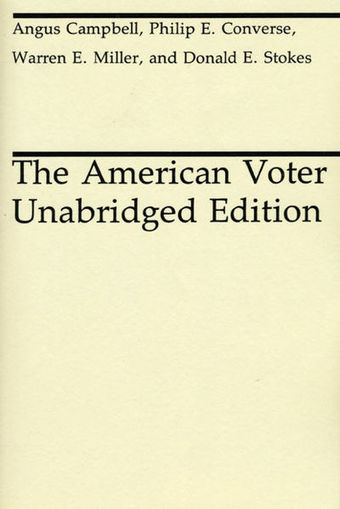
The American Voter
An image of the publication that was influenced by early ANES data.
Today ANES data are used by numerous scholars, students, and journalists. It is widely considered the “gold standard” of election studies.
The ANES also has a long history of innovation. In 2006, it opened the ANES Online Commons, becoming the first large-scale academic survey to allow interested scholars and survey professionals to propose questions for future ANES surveys.
6.3.5: Types of Polls
The main types of polls are: opinion, benchmark, bushfire, entrance, exit, deliberative opinion, tracking, and the straw poll.
Learning Objective
Compare and contrast the different types of polls utilized to measure public opinion
Key Points
- Benchmark polls, brushfire polls and tracking polls are used by political campaigns to gauge interest in a candidate’s office bid, the success of his/her messaging, and his/her weekly standing. Tracking polls may also be used by news organizations to inform their own reports of the campaign.
- A push poll is an interactive marketing technique, most commonly employed during political campaigning, in which an individual or organization attempts to influence or alter the view of respondents under the guise of conducting a legitimate poll.
- A straw poll, or straw vote, is a poll with nonbinding results. In meetings subject to rules of order, impromptu straw polls often are taken to see if there is enough support for an idea to devote more meeting time to it, and for the attendees to see who is on which side of a question.
Key Terms
- Entrance Poll
-
An entrance poll is taken directly before voters cast their votes; the voter is unlikely change his/her mind after the poll, typically making the margin of error lower than that of an opinion poll.
- Tracking Poll
-
A tracking poll is a poll repeated at intervals generally averaged over a trailing window.
- Exit Poll
-
An exit poll is taken immediately after the voters have exited the polling stations. Pollsters conduct exit polls to gain an early indication as to how an election has turned out.
Types of Polls
There are nine main types of polls :
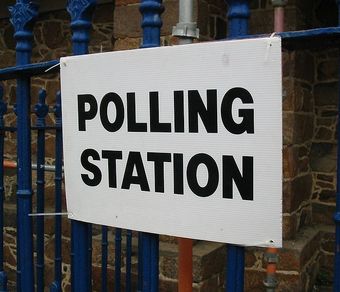
Poling Station
A polling place in New Jersey during the United States presidential election, 2008
- An opinion poll is a survey of public opinion from a particular sample. Opinion polls are usually designed to represent the opinions of a population by asking a series of questions and then extrapolating generalities from responses in ratio or within confidence intervals.
- A benchmark poll is generally the first poll taken in a campaign. It is often taken before a candidate announces his or her bid for office, but sometimes it occurs immediately following the announcement, allowing some opportunity to raise funds. This poll is generally a short and simple survey of likely voters.
- Brushfire polls are polls taken during the period between the benchmark and tracking polls. The number of brushfire polls taken by a campaign is determined by how competitive the race is and how much money the campaign has to spend. These polls usually focus on likely voters and the length of the survey varies on the number of messages being tested.
- A tracking poll is a poll repeated at intervals generally averaged over a trailing window. A weekly tracking poll uses the data from the past week and discards older data.
- An entrance poll is a poll that is taken before voters cast their votes. It is akin to an opinion poll in the sense that it asks who the voter plans to vote for and other similar questions. The possibility that the prospective voter might change his or her mind after the poll is very small compared to that of an opinion poll; therefore, the margin of error of an entrance poll is expected to be lower than that of an opinion poll.
- An exit poll is taken immediately after the voters have exited the polling stations. Pollsters —usually private companies working for newspapers or broadcasters—conduct exit polls to gain an early indication as to how an election has turned out, since in many elections the actual result may take hours or even days to count. Exit polls have historically and throughout the world been used as a check against and rough indicator of the degree of election fraud. Like all opinion polls, exit polls by nature do include a margin of error. A famous example of exit poll error occurred in the 1992 UK General Election, when two exit polls predicted a hung parliament. Widespread criticism of exit polling has occurred in cases, especially in the United States, where exit-poll results have appeared and/or have provided a basis for projecting winners before all real polls have closed, thereby possibly influencing election results
- The deliberative opinion poll is a form of opinion poll that incorporates the principles of deliberative democracy. In the deliberative opinion poll, a statistically representative sample of a community is gathered to discuss an issue in conditions that further deliberation. The group is then polled, and the results of the poll and the actual deliberation can be used both as a recommending force and, in certain circumstances, to replace a vote. Rather than simply determining existing public opinion, a deliberative poll aims to understand what public opinion would be if the public were well-informed and had carefully discussed a particular issue. Citizens are invited by modern random sampling techniques to participate; a large enough sampling group will provide a relatively accurate representation of public opinion.
- A push poll is an interactive marketing technique, most commonly employed during political campaigning, in which an individual or organization attempts to influence or alter the view of respondents under the guise of conducting a poll. In a push poll, large numbers of respondents are contacted and little or no effort is made to collect and analyze response data. Instead, the push poll is a form of telemarketing-based propaganda masquerading as a poll and is generally viewed as a form of negative campaigning. This tactic is commonly considered to undermine the democratic process since false or misleading information is often provided about candidates. Push polling has been condemned by the American Association of Political Consultants and the American Association for Public Opinion Research. The term is also used in a broader sense to refer to legitimate polls that aim to test political messages, some of which may be negative. In all such polls, the pollster asks leading or suggestive questions that “push” the interviewee towards adopting an unfavorable response towards the political candidate.
- A straw poll or straw vote is a poll with nonbinding results. Straw polls provide dialogue among movements within large groups. In meetings subject to rules of order, impromptu straw polls often are taken to see if there is enough support for an idea to devote more meeting time to it, and (when not a secret ballot) for the attendees to see who is on which side of a question.
6.3.6: Conducting Polls
Steps to conduct a poll effectively including identifying a sample, evaluating poll questions, and selecting a question and response mode.
Learning Objective
Describe the various methods taken by pollsters to conduct surveys
Key Points
- A questionnaire is a series of questions asked to individuals to obtain statistically useful information about a given topic. When properly constructed and responsibly administered, questionnaires become a vital instrument for polling a population.
- Inappropriate questions, incorrect ordering of questions, incorrect scaling, or bad questionnaire format can make the survey valueless, as it may not accurately reflect the views and opinions of the participants.
- According to the three stage theory, or the sandwich theory, initial questions should be screening and rapport questions. The second stage should concern the product specific questions. In the last stage demographic questions are asked.
Key Terms
- Stratified Sampling
-
Stratified sampling is a method of probability sampling such that sub-populations within an overall population are identified and included in the sample selected in a balanced way.
- Open-Ended Question
-
An open-ended question asks the respondent to formulate his/her own answer.
- Closed-Ended Question
-
A closed-ended question asks the respondent to pick an answer from a given number of options.
Conducting Polls
Generally, in order to conduct a poll, the survey methodologist must do the following :

Questionnaire
This is an example of a questionnaire.
- Identify and select potential sample members
- Contact sampled individuals and collect data from those who are difficult to reach
- Evaluate and test questions
- Select the mode for posing questions and collecting responses
- Train and supervise interviewers
- Check data files for accuracy and internal consistency
- Adjust survey estimates to correct for identified errors
Survey samples can be broadly divided into two types: probability samples and non-probability samples. Stratified sampling is a method of probability sampling such that sub-populations within an overall population are identified and included in the sample.
Usually, a poll consists of a number of questions that the respondent answers in a set format. A distinction is made between open-ended and closed-ended questions. An open-ended question asks the respondent to formulate his or her own answer; a closed-ended question asks the respondent to pick an answer from a given number of options. The response options for a closed-ended question should be exhaustive and mutually exclusive. Four types of response scales for closed-ended questions are as follows:
- Dichotomous: the respondent has two options
- Nominal-polytomous: the respondent has more than two unordered options
- Ordinal-polytomous: the respondent has more than two ordered options
- (bounded) Continuous: the respondent is presented with a continuous scale
A respondent’s answer to an open-ended question can be coded into a response scale or analyzed using more qualitative methods.
A questionnaire is a series of questions asked to individuals to obtain statistically useful information about a given topic. When properly constructed and responsibly administered, questionnaires become a vital instrument for polling a population.
Adequate questionnaire construction is critical to the success of a poll. Inappropriate questions, incorrect ordering of questions, incorrect scaling, or bad questionnaire format can make the survey valueless, as it may not accurately reflect the views and opinions of the participants. Pretesting among a smaller subset of target respondents is useful method of checking a questionnaire and making sure it accurately captures the intended information.
Questionnaire construction issues
The topics should fit the respondents’ frame of reference. Their background may affect their interpretation of the questions. Respondents should have enough information or expertise to answer the questions truthfully.
The type of scale, index, or typology to be used is determined. The level of measurement used determines what can be concluded from the data. If the response option is yes/no then you will only know how many, or what percent, of your sample answered yes/no. You cannot, however, conclude what the average respondent answered.
The types of questions (closed, multiple-choice, open) should fit the statistical data analysis techniques available and the goals of the poll. Questions and prepared responses should be unbiased and neutral as to intended outcome. The order or “natural” grouping of questions is often relevant. Prior previous questions may bias later questions. Also, the wording should be kept simple: no technical or specialized vocabulary. The meaning should be clear. Ambiguous words, equivocal sentence structures and negatives may cause misunderstanding, possibly invalidating questionnaire results. Care should be taken to ask one question at a time. The list of possible responses should be collectively exhaustive. Respondents should not find themselves without category that fits them. Additionally, possible responses should be mutually exclusive; categories should not overlap. Writing style should be conversational, concise, accurate and appropriate to the target audience. “Loaded” questions evoke emotional responses and may skew results.
Many respondents will not answer personal or intimate questions. For this reason, questions about age, income, marital status, etc., are generally placed at the end of the survey. Thus, if the respondent refuses to answer these questions, the research questions will have already been answered.
Presentation of the questions on the page (or computer screen) and the use of graphics may affect a respondent’s interest or distract from the questions.
Finally, questionnaires can be administered by research staff, by volunteers or self-administered by the respondents. Clear, detailed instructions are needed in either case, matching the needs of each audience.
Question sequence
Some further considerations about questionnaires are the following.
Questions should flow logically from one to the next, from the more general to the more specific, from the least sensitive to the most sensitive, from factual and behavioral questions to attitudinal and opinion questions, from unaided to aided questions.
Finally, according to the three stage theory, or the sandwich theory, initial questions should be screening and rapport questions. The second stage should concern the product specific questions. In the last stage demographic questions are asked.
6.3.7: Analyzing Data
A very important tool in data analysis is the margin of error because it indicates how closely the results of the survey reflect reality.
Learning Objective
Discuss how data is broken down and subject to analysis after conducting surveys
Key Points
- The margin of error is usually defined as the “radius” of a confidence interval for a particular statistic from a survey.
- The confidence level, the sample design for a survey, and in particular its sample size, determine the magnitude of the margin of error. A larger sample size produces a smaller margin of error, all else remaining equal.
- The margin of error for a particular sampling method is essentially the same regardless of whether the population of interest is the size of a school, city, state, or country, as long as the sampling fraction is less than 5%.
Key Terms
- margin of error
-
expression of the lack of precision in the results obtained from a sample
- Finite Population Correction
-
The “finite population correction” (FPC) is used to adjust the margin of error to account for the added precision gained by sampling a larger percentage of the population.
- margin of error
-
The margin of error is a statistic that expresses the amount of random sampling error in a survey’s results.
The margin of error is a statistic used to analyze data. It expresses the amount of random sampling error in a survey’s results. The larger the margin of error, the less faith one should have that the poll’s reported results are close to the “true” figures—the figures for the whole population .
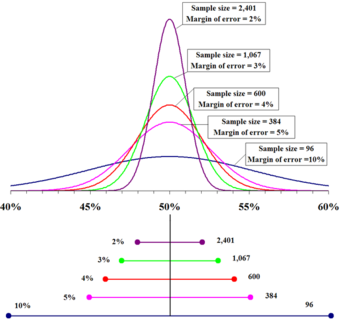
Margin of Error
This normal distribution curve illustrates the points of various margin of errors.
Explanation
The margin of error is usually defined as the “radius” of a confidence interval for a particular statistic from a survey. When a single, global margin of error is reported for a survey, it refers to the maximum margin of error for all reported percentages using the full sample from the survey. If the statistic is a percentage, this maximum margin of error can be calculated as the radius of the confidence interval for a reported percentage of 50%.
The margin of error can be described as an “absolute” quantity. For example, if the true value is 50 percentage points, and the statistic has a confidence interval radius of 5 percentage points, then we say the margin of error is 5 percentage points.
However, the margin of error can also be expressed as a “relative” quantity. For example, suppose the true value is 50 people and the statistic has a confidence interval radius of 5 people. If we use the “relative” definition, then we express this absolute margin of error as a percent of the true value. Therefore, the absolute margin of error is 5 people, but the “percent relative” margin of error is 10% (because 5 people are ten percent of 50 people).
The margin of error can be defined for any desired confidence level, but usually a level of 90%, 95%, or 99% is chosen. This level is the probability that a margin of error around the reported percentage would include the “true” percentage. The confidence level, the sample design for a survey, and in particular its sample size, determines the magnitude of the margin of error. A larger sample size produces a smaller margin of error, all else remaining equal.
If the exact confidence intervals are used the margin of error takes into account both sampling error and non-sampling error. If an approximate confidence interval is used then the margin of error may only take random sampling error into account. It does not represent other potential sources of error or bias such as a non-representative sample-design, poorly phrased questions, people lying or refusing to respond, the exclusion of people who could not be contacted, or miscounts and miscalculations.
Basic Concept
Polls typically involve taking a sample from a certain population. In the case of the Newsweek 2004 Presidential Election poll, the population of interest was the population of people who would vote. Sampling theory provides methods for calculating the probability that the poll results differ from reality by more than a certain amount simply due to chance. For example, if the poll reports 47% for Kerry, his support could actually be as high as 50% or as low as 44%. The more people that are sampled, the more confident pollsters can be that the “true” percentage is close to the observed percentage. The margin of error is a measure of how close the results are likely to be.
Effect of Population Size
The margin of error for a particular sampling method is essentially the same regardless of whether the population of interest is the size of a school, city, state, or country, as long as the sampling fraction is less than 5%.
In cases where the sampling fraction exceeds 5%, analysts can adjust the margin of error using a “finite population correction” (FPC) to account for the added precision gained by sampling a larger percentage of the population.
The FPC, factored into the calculation of the margin of error, has the effect of narrowing the margin of error. It holds that the FPC approaches zero as the sample size approaches the population size, which has the effect of eliminating the margin of error entirely.
Comparing Percentages
The terms “statistical tie” and “statistical dead heat” are sometimes used to describe reported percentages that differ by less than a margin of error, but these terms can be misleading. For one thing, the margin of error as generally calculated is applicable to an individual percentage and not the difference between percentages. The difference between two percentage estimates may not be statistically significant even when they differ by more than the reported margin of error. The survey results also usually provide strong information even when there is not a statistically significant difference.
6.3.8: Sampling Techniques
Sampling is concerned with choosing a subset of individuals from a statistical population to estimate characteristics of a whole population.
Learning Objective
Compare and contrast the different sampling techniques used for opinion polls
Key Points
- Probability-proportional-to-size (PPS) is sampling in which the selection probability for each element is set to be proportional to its size measure, up to 1. This approach can improve accuracy by concentrating a sample on large elements that have the greatest impact on population estimates.
- Maintaining the randomness in a sample is very important to each sampling technique to ensure that the findings are representative of the population in general.
- Panel sampling is the method of selecting a group of participants through a random sampling method and then asking that group for the same information again several times over a period of time. This longitudinal sampling-method allows for estimates of changes in the population.
Key Terms
- Systematic Sampling
-
Systematic sampling relies on arranging the target population according to some ordering scheme, a random start, and then selecting elements at regular intervals through that ordered list.
- Simple Random Sampling
-
A simple random sampling (SRS) is a sample of a given size in which all such subsets of the frame are given an equal probability to be chosen.
- Stratified Sampling
-
Stratified sampling is a method of probability sampling such that sub-populations within an overall population are identified and included in the sample selected in a balanced way.
Sampling Techniques
In statistics and survey methodology, sampling is concerned with the selection of a subset of individuals from within a statistical population to estimate characteristics of the whole population . The three main advantages of sampling are that the cost is lower, data collection is faster, and the accuracy and quality of the data can be easily improved.

Normal Distribution Curve
The normal distribution curve can help indicate if the results of a survey are significant and what the margin of error may be.
Simple Random Sampling
In a simple random sample (SRS) of a given size, all such subsets of the frame are given an equal probability. Each element has an equal probability of selection. Furthermore, any given pair of elements has the same chance of selection as any other pair. This minimizes bias and simplifies analysis of results. In particular, the variance between individual results within the sample is a good indicator of variance in the overall population, which makes it relatively easy to estimate the accuracy of results.
However, SRS can be vulnerable to sampling error because the randomness of the selection may result in a sample that doesn’t reflect the makeup of the population.
Systematic Sampling
Systematic sampling relies on arranging the target population according to some ordering scheme, a random start, and then selecting elements at regular intervals through that ordered list. As long as the starting point is randomized, systematic sampling is a type of probability sampling. It is easy to implement and the stratification can make it efficient, if the variable by which the list is ordered is correlated with the variable of interest.
However, if periodicity is present and the period is a multiple or factor of the interval used, the sample is especially likely to be unrepresentative of the overall population, decreasing its accuracy. Another drawback of systematic sampling is that even in scenarios where it is more accurate than SRS, its theoretical properties make it difficult to quantify that accuracy. As described above, systematic sampling is an EPS method, because all elements have the same probability of selection.
Stratified Sampling
Where the population embraces many distinct categories, the frame can be organized by these categories into separate “strata. ” Each stratum is then sampled as an independent sub-population, out of which individual elements can be randomly selected. In this way, researchers can draw inferences about specific subgroups that may be lost in a more generalized random sample. Additionally, since each stratum is treated as an independent population, different sampling approaches can be applied to different strata, potentially enabling researchers to use the approach best suited for each identified subgroup. Stratified sampling can increase the cost and complicate the research design.
Probability-Proportional-to-Size Sampling
Probability-proportional-to-size (PPS) is sampling in which the selection probability for each element is set to be proportional to its size measure, up to a maximum of 1.The PPS approach can improve accuracy for a given sample size by concentrating the sample on large elements that have the greatest impact on population estimates. PPS sampling is commonly used for surveys of businesses, where element size varies greatly and auxiliary information is often available.
Cluster Sampling
Sometimes it is more cost-effective to select respondents in groups (“clusters”). Sampling is often clustered by geography or by time periods. Clustering can reduce travel and administrative costs. It also means that one does not need a sampling frame listing all elements in the target population. Instead, clusters can be chosen from a cluster-level frame, with an element-level frame created only for the selected clusters.
Cluster sampling generally increases the variability of sample estimates above that of simple random sampling, depending on how the clusters differ between themselves, as compared with the within-cluster variation.
Quota Sampling
In quota sampling, the population is first segmented into mutually exclusive subgroups, just as in stratified sampling. Then judgment is used to select the subjects or units from each segment based on a specified proportion. For example, an interviewer may be told to sample 200 females and 300 males between the age of 45 and 60. In quota sampling the selection of the sample is non-random. The problem is that these samples may be biased because not everyone gets a chance of selection.
Accidental Sampling
Accidental sampling (or grab, convenience, or opportunity sampling) is a type of non-probability sampling which involves the sample being drawn from that part of the population which is close to hand. The researcher cannot scientifically make generalizations about the total population from this sample because it would not be representative enough.
Panel Sampling
Panel sampling is the method of first selecting a group of participants through a random sampling method and then asking that group for the same information again several times over a period of time. This longitudinal sampling-method allows estimates of changes in the population.
6.3.9: The Importance of Accuracy
Polling organization will lose credibility if they publish inaccurate results.
Learning Objective
Discuss the importance of maintaining accuracy when conducting measuring public opinion
Key Points
- Relevance of the survey information, quality of the data, and overcoming personal bias are integral to polling accuracy.
- The quality of the accurate and timely results must be assessed prior to release. If errors in the results occur they should be directly corrected and the public should be informed as soon as possible.
- When social scientists speak of good research the focus is on how the research is done rather than on whether the results of the research are consistent with personal biases or preconceptions.
Key Term
- Literary Digest
-
The Literary Digest was an influential general interest weekly magazine published by Funk & Wagnalls. When the Digest conducted their 1936 election using an inaccurate sample causing them to predict the wrong winner, they lost all credibility and the Digest itself soon went out of business.
The importance of accuracy may be illustrated through the example of the Literary Digest Roosevelt-Landon presidential election poll. After correctly predicting the victories of Warren Harding in 1920, Calvin Coolidge in 1924, Herbert Hoover in 1929, and Franklin Roosevelt in 1932, the Literary Digest had established itself as a well-known and well-respected publication. One reason for their previous successes was the use of a very large sample population.
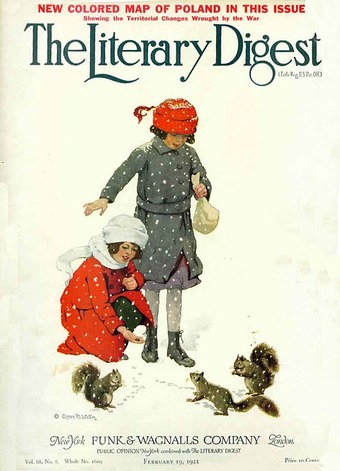
The Literary Digest
The Literary Digest conducted the first national poll.
In 1936, the Digest conducted their presidential poll with 2.3 million voters, a huge sample size. However, the sample turned out to be an inaccurate representation of the general population as those polled were generally more affluent Americans who tended to have Republican sympathies. The Literary Digest was ignorant of this new bias. The week before Election Day, it reported that Alf Landon was far more popular than Roosevelt. At the same time, George Gallup conducted a far smaller, but more scientifically based survey, in which he polled a more demographically representative sample. Gallup correctly predicted Roosevelt’s landslide victory. The Literary Digest lost its reputation for accuracy and the trust of the readers and soon went out of business.
Maintaining Polling Accuracy
Relevance of the survey information, quality of the data, and overcoming personal bias are integral to polling accuracy.
When releasing information, data and official statistics should be relevant to the needs of users as well as both public and private sector decision makers. The quality of results must be assessed prior to release. If errors in the results occur before or after the data revision, they should be corrected and users should be informed as quickly as possible. Finally, when social scientists speak of “good research,” the focus is on how the research is done–whether the research is methodologically sound–rather than on whether the results of the research are consistent with personal biases or preconceptions.
Glenn Firebaugh summarizes the principles for good research in his book Seven Rules for Social Research. He states that “there should be the possibility of surprise in social research. ” In other words, it is imperative that the researchers look past their preconceived notions or desires to conduct a study that reflects whatever the reality may be. Additionally, good research will “look for differences that make a difference” and “build in reality checks. ” Researchers are also advised to replicate their polls, that is, “to see if identical analyses yield similar results for different samples of people. ” The next two rules urge researchers to “compare like with like” and to “study change;” these two rules are especially important when researchers want to estimate the effect of one variable on another. The final rule, “let method be the servant, not the master,” reminds researchers that methods are the means, not the end, of social research; it is critical from the outset to fit the research design to the research issue, rather than the other way around.
6.3.10: The Problems with Polls
Problems with polls typically stem either from issues with the methodology that bias the sample or the responses that cause the bias.
Learning Objective
Identify some of the common problems with conducting opinion polls
Key Points
- It is well established that the wording of the questions, the order in which they are asked, and the number and form of alternative answers offered can influence results of polls.
- Coverage bias is another source of error involving the use of samples that are not representative of the population due to the polling methodology.
- Self-selection bias arises in any situation in which individuals select themselves into a group, causing a biased sample with non-probability sampling.
Key Term
- Literary Digest
-
The Literary Digest was an influential general interest weekly magazine published by Funk & Wagnalls. When the Digest conducted their 1936 election using an inaccurate sample causing them to predict the wrong winner, they lost all credibility and the Digest itself soon went out of business.
Potential for Inaccuracy
In practice, pollsters need to balance the cost of a large sample with the reduction in sampling error. A sample size of around 500 – 1,000 is a typical compromise for political polls . Another way to reduce the margin of error is to rely on poll averages. This method is based on the assumption that the procedure and sample size is similar enough between many different polls to justify creating a polling average.

Venn Diagram: A Subset B
This Venn diagram illustrates the sample population within the larger, general population.
Another source of error stems from faulty demographic models by pollsters who weigh their samples by particular variables such as party identification in an election. For example, one could assume that the breakdown of the US population by party identification has not changed since the previous presidential election. As a result, one would underestimate a victory or a defeat of a particular party candidate that saw a surge or decline in its party registration relative to the previous presidential election cycle.
Theories on Erroneous Polling Results
A number of theories and mechanisms have been offered to explain erroneous polling results. Some of these reflect errors on the part of the pollsters; many of them are statistical in nature. Others blame the respondents for not giving candid answers (the controversial Bradley effect & Shy Tory Factor).
Non-response Bias
Since some people do not answer calls from strangers or refuse to answer the poll, poll samples may not be representative samples from a population due to a non-response bias. Because of this selection bias, the characteristics of those who agree to be interviewed may be markedly different from those who decline. That is, the actual sample is a biased version of the universe the pollster wants to analyze. In these cases, bias introduces new errors, in addition to errors caused by sample size. Error due to bias does not become smaller with larger sample sizes–taking a larger sample size simply repeats the same mistake on a larger scale.
Response Bias
Surveys may be affected by response bias, where the answers given by respondents do not reflect their true beliefs. This may be deliberately engineered by unscrupulous pollsters in order to generate a certain result or please their clients, but more often is a result of the detailed wording or ordering of questions. Respondents may deliberately try to manipulate the outcome of a poll by advocating a more extreme position than they actually hold in order to boost their side of the argument or give rapid and ill-considered answers in order to hasten the end of their questioning. Respondents may also feel under social pressure not to give an unpopular answer. In American political parlance, this phenomenon is often referred to as the Bradley effect. If the results of surveys are widely publicized this effect may be magnified in a phenomenon commonly referred to as the spiral of silence.
Wording of Questions
It is well established that the wording of the questions, the order in which they are asked, and the number and form of alternative answers offered can influence results of polls. For instance, the public is more likely to indicate support for a person who is described by the operator as one of the “leading candidates. “
A common technique to control for this bias is to rotate the order in which questions are asked. Many pollsters also split-sample in that one of two different versions of a question are presented to half the respondents.
Coverage Bias
Another source of error is the use of samples that are not representative of the population as a consequence of the polling methodology. For example, telephone sampling has a built-in error because in many times and places, those with telephones have generally been richer than those without.
Selection Bias
Selection bias occurs when some units have a differing probability of selection that is unaccounted for by the researcher. For example, some households have multiple phone numbers making them more likely to be selected in a telephone survey than households with only one phone number.
In statistics, self-selection bias arises in any situation in which individuals select themselves into a group, causing a biased sample with non-probability sampling. It is commonly used to describe situations where the characteristics of the people which cause them to select themselves in the group create abnormal or undesirable conditions in the group.
There may be a purposeful intent on the part of respondents leading to self-selection bias whereas other types of selection bias may arise more inadvertently, possibly as the result of mistakes by those designing any given study.
6.3.11: Telephone and Internet Polling
Internet and telephone polls are very useful as they are much cheaper than most other polls and are able to reach a wide population.
Learning Objective
Identify the advantages and disadvantages of telephone and internet polling
Key Points
- Probability samples of internet polls are highly affected by problems of non-coverage. Not all members of the general population have Internet. In addition, online survey invitations are distributed using e-mail, but there are no e-mail directories of the general population.
- Online survey may be affected by non-response as response rates are generally low and vary extremely. Some may refuse participation, terminate surveys during the process, or not answer certain questions.
- Telephone interviewers encourage sample persons to respond, leading to higher response rates and interviewers may increase comprehension of questions by answering respondents’ questions.
- There are some disadvantages to telephone polling such as interviewer bias, the fact it cannot be used for non-audio information, and it is unreliable for consumer surveys in rural areas where telephone density is low.
Key Terms
- Telephone Polling
-
Telephone polling is also fairly cost efficient, depending on local call charge structure, which makes it good for large national (or international) sampling frames.
- Internet Polls
-
Internet polls are becoming an essential research tool for a variety of research fields, including marketing and official statistics research. Web polls are faster, simpler, and cheaper than many other polling methods.
Internet polls
Online polls are becoming an essential research tool for a variety of research fields, including marketing and official statistics research.
Advantages of Internet Surveys
Web polls are faster, simpler, and cheaper than many other polling methods. However, lower costs are not so straightforward in practice, as they are strongly interconnected to errors. Because response rate comparisons to other survey modes are usually not favorable for online surveys, efforts to achieve a higher response rate may substantially increase costs. Additionally, the entire data collection period is significantly shortened, as all data can be collected and processed in typically little more than a month.
Interaction between the respondent and the questionnaire is also more dynamic compared to e-mail or paper surveys. Online surveys are also less intrusive, and they suffer less from social desirability effects. Questions with long lists of answer choices can be used to provide immediate coding of answers to certain questions that are usually asked in an open-ended fashion in paper questionnaires. Finally, online surveys can be tailored to the situation (the questionnaire may be preloaded with already available information).
Methodological Issues of Online Surveys
Sampling
The difference between probability samples (where the inclusion probabilities for all units of the target population is known in advance) and non-probability samples (which often require less time and effort but generally do not support statistical inference) is crucial. Probability samples are highly affected by problems of non-coverage (not all members of the general population have Internet access) and frame problems (online survey invitations are most conveniently distributed using e-mail, but there are no e-mail directories of the general population that might be used as a sampling frame). Because coverage and frame problems can significantly impact data quality, they should be adequately reported when disseminating the research results.
Invitations to Online Surveys
Due to the lack of sampling frames, many online survey invitations are published in the form of an URL link on web sites or in other media, which leads to sample selection bias that is out of research control and to non-probability samples. Traditional solicitation modes, such as telephone or mail invitations to web surveys, can help overcoming probability sampling issues in online surveys. However, such approaches are faced with problems of dramatically higher costs and questionable effectiveness.
Non-response
Online survey response rates are generally low and also vary extremely. In addition to refusing participation, terminating surveying during the process, or not answering certain questions, several other non-response patterns can be observed in online surveys, such as lurking respondents and a combination of partial and item non-response. Response rates can be increased by offering monetary or some other type of incentive to the respondents, by contacting respondents several times, and by keeping the questionnaire difficulty as low as possible.
Questionnaire Design
The use of design features should be limited to the extent necessary for respondents to understand questions or to stimulate the response. The features should not affect their response as that would mean lower validity and reliability of data.
It is important that uncontrolled variations in how a questionnaire appears are minimized. Web-based survey methods make the construction and delivery of questionnaire instruments relatively easy, but what is difficult to ensure is that everyone sees the questionnaire as its designer intended it to be. This problem can arise due to the variability of software and hardware used by respondents.
Telephone Polling
An important aspect of telephone polling is the use of interviewers. Interviewers encourage sample persons to respond, leading to higher response rates and interviewers may increase comprehension of questions by answering respondents’ questions.
Telephone polling is also fairly cost efficient, depending on local call charge structure, which makes it good for large national (or international) sampling frames .
However, there are some disadvantages to telephone polling. For instance, there is some potential for interviewer bias (e.g. some people may be more willing to discuss a sensitive issue with a female interviewer than with a male one), telephone polling cannot be used for non-audio information (graphics, demonstrations, taste/smell samples), and it is unreliable for consumer surveys in rural areas where telephone density is low .
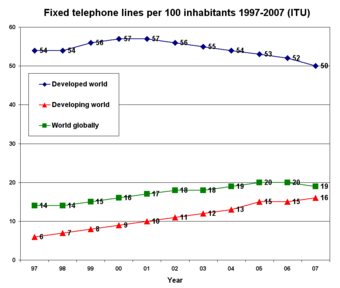
Number of fixed telephone lines globally
This chart shows the numbers of fixed telephone lines from 1997 to 2007.
There are three main types of telephone polling: traditional telephone interviews, computer assisted telephone dialing, and computer assisted telephone interviewing ( CATI ).
Chapter 5: Civil Rights
5.1: Slavery and Civil Rights
5.1.1: Slavery and the Abolitionist Movement
Slavery continued until 1865, when abolitionists argued against its conditions as violating Christian principals and rights to equality.
Learning Objective
Describe the history of slavery in the United States and early efforts at abolition
Key Points
- By 1860, four million people lived in slavery in the US. Most were people who had been brought from Africa and their descendants.
- Most people living as slaves worked in agriculture, including in the cotton industry, which was a key industry in the southern states. Enslaved people had few rights and were often subjected to harsh and violent living conditions.
- Abolitionists argued against slavery because of its harsh conditions, and through claims that slavery violated Christian principals and the natural rights of all people for equality.
- Most Northern states moved to end slavery by 1804.
- Freed slaves often continued to face racial segregation and discrimination.
- The conflict over slavery became a key catalyst for the Civil War.
Key Terms
- manumission
-
release from slavery, freedom, the act of manumitting
- Underground Railway
-
a network of secret routes and safe houses used by 19th-century black slaves in the United States to escape to free states and Canada with the aid of abolitionists and allies who were sympathetic to their cause
- chattel slavery
-
people are treated as the personal property, chattels, of an owner and are bought and sold as commodities
Slavery in the US
While the US was founded on principles of representation, due process and universal rights, slavery remained one of the most persistent and visible exceptions to these ideals.
Slavery, including chattel slavery, was a legal institution in the US from the colonial period until the Emancipation Proclamation (1863) and Thirteenth Amendment of the Constitution (1865). Most slaves in the US were people brought from Africa and their descendants, and this racial dimension of US slavery continues to impact US civil rights debates. By 1860, four million people lived as slaves in the US, and most worked in the agriculture sector. The rise in the southern cotton industry after 1800 also led to a steady increase in slavery, which then became a major catalyst for the Civil War.
Conditions of Slavery
The conditions of slavery were harsh, starting with the “middle passage” where Africans were stuffed into the hulls of ships like cargo. Some fifteen percent of enslaved people are estimated to have died during travel from Africa. In the US the conditions of slavery acted to dehumanize enslaved people denying them even basic rights. The use of native languages was banned, and it was illegal to learn or teach reading and writing. Marriages were banned, and children were often taken away from parents to be sold. It was also common for slave owners to sexually assault enslaved women. Finally, working conditions were long and hard, especially for field workers, and violence was an ever present part of life.
Abolition
Throughout this period many people worked to end slavery. Early abolitionist legislation included Congress prohibiting slavery in the Northwest Territory (1787), and a ban on the import or export of slaves (1808) in the US and Britain. Resistance to slavery also took other forms including institutions such as the Underground Railway that helped escaping slaves make their way to freedom.
Abolitionists came from various communities including religious groups such as the Quakers, white anti-slavery activists such as Harriet Beecher Stowe, and former slaves and free people of color such as Frederick Douglass, Robert Purvis and James Forten. While some abolitionists called for an immediate end to slavery, others favored more gradual approaches. These included the banning of slavery in the territories, and manumission campaigns encouraging individual owners to free slaves.
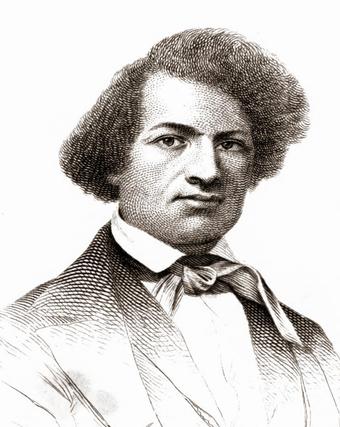
Frederick Douglass
Frederick Douglass was a freed slave prominent abolitionist and rights advocate.
Arguments against Slavery
Abolitionists used several arguments against slavery. As early as 1688, Quakers in Germantown, Pennsylvania presented a petition to end slavery based on religious obligation and natural rights to equality. In 1774, a group of enslaved people in Massachusetts petitioned the governor against slavery used similar arguments including the natural rights of all people, the demands of Christian brotherhood, and the harsh conditions of slavery. By the 1830s, evangelical groups became quite active in the abolitionist movement including the formation of the American Anti-Slavery Society in 1833. These groups often also supported other reform movements such as temperance movements and supports for public schools.
Early politicians and constitutional authors including Thomas Paine, Alexander Hamilton and Thomas Jefferson also had reservations about slavery because of their commitment to equal rights. However, many of these same politicians also owned slaves.
Gradual Abolition and Conflict
By 1804, most of the northern states had moved towards the abolition of slavery. although this process was quite gradual, and freed slaves were often subject to racial segregation and discrimination. Manumission campaigns in the Upper South were also successful in increasing the number of free people of color in Virginia, Maryland and Delaware where, by 1810, three-quarters of Black people in Delaware were free.
Support for slavery remained the strongest in the southern states where slavery was an important economic institution for cotton and other agricultural industries strongest in the South. The conflict over slavery became a key catalyst for the Civil War that divided northern and southern states.
5.1.2: Abolitionism and the Women’s Rights Movement
Many women involved in the early abolitionist movement went on to be important leaders in the early women’s rights and suffrage movements.
Learning Objective
Describe the relationship between the women’s rights and anti-slavery movements
Key Points
- There were many progressive movements active in the pre-civil war era. The abolition and women’s rights movement were two of the most important.
- The two movements tied together as many women involved in early abolition became leaders in the women’s rights and suffrage movements.
- The women’s rights movement applied the arguments for human rights and equality used in the abolition movement to their own lives and demanded equal consideration for women.
- There were divisions within the abolition movement over the role of women, and whether they should be subordinate, or if it was appropriate for women to take more public or leadership roles in the movement.
- While the pre-civil war women’s rights movement had few major victories it set the ground work for the suffrage campaigns that would occur in the early 20th century, along with women’s rights, feminist and women of color movements that continue today.
Key Terms
- women’s rights movement
-
the political and social actions of individuals and organizations focused on the empowerment and equal treatment of women
- suffrage
-
The right or chance to vote, express an opinion, or participate in a decision.
Progressive Pre-War Period
A wide variety of progressive movements grew up during the decades leading up to the US Civil War. The activists involved hoped to make significant changes in society, including expanding rights and freedoms to a larger group of people living in the US.
Two of the most influential were the anti-slavery or abolitionist movement, and the women’s rights movement. These were also closely related as many of the women who would go on to be leaders in the women’s rights movement got their political start in the abolitionist movement.
While many women were active in the abolitionist movement they were often kept out of public, leadership and decision making positions. For example only two women attended the Agents’ Convention of the American Anti-Slavery Society in 1836. Women began to form their own abolition groups, organizing events such as the Anti-Slavery Convention of American Women held in 1837. This convention brought 200 women to New York City, where they called for the immediate abolition of slavery in the US. The delegates argued for an end to slavery based on the often brutal conditions of slavery, as well as the ways in which slavery violated christian principals and basic human right to equality.
Women’s Rights Movement
Women involved in the early abolitionists movement also began to connect demands for equal right to their own lives and experiences, advocating for expanded education, employment and political rights including suffrage.
The 1848 Seneca Falls convention is one of the key early moments in the suffrage and women’s rights movement in the US. The convention was organized primarily by a group of Quaker women during a visit by Lucretia Mott, a Quaker woman well known for her role in the abolition movement and advocacy for women’s rights. The convention brought together 300 people, men and women, and produced a strong Declaration of Sentiments advocating for women’s equality including the right to vote.
The Intersection of Race and Gender
As progressive movements grew, several divisions developed often over questions of identity and especially over the role women and people of color in the movements. In terms of Abolition more incremental groups preferred advocating against the expansion of slavery, but would often stop short of calling for full or immediate abolition. Supporters of this strategy often also advocated for colonization for freed slaves, a strategy that would see emancipated people sent to colonies established in Africa, such as Liberia.
Many advocates of incremental abolition and colonization also held more traditional views on the role of women, claiming that women should play a supporting role in both the abolitionist movement and in society more generally.
A more progressive and radical strain of abolition maintained that rights and moral standing were universal, and that whether people were of African or European decent, men or women they were all due to equal treatment and rights.
A well-known exchange between Catherine Beecher and Angelina Grimké two prominent women activists and writers highlighted these two perspectives. Beecher argued women should remain subordinate by divine law in her Essay on Slavery and Abolitionism with Reference to the Duty of American Females. While Grimké asserts the rights of women to engage in all political institutions that impact their lives.
The role of Black women in the suffrage movement was also sometimes problematic. For example, both emancipated women who had been slaves and free women of color were active in the abolitionist movement, but as the women’s movement grew there was often resistance on the part of the increasingly middle class, educated, white leadership to include Black women. For example while Sojourner Truth spoke to the Women’s Convention in Akron Ohio in 1851 there were conflicting reports over how the speech was received. Some claimed delegates welcomed both the speaker and message, and others claimed that delegates were hostile to having a Black speaker address them.
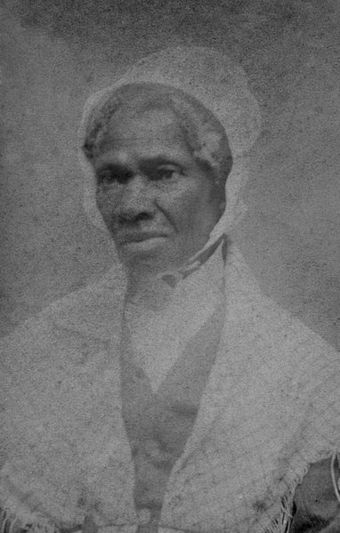
Sojourner Truth
Sojourner Truth who had been bom into slavery won her own freedom and became a prominent abolitionist and women’s rights advocate.
Outcomes and Legacy
While women did not gain the right to vote in all sates until 1920, there were still some victories won for women’s rights in the period leading up to the Civil War. One of the most notable was New York State granting property rights to married women. This period of activism also set the foundation for the suffrage campaigns that would occur in the early 20th century, along with women’s rights, feminist and women of color movements that continue today.
5.1.3: The Civil War Amendments
The Civil War Amendments protected equality for emancipated slaves by banning slavery, defining citizenship, and ensuring voting rights.
Learning Objective
Identify the key provisions of the three Civil War amendments
Key Points
- The 13th, 14th, and 15th Amendments, known collectively as the Civil War Amendments, were designed to ensure equality for recently emancipated slaves.
- The 13th Amendment banned slavery and all involuntary servitude, except in the case of punishment for a crime.
- The 14th Amendment defined a citizen as any person born in or naturalized in the United States, overturning the Dred Scott V. Sandford (1857) Supreme Court ruling stating that Black people were not eligible for citizenship.
- The 15th Amendment prohibited governments from denying U.S. citizens the right to vote based on race, color, or past servitude.
Key Terms
- Emancipation Proclamation
-
An executive order issued by Abraham Lincoln on January 1, 1863, during the American Civil War. It proclaimed the freedom of slaves in 10 states that were still in rebellion.
- Jim Crow
-
Southern United States racist and segregationist policies in the late 1800’s and early to mid 1900’s, taken collectively.
- Civil War Amendments
-
The 13th, 14th, and 15th Amendments to the United States Constitution.
The Civil War Amendments
The 13th (1865), 14th (1868), and 15th Amendments (1870) were the first amendments made to the U.S. constitution in 60 years. Known collectively as the Civil War Amendments, they were designed to ensure the equality for recently emancipated slaves.
While the Emancipation Proclamation ended slavery in the 10 states that were still in rebellion, many citizens were concerned that the rights granted by war-time legislation would be overturned. The Republican Party controlled congress and pushed for constitutional amendments that would be more permanent and binding. The three amendments prohibited slavery, granted citizenship rights to all people born or naturalized in the United States regardless of race, and prohibited governments from infringing on voting rights based on race or past servitude.
The 13th Amendment
This amendment explicitly banned slavery and involuntary servitude in the United States. An exception was made for punishment of a crime. This amendment also gave Congress the power to enforce the article through legislation.
The 14th Amendment
This amendment set out the definitions and rights of citizenship in the United States. The first clause asserted that anyone born or naturalized in the United States is a citizen of the United States and of the state in which they live. It also confirmed the right to due process, life, liberty, and property. This overturned the Dred Scott v. Sandford (1857) Supreme Court ruling that stated that black people were not eligible for citizenship.
The amendment also defined the formula for determining political representation by apportioning representatives among states based on a count of all residents as whole persons. This contrasted with the pre-Civil War compromise that counted enslaved people as three-fifth in representation enumeration. Southern slave owners wanted slaves counted as whole people to increase the representation of southern states in Congress. Even after the 14th Amendment, native people not paying taxes were not counted for representation.
Finally, the amendment dealt with the Union officers, politicians, and debt. It banned any person who had engaged in insurrection or rebellion against the United States from holding civil or military office. Finally, it declared that no debt undertaken by the Confederacy would be assumed by the United States.
The 15th Amendment
This amendment prohibited governments from denying U.S. citizens the right to vote based on race, color, or past servitude.
While the amendment provided legal protection for voting rights based on race, there were other means that could be used to block black citizens from voting. These included poll taxes and literacy tests. These methods were employed around the country to undermine the Civil War Amendments and set the stage for Jim Crow conditions and for the Civil Rights Movement.
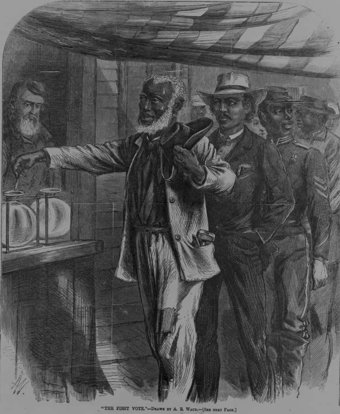
The First Vote
This image depicts the first black voters going the polls.
5.1.4: The NAACP
The NAACP, which was founded in 1909, advocates for full civil liberties and an end to racial discrimination and violence.
Learning Objective
Identify the key figures and groups working for racial equality in early twentieth-century America
Key Points
- Discrimination and violence against people of color and especially Black people continued into the 1900s, and led several groups to organize against discrimination.
- The NAACP was founded in 1909, and organized around full civil liberties and and end to racial discrimination and violence including lynching.
- The NAACP focused on local organizing with 300 branches by 1919.
- The NAACP’s worked continued to evolve and they organized campaigns around voting rights, education and employment.
Key Term
- lynching
-
Execution of a person by mob action without due process of law, especially hanging.
Organizing for Equality: The NAACP
At the beginning of the 1900s the conditions for people of color, and particularly Black people in the US were incredibly unequal. Most Black people in the US were descendants of people who had lived in slavery in the US, and particularly in the South they experienced legal segregation, limitations on civil rights and liberties, and high rates of violence including lynching. During this period several groups began organizing, particularly around defending rights won under the thirteenth, fourteenth and fifteenth amendments. The NAACP (National Association for the Advancement of Colored People) was one of these groups.
W.E.B. Du Bois and the Niagara Movement
W.E.B. Du Bois was a scholar and activist committed to full civil rights for all people. His worked extended beyond the US, and he was also a Pan-Africanist and supported anti-colonial actions in Africa and Asia.
In 1905 Du Bois along with William Monroe Trotter convened the first meeting of the Niagara Movement in Niagara Falls in Ontario. This group of Black activists and scholars called for full civil liberties and an end to racial discrimination. Their approach contrasted with other groups at the time calling for more gradual reform.
The NAACP
In 1909 the NAACP formed, the fist call for a meeting was send out by a group of white liberals appalled by the continued violence committed against Black people in the US . W.E.B. Du Bois was one of a small group of Black participants in the first meeting, and his focus on defending the rights granted in the thirteenth, fourteenth and fifteenth amendments and eliminate race prejudice were adopted by the group.
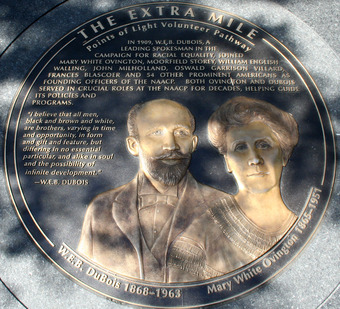
The NAACP
W.E.B. Du Bois and Mary White Ovington were two of the founding officers of the NAACP.
The NAACP focused on recruiting members and local organizing. Branch offices were established in cities such as Washington DC, Kansas City MO, Detroit MI, and Boston MA. by 1919 they had tens of thousands of members and hundreds of local chapters.
In the early years the NAACP campaigned vigorously against lynching, voter suppression laws, for education rights, and blocked the nomination of a segregationist Supreme Court Judge. During the great depression the NAACP moved to organizing around the disproportionate impact of the depression on Black workers, and worked with willing unions to help secure jobs.
5.1.5: Litigating for Equality After World War II
Post-WWI civil rights were expanded through court rulings such as Brown v. Board of Education (1954), which helped integrate public schools.
Learning Objective
Describe the decision in Brown v. Board of Education
Key Points
- The period after World War II saw a great expansion in Civil Rights. This was achieved through a diversity of tactics including ongoing litigation.
- The best know case from this period is Brown v. Board of Education (1954), a Supreme Court case in which justices unanimously decided to reverse the principle of separate but equal. The decision led to the legal integration of public schools.
- While Brown v. Board of Education paved the way for integration in schools and other spheres of life, not everyone supported this decision. Many white people in southern states protested against integration and legislators thought up creative ways to get around the ruling.
Key Terms
- “Separate but Equal”
-
A legal doctrine in United States constitutional law that justified systems of segregation. Under this doctrine, services, facilities and public accommodations were allowed to be separated by race, on the condition that the quality of each group’s public facilities was to remain equal.
- Brown v. Board of Education
Litigating for Equality after World War II
The period after World War II saw a great expansion in civil rights. This was achieved through a diversity of tactics including ongoing litigation.
The best know case from this period is Brown v. Board of Education (1954), a Supreme Court case in which justices unanimously decided to reverse the principle of separate but equal. The decision led to the legal integration of public schools.
Brown v. Board of Education was a collection of cases that had been filed on the issue of school segregation from Delaware, Kansas, South Carolina and Washington DC. Each case was brought forward through NAACP local chapters. In each case except for Delaware, local courts had upheld the legality of segregation. The states represented a diversity of situations ranging from required school segregation to optional school segregation.
Segregation as Unconstitutional
Rather than focusing on whether or not segregated schools were equal, the Supreme Court ruling focused on the question of whether a doctrine of separate could ever be said to be equal. The judges’ ruling hinged on an interpretation that took separate as unconstitutional particularly because “Segregation of white and colored children in public schools has a detrimental effect upon the colored children. The impact is greater when it has the sanction of the law, for the policy of separating the races is usually interpreted as denoting the inferiority of the negro group. A sense of inferiority affects the motivation of a child to learn. “
School Integration and Resistance
Brown v. Board of Education paved the way for integration in schools and other spheres of life, but not everyone supported this decision. Many white people in southern states protested integration, and legislators thought up creative ways to get around the ruling. This case was just one step on the road to providing full civil liberties for all people living in the United States.
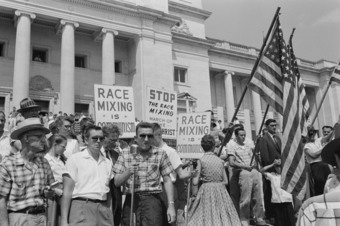
Anti-Integration Protest
A 1959 rally in Little Rock AK protests the integration of the high school.
5.2: The Civil Rights Movement
5.2.1: Separate But Equal
Separate but equal was a legal doctrine in American constitutional law that justified systems of segregation.
Learning Objective
Discuss the reasoning behind the separate of “Separate but Equal” before the Civil Rights Movement
Key Points
- Under this doctrine, services, facilities and public accommodations were allowed to be separated by race, on the condition that the quality of each group’s public facilities was to remain equal.
- Although the Constitutional doctrine required equality, the facilities and social services offered to African-Americans were almost always of lower quality than those offered to white Americans.
- The doctrine of “separate but equal” was legitimized in the 1896 Supreme Court case, Plessy v. Ferguson.
Key Term
- Reconstruction
-
A period in U.S. history from 1865 to 1877, during which the nation tried to resolve the status of the ex-Confederate states, the ex-Confederate leaders, and the Freedmen (ex-slaves) after the American Civil War.
Separate but equal was a legal doctrine in American constitutional law that justified systems of segregation. Under this doctrine, services, facilities and public accommodations were allowed to be separated by race on the condition that the quality of each group’s public facilities was to remain equal.
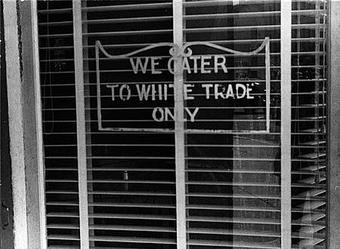
Segregation
A store catering to “whites only” under the separate but equal doctrine.
After the end of Reconstruction in 1877, former slave-holding states enacted various laws to undermine the equal treatment of African Americans, although the 14th Amendment, as well as federal Civil Rights laws enacted after the Civil War, were meant to guarantee such treatment. Southern states contended that the requirement of equality could be met in a manner that kept the races separate. Furthermore, the state and federal courts tended to reject the pleas by African Americans that their 14th Amendment rights had been violated, arguing that the 14th amendment applied only to federal, not state, citizenship.
The doctrine of “separate but equal” was legitimized in the 1896 Supreme Court case, Plessy v. Ferguson. Homer Plessy, who was of mixed ancestry, claimed that his constitutional rights had been violated when he was forced to move to a “colored’s only car” while riding a train. Nonetheless, the Supreme Court ruling “[required] railway companies carrying passengers in their coaches in that State to provide equal, but separate, accommodations for the white and colored races…,” establishing the actual term “separate but equal” in the process. After this ruling, not only was “separate but equal” applied to railroad cars, but also schools, voting rights and drinking fountains. Segregated schools were created for students, as long as they followed “separate but equal”.
Although the Constitutional doctrine required equality, the facilities and social services offered to African-Americans were almost always of lower quality than those offered to white Americans. For example, many African-American schools received less public funding per student than nearby white schools. In Texas, the state established a state-funded law school for white students without any law school for black students.
The repeal of such laws establishing racial segregation, generally known as Jim Crow laws, was a key focus of the Civil Rights Movement prior to 1954. The doctrine of “separate but equal” was eventually overturned by the Linda Brown v. Board of Education Supreme Court Case in 1954.
5.2.2: Brown v. Board of Education and School Integration
Brown v. Board of Education was a Supreme Court case which declared racial segregation in public schools unconstitutional.
Learning Objective
Summarize the phenomena of de jure and de facto segregation in the United States during the mid-1900s and the significance of the Brown v. Board of Education decision for the Civil Rights Movement
Key Points
- Brown v. Board of Education overturned the Plessy v. Ferguson decision of 1896 which allowed state-sponsored segregation.
- The plaintiffs argued that systematic racial segregation, while masquerading as providing separate but equal treatment of both white and black Americans, instead perpetuated inferior accommodations, services, and treatment for black Americans.
- The key holding of the Court was that, even if segregated black and white schools were of equal quality in facilities and teachers, segregation by itself was socially and psychologically harmful to black students and therefore unconstitutional.
Key Term
- de jure
-
By right, in accordance with the law, legally.
Brown v. Board of Education was a landmark U.S. Supreme Court case in which the Court declared that state laws establishing separate public schools for black and white students were unconstitutional. The decision overturned the Plessy v. Ferguson decision of 1896 that allowed state-sponsored segregation. Handed down on May 17, 1954, the Court’s unanimous (9–0) decision stated that “separate educational facilities are inherently unequal. ” As a result, de jure racial segregation was ruled a violation of the Equal Protection Clause of the Fourteenth Amendment of the U.S. Constitution. This ruling paved the way for further racial integration and was a major victory of the civil rights movement.
In 1951, a class action suit was filed against the Board of Education of Topeka, Kansas in the U.S. District Court for the District of Kansas. The plaintiffs were 13 Topeka parents who, on behalf of their 20 children, called for the school district to reverse its policy of racial segregation. The plaintiffs argued that systematic racial segregation, while seeming to provide separate but equal treatment of both white and black Americans, instead perpetuated inferior accommodations, services, and treatment for black Americans. The lead plaintiff was Oliver L. Brown, whose daughter Linda had to walk six blocks to her school bus stop to ride to Monroe Elementary, her segregated black school one mile away, while Sumner Elementary, a white school, was only seven blocks from her house.
The District Court ruled in favor of the Board of Education, citing the U.S. Supreme Court precedent set in Plessy v. Ferguson, and the case moved to the Supreme Court. Chief Justice Earl Warren convened a meeting of the justices and presented to them with the argument that the only reason to sustain segregation was an honest belief in the inferiority of African-American citizens. Warren further submitted that the Court must overrule Plessy to maintain its legitimacy as an institution of liberty, and it must do so unanimously to avoid massive southern resistance. Warren drafted the basic opinion and kept circulating and revising it until the opinion was endorsed by all the members of the Court.
Eventually, the key decision of the Court was that even if segregated black and white schools were of equal quality in facilities and teachers, segregation by itself was socially and psychologically harmful to black students and, therefore, unconstitutional. This aspect was vital because the question was not whether the schools were “equal,” which under Plessy they nominally should have been, but whether the doctrine of separate was constitutional.
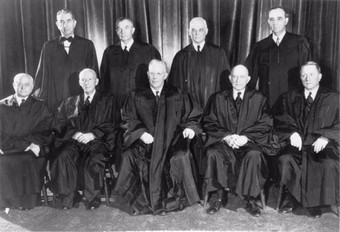
The Warren Court
The members of the Warren Court that unanimously agreed on Brown v. Board of Education.
5.2.3: Jim Crow and the Civil Rights Movement
The Civil Rights Movement aimed to outlaw racial discrimination against black Americans, particularly in the South.
Learning Objective
Differentiate between the legal strategies and “direct action” approaches used to challenge racial discrimination
Key Points
- Characteristics of the Jim Crow system included racial segregation, voter disenfranchisement, economic exploitation, and organized violence against the black community.
- After the Brown v. Board of Education decision in 1954, civil rights organization broadened their strategy to emphasize “direct action”—primarily boycotts, sit-ins, Freedom Rides, marches and similar tactics that relied on mass mobilization, nonviolent resistance and civil disobedience.
- Key events in the Civil Rights Movement included: the Montgomery Bus Boycott, the desegregation of Little Rock Central High School, student sit-ins, Freedom Rides, voter registration drives, and the March on Washington.
Key Terms
- desegregation
-
the act or process of ending the separation of two groups, usually referring to race
- disenfranchisement
-
Explicit or implicit revocation of, or failure to grant the right to vote, to a person or group of people.
The African American Civil Rights Movement refers to the social movements in the United States aimed at outlawing racial discrimination against black Americans and restoring voting rights to them. The Civil Rights Movement generally lasted from 1955 to 1968 and was particularly focused in the American South.
After the period of Reconstruction, the American South maintained an entrenched system of overt, state-sanctioned racial discrimination and oppression. Characteristics of this system, also known as “Jim Crow,” included racial segregation, voter disenfranchisement, economic exploitation, and organized violence against the black community. African Americans and other racial minorities resisted this regime in numerous ways and sought better opportunities through lawsuits, new organizations (such as the National Association for the Advancement of Colored People), political redress, and labor organizing.
After the Brown v. Board of Education decision in 1954, civil rights organization broadened their strategy to emphasize “direct action”—primarily boycotts, sit-ins, Freedom Rides, marches and similar tactics that relied on mass mobilization, nonviolent resistance and civil disobedience. This mass action approach typified the movement from 1960 to 1968. Churches, local grassroots organizations, fraternal societies, and black-owned businesses mobilized volunteers to participate in broad-based actions. This was a more direct and potentially more rapid means of orchestrating change than the traditional approach of mounting court challenges.
Key events in the Civil Rights Movement included: the Montgomery Bus Boycott (1955-1956), which began when Rosa Parks, a NAACP secretary, was arrested when she refused to cede her public bus seat to a white passenger; the desegregation of Little Rock Central High School (1957); the Selma to Montgomery marches, also known as Bloody Sunday and the two marches that followed, were marches and protests held in 1965 that marked the political and emotional peak of the American civil rights movement which sought to secure voting rights for African-Americans. All three were attempts to march from Selma to Montgomery where the Alabama capitol is located. The student sit-ins protesting segregated lunch counters (1960); the Freedom Rides (1961) in which activists attempted to integrate bus terminals, restrooms, and water fountains; voter registration drives; and the March on Washington for Jobs and Freedom (1963), in which civil rights leader, Martin Luther King, Jr. delivered his famous “I Have a Dream” speech.
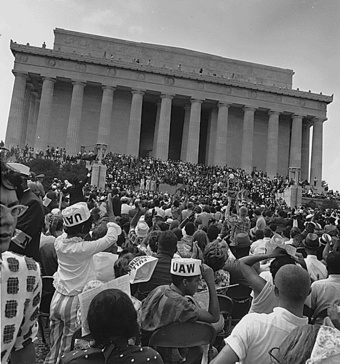
The March on Washington
The March on Washington, a key event in the U.S. Civil Rights Movement.
5.2.4: The Civil Rights Acts
The Civil Rights Act of 1964 outlawed forms of discrimination against women and minorities.
Learning Objective
Compare and contrast the 1964 Civil Rights Act and the 1965 Voting Rights Act
Key Points
- President John F. Kennedy called for the passage of the bill, though it was President Lyndon Johnson who would sign the bill into law after Kennedy’s assassination.
- The Civil Rights Act of 1964 emulated the Civil Rights Act of 1875, which established equal treatment in public accommodations.
- The Voting Rights Act of 1965 outlawed discriminatory voting practices responsible for the widespread disenfranchisement of African-Americans.
Key Terms
- civil rights
-
legal or moral entitlements which are expressly enumerated in the U.S. Constitution and are considered to be unquestionable, deserved by all people under all circumstances, especially without regard to race, creed, religion, sexual orientation, gender and disabilities
- Civil Rights Act of 1964
-
a landmark piece of legislation outlawing major forms of discrimination against women as well as minorities.
- Attorney General
-
the head of the United States Department of Justice; concerned with legal affairs as the chief law enforcement officer of the United States government.
The Civil Rights Act of 1964 was a landmark piece of United States legislation outlawing major forms of discrimination against women as well as racial, ethnic, national and religious minorities. It ended unequal application of voter registration requirements and racial discrimination in schools, at the workplace, and by facilities that served the general public.
In a civil rights speech on June 11, 1963, President John F. Kennedy called for passage of the bill, which he said would “give all Americans the right to be served in facilities which are open to the public – hotels, restaurants, theaters, retail stores, and similar establishments,” as well as “greater protection for the right to vote. ” Emulating the Civil Rights Act of 1875, which established equal treatment in public accommodations, Kennedy’s civil rights bill included provisions to ban discrimination in public accommodations. It also enabled the U.S. Attorney General to join in lawsuits against state governments which operated segregated school systems. After Kennedy’s assassination in November 1963, President Lyndon Johnson utilized his experience in legislative politics to garner support for the bill, which was passed in July 1964.
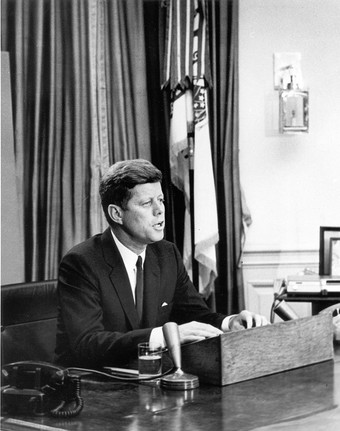
President John F. Kennedy
President John F. Kennedy, who called for the passage of a civil rights bill.
The Civil Rights Act was followed by the Voting Rights Act, signed into law by President Johnson in 1965. The Voting Rights Act outlawed discriminatory voting practices that had been responsible for the widespread disenfranchisement of African-Americans. Specifically, the Act outlawed the practice of requiring otherwise qualified voters to pass literary tests to register to vote. This was a principal means by which Southern states had prevented African-Americans from exercising the franchise.
The Voting Rights Act of 1965 is a landmark piece of national legislation in the United States that prohibits discrimination in voting. Echoing the language of the 15th Amendment, the Act prohibits states and local governments from imposing any “voting qualification or prerequisite to voting, or standard, practice, or procedure … to deny or abridge the right of any citizen of the United States to vote on account of race or color. ” Specifically, Congress intended the Act to outlaw the practice of requiring otherwise qualified voters to pass literacy tests in order to register to vote, a principal means by which Southern states had prevented African Americans from exercising the franchise. The Act was signed into law by President Lyndon B. Johnson, who had earlier signed the landmark Civil Rights Act of 1964 into law.
The Act established extensive federal oversight of elections administration, providing that states and local governments with a history of discriminatory voting practices could not implement any change affecting voting without first obtaining the approval of the Department of Justice, a process known as preclearance. The Act allowed “poll watchers” to ensure state compliance with federal legislation. It also eliminated literacy tests as a precondition for voting, effectively removing barriers to African American voter registration. These enforcement provisions applied to states and political subdivisions (mostly in the South) that had used a “device” to limit voting and in which less than 50 percent of the population was registered to vote in 1964. The Act has been renewed and amended by Congress four times, the most recent being a 25-year extension signed into law by President George W. Bush in 2006.
5.2.5: Continuing Challenges in Race Relations in the U.S.
The Civil Rights Movement influenced racial integration, but tensions with affirmative action and racism still affect racial relations.
Learning Objective
Explain why racial profiling remains controversial
Key Points
- Affirmative action refers to policies that take factors including race, color, religion, gender, sexual orientation, or national origin into consideration in order to benefit underrepresented groups in areas of employment, education, and business.
- Opponents emphasize that affirmative action is counterproductive, as choosing people based on their social group instead of solely their qualifications has the effect of devaluing their accomplishments.
- Racial profiling refers to the use of an individual’s race or ethnicity by law enforcement personnel as a key factor in deciding whether to engage in enforcement.
- After Richard Nixon’s inauguration in 1969, he appointed Vice President Agnew to lead a task force, which worked with local leaders—both white and black—to determine how to integrate local schools.
- Supporters of affirmative action often cite their goals as bridging inequalities in employment and pay; increasing access to education; enriching state, institutional, and professional leadership with the full spectrum of society; and redressing apparent past wrongs, harms, or hindrances.
Key Term
- reverse discrimination
-
The policy or practice of discriminating against members of a designated group which has in the past unfairly received preferential treatment in social, legal, educational, or employment situations, with the intention of benefiting one or more other groups (such as racial, disabled, or gender groups) that have previously been discriminated against.
Continuing Challenges
Background
Though much progress has been made in establishing racial equality since the time of the Civil Rights Movement, there still exist numerous challenges in this area. Two issues relating to race that remain controversial are the debates surrounding affirmative action and racial profiling.
Affirmative action refers to policies that take factors including race, color, religion, gender, sexual orientation, or national origin into consideration in order to benefit underrepresented groups in areas of employment, education, and business. In 1965, President Lyndon Johnson signed Executive order 11246, affirming the Federal Government’s commitment “to promote the full realization of equal employment opportunity through a positive, continuing program in each executive department and agency. “

President Lyndon B. Johnson
Lyndon B. Johnson, who successfully utilized negative political advertising in the famous “Daisy ad” during the 1964 election
After Richard Nixon’s inauguration in 1969, he appointed Vice President Agnew to lead a task force, which worked with local leaders—both white and black—to determine how to integrate local schools. Agnew had little interest in the work, and Labor Secretary George Shultz did most of it. Federal aid was available, and a meeting with President Nixon was a possible reward for compliant committees. By September 1970, fewer than ten percent of black children were attending segregated schools. By 1971, however, tensions over desegregation surfaced in Northern cities, with angry protests over the busing of children to schools outside their neighborhood to achieve racial balance. Nixon opposed busing personally but enforced court orders requiring its use.
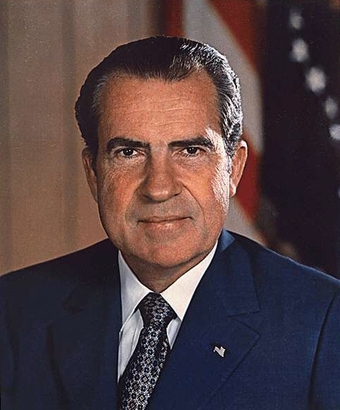
Richard Nixon, 37th President of the United States
Richard Nixon was elected president in 1968, and resigned in 1974 amidst the Watergate scandal. His presidency included foreign policy achievements, most notably improved relations with China.
In addition to desegregating public schools, Nixon implemented the Philadelphia Plan in 1970—the first significant federal affirmative action program. He also endorsed the Equal Rights Amendment after it passed both houses of Congress in 1972 and went to the states for ratification. Nixon had campaigned as an ERA supporter in 1968. However, feminists criticized him for doing little to help the ERA or their cause after his election even though he appointed more women to administration positions than Lyndon Johnson had.
Racial Profiling
Racial profiling refers to the use of an individual’s race or ethnicity by law enforcement personnel as a key factor in deciding whether to engage in enforcement (e.g. make a traffic stop or arrest). The practice is controversial and illegal in many jurisdictions. Racial profiling is challenged at a federal level by both the 4th Amendment of the U.S. Constitution, which guarantees the right to be safe from search and seizure without a warrant (which is to be issued “upon probable cause”); and the 14th Amendment, which requires that all citizens be treated equally under the law. Nonetheless, racial profiling is sometimes practiced in African-American, Hispanic, and Muslim communities within the U.S.
Today’s Controversy of Affirmative Action
The controversy surrounding affirmative action’s effectiveness is based on the idea of class inequality. Opponents of racial affirmative action argues that the program actually benefits middle and upper class African Americans and Hispanic Americans at the expense of lower-income European Americans and Asian Americans. This argument supports the idea of solely class-based affirmative action. America’s poor is disproportionately made up of people of color, so class-based affirmative action would disproportionately help people of color. This would eliminate the need for race-based affirmative action as well as reducing any disproportionate benefits for middle and upper class people of color.
Supporters of affirmative action often cite their goals as
- bridging inequalities in employment and pay;
- increasing access to education;
- enriching state, institutional, and professional leadership with the full spectrum of society;
- redressing apparent past wrongs, harms, or hindrances.
Opponents emphasize that affirmative action is counterproductive. They believe that choosing people based on their social group instead of solely their qualifications has the effect of devaluing their accomplishments; opponents also claim that affirmative action is a form of “reverse discrimination” and may increase racial tension.
5.3: Women’s Rights
5.3.1: The Women’s Rights Movement
The women’s rights movement refers to political struggles to achieve rights claimed for women and girls of many societies worldwide.
Learning Objective
Compare and contrast the first and second waves of feminism in the United States
Key Points
- Second-wave feminism is a period of feminist activity that broadened the debate to a wide range of issues: sexuality, family, the workplace, reproductive rights, de facto inequalities, and official legal inequalities.
- The second wave of feminism in North America came as a delayed reaction against the renewed domesticity of women after World War II: the late 1940s post-war boom, which was an era characterized by unprecedented economic growth, a baby boom, and the move to family-oriented suburbs.
- In 1963, Betty Friedan wrote the bestselling book “The Feminine Mystique” in which she explicitly objected to the mainstream media image of women, stating that placing women at home limited their possibilities, and wasted talent and potential.
- The changing of social attitudes towards women is usually considered the greatest success of the women’s movement.
Key Terms
- Roe v. Wade
-
Roe v. Wade (1973) is a landmark decision by the United States Supreme Court on the issue of abortion; the Court ruled 7-2 that a right to privacy under the due process clause of the 14th Amendment extended to a woman’s decision to have an abortion, but that right must be balanced against the state’s two legitimate interests in regulating abortions: protecting prenatal life and protecting women’s health. Arguing that these state interests became stronger over the course of a pregnancy, the Court resolved this balancing test by tying state regulation of abortion to the trimesters of pregnancy.
- Betty Friedan
-
In 1963, Betty Friedan wrote the bestselling book “The Feminine Mystique” in which she explicitly objected to the mainstream media image of women, stating that placing women at home limited their possibilities, and wasted talent and potential.
- Second-Wave Feminism
-
Second-wave feminism is a period in the history of feminism in America that broadened the debate to a wide range of issues: sexuality, family, the workplace, reproductive rights, de facto inequalities, and official legal inequalities.
Example
- By the early 1980s, it was largely perceived that women had met their goals and succeeded in changing social attitudes towards gender roles, repealing oppressive laws that were based on sex, integrating “boys’ clubs” such as military academies, the United States Armed Forces, NASA, single-sex colleges, men’s clubs, and the Supreme Court, and by accomplishing the goal of making gender discrimination illegal.
Introduction
Second-wave feminism is a period of feminist activity. In the United States, second-wave feminism, initially called the Women’s Liberation Movement , began during the early 1960s and lasted through the late 1990s. It was a worldwide movement that was strong in Europe and parts of Asia, such as Turkey and Israel, where it began in the 1980s, and it began at other times in other countries.
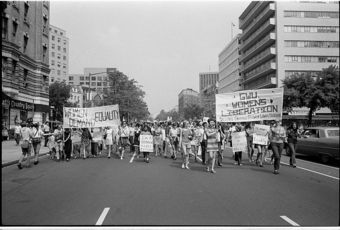
Women’s Liberation March
Women’s Liberation march from Farrugut Square to Layfette park
Whereas first-wave feminism focused mainly on suffrage and overturning legal obstacles to gender equality (i.e. voting rights, property rights), second-wave feminism broadened the debate to a wide range of issues: sexuality, family, the workplace, reproductive rights, de facto inequalities, and official legal inequalities. At a time when mainstream women were making job gains in professions, the military, the media, and sports in large part because of second-wave feminist advocacy, second-wave feminism also focused on a battle against violence with proposals for marital rape laws, establishment of rape crisis and battered women’s shelters, and changes in custody and divorce law. Its major effort was trying to get the Equal Rights Amendment (ERA) added to the United States Constitution, an effort in which they were defeated by anti-feminists led by Phyllis Schlafly, who argued against the ERA, saying women would be drafted into the military.
Historical Precedents
Starting in the late 18th century, and throughout the 19th century, rights, as a concept and claim, gained increasing political, social and philosophical importance in Europe. Movements emerged which demanded freedom of religion, the abolition of slavery, rights for women, rights for those who did not own property and universal suffrage. In the late 18th century the question of women’s rights became central to political debates in both France and Britain. At the time some of the greatest thinkers of the Enlightenment, who defended democratic principles of equality and challenged notions that a privileged few should rule over the vast majority of the population, believed that these principles should be applied only to their own gender and their own race.
Overview
The second wave of feminism in North America came as a delayed reaction against the renewed domesticity of women after World War II: the late 1940s post-war boom, which was an era characterized by an unprecedented economic growth, a baby boom, a move to family-oriented suburbs, and the ideal of companionate marriages. This life was clearly illustrated by the media of the time; for example, television shows such as “Father Knows Best” and “Leave It to Beaver” idealized domesticity.
In 1960, the Food and Drug Administration approved the combined oral contraceptive pill, which was made available in 1961. This made it easier for women to have careers without having to leave due to unexpectedly becoming pregnant. The administration of President Kennedy made women’s rights a key issue of the New Frontier, and named women (such as Esther Peterson) to many high-ranking posts in his administration.
In 1963 Betty Friedan (), influenced by Simone De Beauvoir’s book “The Second Sex,” wrote the bestselling book “The Feminine Mystique” in which she explicitly objected to the mainstream media image of women, stating that placing women at home limited their possibilities, and wasted talent and potential. The perfect nuclear family image depicted and strongly marketed at the time, she wrote, did not reflect happiness and was rather degrading for women. This book is widely credited with having begun second-wave feminism.
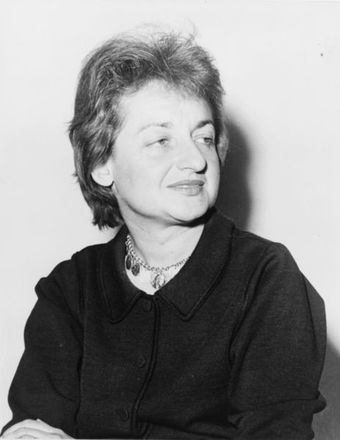
Betty Friedan (1960)
Betty Friedan, American feminist and writer, wrote the best selling book “The Feminist Mystique. ” This book is widely credited with having begun second-wave feminism in the United States.
Achievements
Among the most significant legal victories of the movement after the formation of the National Organization of Women (NOW) were: a 1967 Executive Order extending full Affirmative Action rights to women, Title IX and the Women’s Educational Equity Act (1972 and 1974, respectively, educational equality), Title X (1970, health and family planning), the Equal Credit Opportunity Act (1974), the Pregnancy Discrimination Act of 1978, the outlaw of marital rape, the legalization of no-fault divorce, a 1975 law requiring U.S. Military Academies to admit women, and many Supreme Court cases, perhaps most notably Reed v. Reed of 1971 and Roe v. Wade of 1973 . However, the changing of social attitudes towards women is usually considered the greatest success of the women’s movement.
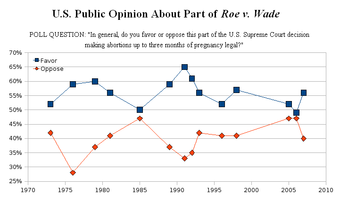
U.S. Public Opinion about Roe v. Wade
Graph showing public support for Roe v. Wade over the years
By the early 1980s, it was largely perceived that women had met their goals and succeeded in changing social attitudes towards gender roles, repealing oppressive laws that were based on sex, integrating “boys’ clubs” such as military academies, the United States Armed Forces, NASA, single-sex colleges, men’s clubs, and the Supreme Court, and by accomplishing the goal of making gender discrimination illegal. However, the movement did fail, in 1982, in adding the Equal Rights Amendment to the United States Constitution, coming up three states short of ratification.
5.3.2: Gender Discrimination
Gender discrimination refers to prejudice or discrimination based on gender, as well as conditions that foster stereotypes of gender roles.
Learning Objective
Illustrate cases of gender discrimination and stereotypes
Key Points
- Sexist attitudes are frequently based on beliefs in traditional stereotypes of gender roles, and is thus built into many societal institutions.
- Many of the stereotypes that result in gender discrimination are not only descriptive, but also prescriptive beliefs about how men and women “should” behave.
- Occupational sexism refers to discriminatory practices, statements, or actions based on a person’s gender which occur in a place of employment.
- Violence against women, including sexual assault, domestic violence, and sexual slavery, remains a serious problem around the world.
Key Terms
- objectification
-
The process or manifestation of objectifying (something).
- Gender Role
-
a set of social and behavioral norms that are generally considered appropriate for either a man or a woman in a social or interpersonal relationship.
- stereotype threat
-
the experience of anxiety or concern in a situation where a person has the potential to confirm a negative stereotype about their social group.
Gender discrimination, also known as sexism, refers to prejudice or discrimination based on sex and/or gender, as well as conditions or attitudes that foster stereotypes of social roles based on gender. Sexist mindsets are frequently based on beliefs in traditional stereotypes of gender roles, and is thus built into many societal institutions.
Gender Stereotypes
Gender stereotypes are widely held beliefs about the characteristics and behavior of women and men. Many of the stereotypes that result in gender discrimination are not only descriptive, but also prescriptive beliefs about how men and women “should” behave. For example, women who are considered to be too assertive or men who lack physical strength are often criticized and historically faced societal backlash. They can also facilitate or impede intellectual performance, such as the stereotype threat that lower women’s performance on mathematics tests, due to the stereotype that women have inferior quantitative skills compared to men’s, or when the same stereotype leads men to assess their own task ability higher than women performing at the same level.
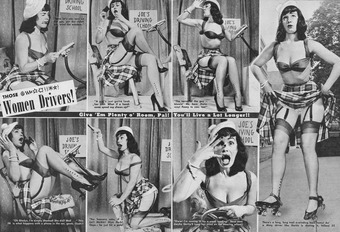
Gender stereotypes
A poster depicting gender stereotypes about women drivers from the 1950s
Examples of Gender Discrimination
There are several prominent ways in which gender discrimination continues to play a role in modern society. Occupational sexism refers to discriminatory practices, statements, and/or actions based on a person’s gender which occur in a place of employment. Wage discrimination, the “glass ceiling” (in which gender is perceived to be a barrier to professional advancement), and sexual harassment in the workplace are all examples of occupational sexism. Violence against women, including sexual assault, domestic violence, and sexual slavery, remains a serious problem around the world. Many also argue that the objectification of women, such as in pornography, also constitutes a form of gender discrimination.
5.3.3: The Women’s Suffrage Movement
The Women’s Suffrage Movement refers to social movements around the world dedicated to achieving voting rights for women.
Learning Objective
Discuss the historical events that culminated with women’s suffrage in America
Key Points
- Within the United States, the first major call for women’s suffrage took place in 1848 at the Seneca Falls Convention.
- World War I provided the final push for women’s suffrage in America, as President Wilson’s stance that the war was being fought for democracy was countered by those who felt women’s disenfranchisement prevented America from being a true democracy.
- In 1919, the Senate passed the Nineteenth Amendment, giving women the right to vote, though the amendment would not be fully ratified until 1920.
- Through a constitutional amendment, reformers pursued state-by-state campaigns to build support for, or to win, residence-based state suffrage. Towns, counties, states, and territories granted suffrage, in full or in part, throughout the 19th and early 20th century.
Key Terms
- Progressive Era
-
a period of social activism and political reform in the United States that flourished from the 1890s to the 1920s.
- suffrage
-
To have the right to vote by citizens of a particular state.
- Prohibition
-
A law prohibiting the manufacture or sale of alcohol.
Background
The Women’s Suffrage Movement refers to social movements around the world dedicated to achieving voting rights for women. Within the United States, the first major call for women’s suffrage took place in 1848 at the Seneca Falls Convention. After the Civil War agitation for the cause resumed. In 1869, the Fifteenth Amendment of the Constitution which gave black men the right to vote, split the movement. Campaigners such as Susan B. Anthony and Elizabeth Cady Stanton refused to endorse the amendment, as it did not give women the right to vote. Others, such as Lucy Stone and Julia Ward Howe, argued that if black men were enfranchised, it would help women achieve their goal.
The conflict caused two organizations to emerge, the National Woman Suffrage Association, which campaigned for women’s suffrage at a federal level and for married women to be given property rights. As well as the American Woman Suffrage Organization, which aimed to secure women’s suffrage through state legislation. After 1900, the groups made a new argument to the effect that women’s superior characteristics, especially purity, made their votes essential to promoting the reforms of the Progressive Era, particularly Prohibition, and exposing political corruption .
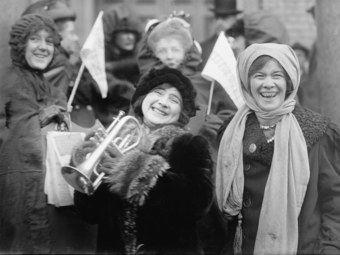
Women’s Suffrage
Supporters of women’s suffrage at a political rally
Women’s Suffrage in America
World War I provided the final push for women’s suffrage in America. When President Woodrow Wilson announced that the war was being fought for democracy, supporters of women’s suffrage protested that disenfranchising women prevented the United States from being a true democracy. In 1918, after years of opposition, Wilson changed his position to advocate for women’s suffrage as a war measure.
In June 1919, the Nineteenth Amendment to the Constitution, giving women the right to vote, was brought before the Senate, and after a long discussion it was passed, with 56 ayes and 25 nays. It would take until August 1920 for enough state legislatures to ratify the amendment, thus making it the law throughout the United States.
In addition to their strategy to obtain full suffrage through a constitutional amendment, reformers pursued state-by-state campaigns to build support for, or to win, residence-based state suffrage. Towns, counties, states, and territories granted suffrage, in full or in part, throughout the 19th and early 20th century. As women received the right to vote, they began running for, and being elected to, public office. They gained positions as school board members, county clerks, state legislators, judges, and eventually as Members of Congress.
5.3.4: The Feminist Movement
The feminist movement refers to a series of campaigns for cultural, political, economic, and social equality for women.
Learning Objective
Compare and contrast the three waves of feminism in the United States and their historical achievements
Key Points
- The history of feminist movements has been divided into three “waves” by feminist scholars.
- The first wave focused on women’s suffrage; the second wave (early 1960s to the late 1980s) was concerned with cultural and political inequalities. The third wave, (starting in the 1990s) criticizes definitions of femininity that generalize the experiences of upper-middle-class white women.
- As a whole, the feminist movement affected change in Western society, including women’s suffrage, the right to initiate divorce proceedings and “no fault” divorce, the right of women to make individual decisions regarding pregnancy, and the right to own property.
- Other important advances in the women’s movement include the founding of the National Organization for Women, as well as the development of legislation prohibiting sexual harassment or discrimination based on gender.
- While women have made strides, they still fall behind men in important measures. They are still underrepresented in Congress, and overrepresented in what have traditionally been considered “women’s” professions (such as teachers or secretaries).
- In recent times, many American women have accomplished “firsts” in the 2000s. For instance, Nancy Pelosi became the first woman to serve as Speaker of the House.
Key Terms
- feminist movement
-
The feminist movement refers to a series of campaigns for reforms on issues. such as reproductive rights, domestic violence, maternity leave, equal pay, women’s suffrage, sexual harassment, and sexual violence.
- National Organization for Women
-
The largest feminist organization in the United States. It was founded in 1966 and has 500,000 contributing members. The six core issues that NOW addresses are abortion rights/reproductive issues, violence against women, constitutional equality, promoting diversity/ending racism, lesbian rights, and economic justice.
- Equal Employment Opportunity Commission
-
A federal law enforcement agency that enforces laws against workplace discrimination. The EEOC investigates discrimination complaints based on an individual’s race, color, national origin, religion, sex, age, disability, genetic information, and retaliation for opposing a discriminatory practice.
The Feminist Movement
The feminist movement (also known as the women’s movement or women’s liberation) refers to a series of campaigns for reforms on issues, such as women’s suffrage, reproductive rights, domestic violence, maternity leave, equal pay in the workplace, maternity leave, sexual harassment, and sexual violence. The movement’s priorities vary among nations and communities.
Women constitute a majority of the population and of the electorate in the United States, but they have never spoken with a unified voice for civil rights, nor have they received the same degree of protection as racial and ethnic minorities.
History of the Movement
The history of feminist movements has been divided into three “waves” by feminist scholars. The first wave refers to the feminist movement of the nineteenth through early twentieth centuries, which focused mainly on women’s suffrage .
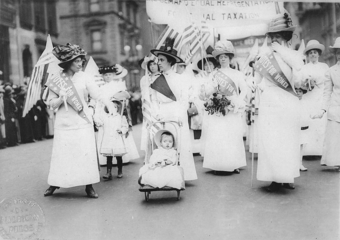
Feminist Suffrage Parade in New York City, May 6, 1912.
First-wave feminists marching for women’s suffrage. The first wave of women’s feminism focused on suffrage, while subsequent feminist efforts have expanded to focus on equal pay, reproductive rights, sexual harassment, and others.
The second wave, generally taking place from the early 1960s to the late 1980s, was concerned with cultural and political inequalities, which feminists perceived as being inextricably linked. The movement encouraged women to understand aspects of their own personal lives as deeply politicized and reflective of a sexist structure of power.
The third wave, starting in the 1990s, rose in response to the perceived failures of the second wave feminism. It seeks to challenge or avoid what it deems the second wave’s “essentialist” definitions of femininity, which often assumed a universal female identity and over-emphasized the experiences of upper-middle-class white women.
One of the most important organizations that formed out of the women’s rights movement is the National Organization for Women (NOW). Established in 1966 and currently the largest feminist organization in the United States, NOW works to secure political, professional, and educational equality for women. In 1972, NOW and other women activist groups fought to ratify the Equal Rights Amendment (ERA) to the Constitution, which affirmed that women and men have equal rights under the law. Although passage failed, the women’s rights movement has made significant inroads in reproductive rights, sexual harassment law, pay discrimination, and equality of women’s sports programs in schools.
In 1980, the Equal Employment Opportunity Commission defined sexual harassment as unwelcome sexual advances or sexual conduct, verbal or physical, that interferes with a person’s performance or creates a hostile working environment. Such discrimination on the basis of sex is barred in the workplace by the Civil Rights Act of 1964 and in colleges and universities that receive federal funds by Title IX. In a series of decisions, the Supreme Court has ruled that employers are responsible for maintaining a harassment-free workplace. Legislation such as this has helped to protect the rights of women in the workplace and at schools. The proposed ERA did have unintended consequences. For example, stay-at-home women did not agreed necessarily with women who worked steady schedules.
The Status of Women in the United States
As a whole, the feminist movement has brought changes to U.S. society, including women’s suffrage, the right to initiate divorce proceedings and “no fault” divorce, the right of women to make individual decisions regarding pregnancy (including access to contraceptives and abortion), and the right to own property. It has also led to increased employment opportunities for women at more equitable wages, as well as broad access to university educations. The feminist movement also helped to transform family structures as a result of these increased rights, in that gender roles and the division of labor within households have gradually become more flexible.
Marxist Feminism
Rosemary Hennessy and Chrys Ingraham say that materialist feminisms grew out of Western Marxist thought and have inspired a number of different (but overlapping) movements, all of which are involved in a critique of capitalism and are focussed on ideology’s relationship to women. Marxist feminism argues that capitalism is the root cause of women’s oppression, and that discrimination against women in domestic life and employment is an effect of capitalist ideologies. Socialist feminism distinguishes itself from Marxist feminism by arguing that women’s liberation can only be achieved by working to end both the economic and cultural sources of women’s oppression. Anarcha-feminists believe that class struggle and anarchy against the state.
Despite this, many American women achieved many political firsts in the 2000s. In 2007, Nancy Pelosi became the first female Speaker of the House of Representatives. In 2008, Democratic presidential candidate Hillary Clinton became the first woman to win a presidential primary, winning the New Hampshire Democratic primary . In 2008, Alaska governor Sarah Palin became the first woman nominated for Vice President by the Republican Party. In 2009 and 2010, respectively, Sonia Sotomayor and Elena Kagan were confirmed as Supreme Court Associate Justices, making them the third and fourth female justices.
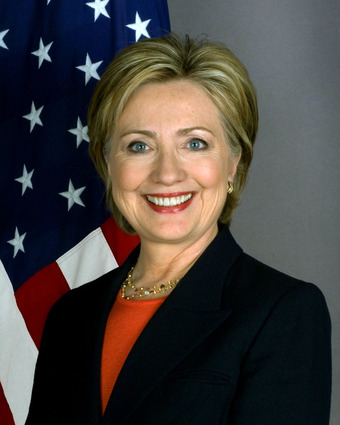
Hillary Rodham Clinton
While women still fall behind men in many important measures, important exceptions exist. For example, Hillary Clinton became the first woman to become the presumptive nominee of a major political party.
5.3.5: Women in the Workplace
Women’s participation in the workforce has been a relatively recent phenomenon and is still associated with many continuing challenges.
Learning Objective
Identify the barriers for equal participation of women in the workplace
Key Points
- Particular barriers to equal participation in the workplace included a lack of access to educational opportunities; restrictions women entering or studying a field; discrimination within a field; and the expectation that mothers should be the primary childcare providers.
- Beginning in the 1970s, women began attending colleges and graduate schools in large numbers and entering professions like law, medicine, and business.
- Challenges that remain for women in the workplace include the gender pay gap, the “glass ceiling”, sexual harassment, and network discrimination.
Key Terms
- sexual harassment
-
intimidation, bullying or coercion of a sexual nature, or the unwelcome or inappropriate promise of rewards in exchange for sexual favors.
- sexism
-
or gender discrimination is prejudice or discrimination based on a person’s sex or gender. Extreme sexism may foster sexual harassment, rape and other forms of violence.
Women’s participation in the workforce has been a relatively recent phenomenon. Until modern times, legal and cultural practices, combined with the inertia of longstanding religious and educational conventions, restricted women’s entry and participation in the workforce.
Particular barriers to equal participation in the workplace included a lack of access to educational opportunities; prohibitions or restrictions on members of a particular gender entering a field or studying a field; discrimination within fields, including wage, management, and prestige hierarchies; and the expectation that mothers, rather than fathers, should be the primary childcare providers.
Within the United States, World War I and World War II provided many new opportunities for women to participate in the workplace, including jobs as secretaries, salespeople, factory workers. Beginning in the 1970s, women began attending colleges and graduate schools in large numbers and entering professions like law, medicine, and business. Many scholars attribute this trend to the advent of the birth control pill, which allowed women to postpone pregnancy and marriage and focus instead on their education and careers. This transformation of women’s expectations had a profound effect on their conception of their own identity and still continues on today.
Challenges that remain for women in the workplace include the gender pay gap, the difference between women’s and men’s earnings due to lifestyle choices and explicit discrimination; the “glass ceiling”, which prevents women from reaching the upper echelons within their companies; sexism and sexual harassment; and network discrimination, wherein recruiters for high-status jobs are generally men who hire other men.
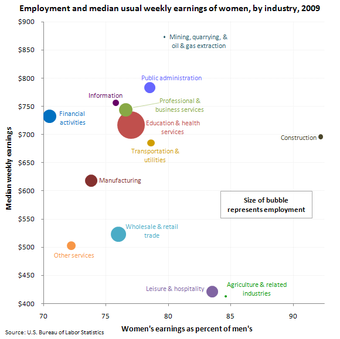
Gender pay gap
A chart depicting women’s earnings in different industries as a percentage of men’s earnings
5.3.6: Women in American Politics
In recent decades, women have served in more political posts and organizations, but they remain underrepresented in comparison to men.
Learning Objective
Analyze the role that women play in American politics, especially the involvement of African-American women in grassroots activism and institutional politics
Key Points
- As of January 2011, 35 women have served as governors of U.S. states, with six women currently serving.
- There are currently 17 female members of the Senate, 12 Democrats and 5 Republicans.
- The first woman to serve as a justice in the U.S. Supreme Court was Sandra Day O’Connor, who was appointed by President Ronald Reagan in 1981.
- African-American women have been involved in American political issues and advocating for the community since the American Civil War era through organizations, clubs, community-based social services, and advocacy.
- African-American women have been underrepresented in politics within the United States, but numbers still increase. The Center for American Women and Politics at Rutgers University states currently 13 African-American women serve in the 112th Congress, with 239 state legislators serving nationwide.
Key Terms
- misogyny
-
Hatred of, contempt for, or prejudice against women.
- U.S. Cabinet
-
The most senior appointed officers of the executive branch of the federal government of the United States, who are generally the heads of the federal executive departments.
Background
As women campaigned for and eventually received the right to vote, they began running for, and being elected to, public office. They gained positions as school board members, county clerks, state legislators, judges and, eventually, shortly before ratification of the Nineteenth Amendment, as members of Congress. In recent decades, women have been increasingly involved in American politics, serving as mayors, governors, state legislators, members of Congress, members of the U.S. Cabinet, and Supreme Court justices.
As of January 2011, 35 women have served as governors of U.S. states, with six women currently serving. The first elected female governor was Nellie Tayloe Ross of Wyoming, who was sworn in on November 4, 1925. The first female governor elected without being the wife or widow of a past state governor was Ella T. Grasso of Connecticut, sworn in on January 8, 1975.
Women in the Government Posts
The first woman elected to Congress was Jeannette Rankin, a Republican from Montana who took office in 1917. Women have been elected to the House of Representatives from 44 of the 50 states. Thirty-nine women have served altogether in the Senate, with Hattie Caraway of Arkansas became the first woman to win election to that legislative body in 1932. There are currently 17 female members of the Senate, 12 Democrats and 5 Republicans.
Twenty-five women have served as U.S. Cabinet officials. The first woman to hold a Cabinet position was Frances Perkins, who was appointed Secretary of Labor by President Franklin D. Roosevelt in 1933. Other prominent female Cabinet members include: Janet Reno, who served as the first female attorney general under President Bill Clinton; Madeline Albright, who served as the first female secretary of state under President Clinton; Condoleezza Rice, Secretary of State under President George W. Bush; and Hillary Rodham Clinton, former First Lady, Senator from New York, Secretary of State under Barack Obama, and the first woman to be nominated for president by a major American political party.
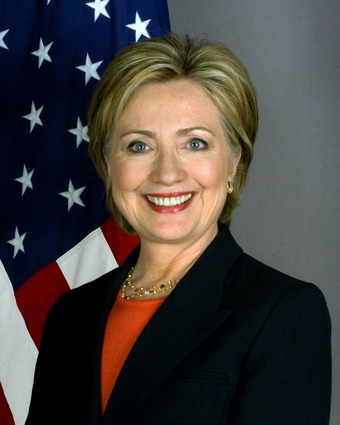
Hillary Rodham Clinton
While women still fall behind men in many important measures, important exceptions exist. For example, Hillary Clinton became the first woman to be nominated for president by a major American political party
The first woman to serve as a justice in the U.S. Supreme Court was Sandra Day O’Connor, who was appointed by President Ronald Reagan in 1981. Three women serve in the current Supreme Court: Ruth Bader Ginsburg, appointed by President Clinton; Sonia Sotomayor, appointed by President Obama; and Elena Kagan, also appointed by President Obama.
African American women in politics
African-American women have been involved in American political issues and advocating for the community since the American Civil War era through organizations, clubs, community-based social services, and advocacy. Issues that deal with identity, racism, and sexism have been important to African-American women in the political dialogue.
Though women obtained the right to vote in the United States in 1920, many women of color still ran into obstacles. Some faced tests that required them to interpret the Constitution in order to vote. Others were threatened with physical violence, false charges, and other extreme danger to prevent voting. Due to these tactics and others that marginalized people of color, the Voting Rights Act of 1965 was put into place. It outlawed any discriminatory acts to prevent people from voting.
Women and Black Power
Despite the fact that elements of the Black Power Movement had some views centered on misogyny, African-American women quickly found a voice in the movement. Women held leadership positions, ran community-based programs, and fought misogyny. Other women also contributed to the grass-roots movement through community service. “In the age of rights, antipoverty, and power campaigns, black women in community-based and often women-centered organizations, like their female counterparts in nationally known organizations, harnessed and engendered Black Power through their speech and iconography as participants of tenant councils, welfare rights groups, and a black female religious order.”
Political Representation
African-American women have been underrepresented in politics within the United States, but numbers continue to increase. According to the Center for American Women and Politics at Rutgers University, currently 13 African-American women serve in the 112th Congress, with 239 state legislators serving nationwide . The paths to public office for women in the African-American community have differed from men and other groups, such as women’s organizations, rallies, and fundraisers.
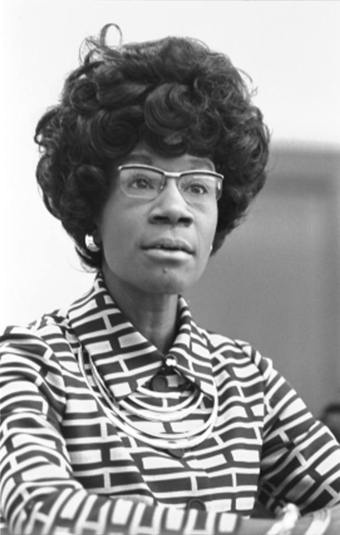
Shirley Chisholm
Shirley Chisholm was a member of the U.S. House of Representatives representing New York’s twelfth Congressional District for seven terms from 1969 to 1983.
A number of organizations supporting African-American women have historically played an important role in politics. The National Association of Colored Women, founded in 1896 by Josephine St. Pierre Ruffin and Mary Church Terrell, is one of the oldest political groups created for and by African-American women. Among its objectives were equal rights, eliminating lynching, and defeating Jim Crow laws. Another organization, the National Council of Negro Women, was founded in 1935 by civil rights activist Mary McLeod Bethune and was more involved in African-American politics with the aim to improve the quality of life for African-American women and families.
5.4: Civil Rights of Other Specific Groups
5.4.1: Civil Rights of Latinos
Policies regarding immigration, language, and voting are modern-day civil rights issues that affect Latinos living in the United States.
Learning Objective
Identify the recent trends in voting among Latinos in the United States and the civil rights issues that affect them
Key Points
- Since the mid-1960’s, Latinos have become the largest immigrant group to the United States.
- Immigration policy remains a highly controversial issue in U.S. politics, with proposals ranging from building a wall along the U.S./Mexican border to limit immigration, to granting legal status to all foreign-born Latinos currently working in the United States.
- Many Latinos living in the U.S. arguably face civil rights violations, such as policies that limit Latino voting and economic participation.
Key Terms
- redistricting
-
the process of drawing boundaries for United States electoral areas, often in response to population changes determined by the results of the decennial census
- Immigration and Nationality Act of 1965
-
Immigration legislation that removed yearly, numerical quotas based on the immigrant’s country of origin and implemented a system of ranking potential immigrants based on skills and family relationships.
- Latino
-
A term used in the U.S. to describe people of Latin American descent or origin.
Example
- Voting redistricting laws that serve to limit the political power of Latino voting blocs are examples of contemporary civil rights controversy affecting Latinos.
Introduction
“Latino” is a term used primarily in the United States to designate people of Latin American heritage or descent. Often, the term is treated as a synonym for Hispanic, although the latter only includes persons of Spanish-speaking origin. Latino is generally used more broadly to include non-Spanish speaking persons of Latin American descent, such as Brazilians. The U.S. Census considers Latino persons to share an ethnic group, not a race. Therefore, on the census individuals of any race can indicate that they are Hispanic or Latino.
Civil Rights and Immigration
The United States has long been a nation with a large immigrant population, but immigration policies have varied throughout the country’s history. In the earliest years, the largest immigrant group to North America consisted of European men. Immigration (not including the arrival of African and Caribbean slaves) proceeded at a relatively low rate until the mid-19th century. By the mid-1800’s, poor economic conditions in some European nations and a surge in industrial opportunities in the U.S. contributed to a dramatic rise in the number of immigrants entering the U.S. The wave of immigration in the latter half of the 1800’s was dominated by the Irish and Germans, although other European ethnicities arrived in significant numbers. By the early 1900’s, vast numbers of immigrants were still arriving, but the demographics had changed. Increasingly large numbers of southern and eastern Europeans were arriving in the eastern United States, while many Chinese and Japanese immigrants were arriving on the West Coast. In response, the U.S. government passed immigration quota laws in the 1920’s which restricted the number of people who could enter the U.S. from any given country. In effect, the policy changes restricted immigration from southern and eastern Europe, Asia, and Central and South America.
The immigration policies of the 1920’s stood until the passage of the Immigration and Nationality Act of 1965, also known as the Hart-Cellar Act. By the 1960’s, immigration was seen as a civil rights issue. Critics of existing policy included President John F. Kennedy, who considered immigration quotas to be at odds with democratic principles. The Immigration and Nationality Act of 1965 was signed into law by President Lyndon B. Johnson. It removed national-origin quotas from immigration law. Instead, potential immigrants would be ranked based on skills, education, and family relationships. The Hart-Cellar Act opened the borders to populations that had been largely excluded from entry to the U.S. in earlier years, thus shifting the demographics of the country. Prior to 1965 the majority of immigrants in the U.S. were of European descent, but in the subsequent decades Latinos came to make up a majority of new immigrants .

The American Public by Ancestry, 2000
Especially in the southwest United States, people of Latino origin make up a significant proportion of United States residents.
Since the Civil Rights Era legislation that made Latino immigration possible, debates about immigration law have remained controversial. In particular, immigration from Mexico has surged since the late-1980’s. People of Mexican origin are now the largest foreign-born group in the United States. While many Mexican and Latino immigrants enter the country legally, particularly through family reunification policies, a substantial number do not have legal-immigrant status — an estimated 700,000 new immigrants per year. Some politicians have sought legislation to curb the flow of immigration from Latin America, including a proposals for increased deportation, building a wall along the U.S./Mexican border, and harsher enforcement of existing laws. Many other politicians and voters instead seek to facilitate the acquisition of legal citizenship for current residents.
Contemporary immigration policy is widely considered to be a civil rights issue that disproportionately affects Latinos. Enforcement and labor policies often violate the rights that are afforded to U.S. citizens. For example, many Latino immigrants are employed in unregulated workplaces, where employers do not pay minimum wage and do not abide by health and safety regulations. Children of immigrants may be denied access to education or coerced into labor that violates child labor laws. Moreover, for fear of deportation or prosecution, immigrants without legal status do not have legal recourse when they are victims of crimes or exploitation. Current policy proposals aimed at reducing these rights violations include legislation to grant legal status to all children born in the U.S. as well as proposals for foreign worker programs that would grant legal status to foreign born laborers. These proposals are highly controversial among the U.S. electorate and politicians.
Language
Because the majority of foreign-born Latinos in the United States speak Spanish as a primary language, and many second-generation continue to speak Spanish in their households, controversies surrounding language are sometimes considered to be civil rights issues affecting Latinos. In recent decades, politicians have repeatedly proposed provisions to make English the official language of the U.S. These proposals have never passed — the U.S. does not have an official language. But, if such propositions were to become law, it would make it substantially more difficult for Spanish-speaking Americans to vote, attend school, and participate in other civic rights and duties. In many cases, critiques of proposals to make English the country’s official language accuse bill sponsors of attempting to disenfranchise Latinos — that is, of trying to reduce their political and economic power.
Voting
Proposals to change voting laws in recent years have also been met by criticism that they would prevent American Latinos from participating in the country’s governance. In some states, redistricting, or the process of redrawing voting precinct boundaries, has divided voters to either segregate Latinos or prevent them from gaining a majority in historically white native-born American districts. Similarly, recent proposals to require more stringent identification at polling places is suspected of attempting to reduce Latino voter turnout because a disproportionate number of Latino citizens do not have drivers licenses or other forms of state-accepted ID.
5.4.2: Civil Rights of Asian Americans
Civil Rights controversies surrounding Asian Americans include early immigration restrictions and xenophobia during the Second World War.
Learning Objective
Discuss the civil rights issues that affect Asian Americans
Key Points
- By the late 1800s, Asian American immigrants, especially from China, comprised large portions of the labor force in some industries.
- Throughout the early to mid-20th century, a period of xenophobia referred to as “Yellow Peril” saw limitations on Asian immigration and civil rights violations inflicted on U.S. Asian residents.
- Since the 1960s, Asian Americans have seen large advances in educational attainment and professional success, leading some commentators to refer to the group as the model minority.
Key Terms
- Yellow Peril
-
A period of xenophobia in the early 1900s that resulted in laws restricting the immigration and naturalization of people of Asian origin.
- internment camp
-
A governmental euphemism for a concentration camp, especially a non-Nazi one from before or during WWII; a detention center; a relocation camp.
- national origins quota laws
-
Immigration laws restricting the number of people who may legally enter the U.S. from any given country.
Example
- Internment camps during World War II were used to hold Japanese American residents and citizens, who were suspected of anti-American plotting without the benefit of legal proceedings.
Introduction
According to U.S. Census data, Asian Americans comprise 4.8% of the U.S. population, with an additional 5.6% of the population having partial Asian ancestry. The Census defines Asian Americans as people who indicate their race as “Asian,” “Chinese,” “Filipino,” “Indian,” “Vietnamese,” “Korean,” “Japanese,” or “Other Asian. ” The group term Asian American has been in wide use since the 1960s, and was introduced as an alternative to the now antiquated and sometimes offensive term “Oriental. “
Asian Americans are sometimes referred to as “the model minority” in the popular press. This label reflects the group’s educational and economic success in recent decades. As of 2008, Asian Americans have the highest educational attainment and median household income of any racial demographic in the United States. While the group’s nickname generally reflects positive trends, it can be seen as offensive or stereotypical when it is applied in a way that implies all Asian Americans are well-educated, wealthy, and demure.
Immigration and Civil Rights
Immigration policy has played a central role in legal Civil Rights issues affecting Asian Americans. People of Asian descent began immigrating to the United States in significant numbers in the late 1800s. As of 1868, U.S. policy encouraged Chinese immigration. Chinese men made up the majority of certain industrial labor pools, most notably the western railroad industry, by the end of the century. Chinese laborers were often subject to unregulated work conditions, which resulted in widespread health problems, work-related injury and death, and exploitation. Nonetheless, it was not until the end of the 19th century that Asian Americans began to face institutionalized barriers to immigration and citizenship.
In 1875, the Page Act expressly prohibited the entry of immigrants deemed “undesirable,” including Asian men seeking contract labor and Asian women who were suspected of engaging in prostitution. The Page Act was followed by the Chinese Exclusion Act of 1882, which suspended all Chinese immigration for ten years, and the Geary Act of 1892, which provided Chinese immigrants to carry resident papers and prevented them from full access to U.S. legal proceedings. By the 1920s, a nativist tendency in the U.S. had propelled the passage of national origins quota laws, which limited the number of immigration from any given country. These policies effectively curbed immigration for several decades.
A xenophobic stance known as the Yellow Peril is often associated with early 20th century attempts to limit Chinese immigration and to bar Chinese residents from gaining American citizenship. By the mid-20th century, however, the term became associated with xenophobia towards Japanese Americans. Spurred by Japan’s role in World War II, many Americans, including legislators, became hostile towards Japanese immigrants and people of Japanese descent living in the U.S. In what is now considered to be a major civil rights violation, thousands of Japanese Americans were held in internment camps during World War II. These camps were premised on the suspicion that Japanese Americans could be linked to Japanese war efforts, but in fact they held thousands of civilians without any legal grounds or evidence of criminal activity.
In 1965, at the tail end of the Civil Rights era, President Lyndon B. Johnson signed the Immigration and Nationality Act of 1965. This bill overturned laws setting immigration quotas, opening the borders to increasing immigration from Asia and Latin America. Asians began entering the U.S. in large numbers, often aided by legal provisions that facilitated the immigration of highly skilled individuals or individuals with family members in the United States. A demographic shift followed the passage of the act, and the Asian American population became increasingly well-educated and had growing access to material resources in the United States.
In the modern day, Asian Americans continue to comprise the second largest ethnic immigrant group, after Latinos. That said, Asian American immigrants have diverse ethnic backgrounds, with large immigrant populations arriving from China, Korea, and India, for example. There has been some controversy over illegal immigration from Asia, with some speculating that as much as 15% of the Asian American population is in the U.S. illegally. However, largely due to favorable stereotypes of Asian Americans, debates surrounding illegal immigration tend to focus on Latinos, who are more negatively stereotyped by native born Americans.
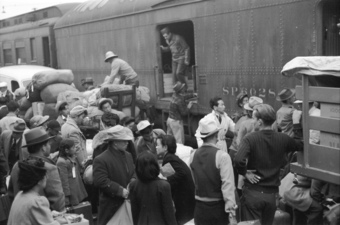
Japanese Americans Sent to Internment Camp
During the Second World War, Japanese Americans were forced to relocate to U.S. government administered internment camps on the baseless suspicion that they may plot anti-American activities.
5.4.3: Civil Rights of Native Americans
Historical policies of American expansion have infringed upon the rights of Native Americans and have lead to long-term inequality.
Learning Objective
Identify the modern civil rights issues that pertain to Native Americans in the United States
Key Points
- 19th and 20th Century policies created a system of Indian reservations, where Native Americans were geographically confined, but had some degree of sovereignty.
- The Indian Civil Rights Act of 1968 extended legal protections against discrimination by the federal government to Native Americans under tribal governance.
- Since the 1970s, affirmative action policies have attempted to provide Native Americans with equal opportunity in housing, employment, and education.
Key Terms
- affirmative action
-
A policy or program providing advantages for people of a minority group with the aim of creating a more racially equal society through preferential access to education, employment, health care, social welfare, etc.
- Indian Civil Rights Act
-
A law that applies to the Indian tribes of the United States and makes many, but not all, of the guarantees of the Bill of Rights applicable within the tribes.
- Indian reservation
-
An area of land managed by a Native American tribe under the United States Department of the Interior’s Bureau of Indian Affairs.
Example
- Relocating Indian populations to reservations during a period of American expansion is an example of what would today be considered a civil rights violation.
Introduction
Native Americans are people of indigenous American descent, including indigenous peoples within the boundaries of the present-day United States. Native Americans are comprised of numerous, distinct ethnic groups, many of which continue as intact cultural and political entities. According to US Census data, 1.37% of Americans identify themselves as Native American.
European Settlement and American Expansion
Prior to the 15th century, groups that were indigenous to the Americas lived in isolation from the rest of the world. Indigenous societies ranged widely in terms of geographic location, culture, and social structure, with distinct languages and governing systems. When Europeans colonized the Americas, massive numbers of Native Americans were killed through warfare and the spread of disease. Of those who survived, most were either forced off the land they inhabited or forced to convert to Christianity and work under Europeans. During the initial phases of American colonization, European policy generally forced Native Americans westward, where there was a low density of European settlement.
By the 1800s, however, the newly formed United States of America sought to expand its territory and strengthen its hold on the western portion of the continent. As settlers moved west, new conflicts with Native American populations ensued. In an attempt to confine Native Americans to limited territory, thus clearing the way for westward expansion, the U.S. government created a system of Indian reservations. Reservations were intended to reduce conflict between settlers and Indians without curbing American expansion, but they were controversial and largely unsuccessful from the start. On the one hand, settlers objected to large portions of land being given to indigenous populations, and on the other, Native Americans objected to having their movement restricted and their territory reduced. Moreover, Native Americans rejected the limited autonomy they were granted through the reservation system, as the reservations were administered by U.S. bureaucrats rather than tribal leaders.
Native Americans in the Modern United States
Today, there are still 310 Indian reservations in the U.S., but they remain controversial. Reservations have alcoholism, domestic abuse, sexual violence, poverty, and illiteracy rates that are among the highest in the country. Partly because of the reservation system, civil rights protections have often involved complex legal issues. Native Americans have allegedly been granted the right to self-determination, which has sometimes limited support on both sides for U.S. governmental protections.
Nonetheless, by 1968 the U.S. Congress passed the Indian Civil Rights Act, which gave tribal members protections from both the U.S. Government and from rights infringements by tribal leaders. Soon after, affirmative action policies began being applied to Native Americans, in an attempt to provide equal opportunity in employment, housing, and education. Despite these efforts, Native Americans still tend to have lower socioeconomic status and greater exposure to crime and abuse than other American groups.
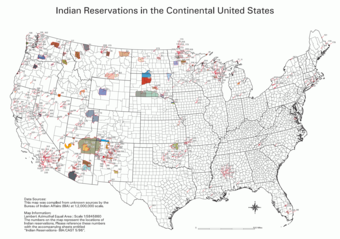
Map of Indian Reservations in the U.S.
Beginning in the 19th century, the U.S. government attempted to reduce conflict and pave the way for territorial expansion by confining Native Americans to reservations, granting them a degree of sovereignty in exchange.
5.4.4: Civil Rights of People with Disabilities
Disabled Americans face limited access to public places and institutions that civil rights legislation seeks to address.
Learning Objective
Describe the campaigns and successes of the disability rights movement.
Key Points
- The Disability Rights Movement arose in the 1960s to create widespread institutional reform that would protect the civil rights of disabled persons in the United States.
- Disability is an umbrella term that includes impairments, activity limitations, and participation restrictions caused by a combination of physical, social, and psychological conditions.
- The 1990 Americans with Disabilities Act mandated improved access to government and social spaces for disabled persons, and also strengthened protections against discrimination.
Key Terms
- disability
-
State of being disabled; deprivation or want of ability; absence of competent physical, intellectual, or moral power, means, fitness, and the like.
- disability rights movement
-
The movement to secure equal opportunities and equal rights for people with disabilities.
- Americans with Disabilities Act
-
A wide-ranging civil rights law that affords similar protections against discrimination to Americans with disabilities as the Civil Rights Act of 1964 did for other groups.
Example
- Outfitting trains and buses with ramps in order to improve access to transportation for disabled persons is an example of a measure designed to meet the requirements of the Americans with Disabilities Act.
Introduction
Disability is an umbrella term that includes impairments, activity limitations, and participation restrictions. Disabilities may be physical, cognitive, mental, sensory, emotional, developmental or some combination of these, and they may be present from birth or acquired later in a person’s lifetime. According to the World Health Organization, an impairment inhibits body function or structure; an activity limitation inhibits an individual’s ability to execute a task or action; and a participation restriction affects an individual’s ability to participate in life situations. Thus, disability is often complex, reflecting an interaction between features of a person’s body and of the society in which he or she lives.
Civil Rights
Disabled persons face unique social challenges that may limit their participation in civic life. Notable issues include:
- Accessibility and safety measures in transportation, architecture, and the physical environment
- Equal opportunity in housing, employment, and education
- Protection from abuse, neglect, and the violation of patients’ rights
To address these concerns, a disability rights movement has introduced a range of legislation and law suits.
The disability rights movement became organized in the 1960s, concurrent with the African-American civil rights movement and feminist movement. Prior to the 1960s, individual disability groups had advocated for social reform; schools for the deaf and blind were organized as early as 1817, and the American Federation of the Physically Handicapped was formed in 1940 to advocate on behalf of people with physical limitations. But, it was not until the 1960s that a diverse range of disability groups became unified in pursuit of large scale advocacy. In the 1960s, the movement included such successful initiatives as the Community Mental Health Act, which provided funding for research about developmental disorders, and the Architectural Barriers Act, which required all federally owned or leased buildings to be accessible to disabled people.
Throughout the 1970s and 80s, the disability rights act gained increasing visibility and a number of policy successes, including increased accessibility of public places and increased resources for people with developmental disabilities. Perhaps the most sweeping success, however, came in 1990 with the passage of the Americans with Disabilities Act. The act provided comprehensive civil rights protections modeled after the Civil Rights Act. It mandated that local, state, and federal governments and programs be accessible to people with disabilities, that employers with more than 15 employees make “reasonable accommodations” for workers with disabilities and not discriminate against otherwise qualified workers on the basis of disability, and that public spaces such as restaurants and stores make “reasonable modifications” to ensure accessibility. The act also mandated the accessibility of public transportation, communication, and other publicly provided services.

Transportation Accessibility
Public transportation vehicles, such as train and bus systems, are required to be outfitted with ramps accessible to disabled persons.
5.4.5: Civil Rights of the Elderly
The elderly, or senior citizens, are vulnerable to civil rights abuses due to a propensity for sickness, disability, and poverty.
Learning Objective
Discuss the civil rights issues that affect the elderly in the United States
Key Points
- Senior citizens are those Americans who are older than the retirement age and who are therefore eligible for state benefits.
- American population shifts have caused the elderly population to expand significantly in recent decades, and it is expected to grow until 2020.
- The Older Americans Act and the Age Discrimination in Employment Act are two pieces of civil rights legislation intended to protect the elderly population.
Key Terms
- Older Americans Act
-
The first federal level initiative aimed at providing comprehensive services for older adults.
- retirement age
-
The age after which a person is eligible for senior citizen benefits, currently 65 in the United States.
- senior citizen
-
An old person, generally, a senior citizen is considered to be over 60 years of age or over the retirement age.
Introduction
The elderly, sometimes referred to as senior citizens in the United States, are a demographic group usually defined by being retired or over the retirement age (which is dependent on life expectancy changes). Due to demographic shifts, including increased life expectancy and high birth rates in the post-World War II era, the United States population has grown older in recent years. As of 1990, only 4% of Americans were over 65; by 2000, 12% were; and demographers estimate that by 2020, 17% will be in that age group.
Civil Rights Issues Affecting the Elderly
Because of a propensity for illness, disability, and lack of employment, the elderly are faced with unique civil rights challenges. Government policies throughout the twentieth century were aimed at meeting the unique needs of elderly Americans. For example, President Franklin D. Roosevelt’s Social Security Act funded medical care for aging Americans. In 1965, President Lyndon B. Johnson signed the Older Americans Act (OAA) into law. This legislation specifically sought to provide equal opportunity for the enjoyment of adequate income in retirement, adequate health care, housing, long-term care, recreation, community services, freedom and self-determination, and protection against abuse, neglect, and exploitation. The OAA provides funding to states for the provision of services on the basis of the percentage of the population over the age of 60. Recipients of the OAA benefits are disproportionately poor, female, rural, and African American, as these elderly populations are particularly vulnerable.
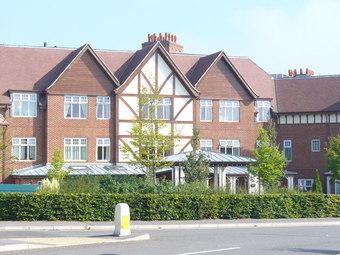
Retirement Home
A large component of non-monetary compensation is retirement funding and similar benefits. Employers will often offer matching or retirement accounts for employees.
Additionally, in 1967, Congress passed the Age Discrimination in Employment Act. This law forbids employment discrimination against anyone who is at least 40 years old in the United States; the denial of benefits based on age; mandatory retirement; and prohibits statements of age preferences in job notices or advertisements. The law attempts to address company policies that force elderly employees out of work once they become eligible for government retirement benefits or due to prejudice against the elderly.
5.4.6: LGBTQ Civil Rights
Lesbian, gay, bisexual, transgender, and queer/questioning (LGBTQ) people have attained many civil protections, but are still subject to discrimination.
Learning Objective
Identify the historical origins and issues relevant for the LGBTQ rights movement
Key Points
- Since roughly the 1950s, the LGBTQ rights movement has worked to protect people from discrimination on the basis of sexual orientation.
- Many policies have changed as a result of the LGBTQ rights movement, such as the legalization of same-sex marriages or civil unions in many states and the overturning of a ban on LGBTQ military service members.
- Despite many policy changes, LGBTQ people are not protected against discrimination by any federal laws, and a powerful conservative movement opposes LGBTQ rights.
- “Don’t Ask, Don’t Tell” (DADT) prohibited military personnel from discriminating against or harassing closeted homosexual or bisexual service members or applicants, while barring openly gay, lesbian, or bisexual persons from military service.
Key Terms
- “Don’t Ask, Don’t Tell” (DADT)
-
A policy in effect between 1991 and 2011 prohibiting military personnel from discriminating against or harassing closeted homosexual or bisexual service members or applicants, while barring openly gay, lesbian, or bisexual persons from military service.
- Stonewall Riots
-
Riots against a police raid that took place on June 28, 1969, at the Stonewall Inn, in the Greenwich Village neighborhood of New York City, which propelled LGBTQ activism and visibility.
- LGBTQ rights movement
-
Activist efforts of individuals and organizations to improve the social and legal standing of lesbian, gay, bisexual, transgender, and queer/questioning (LGBTQ) people.
Introduction
The LGBTQ rights movement refers to the efforts of individuals and organizations to improve the social and legal standing of lesbian, gay, bisexual, and transgender (LGBTQ) people. The Stonewall Riots of 1969 are often thought to mark the starting point of a worldwide LGBTQ rights movement. In fact, some gay and lesbian organizations were established earlier than 1969 and advocated for the improved social standing of LGBTQ people. Still, it was not until the second half of the twentieth century that LGBTQ advocates organized groups and demonstrations to improve the legal status of LGBTQ people.
Despite the long history of non-heterosexual sexual practices and non-conforming gender roles, the concept of lesbian, gay, bisexual, transgender, and queer/questioning (LGBTQ) rights did not become widely used until the second half of the twentieth century. In the early twentieth century in the United States, men and women engaged in homosexual practices and relationships but did not identify as “gay” or “lesbian. ” In New York City in the 1920s, for example, men met in particular social clubs and bars to find male sexual partners. The majority of these men were married and did not consider themselves to be homosexual. While they engaged in homosexual conduct, they generally did not advocate for the improved standing of homosexuals in society. Likewise, throughout the early 1900s, well-educated, unmarried women sometimes lived with long-term female partners. While these relationships were often intimate and resembled marriage, and were sometimes colloquially referred to as “Boston marriages,” the women in these partnerships were more often advocates for women’s rights than for homosexual rights and did not identify as lesbians. The origin of the term “Boston marriages” refer to two single women living together, independent of men. The term was originally coined in Henry James’ novel The Bostonians, which told the tale of an intimate companionship between two wealthy Boston women.
The Stonewall Riots
By the 1950s “homophile organizations” comprised of self-identified homosexual men and women arose. Like earlier social clubs and bars, these homophile club meetings served as a place to meet romantic and sexual partners. But, unlike earlier meeting places, homophile clubs explicitly advocated for the improved social status of homosexual people. While homophile organizations made early explicit attempts to improve LGBTQ peoples’ status, it was not until The Stonewall Riots of 1969 that large numbers of LGBTQ advocates united to demand legal and social rights. Throughout the 1950s-60s LGBTQ people gathered in a small number of bars that welcomed them as customers. Police forces often kept track of which bars were frequented by homosexuals. Since homosexuality was still illegal under anti-sodomy laws, and LGBTQ people had no protections against discrimination, police raids on known gay bars were common.
Don’t Ask, Don’t Tell
“Don’t Ask, Don’t Tell” (DADT) was the official United States policy on gays serving in the military from December 21, 1993, to September 20, 2011. The policy prohibited military personnel from discriminating against or harassing closeted homosexual or bisexual service members or applicants, while barring openly gay, lesbian, or bisexual persons from military service.
The policy was introduced as a compromise measure in 1993 by President Bill Clinton who campaigned in 1992 on the promise to allow all citizens to serve in the military regardless of sexual orientation. In accordance with the December 21, 1993, Department of Defense Directive, it was legal policy that homosexuality was incompatible with military service and that persons who engaged in homosexual acts or stated that they are homosexual or bisexual were to be discharged. he “Don’t Ask” provision mandated that military or appointed officials will not ask about or require members to reveal their sexual orientation. The “Don’t Tell” stated that a member may be discharged for claiming to be a homosexual or bisexual or making a statement indicating a tendency towards or intent to engage in homosexual activities.
A congressional bill to repeal DADT was enacted in December 2010, specifying that the policy would remain in place until the President, the Secretary of Defense, and the Chairman of the Joint Chiefs of Staff certified that repeal would not harm military readiness, followed by a 60-day waiting period. A July 6, 2011, ruling from a federal appeals court barred further enforcement of the U.S. military’s ban on openly gay service members. President Barack Obama, Secretary of Defense Leon Panetta, and Chairman of the Joint Chiefs of Staff Admiral Mike Mullen sent that certification to Congress on July 22, 2011, which set the end of DADT for September 20, 2011.
Successes and Challenges
Since the late-1960s, LGBTQ activists have achieved many successes in the struggle to secure civil rights for LGBTQ people. Notably, in the past decade many states have legalized same-sex marriages and civil unions, the federal government overturned a ban on open LGBTQ military service members known as Don’t Ask, Don’t Tell (DADT), and most states have passed anti-discrimination laws that prevent discrimination in housing, employment, and education on the basis of sexual orientation. Although gay marriage is legal nationally, and no federal law protects LGBTQ people from discrimination.
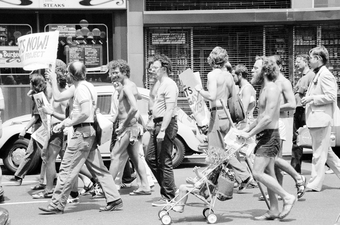
Gay Rights Demonstration
By the late 1960s, cities across the country held gay rights demonstrations to oppose discrimination on the basis of sexual orientation.
5.4.7: Civil Rights of Immigrants
Immigrants are vulnerable to civil rights violations, often due to low socioeconomic status, language barriers, or xenophobia.
Learning Objective
Discuss the history of immigration to the United States
Key Points
- In the early history of the United States, the largest numbers of immigrants were comprised of Europeans seeking economic opportunity and Africans who were forcibly brought to the U.S. as slaves.
- Throughout much of the 20th century, immigration to the U.S. was heavily restricted, but the Immigration and Nationality Act of 1965 lifted prior quotas and allowed many new immigrants into the country.
- The largest immigrant populations in the U.S. today are Latinos and Asian-Americans, though the former group is the subject of significantly more political controversy.
Key Terms
- immigration
-
Coming into a non-native country for the purpose of permanent residence.
- Immigration and Nationality Act
-
Law that abolished country of origin quotas on immigration.
- The Dream Act
-
Proposed legislation that would provide conditional permanent residency to certain undocumented residents of good moral character who graduate from U.S. high schools, arrived in the United States as minors, and lived in the country continuously for at least five years prior to the bill’s enactment. This proposed legislation has been introduced at least 5 times in Congress since 2001, but has failed to pass both houses.
Example
- Paying migrant farm workers less than minimum wage is a civil rights violation carried out against a primarily immigrant population. The United Farm Workers union, led by Cesar Chavez, directly addressed this illegal exploitation of workers.
History
Immigration is the movement of people from one country to a country in which they are not native. In the United States, immigration has a long and complex history. It has long been a source of population growth as well as cultural, social, and political change.
In the first two centuries of the United States’ history, new immigrants were primarily north European, African, and Caribbean. Europeans immigrated primarily for economic opportunity, though some groups moved in pursuit of religious freedom or political asylum. Virtually all immigration from Africa and the Caribbean was the result of slavery — the movement of Africans and Caribbean Islanders from their native countries was entirely involuntary.
By the mid-1800s, increasing numbers of southern and eastern Europeans were immigrating to the United States. Many new groups were met with xenophobia. For example, in the second half of the 1800s, the Irish population in the U.S. exploded, and anti-Irish sentiment resulted in a plethora of discriminatory practices in housing, employment, and governance.
For much of the twentieth century, immigration was severely restricted by legislation with an isolationist philosophy. It was not until the passage of the Immigration and Nationality Act of 1965 that significant numbers of immigrants were once again allowed to enter the U.S. The Immigration and Nationality Act reversed laws that limited the number of immigrants who could enter from any given country, and instead put in place policies that encouraged the immigration of skilled workers and family members of U.S. citizens.
Contemporary Debates
At present, the two largest immigrant groups in the United States are Latinos and Asian-Americans. While there is general political debate surrounding immigration, the bulk focuses on Latinos. This trend is largely due to the high socio-economic status of Asian immigrants — compared to other groups, Asian immigrants tend to be well-educated, and second-generation Asian-Americans immigrants tend to have high incomes and educational attainment. Latino immigrants, on the other hand, comprise a poorer, less-educated population. Consequently, they are more vulnerable to civil rights violations and lack of legal protection.
All immigrants are affected by certain civil rights issues, though Latinos may be more vulnerable than other groups. Central issues include the low enforcement of labor laws with regards to immigrant workers who are subject to dangerous or exploitative conditions; lack of due process in the courts for residents who entered the country illegally; debates about whether languages other than English should be taught in public schools and used in government documents; and debates about whether children who entered the country illegally can be prosecuted and deported. The Dream Act is an example of recently proposed legislation that would allow children born to parents who are illegally in the U.S. to attend public universities and become citizens .Although the Dream Act has not passed as federal legislation, a California version was passed in 2011. The California DREAM (Development, Relief, and Education for Alien Minors) Act is a package of California state laws that allow children who were brought into the US under the age of 16 without proper visas/immigration documentation who have attended school on a regular basis and otherwise meet in-state tuition and GPA requirements to apply for student financial aid benefits.
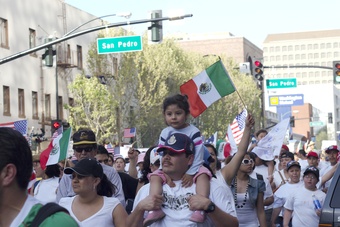
Mexican-American Rights March
Mexican-American immigrants have organized many political demonstrations to protest the exploitation of workers, discrimination in education and employment, and heavy-handed criminal justice enforcement against illegal immigrants.
While illegal immigration is the most controversial issue in American politics, immigrants who enter the country legally also face civil rights challenges. Discrimination in housing, employment, and education is legally prohibited, but continues to impact many immigrants, especially those who may be vulnerable due to a language barrier or their economic status.
5.5: Affirmative Action
5.5.1: The Supreme Court and the Burden of Proof
The Supreme Court is the highest court in the United States and has ultimate jurisdiction over all courts that involve a contest of federal law.
Learning Objective
Describe the structure and function of the Supreme Court
Key Points
- The Supreme Court hears cases from lower courts and decides the law of the United States.
- The Court expresses its views in a legal opinion, which much have a majority opinion and may have concurrences and dissents.
- Though the Supreme Court is supposed to be politically independent, the current court’s opinions are more frequently embraced by conservatives than by liberals.
Key Terms
- opinion
-
A statement of judicial finding that becomes law.
- Supreme Court of the United States
-
The highest court in all of the United States, one that can hear and decide cases from all lower courts.
The Supreme Court of the United States
The Supreme Court is the highest court in all of the United States. Any lower (more local) court can appeal a ruling to the Supreme Court. In other words, it has ultimate, but largely discretionary, appellate jurisdiction over all courts that involve a contest of federal law. The Court consists of a chief justice and eight associate justices who are nominated by the President and confirmed by the United States Senate. Once appointed, justices have life tenure unless they resign, retire, or are removed after impeachment. The sitting court consists of Chief Justice John Roberts, Anthony Kennedy, Clarence Thomas, Ruth Bader Ginsburg, Stephen Breyer, Samuel Alito, Sonia Sotomayor, and Elena Kagan. No replacement has been made to fill the open seat resulting from the death of justice Antonin Scalia on Feb. 13, 2016.
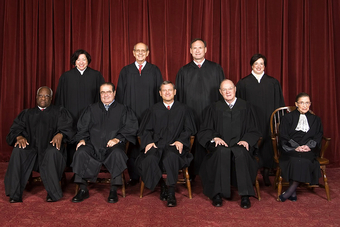
The U.S. Supreme Court
The United States Supreme Court, the highest court in the United States, in 2010. Top row (left to right): Associate Justice Sonia Sotomayor, Associate Justice Stephen G. Breyer, Associate Justice Samuel A. Alito, and Associate Justice Elena Kagan. Bottom row (left to right): Associate Justice Clarence Thomas, Associate Justice Antonin Scalia, Chief Justice John G. Roberts, Associate Justice Anthony Kennedy, and Associate Justice Ruth Bader Ginsburg.
The Supreme Court is the head the judicial branch, one of the three branches of American government (the other two being the executive branch and legislative branch). Of the three, the Supreme Court is supposed to be politically independent, and thus not wed to either the Democratic or Republican Party. However, the nomination process itself essentially ensures that some partisanship, or allegiance to a political party, appears on the Court. A partisan president nominates a justice and a partisan Senate must confirm a justice. Justices are thus categorized in legal and political circles as being judicial conservatives, moderates, or liberals. Though explicitly not for political motivations, judicial conservatives tend to confirm Republican agendas while judicial liberals tend to support Democratic aims. Ideally, their legal holdings are independent of their political views, though the degree to which this is true in practice is highly contested. The current court tends to lean conservatively in its opinions.
The Supreme Court decides which cases it would like to hear. Allowing a case to come before the court is called granting a writ of certiorari or granting cert. But for a small set of limited exceptions, the Court only hears cases that have already been reviewed by a lower court, meaning that the Supreme Court is a court of appeal. The party that lost the case in the lower court is called the petitioner and the party that won in lower court is called the respondent. The names of all of the cases that come before the court are structured as Petitioner v. Respondent, regardless of which party brought suit in the lower court. After granting cert, lawyers for each party will submit briefs, or written legal arguments, about the issues for the Court to read before oral arguments, or the time when a lawyer from each side will argue his case before all of the justices. After oral arguments, the justices will meet to discuss the case and then issue an opinion, or written statement of their findings, weeks or months later.
Not all justices have to agree on the finding of the court; in fact, they rarely unanimously agree. Instead, the justices will vote on the issues before them and the majority vote will constitute the legal opinion and law of the United States. Because of this voting process, you will frequently see the score for the vote (justices for and against). For example, in the case of Roe v. Wade (1973), the case that established federal abortion law in some instances of pregnancy became law by a vote of 7-2. The opinion will describe the justices’ reasons for voting as they did. The part of the opinion that address the majority vote and the new law of the land is called the majority opinion, while the part of the opinion that describes the rationale for the minority voters is called the dissent. One justice can write an opinion to which other justices will sign, though justices will frequently write their own opinion. When a justice that voted with the majority writes his or her own opinion, it is called a concurrence. You will frequently find opinions that contain several concurrences and dissents.
5.5.2: Referenda on Affirmative Action
Affirmative action measures, particularly those pertaining to higher education, have been politically controversial in the United States.
Learning Objective
Identify four key referenda challenging affirmative action programs
Key Points
- Affirmative action refers to the integration of minorities in higher education settings and equal opportunity employment.
- Referenda have been issued across the country so that citizens can vote on this politically controversial issue.
- California, Washington, Michigan, and Nebraska have all passed referenda to limit the use of affirmative action in their states.
Key Terms
- affirmative action
-
A policy or program providing advantages for people of a minority group with the aim of creating a more racially equal society through preferential access to education, employment, health care, social welfare, etc.
- referendum
-
A direct popular vote on a proposed law or constitutional amendment.
In the United States, affirmative action refers to two different institutional capacities: 1) the proactive integration of minorities in settings of higher education, possibly by the use of different admissions standards and 2) equal opportunity employment measures that federal contractors are legally required to adopt. Affirmative action measures, particularly those pertaining to higher education, have been politically controversial in the United States. Though the majority of legal discussions about affirmative action have pertained to law suits, many states have had referenda on the topic. A referendum is a direct vote in which an entire electorate (citizens of particular states, in these cases) is asked to either accept or reject a particular proposal.
Major Affirmative Action Referenda in the United States
In California, Proposition 209 (the California Civil Rights Initiative) was passed in 1996 and amended the state constitution to prohibit state government institutions from considering race, sex, or ethnicity, specifically in the areas of public employment, public contracting, and public education. Proposition 209 was passed with 54% of the electorate approving of the initiative. The most controversial aspect of Proposition 209 was the element that applied to public education. Prior to the passage of the proposition, the University of California system had used mechanisms of affirmative action. Since the passage of Proposition 209, higher graduation rates have be been posted across all of the University of California, leading opponents of affirmative action to suggest a causal link between Proposition 209 and a better prepared student body. However, while minority graduation rates have risen, enrollment rates have decreased. Of the 4,422 student in UCLA’s class of 2006, only 100 (2.26%) were African American. Since the passage of Proposition 209, enrollment rates for African Americans and Latinos have declined significantly, while rates have increased for Asian Americans.
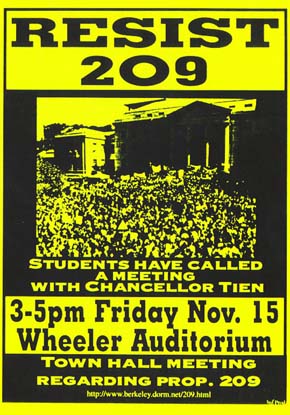
Protests of California’s Proposition 209
Hundreds of students protested Proposition 209 at the University of California – Berkeley.
Several other states were inspired by California’s referendum. In 1998, the state of Washington sought to prohibit racial and gender preferences by state and local government. The initiative passed with 58.22% of the vote, adding the following language to Washington’s laws: “The state shall not discriminate against, or grant preferential treatment to, or any individual group on the basis of race, sex, color, ethnicity, or national origin in the operation of public employment, public education, or public contracting.”
The Michigan Civil Rights Initiative (MCRI, or Proposition 2), was a ballot initiative that passed into Michigan Constitutional law by a 58% to 48% vote in 2006. The MCRI was legislation aimed at stopping the preferential treatment of minorities (by race, color, sex, or religion) in receiving admission to colleges, jobs, and other publicly funded institutions. However, the MCRI was overturned by the United States Court of Appeals for the Sixth Circuit in 2011. Bill Schutte, Attorney General for the State of Michigan, announced that he was appealing the Sixth Circuit’s decision, so the MCRI is in effect until the appeal is complete.
The Nebraska Civil Rights Initiative, or Initiative 424, was a 2008 ballot measure that proposed a constitutional amendment which would prohibit the state from discriminating against or granting preferential treatment to “any individual on the basis of race, sex, color, ethnicity, or national origin in the operation of public employment, public education, or public contracting.” The measure, in effect, banned affirmative action at the state level. It passed with 58% of the vote.
5.5.3: Controversies Surrounding Affirmative Action
Opponents have tested affirmative action programs politically and legally through referendums and lawsuits since the 1970s.
Learning Objective
Analyze the response to the rise of affirmative action programs
Key Points
- Since the 1970s, affirmative action programs, particularly those in higher education, have been tested politically and legally by its opponents.
- Referendums have curtailed affirmative action programs in California, Michigan, Washington, and Nebraska.
- Lawsuits have also questioned the constitutionality of affirmative action programs.
Key Terms
- referendum
-
A direct popular vote on a proposed law or constitutional amendment.
- affirmative action
-
A policy or program providing advantages for people of a minority group with the aim of creating a more racially equal society through preferential access to education, employment, health care, social welfare, etc.
- reverse racism
-
Racism against either a person or people of a racial majority as a result of favorable treatment given to the minority.
Since the 1970s, affirmative action programs, particularly those in higher education, have been tested politically and legally by its opponents. Proponents of affirmative action contend that affirmative action programs give minorities the same educational advantages and opportunities that should be afforded to all races and attempt to compensate for past institutional racism. Proponents further argue that affirmative action programs encourage the elimination of racism by demonstrating that people from all different backgrounds can succeed in educational and professional settings.
However, supporters of affirmative action have encountered opposition. Some opponents have tested the bases for affirmative action programs on the basis of class inequality. These opponents argue that the program actually benefits middle- and upper-class African and Hispanic Americans at the expense of lower-class European and Asian Americans. This argument supports the idea of solely-class based affirmative action or the idea that affirmative action programs should be instituted based on social class rather than race . Other opponents have tested affirmative action by arguing that these programs lower admission standards for educational and professional environments and stating that affirmative action is a form of reverse racism, by which Caucasians are disadvantaged in the same way that minorities were in the past.
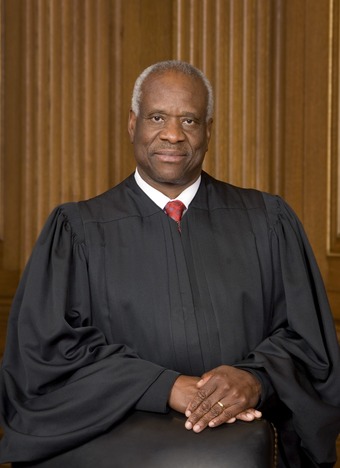
Justice Clarence Thomas
Supreme Court Justice Clarence Thomas has argued that affirmative action programs disadvantage minority students because others think that they achieved success due to affirmative action rather than their own merits.
Opponents of affirmative action have tried to disassemble affirmative action programs. States such as California, Michigan, Washington, and Nebraska have held a referendums, turning the issue over to voters on a direct ballot measure. In all four of these states, voters demanded that state institutions, including public institutions of higher education, disband all programs that take race and ethnicity into account for admissions. Affirmative action programs have engendered lawsuits disputing their constitutionality. These suits are normally sought by Caucasian students who were not admitted to institutions of higher education while lower scoring minority students were admitted. The most famous of these cases include Regents of the University of California v. Bakke (1978), Hopwood v. Texas (1996), Grutter v. Bollinger (2003), Gratz v. Bollinger (2003), and Parents Involved in Community Schools v. Seattle School District No. 1 (2006). Each of these cases has more narrowly defined the instances in which public schools can factor race into account in admissions.
5.5.4: Strict Scrutiny
The legal standard of strict scrutiny, the most stringent standard of judicial review, must be used in all court cases involving affirmative action.
Learning Objective
Describe the three tests a law faces under a strict scrutiny standard
Key Points
- Courts employ different legal standards to evaluate the constitutionality of legal claims; all cases of affirmative action must pass the strict scrutiny test.
- To pass the strict scrutiny test, the state must demonstrate that the state has a compelling governmental interest in the program or law, that the law or program is narrowly tailored to suit the compelling governmental interest, and that the state is using the least restrictive means.
- The court must use the strict scrutiny test because affirmative action programs constitute suspect classification, or preferential treatment based on race.
Key Terms
- suspect classification
-
When the government classifies individuals along racial lines and treats minority populations differently than the majority population.
- strict scrutiny
-
The most stringent standard of legal review in American courts, used to evaluate the constitutionality of laws and government programs.
- constitutional
-
Conforming to the constitution.
Strict scrutiny is the most stringent standard of judicial review used in American courts . It is part of the hierarchy of standards that courts use to weigh the government’s interest against a constitutional right or principle. The other members of the hierarchy of standards are, at the lowest level, “rational basis review” and, at the intermediate level, “intermediate scrutiny.”
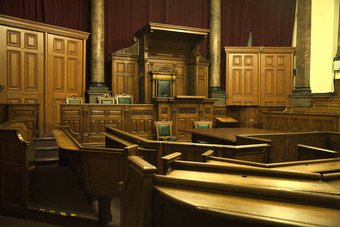
Strict Scrutiny
Courts must use strict scrutiny to evaluate affirmative action programs.
Strict scrutiny is the standard that is employed in litigating affirmative action cases. Strict scrutiny is applied by judges in these cases because they give preferential treatment to a class of citizens–racial minorities. Whether the treatment is justified or not is politically contentious, but the treatment is recognized as legally preferential. Because affirmative action programs do not treat citizens equally, the implementation of affirmative action programs must pass the strict scrutiny standard for the programs to be constitutional, or legal and in accordance with the law and principles outlined in the American Constitution.
Judges apply strict scrutiny tests when a case regarding affirmative action come before them. In other words, in order to determine the constitutionality of the contested program, the judge must determine whether or not the program meets the standards of a strict scrutiny test. To meet these standards, the law or program must satisfy three tests:
- The program must be justified by a compelling governmental interest. This concept refers to something that is necessary or crucial for the functioning of the state, rather than just something that the state wants. An example of a compelling governmental interest would be national security. Whether or not the state has a compelling governmental interest in the incorporation of minority students in places of public education is a key question in any affirmative action case coming before the court.
- The law or program must be narrowly tailored to achieve the state’s compelling governmental interest. For example, even if the court found that states had a compelling governmental interest in incorporating minority students, the state would have to demonstrate that its program only incorporated eligible candidates. A person could not be admitted to an institution of higher education simply because of his racial background.
- The law or program must use the least restrictive means for achieving the state’s compelling governmental interest; that is, there cannot be a less restrictive way to effectively achieve the compelling governmental interest.
When the court uses the strict scrutiny standard to evaluate affirmative action cases, the court is employing the standard because the court must do so in every case of suspect classification. These are cases in which a petitioner is questioning the state’s categorization and treatment of a particular minority group of citizens. Affirmative action cases fall in this category. For the classification to be constitutional, the class must have experienced a history of discrimination, must be definable as a group, must have limited political powers, and its characteristic must have little relationship to the government’s policy aims or the ability of the group’s members to contribute to society. The Supreme Court has consistently found that classification based on race, national origin, and alienage require strict scrutiny review. Thus, it is used in all legal contestations of affirmative action.
5.5.5: The Diversity Debate
Debates over affirmative action center around the question of whether diversity in the classroom merits a program of state intervention.
Learning Objective
Reconstruct frequently-made arguments for and against affirmative action in higher education
Key Points
- Debates about affirmative action question the need and usefulness of state schemes for racial integration in the classroom.
- Brown v. Board of Education made it illegal to segregate public education; affirmative action programs claim that the government needs to be proactive in integrating minorities.
- Opponents of affirmative action claim that the program encourages a sensitivity to race rather than the development of a colorblind world.
Key Terms
- affirmative action
-
A policy or program providing advantages for people of a minority group with the aim of creating a more racially equal society through preferential access to education, employment, health care, social welfare, etc.
- Brown v. Board of Education
-
The Supreme Court case that ruled segregated education unconstitutional.
Racial diversity in American schools remains a contentious political issue. Should public schools go out of their way to attract minority students? Does the government have a serious interest in the balancing of racial populations in education? Does a racially diverse classroom support educational goals? These questions are at the heart of the debate over affirmative action.
The institutional practice of slavery, and later segregation, in the United States prevented certain racial groups from entering the school system, particularly systems of higher education, until midway through the 20th century when the Supreme Court case of Brown v. Board of Education forbade racially segregated education. The Court ruled that school segregation stunted the educational development of minority children. Though Brown became law, most counties in the Southern United States did not fully integrate their schools until the 1970s.
Affirmative action programs in higher education are, of course, different from the desegregation programs of the mid-twentieth century. In affirmative action programs, the state goes beyond ensuring de jure equality for racial minorities in public education and makes strides to create conditions for de facto equality. Supporters of affirmative action believe that these types of proactive programs prove that all students benefit from racial diversity in the class room, and that institutional forms of racism have precluded members of the minority community from entering spaces of higher education. Some believe that racial and ethnic diversity in schools fosters understanding of new cultures and beliefs systems, dispelling stereotypes held by the majority population . Since the mid-twentieth century, researchers have found that benefits of racial diversity in schools range from higher reading levels, increased likelihood of high school graduation, positive impact on work aspirations and higher educational attainment, greater interaction with other racial groups and creation of interracial friendships in adult life, and higher desire to live and work in racially diverse environments.

Diversity in Education
Supporters of affirmative action programs posit that all students benefit from diversity in schools.
In addition to the perceived legal obstacles to the implementation of affirmative action programs, some opponents of affirmative action believe that race-conscious approaches to diversity in the classroom are harmful. They perceive little correlation between racial diversity in the classroom and increased performance by minority students. These theorists believe that focusing on race in diversity policies creates a heightened awareness of racial difference and perpetuates discrimination. Rather, these individuals usually support colorblind policies to instill the norm that skin color does not matter.
5.5.6: The Supreme Court Revisits Affirmative Action
The first affirmative action case to come before the Supreme Court dealt with affirmative action in employment.
Learning Objective
Summarize the facts of the case Griggs v. Duke Power
Key Points
- As a concept, affirmative action developed in relation to employment and only later was applied to institutions of higher education.
- The first court case addressing affirmative action was Griggs v. Duke Power Co. in 1971.
- The Supreme Court held that Duke’s hiring tests, which disadvantaged minority candidates, were not reasonably related to the job at hand and thus unconstitutional.
Key Terms
- Griggs v. Duke Power Co.
-
The first Supreme Court case in the US to address affirmative action in 1971.
- affirmative action
-
A policy or program providing advantages for people of a minority group with the aim of creating a more racially equal society through preferential access to education, employment, health care, social welfare, etc.
Though the current debate over affirmative actionin the United States generally refers to affirmative action programs in admissions to institutions of higher education, the term originally developed in regard to actions to proactively hire candidates from minority backgrounds. Examples of affirmative action programs offered by the US Department of Labor include outreach campaigns, targeted recruitment, employee and management development, and employee support programs. In broad terms, affirmative action programs in employment refer to the preferential treatment of minority employees in the hiring or management process.
The first Supreme Court cases adjudicating affirmative action dealt with affirmative action in cases of employment. The first court case in the United States over affirmative action was Griggs v. Duke Power Co., 401 U.S. 424, in 1971. In the 1950s, Duke Power’s Dan River plan had a policy that African-Americans were allowed to work only in its Labor Department, which constituted the lowest-paying positions in the company. In 1955, a time when even public education served as a barrier between whites and African Americans, the company added the requirement of a high school diploma for its higher jobs. After the passage of the Civil Rights Act in 1964, the company removed the racial restriction, but retained the high school diploma requirement, and added the requirement of an IQ test, with the racist belief that African Americans would score lower than whites on an IQ test. African Americans were far less likely to be hired than white candidates. It was found that white people who had been working at the firm for some time but met neither of the new requirements performed their jobs as well as those that did meet the requirements.
The court ruled that Duke Power’s employment requirements did not pertain to applicants’ abilities to perform the job and so was discriminating against African-American employees, even if Duke Power hadn’t intended for the policy to have that effect . The Supreme Court ruled that under Title VII of the Civil Rights Act, if the IQ and diploma tests disparately impacted ethnic minority groups, businesses must demonstrate that such tests are “reasonably related” to the job for which the test is required. Duke Power’s requirements did not pass this legal standard, and thus the case was decided against Duke Power.
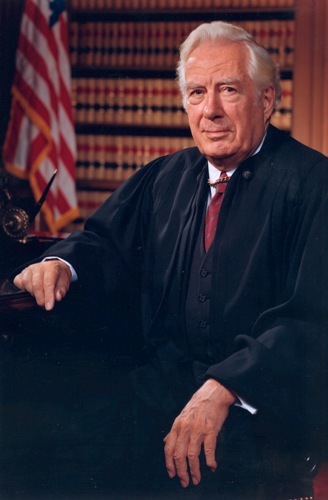
Chief Justice Burger
Chief Justice Warren E. Burger authored the opinion of the court in Briggs v. Duke Power Co. in 1971.
5.5.7: State Initiatives Against Affirmative Action
States and the federal government have argued about the appropriate implementation of affirmative action policies.
Learning Objective
Assess the relationship between states and the federal government in matters related to affirmative action
Key Points
- States have sought to limit the federal government’s implementation of affirmative action policies.
- The most effective state actions against affirmative action have occurred through referenda.
- The federal government has pushed back against state opposition to affirmative action policies.
Key Terms
- referendum
-
A direct popular vote on a proposed law or constitutional amendment.
- Griggs v. Duke Power Company
-
The 1971 Supreme Court case in which the federal government first adjudicated affirmative action, ruling that states cannot limit access to employment for minorities; limitations for employment must be related to work performance.
Following the decision of Griggs v. Duke Power Company, the first court case to assess affirmative action in employment that made it to the Supreme Court in 1971, states took action to limit the application of affirmative action programs in their jurisdictions. This case decided for the minority petitioners, asserting that companies could not impose policies that raised obstacles for minority applicants so long as the the fulfillment of the policies were not reasonably related to job performance. States sought to limit the reach of federal policies regulating employment standards.
However, the scope of affirmative action debates soon extended beyond employment and entered the domain of higher education. Opponents to affirmative action have been even more vociferous about the use of affirmative action in higher education than when affirmative action pertains to employment policies. Since 1996, citizens of Arizona, Nebraska, California, Michigan, and Washington have all sponsored referendums to limit the legality of affirmative action policies . Since voters passed the referenda, the law in Michigan has been put on hold while the Michigan courts assess the constitutionality of voters’ limitations.
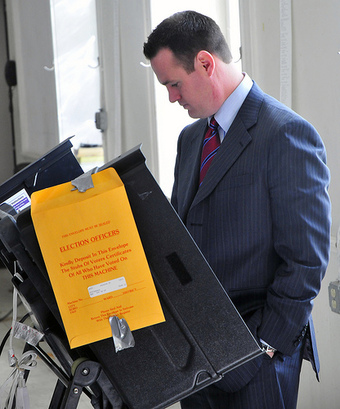
State Initiatives Against Affirmative Action
State referenda have been the most successful way for opponents of affirmative action to limit its reach.
Since the implementation of state policies resisting affirmative action programs, the federal government has pushed back to ensure that affirmative action policies are implemented. In 1973, the U.S. Congress passed Section 717 of Title VII of the Civil Rights Act and Section 501 of the Rehabilitation Act, both of which require all U.S. federal agencies to implement affirmative employment opportunity programs for all federal employees. In 1979, President Carter issued U.S. Executive Order 12138, creating a National Women’s Business Enterprise Policy and requiring government agencies to take affirmative action in support of women’s business enterprises. As for the judicial branch, in 1995, the Supreme Court heard Adarand Constructors v. Peña, which established strict scrutiny standards of review for race and ethnicity-based federal affirmative action programs.
Thus, one can see that affirmative action policies and programs have gone back and forth between the states and federal government, typically with state voters trying to limit the reach of affirmative action and the federal government insisting on implementation.
5.5.8: Regents of the University of California v. Bakke
The 1978 Supreme Court case Bakke was the first case before the Court of affirmative action in higher education.
Learning Objective
Analyze the Supreme Court’s decision in Bakke v. University of California (Davis)
Key Points
- Regents of the University of California v. Bakke (1978) was the first case before the U.S. Supreme Court that evaluated the constitutionality of affirmative action programs in admissions for higher education.
- Bakke held that universities could use affirmative action in admissions and consider racial background “a plus,” but could not establish quota systems like that in place in Bakke.
- The Bakke holding was confusing and far from unanimous. It opened space for decades of further debate over affirmative action in higher education.
Key Terms
- quota systems
-
An affirmative action program in which a certain number of spots in any class of higher education or employment are reserved for minority applicants.
- affirmative action
-
A policy or program providing advantages for people of a minority group with the aim of creating a more racially equal society through preferential access to education, employment, health care, social welfare, etc.
In 1973, Allan Bakke, a 33-year-old white male, applied to 12 medical schools. He had been a National Merit Scholar in high school and graduated from the University of Minnesota with a GPA of 3.51. Bakke had served in Vietnam. After college, he and went on to work as an engineer at NASA. Bakke said that his interest in medicine began while serving in Vietnam and increased at NASA, as he had to consider the problems of space flight for the human body. All 12 schools rejected his application, including the University of California, Davis School of Medicine .

University of California, Davis School of Medicine
Bakke was adjudicated as a result of the 1970’s admissions policies of the University of California, Davis School of Medicine.
At that time, UC Davis was employing an overt form of affirmative action. The school had 100 seats available to applicants, 16 of which were specifically for “Blacks,” “Asians,” “Chicanos,” and “American Indians” under an affirmative action program. By siphoning off these 16 spaces, UC Davis created a separate admissions process for those 16 seats alone. Bakke sued the Regents of the University of California based on the fact that these 16 seats were off limits for him based on race and that minorities had been admitted to fill these 16 seats with lower academic scores than Bakke. He sued to have the state force UC Davis to admit him.
The Supreme Court heard the case in 1978. There were two main issues before the Court: 1) Was it illegal and unconstitutional under Section VI of the Civil Rights Act of 1964 for Bakke’s to be excluded from consideration in UC Davis Medical School special admissions program for minorities? And 2) If Bakke’s exclusion was unconstitutional, should UC Davis be required to admit him?
The strongest contention by the University of California in countering the law suit was the justification of affirmative action by the good of diversity in the classroom. UC Davis’s admissions procedure was designed to increase diversity. UC Davis maintained that the program had originally been developed to 1) reduce the historic deficit of traditionally disfavored minorities in medical schools and the medical profession, 2) counter the effects of societal discrimination, 3) increase the number of physicians who will practice in under served communities, and 4) obtain the educational benefits that flow from a racially diverse student body.
Though fragmented and far from a unanimous decision, the Court ultimately held that affirmative action programs are constitutional. However,quota systems, such as that established by UC Davis, were unconstitutional. In other words, the state could enact programs that preference the applications of minority candidates in the name of campus diversity, but could not reserve a certain number of seats for minority applicants and use an entirely different admissions process.
Bakke is significant for its holding and for the role of the decision in the adjudication of affirmative action. Bakke was the first case the Supreme Court decided that referenced affirmative action policies in higher education. Further, the nuances and confusions surrounding the Bakke decision set the stage for decades of future adjudication over affirmative action. The Court did not establish a precise ruling, but rather opened the door for future debates.
5.5.9: The End of Affirmative Action?
Since Bakke, the Supreme Court has been questioning the constitutionality of affirmative action programs.
Learning Objective
Analyze the two affirmative action cases in which the University of Michigan was involved in the early 2000s
Key Points
- In 2003, Gratz v. Bollinger held that the use of point systems in college admissions, where certain races are given a high number of points, are unconstitutional.
- In 2003, Grutter v. Bollinger held that the consideration of race in law school admissions without a point or quota system is constitutional.
- In 2012, the Court will hear Fisher v. University of Texas which could dismantle the use of affirmative action in public, higher education programs in the US.
- In the United States, multiculturalism is not clearly established in policy at the federal level, but ethnic diversity is common in both rural and urban areas.
- The idea of the Melting pot is a metaphor that implies that all the immigrant cultures are mixed and amalgamated without state intervention.
- Critics of multiculturalism often debate whether the multicultural ideal of benignly co-existing cultures that interrelate and influence one another, and yet remain distinct, is sustainable, paradoxical, or even desirable.
Key Terms
- Fisher v. University of Texas
-
A court case coming before the Supreme Court in 2012 that has the potential to dismantle affirmative action in public education.
- Grutter v. Bollinger
-
A 2003 Supreme Court case that found that considering race without a point or quota system in law school admissions is constitutional.
- Gratz v. Bollinger
-
A 2003 Supreme Court case in which the court held that giving race a certain number of points in admissions decisions at the University of Michigan College of Literature, Science, and Arts was unconstitutional.
Multiculturalism in America
Multiculturalism relates to communities containing multiple cultures. In the United States, multiculturalism is not clearly established in policy at the federal level, but ethnic diversity is common in both rural and urban areas. Continuous mass immigration was a feature of the United States economy and society since the first half of the 19th century. The absorption of the stream of immigrants became, in itself, a prominent feature of America’s national myth. The idea of the Melting pot is a metaphor that implies that all the immigrant cultures are mixed and amalgamated without state intervention
Critics of multiculturalism often debate whether the multicultural ideal of benignly co-existing cultures that interrelate and influence one another, and yet remain distinct, is sustainable, paradoxical, or even desirable. It is argued that Nation states, who would previously have been synonymous with a distinctive cultural identity of their own, lose out to enforced multiculturalism and that this ultimately erodes the host nations’ distinct culture.
Affirmative Action in America
Since the case of Regents of the University of California v.Bakke in 1978, several Supreme Court cases have revisited questions of affirmative action in higher education. The majority of these cases have limited universities’ abilities to incorporate race into admissions .
In 2003, the Supreme Court heard the case of Gratz v. Bollinger, regarding the undergraduate admissions policies of the College of Literature, Science, and Arts at the University of Michigan. The University of Michigan used a 150-point scale to rank applicants, with 100 points needed to guarantee admission. The University gave underrepresented ethnic groups, including African-Americans, Hispanics, and Native Americans an automatic 20-point bonus on the scale. As a point of comparison, a perfect SAT score was worth 12 points. After being denied admission, Jennifer Gratz filed suit on the basis that the University of Michigan’s point system discriminated against her on the basis of race, as she belonged to none of the specified minority groups. The Supreme Court held that the university could still consider race in college admissions, but that the University of Michigan’s ranking and point system was unconstitutional because it gave an automatic point increase to all racial minorities rather than considering what a specific individual could contribute to campus life.
The Supreme Court is expected to rule again on affirmative action in the upcoming term in the case of Fisher v. University of Texas. The case is brought by Abigail Fisher after she was denied admission to the University of Texas at Austin. UT Austin guarantees admission to the top 10% of students in every high school class, regardless of race. Fisher was not in the top 10% and was therefore evaluated based on her merits. She contends that race plays too great of a role in the decision making for students outside of the 10% rule.
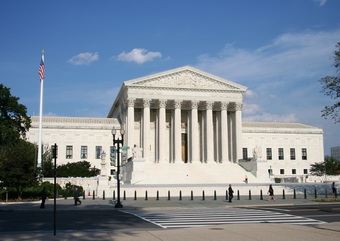
The Supreme Court Building
Since Bakke in 1978, the Supreme Court has slowly been limiting the types of affirmative action programs that are deemed constitutional.
Chapter 4: Civil Liberties
4.1: Civil Liberties and the Bill of Rights
4.1.1: The Bill of Rights
The Bill of Rights is the collective name for the first ten amendments to the US Constitution and they guarantee certain liberties.
Learning Objective
Explain how the Bill of Rights is used to protect natural rights of liberty and property.
Key Points
- The Bill of Rights was introduced by James Madison to the 1st US Congress as a series of legislative articles. Without a Bill of Rights, the Constitution may not have been ratified.
- Originally, the Bill of Rights implicitly and legally protected only white men, excluding American Indians, people considered to be “black” (now described as African Americans), and women.
- The Bill of Rights originally only applied to the federal government, but has since been expanded to apply to the states as well.
- The Bill of Rights includes protections such as freedom of the press, speech, religion, and assembly; the right to due process and fair trials; the right to personal property and other rights.
Key Terms
- Fourteenth Amendment
-
An amendment to the US Constitution containing a clause that has been used to make most of the Bill of Rights applicable to the states, as well as to recognize substantive and procedural rights.
- Bill of Rights
-
The collective name for the first ten amendments to the United States Constitution.
- amendment
-
An addition and/or alteration to the Constitution.
The Bill of Rights
The Bill of Rights is the collective name for the first ten amendments to the United States Constitution . These limitations serve to protect the natural rights of liberty and property. They guarantee a number of personal freedoms, limit the government’s power in judicial and other proceedings, and reserve some powers to the states and the public. While the amendments originally applied only to the federal government, most of their provisions have since been held to apply to the states by way of the Fourteenth Amendment.
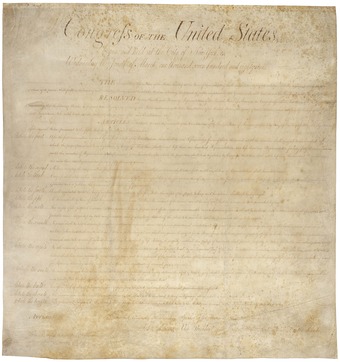
The Bill of Rights of the United States of American
The United States Bill of Rights, which are the first 10 amendments to the US Constitution, and the core of American civil liberties.
History of the Bill of Rights
The Constitution may never have been ratified if a bill of rights had not been added . Most state constitutions adopted during the Revolution had included a clear declaration of the rights of all people, and most Americans believed that no constitution could be considered complete without such a declaration.
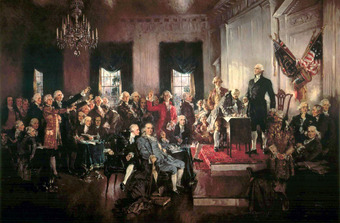
Signing the Constitution
This painting depicts the signing of the US Constitution. Without the addition of the Bill of Rights, it is unlikely that the Constitution would have been ratified.
The amendments that would become the Bill of Rights were introduced by James Madison as a series of legislative articles . They were adopted by the House of Representatives on August 21, 1789, and came into effect as Constitutional Amendments on December 15, 1791, through the process of ratification by three-fourths of the States.
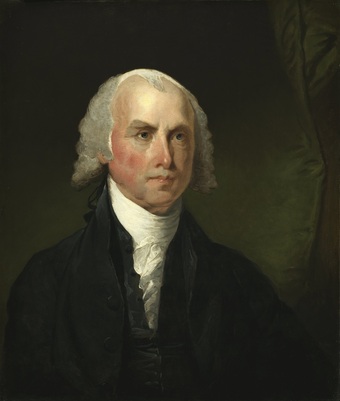
Portrait of James Madison
James Madison, “Father of the Constitution” and first author of the Bill of Rights
Congress passed twelve amendments, yet only ten were originally passed by the states. One of the two rejected amendments dealt with the size of the House of Representatives, and the other rejected amendment provided that Congress could not change the salaries of its members until after an election of representatives had been held (it was ratified 202 years later, becoming the 27th Amendment).
Original Exclusions from the Bill of Rights
The Bill of Rights implicitly and legally only protected white land-owning men, excluding American Indians, people considered to be “black” (now described as African Americans), and women. These exclusions were not explicit in the Bill of Right’s text, but were well understood and applied. Gradually, these exclusions were lifted by subsequent interpretations or amendments, so in contemporary times, the Bill of Rights protects all classes of people.
Protected Rights
- The First Amendment protects freedom of religion, speech, press, assembly and petition.
- The Second Amendment protects the right of Americans to bear arms.
- The Third Amendment prevents the government from quartering (housing) soldiers in civilian’s homes during peace time without the consent of the civilian.
- The Fourth Amendment provides protection from unreasonable search and seizure.
- The Fifth Amendment establishes rights related to due process, double jeopardy, self-incrimination, and eminent domain.
- The Sixth Amendment sets out rights of the accused of a crime: a trial by jury, a speedy trial, a public trial, the right to face the accusers, and the right to counsel.
- The Seventh Amendment protects the right to a trial by jury for civil trials.
- The Eighth Amendment prohibits excessive bail and cruel and unusual punishment.
- The Ninth Amendment protects rights not specifically enumerated in the Constitution. Some people feared that the listing of some rights in the Bill of Rights would be interpreted to mean that other rights not listed were not protected. This amendment was adopted to prevent such a misinterpretation.
- The Tenth Amendment confirms that the states or the people retain all powers not given to the national government. This amendment was adopted to reassure people that the national government would not swallow up the states.
4.1.2: Nationalizing the Bill of Rights
The Bill of Rights were included into state laws through selective incorporation, rather than through full incorporation or nationalization.
Learning Objective
Compare and contrast the difference between nationalization and selective incorporation of the Bill of Rights.
Key Points
- The Bill of Rights were gradually incorporated into state law, through the Due Process Clause of the Fourteenth Amendment.
- There were two opposing viewpoints that debated how the Bill of Rights should be incorporated at the state level. One argued for total incorporation, or nationalization, of the first eight amendments. Others argued for gradual and selective incorporation.
- Justice Hugo Black argued for the nationalization of the Bill of Rights, but the Supreme Court eventually adopted a practice of selective incorporation.
Key Terms
- selective incorporation
-
the process by which American courts have applied certain portions of the U.S. Bill of Rights to the states
- Bill of Rights
-
The collective name for the first ten amendments to the United States Constitution.
- Fourteenth Amendment
-
An amendment to the US Constitution containing a clause that has been used to make most of the Bill of Rights applicable to the states, as well as to recognize substantive and procedural rights.
- incorporation doctrine
-
The process by which American courts have applied portions of the US Bill of Rights to the states, using the Due Process Clause of the Fourteenth Amendment.
Incorporating the Bill of Rights
The incorporation of the Bill of Rights (also called the incorporation doctrine) is the process by which American courts have applied portions of the United States’ Bill of Rights to the states. According to the doctrine of incorporation, the Due Process Clause of the Fourteenth Amendment applies the Bill of Rights to the states.
Prior to the ratification of the Fourteenth Amendment and the development of the incorporation doctrine, the Supreme Court held in Barron v. Baltimore (1833) that the Bill of Rights applied only to the federal government, not to any state governments. However, beginning in the 1920s, a series of United States Supreme Court decisions interpreted the Fourteenth Amendment to “incorporate” most portions of the Bill of Rights, making these portions, for the first time, enforceable against the state governments.
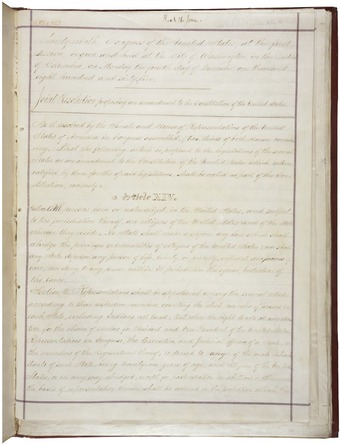
14th Amendment of the United States Constitution
The Fourteenth Amendment, depicted here, allowed for the incorporation of the First Amendment against the states.
Nationalization Versus Selective Incorporation
After the Fourteenth Amendment was passed, the Supreme Court debated how to incorporate the Bill of Rights into state legislation. Some argued that the Bill of Rights should be fully incorporated. This is referred to as “total” incorporation, or the “nationalization” of the Bill of Rights. On the other hand, some believed that incorporation should be selective, in that only the rights deemed fundamental (like the rights protected under the First Amendment) should be applied to the states, and it should be a gradual process. The Supreme Court eventually pursued selective incorporation.
Hugo Black: A Champion for Nationalization
Even though the Supreme Court decided on selective incorporation, there were some who advocated for a total incorporation or nationalization of the Bill of Rights. Justice Hugo Black championed this view. Black called for the nationalization of the first eight amendments of the Bill of Rights (Amendments 9 and 10 being patently connected to the powers of the federal government alone), and his most famous expression of this belief is found in his dissenting opinion in the Supreme Court case, Adamson v. California (1947).
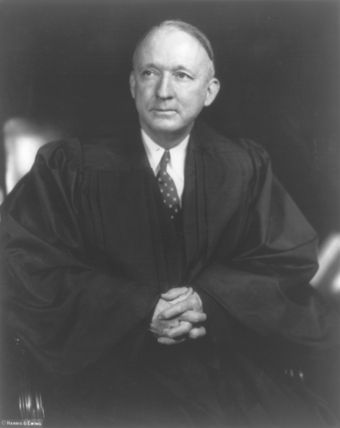
Justice Hugo Black
Supreme Court Justice Hugo Black is noted for the complete nationalization of the Bill of Rights.
4.1.3: Incorporation Doctrine
The incorporation of the Bill of Rights is the process by which American courts have applied portions of the Bill of Rights to the states.
Learning Objective
Indicate how the Bill of Rights was incorporated by the the Federal government in the States
Key Points
- Prior to the 1890s, the Bill of Rights was held only to apply to the federal government, which was a principle solidified even further by a Supreme Court case in 1833 (Barron v. Baltimore).
- The Fourteenth Amendment’s Due Process Clause has been used to apply portions of the Bill of Rights to the state through selective incorporation. This amendment is cited in US litigation more than any other amendment.
- By the last half of the 20th century, nearly all of the first 8 amendments have been incorporated into state law (except the 3rd Amendment, and certain parts of the 5th, 7th, and 8th). The 9th and 10th Amendments apply to the federal government, and so have not been incorporated.
- Incorporation of the Bill of Rights into state law began with the case Gitlow v. New York (1925), in which the Supreme Court upheld that states must respect freedom of speech.
Key Terms
- Fourteenth Amendment
-
An amendment to the US Constitution containing a clause that has been used to make most of the Bill of Rights applicable to the states, as well as to recognize substantive and procedural rights.
- due process
-
The limits of laws and legal proceedings, so as to ensure a person fairness, justice, and liberty.
- incorporation doctrine
-
The process by which American courts have applied portions of the US Bill of Rights to the states, using the Due Process Clause of the Fourteenth Amendment.
What is the Incorporation Doctrine?
As described, the incorporation of the Bill of Rights is the process by which American courts have applied portions of the U.S. Bill of Rights to the states, by virtue of the due process clause of the Fourteenth Amendment of the Constitution.
The Fourteenth Amendment and Moving Towards Incorporation
In Barron v. Baltimore (1833), the Supreme Court declared that the Bill of Rights applied to the federal government, and not to the states. Some argue that the intention of the creator of the Fourteenth Amendment was to overturn this precedent.
The Fourteenth Amendment to the Constitution was adopted on July 9, 1868, as one of the Reconstruction Amendments. Its Due Process Clause prohibits state and local governments from depriving persons of life, liberty, or property without certain steps being taken to ensure fairness. This clause has been used to make most of the Bill of Rights applicable to the states, as well as to recognize substantive and procedural rights .
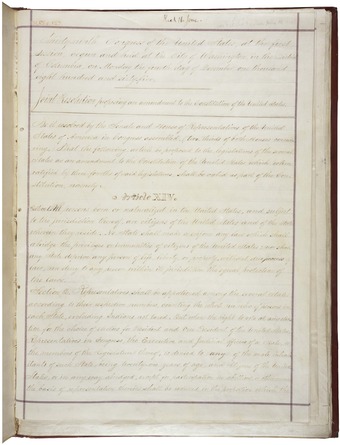
14th Amendment of the United States Constitution
The Fourteenth Amendment, depicted here, allowed for the incorporation of the First Amendment against the states.
The first instance of incorporation include the case Chicago, Burlington and Quincy Railroad v. City of Chicago (1897), in which the Supreme Court required just compensation for property appropriated by state or local authorities (so this was an application of the Fifth Amendment in the Bill of Rights). More commonly, it is argued that incorporation began in the case Gitlow v. New York (1925), in which the Court expressly held that States were bound to protect freedom of speech. Since that time, the Court has steadily incorporated most of the significant provisions of the Bill of Rights.
Selective Incorporation
In Adamson v. California (1947), Supreme Court Justice Hugo Black argued in his dissent that the Supreme Court should pursue nationalization of the Bill of Rights. Despite his opinion, in the following twenty-five years, the Supreme Court employed a doctrine of selective incorporation that succeeded in extending to the States almost of all of the protections in the Bill of Rights, as well as other, unenumerated rights. The Fourteenth Amendment has vastly expanded civil rights protections and is cited in more litigation than any other amendment to the U.S. Constitution.
Which Amendments Have Been Incorporated?
By the latter half of the 20th century, nearly all of the rights in the Bill of Rights had been applied to the states, under the incorporation doctrine.
All of the provisions of Amendment I and Amendment II have been incorporated against the state, while the Third Amendment has not yet been incorporated (the Third Amendment refers to the prohibition on quartering of soldiers in civilian homes).
Amendment IV, unreasonable search and seizure, has been incorporated against the states by the Supreme Court’s decision in Wolf v. Colorado (1949). The exclusion of unlawfully seized evidence has been incorporated against the states in Mapp v. Ohio (1961).
Amendment V, the right to indictment by a grand jury, has been held not to be incorporated against the states, but protection against double jeopardy and protection against self-incrimination have been incorporated against the states in Malloy v. Hogan (1964) .
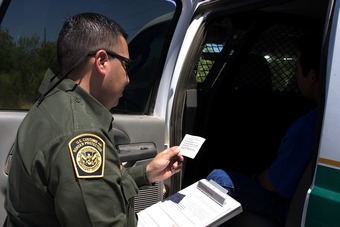
Incorporating Amendment V
Here, a US law enforcement official reads an arrested person his rights. Amendment V, the right to due process, has been incorporated against the states.
Amendment VI, the rights to a speedy, public, and impartial trial have been incorporated against the states, as has the right to counsel in Gideon v. Wainwright (1963) .
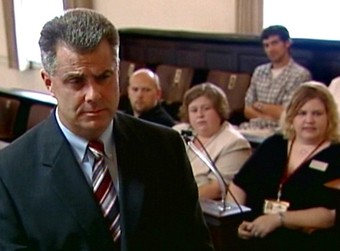
Incorporating Amendment VI
Amendment VI, the right to a trial by a jury and the right to counsel, was incorporated against the states in the case Gideon v. Wainwright (1963). Here, this right is exercised as an attorney asks questions during jury selection.
Amendment VII, right to a jury trial in civil cases, has been held not to be applicable to the states.
Amendment VIII, the right to jury trial in civil cases has been held not to be incorporated against the states, but protection against “cruel and unusual punishments” has been incorporated against the states.
Amendments IX and X have not been incorporated against the states, as they apply expressly to the federal government alone.
4.2: The First Amendment: The Right to Freedom of Religion, Expression, Press, and Assembly
4.2.1: The First Amendment
The First Amendment to the US Constitution is part of the Bill of Rights, and protects core American civil liberties.
Learning Objective
Compare and contrast civil rights with civil liberties with respect to the First Amendment
Key Points
- The First Amendment protects Americans’ rights to religious freedom. As part of this, the US cannot establish a religion nor prevent free exercise of religion.
- The First Amendment protects Americans’ rights to the freedom of speech, press, assembly, and petition.
- Originally, the First Amendment applied only to the federal government. However, Gitlow v. New York (1925) used provisions found in the Fourteenth Amendment to apply the First Amendment to the states as well.
- Some of the rights protected in the First Amendment have roots in other countries’ declarations of rights. In particular, the English Bill of Rights, the French Declaration of the Rights of Man and of the Citizen, and the Philippine Constitution all have similar elements to the First Amendment.
- Clear and present danger was a doctrine adopted by the Supreme Court of the United States to determine under what circumstances limits can be placed on First Amendment freedoms of speech, press or assembly.
- In the 1919 case Schenck v. United States the Supreme Court held that an anti-war activist did not have a First Amendment right to speak out against the draft.
Key Terms
- French Declaration of the Rights of Man and of the Citizen
-
A fundamental document of the French Revolution and in the history of human rights, defining the individual and collective rights of all the estates of the realm as universal.
- First Amendment
-
The first of ten amendments to the constitution of the United States, which protects freedom of religion, speech, assembly, and the press.
- civil liberties
-
Civil rights and freedoms such as the freedom from enslavement, freedom from torture and right to a fair trial.
The First Amendment
The First Amendment (Amendment I) to the United States Constitution is part of the Bill of Rights and protects American civil liberties. The amendment prohibits the making of any law pertaining to an establishment of a federal or state religion, impeding the free exercise of religion, abridging the freedom of speech, infringing on the freedom of the press , interfering with the right to peaceably assemble, or prohibiting the petitioning for a governmental redress of grievances .
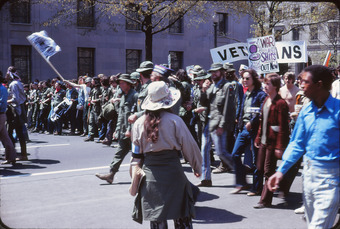
Vietnam War Protest in Washington D.C., April, 1971
The First Amendment established the right to assemble as a core American liberty, as is depicted here in a Vietnam-era assembly.

Freedom of the Press Worldwide
The First Amendment to the Constitution guarantees Americans the right to a free press. This is something that many other countries do not enjoy, as this map illustrates.
The text of the First Amendment reads, “Congress shall make no law respecting an establishment of religion, or prohibiting the free exercise thereof; or abridging the freedom of speech, or of the press; or the right of the people peaceably to assemble, and to petition the Government for a redress of grievances. “
Anti-war protests during World War I gave rise to several important free speech cases related to sedition and inciting violence. Clear and present danger was a doctrine adopted by the Supreme Court of the United States to determine under what circumstances limits can be placed on First Amendment freedoms of speech, press or assembly. Before the twentieth century, most free speech issues involved prior restraint. Starting in the early 1900s, the Supreme Court began to consider cases in which persons were punished after speaking or publishing.
In the 1919 case Schenck v. United States the Supreme Court held that an anti-war activist did not have a First Amendment right to speak out against the draft. The clear and present danger test was established by Justice Oliver Wendell Holmes, Jr. in the unanimous opinion for the case Schenck v. United States, concerning the ability of the government to regulate speech against the draft during World War I. Following Schenck v. United States, “clear and present danger” became both a public metaphor for First Amendment speech and a standard test in cases before the Court where a United States law limits a citizen’s First Amendment rights; the law is deemed to be constitutional if it can be shown that the language it prohibits poses a “clear and present danger.
Incorporating the First Amendment
Originally, the First Amendment applied only to laws enacted by the Congress. However, starting with Gitlow v. New York (1925), the Supreme Court has applied the First Amendment to each state. This was done through the Due Process Clause of the Fourteenth Amendment . The Court has also recognized a series of exceptions to provisions protecting the freedom of speech.
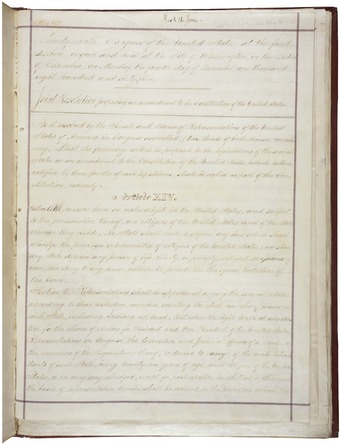
14th Amendment of the United States Constitution
The Fourteenth Amendment, depicted here, allowed for the incorporation of the First Amendment against the states.
Background to the First Amendment
Opposition to the ratification of the Constitution was partly based on the Constitution’s lack of adequate guarantees for civil liberties. To provide such guarantees, the First Amendment, along with the rest of the Bill of Rights, was submitted to the states for ratification on September 25, 1789, and adopted on December 15, 1791.
Comparing the First Amendment to Other Rights Protection Instruments
Some provisions of the United States Bill of Rights have their roots in similar documents from England, France, and the Philippines. The English Bill of Rights, however, does not include many of the protections found in the First Amendment. For example, the First Amendment guarantees freedom of speech to the general populace but the English Bill of Rights protected only free speech in Parliament . A French revolutionary document, the French Declaration of the Rights of Man and of the Citizen, passed just weeks before Congress proposed the Bill of Rights, contains certain guarantees that are similar to those in the First Amendment. Parts of the Constitution of the Philippines, written in 1987, contain identical wording to the First Amendment regarding speech and religion. Echoing Jefferson’s famous phrase, all three constitutions, in the section on Principles, contain the sentence, “The separation of Church and State shall be inviolable”.
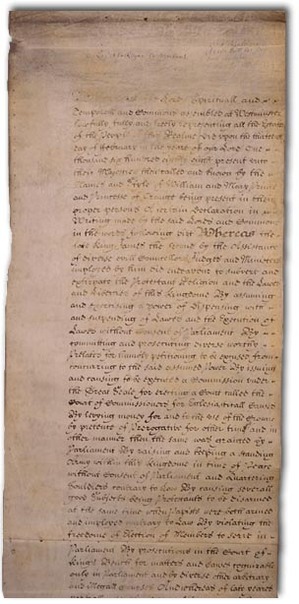
English Bill of Rights
The US Bill of Rights drew many of its First Amendment provisions from other countries’ bill of rights, such as the English Bill of Rights. However, the US Bill of Rights established more liberties than the English Bill of Rights.
Although the First Amendment does not explicitly set restrictions on freedom of speech, other declarations of rights occasionally do. For example, The European Convention on Human Rights permits restrictions “in the interests of national security, territorial integrity or public safety, for the prevention of disorder or crime, for the protection of health or morals, for the protection of the reputation or the rights of others, for preventing the disclosure of information received in confidence, or for maintaining the authority and impartiality of the judiciary. ” Similarly, the Constitution of India allows “reasonable” restrictions upon free speech to serve “public order, security of State, decency or morality. “
Lastly, the First Amendment was one of the first guarantees of religious freedom: neither the English Bill of Rights nor the French Declaration of the Rights of Man and of the Citizen contain a similar guarantee.
4.2.2: Freedom of Religion
Freedom of religion is a constitutionally guaranteed right, established in the First Amendment of the Bill of Rights.
Learning Objective
Summarize the meaning of “freedom of religion” in the U.S. constitution
Key Points
- The protection of religious freedom is laid out in the First Amendment, which states that Congress cannot establish a state religion nor prohibit free exercise of religion.
- The Establishment Clause prevents the U.S. from creating a state or national religion, from favoring one religion over another, or entangling the government with religion.
- The Free Exercise Clause gives all Americans the right to practice their religion freely, without interference or persecution by the government.
Key Terms
- Bill of Rights
-
The collective name for the first ten amendments to the United States Constitution.
- freedom of religion
-
The right of citizens to hold any religious or non-religious beliefs, and to carry out any practices in accordance with those beliefs, so long as they do not interfere with another person’s legal or civil rights, or any reasonable laws, without fear of harm or prosecution.
- civil liberties
-
Civil rights and freedoms such as the freedom from enslavement, freedom from torture and right to a fair trial.
The First Amendment
In the United States, freedom of religion is a constitutionally guaranteed right , laid out in the Bill of Rights. The following religious civil liberties are guaranteed by the First Amendment to the Constitution: “Congress shall make no law respecting an establishment of religion, or prohibiting the free exercise thereof. ” Thus, freedom of religion in the U.S. has two parts: the prohibition on the establishment of a state religion, and the right of all citizens to practice their religion.
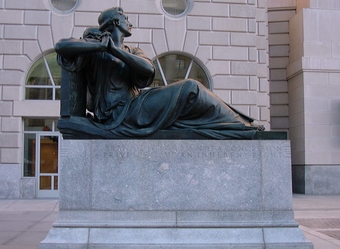
Monument to the Right to Worship
This monument in Washington, DC honors the right to worship. The inscription reads, “Our liberty of worship is not a concession nor a privilege, but an inherent right. “
No U.S. State Religion
Many countries have made one religion into the established (official) church, and support it with government funds . In what is called the Establishment Clause of the First Amendment (“Congress shall make no law respecting an establishment of religion”), Congress is forbidden from setting up, or in any way providing for, an established church. It has been interpreted to forbid government endorsement of, or aid to, religious doctrines. The Federal Government may not establish a national church or religion or excessively involve itself in religion, particularly to the benefit of one religion over another.
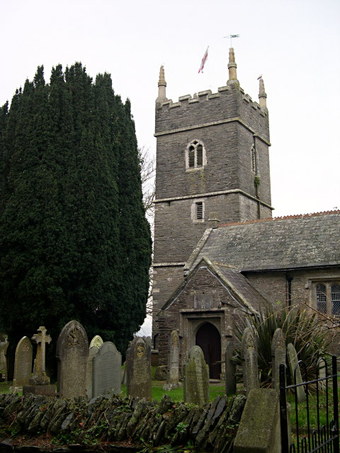
No State Religion
The Establishment Clause of the First Amendment prohibits the creation of a state religion in the U.S. Other countries have had state religions; for instance, the Church of England once dominated religious and political life (former Anglican church depicted here).
Freedom to Practice Religion
In addition to the rights afforded under the Establishment Clause, the Free Exercise Clause of the First Amendment protects the rights of citizens to practice their religions. This clause states that Congress cannot “prohibit the free exercise” of religious practices.
Incorporation of the First Amendment
The Supreme Court has interpreted the 14th Amendment as applying the First Amendment’s provisions on the freedom of religion to states as well as to the Federal Government. Therefore, states must guarantee freedom of religion in the same way the Federal Government must. Many states have freedom of religion established in their constitution, though the exact legal consequences of this right vary for historical and cultural reasons.
Most states interpret “freedom of religion” as including the freedom of long-established religious communities to remain intact and not be destroyed. By extension, democracies interpret “freedom of religion” as the right of each individual to freely choose to convert from one religion to another, mix religions, or abandon religion altogether.
4.2.3: The Establishment Clause: Separation of Church and State
As part of the First Amendment’s religious freedom guarantees, the Establishment Clause requires a separation of church and state.
Learning Objective
Distinguish the Establishment Clause from other clauses of the First Amendment
Key Points
- The Establishment Clause prohibits the creation of a national religion, and also prohibits the US government from favoring one religion over another or excessively entangling itself with religious issues or groups.
- Thomas Jefferson is often cited as being the one who introduced the concept of the separation of church and state.
- The Establishment Clause has been incorporated against the states via the Fourteenth Amendment. However, the process has been tricky, as it is argued that the Fourteenth Amendment speaks to individual rights, while the Establishment Clause does not.
- The Supreme Court has made judgments on three main questions: can the US government give financial assistance to religious groups? Is state-sanctioned prayer in public schools acceptable? Are religious displays in government-affiliated places acceptable?
- The “Lemon Test,” established by Lemon v. Kurtzman (1971) provided a three-part test for determining whether or not a law or act violates the Establishment Clause.
Key Terms
- Lemon Test
-
a method of measuring weather a government action violates the Establishment Clause of the United States’ constitution concerning religion. To pass the test, the action must have a secular legislative purpose, must not have the primary effect of either advancing or inhibiting religion, and must not result in an “excessive government entanglement” with religion.
- Thomas Jefferson
-
Thomas Jefferson (April 13, 1743 (April 2, 1743 O.S.) – July 4, 1826) was an American Founding Father, the principal author of the Declaration of Independence (1776) and the third President of the United States (1801–1809).
- First Amendment
-
The first of ten amendments to the constitution of the United States, which protects freedom of religion, speech, assembly, and the press.
- separation of church and state
-
The distance in the relationship between organized religion and the nation state.
- establishment clause
-
a pronouncement in the First Amendment to the U.S. Constitution which prohibits both the establishment of a national religion by Congress, and the preference by the U.S. government of one religion over another
The Establishment Clause
The Establishment Clause in the First Amendment to the Constitution states, “Congress shall make no law respecting an establishment of religion. ” Together with the Free Exercise Clause (“… or prohibiting the free exercise thereof”), these two clauses make up what are called the “religion clauses” of the First Amendment.
The Establishment Clause has generally been interpreted to prohibit (1) the establishment of a national religion by Congress, or (2) the preference by the U.S. government of one religion over another. The first approach is called the “separation” or “no aid” interpretation, while the second approach is called the “non-preferential” or “accommodation” interpretation. The accommodation interpretation prohibits Congress from preferring one religion over another, but does not prohibit the government’s entry into religious domain to make accommodations in order to achieve the purposes of the Free Exercise Clause.
The “Wall of Separation”
Thomas Jefferson wrote that the First Amendment erected a “wall of separation between church and state”, likely borrowing the language from Roger Williams, founder of the Colony of Rhode Island . James Madison, often regarded as the “Father of the Bill of Rights”, also often wrote of the “perfect separation”, “line of separation”, and “total separation of the church from the state. “
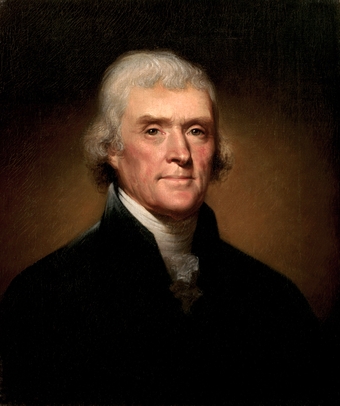
Thomas Jefferson
Founding Father and Third President of the United States. Thomas Jefferson’s phrase “the wall of separation,” is often quoted in debates on the Establishment Clause and the separation of church and state.
Incorporation of the Establishment Clause
Incorporation of the Establishment Clause in 1947 has been tricky and subject to much more critique than incorporation of the Free Exercise Clause. The controversy surrounding Establishment Clause incorporation primarily stems from the fact that one of the intentions of the Establishment Clause was to prevent Congress from interfering with state establishments of religion that existed at the time of the founding.
Critics have also argued that the Due Process Clause of the Fourteenth Amendment is understood to incorporate only individual rights found in the Bill of Rights; the Establishment Clause, unlike the Free Exercise Clause (which critics readily concede protects individual rights), does not purport to protect individual rights.
Controversy Over the Establishment Clause
Controversy rages in the United States between those who wish to restrict government involvement with religious institutions and remove religious references from government institutions and property, and those who wish to loosen such prohibitions. Advocates for stronger separation of church and state emphasize the plurality of faiths and non-faiths in the country, and what they see as broad guarantees of the federal Constitution. Their opponents emphasize what they see as the largely Christian heritage and history of the nation (often citing the references to “Nature’s God” and the “Creator” of men in the Declaration of Independence).
Main Questions of the Establishment Clause
One main question of the Establishment Clause is: does government financial assistance to religious groups violate the Establishment Clause? The Supreme Court first considered this issue in Bradfield v. Roberts (1899). The federal government had funded a hospital operated by a Roman Catholic institution. In that case, the Court ruled that the funding was to a secular organization—the hospital—and was therefore permissible.
Another main question is: should state-sanctioned prayer or religion in public schools be allowed? The Supreme Court has consistently held fast to the rule of strict separation of church and state in this issue. In Engel v. Vitale (1962) the Court ruled that government-imposed nondenominational prayer in public school was unconstitutional. In Lee v. Weisman (1992), the Court ruled prayer established by a principal at a middle school graduation was also unconstitutional, and in Santa Fe Independent School Dist. v. Doe (2000) it ruled that school officials may not directly or indirectly impose student-led prayer during high school football games .
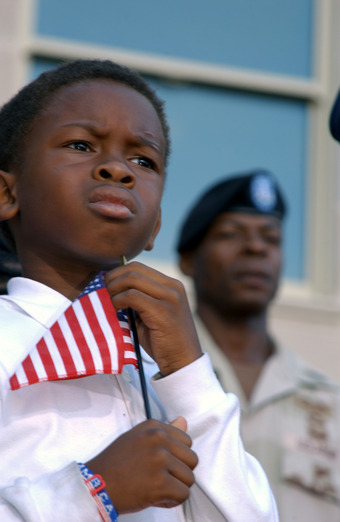
Pledge of Allegiance
In 2002, controversy centered on a California court case that struck down a law providing for the recitation of the Pledge of Allegiance (which includes the phrase “under God”) in classrooms. Congress and the Supreme Court eventually overturned the ruling, demonstrating the controversy that exists in the interpretations of the Establishment Clause.
Lastly, are religious displays in public places allowed under the Establishment Clause? The inclusion of religious symbols in public holiday displays came before the Supreme Court in Lynch v. Donnelly (1984), and again in Allegheny County v. Greater Pittsburgh ACLU (1989). In the former case, the Court upheld a public display, ruling that any benefit to religion was “indirect, remote, and incidental. ” In Allegheny County, however, the Court struck down a display that had more overt religious themes .
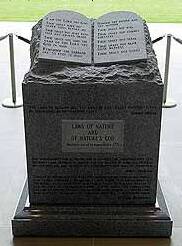
Religious Displays
In 2001, the Chief Justice of Alabama installed a monument to the Ten Commandments in the state judicial building (pictured here). In 2003, a court case determined that this was not allowed under the Establishment Clause.
The Lemon Test
The distinction between force of government and individual liberty is the cornerstone of such cases. Each case restricts acts by government designed to establish a religion, while affirming peoples’ individual freedom to practice their religions. The Court has therefore tried to determine a way to deal with church/state questions. In Lemon v. Kurtzman (1971), the Court created a three part test for laws dealing with religious establishment. This determined that a law related to religious practices was constitutional if it:
- Had a secular purpose;
- Neither advanced nor inhibited religion; and,
- Did not foster an excessive government entanglement with religion.
4.2.4: The Free Exercise Clause: Freedom of Religion
The Free Exercise Clause of the First Amendment establishes the right of all Americans to freely practice their religions.
Learning Objective
Describe how the interpretation of the Free Exercise clause has changed over time.
Key Points
- The Free Exercise Clause and the Establishment Clause (which essentially establishes the separation of church and state), compose the provisions on religious freedom in the First Amendment of the Bill of Rights.
- The interpretation of the Free Exercise Clause has narrowed and widened throughout the past decades. In the late 1800s, the Supreme Court took the view that it acceptable for the government to pass neutral laws that may incidentally impact certain religions.
- During the time of the Warren Court in the 1960s, the Supreme Court took the view that there must be a “compelling interest” in order for religious freedom to be restricted.
- In the 1990s, the Supreme Court moved away from this strict interpretation of the Free Exercise Clause, and removed the idea that there had to be a “compelling interest” in order to violate religious freedom.
- Jehovah Witnesses have been involved in a lot of litigation related to the Free Exercise Clause and, consequently, have helped define its limits.
Key Terms
- strict scrutiny
-
The most stringent standard of legal review in American courts, used to evaluate the constitutionality of laws and government programs.
- Warren Court
-
The Supreme Court of the United States between 1953 and 1969, when Earl Warren served as Chief Justice. Warren led a liberal majority that used judicial power in dramatic fashion, expanding civil rights, civil liberties, judicial power, and the federal power.
- Jehovah’s Witnesses
-
A monotheistic and nontrinitarian Restoration Christian denomination founded in 1879 as a small Bible study group.
- free exercise clause
-
the accompanying clause with the Establishment Clause of the First Amendment to the United States Constitution, which prohibits Congress from interfering with the practices of any religion
The Free Exercise Clause
The Free Exercise Clause is the accompanying clause with the Establishment Clause of the First Amendment to the United States Constitution. The Establishment Clause and the Free Exercise Clause together read:” Congress shall make no law respecting an establishment of religion, or prohibiting the free exercise thereof…” Thus, the Establishment Clause prevents the US from establishing or advocating for a specific religion, while the Free Exercise clause is intended to ensure the rights of Americans to practice their religions without state intervention . The Supreme Court has consistently held, however, that the right to free exercise of religion is not absolute, and that it is acceptable for the government to limit free exercise in some cases.
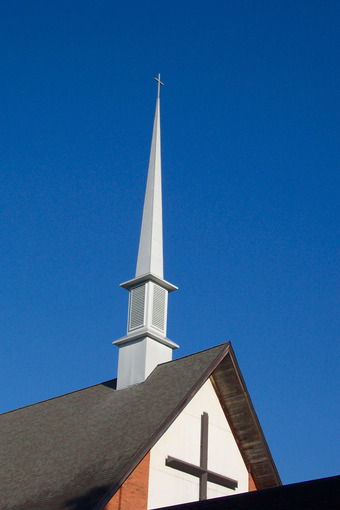
Church and Political Socialization
Participation in organized religion or church attendance can be another important source of political socialization, as churches often teach certain political values.
Interpreting the Free Exercise Clause
The history of the Supreme Court’s interpretation of the Free Exercise Clause follows a broad arc, beginning with approximately 100 years of little attention. Then it took on a relatively narrow view of the governmental restrictions required under the clause. The 1960s saw it grow into a much broader view and later receding again.
In 1878, the Supreme Court was first called to interpret the extent of the Free Exercise Clause in Reynolds v. United States, as related to the prosecution of polygamy under federal law. The Supreme Court upheld Reynolds’ conviction for bigamy, deciding that to do otherwise would provide constitutional protection for a gamut of religious beliefs, including those as extreme as human sacrifice. This case, which also revived Thomas Jefferson’s statement regarding the “wall of separation” between church and state, introduced the position that although religious exercise is generally protected under the First Amendment, this does not prevent the government from passing neutral laws that incidentally impact certain religious practices.
This interpretation of the Free Exercise Clause continued into the 1960s. With the ascendancy of the Warren Court under Chief Justice Earl Warren, a new standard of “strict scrutiny” in various areas of civil rights law was applied. The Court established many requirements that had to be met for any restrictions of religious freedom. For example, in Sherbert v. Verner (1963), the Supreme Court required states to meet the “strict scrutiny” standard when refusing to accommodate religiously motivated conduct. This meant that a government needed to have a “compelling interest” regarding such a refusal. The case involved Adele Sherbert, who was denied unemployment benefits by South Carolina because she refused to work on Saturdays, something forbidden by her Seventh-day Adventist faith.
This view of the Free Exercise Clause would begin to narrow again in the 1980s, culminating in the 1990 case of Employment Division v. Smith. Examining a state prohibition on the use of peyote, the Supreme Court upheld the law despite the drug’s use as part of a religious ritual . In 1993, the Congress passed the Religious Freedom Restoration Act (RFRA), which sought to restore the compelling interest requirement applied in Sherbert v. Yoder. In another case in 1997, the Court struck down the provisions of the Act on the grounds that, while the Congress could enforce the Supreme Court’s interpretation of a constitutional right, the Congress could not impose its own interpretation on states and localities.

Peyote Cactus
Native Americans used peyote (a cactus that has psychedelic effects when ingested) in spiritual rituals. In 1990, the Supreme Court banned the use of this drug, demonstrating a move away from the requirement to show “compelling interest” before limiting religious freedom.
Jehovah’s Witnesses Cases
During the twentieth century, many major cases involving the Free Exercise Clause were related to Jehovah’s Witnesses . Many communities directed laws against the Witnesses and their preaching work. From 1938 to 1955, the organization was involved in over forty cases before the Supreme Court, winning a majority of them. For example, the first important victory came in 1938 with Lovell v. City of Griffin. The Supreme Court held that cities could not require permits for the distribution of pamphlets.

Jehovah’s Witnesses
The specific beliefs and practices (such as a belief in door-to-door proselytizing, depicted here) of the Jehovah’s Witnesses has meant that Jehovah’s Witnesses’ litigation has played a key role in defining the Free Exercise Clause of the First Amendment.
4.2.5: Freedom of Speech
The freedom of speech is a protected right under the First Amendment, and while many categories of speech are protected, there are limits.
Learning Objective
Explain how freedom of speech is protected by the United States Constitution
Key Points
- The Bill of Right’s provision on the freedom of speech was incorporated against the states in Gitlow v. New York (1925).
- Core political speech, expressive speech, and most types of commercial speech are protected under the First Amendment.
- Certain types of speech (particularly, speech that can harm others) is not protected, such as obscenity, fighting words, true threats, child pornography, defamation, or invasion of privacy. Speech related to national security or state secrets may also not be protected.
Key Terms
- defamation
-
Act of injuring another’s reputation by any slanderous communication, written or oral; the wrong of maliciously injuring the good name of another; slander; detraction; calumny; aspersion.
- fighting words
-
agressive words that forseeably may lead to potentially violent confrontation; in law, often considered mitigation for otherwise sanctionable behavior (fighting)
- freedom of speech
-
The right of citizens to speak, or otherwise communicate, without fear of harm or prosecution.
- prior restraint
-
censorship imposed, usually by a government, on expression before the expression actually takes place
- slander
-
a false, malicious statement (spoken or published), especially one which is injurious to a person’s reputation; the making of such a statement
Freedom of Speech
Freedom of speech in the United States is protected by the First Amendment to the United States Constitution and by many state constitutions as well.

Protesting for Freedom of Speech
This individual is protesting for the right to speak freely. Freedom of speech is a closely guarded liberty in American society.
The freedom of speech is not absolute. The Supreme Court of the United States has recognized several categories of speech that are excluded, and it has recognized that governments may enact reasonable time, place, or manner restrictions on speech.
Criticism of the government and advocacy of unpopular ideas that people may find distasteful or against public policy are almost always permitted. There are exceptions to these general protections. Within these limited areas, other limitations on free speech balance rights to free speech and other rights, such as rights for authors and inventors over their works and discoveries (copyright and patent), protection from imminent or potential violence against particular persons (restrictions on fighting words), or the use of untruths to harm others (slander). Distinctions are often made between speech and other acts which may have symbolic significance.
Despite the exceptions, the legal protections of the First Amendment are some of the broadest of any industrialized nation, and remain a critical, and occasionally controversial, component of American jurisprudence.
Incorporation of Freedom of Speech
Although the text of the Amendment prohibits only the United States Congress from enacting laws that abridge the freedom of speech, the Supreme Court used the incorporation doctrine in Gitlow v. New York (1925) to also prohibit state legislatures from enacting such laws.
Protected Speech
The following types of speech are protected:
- Core political speech. Political speech is the most highly guarded form of speech because of its purely expressive nature and importance to a functional republic. Restrictions placed upon core political speech must weather strict scrutiny analysis or they will be struck down.
- Commercial speech. Not wholly outside the protection of the First Amendment is speech motivated by profit, or commercial speech. Such speech still has expressive value although it is being uttered in a marketplace ordinarily regulated by the state.
- Expressive speech. The Supreme Court has recently taken the view that freedom of expression by non-speech means is also protected under the First Amendment. In 1968 (United States v. O’Brien) the Supreme Court stated that regulating non-speech can justify limitations on speech.
Type of Free Speech Restrictions
The Supreme Court has recognized several different types of laws that restrict speech, and subjects each type of law to a different level of scrutiny.
- Content-based restrictions. Restrictions that require examining the content of speech to be applied must pass strict scrutiny. Restrictions that apply to certain viewpoints but not others face the highest level of scrutiny, and are usually overturned, unless they fall into one of the court’s special exceptions.
- Time, place, or manner restrictions. Time, place, or manner restrictions must withstand intermediate scrutiny. Note that any regulations that would force speakers to change how or what they say do not fall into this category (so the government cannot restrict one medium even if it leaves open another).
- Prior restraint. If the government tries to restrain speech before it is spoken, as opposed to punishing it afterwards, it must: clearly define what’s illegal, cover the minimum speech necessary, make a quick decision, be backed up by a court, bear the burden of suing and proving the speech is illegal, and show that allowing the speech would “surely result in direct, immediate and irreparable damage to our Nation and its people. “
Exceptions to Free Speech
Certain exceptions to free speech exist, usually when it can be justified that restricting free speech is necessary to protect others from harm. These restrictions are controversial, and have often been litigated at all levels of the United States judiciary. These restrictions can include include the incitement to crime (such as falsely yelling “Fire! ” in a crowded movie theater); fighting words (which are words that are likely to induce the listener to get in a fight); true threats; obscenity; child pornography; defamation; invasion of privacy; intentional infliction of emotional distress; or certain kinds of commercial, government, or student speech. Speech related to national security, military secrets, inventions, nuclear secrets or weapons may also be restricted.
The flag of the United States is sometimes symbolically burned, often in protest of the policies of the American government, both within the country and abroad. The United States Supreme Court in Texas v. Johnson, 491 U.S. 397 (1989), and reaffirmed in U.S. v. Eichman, 496 U.S. 310 (1990), has ruled that due to the First Amendment to the United States Constitution, it is unconstitutional for a government (whether federal, state, or municipality) to prohibit the desecration of a flag, due to its status as “symbolic speech. ” However, content-neutral restrictions may still be imposed to regulate the time, place, and manner of such expression.

Free Speech Zones
The government may set up time, place, or manner restrictions to free speech. This image is a picture of the free speech zone of the 2004 Democratic National Convention.
4.2.6: Freedom of the Press
The First Amendment guarantees the freedom of the press, which includes print media as well as any other source of information or opinion.
Learning Objective
Indicate the role the Freedom of the Press in the U.S. Constitution and discuss violations to and restrictions of it
Key Points
- In a free press, those who own the press or the media have the right to print or say what they want, without persecution or any interference from the government.
- In the late 1800’s and early 1900’s, the U.S. government violated its guarantee of a free press by prosecuting Civil War era newspapers and passing the Espionage and Sedition Acts of 1917 and 1918. The Supreme Court argued that a “clear and present danger” justified this suppression.
- In recent times, controversy over free press has been related to WikiLeaks, censoring of U.S. military members’ blogs, and “obscenity” censorship of TV and radio by the FCC.
Key Terms
- federal communications commission
-
A U.S. wireless regulatory authority. The FCC was established by the Communications Act of 1934 and is charged with regulating Interstate and International communications by radio, television, wire, satellite, and cable.
- Alien and Sedition Acts
-
Four bills passed in 1798 in the U.S. Congress in the aftermath of the French Revolution and during an undeclared naval war with France. They granted the federal government more power in dealing with political dissidents.
- WikiLeaks
-
WikiLeaks is an international, online, self-described not-for-profit organization that publishes submissions of secret information, news leaks, and classified media from anonymous news sources and whistleblowers.
Freedom of the Press
Freedom of the press in the United States is protected by the First Amendment to the United States Constitution . This clause is generally understood to prohibit the government from interfering with the printing and distribution of information or opinions. However, freedom of the press, like freedom of speech, is subject to some restrictions such as defamation law and copyright law .

Freedom of the Press Worldwide
The First Amendment to the Constitution guarantees Americans the right to a free press. This is something that many other countries do not enjoy, as this map illustrates.

Freedom of the Press
Freedom of the press is a primary civil liberty guaranteed in the First Amendment.
In Lovell v. City of Griffin, Chief Justice Hughes defined the press as, “every sort of publication which affords a vehicle of information and opinion. ” This includes everything from newspapers to blogs . The individuals, businesses, and organizations that own a means of publication are able to publish information and opinions without government interference. They cannot be compelled by the government to publish information and opinions that they disagree with. For example, the owner of a printing press cannot be required to print advertisements for a political opponent, even if the printer normally accepts commercial printing jobs.
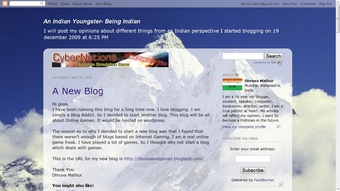
Blogs and Free Press
Not just print media is protected under the freedom of the press; rather, all types of media, such as blogs, are protected.
Incorporation of the Freedom of the Press
In 1931, the U.S. Supreme Court decision in Near v. Minnesota used the 14th Amendment to apply the freedom of the press to the states.
Violations of the Freedom of the Press in U.S. History
In 1798, not long after the adoption of the Constitution, the governing Federalist Party attempted to stifle criticism with the Alien and Sedition Acts. These restrictions on freedom of the press proved very unpopular in the end and worked against the Federalists, leading to the party’s eventual demise and a reversal of the Acts.
In 1861, four newspapers in New York City were all given a presentment by a Grand Jury of the United States Circuit Court for “frequently encouraging the rebels by expressions of sympathy and agreement. ” This started a series of federal prosecutions of newspapers throughout the northern United States during the Civil War which printed expressions of sympathy for southern causes or criticisms of the Lincoln Administration.
The Espionage Act of 1917 and the Sedition Act of 1918 imposed restrictions on free press during wartime. In Schenck v. United States (1919), the Supreme Court upheld the laws and set the “clear and present danger” standard. In other words, the Supreme Court argued that a “clear and present danger,” like wartime, justified specific free press restrictions. Congress repealed both laws in 1921. Brandenburg v. Ohio (1969) revised the “clear and present danger” test to the “imminent lawless action” test, which is less restrictive.
Regulating Press and Media Content
The courts have rarely treated content-based regulation of journalism with any sympathy. In Miami Herald Publishing Co. v. Tornillo (1974), the court unanimously struck down a state law requiring newspapers criticizing political candidates to publish their responses. The state claimed that the law had been passed to ensure journalistic responsibility. The Supreme Court found that freedom, but not responsibility, is mandated by the First Amendment. So, it ruled that the government may not force newspapers to publish that which they do not desire to publish.
However, content-based regulation of television and radio has been sustained by the Supreme Court in various cases. Since there are a limited number of frequencies for non-cable television and radio stations, the government licenses them to various companies. However, the Supreme Court has ruled that the problem of scarcity does not allow the raising of a First Amendment issue. The government may restrain broadcasters, but only on a content-neutral basis. In Federal Communications Commission v. Pacifica Foundation (1978), the Supreme Court upheld the Federal Communications Commission’s authority to restrict the use of “indecent” material in broadcasting.
Recent Restrictions to Freedom of the Press
Some of the recent issues in restrictions of free press include: the U.S. military censoring blogs written by military personnel; the Federal Communications Commission censoring television and radio, citing obscenity; Scientology suppressing criticism, citing freedom of religion; and censoring of WikiLeaks at the Library of Congress. There has also been some controversy over the U.S. government’s position that the media does not have the right to not reveal its sources. There are other critiques that claim the “war on terror” has been a pretext for further restrictions on free press.
4.2.7: Freedom of Assembly and Petition
The First Amendment establishes the right to assembly and the right to petition the government.
Learning Objective
Recognize the role of the Right to Petition clause in the Constitution.
Key Points
- The right to assembly guarantees that Americans have the right to peaceably come together to protest, and also have the right to come together to express and pursue collective interests.
- The right to petition gives citizens the right to appeal to the government to change its policies. It gives citizens the right to stand up for something they think is wrong, or support certain legislation, etc. that can help right those wrongs.
- The right to petition and assembly are interconnected, as they both relate to the freedom of expression. However, the right to assembly protects citizens’ rights to come together, while the right to petition protects citizens’ rights to address the government.
Key Terms
- right to petition
-
The right of citizens of the United States to freely petition the government to address particular grievances or for any reason.
- Alien and Sedition Acts
-
Four bills passed in 1798 in the U.S. Congress in the aftermath of the French Revolution and during an undeclared naval war with France. They granted the federal government more power in dealing with political dissidents.
- freedom of assembly
-
The right of citizens of the United States to freely congregate or assemble anywhere should they desire.
Right to Petition
The Petition Clause in the First Amendment states, “Congress shall make no law… abridging … the right of the people… to petition the government for a redress of grievances. ” The Petition Clause prohibits Congress from restricting the people’s right to appeal to government in favor of or against policies that affect them or about which they feel strongly, including the right to gather signatures in support of a cause and to lobby legislative bodies for or against legislation. A simplified definition of the right to petition is: the right to present requests to the government without punishment or reprisal.
Petition can be used to describe, “any nonviolent, legal means of encouraging or disapproving government action, whether directed to the judicial, executive, or legislative branch. Lobbying, letter-writing, e-mail campaigns, testifying before tribunals, filing lawsuits, supporting referenda, collecting signatures for ballot initiatives, peaceful protests and picketing: all public articulation of issues, complaints and interests designed to spur government action qualifies under the petition clause.”
The right to petition grants people not only the freedom to stand up and speak out against injustices they feel are occurring, but also grants the power to help change those injustices. It is important to note that in response to a petition from a citizen or citizens, the government is not required to actually respond to or address the issue. Under the Petition Clause, the government is only required to provide a way for citizens to petition, and a method in which they will receive the petition.
Limiting the Right to Petition
In the past, Congress has directly limited the right to petition. During the 1790s, Congress passed the Alien and Sedition Acts, punishing opponents of the Federalist Party; the Supreme Court never ruled on the matter. In 1835, the House of Representatives adopted the Gag Rule, barring abolitionist petitions calling for the end of slavery. The Supreme Court did not hear a case related to the rule, which was abolished in 1844. During World War I, individuals petitioning for the repeal of sedition and espionage laws were punished—again, the Supreme Court did not rule on the matter.
Freedom of Assembly and Association
Freedom of Assembly, sometimes used interchangeably with the freedom of association, is the individual right to come together and collectively express, promote, pursue, and defend common interests . The right to freedom of association is recognized as a human and political right, and a civil liberty. Freedom of assembly and freedom of association may be used to distinguish between the freedom to assemble in public places and the freedom of joining an association, but both are recognized as rights under the First Amendment’s provision on freedom of assembly.
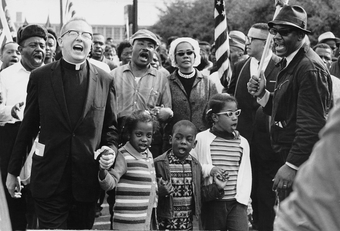
Civil Rights Movement
The right to assembly protects citizens’ rights to gather together to peacefully protest. This right was frequently exercised during the Civil Rights Movement (depicted here).
Freedom of Assembly and Right to Petition
The right of assembly was originally distinguished from the right to petition. In United States v. Cruikshank (1875), the Supreme Court held that “the right of the people peaceably to assemble for the purpose of petitioning Congress for a redress of grievances, or for anything else connected with the powers or duties of the National Government, is an attribute of national citizenship, and, as such, under protection of, and guaranteed by, the United States. ” Justice Waite’s opinion for the Court carefully distinguished the right to peaceably assemble as a secondary right, while the right to petition was labeled to be a primary right. Later cases, however, paid less attention to these distinctions. The right to petition is generally concerned with expression directed to the government seeking redress of a grievance, while the right to assemble is speaking more so to the right of Americans to gather together.
4.3: The Second Amendment: The Right to Bear Arms
4.3.1: The Second Amendment
The Second Amendment gives the right to bear arms, and can arguably apply to individuals or state militias depending on interpretation.
Learning Objective
Summarize the key provision of the Second Amendment and the two rival interpretations of its application
Key Points
- The Second Amendment is part of the US Bill of Rights.
- It gives the right to bear arms in the US, especially for the organization of state militias.
- The right to bear arms was originally seen as a check against the potential tyranny of the new Federal government as well as foreign invasion.
- In the 20th and 21st centuries, there have been conflicts between collective and individual interpretations of the amendment.
- Recent Supreme Court rulings have leaned towards the individual right to bear arms outside of a militia for other legal uses.
Key Term
- militias
-
militia or irregular army is a military force composed of ordinary citizens to provide defense, emergency law enforcement, or paramilitary service, in times of emergency without being paid a regular salary or committed to a fixed term of service.
The Second Amendment: The Right to Bear Arms
The Second Amendment to the US constitution was adopted in 1791 as part of the US Bill of Rights. At the time that the amendment was written, there was controversy around the question of state versus federal rights. Anti-federalists were concerned that the new US government would be able to maintain a standing army, which might be temptation to abuse power. The right to bear arms was seen as a check against tyranny, both domestic and foreign, and was designed to help states easily raise organized militias.
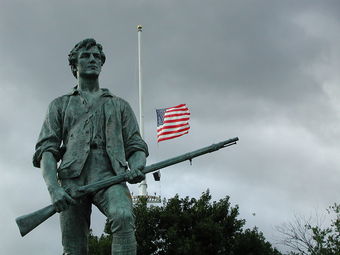
Minute Man
Ideals that helped to inspire the Second Amendment are in part symbolized by the minutemen, civilian colonists who independently organized to form well-prepared militia companies self-trained in weaponry, tactics, and military strategies from the American colonial partisan militia during the American Revolutionary War.
In the 20th century, the wording of Second Amendment has been the focus of controversy. The amendment reads “A well regulated militia, being necessary to the security of a free state, the right of the people to keep and bear arms, shall not be infringed. ” In some interpretations of the bill the right to bear arms is a collective right, exclusively or primarily given to states to arm a militia. Others interpret it as an individual right enabling people to keep and bear arms outside of any organization for other lawful uses.
Recent Supreme Court rulings, including the District of Columbia v. Heller (2008) have leaned towards the individual interpretation of the amendment. This ruling overturned Washington D.C.’s legislation that banned handguns in personal homes. In McDonald v. Chicago (2010), the Supreme Court ruled that Second Amendment rights could not be limited by state or local governments. However, in both cases the court has still ruled that governments can put some restrictions on gun ownership even if they can not ban it outright.
4.4: The Right to Privacy
4.4.1: The Right to Privacy
The Right to Privacy was an article that advocated for the protection of a citizen’s private matters.
Learning Objective
Examine the historical roots of the right to privacy as a legal concept
Key Points
- The right to privacy noted that it had been found necessary to define anew the exact nature and extent of the individual’s protections of person and property. It stated that the scope of such legal rights broadened over time to now include the right to enjoy life and be let alone.
- The article notes that defenses within the law of defamation, the truthfulness of the information published, or the absence of the publisher’s malice, should not be defenses.
- Although the word “privacy” is actually never used in the text of the United States Constitution, there are Constitutional limits to the government’s intrusion into individuals’ right to privacy.
Key Terms
- common law
-
A legal system that gives great precedential weight to common law on the principle that it is unfair to treat similar facts differently on different occasions.
- tort
-
A wrongful act, whether intentional or negligent, that causes an injury and can be remedied at civil law, usually through awarding damages. A delict.
- law of defamation
-
In the United States, a comprehensive discussion of what is and is not libel or slander is difficult because the definition differs between different states. Some states codify what constitutes slander and libel together into the same set of laws.
Example
- The Supreme Court recognized the 14th Amendment as providing a substantive due process right to privacy. This was first recognized by several Supreme Court Justices in Griswold v. Connecticut, a 1965 decision protecting a married couple’s rights to contraception. It was recognized again in 1973 Roe v. Wade, which invoked the right to privacy to protect a woman’s right to an abortion.
Background
United States privacy law embodies several different legal concepts. One is the invasion of privacy. It is a tort based in common law allowing an aggrieved party to bring a lawsuit against an individual who unlawfully intrudes into his or her private affairs, discloses his or her private information, publicizes him or her in a false light, or appropriates his or her name for personal gain.
The Right to Privacy is a law review article written by Samuel Warren and Louis Brandeis. It was published in the 1890 Harvard Law Review. It is one of the most influential essays in the history of American law. The article is widely regarded as the first publication in the United States to advocate a right to privacy, articulating that right primarily as a right to be left alone. It was written primarily by Louis Brandeis although credited to both men, on a suggestion of Warren based on his deep-seated abhorrence of the invasions of social privacy. William Prosser, in writing his own influential article on the privacy torts in American law, attributed the specific incident to an intrusion by journalists on a society wedding. However, in truth it was inspired by more general coverage of intimate personal lives in society columns of newspapers.
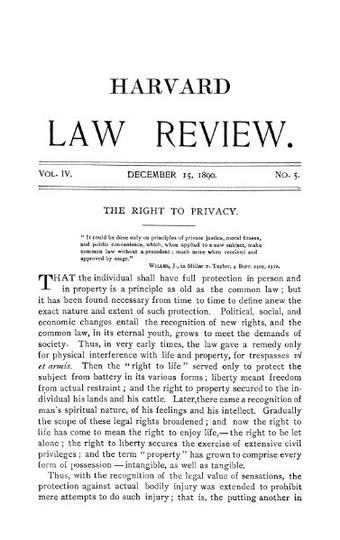
Harvard Law Review, Right to Privacy
The Right to Privacy was published at the Harvard Law Review in 15 December, 1890.
Defining the Necessity of the Right to Privacy
The authors begin the article by noting that it has been found necessary from time to time to define anew the exact nature and extent of the individual’s protections of person and property. The article states that the scope of such legal rights broadens over time — to now include the right to enjoy life — the right to be left alone.
Then the authors point out the conflicts between technology and private life. They note that recent inventions and business methods, such as instant pictures and newspaper enterprise have invaded domestic life, and numerous mechanical devices may make it difficult to enjoy private communications.
The authors discuss a number of cases involving photography, before turning to the law of trade secrets. Finally, they conclude that the law of privacy extends beyond contractual principles or property rights. Instead, they state that it is a right against the world.
Remedies and Defenses
The authors consider the possible remedies available. They also mention the necessary limitations on the doctrine, excluding matters of public or general interest, privileged communications such as judicial testimony, oral publications in the absence of special damage, and publications of information published or consented to by the individual. They pause to note that defenses within the law of defamation — the truthfulness of the information published or the absence of the publisher’s malice — should not be defenses. Finally, they propose as remedies the availability of tort actions for damages and possible injunctive relief.
Modern Tort Law
In the United States today, “invasion of privacy” is a commonly used cause of action in legal pleadings. Modern tort law includes four categories of invasion of privacy:
- Intrusion of solitude: physical or electronic intrusion into one’s private quarters
- Public disclosure of private facts: the dissemination of truthful private information which a reasonable person would find objectionable
- False light: the publication of facts which place a person in a false light, even though the facts themselves may not be defamatory
- Appropriation: the unauthorized use of a person’s name or likeness to obtain some benefits.
Constitutional basis for right to privacy
The Constitution only protects against state actors. Invasions of privacy by individuals can only be remedied under previous court decisions.
The Fourth Amendment to the Constitution of the United States ensures the right of the people to be secure in their persons, houses, papers and effects, against unreasonable searches and seizures, shall not be violated, and no warrants shall issue, but upon probable cause, supported by oath or affirmation, and particularly describing the place to be searched, and the persons or things to be seized.
The First Amendment protects the right to free assembly, broadening privacy rights. The Ninth Amendment declares the fact that if a right is not explicitly mentioned in the Constitution it does not mean that the government can infringe on that right. The Supreme Court recognized the 14th Amendment as providing a substantive due process right to privacy. This was first recognized by several Supreme Court Justices in Griswold v. Connecticut, a 1965 decision protecting a married couple’s rights to contraception. It was recognized again in 1973 Roe v. Wade, which invoked the right to privacy in order to protect a woman’s right to an abortion.
4.4.2: Privacy Rights and Abortion
Abortion rights are can be determined by state courts and the Supreme Court and still continues to be a highly debated right for women.
Learning Objective
Identify the legal court cases that established abortion as a right to privacy and discuss the recent cases and policies that have challenged individuals’ legal right to abortion
Key Points
- Abortion in the United States has been legal in every state since the 1973 Supreme Court decision Roe v. Wade. Prior to the ruling, the legality of abortion was decided by each state; it was illegal in 30 states and legal under certain cases in 20 states.
- The Supreme Court continues to grapple with cases on the subject. On April 18, 2007 it issued a ruling in the case of Gonzales v. Carhart, involving a federal law entitled the Partial-Birth Abortion Ban Act of 2003, which President George W. Bush had signed into law.
- Voter opposition to these ballot initiatives has proven to be far stronger than the support, despite the fact that American citizens poll as being much more evenly divided on the issue of abortion.
Key Term
- trigger laws
-
It is a nickname for a law that is unenforceable and irrelevant in the present, but may achieve relevance and enforceability if a key change in circumstances occurs.
Example
- North Dakota HB 1572 or the Personhood of Children Act, which passed the North Dakota House of Representatives on February 18, 2009, but was later defeated in the North Dakota Senate, aimed to allocate rights to the pre-born, partially born, and if passed, would likely have been used to challenge Roe v. Wade.
Background
Abortion in the United States has been legal in every state since the 1973 Supreme Court decision Roe v. Wade. Prior to the ruling, the legality of abortion was decided by each state; it was illegal in 30 states and legal under certain cases in 20 states. Roe established that the right of personal privacy includes the abortion decision, but that this right is not unqualified, and must be considered against important state interests in regulation.
Before Roe v. Wade, abortion was legal in several areas of the country, but that decision imposed a uniform framework for state legislation on the subject, and established a minimal period during which abortion must be legal (under greater or lesser degrees of restriction throughout the pregnancy). That basic framework, modified in Casey, remains nominally in place, although the effective availability of abortion varies significantly from state to state. Abortion remains one of the most controversial topics in United States culture and politics.
Later judicial decisions
In the 1992 case of Planned Parenthood v. Casey, the Court abandoned Roe’s strict trimester framework. Instead adopting the standard of undue burden for evaluating state abortion restrictions, but reemphasized the right to abortion as grounded in the general sense of liberty and privacy protected under the constitution: “Constitutional protection of the woman’s decision to terminate her pregnancy derives from the Due Process Clause of the Fourteenth Amendment. It declares that no State shall “deprive any person of life, liberty, or property, without due process of law. ” The controlling word in the cases before us is “liberty. “
The Supreme Court continues to grapple with cases on the subject. On April 18, 2007 it issued a ruling in the case of Gonzales v. Carhart, involving a federal law entitled the Partial-Birth Abortion Ban Act of 2003 , which President George W. Bush had signed into law. The law banned intact dilation and extraction, which opponents of abortion rights referred to as “partial-birth abortion,” and stipulated that anyone breaking the law would get a prison sentence up to 2.5 years. The United States Supreme Court upheld the 2003 ban by a narrow majority of 5-4, marking the first time the Court has allowed a ban on any type of abortion since 1973. Justices Antonin Scalia, Clarence Thomas, and the two recent appointees, Samuel Alito and Chief Justice John Roberts, joined the swing vote, which came from moderate justice Anthony Kennedy.
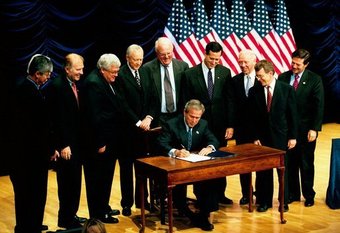
Signing the Partial-Birth Abortion ban.
The Partial-Birth Abortion Ban Act of 2003 is a United States law prohibiting a form of late-term abortion that the Act calls “partial-birth abortion”, often referred to in medical literature as intact dilation and extraction.
State-by-state legal status
Various states have passed legislation on the subject of feticide. On March 6, 2006, South Dakota Governor Mike Rounds signed into law a pro-life statute, which made performing abortions a felony, and that law was subsequently repealed in a November 7, 2006 referendum. On February 27, 2006, Mississippi’s House Public Health Committee voted to approve a ban on abortion, and that bill died after the House and Senate failed to agree on compromise legislation. Several states have enacted trigger laws, which would take effect if Roe v. Wade were overturned. North Dakota HB 1572 or the Personhood of Children Act, which passed the North Dakota House of Representatives on February 18, 2009, but was later defeated in the North Dakota Senate, aimed to allocate rights to the pre-born, partially born, and if passed, would likely have been used to challenge Roe v. Wade.
Voter opposition to these ballot initiatives has proven to be far stronger than the support, despite the fact that American citizens poll as being much more evenly divided on the issue of abortion. Other states are considering personhood amendments banning abortion, some through legislative methods and others through citizen initiative campaigns. Among these states are Florida, Ohio, Georgia, Texas, and Arkansas.
4.4.3: Privacy Rights and National Security
National security practices impact privacy rights for the well-being and domestic security of the United States.
Learning Objective
Explain the underlying tension between national security and civil liberties, identifying the historical roots and institutionalization of the concept of national security
Key Points
- The U.S. National Security Act of 1947 was set up to advise the President on the integration of domestic, military and foreign policies relating to national security.
- The measures adopted to maintain national security has led to ongoing dialectic on the role of authority in matters of civil and human rights.
- If the exercise of national security laws is not subject to good governance, the rule of law, and strict checks and balances, national security may simply serve as a pretext for suppressing unfavorable political and social views.
Key Terms
- rule of law
-
The doctrine that no individual is above the law and that everyone must answer to it.
- dystopia
-
A miserable, dysfunctional state or society that has a very poor standard of living.
- Orwellian
-
An over-controlling government that interferes in nearly every aspect of personal life. The term refers to George Orwell, the author of the fictional 1984, written in 1949, which predicted a future with a “big brother” government.
Example
- In the United States, the controversial USA Patriot Act has raised two main questions – to what extent should individual rights and freedoms be restricted and can the restriction of civil rights for the sake of national security be justified?
Background
The concept of national security became an official guiding principle of foreign policy in the United States when U.S. President Harry S. Truman signed the National Security Act of 1947 on July 26, 1947.
Together with its 1949 amendment, this act stood as the precursor to the Department of Defense. It also established the National Security Council and the Central Intelligence Agency, while subordinating the military branches to the Secretary of Defense. The Act did not define national security. Its ambiguity made it a powerful phrase to invoke whenever issues threatened by other interests of the state came up for discussion and decision.
The realization that national security encompasses more than just military security was present early on. The U.S. National Security Act of 1947 was set up to advise the President on the integration of domestic, military and foreign policies relating to national security.
Rights and Freedoms Under National Security
The measures adopted to maintain national security in the face of threats to society has led to ongoing dialectic, particularly in liberal democracies, on the appropriate scale and role of authority in matters of civil and human rights.
Tension exists between preservation of rights and freedoms of individuals. Although national security measures are imposed to protect society as a whole, many such measures will restrict the rights and freedoms of all individuals in society. The concern is that where the exercise of national security laws is not subject to good governance, the rule of law, and strict checks and balances, national security may simply serve as a pretext for suppressing unfavorable political and social views. Taken to its logical conclusion, this view contends that measures like mass surveillance and censorship of mass media could ultimately lead to an Orwellian dystopia.
In the United States, the politically controversial USA Patriot Act and other government action has raised two main questions – to what extent should individual rights and freedoms be restricted and can the restriction of civil rights for the sake of national security be justified?
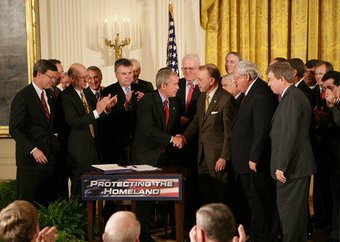
Bush signs USA PATRIOT Improvement and Reauthorization Act
United States President George W. Bush shakes hands with U.S. Senator Arlen Specter after signing H.R. 3199, the USA PATRIOT Improvement and Reauthorization Act of 2005 in the East Room of the White House
4.4.4: Privacy Rights and the Right to Die
There is a wide range of public opinion about the right-to-die movement in the United States, yet It is only legal in a few states.
Learning Objective
Compare and contrast euthanasia and physician aid-in-dying
Key Points
- The key difference between euthanasia and PAD is in who administers the lethal dose of medication. Euthanasia requires the physician or another third party to administer the medication.
- The process of physician assisted suicide, set forth in law, includes requirements that the patient must be of sound mind when requesting assisted suicide as confirmed by a doctor and other witnesses, and the patient must be diagnosed with a terminal illness.
- The Oregon Death with Dignity Act and the Washington statute modeled after it, set certain requirements and safeguards before a person may commit suicide with a doctor’s assistance. The patient must be of sound mind when they request a prescription for a lethal dose of medication.
Key Term
- Euthanasia
-
The act of putting a person or animal to death painlessly or allowing death if suffering from an incurable and painful condition.
Example
- The state of Washington voters saw Ballot Initiative 119 in 1991, the state of California placed Proposition 161 on the ballot in 1992, Oregon voters passed Measure 16 (Death with Dignity Act) in 1994, the state of Michigan included Proposal B in their ballot in 1998, and Washington’s Initiative 1000 passed in 2008.
Background
Euthanasia is illegal in all states of the United States. Physician aid-in-dying (PAD), or assisted suicide, is legal in the states of Washington, Oregon, and Montana. The key difference between euthanasia and PAD is who administers the lethal dose of medication. Euthanasia requires the physician or another third party to administer the medication, whereas PAD requires the patient to self-administer the medication and to determine whether and when to do this. Attempts to legalize PAD resulted in ballot initiatives and “legislation bills” in the United States in the last 20 years, as follows.
- Voters in the state of Washington saw Ballot Initiative 119 in 1991.
- The state of California placed Proposition 161 on the ballot in 1992.
- Oregon voters passed Measure 16 (Death with Dignity Act) in 1994.
- The state of Michigan included Proposal B in their ballot in 1998.
- Washington’s Initiative 1000 passed in 2008.
Public Opinion on Euthanasia in the United States
There is a wide range of public opinion about euthanasia and the right-to-die movement in the United States, which reflects their religious and cultural diversity. During the past 30 years, public opinion research shows that views on euthanasia tend to correlate with religious affiliation and culture, though not gender.
Assisted Suicide in the United States
Physician-assisted suicide in the United States is legal in the states of Oregon, Montana, and Washington . The process is set forth in law, including the requirements that the patient must be of sound mind when requesting assisted suicide, as confirmed by a doctor and other witnesses. The patient must also be diagnosed with a terminal illness.

Map of USA highlighting euthanasia states
Map of the United States highlighting states and districts with legalized physician-assisted suicide.
The Oregon Death with Dignity Act and the Washington statute modeled after it, set certain requirements and safeguards before a person may commit suicide with a doctor’s assistance. The patient must be of sound mind when they request a prescription for a lethal dose of medication. Two doctors must confirm a diagnosis of terminal illness with no more than six months to live. Two witnesses, one non-doctor unrelated to the patient, must confirm the patient’s request, and the patient must make a second request after 15 days.
4.4.5: Privacy Rights and Sexuality
Rights to sexuality allow people in the United States to express sexual orientation without discrimination.
Learning Objective
Identify the legal cases and national legislation that protects people on the grounds of sexual orientation
Key Points
- The right to sexuality, and to freedom from discrimination on the grounds of sexual orientation, is based on the universality of human rights belonging to every person by virtue of being human.
- Same-sex sexual acts between consenting adults of the same sex (depending on the age of consent in each state, varying from age 16 to 21), and adolescents of a close age, have been legal nationwide in the U.S. since 2003, pursuant to the U.S. Supreme Court ruling in Lawrence v. Texas.
- Hate crimes based on sexual orientation or gender identity are punishable by federal law under the Matthew Shepard and James Byrd, Jr. Hate Crimes Prevention Act of 2009.
Key Term
- sexual orientation
-
It describes an enduring pattern of attraction—emotional, romantic, sexual, or some combination of these—to the opposite sex, the same sex, or both sexes, and the genders that accompany them.
Example
- Family and anti-discrimination laws vary by state. States had different laws on the legalization of same-sex marriage until the Supreme Court 5-4 ruling in 2015. In Obergefell v. Hodges, the court said a fundamental right to marry is guaranteed by the Equal Protection Clause of the 14th Amendment, therefore the laws banning such marriages in 14 states were unconstitutional.
Background
The right to sexuality incorporates the right to express one’s sexuality, and to be free from discrimination on the grounds of sexual orientation. It specifically refers to the protection of the rights of people of diverse sexual orientations, including lesbian, gay, bisexual and transgender (LGBT) people (although it is equally applicable to heterosexuality). The right to sexuality, and to freedom from discrimination on the grounds of sexual orientation, is based on the universality of human rights belonging to every person by virtue of being human.

Transgender Symbol
From the female and male symbols. Intersexual or transgender.
The right to sexuality does not exist explicitly in international human rights law; rather, it is found in a number of international human rights instruments including the Universal Declaration of Human Rights, the International Covenant on Civil and Political Rights and the International Covenant on Economic, Social and Cultural Rights.
LGBT Rights in the United States
Lesbian, gay, bisexual, and transgender rights in the United States have evolved over time and vary on a state-by-state basis. Sexual acts between consenting adults of the same sex (depending on the age of consent in each state, varying from age 16 to 21), and adolescents of a close age, have been legal nationwide in the U.S. since 2003, pursuant to the U.S. Supreme Court ruling in Lawrence v. Texas.
Twenty-one states plus Washington, D.C. outlaw discrimination based on sexual orientation, and sixteen states plus Washington, D.C. outlaw discrimination based on gender identity or expression. Hate crimes based on sexual orientation or gender identity are also punishable by federal law under the Matthew Shepard and James Byrd, Jr. Hate Crimes Prevention Act of 2009.
Adoption policies in regard to LGBT parents also varied greatly from state to state, but since March 2016, a federal judge in Mississippi overturned the last remaining state law that prohibited such adoptions.
4.5: The Rights of the Accused
4.5.1: The Rights of the Accused
The rights of the accused include the right to a fair trial; due process; and the right to privacy.
Learning Objective
Identify key first-generation human rights and civil and political rights
Key Points
- The rights of the accused are: the right to a fair trial; due process; to seek redress or a legal remedy; and rights of participation in civil society and politics such as freedom of association, the right to assemble, the right to petition, the right of self-defense, and the right to vote.
- Civil and political rights form the original and main part of international human rights. They comprise the first portion of the 1948 Universal Declaration of Human Rights (with economic, social and cultural rights comprising the second portion).
- Currently, in many countries with a democratic system and the rule of law, criminal procedure puts the burden of proof on the prosecution – that is, it is up to the prosecution to prove that the defendant is guilty beyond any reasonable doubt.
Key Terms
- criminal procedure
-
The legal process for adjudicating claims that someone has violated criminal law.
- first-generation rights
-
First-generation human rights, often called “blue” rights, deal essentially with liberty and participation in political life. They are fundamentally civil and political in nature, as well as strongly individualistic: They serve negatively to protect the individual from excesses of the state. First-generation rights include, among other things, freedom of speech, the right to a fair trial, freedom of religion and voting rights. The idea of three levels of human rights dates to 1979 and is primarily used in European law. This term is rarely, if ever, used in the U.S.
- civil and political rights
-
Civil and political rights are a class of rights based upon birthright into a polity or designation otherwise of human rights. They ensure a citizen’s ability to fully participate in the civil and political life of the state without discrimination or political repression, and protect the freedom of classes of persons and individuals from unwarranted infringement into those rights by governments, private organizations, and other entities.
Example
- An important postwar case was the Civil Rights Cases (1883), in which the constitutionality of the Civil Rights Act of 1875 was at issue. The Act provided that all persons should have “full and equal enjoyment of … inns, public conveyances on land or water, theatres, and other places of public amusement. ” In its opinion, the Court promulgated what has since become known as the “state action doctrine,” which limits the guarantees of the equal protection clause only to acts done or otherwise “sanctioned in some way” by the state. Prohibiting blacks from attending plays or staying in inns was “simply a private wrong,” provided, of course, that the state’s law saw it as a wrong. Justice John Marshall Harlan dissented alone, saying, “I cannot resist the conclusion that the substance and spirit of the recent amendments of the Constitution have been sacrificed by a subtle and ingenious verbal criticism. “
Background
The rights of the accused, include the right to a fair trial; due process; the right to seek redress or a legal remedy; and rights of participation in civil society and politics such as freedom of association, the right to assemble, the right to petition, the right of self-defense, and the right to vote.
Currently, in many countries with a democratic system and the rule of law, criminal procedure puts the burden of proof on the prosecution – that is, it is up to the prosecution to prove that the defendant is guilty beyond any reasonable doubt, as opposed to having the defendant prove that s/he is innocent; any doubt is resolved in favor of the defendant. Similarly, all such jurisdictions allow the defendant the right to legal counsel and provide any defendant who cannot afford their own lawyer with a lawyer paid for at the public expense (which is in some countries called a “court-appointed lawyer”).
First-generation human rights, often called “blue” rights, deal essentially with liberty and participation in political life. They are fundamentally civil and political in nature, as well as strongly individualistic: They serve negatively to protect the individual from the excesses of the state. First-generation rights include, among other things, freedom of speech, the right to a fair trial, freedom of religion and voting rights.
Civil and political rights form the original and main part of international human rights. They comprise the first portion of the 1948 Universal Declaration of Human Rights (with economic, social and cultural rights comprising the second portion). The theory of three generations of human rights considers this group of rights to be “first-generation rights”, and the theory of negative and positive rights considers them to be generally negative rights.

Mural, Falls Road, Belfast.
The mural on the ‘International Wall’ depicts Frederick Douglass (1815-1895), a former slave who became one of the foremost leaders of the abolitionist movement which fought to end slavery within the United States in the decades prior to the Civil War. Douglass later served as an adviser to President Abraham Lincoln during the Civil War and fought for the adoption of constitutional amendments that guaranteed voting rights and other civil liberties for blacks. He is still revered today for his contributions against racial injustice.
Civil and political rights are not codified to be protected, although most democracies worldwide do have formal written guarantees of civil and political rights. Civil rights are considered to be natural rights. Thomas Jefferson wrote in his 1774 A Summary View of the Rights of British America “a free people claim their rights as derived from the laws of nature, and not as the gift of their chief magistrate. “
United States Criminal Procedure
United States criminal procedure derives from several sources of law: the baseline protections of the United States Constitution, federal and state statutes, federal and state rules of criminal procedure (such as the Federal Rules of Criminal Procedure), and state and federal case law either interpreting the foregoing or deriving from inherent judicial supervisory authority.
The United States Constitution, including the United States Bill of Rights and subsequent amendments, contains provisions regarding criminal procedure. Due to the incorporation of the Bill of Rights, all of these provisions apply equally to criminal proceedings in state courts, with the exception of the Grand Jury Clause of the Fifth Amendment, the Vicinage Clause of the Sixth Amendment, and (maybe) the Excessive Bail Clause of the Eighth Amendment.
4.5.2: The Fourth Amendment and Search and Seizure
The Fourth Amendment to the U.S. Constitution is the part of the Bill of Rights guarding against unreasonable searches and seizures.
Learning Objective
Describe the the historical circumstances that generated the Fourth Amendment and the protections the Amendment affords
Key Points
- The Fourth Amendment (Amendment IV) to the United States Constitution is the part of the Bill of Rights guarding against unreasonable searches and seizures, as well as requiring any warrant to be judicially sanctioned and supported by probable cause.
- Police officers are not required to advise a suspect that he/she may refuse a search. There are also some circumstances in which a third party who has equal control, or common authority, over the property may consent to a search.
- When an individual does not possess a reasonable expectation of privacy that society is willing to acknowledge in a particular piece of property, any interference by the government with regard to that property is not considered a search subject to 4th Amendment, and a warrant is never required.
Key Terms
- searches and seizures
-
A legal procedure used in many civil law and common law legal systems whereby police or other authorities and their agents, who suspect that a crime has been committed, conduct a search of a person’s property and confiscate any relevant evidence to the crime.
- Bill of Rights
-
The collective name for the first ten amendments to the United States Constitution.
Example
- In the 1946 case of Oklahoma Press Pub. Co. v. Walling, there was a distinction made between a “figurative or constructive search” and an actual search and seizure. The court held that constructive searches are limited by the Fourth Amendment, while actual searches and seizures require a warrant based on “probable cause.” In the case of a constructive search in which the records and papers sought are of corporate character, the court held that the Fourth Amendment does not apply, since corporations are not entitled to all the constitutional protections of rights created for private individuals.
Background
The Fourth Amendment (Amendment IV) to the United States Constitution is the part of the Bill of Rights ([fig:9477]]) guarding against unreasonable searches and seizures, as well as requiring any warrant to be judicially sanctioned and supported by probable cause. It was adopted as a response to the abuse of the writ of assistance (a type of general search warrant) in the American Revolution. The amendment also states that a search or seizure should be limited in scope according to specific information supplied by law enforcement to the issuing court. The Fourth Amendment applies to the states by way of the Due Process Clause of the Fourteenth Amendment.
The text of the Fourth Amendment states the following: “The right of the people to be secure in their persons, houses, papers, and effects, against unreasonable searches and seizures, shall not be violated, and no Warrants shall issue, but upon probable cause, supported by Oath or affirmation, and particularly describing the place to be searched, and the persons or things to be seized. “
For instance, the owner of the property in question may consent to the search. The consent must be voluntary, but there is no clear method of determining this; rather, a court will consider the “totality of the circumstances” in assessing whether consent was voluntary. Police officers are not required to advise a suspect that he/she may refuse the search. There are also some circumstances in which a third party who has equal control, or common authority, over the property may consent to a search.
When an individual does not possess a “reasonable expectation of privacy” that society is willing to acknowledge in a particular piece of property, any interference by the government with regard to that property is not considered a search subject to the Fourth Amendment, and a warrant is never required. For example, courts have found that a person does not possess a reasonable expectation of privacy in information transferred to a third party, such as writing on the outside of an envelope sent through the mail or left for pick-up in an area where others might view it. While that does not mean that the person has no reasonable expectation of privacy in the contents of that envelope, courts have held that one does not possess a reasonable expectation of privacy that society is willing to acknowledge in the contents of garbage left outside the curtilage of a home.
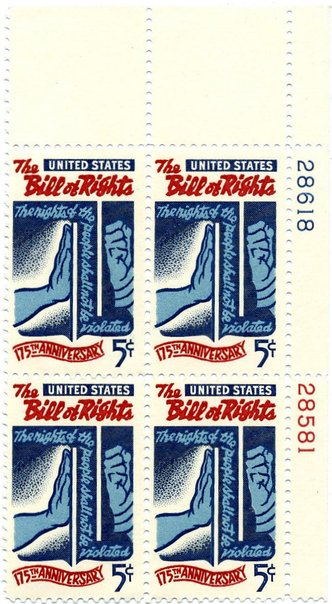
Bill of Rights
175th anniversary of the Bill of Rights commemorated on 1966 US postage stamp Plate block of four.
4.5.3: The Fifth Amendment, Self-Incrimination, and Double Jeopardy
The Fifth Amendment to the U.S. Constitution, which is part of the Bill of Rights, protects against abuse of government authority in a legal procedure.
Learning Objective
Explain the key provisions of the Fifth Amendment, including self-incrimination and double jeopardy.
Key Points
- The Fifth Amendment protects witnesses from being forced to incriminate themselves.
- To “plead the Fifth” is to refuse to answer a question because the response could provide self-incriminating evidence of an illegal act punishable by fines, penalties, or forfeiture.
- The Double Jeopardy Clause encompasses four distinct prohibitions: subsequent prosecution after acquittal, subsequent prosecution after conviction, subsequent prosecution after certain mistrials, and multiple punishments in the same indictment.
Key Term
- Magna Carta
-
The 1215 magna carta, also called charter, required King John of England to proclaim certain liberties and accept that his will was not arbitrary. For example, no “freeman” (in the sense of non-serf) could be punished except through the law of the land. This is a right that is still in existence today.
Example
- Protection against self-incrimination is implicit in the Miranda rights statement, which protects the “right to remain silent.” When a citizen has been apprehended by the police, he or she can exercise their Miranda rights. The Supreme Court has held that “a witness may have a reasonable fear of prosecution and yet be innocent of any wrongdoing.”
The Fifth Amendment, Self-Incrimination, and Double Jeopardy
Background on the Fifth Amendment
The Fifth Amendment (Amendment V) to the United States Constitution, part of the Bill of Rights, protects against abuse of government authority in a legal procedure. Its guarantees stem from English common law, which traces back to the Magna Carta in 1215. For instance, grand juries and the phrase “due process” (also found in the 14th Amendment) both trace their origins to the Magna Carta.
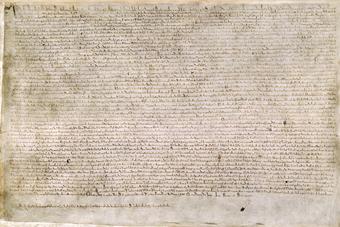
Magna Carta
Magna Carta is one of the major documents in British history that set forth legal precedents that would later be interpreted as protecting the civil rights of English subjects
The text of the Fifth Amendment reads as follows: “No person shall be held to answer for a capital, or otherwise infamous crime, unless on a presentment or indictment of a Grand Jury, except in cases arising in the land or naval forces, or in the Militia, when in actual service in time of War or public danger; nor shall any person be subject for the same offense to be twice put in jeopardy of life or limb; nor shall be compelled in any criminal case to be a witness against himself, nor be deprived of life, liberty, or property, without due process of law; nor shall private property be taken for public use, without just compensation.”
Self Incrimination
The Fifth Amendment protects witnesses from being forced to incriminate themselves. To “plead the Fifth” is to refuse to answer a question because the response could provide self-incriminating evidence of an illegal act punishable by fines, penalties, or forfeiture.
Historically, the legal protection against self-incrimination was directly related to the question of torture for extracting information and confessions.
Protection against self-incrimination is implicit in the Miranda rights statement, which protects the “right to remain silent.” The Supreme Court has held that “a witness may have a reasonable fear of prosecution and yet be innocent of any wrongdoing. The privilege serves to protect the innocent who otherwise might be ensnared by ambiguous circumstances.”
Double Jeopardy
The Double Jeopardy Clause encompasses four distinct prohibitions: subsequent prosecution after acquittal, subsequent prosecution after conviction, subsequent prosecution after certain mistrials, and multiple punishments in the same indictment. Jeopardy “attaches” when the jury is impaneled, the first witness is sworn, or a plea is accepted.
The government is not permitted to appeal or try again after the entry of an acquittal. The prohibition extends to a directed verdict before the case is submitted to the jury, a directed verdict after a deadlocked jury, an appellate reversal for sufficiency (except by direct appeal to a higher appellate court), and an “implied acquittal” via conviction of a lesser included offense.
Blockburger v. United States addresses multiple punishments, including prosecution after conviction. In Blockburger v. United States (1932), the Supreme Court announced the following test: the government may separately try and punish the defendant for two crimes if each crime contains an element that the other does not. Blockburger is the default rule, unless the legislature intends to depart from it via enacted law; for example, Continuing Criminal Enterprise (CCE) may be punished separately from its predicates, as can conspiracy.
The rule for prosecution after mistrials depends on who sought the mistrial. If the defendant moved for a mistrial, there is no bar to retrial, unless the prosecutor acted in bad faith. For example, the prosecutor goads the defendant into moving for a mistrial because the government specifically wanted a mistrial. If the prosecutor moves for a mistrial, there is no bar to retrial if the trial judge finds “manifest necessity” for granting the mistrial. The same standard governs mistrials granted sua sponte.
4.5.4: The Exclusionary Rule
The exclusionary rule holds that evidence collected in violation of the defendant’s rights is sometimes inadmissible.
Learning Objective
Describe the constitutional bases of the exclusionary rule
Key Points
- The exclusionary rule is grounded in the Fourth Amendment and is intended to protect citizens from illegal searches and seizures.
- The exclusionary rule is designed to provide disincentive to prosecutors and police who illegally gather evidence in violation of the Fifth Amendment of the Bill of Rights.
- The exclusionary rule is not applicable to aliens residing outside of U.S. borders. In United States v. Alvarez-Machain, 504 U.S. 655, the U.S. Supreme Court decided that property owned by aliens in a foreign country is admissible in court.
Key Terms
- exclusionary rule
-
A legal principle in the United States, under constitutional law, which holds that evidence collected or analyzed in violation of the defendant’s constitutional rights is sometimes inadmissible for a criminal prosecution in a court of law.
- constitutional right
-
Rights given to citizens by the constitution.
- right to counsel
-
When a citizen accused has the right to be legally represented by a legal defense.
Example
- In 1914, the U.S. Supreme Court announced a strong version of the exclusionary rule in the case of Weeks v. United States under the Fourth Amendment prohibiting unreasonable searches and seizures. This decision, however, created the rule only on the federal level. The “Weeks Rule,” which made an exception for cases at the state level, was adopted by numerous states during prohibition.
Background
The exclusionary rule is a legal principle in the United States holding that evidence collected or analyzed in violation of the defendant’s constitutional rights is sometimes inadmissible for criminal prosecution. This may be considered an example of a prophylactic rule formulated by the judiciary in order to protect a constitutional right. However, in some circumstances, the exclusionary rule may also be considered to follow directly from the constitutional language. For example, the Fifth Amendment’s command that no person “shall be deprived of life, liberty or property without due process of law. “
The exclusionary rule is grounded in the Fourth Amendment and is intended to protect citizens from illegal searches and seizures. The exclusionary rule is also designed to provide disincentive to prosecutors and police who illegally gather evidence in violation of the Fifth Amendment of the Bill of Rights. The exclusionary rule furthermore applies to violations of the Sixth Amendment, which guarantees the right to counsel.
Most states have their own exclusionary remedies for illegally obtained evidence under their state constitutions and/or statutes. This rule is occasionally referred to as a legal technicality because it allows defendants a defense that does not address whether the crime was actually committed. In this respect, it is similar to the explicit rule in the Fifth Amendment protecting people from double jeopardy. In strict cases, when an illegal action is used by police/prosecution to gain any incriminating result, all evidence whose recovery stemmed from the illegal action can be thrown out from a jury.
The exclusionary rule applies to all persons within the United States regardless of whether they are citizens, immigrants (legal or illegal), or visitors.
Limitations of the Rule
The exclusionary rule was passed in 1917, and does not apply in a civil case, a grand jury proceeding, or a parole revocation hearing.
Even in a criminal case, the exclusionary rule does not simply bar the introduction of all evidence obtained in violation of the Fourth, Fifth, or Sixth Amendments.
The exclusionary rule is not applicable to aliens residing outside of U.S. borders. In United States v. Alvarez-Machain, 504 U.S. 655, the Supreme Court decided that property owned by aliens in a foreign country is admissible in court. Prisoners, probationers, parolees and persons crossing U.S. borders are among those receiving limited protections. Corporations, by virtue of being, also have limited rights under the Fourth Amendment (see corporate personhood).
Criticism of the Rule
The exclusionary rule as it has developed in the U.S. has been long criticized, even by respected jurists and commentators. Judge Benjamin Cardozo, generally considered one of the most influential American jurists, was strongly opposed to the rule, stating that under the rule, “The criminal is to go free because the constable has blundered. “

U.S. Supreme Court Seal
The Supreme Court of the United States is the highest court in the country. It has ultimate (but largely discretionary) appellate jurisdiction over all federal courts and over state court cases involving issues of federal law, and original jurisdiction over a small range of cases.
4.5.5: The Sixth Amendment and the Right to Counsel
The Assistance of Counsel Clause in the Sixth Amendment allows to any person accused the right to counsel for his defense.
Learning Objective
Summarize the protections afforded an accused under the Sixth Amendment’s Assistance of Counsel Clause
Key Points
- The assistance of counsel clause includes, as relevant here, five distinct rights: the right to counsel of choice, the right to appointed counsel, the right to conflict-free counsel, the effective assistance of counsel, and the right to represent oneself, in legal terms known as pro se.
- Criminal defendants have a right to be represented by counsel of their choice. The remedy for erroneous depravation of first choice counsel is automatic reversal.
- As stated in Brewer v. Williams, 1977, the right to counsel means at least that a person is entitled to the help of a lawyer at or after the time that judicial proceedings have been initiated against him, whether by formal charge, preliminary hearing, indictment, information, or accusation.
- The pivotal case that established the right to counsel in State courts was Gideon v. Wainwright in 1963. Clarence Earl Gideon was convicted of breaking and entering and was imprisoned. He sent a hand-written appeal to the Supreme Court claiming a right to have counsel provided for him as he could not afford an attorney. The court, in a 9-0 decision, applied the Bill of Rights to the states and determined that indigent defendants are entitled to legal defense at public expense.
Key Terms
- right to counsel
-
When a citizen accused has the right to be legally represented by a legal defense.
- jury proceedings
-
The United States is the only common law jurisdiction in the world that continues to use the grand jury to screen criminal indictments.
Example
- In the 2009-2010 term of the United States Supreme Court, it was handed down that a suspect’s request for legal counsel is only good for fourteen days after the suspect is released from police custody.
Background
The Assistance of Counsel Clause of the Sixth Amendment to the United States Constitution provides: “In all criminal prosecutions, the accused shall enjoy the right . . . to have the Assistance of Counsel for his defense.”
The assistance of counsel clause includes, as relevant here, five distinct rights:
- The right to counsel of choice
- The right to appointed counsel
- The right to conflict-free counsel
- The effective assistance of counsel
- The right to represent oneself pro se
As stated in Brewer v. Williams, 430 U.S. 387 (1977), the right to counsel means “at least that a person is entitled to the help of a lawyer at or after the time that judicial proceedings have been initiated against him, whether by formal charge, preliminary hearing, indictment, information, or accusation.” Brewer goes on to conclude that once adversarial proceedings have begun against a defendant, he has a right to legal representation when the government interrogates him and that when a defendant is arrested, “arraigned on an arrest warrant before a judge” and “committed by the court to confinement . . . there can be no doubt that judicial proceedings have been initiated.”
Individuals subject to grand jury proceedings do not have a Sixth Amendment right to counsel because grand juries are not considered by the U.S. Supreme Court to be criminal proceedings, which trigger the protections of that constitutional protection.
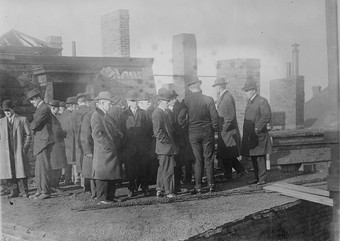
Grand Jury at Arcadia Hotel Fire.
A grand jury investigating the fire that destroyed the Arcadia Hotel in Boston, Massachusetts in 1913.
In the 2009-2010 term of the United States Supreme Court, it was handed down that a suspect’s request for legal counsel is only good for fourteen days after the suspect is released from police custody.
Choice of Counsel
Subject to considerations such as conflicts of interest, scheduling, counsel’s authorization to practice law in the jurisdiction, and counsel’s willingness to represent the defendant (whether pro bono or for a fee), criminal defendants have a right to be represented by counsel of their choice. The remedy for erroneous depravation of first choice counsel is automatic reversal.
Whether counsel is retained or appointed, the defendant has a right to counsel without a conflict of interest. If an actual conflict of interest is present, and that conflict results in any adverse effect on the representation, the result is automatic reversal. The general rule is that conflicts can be knowingly and intelligently waived, but some conflicts are non-waiveable.
Appointment of Counsel
In Powell v. Alabama, 287 U.S. 45 (1932), the Supreme Court ruled that “in a capital case, where the defendant is unable to employ counsel, and is incapable of adequately making his own defense because of ignorance, feeble mindedness, illiteracy, or the like, it is the duty of the court, whether requested or not, to assign counsel for him.” In Johnson v. Zerbst, 304 U.S. 458 (1938), the Supreme Court ruled that in all federal cases, counsel would have to be appointed for defendants who were too poor to hire their own. However, in Betts v. Brady, 316 U.S. 455 (1942), the Court declined to extend this requirement to the state courts under the Fourteenth Amendment unless the defendant demonstrated “special circumstances” requiring the assistance of counsel.
Ineffective Assistance of Counsel
In Strickland v. Washington (1984), the Court held that, on collateral review, a defendant may obtain relief if the defendant demonstrates both that the defense counsel’s performance fell below an objective standard of reasonableness (the “performance prong”) and that, but for the deficient performance, there is a reasonable probability that the result of the proceeding would have been different (the “prejudice prong”).
To satisfy the prejudice prong of Strickland, a defendant who pleads guilty must show that, but for counsel’s deficient performance, he or she would not have plead guilty.
Pro Se Legal Representation in the United States
A criminal defendant may represent himself, unless a court deems the defendant to be incompetent to waive the right to counsel.
In Faretta v. California, 422 U.S. 806 (1975), the Supreme Court recognized the defendant’s right to pro se representation. However, under Godinez v. Moran, 509 U.S. 389 (1993), a court can require a defendant to be represented by counsel if it believes the accused less than fully competent to adequately proceed without counsel.
Some states extend the right to counsel to all matters where a defendant’s liberty interest is threatened. The New Jersey Supreme Court unanimously held that, regardless of whether the proceeding is labeled as civil, criminal, or administrative, if a defendant faces a loss of liberty, she or he is entitled to appointed counsel if indigent. Anne Pasqua, et al. v. Hon. Gerald J. Council, et al., 186 N.J. 127 (2006) (March 2006).
4.5.6: The Sixth Amendment and Jury Trials
The Sixth Amendment U.S. Constitution is the part of the Bill of Rights, which sets forth rights related to criminal prosecutions.
Learning Objective
Summarize the rights afforded to an accused under the Sixth Amendment and describe the protocols in place to achieve the impartiality of the jury to ensure these rights
Key Points
- The Sixth Amendment (Amendment VI) to the U.S. Constitution is the part of the Bill of Rights, which sets forth rights related to criminal prosecutions. The Supreme Court has applied the protections of this amendment to the states through the Due Process Clause of the Fourteenth Amendment.
- The right to a jury has always depended on the nature of the offense with which the defendant is charged.
- The Sixth Amendment requires juries to be impartial. Impartiality has been interpreted as requiring individual jurors to be unbiased.
- The jury panel must represent a fair cross-section of the community.
Key Terms
- petty offenses
-
Criminal offenses punishable by imprisonment for not more than six months and are not covered by the jury requirement.
- voir dire
-
The preliminary phase of a jury trial in which the jurors are examined and selected.
- impartiality
-
The quality of being impartial; fairness.
Background
The Sixth Amendment (Amendment VI) to the United States Constitution is the part of the United States Bill of Rights, which sets forth rights related to criminal prosecutions. The Supreme Court has applied the protections of this amendment to the states through the Due Process Clause of the Fourteenth Amendment.
The Sixth Amendment states the following: “In all criminal prosecutions, the accused shall enjoy the right to a speedy and public trial, by an impartial jury of the State and district wherein the crime shall have been committed, which district shall have been previously ascertained by law, and to be informed of the nature and cause of the accusation; to be confronted with the witnesses against him; to have compulsory process for obtaining witnesses in his favor, and to have the Assistance of Counsel for his defense.”
Impartial Jury
The right to a jury has always depended on the nature of the offense with which the defendant is charged. Petty offenses are those punishable by imprisonment for not more than six months and are not covered by the jury requirement. Even where multiple petty offenses are concerned, the total time of imprisonment possibly exceeding six months, the right to a jury trial does not exist. Also, in the United States, except for serious offenses (such as murder), minors are usually tried in a juvenile court, which lessens the sentence allowed, but forfeits the right to a jury.
Originally, the Supreme Court held that the Sixth Amendment right to a jury trial indicated a right to “a trial by jury as understood and applied at common law, and includes all the essential elements as they were recognized in this country and England when the Constitution was adopted.” Therefore, it was held that juries had to be composed of twelve persons and that verdicts had to be unanimous, as was customary in England.
When, under the Fourteenth Amendment, the Supreme Court extended the right to a trial by jury to defendants in state courts, it re-examined some of the standards. It has been held that twelve came to be the number of jurors by “historical accident,” and that a jury of six would be sufficient, but anything less would deprive the defendant of a right to trial by jury. Although on the basis of history and precedent the Sixth Amendment mandates unanimity in a federal jury trial, the Supreme Court has ruled that the Due Process Clause of the Fourteenth Amendment, while requiring States to provide jury trials for serious crimes, does not incorporate all the elements of a jury trial within the meaning of the Sixth Amendment and does not require jury unanimity.
Impartiality
The Sixth Amendment requires juries to be impartial. Impartiality has been interpreted as requiring individual jurors to be unbiased. At voir dire, each side may question potential jurors to determine any bias, and challenge them if the same is found; the court determines the validity of these challenges for cause. Defendants may not challenge a conviction on the basis that a challenge for cause was denied incorrectly if they had the opportunity to use peremptory challenges.
Another factor in determining the impartiality of the jury is the nature of the panel from which the jurors are selected. The jury panel must represent a fair cross-section of the community; the defendant may establish that the requirement was violated by showing that the allegedly excluded group is a “distinctive” one in the community, that the representation of such a group in venires is unreasonable and unfair in regard to the number of persons belonging to such a group, and that the under-representation is caused by a systematic exclusion in the selection process. Thus, in Taylor v. Louisiana, 419 U.S. 522 (1975), the Supreme Court invalidated a state law that exempted women who had not made a declaration of willingness to serve from jury service, while not doing the same for men.
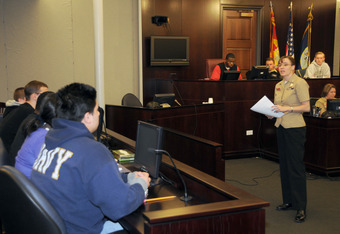
The Jury Panel
Great Lakes, Ill. (Dec. 23, 2008) Legalman 1st Class Christie Richardson, a trial services legalman assigned to Region Legal Service Office Midwest makes an opening statement for the prosecution to a jury during a mock trial. Richardson was part of a legal team demonstrating the legal system for 22 Navy Junior Reserve Officers Training Corps (NJROTC) cadets from Chicago-area high schools.
4.5.7: The Eighth Amendment and Cruel and Unusual Punishment
The Eight Amendment determines the provisions for cruel and unusual punishment.
Learning Objective
Summarize the sources of the Eight Amendment in British history and significance moments in American case law
Key Points
- The Eighth Amendment of the United States Constitution prohibits the federal government from imposing excessive bail, excessive fines or cruel and unusual punishment.
- The Virginia Declaration of Rights of 1776 had already adopted the English Bill of Rights’ stance on cruel and unusual punishment The state later recommended that this language also be included in the Constitution.
- Justice Brennan wrote that no state would violate any one of the four principles prohibiting cruel and unusual punishment. Court decisions regarding the Eighth Amendment would involve a “cumulative” analysis of the implication of each of the four principles.
Key Term
- cadena temporal
-
A former form of punishment overturned by the Supreme Court. It mandated “hard and painful labor,” shackling for the duration of incarceration, and permanent civil disabilities.
Example
- The case of Weems v. United States, (1910), marked the first time that the Supreme Court exercised judicial review to overturn a criminal sentence as cruel and unusual. The Court overturned a punishment called cadena temporal, which mandated “hard and painful labor,” shackling for the duration of incarceration, and permanent civil disabilities. This case is often viewed as establishing a principle of proportionality under the Eighth Amendment
Background
The Eighth Amendment of the United States Constitution prohibits the federal government from imposing excessive bail, excessive fines or cruel and unusual punishments. The U.S. Supreme Court has ruled that this amendment’s Cruel and Unusual Punishment clause applies to states. The phrases employed originated in the English Bill of Rights of 1689.
The Eighth Amendment was adopted as part of the Bill of Rights in 1791. The provision was largely inspired by the case of Titus Oates. The Englishman was tried in 1685 for multiple acts of perjury during the ascension of King James II after a number of people whom Oates had wrongly accused of treason were executed. Oates was sentenced to imprisonment, along with an annual ordeal of whipping and time in the pillory. The Oates case became a topic of the U.S. Supreme Court’s Eighth Amendment jurisprudence. Oates’s punishment involved ordinary penalties collectively imposed in an excessive and unprecedented manner. The reason Oates did not receive the death penalty may be because the punishment would have deterred even honest witnesses from testifying in later cases.
The Virginia Declaration of Rights of 1776 had already adopted the English Bill of Rights’ stance on cruel and unusual punishment The state later recommended that this language also be included in the Constitution.
According to the Supreme Court, the Eighth Amendment forbids some punishments entirely, prohibiting other punishments that are deemed excessive when compared to the crime or the competence of the perpetrator.
Punishments Forbidden for Certain Crimes
The case of Weems v. United States, (1910) marked the first time that the Supreme Court exercised judicial review to overturn a criminal sentence as cruel and unusual. The Court overturned a punishment called cadena temporal, which mandated “hard and painful labor,” shackling for the duration of incarceration and permanent civil disabilities. This case is often viewed as establishing a principle of proportionality under the Eighth Amendment. However, others have written “it is hard to view Weems as announcing a constitutional requirement of proportionality. “
In Trop v. Dulles, (1958), the Supreme Court held that taking away citizenship from a natural-born citizen for a crime was unconstitutional. The punishment was considered “more primitive than torture” because it involved the “total destruction of the individual’s status in organized society. “
In Furman v. Georgia (1972), Justice Brennan wrote that there are four principles by which particular punishment is deemed cruel and unusual : Punishment should not be patently unnecessary, degrading to human dignity, inflicted in a wholly arbitrary fashion, or severe enough to be clearly rejected throughout society.
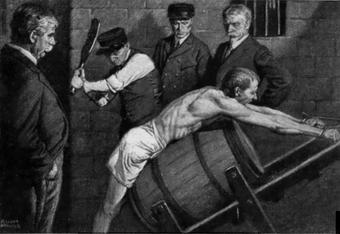
Punishment of the Paddle
This is an old form of punishment.
Justice Brennan also wrote that no state would pass a law violating any one of these principles. Court decisions regarding the Eighth Amendment would hence involve a “cumulative” analysis of the implication of each of the four principles, setting a standard in the way punishments were considered cruel and unusual.
It is up to individual states to decide if death can be considered “cruel and unusual” punishment. As of 2016, 31 states (and the federal government) had death as an acceptable form of punishment.
In California, more than 700 inmates await execution, with the last execution occurring in 2006. Because California’s death penalty was approved by voter initiative, it can only be repealed by voters and not the legislature. Prop. 62 on the Nov. 8, 2016 ballot will ask voters to do repeal its death penalty.
4.5.8: The Miranda Warning
The Miranda warning is a statement read by police to criminal suspects that asserts their right to counsel and right to remain silent.
Learning Objective
Describe the Miranda Rights and the obligations they impose on police
Key Points
- The Miranda warning (also referred to as Miranda rights) is a warning given by police in the United States to criminal suspects in police custody.
- The Miranda rule applies to the use of testimonial evidence in criminal proceedings that is the product of custodial police interrogation. Miranda right to counsel and right to remain silent are derived from the self-incrimination clause of the Fifth Amendment.
- The Miranda rule would apply unless the prosecution can establish that the statement falls within an exception to the Miranda rule. The three exceptions are (1) the routine booking question exception (2) the jailhouse informant exception and (3) the public safety exception.
Key Terms
- testimonial evidence
-
It is the proof given by the product of custodial police interrogation.
- procedure rule
-
It is the body of law that sets out the rules and standards that courts follow when adjudicating civil lawsuits (as opposed to procedures in criminal law matters).
Example
- In Berghuis v. Thompkins, the Court ruled that a suspect must clearly and unambiguously assert right to silence. Merely remaining silent in face of protracted questioning is insufficient to assert the right.
Background
The Miranda warning (also referred to as Miranda rights) is a warning given by police in the United States to criminal suspects in police custody (or in a custodial interrogation) before they are interrogated to preserve the admissibility of their statements against them in criminal proceedings.
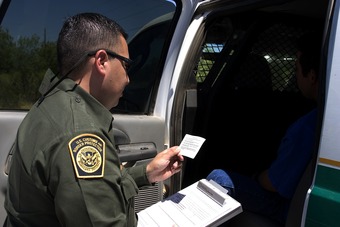
Incorporating Amendment V
Here, a US law enforcement official reads an arrested person his rights. Amendment V, the right to due process, has been incorporated against the states.
In other words, a Miranda warning is a preventive criminal procedure rule that law enforcement is required to administer to protect an individual who is in custody and subject to direct questioning or its functional equivalent from a violation of his or her Fifth Amendment right against compelled self-incrimination. In Miranda v. Arizona, the Supreme Court held that the admission of an elicited incriminating statement by a suspect not informed of these rights violates the Fifth and the Sixth Amendment right to counsel.
Mirada refers to Ernesto Miranda. In 1963 Miranda was arrested in Phoenix and charged with rape, kidnapping, and robbery. Miranda was not informed of his rights prior to the police interrogation. During the two-hour interrogation, Miranda allegedly confessed to committing the crimes, which the police apparently recorded. Miranda, who had not finished ninth grade and had a history of mental instability, had no counsel present. At trial, the prosecution’s case consisted solely of his confession. Miranda was convicted of both rape and kidnapping and sentenced to 20 to 30 years in prison. Miranda appealed to the U.S. Supreme Court and won his case. The Supreme Court devised a statement that must be read to those who are arrested.
Thus in theory, if law enforcement officials decline to offer a Miranda warning to an individual in their custody, they may still interrogate that person and act upon the knowledge gained, but may not use that person’s statements to incriminate him or her in a criminal trial. However, in the pragmatic interactions between police and citizens, this is rarely true. In Berghuis v. Thompkins, the court held that unless a suspect actually states that he is relying on this right, his subsequent voluntary statements can be used in court and police can continue to interact with or question him.
The Miranda rule applies to the use of testimonial evidence in criminal proceedings that is the product of custodial police interrogation. The Miranda right to counsel and right to remain silent are derived from the self-incrimination clause of the Fifth Amendment.
It is important to note that immigrants who live in the United States illegally are also protected and should receive their Miranda warnings as well when being interrogated or placed under arrest. Aliens receive constitutional protections when they have come within the territory of the United States and have developed substantial connections with this country.
Assertion of Miranda Rights
If the defendant asserts his right to remain silent all interrogation must immediately stop and the police may not resume the interrogation unless the police have “scrupulously honored” the defendant’s assertion and obtain a valid waiver before resuming the interrogation. In determining whether the police “scrupulously honored” the assertion the courts apply a totality of the circumstances test. The most important factors are the length of time between the termination of the original interrogation and commencement of the second and a fresh set of Miranda warnings before resumption of interrogation.
The consequences of assertion of Fifth Amendment right to counsel are stricter. The police must immediately cease all interrogation and the police cannot reinitiate interrogation unless counsel is present (merely consulting with counsel is insufficient) or the defendant contacts the police on his own volition. If the defendant does reinitiate contact, a valid waiver must be obtained before interrogation may resume.
In Berghuis v. Thompkins, the Court ruled that a suspect must clearly and unambiguously assert right to silence. Merely remaining silent in face of protracted questioning is insufficient to assert the right.
Exceptions of Miranda Rights
The Miranda rule would apply unless the prosecution can establish that the statement falls within an exception to the Miranda rule. The three exceptions are (1) the routine booking question exception (2) the jailhouse informant exception and (3) the public safety exception. Arguably only the last is a true exception–the first two can better be viewed as consistent with the Miranda factors. For example, questions that are routinely asked as part of the administrative process of arrest and custodial commitment are not considered “interrogation” under Miranda because they are not intended or likely to produce incriminating responses. Nonetheless, all three circumstances are treated as exceptions to the rule.
4.6: Terrorism and Security
4.6.1: The First and Fourth Amendments and Issues of Terrorism and Security
Issues on privacy created new grounds for citizens to battle the constitutionality of security policies enacted after September 11th.
Learning Objective
Describe the safeguards afforded by the Fourth Amendment
Key Points
- The Fourth Amendment states that a warrant must be judicially sanctioned for a search or an arrest. It must be supported by probable cause and be limited in scope according to specific information supplied by a person who has sworn by it .
- The protection of private conversations has been held to apply only to conversations where the participants have a reasonable expectation it is indeed private and no other party is listening in. In the absence of such expectation, the Fourth Amendment does not apply.
- The Supreme Court stated that the First Amendment precludes liability for a media defendant for publication of illegally obtained communications if the topic involves a public controversy and the media defendant itself did nothing illegal to obtain the information.
Key Terms
- whistleblower
-
A person who reveals classified information about an institution operating in either the private or public sector.
- wiretap
-
A concealed device connected to a telephone or other communications system that allows a third party to listen or record conversations.
- provision
-
A clause in a legal instrument, a law, etc., providing for a particular matter and/or stipulation.
Example
- The Fourth Amendment applies to governmental searches and seizures, but not those done by private citizens or organizations that are not acting on behalf of a government. The Bill of Rights originally only restricted the federal government in the matter. However, in Mapp v. Ohio, 1961, the Supreme Court ruled that the Fourth Amendment applies to the states by way of the Due Process Clause of the Fourteenth Amendment. Moreover, all state constitutions contain a similar provision.
Background
Since September 11, 2001, a number of high-profile incidents and security scares have occurred in Washington, D.C. In October 2001, anthrax-contaminated mail sent to members of Congress infected 31 staff members and killed two U.S. Postal Service employees. Issues in disclosing information and the surveillance of the population has created new grounds for citizens to battle the constitutionality of security policies enacted after September 11.
The Fourth Amendment and Issues on Privacy
The Fourth Amendment has been held to mean that a warrant must be judicially sanctioned for a search or an arrest. In order for such a warrant to be considered reasonable, it must be supported by probable cause. It also must be limited in scope according to specific information supplied by a person (usually a law enforcement officer) who has sworn by it and is therefore accountable to the issuing court. The Fourth Amendment applies to governmental searches and seizures. It does not apply to searches and seizures done by private citizens or organizations not acting on behalf of a government. The Bill of Rights originally only restricted the federal government in these matters. However, in Mapp v. Ohio, 1961, the Supreme Court ruled that the Fourth Amendment applies to states by way of the Due Process Clause of the Fourteenth Amendment. Moreover, all state constitutions contain a similar provision.
The protection of private conversations has been held to apply only to conversations where the participants have manifested a reasonable expectation that no other party is listening in on their conversation.The Fourth Amendment does not apply in the absence of such a reasonable expectation, and surveillance without warrant does not violate it. Privacy is clearly not a reasonable expectation in the many countries where governments openly intercept electronic communications, and is of dubious reasonability in countries against which the United States is waging war.
The law also recognizes a distinction between domestic surveillance taking place within U.S. borders and foreign surveillance of non-U.S. persons either in the U.S. or abroad. In United States v. Verdugo-Urquidez, the Supreme Court reaffirmed the principle that the Constitution does not extend protection to non-U.S. persons located outside of the United States. This means no warrant would be required to engage in even physical searches of non-U.S. citizens abroad.
All wiretapping of American citizens by the National Security Agency requires a warrant from a three-judge court set up under the Foreign Intelligence Surveillance Act. After the 9/11 attacks, Congress passed the Patriot Act, which granted the President broad powers to fight a war against terrorism. The George W. Bush administration used these powers to bypass the FISA (Foreign Intelligence Surveillance Act) and directed the NSA to spy directly on al Qaeda in a new NSA electronic surveillance program. Reports at the time indicate that an “apparently accidental glitch” resulted in the interception of communications that were purely domestic in nature. This action was challenged by a number of groups, including Congress, as unconstitutional.

National Security Agency
The seal of the U.S. National Security Agency. The first use was in September 1966, replacing an older seal which was used briefly.
Publication of Unclassified Information
Publicizing information as part of the First Amendment has produced legal and security repercussions between the citizens and the government. The Intelligence Community Whistleblower Protection Act of 1998 is a statutory procedure for a “whistleblower” in the intelligence community to report concerns with the propriety of a secret program . Essentially, the Act provides for disclosure to the agency Inspector General, with an appeal to the Congressional Intelligence Committees if the result of that disclosure is unsatisfactory. Former NSA official Russ Tice has asked to testify under the terms of the Act to provide information about highly classified Special Access Programs (SAPs) that were improperly carried out by both the NSA and the Defense Intelligence Agency.
It is unlikely that the New York Times could be held liable for publishing its article under established Supreme Court precedent. In Bartnicki v. Vopper, 532, the Supreme Court held that the First Amendment precluded liability for publication of illegally obtained communications if the topic involves a public controversy and the information was not obtained by a media defendant illegally. The high court in Bartnicki gave the radio station in question a pass because it did nothing itself illegal to obtain the information, even though the initial broadcast of the information was illegal.
4.6.2: The Right to Due Process
Due process rights provides legal protections while a citizen is charged by the courts and other legal procedures.
Learning Objective
Summarize the protections afforded by the Due Process Clauses of the 5th and 14th Amendments
Key Points
- Due process rights extends to all government proceedings that can result in an individual’s deprivation, whether civil or criminal in nature, from parole violation hearings to administrative hearings regarding government benefits and entitlements to full-blown criminal trials.
- Procedural due process has also been an important factor in the development of the law of personal jurisdiction, in the sense that it is inherently unfair for the judicial machinery of a state to take away the property of a person who has no connection to it.
- The term substantive due process (SDP) is commonly used in two ways: first to identify a particular line of case law, and second to signify a particular attitude toward judicial review under the Due Process Clause.
Key Term
- Judicial Review
-
Judicial review refers to the power of a court to review the constitutionality of a statute or treaty or to review an administrative regulation for consistency with a statute, a treaty, or the Constitution itself.
Example
- In 1934, the United States Supreme Court held that due process is violated “if a practice or rule offends some principle of justice so rooted in the traditions and conscience of our people as to be ranked as fundamental. ” As construed by the courts, it includes an individual’s right to be adequately notified of charges or proceedings, the opportunity to be heard at these proceedings, and that the person or panel making the final decision over the proceedings be impartial in regards to the matter before them.
Background
The Fifth and Fourteenth Amendments to the United States Constitution each contain a Due Process Clause. The Supreme Court of the United States interprets these two clauses as providing four protections: procedural due process in civil and criminal proceedings, substantive due process, a prohibition against vague laws, and as the vehicle for the incorporation of the Bill of Rights .
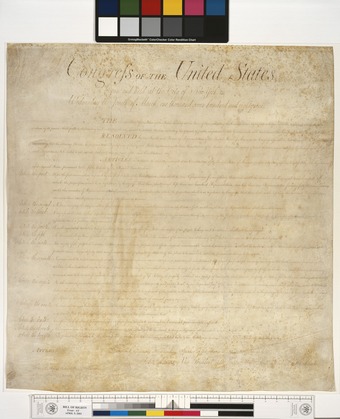
Bill of Rights
This item is the enrolled original joint resolution of Congress, engrossed on parchment, proposing 12 amendments to the United States Constitution. The Federal Government’s official copy of the resolution is signed by Frederick Augustus Muhlenberg, Speaker of the House of Representatives, and John Adams, Vice President of the United States and President of the Senate.
This protection extends to all government proceedings that can result in an individual’s deprivation, whether civil or criminal in nature, from parole violation hearings to administrative hearings regarding government benefits and entitlements to full-blown criminal trials.
Procedural Due Process
At a basic level, procedural due process is essentially based on the concept of fundamental fairness. For example, in 1934, the United States Supreme Court held that due process is violated “if a practice or rule offends some principle of justice so rooted in the traditions and conscience of our people as to be ranked as fundamental. ” As construed by the courts, it includes an individual’s right to be adequately notified of charges or proceedings, the opportunity to be heard at these proceedings, and that the person or panel making the final decision over the proceedings be impartial in regards to the matter before them. To put it more simply, where an individual is facing a deprivation of life, liberty, or property, procedural due process mandates that he or she be entitled to adequate notice, a hearing, and a neutral judge.
Procedural due process has also been an important factor in the development of the law of personal jurisdiction, in the sense that it is inherently unfair for the judicial machinery of a state to take away the property of a person who has no connection to it whatsoever.
The requirement of a neutral judge has introduced a constitutional dimension into the question of whether a judge should recuse himself or herself from a case. Specifically, the Supreme Court has ruled that in certain circumstances, the Due Process Clause of the Fourteenth Amendment requires a judge to recuse himself on account of a potential or actual conflict of interest. For example, on June 8, 2009, in Caperton v. A. T. Massey Coal Co. (2009), the Court ruled that a justice of the Supreme Court of Appeals of West Virginia could not participate in a case involving a major donor to his election to that court.
In criminal cases, many of these due process protections overlap with procedural protections provided by the Eighth Amendment to the United States Constitution, which guarantees reliable procedures that protect innocent people from being executed, which would be an obvious example of cruel and unusual punishment.
Substantive Due Process
The term substantive due process (SDP) is commonly used in two ways: first to identify a particular line of case law, and second to signify a particular attitude toward judicial review under the Due Process Clause. The term substantive due process began to take form in 1930s legal casebooks as a categorical distinction of selected due process cases, and by 1950 had been mentioned twice in Supreme Court opinions.
Today, the Court focuses on three types of rights under substantive due process in the Fourteenth Amendment, which originated in United States v. Carolene, 1938. Those three types of rights are: the first eight amendments in the Bill of Rights (e.g. the Eighth Amendment); restrictions on the political process (e.g. the rights of voting, association, and free speech); and the rights of “discrete and insular minorities.”
4.6.3: Roving Wiretaps
A roving wiretap is a wiretap specific to the United States that follows the surveillance target across his or her private communications.
Learning Objective
Discuss the claims made on behalf of increases in government surveillance and the worries voiced by critics
Key Points
- A roving wiretap follows the target and defeats the target’s attempts at breaking the surveillance by changing location or communications technology.
- In 2007 a United States Foreign Intelligence Surveillance court ruling required that the NSA obtain a warrant when intercepting or eavesdropping on foreign-to-foreign intelligence if it passes through any U.S. networks.
- The ACLU said the language of the bill is a blank check that would cover not only the warrantless wiretapping program that the Bush administration has acknowledged, but any unconfirmed or previously unknown program.
Key Term
- wiretap
-
A concealed device connected to a telephone or other communications system that allows a third party to listen or record conversations.
Example
- The American Civil Liberties Union (ACLU) brought many legal cases challenging the constitutionality of the bill, asserting that it violates Americans’ right to free speech and privacy. They have filed lawsuits, motions, and complaints in over 27 states to oppose any legislation that encourages unchecked government surveillance.
Background
A roving wiretap is a wiretap specific to the United States that follows the surveillance target. For instance, if a target attempts to defeat surveillance by throwing away a phone and acquiring a new one, another surveillance order would usually need to be applied for. However, a roving wiretap defeats the target’s attempts at breaking the surveillance by changing location or their communications technology. It is allowed under amendments made to Title III of the Omnibus Crime Control and Safe Streets Act of 1968 (the Wiretap Statute) in 1988 by the Electronic Communications Privacy Act and was later expanded by section 604 of the Intelligence Authorization Act for Fiscal Year 1999. On May 26, 2011, the U.S. Senate voted to extend the provisions of the 2001 USA PATRIOT Act to search business records and allow for roving wiretaps.

This Phone Is Tapped
The US Patriot Act of 2001, Section 216, permits all phone calls to be recorded without a warrant or notification.
NSA warrantless surveillance controversy
In 2007 a United States Foreign Intelligence Surveillance court ruling required that the NSA obtain a warrant when intercepting or eavesdropping on foreign-to-foreign intelligence if it passes through any U.S. networks. In response, the Bush administration passed stopgap legislation very quickly through Congress that temporarily relieved the NSA of this prior ruling. Director of National Intelligence Mike McConnell remarked to Congress that the new ruling could potentially decrease the amount of useful information they collected on groups like al-Qaeda by almost two thirds. He also stated that since applying for a warrant can run up to 90 pages, the process is exceedingly time consuming and labor intensive.
The American Civil Liberties Union (ACLU) brought many legal cases challenging the constitutionality of the bill, asserting that it violates Americans’ right to free speech and privacy. They have filed lawsuits, motions, and complaints in over 27 states to oppose any legislation that encourages unchecked government surveillance. In response to the government arguments, Caroline Fredrickson, Director of the ACLU Washington Legislative Office has said of the bill: “Where will Congress go from here? More unfettered power for an administration that has no respect for the privacy of the citizenry that elected it? “
The stopgap expired in February 2008. By then, Congress and FISA reached a compromise on the details of the bill. ACLU advocates pushed to require that the NSA provide individual warrants when Americans were involved. On the other hand, U.S. intelligence agencies and the administration wanted as few obstacles in their way of intercepting private information. Both sides have shown the possibility of accepting a bill that would require a FISA court to approve NSA’s procedures while intercepting foreign intelligence when it comes to Americans.
However, a later addition to this bill, that was insisted on by then President Bush and Mike McConnell, granted retroactive immunity to telecommunications companies for any “intelligence activity involving communications that was designed to detect or prevent a terrorist attack” or attack preparations. The Bush administration has acknowledged that intelligence agencies conducted warrantless eavesdropping on Americans with the help of Telecom companies such as Verizon, AT&T, and Qwest. All three of these Telecom companies faced multiple civil lawsuits related to their handling of phone records and the passing of this bill granted them immunity.
In favor of the bill, McConnell has stated that such immunity was necessary to prevent the telecoms from being bankrupted and to encourage them to continue to cooperate with intelligence agencies. Bush said that he would veto any intelligence bill passed that did not include such immunity. Liz Rose, spokeswoman for the Washington office of the ACLU, said the language of the bill is a blank check that would cover not only the warrantless wiretapping program that the Bush administration has acknowledged, but any unconfirmed or previously unknown program. Senator Russ Feingold from the District of Washington promised to lead a filibuster to block approval of retroactive immunity. Retroactive immunity set the terrible precedent that breaking the law is permissible and companies need not worry about the privacy of their customers, Feingold said.
Legal issues
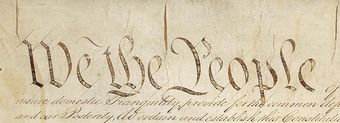
United States Constitution
“We the People”, as it appears in an original copy of the Constitution.
The NSA surveillance controversy involves legal issues that fall into two broad disciplines: statutory interpretation and Constitutional law. Statutory interpretation is the process of interpreting and applying legislation to the facts of a given case. Constitutional law is the body of law that governs the interpretation of the United States Constitution and covers such legal areas as the relationship between the federal government and state governments, the rights of individuals, and other fundamental aspects of the application of government authority in the United States.
4.6.4: The PATRIOT and Freedom Acts
The controversial Patriot Act was enacted following September 11 to protect national security, and allows the government extensive power over surveillance.
Learning Objective
Identify the key provisions of the Patriot Act and the controversies that followed from it
Key Points
- The act expanded the definition of terrorism to include domestic terrorism, thus enlarging the number of activities to which the USA PATRIOT Act’s expanded law enforcement powers can be applied.
- The USA PATRIOT Act has generated a great deal of controversy since its enactment. Opponents of the Act have been quite vocal in asserting that it was passed opportunistically after the September 11 attacks, believing there to have been little debate.
- Critics such as EPIC and the ACLU strongly criticized the law for violating the Fourth Amendment, with the ACLU going so far as to release an advertisement condemning it and calling for it to be repealed.
Key Term
- jurisdiction
-
the power, right, or authority to interpret and apply the law
Example
- One prime example of a controversy of the Patriot Act is shown in the recent court case United States v. Antoine Jones. A nightclub owner was linked to a drug trafficking stash house via a law enforcement GPS tracking device that had been attached to his car.
Background of the PATRIOT Act
The Uniting and Strengthening America by Providing Appropriate Tools Required to Intercept and Obstruct Terrorism Act (USA PATRIOT Act), also commonly known as the Patriot Act, is an Act of the U.S. Congress that was signed into law by President George W. Bush on October 26, 2001. The Patriot Act came as a response to the terrorist attacks of September 11th and included:
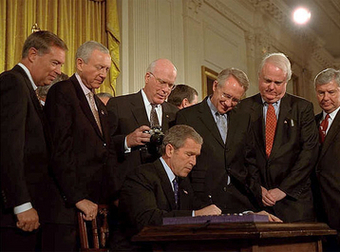
Patriot Act Signing
President George W. Bush signs the Uniting and Strengthening America by Providing Appropriate Tools Required to Intercept and Obstruct Terrorism (USA PATRIOT) Act, Anti-Terrorism Legislation, in the East Room Oct. 26. “With my signature, this law will give intelligence and law enforcement officials important new tools to fight a present danger,” the President said in his remarks.
- A significant reduction of restrictions to law enforcement agencies’ gathering of intelligence within the United States
- An expansion of the Secretary of the Treasury’s authority to regulate financial transactions, particularly those involving foreign individuals and entities
- A broadening of the discretion allowed to law enforcement and immigration authorities in detaining and deporting immigrants suspected of terrorism-related acts.
The act also expanded the definition of terrorism to include domestic terrorism, thus enlarging the number of activities to which the USA PATRIOT Act’s expanded law enforcement powers can be applied. On May 26, 2011, President Barack Obama used an Autopen to sign a four-year extension of three key provisions in the USA PATRIOT Act: roving wiretaps, searches of business records (the library records provision), and conducting surveillance of lone wolves– individuals suspected of terrorist-related activities not linked to terrorist groups. Republican leaders questioned whether the use of the Autopen met the constitutional requirements for signing a bill into law.
Due to its controversial nature, a number of bills were proposed to amend the USA PATRIOT Act. These included the Protecting the Rights of Individuals Act, the Benjamin Franklin True Patriot Act, and the Security and Freedom Ensured Act (SAFE), none of which passed. In late January 2003, the founder of the Center for Public Integrity, Charles Lewis, published a leaked draft copy of an Administration proposal titled the Domestic Security Enhancement Act of 2003. This highly controversial document was quickly dubbed “PATRIOT II” or “Son of PATRIOT” by the media and organizations such as the Electronic Frontier Foundation. The draft, which was circulated to ten divisions of the Department of Justice, proposed to make further extensive modifications to extend the USA PATRIOT Act. It was widely condemned, although the Department of Justice claimed that it was only a draft and contained no further proposals.
Controversy
The USA PATRIOT Act has generated a great deal of controversy since its enactment. Opponents of the Act have been quite vocal in asserting that it was passed opportunistically after the September 11 attacks. Opponents view the Act as one that was hurried through the Senate with little change or debate before it was passed. Senators Patrick Leahy and Russell Feingold proposed amendments to modify the final revision.
It was placed there without a warrant, which caused a serious conviction obstacle for federal prosecutors in court. Through the years the case has risen to the United States Supreme Court where the conviction was overturned in favor of the defendant. The court found that increased monitoring of suspects caused by such legislation like the Patriot Act directly put the suspects Constitutional rights in jeopardy.
The USA PATRIOT Act’s expansion of court jurisdiction to allow the nationwide service of search warrants proved controversial for the Electronic Frontiers Foundation (EFF). They believe that agencies will be able to shop for judges that have demonstrated a strong bias toward law enforcement with regard to search warrants, and use only those judges least likely to say no even if the warrant doesn’t satisfy the strict requirements of the Fourth Amendment to the Constitution. They also believe that the expansion reduces the likelihood that smaller ISPs or phone companies will try to protect the privacy of their clients by challenging the warrant in court; for example a small San Francisco ISP served with such a warrant may be unlikely to have the resources to appear before the New York court that issued it. They also assert that only the communications provider will be able to challenge the warrant as only they will know about it; many warrants are issued ex parte, which means that the target of the order is not present when the order is issued.
For a time, the USA PATRIOT Act allowed for agents to undertake “sneak and peek” searches. Critics such as the Electronic Privacy Information Center (EPIC) and the American Civil Liberties Union (ACLU) strongly criticized the law for violating the Fourth Amendment, with the ACLU going so far as to release an advertisement condemning it and calling for it to be repealed. However, supporters of the amendment such as Heather Mac Donald, a fellow at the Manhattan Institute and a contributing editor to the New York City Journal, expressed the belief that the act was necessary because the temporary delay in notification of a search order could stop terrorists from tipping off counterparts under investigation.
The USA Freedom Act
The USA FREEDOM Act (“Uniting and Strengthening America by Fulfilling Rights and Ending Eavesdropping, Dragnet-collection and Online Monitoring Act”), more commonly known as the Freedom Act, is a U.S. law that was enacted on June 2, 2015, the day after the PATRIOT Act expired. The Freedom Act modified several provisions of the Patriot Act and limited the ability of American intelligence agencies, such as the NSA, to bulk-collect telecommunications data on US citizens. It restored authorization for roving wiretaps and tracking “lone wolf” terrorists.
4.6.5: National Security Agency Surveillance
After 9/11 attacks, the United States government passed and extended policies of surveillance for public citizens.
Learning Objective
Summarize the history of the warrantless surveillance controversy and its relationship to the so-called war on terror
Key Points
- The NSA warrantless surveillance controversy concerns surveillance of persons within the United States during the collection of foreign intelligence by the U.S. National Security Agency (NSA) as part of the war on terror.
- If no fair reading of Foreign Intelligence Surveillance Act can be found in satisfaction of the canon of avoidance, these issues will have to be decided at the appellate level, by United States courts of appeals.
- As part of the terrorist surveillance program, the NSA was authorized by executive order to monitor phone calls, Internet activity (web, e-mail, etc. ), text messaging, and other communications, all without search warrants.
Key Term
- executive order
-
A legally enforceable order, decree, or regulation issued on the authority of the head of the executive branch of government.
Example
- Corporate secrecy can be an issue. In a letter to the EFF, AT&T objected to the filing of the documents in any manner, saying that they contain sensitive trade secrets and could be “used to ‘hack’ into the AT&T network, compromising its integrity. ” [103] However, Chief Judge Vaughn Walker stated, during the September 12, 2008 hearing in the class-action lawsuit filed by the EFF, that the Klein evidence could be presented in court, effectively ruling that AT&T’s trade secret and security claims were unfounded.
Background
The NSA warrantless surveillance controversy concerns surveillance of persons within the United States during the collection of foreign intelligence by the U.S. National Security Agency (NSA) as part of the war on terror. Under this program, referred to by the Bush administration as the terrorist surveillance program, part of the broader President’s Surveillance Program, the NSA was authorized by executive order to monitor, without search warrants, the phone calls, Internet activity (web, email, etc.), text messaging, and other communication involving any party believed by the NSA to be outside the U.S., even if the other end of the communication lies within the U.S. Critics, however, claimed that it was an attempt to silence critics of the Bush administration and their handling of several hot button issues during its tenure. Under public pressure, the Bush administration ceased the warrantless wiretapping program in January 2007 and returned review of surveillance to the FISA court. Subsequently, in 2008 Congress passed the FISA (Foreign Intelligence Surveillance Act) Amendments Act of 2008, which relaxed some of the original FISA court requirements.

National Security Agency
The seal of the U.S. National Security Agency. The first use was in September 1966, replacing an older seal which was used briefly.
During the Obama Administration, the NSA has officially continued operating under the new FISA guidelines. However, in April 2009, officials at the United States Department of Justice acknowledged that the NSA had engaged in over-collection of domestic communications in excess of the FISA court’s authority, but claimed that the acts were unintentional and had since been rectified.
NSA Warrantless Surveillance Controversy
All wiretapping of American citizens by the National Security Agency requires a warrant from a three-judge court set up under the Foreign Intelligence Surveillance Act. After the 9/11 attacks, Congress passed the Patriot Act, which granted the President broad powers to fight a war against terrorism. The George W. Bush administration used these powers to bypass the FISA court and directed the NSA to spy directly on al-Qaeda in a new NSA electronic surveillance program. Reports at the time indicate that an “apparently accidental” “glitch” resulted in the interception of communications that were purely domestic in nature. This action was challenged by a number of groups, including Congress, as unconstitutional.
The exact scope of the program is not known, but the NSA is, or was, given total and unsupervised access to all fiber-optic communications going between some of the nation’s major telecommunication companies’ major interconnect locations, including phone conversations, email, web browsing, and corporate private network traffic. Critics said that such “domestic” intercepts required FISA authorization under the Foreign Intelligence Surveillance Act. The Bush administration maintained that the authorized intercepts were not domestic but rather foreign intelligence integral to the conduct of war. Additionally, they claimed that the warrant requirements of FISA were implicitly superseded by the subsequent passage of the Authorization for Use of Military Force Against Terrorists (AUMF). FISA makes it illegal to intentionally engage in electronic surveillance under appearance of an official act, or to disclose or use information obtained by electronic surveillance under appearance of an official act knowing that it was not authorized by statute. This is punishable with a fine of up to $10,000 or up to five years in prison, or both. In addition, the Wiretap Act prohibits any person from illegally intercepting, disclosing, using, or divulging phone calls or electronic communications; this is punishable with a fine or up to five years in prison, or both.
Constitutional Law Issues
The constitutional debate surrounding executive authorization of warrantless surveillance is principally about separation of powers (checks and balances). If, as discussed above, no fair reading of FISA can be found in satisfaction of the canon of avoidance, these issues will have to be decided at the appellate level, by United States courts of appeals. It should be noted that in such a separation of powers dispute, the burden of proof is placed upon the Congress to establish its supremacy in the matter: the Executive branch enjoys the presumption of authority until an Appellate Court rules against it.
Domestic vs. Foreign Intelligence
The administration holds that an exception to the normal warrant requirements exists when the purpose of the surveillance is to prevent an attack from a foreign threat. Such an exception has been upheld at the Circuit Court level when the target was a foreign agent residing abroad, a foreign agent residing in the U.S., and a U.S. citizen abroad. The warrantless exception was struck down when both the target and the threat were deemed domestic. The legality of targeting Americans acting as agents of a foreign power and residing in this country has not been addressed by the U.S. Supreme Court, but has occurred at least once, in the case of Aldrich Ames.
Chapter 3: Federalism
4.1: Civil Liberties and the Bill of Rights
4.1.1: The Bill of Rights
The Bill of Rights is the collective name for the first ten amendments to the US Constitution and they guarantee certain liberties.
Learning Objective
Explain how the Bill of Rights is used to protect natural rights of liberty and property.
Key Points
- The Bill of Rights was introduced by James Madison to the 1st US Congress as a series of legislative articles. Without a Bill of Rights, the Constitution may not have been ratified.
- Originally, the Bill of Rights implicitly and legally protected only white men, excluding American Indians, people considered to be “black” (now described as African Americans), and women.
- The Bill of Rights originally only applied to the federal government, but has since been expanded to apply to the states as well.
- The Bill of Rights includes protections such as freedom of the press, speech, religion, and assembly; the right to due process and fair trials; the right to personal property and other rights.
Key Terms
- Fourteenth Amendment
-
An amendment to the US Constitution containing a clause that has been used to make most of the Bill of Rights applicable to the states, as well as to recognize substantive and procedural rights.
- Bill of Rights
-
The collective name for the first ten amendments to the United States Constitution.
- amendment
-
An addition and/or alteration to the Constitution.
The Bill of Rights
The Bill of Rights is the collective name for the first ten amendments to the United States Constitution . These limitations serve to protect the natural rights of liberty and property. They guarantee a number of personal freedoms, limit the government’s power in judicial and other proceedings, and reserve some powers to the states and the public. While the amendments originally applied only to the federal government, most of their provisions have since been held to apply to the states by way of the Fourteenth Amendment.

The Bill of Rights of the United States of American
The United States Bill of Rights, which are the first 10 amendments to the US Constitution, and the core of American civil liberties.
History of the Bill of Rights
The Constitution may never have been ratified if a bill of rights had not been added . Most state constitutions adopted during the Revolution had included a clear declaration of the rights of all people, and most Americans believed that no constitution could be considered complete without such a declaration.

Signing the Constitution
This painting depicts the signing of the US Constitution. Without the addition of the Bill of Rights, it is unlikely that the Constitution would have been ratified.
The amendments that would become the Bill of Rights were introduced by James Madison as a series of legislative articles . They were adopted by the House of Representatives on August 21, 1789, and came into effect as Constitutional Amendments on December 15, 1791, through the process of ratification by three-fourths of the States.

Portrait of James Madison
James Madison, “Father of the Constitution” and first author of the Bill of Rights
Congress passed twelve amendments, yet only ten were originally passed by the states. One of the two rejected amendments dealt with the size of the House of Representatives, and the other rejected amendment provided that Congress could not change the salaries of its members until after an election of representatives had been held (it was ratified 202 years later, becoming the 27th Amendment).
Original Exclusions from the Bill of Rights
The Bill of Rights implicitly and legally only protected white land-owning men, excluding American Indians, people considered to be “black” (now described as African Americans), and women. These exclusions were not explicit in the Bill of Right’s text, but were well understood and applied. Gradually, these exclusions were lifted by subsequent interpretations or amendments, so in contemporary times, the Bill of Rights protects all classes of people.
Protected Rights
- The First Amendment protects freedom of religion, speech, press, assembly and petition.
- The Second Amendment protects the right of Americans to bear arms.
- The Third Amendment prevents the government from quartering (housing) soldiers in civilian’s homes during peace time without the consent of the civilian.
- The Fourth Amendment provides protection from unreasonable search and seizure.
- The Fifth Amendment establishes rights related to due process, double jeopardy, self-incrimination, and eminent domain.
- The Sixth Amendment sets out rights of the accused of a crime: a trial by jury, a speedy trial, a public trial, the right to face the accusers, and the right to counsel.
- The Seventh Amendment protects the right to a trial by jury for civil trials.
- The Eighth Amendment prohibits excessive bail and cruel and unusual punishment.
- The Ninth Amendment protects rights not specifically enumerated in the Constitution. Some people feared that the listing of some rights in the Bill of Rights would be interpreted to mean that other rights not listed were not protected. This amendment was adopted to prevent such a misinterpretation.
- The Tenth Amendment confirms that the states or the people retain all powers not given to the national government. This amendment was adopted to reassure people that the national government would not swallow up the states.
4.1.2: Nationalizing the Bill of Rights
The Bill of Rights were included into state laws through selective incorporation, rather than through full incorporation or nationalization.
Learning Objective
Compare and contrast the difference between nationalization and selective incorporation of the Bill of Rights.
Key Points
- The Bill of Rights were gradually incorporated into state law, through the Due Process Clause of the Fourteenth Amendment.
- There were two opposing viewpoints that debated how the Bill of Rights should be incorporated at the state level. One argued for total incorporation, or nationalization, of the first eight amendments. Others argued for gradual and selective incorporation.
- Justice Hugo Black argued for the nationalization of the Bill of Rights, but the Supreme Court eventually adopted a practice of selective incorporation.
Key Terms
- selective incorporation
-
the process by which American courts have applied certain portions of the U.S. Bill of Rights to the states
- Bill of Rights
-
The collective name for the first ten amendments to the United States Constitution.
- Fourteenth Amendment
-
An amendment to the US Constitution containing a clause that has been used to make most of the Bill of Rights applicable to the states, as well as to recognize substantive and procedural rights.
- incorporation doctrine
-
The process by which American courts have applied portions of the US Bill of Rights to the states, using the Due Process Clause of the Fourteenth Amendment.
Incorporating the Bill of Rights
The incorporation of the Bill of Rights (also called the incorporation doctrine) is the process by which American courts have applied portions of the United States’ Bill of Rights to the states. According to the doctrine of incorporation, the Due Process Clause of the Fourteenth Amendment applies the Bill of Rights to the states.
Prior to the ratification of the Fourteenth Amendment and the development of the incorporation doctrine, the Supreme Court held in Barron v. Baltimore (1833) that the Bill of Rights applied only to the federal government, not to any state governments. However, beginning in the 1920s, a series of United States Supreme Court decisions interpreted the Fourteenth Amendment to “incorporate” most portions of the Bill of Rights, making these portions, for the first time, enforceable against the state governments.

14th Amendment of the United States Constitution
The Fourteenth Amendment, depicted here, allowed for the incorporation of the First Amendment against the states.
Nationalization Versus Selective Incorporation
After the Fourteenth Amendment was passed, the Supreme Court debated how to incorporate the Bill of Rights into state legislation. Some argued that the Bill of Rights should be fully incorporated. This is referred to as “total” incorporation, or the “nationalization” of the Bill of Rights. On the other hand, some believed that incorporation should be selective, in that only the rights deemed fundamental (like the rights protected under the First Amendment) should be applied to the states, and it should be a gradual process. The Supreme Court eventually pursued selective incorporation.
Hugo Black: A Champion for Nationalization
Even though the Supreme Court decided on selective incorporation, there were some who advocated for a total incorporation or nationalization of the Bill of Rights. Justice Hugo Black championed this view. Black called for the nationalization of the first eight amendments of the Bill of Rights (Amendments 9 and 10 being patently connected to the powers of the federal government alone), and his most famous expression of this belief is found in his dissenting opinion in the Supreme Court case, Adamson v. California (1947).

Justice Hugo Black
Supreme Court Justice Hugo Black is noted for the complete nationalization of the Bill of Rights.
4.1.3: Incorporation Doctrine
The incorporation of the Bill of Rights is the process by which American courts have applied portions of the Bill of Rights to the states.
Learning Objective
Indicate how the Bill of Rights was incorporated by the the Federal government in the States
Key Points
- Prior to the 1890s, the Bill of Rights was held only to apply to the federal government, which was a principle solidified even further by a Supreme Court case in 1833 (Barron v. Baltimore).
- The Fourteenth Amendment’s Due Process Clause has been used to apply portions of the Bill of Rights to the state through selective incorporation. This amendment is cited in US litigation more than any other amendment.
- By the last half of the 20th century, nearly all of the first 8 amendments have been incorporated into state law (except the 3rd Amendment, and certain parts of the 5th, 7th, and 8th). The 9th and 10th Amendments apply to the federal government, and so have not been incorporated.
- Incorporation of the Bill of Rights into state law began with the case Gitlow v. New York (1925), in which the Supreme Court upheld that states must respect freedom of speech.
Key Terms
- Fourteenth Amendment
-
An amendment to the US Constitution containing a clause that has been used to make most of the Bill of Rights applicable to the states, as well as to recognize substantive and procedural rights.
- due process
-
The limits of laws and legal proceedings, so as to ensure a person fairness, justice, and liberty.
- incorporation doctrine
-
The process by which American courts have applied portions of the US Bill of Rights to the states, using the Due Process Clause of the Fourteenth Amendment.
What is the Incorporation Doctrine?
As described, the incorporation of the Bill of Rights is the process by which American courts have applied portions of the U.S. Bill of Rights to the states, by virtue of the due process clause of the Fourteenth Amendment of the Constitution.
The Fourteenth Amendment and Moving Towards Incorporation
In Barron v. Baltimore (1833), the Supreme Court declared that the Bill of Rights applied to the federal government, and not to the states. Some argue that the intention of the creator of the Fourteenth Amendment was to overturn this precedent.
The Fourteenth Amendment to the Constitution was adopted on July 9, 1868, as one of the Reconstruction Amendments. Its Due Process Clause prohibits state and local governments from depriving persons of life, liberty, or property without certain steps being taken to ensure fairness. This clause has been used to make most of the Bill of Rights applicable to the states, as well as to recognize substantive and procedural rights .

14th Amendment of the United States Constitution
The Fourteenth Amendment, depicted here, allowed for the incorporation of the First Amendment against the states.
The first instance of incorporation include the case Chicago, Burlington and Quincy Railroad v. City of Chicago (1897), in which the Supreme Court required just compensation for property appropriated by state or local authorities (so this was an application of the Fifth Amendment in the Bill of Rights). More commonly, it is argued that incorporation began in the case Gitlow v. New York (1925), in which the Court expressly held that States were bound to protect freedom of speech. Since that time, the Court has steadily incorporated most of the significant provisions of the Bill of Rights.
Selective Incorporation
In Adamson v. California (1947), Supreme Court Justice Hugo Black argued in his dissent that the Supreme Court should pursue nationalization of the Bill of Rights. Despite his opinion, in the following twenty-five years, the Supreme Court employed a doctrine of selective incorporation that succeeded in extending to the States almost of all of the protections in the Bill of Rights, as well as other, unenumerated rights. The Fourteenth Amendment has vastly expanded civil rights protections and is cited in more litigation than any other amendment to the U.S. Constitution.
Which Amendments Have Been Incorporated?
By the latter half of the 20th century, nearly all of the rights in the Bill of Rights had been applied to the states, under the incorporation doctrine.
All of the provisions of Amendment I and Amendment II have been incorporated against the state, while the Third Amendment has not yet been incorporated (the Third Amendment refers to the prohibition on quartering of soldiers in civilian homes).
Amendment IV, unreasonable search and seizure, has been incorporated against the states by the Supreme Court’s decision in Wolf v. Colorado (1949). The exclusion of unlawfully seized evidence has been incorporated against the states in Mapp v. Ohio (1961).
Amendment V, the right to indictment by a grand jury, has been held not to be incorporated against the states, but protection against double jeopardy and protection against self-incrimination have been incorporated against the states in Malloy v. Hogan (1964) .

Incorporating Amendment V
Here, a US law enforcement official reads an arrested person his rights. Amendment V, the right to due process, has been incorporated against the states.
Amendment VI, the rights to a speedy, public, and impartial trial have been incorporated against the states, as has the right to counsel in Gideon v. Wainwright (1963) .

Incorporating Amendment VI
Amendment VI, the right to a trial by a jury and the right to counsel, was incorporated against the states in the case Gideon v. Wainwright (1963). Here, this right is exercised as an attorney asks questions during jury selection.
Amendment VII, right to a jury trial in civil cases, has been held not to be applicable to the states.
Amendment VIII, the right to jury trial in civil cases has been held not to be incorporated against the states, but protection against “cruel and unusual punishments” has been incorporated against the states.
Amendments IX and X have not been incorporated against the states, as they apply expressly to the federal government alone.
4.2: The First Amendment: The Right to Freedom of Religion, Expression, Press, and Assembly
4.2.1: The First Amendment
The First Amendment to the US Constitution is part of the Bill of Rights, and protects core American civil liberties.
Learning Objective
Compare and contrast civil rights with civil liberties with respect to the First Amendment
Key Points
- The First Amendment protects Americans’ rights to religious freedom. As part of this, the US cannot establish a religion nor prevent free exercise of religion.
- The First Amendment protects Americans’ rights to the freedom of speech, press, assembly, and petition.
- Originally, the First Amendment applied only to the federal government. However, Gitlow v. New York (1925) used provisions found in the Fourteenth Amendment to apply the First Amendment to the states as well.
- Some of the rights protected in the First Amendment have roots in other countries’ declarations of rights. In particular, the English Bill of Rights, the French Declaration of the Rights of Man and of the Citizen, and the Philippine Constitution all have similar elements to the First Amendment.
- Clear and present danger was a doctrine adopted by the Supreme Court of the United States to determine under what circumstances limits can be placed on First Amendment freedoms of speech, press or assembly.
- In the 1919 case Schenck v. United States the Supreme Court held that an anti-war activist did not have a First Amendment right to speak out against the draft.
Key Terms
- French Declaration of the Rights of Man and of the Citizen
-
A fundamental document of the French Revolution and in the history of human rights, defining the individual and collective rights of all the estates of the realm as universal.
- First Amendment
-
The first of ten amendments to the constitution of the United States, which protects freedom of religion, speech, assembly, and the press.
- civil liberties
-
Civil rights and freedoms such as the freedom from enslavement, freedom from torture and right to a fair trial.
The First Amendment
The First Amendment (Amendment I) to the United States Constitution is part of the Bill of Rights and protects American civil liberties. The amendment prohibits the making of any law pertaining to an establishment of a federal or state religion, impeding the free exercise of religion, abridging the freedom of speech, infringing on the freedom of the press , interfering with the right to peaceably assemble, or prohibiting the petitioning for a governmental redress of grievances .

Vietnam War Protest in Washington D.C., April, 1971
The First Amendment established the right to assemble as a core American liberty, as is depicted here in a Vietnam-era assembly.

Freedom of the Press Worldwide
The First Amendment to the Constitution guarantees Americans the right to a free press. This is something that many other countries do not enjoy, as this map illustrates.
The text of the First Amendment reads, “Congress shall make no law respecting an establishment of religion, or prohibiting the free exercise thereof; or abridging the freedom of speech, or of the press; or the right of the people peaceably to assemble, and to petition the Government for a redress of grievances. “
Anti-war protests during World War I gave rise to several important free speech cases related to sedition and inciting violence. Clear and present danger was a doctrine adopted by the Supreme Court of the United States to determine under what circumstances limits can be placed on First Amendment freedoms of speech, press or assembly. Before the twentieth century, most free speech issues involved prior restraint. Starting in the early 1900s, the Supreme Court began to consider cases in which persons were punished after speaking or publishing.
In the 1919 case Schenck v. United States the Supreme Court held that an anti-war activist did not have a First Amendment right to speak out against the draft. The clear and present danger test was established by Justice Oliver Wendell Holmes, Jr. in the unanimous opinion for the case Schenck v. United States, concerning the ability of the government to regulate speech against the draft during World War I. Following Schenck v. United States, “clear and present danger” became both a public metaphor for First Amendment speech and a standard test in cases before the Court where a United States law limits a citizen’s First Amendment rights; the law is deemed to be constitutional if it can be shown that the language it prohibits poses a “clear and present danger.
Incorporating the First Amendment
Originally, the First Amendment applied only to laws enacted by the Congress. However, starting with Gitlow v. New York (1925), the Supreme Court has applied the First Amendment to each state. This was done through the Due Process Clause of the Fourteenth Amendment . The Court has also recognized a series of exceptions to provisions protecting the freedom of speech.

14th Amendment of the United States Constitution
The Fourteenth Amendment, depicted here, allowed for the incorporation of the First Amendment against the states.
Background to the First Amendment
Opposition to the ratification of the Constitution was partly based on the Constitution’s lack of adequate guarantees for civil liberties. To provide such guarantees, the First Amendment, along with the rest of the Bill of Rights, was submitted to the states for ratification on September 25, 1789, and adopted on December 15, 1791.
Comparing the First Amendment to Other Rights Protection Instruments
Some provisions of the United States Bill of Rights have their roots in similar documents from England, France, and the Philippines. The English Bill of Rights, however, does not include many of the protections found in the First Amendment. For example, the First Amendment guarantees freedom of speech to the general populace but the English Bill of Rights protected only free speech in Parliament . A French revolutionary document, the French Declaration of the Rights of Man and of the Citizen, passed just weeks before Congress proposed the Bill of Rights, contains certain guarantees that are similar to those in the First Amendment. Parts of the Constitution of the Philippines, written in 1987, contain identical wording to the First Amendment regarding speech and religion. Echoing Jefferson’s famous phrase, all three constitutions, in the section on Principles, contain the sentence, “The separation of Church and State shall be inviolable”.

English Bill of Rights
The US Bill of Rights drew many of its First Amendment provisions from other countries’ bill of rights, such as the English Bill of Rights. However, the US Bill of Rights established more liberties than the English Bill of Rights.
Although the First Amendment does not explicitly set restrictions on freedom of speech, other declarations of rights occasionally do. For example, The European Convention on Human Rights permits restrictions “in the interests of national security, territorial integrity or public safety, for the prevention of disorder or crime, for the protection of health or morals, for the protection of the reputation or the rights of others, for preventing the disclosure of information received in confidence, or for maintaining the authority and impartiality of the judiciary. ” Similarly, the Constitution of India allows “reasonable” restrictions upon free speech to serve “public order, security of State, decency or morality. “
Lastly, the First Amendment was one of the first guarantees of religious freedom: neither the English Bill of Rights nor the French Declaration of the Rights of Man and of the Citizen contain a similar guarantee.
4.2.2: Freedom of Religion
Freedom of religion is a constitutionally guaranteed right, established in the First Amendment of the Bill of Rights.
Learning Objective
Summarize the meaning of “freedom of religion” in the U.S. constitution
Key Points
- The protection of religious freedom is laid out in the First Amendment, which states that Congress cannot establish a state religion nor prohibit free exercise of religion.
- The Establishment Clause prevents the U.S. from creating a state or national religion, from favoring one religion over another, or entangling the government with religion.
- The Free Exercise Clause gives all Americans the right to practice their religion freely, without interference or persecution by the government.
Key Terms
- Bill of Rights
-
The collective name for the first ten amendments to the United States Constitution.
- freedom of religion
-
The right of citizens to hold any religious or non-religious beliefs, and to carry out any practices in accordance with those beliefs, so long as they do not interfere with another person’s legal or civil rights, or any reasonable laws, without fear of harm or prosecution.
- civil liberties
-
Civil rights and freedoms such as the freedom from enslavement, freedom from torture and right to a fair trial.
The First Amendment
In the United States, freedom of religion is a constitutionally guaranteed right , laid out in the Bill of Rights. The following religious civil liberties are guaranteed by the First Amendment to the Constitution: “Congress shall make no law respecting an establishment of religion, or prohibiting the free exercise thereof. ” Thus, freedom of religion in the U.S. has two parts: the prohibition on the establishment of a state religion, and the right of all citizens to practice their religion.

Monument to the Right to Worship
This monument in Washington, DC honors the right to worship. The inscription reads, “Our liberty of worship is not a concession nor a privilege, but an inherent right. “
No U.S. State Religion
Many countries have made one religion into the established (official) church, and support it with government funds . In what is called the Establishment Clause of the First Amendment (“Congress shall make no law respecting an establishment of religion”), Congress is forbidden from setting up, or in any way providing for, an established church. It has been interpreted to forbid government endorsement of, or aid to, religious doctrines. The Federal Government may not establish a national church or religion or excessively involve itself in religion, particularly to the benefit of one religion over another.

No State Religion
The Establishment Clause of the First Amendment prohibits the creation of a state religion in the U.S. Other countries have had state religions; for instance, the Church of England once dominated religious and political life (former Anglican church depicted here).
Freedom to Practice Religion
In addition to the rights afforded under the Establishment Clause, the Free Exercise Clause of the First Amendment protects the rights of citizens to practice their religions. This clause states that Congress cannot “prohibit the free exercise” of religious practices.
Incorporation of the First Amendment
The Supreme Court has interpreted the 14th Amendment as applying the First Amendment’s provisions on the freedom of religion to states as well as to the Federal Government. Therefore, states must guarantee freedom of religion in the same way the Federal Government must. Many states have freedom of religion established in their constitution, though the exact legal consequences of this right vary for historical and cultural reasons.
Most states interpret “freedom of religion” as including the freedom of long-established religious communities to remain intact and not be destroyed. By extension, democracies interpret “freedom of religion” as the right of each individual to freely choose to convert from one religion to another, mix religions, or abandon religion altogether.
4.2.3: The Establishment Clause: Separation of Church and State
As part of the First Amendment’s religious freedom guarantees, the Establishment Clause requires a separation of church and state.
Learning Objective
Distinguish the Establishment Clause from other clauses of the First Amendment
Key Points
- The Establishment Clause prohibits the creation of a national religion, and also prohibits the US government from favoring one religion over another or excessively entangling itself with religious issues or groups.
- Thomas Jefferson is often cited as being the one who introduced the concept of the separation of church and state.
- The Establishment Clause has been incorporated against the states via the Fourteenth Amendment. However, the process has been tricky, as it is argued that the Fourteenth Amendment speaks to individual rights, while the Establishment Clause does not.
- The Supreme Court has made judgments on three main questions: can the US government give financial assistance to religious groups? Is state-sanctioned prayer in public schools acceptable? Are religious displays in government-affiliated places acceptable?
- The “Lemon Test,” established by Lemon v. Kurtzman (1971) provided a three-part test for determining whether or not a law or act violates the Establishment Clause.
Key Terms
- Lemon Test
-
a method of measuring weather a government action violates the Establishment Clause of the United States’ constitution concerning religion. To pass the test, the action must have a secular legislative purpose, must not have the primary effect of either advancing or inhibiting religion, and must not result in an “excessive government entanglement” with religion.
- Thomas Jefferson
-
Thomas Jefferson (April 13, 1743 (April 2, 1743 O.S.) – July 4, 1826) was an American Founding Father, the principal author of the Declaration of Independence (1776) and the third President of the United States (1801–1809).
- First Amendment
-
The first of ten amendments to the constitution of the United States, which protects freedom of religion, speech, assembly, and the press.
- separation of church and state
-
The distance in the relationship between organized religion and the nation state.
- establishment clause
-
a pronouncement in the First Amendment to the U.S. Constitution which prohibits both the establishment of a national religion by Congress, and the preference by the U.S. government of one religion over another
The Establishment Clause
The Establishment Clause in the First Amendment to the Constitution states, “Congress shall make no law respecting an establishment of religion. ” Together with the Free Exercise Clause (“… or prohibiting the free exercise thereof”), these two clauses make up what are called the “religion clauses” of the First Amendment.
The Establishment Clause has generally been interpreted to prohibit (1) the establishment of a national religion by Congress, or (2) the preference by the U.S. government of one religion over another. The first approach is called the “separation” or “no aid” interpretation, while the second approach is called the “non-preferential” or “accommodation” interpretation. The accommodation interpretation prohibits Congress from preferring one religion over another, but does not prohibit the government’s entry into religious domain to make accommodations in order to achieve the purposes of the Free Exercise Clause.
The “Wall of Separation”
Thomas Jefferson wrote that the First Amendment erected a “wall of separation between church and state”, likely borrowing the language from Roger Williams, founder of the Colony of Rhode Island . James Madison, often regarded as the “Father of the Bill of Rights”, also often wrote of the “perfect separation”, “line of separation”, and “total separation of the church from the state. “

Thomas Jefferson
Founding Father and Third President of the United States. Thomas Jefferson’s phrase “the wall of separation,” is often quoted in debates on the Establishment Clause and the separation of church and state.
Incorporation of the Establishment Clause
Incorporation of the Establishment Clause in 1947 has been tricky and subject to much more critique than incorporation of the Free Exercise Clause. The controversy surrounding Establishment Clause incorporation primarily stems from the fact that one of the intentions of the Establishment Clause was to prevent Congress from interfering with state establishments of religion that existed at the time of the founding.
Critics have also argued that the Due Process Clause of the Fourteenth Amendment is understood to incorporate only individual rights found in the Bill of Rights; the Establishment Clause, unlike the Free Exercise Clause (which critics readily concede protects individual rights), does not purport to protect individual rights.
Controversy Over the Establishment Clause
Controversy rages in the United States between those who wish to restrict government involvement with religious institutions and remove religious references from government institutions and property, and those who wish to loosen such prohibitions. Advocates for stronger separation of church and state emphasize the plurality of faiths and non-faiths in the country, and what they see as broad guarantees of the federal Constitution. Their opponents emphasize what they see as the largely Christian heritage and history of the nation (often citing the references to “Nature’s God” and the “Creator” of men in the Declaration of Independence).
Main Questions of the Establishment Clause
One main question of the Establishment Clause is: does government financial assistance to religious groups violate the Establishment Clause? The Supreme Court first considered this issue in Bradfield v. Roberts (1899). The federal government had funded a hospital operated by a Roman Catholic institution. In that case, the Court ruled that the funding was to a secular organization—the hospital—and was therefore permissible.
Another main question is: should state-sanctioned prayer or religion in public schools be allowed? The Supreme Court has consistently held fast to the rule of strict separation of church and state in this issue. In Engel v. Vitale (1962) the Court ruled that government-imposed nondenominational prayer in public school was unconstitutional. In Lee v. Weisman (1992), the Court ruled prayer established by a principal at a middle school graduation was also unconstitutional, and in Santa Fe Independent School Dist. v. Doe (2000) it ruled that school officials may not directly or indirectly impose student-led prayer during high school football games .

Pledge of Allegiance
In 2002, controversy centered on a California court case that struck down a law providing for the recitation of the Pledge of Allegiance (which includes the phrase “under God”) in classrooms. Congress and the Supreme Court eventually overturned the ruling, demonstrating the controversy that exists in the interpretations of the Establishment Clause.
Lastly, are religious displays in public places allowed under the Establishment Clause? The inclusion of religious symbols in public holiday displays came before the Supreme Court in Lynch v. Donnelly (1984), and again in Allegheny County v. Greater Pittsburgh ACLU (1989). In the former case, the Court upheld a public display, ruling that any benefit to religion was “indirect, remote, and incidental. ” In Allegheny County, however, the Court struck down a display that had more overt religious themes .

Religious Displays
In 2001, the Chief Justice of Alabama installed a monument to the Ten Commandments in the state judicial building (pictured here). In 2003, a court case determined that this was not allowed under the Establishment Clause.
The Lemon Test
The distinction between force of government and individual liberty is the cornerstone of such cases. Each case restricts acts by government designed to establish a religion, while affirming peoples’ individual freedom to practice their religions. The Court has therefore tried to determine a way to deal with church/state questions. In Lemon v. Kurtzman (1971), the Court created a three part test for laws dealing with religious establishment. This determined that a law related to religious practices was constitutional if it:
- Had a secular purpose;
- Neither advanced nor inhibited religion; and,
- Did not foster an excessive government entanglement with religion.
4.2.4: The Free Exercise Clause: Freedom of Religion
The Free Exercise Clause of the First Amendment establishes the right of all Americans to freely practice their religions.
Learning Objective
Describe how the interpretation of the Free Exercise clause has changed over time.
Key Points
- The Free Exercise Clause and the Establishment Clause (which essentially establishes the separation of church and state), compose the provisions on religious freedom in the First Amendment of the Bill of Rights.
- The interpretation of the Free Exercise Clause has narrowed and widened throughout the past decades. In the late 1800s, the Supreme Court took the view that it acceptable for the government to pass neutral laws that may incidentally impact certain religions.
- During the time of the Warren Court in the 1960s, the Supreme Court took the view that there must be a “compelling interest” in order for religious freedom to be restricted.
- In the 1990s, the Supreme Court moved away from this strict interpretation of the Free Exercise Clause, and removed the idea that there had to be a “compelling interest” in order to violate religious freedom.
- Jehovah Witnesses have been involved in a lot of litigation related to the Free Exercise Clause and, consequently, have helped define its limits.
Key Terms
- strict scrutiny
-
The most stringent standard of legal review in American courts, used to evaluate the constitutionality of laws and government programs.
- Warren Court
-
The Supreme Court of the United States between 1953 and 1969, when Earl Warren served as Chief Justice. Warren led a liberal majority that used judicial power in dramatic fashion, expanding civil rights, civil liberties, judicial power, and the federal power.
- Jehovah’s Witnesses
-
A monotheistic and nontrinitarian Restoration Christian denomination founded in 1879 as a small Bible study group.
- free exercise clause
-
the accompanying clause with the Establishment Clause of the First Amendment to the United States Constitution, which prohibits Congress from interfering with the practices of any religion
The Free Exercise Clause
The Free Exercise Clause is the accompanying clause with the Establishment Clause of the First Amendment to the United States Constitution. The Establishment Clause and the Free Exercise Clause together read:” Congress shall make no law respecting an establishment of religion, or prohibiting the free exercise thereof…” Thus, the Establishment Clause prevents the US from establishing or advocating for a specific religion, while the Free Exercise clause is intended to ensure the rights of Americans to practice their religions without state intervention . The Supreme Court has consistently held, however, that the right to free exercise of religion is not absolute, and that it is acceptable for the government to limit free exercise in some cases.

Church and Political Socialization
Participation in organized religion or church attendance can be another important source of political socialization, as churches often teach certain political values.
Interpreting the Free Exercise Clause
The history of the Supreme Court’s interpretation of the Free Exercise Clause follows a broad arc, beginning with approximately 100 years of little attention. Then it took on a relatively narrow view of the governmental restrictions required under the clause. The 1960s saw it grow into a much broader view and later receding again.
In 1878, the Supreme Court was first called to interpret the extent of the Free Exercise Clause in Reynolds v. United States, as related to the prosecution of polygamy under federal law. The Supreme Court upheld Reynolds’ conviction for bigamy, deciding that to do otherwise would provide constitutional protection for a gamut of religious beliefs, including those as extreme as human sacrifice. This case, which also revived Thomas Jefferson’s statement regarding the “wall of separation” between church and state, introduced the position that although religious exercise is generally protected under the First Amendment, this does not prevent the government from passing neutral laws that incidentally impact certain religious practices.
This interpretation of the Free Exercise Clause continued into the 1960s. With the ascendancy of the Warren Court under Chief Justice Earl Warren, a new standard of “strict scrutiny” in various areas of civil rights law was applied. The Court established many requirements that had to be met for any restrictions of religious freedom. For example, in Sherbert v. Verner (1963), the Supreme Court required states to meet the “strict scrutiny” standard when refusing to accommodate religiously motivated conduct. This meant that a government needed to have a “compelling interest” regarding such a refusal. The case involved Adele Sherbert, who was denied unemployment benefits by South Carolina because she refused to work on Saturdays, something forbidden by her Seventh-day Adventist faith.
This view of the Free Exercise Clause would begin to narrow again in the 1980s, culminating in the 1990 case of Employment Division v. Smith. Examining a state prohibition on the use of peyote, the Supreme Court upheld the law despite the drug’s use as part of a religious ritual . In 1993, the Congress passed the Religious Freedom Restoration Act (RFRA), which sought to restore the compelling interest requirement applied in Sherbert v. Yoder. In another case in 1997, the Court struck down the provisions of the Act on the grounds that, while the Congress could enforce the Supreme Court’s interpretation of a constitutional right, the Congress could not impose its own interpretation on states and localities.

Peyote Cactus
Native Americans used peyote (a cactus that has psychedelic effects when ingested) in spiritual rituals. In 1990, the Supreme Court banned the use of this drug, demonstrating a move away from the requirement to show “compelling interest” before limiting religious freedom.
Jehovah’s Witnesses Cases
During the twentieth century, many major cases involving the Free Exercise Clause were related to Jehovah’s Witnesses . Many communities directed laws against the Witnesses and their preaching work. From 1938 to 1955, the organization was involved in over forty cases before the Supreme Court, winning a majority of them. For example, the first important victory came in 1938 with Lovell v. City of Griffin. The Supreme Court held that cities could not require permits for the distribution of pamphlets.

Jehovah’s Witnesses
The specific beliefs and practices (such as a belief in door-to-door proselytizing, depicted here) of the Jehovah’s Witnesses has meant that Jehovah’s Witnesses’ litigation has played a key role in defining the Free Exercise Clause of the First Amendment.
4.2.5: Freedom of Speech
The freedom of speech is a protected right under the First Amendment, and while many categories of speech are protected, there are limits.
Learning Objective
Explain how freedom of speech is protected by the United States Constitution
Key Points
- The Bill of Right’s provision on the freedom of speech was incorporated against the states in Gitlow v. New York (1925).
- Core political speech, expressive speech, and most types of commercial speech are protected under the First Amendment.
- Certain types of speech (particularly, speech that can harm others) is not protected, such as obscenity, fighting words, true threats, child pornography, defamation, or invasion of privacy. Speech related to national security or state secrets may also not be protected.
Key Terms
- defamation
-
Act of injuring another’s reputation by any slanderous communication, written or oral; the wrong of maliciously injuring the good name of another; slander; detraction; calumny; aspersion.
- fighting words
-
agressive words that forseeably may lead to potentially violent confrontation; in law, often considered mitigation for otherwise sanctionable behavior (fighting)
- freedom of speech
-
The right of citizens to speak, or otherwise communicate, without fear of harm or prosecution.
- prior restraint
-
censorship imposed, usually by a government, on expression before the expression actually takes place
- slander
-
a false, malicious statement (spoken or published), especially one which is injurious to a person’s reputation; the making of such a statement
Freedom of Speech
Freedom of speech in the United States is protected by the First Amendment to the United States Constitution and by many state constitutions as well.

Protesting for Freedom of Speech
This individual is protesting for the right to speak freely. Freedom of speech is a closely guarded liberty in American society.
The freedom of speech is not absolute. The Supreme Court of the United States has recognized several categories of speech that are excluded, and it has recognized that governments may enact reasonable time, place, or manner restrictions on speech.
Criticism of the government and advocacy of unpopular ideas that people may find distasteful or against public policy are almost always permitted. There are exceptions to these general protections. Within these limited areas, other limitations on free speech balance rights to free speech and other rights, such as rights for authors and inventors over their works and discoveries (copyright and patent), protection from imminent or potential violence against particular persons (restrictions on fighting words), or the use of untruths to harm others (slander). Distinctions are often made between speech and other acts which may have symbolic significance.
Despite the exceptions, the legal protections of the First Amendment are some of the broadest of any industrialized nation, and remain a critical, and occasionally controversial, component of American jurisprudence.
Incorporation of Freedom of Speech
Although the text of the Amendment prohibits only the United States Congress from enacting laws that abridge the freedom of speech, the Supreme Court used the incorporation doctrine in Gitlow v. New York (1925) to also prohibit state legislatures from enacting such laws.
Protected Speech
The following types of speech are protected:
- Core political speech. Political speech is the most highly guarded form of speech because of its purely expressive nature and importance to a functional republic. Restrictions placed upon core political speech must weather strict scrutiny analysis or they will be struck down.
- Commercial speech. Not wholly outside the protection of the First Amendment is speech motivated by profit, or commercial speech. Such speech still has expressive value although it is being uttered in a marketplace ordinarily regulated by the state.
- Expressive speech. The Supreme Court has recently taken the view that freedom of expression by non-speech means is also protected under the First Amendment. In 1968 (United States v. O’Brien) the Supreme Court stated that regulating non-speech can justify limitations on speech.
Type of Free Speech Restrictions
The Supreme Court has recognized several different types of laws that restrict speech, and subjects each type of law to a different level of scrutiny.
- Content-based restrictions. Restrictions that require examining the content of speech to be applied must pass strict scrutiny. Restrictions that apply to certain viewpoints but not others face the highest level of scrutiny, and are usually overturned, unless they fall into one of the court’s special exceptions.
- Time, place, or manner restrictions. Time, place, or manner restrictions must withstand intermediate scrutiny. Note that any regulations that would force speakers to change how or what they say do not fall into this category (so the government cannot restrict one medium even if it leaves open another).
- Prior restraint. If the government tries to restrain speech before it is spoken, as opposed to punishing it afterwards, it must: clearly define what’s illegal, cover the minimum speech necessary, make a quick decision, be backed up by a court, bear the burden of suing and proving the speech is illegal, and show that allowing the speech would “surely result in direct, immediate and irreparable damage to our Nation and its people. “
Exceptions to Free Speech
Certain exceptions to free speech exist, usually when it can be justified that restricting free speech is necessary to protect others from harm. These restrictions are controversial, and have often been litigated at all levels of the United States judiciary. These restrictions can include include the incitement to crime (such as falsely yelling “Fire! ” in a crowded movie theater); fighting words (which are words that are likely to induce the listener to get in a fight); true threats; obscenity; child pornography; defamation; invasion of privacy; intentional infliction of emotional distress; or certain kinds of commercial, government, or student speech. Speech related to national security, military secrets, inventions, nuclear secrets or weapons may also be restricted.
The flag of the United States is sometimes symbolically burned, often in protest of the policies of the American government, both within the country and abroad. The United States Supreme Court in Texas v. Johnson, 491 U.S. 397 (1989), and reaffirmed in U.S. v. Eichman, 496 U.S. 310 (1990), has ruled that due to the First Amendment to the United States Constitution, it is unconstitutional for a government (whether federal, state, or municipality) to prohibit the desecration of a flag, due to its status as “symbolic speech. ” However, content-neutral restrictions may still be imposed to regulate the time, place, and manner of such expression.

Free Speech Zones
The government may set up time, place, or manner restrictions to free speech. This image is a picture of the free speech zone of the 2004 Democratic National Convention.
4.2.6: Freedom of the Press
The First Amendment guarantees the freedom of the press, which includes print media as well as any other source of information or opinion.
Learning Objective
Indicate the role the Freedom of the Press in the U.S. Constitution and discuss violations to and restrictions of it
Key Points
- In a free press, those who own the press or the media have the right to print or say what they want, without persecution or any interference from the government.
- In the late 1800’s and early 1900’s, the U.S. government violated its guarantee of a free press by prosecuting Civil War era newspapers and passing the Espionage and Sedition Acts of 1917 and 1918. The Supreme Court argued that a “clear and present danger” justified this suppression.
- In recent times, controversy over free press has been related to WikiLeaks, censoring of U.S. military members’ blogs, and “obscenity” censorship of TV and radio by the FCC.
Key Terms
- federal communications commission
-
A U.S. wireless regulatory authority. The FCC was established by the Communications Act of 1934 and is charged with regulating Interstate and International communications by radio, television, wire, satellite, and cable.
- Alien and Sedition Acts
-
Four bills passed in 1798 in the U.S. Congress in the aftermath of the French Revolution and during an undeclared naval war with France. They granted the federal government more power in dealing with political dissidents.
- WikiLeaks
-
WikiLeaks is an international, online, self-described not-for-profit organization that publishes submissions of secret information, news leaks, and classified media from anonymous news sources and whistleblowers.
Freedom of the Press
Freedom of the press in the United States is protected by the First Amendment to the United States Constitution . This clause is generally understood to prohibit the government from interfering with the printing and distribution of information or opinions. However, freedom of the press, like freedom of speech, is subject to some restrictions such as defamation law and copyright law .

Freedom of the Press Worldwide
The First Amendment to the Constitution guarantees Americans the right to a free press. This is something that many other countries do not enjoy, as this map illustrates.

Freedom of the Press
Freedom of the press is a primary civil liberty guaranteed in the First Amendment.
In Lovell v. City of Griffin, Chief Justice Hughes defined the press as, “every sort of publication which affords a vehicle of information and opinion. ” This includes everything from newspapers to blogs . The individuals, businesses, and organizations that own a means of publication are able to publish information and opinions without government interference. They cannot be compelled by the government to publish information and opinions that they disagree with. For example, the owner of a printing press cannot be required to print advertisements for a political opponent, even if the printer normally accepts commercial printing jobs.

Blogs and Free Press
Not just print media is protected under the freedom of the press; rather, all types of media, such as blogs, are protected.
Incorporation of the Freedom of the Press
In 1931, the U.S. Supreme Court decision in Near v. Minnesota used the 14th Amendment to apply the freedom of the press to the states.
Violations of the Freedom of the Press in U.S. History
In 1798, not long after the adoption of the Constitution, the governing Federalist Party attempted to stifle criticism with the Alien and Sedition Acts. These restrictions on freedom of the press proved very unpopular in the end and worked against the Federalists, leading to the party’s eventual demise and a reversal of the Acts.
In 1861, four newspapers in New York City were all given a presentment by a Grand Jury of the United States Circuit Court for “frequently encouraging the rebels by expressions of sympathy and agreement. ” This started a series of federal prosecutions of newspapers throughout the northern United States during the Civil War which printed expressions of sympathy for southern causes or criticisms of the Lincoln Administration.
The Espionage Act of 1917 and the Sedition Act of 1918 imposed restrictions on free press during wartime. In Schenck v. United States (1919), the Supreme Court upheld the laws and set the “clear and present danger” standard. In other words, the Supreme Court argued that a “clear and present danger,” like wartime, justified specific free press restrictions. Congress repealed both laws in 1921. Brandenburg v. Ohio (1969) revised the “clear and present danger” test to the “imminent lawless action” test, which is less restrictive.
Regulating Press and Media Content
The courts have rarely treated content-based regulation of journalism with any sympathy. In Miami Herald Publishing Co. v. Tornillo (1974), the court unanimously struck down a state law requiring newspapers criticizing political candidates to publish their responses. The state claimed that the law had been passed to ensure journalistic responsibility. The Supreme Court found that freedom, but not responsibility, is mandated by the First Amendment. So, it ruled that the government may not force newspapers to publish that which they do not desire to publish.
However, content-based regulation of television and radio has been sustained by the Supreme Court in various cases. Since there are a limited number of frequencies for non-cable television and radio stations, the government licenses them to various companies. However, the Supreme Court has ruled that the problem of scarcity does not allow the raising of a First Amendment issue. The government may restrain broadcasters, but only on a content-neutral basis. In Federal Communications Commission v. Pacifica Foundation (1978), the Supreme Court upheld the Federal Communications Commission’s authority to restrict the use of “indecent” material in broadcasting.
Recent Restrictions to Freedom of the Press
Some of the recent issues in restrictions of free press include: the U.S. military censoring blogs written by military personnel; the Federal Communications Commission censoring television and radio, citing obscenity; Scientology suppressing criticism, citing freedom of religion; and censoring of WikiLeaks at the Library of Congress. There has also been some controversy over the U.S. government’s position that the media does not have the right to not reveal its sources. There are other critiques that claim the “war on terror” has been a pretext for further restrictions on free press.
4.2.7: Freedom of Assembly and Petition
The First Amendment establishes the right to assembly and the right to petition the government.
Learning Objective
Recognize the role of the Right to Petition clause in the Constitution.
Key Points
- The right to assembly guarantees that Americans have the right to peaceably come together to protest, and also have the right to come together to express and pursue collective interests.
- The right to petition gives citizens the right to appeal to the government to change its policies. It gives citizens the right to stand up for something they think is wrong, or support certain legislation, etc. that can help right those wrongs.
- The right to petition and assembly are interconnected, as they both relate to the freedom of expression. However, the right to assembly protects citizens’ rights to come together, while the right to petition protects citizens’ rights to address the government.
Key Terms
- right to petition
-
The right of citizens of the United States to freely petition the government to address particular grievances or for any reason.
- Alien and Sedition Acts
-
Four bills passed in 1798 in the U.S. Congress in the aftermath of the French Revolution and during an undeclared naval war with France. They granted the federal government more power in dealing with political dissidents.
- freedom of assembly
-
The right of citizens of the United States to freely congregate or assemble anywhere should they desire.
Right to Petition
The Petition Clause in the First Amendment states, “Congress shall make no law… abridging … the right of the people… to petition the government for a redress of grievances. ” The Petition Clause prohibits Congress from restricting the people’s right to appeal to government in favor of or against policies that affect them or about which they feel strongly, including the right to gather signatures in support of a cause and to lobby legislative bodies for or against legislation. A simplified definition of the right to petition is: the right to present requests to the government without punishment or reprisal.
Petition can be used to describe, “any nonviolent, legal means of encouraging or disapproving government action, whether directed to the judicial, executive, or legislative branch. Lobbying, letter-writing, e-mail campaigns, testifying before tribunals, filing lawsuits, supporting referenda, collecting signatures for ballot initiatives, peaceful protests and picketing: all public articulation of issues, complaints and interests designed to spur government action qualifies under the petition clause.”
The right to petition grants people not only the freedom to stand up and speak out against injustices they feel are occurring, but also grants the power to help change those injustices. It is important to note that in response to a petition from a citizen or citizens, the government is not required to actually respond to or address the issue. Under the Petition Clause, the government is only required to provide a way for citizens to petition, and a method in which they will receive the petition.
Limiting the Right to Petition
In the past, Congress has directly limited the right to petition. During the 1790s, Congress passed the Alien and Sedition Acts, punishing opponents of the Federalist Party; the Supreme Court never ruled on the matter. In 1835, the House of Representatives adopted the Gag Rule, barring abolitionist petitions calling for the end of slavery. The Supreme Court did not hear a case related to the rule, which was abolished in 1844. During World War I, individuals petitioning for the repeal of sedition and espionage laws were punished—again, the Supreme Court did not rule on the matter.
Freedom of Assembly and Association
Freedom of Assembly, sometimes used interchangeably with the freedom of association, is the individual right to come together and collectively express, promote, pursue, and defend common interests . The right to freedom of association is recognized as a human and political right, and a civil liberty. Freedom of assembly and freedom of association may be used to distinguish between the freedom to assemble in public places and the freedom of joining an association, but both are recognized as rights under the First Amendment’s provision on freedom of assembly.

Civil Rights Movement
The right to assembly protects citizens’ rights to gather together to peacefully protest. This right was frequently exercised during the Civil Rights Movement (depicted here).
Freedom of Assembly and Right to Petition
The right of assembly was originally distinguished from the right to petition. In United States v. Cruikshank (1875), the Supreme Court held that “the right of the people peaceably to assemble for the purpose of petitioning Congress for a redress of grievances, or for anything else connected with the powers or duties of the National Government, is an attribute of national citizenship, and, as such, under protection of, and guaranteed by, the United States. ” Justice Waite’s opinion for the Court carefully distinguished the right to peaceably assemble as a secondary right, while the right to petition was labeled to be a primary right. Later cases, however, paid less attention to these distinctions. The right to petition is generally concerned with expression directed to the government seeking redress of a grievance, while the right to assemble is speaking more so to the right of Americans to gather together.
4.3: The Second Amendment: The Right to Bear Arms
4.3.1: The Second Amendment
The Second Amendment gives the right to bear arms, and can arguably apply to individuals or state militias depending on interpretation.
Learning Objective
Summarize the key provision of the Second Amendment and the two rival interpretations of its application
Key Points
- The Second Amendment is part of the US Bill of Rights.
- It gives the right to bear arms in the US, especially for the organization of state militias.
- The right to bear arms was originally seen as a check against the potential tyranny of the new Federal government as well as foreign invasion.
- In the 20th and 21st centuries, there have been conflicts between collective and individual interpretations of the amendment.
- Recent Supreme Court rulings have leaned towards the individual right to bear arms outside of a militia for other legal uses.
Key Term
- militias
-
militia or irregular army is a military force composed of ordinary citizens to provide defense, emergency law enforcement, or paramilitary service, in times of emergency without being paid a regular salary or committed to a fixed term of service.
The Second Amendment: The Right to Bear Arms
The Second Amendment to the US constitution was adopted in 1791 as part of the US Bill of Rights. At the time that the amendment was written, there was controversy around the question of state versus federal rights. Anti-federalists were concerned that the new US government would be able to maintain a standing army, which might be temptation to abuse power. The right to bear arms was seen as a check against tyranny, both domestic and foreign, and was designed to help states easily raise organized militias.

Minute Man
Ideals that helped to inspire the Second Amendment are in part symbolized by the minutemen, civilian colonists who independently organized to form well-prepared militia companies self-trained in weaponry, tactics, and military strategies from the American colonial partisan militia during the American Revolutionary War.
In the 20th century, the wording of Second Amendment has been the focus of controversy. The amendment reads “A well regulated militia, being necessary to the security of a free state, the right of the people to keep and bear arms, shall not be infringed. ” In some interpretations of the bill the right to bear arms is a collective right, exclusively or primarily given to states to arm a militia. Others interpret it as an individual right enabling people to keep and bear arms outside of any organization for other lawful uses.
Recent Supreme Court rulings, including the District of Columbia v. Heller (2008) have leaned towards the individual interpretation of the amendment. This ruling overturned Washington D.C.’s legislation that banned handguns in personal homes. In McDonald v. Chicago (2010), the Supreme Court ruled that Second Amendment rights could not be limited by state or local governments. However, in both cases the court has still ruled that governments can put some restrictions on gun ownership even if they can not ban it outright.
4.4: The Right to Privacy
4.4.1: The Right to Privacy
The Right to Privacy was an article that advocated for the protection of a citizen’s private matters.
Learning Objective
Examine the historical roots of the right to privacy as a legal concept
Key Points
- The right to privacy noted that it had been found necessary to define anew the exact nature and extent of the individual’s protections of person and property. It stated that the scope of such legal rights broadened over time to now include the right to enjoy life and be let alone.
- The article notes that defenses within the law of defamation, the truthfulness of the information published, or the absence of the publisher’s malice, should not be defenses.
- Although the word “privacy” is actually never used in the text of the United States Constitution, there are Constitutional limits to the government’s intrusion into individuals’ right to privacy.
Key Terms
- common law
-
A legal system that gives great precedential weight to common law on the principle that it is unfair to treat similar facts differently on different occasions.
- tort
-
A wrongful act, whether intentional or negligent, that causes an injury and can be remedied at civil law, usually through awarding damages. A delict.
- law of defamation
-
In the United States, a comprehensive discussion of what is and is not libel or slander is difficult because the definition differs between different states. Some states codify what constitutes slander and libel together into the same set of laws.
Example
- The Supreme Court recognized the 14th Amendment as providing a substantive due process right to privacy. This was first recognized by several Supreme Court Justices in Griswold v. Connecticut, a 1965 decision protecting a married couple’s rights to contraception. It was recognized again in 1973 Roe v. Wade, which invoked the right to privacy to protect a woman’s right to an abortion.
Background
United States privacy law embodies several different legal concepts. One is the invasion of privacy. It is a tort based in common law allowing an aggrieved party to bring a lawsuit against an individual who unlawfully intrudes into his or her private affairs, discloses his or her private information, publicizes him or her in a false light, or appropriates his or her name for personal gain.
The Right to Privacy is a law review article written by Samuel Warren and Louis Brandeis. It was published in the 1890 Harvard Law Review. It is one of the most influential essays in the history of American law. The article is widely regarded as the first publication in the United States to advocate a right to privacy, articulating that right primarily as a right to be left alone. It was written primarily by Louis Brandeis although credited to both men, on a suggestion of Warren based on his deep-seated abhorrence of the invasions of social privacy. William Prosser, in writing his own influential article on the privacy torts in American law, attributed the specific incident to an intrusion by journalists on a society wedding. However, in truth it was inspired by more general coverage of intimate personal lives in society columns of newspapers.

Harvard Law Review, Right to Privacy
The Right to Privacy was published at the Harvard Law Review in 15 December, 1890.
Defining the Necessity of the Right to Privacy
The authors begin the article by noting that it has been found necessary from time to time to define anew the exact nature and extent of the individual’s protections of person and property. The article states that the scope of such legal rights broadens over time — to now include the right to enjoy life — the right to be left alone.
Then the authors point out the conflicts between technology and private life. They note that recent inventions and business methods, such as instant pictures and newspaper enterprise have invaded domestic life, and numerous mechanical devices may make it difficult to enjoy private communications.
The authors discuss a number of cases involving photography, before turning to the law of trade secrets. Finally, they conclude that the law of privacy extends beyond contractual principles or property rights. Instead, they state that it is a right against the world.
Remedies and Defenses
The authors consider the possible remedies available. They also mention the necessary limitations on the doctrine, excluding matters of public or general interest, privileged communications such as judicial testimony, oral publications in the absence of special damage, and publications of information published or consented to by the individual. They pause to note that defenses within the law of defamation — the truthfulness of the information published or the absence of the publisher’s malice — should not be defenses. Finally, they propose as remedies the availability of tort actions for damages and possible injunctive relief.
Modern Tort Law
In the United States today, “invasion of privacy” is a commonly used cause of action in legal pleadings. Modern tort law includes four categories of invasion of privacy:
- Intrusion of solitude: physical or electronic intrusion into one’s private quarters
- Public disclosure of private facts: the dissemination of truthful private information which a reasonable person would find objectionable
- False light: the publication of facts which place a person in a false light, even though the facts themselves may not be defamatory
- Appropriation: the unauthorized use of a person’s name or likeness to obtain some benefits.
Constitutional basis for right to privacy
The Constitution only protects against state actors. Invasions of privacy by individuals can only be remedied under previous court decisions.
The Fourth Amendment to the Constitution of the United States ensures the right of the people to be secure in their persons, houses, papers and effects, against unreasonable searches and seizures, shall not be violated, and no warrants shall issue, but upon probable cause, supported by oath or affirmation, and particularly describing the place to be searched, and the persons or things to be seized.
The First Amendment protects the right to free assembly, broadening privacy rights. The Ninth Amendment declares the fact that if a right is not explicitly mentioned in the Constitution it does not mean that the government can infringe on that right. The Supreme Court recognized the 14th Amendment as providing a substantive due process right to privacy. This was first recognized by several Supreme Court Justices in Griswold v. Connecticut, a 1965 decision protecting a married couple’s rights to contraception. It was recognized again in 1973 Roe v. Wade, which invoked the right to privacy in order to protect a woman’s right to an abortion.
4.4.2: Privacy Rights and Abortion
Abortion rights are can be determined by state courts and the Supreme Court and still continues to be a highly debated right for women.
Learning Objective
Identify the legal court cases that established abortion as a right to privacy and discuss the recent cases and policies that have challenged individuals’ legal right to abortion
Key Points
- Abortion in the United States has been legal in every state since the 1973 Supreme Court decision Roe v. Wade. Prior to the ruling, the legality of abortion was decided by each state; it was illegal in 30 states and legal under certain cases in 20 states.
- The Supreme Court continues to grapple with cases on the subject. On April 18, 2007 it issued a ruling in the case of Gonzales v. Carhart, involving a federal law entitled the Partial-Birth Abortion Ban Act of 2003, which President George W. Bush had signed into law.
- Voter opposition to these ballot initiatives has proven to be far stronger than the support, despite the fact that American citizens poll as being much more evenly divided on the issue of abortion.
Key Term
- trigger laws
-
It is a nickname for a law that is unenforceable and irrelevant in the present, but may achieve relevance and enforceability if a key change in circumstances occurs.
Example
- North Dakota HB 1572 or the Personhood of Children Act, which passed the North Dakota House of Representatives on February 18, 2009, but was later defeated in the North Dakota Senate, aimed to allocate rights to the pre-born, partially born, and if passed, would likely have been used to challenge Roe v. Wade.
Background
Abortion in the United States has been legal in every state since the 1973 Supreme Court decision Roe v. Wade. Prior to the ruling, the legality of abortion was decided by each state; it was illegal in 30 states and legal under certain cases in 20 states. Roe established that the right of personal privacy includes the abortion decision, but that this right is not unqualified, and must be considered against important state interests in regulation.
Before Roe v. Wade, abortion was legal in several areas of the country, but that decision imposed a uniform framework for state legislation on the subject, and established a minimal period during which abortion must be legal (under greater or lesser degrees of restriction throughout the pregnancy). That basic framework, modified in Casey, remains nominally in place, although the effective availability of abortion varies significantly from state to state. Abortion remains one of the most controversial topics in United States culture and politics.
Later judicial decisions
In the 1992 case of Planned Parenthood v. Casey, the Court abandoned Roe’s strict trimester framework. Instead adopting the standard of undue burden for evaluating state abortion restrictions, but reemphasized the right to abortion as grounded in the general sense of liberty and privacy protected under the constitution: “Constitutional protection of the woman’s decision to terminate her pregnancy derives from the Due Process Clause of the Fourteenth Amendment. It declares that no State shall “deprive any person of life, liberty, or property, without due process of law. ” The controlling word in the cases before us is “liberty. “
The Supreme Court continues to grapple with cases on the subject. On April 18, 2007 it issued a ruling in the case of Gonzales v. Carhart, involving a federal law entitled the Partial-Birth Abortion Ban Act of 2003 , which President George W. Bush had signed into law. The law banned intact dilation and extraction, which opponents of abortion rights referred to as “partial-birth abortion,” and stipulated that anyone breaking the law would get a prison sentence up to 2.5 years. The United States Supreme Court upheld the 2003 ban by a narrow majority of 5-4, marking the first time the Court has allowed a ban on any type of abortion since 1973. Justices Antonin Scalia, Clarence Thomas, and the two recent appointees, Samuel Alito and Chief Justice John Roberts, joined the swing vote, which came from moderate justice Anthony Kennedy.

Signing the Partial-Birth Abortion ban.
The Partial-Birth Abortion Ban Act of 2003 is a United States law prohibiting a form of late-term abortion that the Act calls “partial-birth abortion”, often referred to in medical literature as intact dilation and extraction.
State-by-state legal status
Various states have passed legislation on the subject of feticide. On March 6, 2006, South Dakota Governor Mike Rounds signed into law a pro-life statute, which made performing abortions a felony, and that law was subsequently repealed in a November 7, 2006 referendum. On February 27, 2006, Mississippi’s House Public Health Committee voted to approve a ban on abortion, and that bill died after the House and Senate failed to agree on compromise legislation. Several states have enacted trigger laws, which would take effect if Roe v. Wade were overturned. North Dakota HB 1572 or the Personhood of Children Act, which passed the North Dakota House of Representatives on February 18, 2009, but was later defeated in the North Dakota Senate, aimed to allocate rights to the pre-born, partially born, and if passed, would likely have been used to challenge Roe v. Wade.
Voter opposition to these ballot initiatives has proven to be far stronger than the support, despite the fact that American citizens poll as being much more evenly divided on the issue of abortion. Other states are considering personhood amendments banning abortion, some through legislative methods and others through citizen initiative campaigns. Among these states are Florida, Ohio, Georgia, Texas, and Arkansas.
4.4.3: Privacy Rights and National Security
National security practices impact privacy rights for the well-being and domestic security of the United States.
Learning Objective
Explain the underlying tension between national security and civil liberties, identifying the historical roots and institutionalization of the concept of national security
Key Points
- The U.S. National Security Act of 1947 was set up to advise the President on the integration of domestic, military and foreign policies relating to national security.
- The measures adopted to maintain national security has led to ongoing dialectic on the role of authority in matters of civil and human rights.
- If the exercise of national security laws is not subject to good governance, the rule of law, and strict checks and balances, national security may simply serve as a pretext for suppressing unfavorable political and social views.
Key Terms
- rule of law
-
The doctrine that no individual is above the law and that everyone must answer to it.
- dystopia
-
A miserable, dysfunctional state or society that has a very poor standard of living.
- Orwellian
-
An over-controlling government that interferes in nearly every aspect of personal life. The term refers to George Orwell, the author of the fictional 1984, written in 1949, which predicted a future with a “big brother” government.
Example
- In the United States, the controversial USA Patriot Act has raised two main questions – to what extent should individual rights and freedoms be restricted and can the restriction of civil rights for the sake of national security be justified?
Background
The concept of national security became an official guiding principle of foreign policy in the United States when U.S. President Harry S. Truman signed the National Security Act of 1947 on July 26, 1947.
Together with its 1949 amendment, this act stood as the precursor to the Department of Defense. It also established the National Security Council and the Central Intelligence Agency, while subordinating the military branches to the Secretary of Defense. The Act did not define national security. Its ambiguity made it a powerful phrase to invoke whenever issues threatened by other interests of the state came up for discussion and decision.
The realization that national security encompasses more than just military security was present early on. The U.S. National Security Act of 1947 was set up to advise the President on the integration of domestic, military and foreign policies relating to national security.
Rights and Freedoms Under National Security
The measures adopted to maintain national security in the face of threats to society has led to ongoing dialectic, particularly in liberal democracies, on the appropriate scale and role of authority in matters of civil and human rights.
Tension exists between preservation of rights and freedoms of individuals. Although national security measures are imposed to protect society as a whole, many such measures will restrict the rights and freedoms of all individuals in society. The concern is that where the exercise of national security laws is not subject to good governance, the rule of law, and strict checks and balances, national security may simply serve as a pretext for suppressing unfavorable political and social views. Taken to its logical conclusion, this view contends that measures like mass surveillance and censorship of mass media could ultimately lead to an Orwellian dystopia.
In the United States, the politically controversial USA Patriot Act and other government action has raised two main questions – to what extent should individual rights and freedoms be restricted and can the restriction of civil rights for the sake of national security be justified?

Bush signs USA PATRIOT Improvement and Reauthorization Act
United States President George W. Bush shakes hands with U.S. Senator Arlen Specter after signing H.R. 3199, the USA PATRIOT Improvement and Reauthorization Act of 2005 in the East Room of the White House
4.4.4: Privacy Rights and the Right to Die
There is a wide range of public opinion about the right-to-die movement in the United States, yet It is only legal in a few states.
Learning Objective
Compare and contrast euthanasia and physician aid-in-dying
Key Points
- The key difference between euthanasia and PAD is in who administers the lethal dose of medication. Euthanasia requires the physician or another third party to administer the medication.
- The process of physician assisted suicide, set forth in law, includes requirements that the patient must be of sound mind when requesting assisted suicide as confirmed by a doctor and other witnesses, and the patient must be diagnosed with a terminal illness.
- The Oregon Death with Dignity Act and the Washington statute modeled after it, set certain requirements and safeguards before a person may commit suicide with a doctor’s assistance. The patient must be of sound mind when they request a prescription for a lethal dose of medication.
Key Term
- Euthanasia
-
The act of putting a person or animal to death painlessly or allowing death if suffering from an incurable and painful condition.
Example
- The state of Washington voters saw Ballot Initiative 119 in 1991, the state of California placed Proposition 161 on the ballot in 1992, Oregon voters passed Measure 16 (Death with Dignity Act) in 1994, the state of Michigan included Proposal B in their ballot in 1998, and Washington’s Initiative 1000 passed in 2008.
Background
Euthanasia is illegal in all states of the United States. Physician aid-in-dying (PAD), or assisted suicide, is legal in the states of Washington, Oregon, and Montana. The key difference between euthanasia and PAD is who administers the lethal dose of medication. Euthanasia requires the physician or another third party to administer the medication, whereas PAD requires the patient to self-administer the medication and to determine whether and when to do this. Attempts to legalize PAD resulted in ballot initiatives and “legislation bills” in the United States in the last 20 years, as follows.
- Voters in the state of Washington saw Ballot Initiative 119 in 1991.
- The state of California placed Proposition 161 on the ballot in 1992.
- Oregon voters passed Measure 16 (Death with Dignity Act) in 1994.
- The state of Michigan included Proposal B in their ballot in 1998.
- Washington’s Initiative 1000 passed in 2008.
Public Opinion on Euthanasia in the United States
There is a wide range of public opinion about euthanasia and the right-to-die movement in the United States, which reflects their religious and cultural diversity. During the past 30 years, public opinion research shows that views on euthanasia tend to correlate with religious affiliation and culture, though not gender.
Assisted Suicide in the United States
Physician-assisted suicide in the United States is legal in the states of Oregon, Montana, and Washington . The process is set forth in law, including the requirements that the patient must be of sound mind when requesting assisted suicide, as confirmed by a doctor and other witnesses. The patient must also be diagnosed with a terminal illness.

Map of USA highlighting euthanasia states
Map of the United States highlighting states and districts with legalized physician-assisted suicide.
The Oregon Death with Dignity Act and the Washington statute modeled after it, set certain requirements and safeguards before a person may commit suicide with a doctor’s assistance. The patient must be of sound mind when they request a prescription for a lethal dose of medication. Two doctors must confirm a diagnosis of terminal illness with no more than six months to live. Two witnesses, one non-doctor unrelated to the patient, must confirm the patient’s request, and the patient must make a second request after 15 days.
4.4.5: Privacy Rights and Sexuality
Rights to sexuality allow people in the United States to express sexual orientation without discrimination.
Learning Objective
Identify the legal cases and national legislation that protects people on the grounds of sexual orientation
Key Points
- The right to sexuality, and to freedom from discrimination on the grounds of sexual orientation, is based on the universality of human rights belonging to every person by virtue of being human.
- Same-sex sexual acts between consenting adults of the same sex (depending on the age of consent in each state, varying from age 16 to 21), and adolescents of a close age, have been legal nationwide in the U.S. since 2003, pursuant to the U.S. Supreme Court ruling in Lawrence v. Texas.
- Hate crimes based on sexual orientation or gender identity are punishable by federal law under the Matthew Shepard and James Byrd, Jr. Hate Crimes Prevention Act of 2009.
Key Term
- sexual orientation
-
It describes an enduring pattern of attraction—emotional, romantic, sexual, or some combination of these—to the opposite sex, the same sex, or both sexes, and the genders that accompany them.
Example
- Family and anti-discrimination laws vary by state. States had different laws on the legalization of same-sex marriage until the Supreme Court 5-4 ruling in 2015. In Obergefell v. Hodges, the court said a fundamental right to marry is guaranteed by the Equal Protection Clause of the 14th Amendment, therefore the laws banning such marriages in 14 states were unconstitutional.
Background
The right to sexuality incorporates the right to express one’s sexuality, and to be free from discrimination on the grounds of sexual orientation. It specifically refers to the protection of the rights of people of diverse sexual orientations, including lesbian, gay, bisexual and transgender (LGBT) people (although it is equally applicable to heterosexuality). The right to sexuality, and to freedom from discrimination on the grounds of sexual orientation, is based on the universality of human rights belonging to every person by virtue of being human.

Transgender Symbol
From the female and male symbols. Intersexual or transgender.
The right to sexuality does not exist explicitly in international human rights law; rather, it is found in a number of international human rights instruments including the Universal Declaration of Human Rights, the International Covenant on Civil and Political Rights and the International Covenant on Economic, Social and Cultural Rights.
LGBT Rights in the United States
Lesbian, gay, bisexual, and transgender rights in the United States have evolved over time and vary on a state-by-state basis. Sexual acts between consenting adults of the same sex (depending on the age of consent in each state, varying from age 16 to 21), and adolescents of a close age, have been legal nationwide in the U.S. since 2003, pursuant to the U.S. Supreme Court ruling in Lawrence v. Texas.
Twenty-one states plus Washington, D.C. outlaw discrimination based on sexual orientation, and sixteen states plus Washington, D.C. outlaw discrimination based on gender identity or expression. Hate crimes based on sexual orientation or gender identity are also punishable by federal law under the Matthew Shepard and James Byrd, Jr. Hate Crimes Prevention Act of 2009.
Adoption policies in regard to LGBT parents also varied greatly from state to state, but since March 2016, a federal judge in Mississippi overturned the last remaining state law that prohibited such adoptions.
4.5: The Rights of the Accused
4.5.1: The Rights of the Accused
The rights of the accused include the right to a fair trial; due process; and the right to privacy.
Learning Objective
Identify key first-generation human rights and civil and political rights
Key Points
- The rights of the accused are: the right to a fair trial; due process; to seek redress or a legal remedy; and rights of participation in civil society and politics such as freedom of association, the right to assemble, the right to petition, the right of self-defense, and the right to vote.
- Civil and political rights form the original and main part of international human rights. They comprise the first portion of the 1948 Universal Declaration of Human Rights (with economic, social and cultural rights comprising the second portion).
- Currently, in many countries with a democratic system and the rule of law, criminal procedure puts the burden of proof on the prosecution – that is, it is up to the prosecution to prove that the defendant is guilty beyond any reasonable doubt.
Key Terms
- criminal procedure
-
The legal process for adjudicating claims that someone has violated criminal law.
- first-generation rights
-
First-generation human rights, often called “blue” rights, deal essentially with liberty and participation in political life. They are fundamentally civil and political in nature, as well as strongly individualistic: They serve negatively to protect the individual from excesses of the state. First-generation rights include, among other things, freedom of speech, the right to a fair trial, freedom of religion and voting rights. The idea of three levels of human rights dates to 1979 and is primarily used in European law. This term is rarely, if ever, used in the U.S.
- civil and political rights
-
Civil and political rights are a class of rights based upon birthright into a polity or designation otherwise of human rights. They ensure a citizen’s ability to fully participate in the civil and political life of the state without discrimination or political repression, and protect the freedom of classes of persons and individuals from unwarranted infringement into those rights by governments, private organizations, and other entities.
Example
- An important postwar case was the Civil Rights Cases (1883), in which the constitutionality of the Civil Rights Act of 1875 was at issue. The Act provided that all persons should have “full and equal enjoyment of … inns, public conveyances on land or water, theatres, and other places of public amusement. ” In its opinion, the Court promulgated what has since become known as the “state action doctrine,” which limits the guarantees of the equal protection clause only to acts done or otherwise “sanctioned in some way” by the state. Prohibiting blacks from attending plays or staying in inns was “simply a private wrong,” provided, of course, that the state’s law saw it as a wrong. Justice John Marshall Harlan dissented alone, saying, “I cannot resist the conclusion that the substance and spirit of the recent amendments of the Constitution have been sacrificed by a subtle and ingenious verbal criticism. “
Background
The rights of the accused, include the right to a fair trial; due process; the right to seek redress or a legal remedy; and rights of participation in civil society and politics such as freedom of association, the right to assemble, the right to petition, the right of self-defense, and the right to vote.
Currently, in many countries with a democratic system and the rule of law, criminal procedure puts the burden of proof on the prosecution – that is, it is up to the prosecution to prove that the defendant is guilty beyond any reasonable doubt, as opposed to having the defendant prove that s/he is innocent; any doubt is resolved in favor of the defendant. Similarly, all such jurisdictions allow the defendant the right to legal counsel and provide any defendant who cannot afford their own lawyer with a lawyer paid for at the public expense (which is in some countries called a “court-appointed lawyer”).
First-generation human rights, often called “blue” rights, deal essentially with liberty and participation in political life. They are fundamentally civil and political in nature, as well as strongly individualistic: They serve negatively to protect the individual from the excesses of the state. First-generation rights include, among other things, freedom of speech, the right to a fair trial, freedom of religion and voting rights.
Civil and political rights form the original and main part of international human rights. They comprise the first portion of the 1948 Universal Declaration of Human Rights (with economic, social and cultural rights comprising the second portion). The theory of three generations of human rights considers this group of rights to be “first-generation rights”, and the theory of negative and positive rights considers them to be generally negative rights.

Mural, Falls Road, Belfast.
The mural on the ‘International Wall’ depicts Frederick Douglass (1815-1895), a former slave who became one of the foremost leaders of the abolitionist movement which fought to end slavery within the United States in the decades prior to the Civil War. Douglass later served as an adviser to President Abraham Lincoln during the Civil War and fought for the adoption of constitutional amendments that guaranteed voting rights and other civil liberties for blacks. He is still revered today for his contributions against racial injustice.
Civil and political rights are not codified to be protected, although most democracies worldwide do have formal written guarantees of civil and political rights. Civil rights are considered to be natural rights. Thomas Jefferson wrote in his 1774 A Summary View of the Rights of British America “a free people claim their rights as derived from the laws of nature, and not as the gift of their chief magistrate. “
United States Criminal Procedure
United States criminal procedure derives from several sources of law: the baseline protections of the United States Constitution, federal and state statutes, federal and state rules of criminal procedure (such as the Federal Rules of Criminal Procedure), and state and federal case law either interpreting the foregoing or deriving from inherent judicial supervisory authority.
The United States Constitution, including the United States Bill of Rights and subsequent amendments, contains provisions regarding criminal procedure. Due to the incorporation of the Bill of Rights, all of these provisions apply equally to criminal proceedings in state courts, with the exception of the Grand Jury Clause of the Fifth Amendment, the Vicinage Clause of the Sixth Amendment, and (maybe) the Excessive Bail Clause of the Eighth Amendment.
4.5.2: The Fourth Amendment and Search and Seizure
The Fourth Amendment to the U.S. Constitution is the part of the Bill of Rights guarding against unreasonable searches and seizures.
Learning Objective
Describe the the historical circumstances that generated the Fourth Amendment and the protections the Amendment affords
Key Points
- The Fourth Amendment (Amendment IV) to the United States Constitution is the part of the Bill of Rights guarding against unreasonable searches and seizures, as well as requiring any warrant to be judicially sanctioned and supported by probable cause.
- Police officers are not required to advise a suspect that he/she may refuse a search. There are also some circumstances in which a third party who has equal control, or common authority, over the property may consent to a search.
- When an individual does not possess a reasonable expectation of privacy that society is willing to acknowledge in a particular piece of property, any interference by the government with regard to that property is not considered a search subject to 4th Amendment, and a warrant is never required.
Key Terms
- searches and seizures
-
A legal procedure used in many civil law and common law legal systems whereby police or other authorities and their agents, who suspect that a crime has been committed, conduct a search of a person’s property and confiscate any relevant evidence to the crime.
- Bill of Rights
-
The collective name for the first ten amendments to the United States Constitution.
Example
- In the 1946 case of Oklahoma Press Pub. Co. v. Walling, there was a distinction made between a “figurative or constructive search” and an actual search and seizure. The court held that constructive searches are limited by the Fourth Amendment, while actual searches and seizures require a warrant based on “probable cause.” In the case of a constructive search in which the records and papers sought are of corporate character, the court held that the Fourth Amendment does not apply, since corporations are not entitled to all the constitutional protections of rights created for private individuals.
Background
The Fourth Amendment (Amendment IV) to the United States Constitution is the part of the Bill of Rights ([fig:9477]]) guarding against unreasonable searches and seizures, as well as requiring any warrant to be judicially sanctioned and supported by probable cause. It was adopted as a response to the abuse of the writ of assistance (a type of general search warrant) in the American Revolution. The amendment also states that a search or seizure should be limited in scope according to specific information supplied by law enforcement to the issuing court. The Fourth Amendment applies to the states by way of the Due Process Clause of the Fourteenth Amendment.
The text of the Fourth Amendment states the following: “The right of the people to be secure in their persons, houses, papers, and effects, against unreasonable searches and seizures, shall not be violated, and no Warrants shall issue, but upon probable cause, supported by Oath or affirmation, and particularly describing the place to be searched, and the persons or things to be seized. “
For instance, the owner of the property in question may consent to the search. The consent must be voluntary, but there is no clear method of determining this; rather, a court will consider the “totality of the circumstances” in assessing whether consent was voluntary. Police officers are not required to advise a suspect that he/she may refuse the search. There are also some circumstances in which a third party who has equal control, or common authority, over the property may consent to a search.
When an individual does not possess a “reasonable expectation of privacy” that society is willing to acknowledge in a particular piece of property, any interference by the government with regard to that property is not considered a search subject to the Fourth Amendment, and a warrant is never required. For example, courts have found that a person does not possess a reasonable expectation of privacy in information transferred to a third party, such as writing on the outside of an envelope sent through the mail or left for pick-up in an area where others might view it. While that does not mean that the person has no reasonable expectation of privacy in the contents of that envelope, courts have held that one does not possess a reasonable expectation of privacy that society is willing to acknowledge in the contents of garbage left outside the curtilage of a home.

Bill of Rights
175th anniversary of the Bill of Rights commemorated on 1966 US postage stamp Plate block of four.
4.5.3: The Fifth Amendment, Self-Incrimination, and Double Jeopardy
The Fifth Amendment to the U.S. Constitution, which is part of the Bill of Rights, protects against abuse of government authority in a legal procedure.
Learning Objective
Explain the key provisions of the Fifth Amendment, including self-incrimination and double jeopardy.
Key Points
- The Fifth Amendment protects witnesses from being forced to incriminate themselves.
- To “plead the Fifth” is to refuse to answer a question because the response could provide self-incriminating evidence of an illegal act punishable by fines, penalties, or forfeiture.
- The Double Jeopardy Clause encompasses four distinct prohibitions: subsequent prosecution after acquittal, subsequent prosecution after conviction, subsequent prosecution after certain mistrials, and multiple punishments in the same indictment.
Key Term
- Magna Carta
-
The 1215 magna carta, also called charter, required King John of England to proclaim certain liberties and accept that his will was not arbitrary. For example, no “freeman” (in the sense of non-serf) could be punished except through the law of the land. This is a right that is still in existence today.
Example
- Protection against self-incrimination is implicit in the Miranda rights statement, which protects the “right to remain silent.” When a citizen has been apprehended by the police, he or she can exercise their Miranda rights. The Supreme Court has held that “a witness may have a reasonable fear of prosecution and yet be innocent of any wrongdoing.”
The Fifth Amendment, Self-Incrimination, and Double Jeopardy
Background on the Fifth Amendment
The Fifth Amendment (Amendment V) to the United States Constitution, part of the Bill of Rights, protects against abuse of government authority in a legal procedure. Its guarantees stem from English common law, which traces back to the Magna Carta in 1215. For instance, grand juries and the phrase “due process” (also found in the 14th Amendment) both trace their origins to the Magna Carta.

Magna Carta
Magna Carta is one of the major documents in British history that set forth legal precedents that would later be interpreted as protecting the civil rights of English subjects
The text of the Fifth Amendment reads as follows: “No person shall be held to answer for a capital, or otherwise infamous crime, unless on a presentment or indictment of a Grand Jury, except in cases arising in the land or naval forces, or in the Militia, when in actual service in time of War or public danger; nor shall any person be subject for the same offense to be twice put in jeopardy of life or limb; nor shall be compelled in any criminal case to be a witness against himself, nor be deprived of life, liberty, or property, without due process of law; nor shall private property be taken for public use, without just compensation.”
Self Incrimination
The Fifth Amendment protects witnesses from being forced to incriminate themselves. To “plead the Fifth” is to refuse to answer a question because the response could provide self-incriminating evidence of an illegal act punishable by fines, penalties, or forfeiture.
Historically, the legal protection against self-incrimination was directly related to the question of torture for extracting information and confessions.
Protection against self-incrimination is implicit in the Miranda rights statement, which protects the “right to remain silent.” The Supreme Court has held that “a witness may have a reasonable fear of prosecution and yet be innocent of any wrongdoing. The privilege serves to protect the innocent who otherwise might be ensnared by ambiguous circumstances.”
Double Jeopardy
The Double Jeopardy Clause encompasses four distinct prohibitions: subsequent prosecution after acquittal, subsequent prosecution after conviction, subsequent prosecution after certain mistrials, and multiple punishments in the same indictment. Jeopardy “attaches” when the jury is impaneled, the first witness is sworn, or a plea is accepted.
The government is not permitted to appeal or try again after the entry of an acquittal. The prohibition extends to a directed verdict before the case is submitted to the jury, a directed verdict after a deadlocked jury, an appellate reversal for sufficiency (except by direct appeal to a higher appellate court), and an “implied acquittal” via conviction of a lesser included offense.
Blockburger v. United States addresses multiple punishments, including prosecution after conviction. In Blockburger v. United States (1932), the Supreme Court announced the following test: the government may separately try and punish the defendant for two crimes if each crime contains an element that the other does not. Blockburger is the default rule, unless the legislature intends to depart from it via enacted law; for example, Continuing Criminal Enterprise (CCE) may be punished separately from its predicates, as can conspiracy.
The rule for prosecution after mistrials depends on who sought the mistrial. If the defendant moved for a mistrial, there is no bar to retrial, unless the prosecutor acted in bad faith. For example, the prosecutor goads the defendant into moving for a mistrial because the government specifically wanted a mistrial. If the prosecutor moves for a mistrial, there is no bar to retrial if the trial judge finds “manifest necessity” for granting the mistrial. The same standard governs mistrials granted sua sponte.
4.5.4: The Exclusionary Rule
The exclusionary rule holds that evidence collected in violation of the defendant’s rights is sometimes inadmissible.
Learning Objective
Describe the constitutional bases of the exclusionary rule
Key Points
- The exclusionary rule is grounded in the Fourth Amendment and is intended to protect citizens from illegal searches and seizures.
- The exclusionary rule is designed to provide disincentive to prosecutors and police who illegally gather evidence in violation of the Fifth Amendment of the Bill of Rights.
- The exclusionary rule is not applicable to aliens residing outside of U.S. borders. In United States v. Alvarez-Machain, 504 U.S. 655, the U.S. Supreme Court decided that property owned by aliens in a foreign country is admissible in court.
Key Terms
- exclusionary rule
-
A legal principle in the United States, under constitutional law, which holds that evidence collected or analyzed in violation of the defendant’s constitutional rights is sometimes inadmissible for a criminal prosecution in a court of law.
- constitutional right
-
Rights given to citizens by the constitution.
- right to counsel
-
When a citizen accused has the right to be legally represented by a legal defense.
Example
- In 1914, the U.S. Supreme Court announced a strong version of the exclusionary rule in the case of Weeks v. United States under the Fourth Amendment prohibiting unreasonable searches and seizures. This decision, however, created the rule only on the federal level. The “Weeks Rule,” which made an exception for cases at the state level, was adopted by numerous states during prohibition.
Background
The exclusionary rule is a legal principle in the United States holding that evidence collected or analyzed in violation of the defendant’s constitutional rights is sometimes inadmissible for criminal prosecution. This may be considered an example of a prophylactic rule formulated by the judiciary in order to protect a constitutional right. However, in some circumstances, the exclusionary rule may also be considered to follow directly from the constitutional language. For example, the Fifth Amendment’s command that no person “shall be deprived of life, liberty or property without due process of law. “
The exclusionary rule is grounded in the Fourth Amendment and is intended to protect citizens from illegal searches and seizures. The exclusionary rule is also designed to provide disincentive to prosecutors and police who illegally gather evidence in violation of the Fifth Amendment of the Bill of Rights. The exclusionary rule furthermore applies to violations of the Sixth Amendment, which guarantees the right to counsel.
Most states have their own exclusionary remedies for illegally obtained evidence under their state constitutions and/or statutes. This rule is occasionally referred to as a legal technicality because it allows defendants a defense that does not address whether the crime was actually committed. In this respect, it is similar to the explicit rule in the Fifth Amendment protecting people from double jeopardy. In strict cases, when an illegal action is used by police/prosecution to gain any incriminating result, all evidence whose recovery stemmed from the illegal action can be thrown out from a jury.
The exclusionary rule applies to all persons within the United States regardless of whether they are citizens, immigrants (legal or illegal), or visitors.
Limitations of the Rule
The exclusionary rule was passed in 1917, and does not apply in a civil case, a grand jury proceeding, or a parole revocation hearing.
Even in a criminal case, the exclusionary rule does not simply bar the introduction of all evidence obtained in violation of the Fourth, Fifth, or Sixth Amendments.
The exclusionary rule is not applicable to aliens residing outside of U.S. borders. In United States v. Alvarez-Machain, 504 U.S. 655, the Supreme Court decided that property owned by aliens in a foreign country is admissible in court. Prisoners, probationers, parolees and persons crossing U.S. borders are among those receiving limited protections. Corporations, by virtue of being, also have limited rights under the Fourth Amendment (see corporate personhood).
Criticism of the Rule
The exclusionary rule as it has developed in the U.S. has been long criticized, even by respected jurists and commentators. Judge Benjamin Cardozo, generally considered one of the most influential American jurists, was strongly opposed to the rule, stating that under the rule, “The criminal is to go free because the constable has blundered. “

U.S. Supreme Court Seal
The Supreme Court of the United States is the highest court in the country. It has ultimate (but largely discretionary) appellate jurisdiction over all federal courts and over state court cases involving issues of federal law, and original jurisdiction over a small range of cases.
4.5.5: The Sixth Amendment and the Right to Counsel
The Assistance of Counsel Clause in the Sixth Amendment allows to any person accused the right to counsel for his defense.
Learning Objective
Summarize the protections afforded an accused under the Sixth Amendment’s Assistance of Counsel Clause
Key Points
- The assistance of counsel clause includes, as relevant here, five distinct rights: the right to counsel of choice, the right to appointed counsel, the right to conflict-free counsel, the effective assistance of counsel, and the right to represent oneself, in legal terms known as pro se.
- Criminal defendants have a right to be represented by counsel of their choice. The remedy for erroneous depravation of first choice counsel is automatic reversal.
- As stated in Brewer v. Williams, 1977, the right to counsel means at least that a person is entitled to the help of a lawyer at or after the time that judicial proceedings have been initiated against him, whether by formal charge, preliminary hearing, indictment, information, or accusation.
- The pivotal case that established the right to counsel in State courts was Gideon v. Wainwright in 1963. Clarence Earl Gideon was convicted of breaking and entering and was imprisoned. He sent a hand-written appeal to the Supreme Court claiming a right to have counsel provided for him as he could not afford an attorney. The court, in a 9-0 decision, applied the Bill of Rights to the states and determined that indigent defendants are entitled to legal defense at public expense.
Key Terms
- right to counsel
-
When a citizen accused has the right to be legally represented by a legal defense.
- jury proceedings
-
The United States is the only common law jurisdiction in the world that continues to use the grand jury to screen criminal indictments.
Example
- In the 2009-2010 term of the United States Supreme Court, it was handed down that a suspect’s request for legal counsel is only good for fourteen days after the suspect is released from police custody.
Background
The Assistance of Counsel Clause of the Sixth Amendment to the United States Constitution provides: “In all criminal prosecutions, the accused shall enjoy the right . . . to have the Assistance of Counsel for his defense.”
The assistance of counsel clause includes, as relevant here, five distinct rights:
- The right to counsel of choice
- The right to appointed counsel
- The right to conflict-free counsel
- The effective assistance of counsel
- The right to represent oneself pro se
As stated in Brewer v. Williams, 430 U.S. 387 (1977), the right to counsel means “at least that a person is entitled to the help of a lawyer at or after the time that judicial proceedings have been initiated against him, whether by formal charge, preliminary hearing, indictment, information, or accusation.” Brewer goes on to conclude that once adversarial proceedings have begun against a defendant, he has a right to legal representation when the government interrogates him and that when a defendant is arrested, “arraigned on an arrest warrant before a judge” and “committed by the court to confinement . . . there can be no doubt that judicial proceedings have been initiated.”
Individuals subject to grand jury proceedings do not have a Sixth Amendment right to counsel because grand juries are not considered by the U.S. Supreme Court to be criminal proceedings, which trigger the protections of that constitutional protection.

Grand Jury at Arcadia Hotel Fire.
A grand jury investigating the fire that destroyed the Arcadia Hotel in Boston, Massachusetts in 1913.
In the 2009-2010 term of the United States Supreme Court, it was handed down that a suspect’s request for legal counsel is only good for fourteen days after the suspect is released from police custody.
Choice of Counsel
Subject to considerations such as conflicts of interest, scheduling, counsel’s authorization to practice law in the jurisdiction, and counsel’s willingness to represent the defendant (whether pro bono or for a fee), criminal defendants have a right to be represented by counsel of their choice. The remedy for erroneous depravation of first choice counsel is automatic reversal.
Whether counsel is retained or appointed, the defendant has a right to counsel without a conflict of interest. If an actual conflict of interest is present, and that conflict results in any adverse effect on the representation, the result is automatic reversal. The general rule is that conflicts can be knowingly and intelligently waived, but some conflicts are non-waiveable.
Appointment of Counsel
In Powell v. Alabama, 287 U.S. 45 (1932), the Supreme Court ruled that “in a capital case, where the defendant is unable to employ counsel, and is incapable of adequately making his own defense because of ignorance, feeble mindedness, illiteracy, or the like, it is the duty of the court, whether requested or not, to assign counsel for him.” In Johnson v. Zerbst, 304 U.S. 458 (1938), the Supreme Court ruled that in all federal cases, counsel would have to be appointed for defendants who were too poor to hire their own. However, in Betts v. Brady, 316 U.S. 455 (1942), the Court declined to extend this requirement to the state courts under the Fourteenth Amendment unless the defendant demonstrated “special circumstances” requiring the assistance of counsel.
Ineffective Assistance of Counsel
In Strickland v. Washington (1984), the Court held that, on collateral review, a defendant may obtain relief if the defendant demonstrates both that the defense counsel’s performance fell below an objective standard of reasonableness (the “performance prong”) and that, but for the deficient performance, there is a reasonable probability that the result of the proceeding would have been different (the “prejudice prong”).
To satisfy the prejudice prong of Strickland, a defendant who pleads guilty must show that, but for counsel’s deficient performance, he or she would not have plead guilty.
Pro Se Legal Representation in the United States
A criminal defendant may represent himself, unless a court deems the defendant to be incompetent to waive the right to counsel.
In Faretta v. California, 422 U.S. 806 (1975), the Supreme Court recognized the defendant’s right to pro se representation. However, under Godinez v. Moran, 509 U.S. 389 (1993), a court can require a defendant to be represented by counsel if it believes the accused less than fully competent to adequately proceed without counsel.
Some states extend the right to counsel to all matters where a defendant’s liberty interest is threatened. The New Jersey Supreme Court unanimously held that, regardless of whether the proceeding is labeled as civil, criminal, or administrative, if a defendant faces a loss of liberty, she or he is entitled to appointed counsel if indigent. Anne Pasqua, et al. v. Hon. Gerald J. Council, et al., 186 N.J. 127 (2006) (March 2006).
4.5.6: The Sixth Amendment and Jury Trials
The Sixth Amendment U.S. Constitution is the part of the Bill of Rights, which sets forth rights related to criminal prosecutions.
Learning Objective
Summarize the rights afforded to an accused under the Sixth Amendment and describe the protocols in place to achieve the impartiality of the jury to ensure these rights
Key Points
- The Sixth Amendment (Amendment VI) to the U.S. Constitution is the part of the Bill of Rights, which sets forth rights related to criminal prosecutions. The Supreme Court has applied the protections of this amendment to the states through the Due Process Clause of the Fourteenth Amendment.
- The right to a jury has always depended on the nature of the offense with which the defendant is charged.
- The Sixth Amendment requires juries to be impartial. Impartiality has been interpreted as requiring individual jurors to be unbiased.
- The jury panel must represent a fair cross-section of the community.
Key Terms
- petty offenses
-
Criminal offenses punishable by imprisonment for not more than six months and are not covered by the jury requirement.
- voir dire
-
The preliminary phase of a jury trial in which the jurors are examined and selected.
- impartiality
-
The quality of being impartial; fairness.
Background
The Sixth Amendment (Amendment VI) to the United States Constitution is the part of the United States Bill of Rights, which sets forth rights related to criminal prosecutions. The Supreme Court has applied the protections of this amendment to the states through the Due Process Clause of the Fourteenth Amendment.
The Sixth Amendment states the following: “In all criminal prosecutions, the accused shall enjoy the right to a speedy and public trial, by an impartial jury of the State and district wherein the crime shall have been committed, which district shall have been previously ascertained by law, and to be informed of the nature and cause of the accusation; to be confronted with the witnesses against him; to have compulsory process for obtaining witnesses in his favor, and to have the Assistance of Counsel for his defense.”
Impartial Jury
The right to a jury has always depended on the nature of the offense with which the defendant is charged. Petty offenses are those punishable by imprisonment for not more than six months and are not covered by the jury requirement. Even where multiple petty offenses are concerned, the total time of imprisonment possibly exceeding six months, the right to a jury trial does not exist. Also, in the United States, except for serious offenses (such as murder), minors are usually tried in a juvenile court, which lessens the sentence allowed, but forfeits the right to a jury.
Originally, the Supreme Court held that the Sixth Amendment right to a jury trial indicated a right to “a trial by jury as understood and applied at common law, and includes all the essential elements as they were recognized in this country and England when the Constitution was adopted.” Therefore, it was held that juries had to be composed of twelve persons and that verdicts had to be unanimous, as was customary in England.
When, under the Fourteenth Amendment, the Supreme Court extended the right to a trial by jury to defendants in state courts, it re-examined some of the standards. It has been held that twelve came to be the number of jurors by “historical accident,” and that a jury of six would be sufficient, but anything less would deprive the defendant of a right to trial by jury. Although on the basis of history and precedent the Sixth Amendment mandates unanimity in a federal jury trial, the Supreme Court has ruled that the Due Process Clause of the Fourteenth Amendment, while requiring States to provide jury trials for serious crimes, does not incorporate all the elements of a jury trial within the meaning of the Sixth Amendment and does not require jury unanimity.
Impartiality
The Sixth Amendment requires juries to be impartial. Impartiality has been interpreted as requiring individual jurors to be unbiased. At voir dire, each side may question potential jurors to determine any bias, and challenge them if the same is found; the court determines the validity of these challenges for cause. Defendants may not challenge a conviction on the basis that a challenge for cause was denied incorrectly if they had the opportunity to use peremptory challenges.
Another factor in determining the impartiality of the jury is the nature of the panel from which the jurors are selected. The jury panel must represent a fair cross-section of the community; the defendant may establish that the requirement was violated by showing that the allegedly excluded group is a “distinctive” one in the community, that the representation of such a group in venires is unreasonable and unfair in regard to the number of persons belonging to such a group, and that the under-representation is caused by a systematic exclusion in the selection process. Thus, in Taylor v. Louisiana, 419 U.S. 522 (1975), the Supreme Court invalidated a state law that exempted women who had not made a declaration of willingness to serve from jury service, while not doing the same for men.

The Jury Panel
Great Lakes, Ill. (Dec. 23, 2008) Legalman 1st Class Christie Richardson, a trial services legalman assigned to Region Legal Service Office Midwest makes an opening statement for the prosecution to a jury during a mock trial. Richardson was part of a legal team demonstrating the legal system for 22 Navy Junior Reserve Officers Training Corps (NJROTC) cadets from Chicago-area high schools.
4.5.7: The Eighth Amendment and Cruel and Unusual Punishment
The Eight Amendment determines the provisions for cruel and unusual punishment.
Learning Objective
Summarize the sources of the Eight Amendment in British history and significance moments in American case law
Key Points
- The Eighth Amendment of the United States Constitution prohibits the federal government from imposing excessive bail, excessive fines or cruel and unusual punishment.
- The Virginia Declaration of Rights of 1776 had already adopted the English Bill of Rights’ stance on cruel and unusual punishment The state later recommended that this language also be included in the Constitution.
- Justice Brennan wrote that no state would violate any one of the four principles prohibiting cruel and unusual punishment. Court decisions regarding the Eighth Amendment would involve a “cumulative” analysis of the implication of each of the four principles.
Key Term
- cadena temporal
-
A former form of punishment overturned by the Supreme Court. It mandated “hard and painful labor,” shackling for the duration of incarceration, and permanent civil disabilities.
Example
- The case of Weems v. United States, (1910), marked the first time that the Supreme Court exercised judicial review to overturn a criminal sentence as cruel and unusual. The Court overturned a punishment called cadena temporal, which mandated “hard and painful labor,” shackling for the duration of incarceration, and permanent civil disabilities. This case is often viewed as establishing a principle of proportionality under the Eighth Amendment
Background
The Eighth Amendment of the United States Constitution prohibits the federal government from imposing excessive bail, excessive fines or cruel and unusual punishments. The U.S. Supreme Court has ruled that this amendment’s Cruel and Unusual Punishment clause applies to states. The phrases employed originated in the English Bill of Rights of 1689.
The Eighth Amendment was adopted as part of the Bill of Rights in 1791. The provision was largely inspired by the case of Titus Oates. The Englishman was tried in 1685 for multiple acts of perjury during the ascension of King James II after a number of people whom Oates had wrongly accused of treason were executed. Oates was sentenced to imprisonment, along with an annual ordeal of whipping and time in the pillory. The Oates case became a topic of the U.S. Supreme Court’s Eighth Amendment jurisprudence. Oates’s punishment involved ordinary penalties collectively imposed in an excessive and unprecedented manner. The reason Oates did not receive the death penalty may be because the punishment would have deterred even honest witnesses from testifying in later cases.
The Virginia Declaration of Rights of 1776 had already adopted the English Bill of Rights’ stance on cruel and unusual punishment The state later recommended that this language also be included in the Constitution.
According to the Supreme Court, the Eighth Amendment forbids some punishments entirely, prohibiting other punishments that are deemed excessive when compared to the crime or the competence of the perpetrator.
Punishments Forbidden for Certain Crimes
The case of Weems v. United States, (1910) marked the first time that the Supreme Court exercised judicial review to overturn a criminal sentence as cruel and unusual. The Court overturned a punishment called cadena temporal, which mandated “hard and painful labor,” shackling for the duration of incarceration and permanent civil disabilities. This case is often viewed as establishing a principle of proportionality under the Eighth Amendment. However, others have written “it is hard to view Weems as announcing a constitutional requirement of proportionality. “
In Trop v. Dulles, (1958), the Supreme Court held that taking away citizenship from a natural-born citizen for a crime was unconstitutional. The punishment was considered “more primitive than torture” because it involved the “total destruction of the individual’s status in organized society. “
In Furman v. Georgia (1972), Justice Brennan wrote that there are four principles by which particular punishment is deemed cruel and unusual : Punishment should not be patently unnecessary, degrading to human dignity, inflicted in a wholly arbitrary fashion, or severe enough to be clearly rejected throughout society.

Punishment of the Paddle
This is an old form of punishment.
Justice Brennan also wrote that no state would pass a law violating any one of these principles. Court decisions regarding the Eighth Amendment would hence involve a “cumulative” analysis of the implication of each of the four principles, setting a standard in the way punishments were considered cruel and unusual.
It is up to individual states to decide if death can be considered “cruel and unusual” punishment. As of 2016, 31 states (and the federal government) had death as an acceptable form of punishment.
In California, more than 700 inmates await execution, with the last execution occurring in 2006. Because California’s death penalty was approved by voter initiative, it can only be repealed by voters and not the legislature. Prop. 62 on the Nov. 8, 2016 ballot will ask voters to do repeal its death penalty.
4.5.8: The Miranda Warning
The Miranda warning is a statement read by police to criminal suspects that asserts their right to counsel and right to remain silent.
Learning Objective
Describe the Miranda Rights and the obligations they impose on police
Key Points
- The Miranda warning (also referred to as Miranda rights) is a warning given by police in the United States to criminal suspects in police custody.
- The Miranda rule applies to the use of testimonial evidence in criminal proceedings that is the product of custodial police interrogation. Miranda right to counsel and right to remain silent are derived from the self-incrimination clause of the Fifth Amendment.
- The Miranda rule would apply unless the prosecution can establish that the statement falls within an exception to the Miranda rule. The three exceptions are (1) the routine booking question exception (2) the jailhouse informant exception and (3) the public safety exception.
Key Terms
- testimonial evidence
-
It is the proof given by the product of custodial police interrogation.
- procedure rule
-
It is the body of law that sets out the rules and standards that courts follow when adjudicating civil lawsuits (as opposed to procedures in criminal law matters).
Example
- In Berghuis v. Thompkins, the Court ruled that a suspect must clearly and unambiguously assert right to silence. Merely remaining silent in face of protracted questioning is insufficient to assert the right.
Background
The Miranda warning (also referred to as Miranda rights) is a warning given by police in the United States to criminal suspects in police custody (or in a custodial interrogation) before they are interrogated to preserve the admissibility of their statements against them in criminal proceedings.

Incorporating Amendment V
Here, a US law enforcement official reads an arrested person his rights. Amendment V, the right to due process, has been incorporated against the states.
In other words, a Miranda warning is a preventive criminal procedure rule that law enforcement is required to administer to protect an individual who is in custody and subject to direct questioning or its functional equivalent from a violation of his or her Fifth Amendment right against compelled self-incrimination. In Miranda v. Arizona, the Supreme Court held that the admission of an elicited incriminating statement by a suspect not informed of these rights violates the Fifth and the Sixth Amendment right to counsel.
Mirada refers to Ernesto Miranda. In 1963 Miranda was arrested in Phoenix and charged with rape, kidnapping, and robbery. Miranda was not informed of his rights prior to the police interrogation. During the two-hour interrogation, Miranda allegedly confessed to committing the crimes, which the police apparently recorded. Miranda, who had not finished ninth grade and had a history of mental instability, had no counsel present. At trial, the prosecution’s case consisted solely of his confession. Miranda was convicted of both rape and kidnapping and sentenced to 20 to 30 years in prison. Miranda appealed to the U.S. Supreme Court and won his case. The Supreme Court devised a statement that must be read to those who are arrested.
Thus in theory, if law enforcement officials decline to offer a Miranda warning to an individual in their custody, they may still interrogate that person and act upon the knowledge gained, but may not use that person’s statements to incriminate him or her in a criminal trial. However, in the pragmatic interactions between police and citizens, this is rarely true. In Berghuis v. Thompkins, the court held that unless a suspect actually states that he is relying on this right, his subsequent voluntary statements can be used in court and police can continue to interact with or question him.
The Miranda rule applies to the use of testimonial evidence in criminal proceedings that is the product of custodial police interrogation. The Miranda right to counsel and right to remain silent are derived from the self-incrimination clause of the Fifth Amendment.
It is important to note that immigrants who live in the United States illegally are also protected and should receive their Miranda warnings as well when being interrogated or placed under arrest. Aliens receive constitutional protections when they have come within the territory of the United States and have developed substantial connections with this country.
Assertion of Miranda Rights
If the defendant asserts his right to remain silent all interrogation must immediately stop and the police may not resume the interrogation unless the police have “scrupulously honored” the defendant’s assertion and obtain a valid waiver before resuming the interrogation. In determining whether the police “scrupulously honored” the assertion the courts apply a totality of the circumstances test. The most important factors are the length of time between the termination of the original interrogation and commencement of the second and a fresh set of Miranda warnings before resumption of interrogation.
The consequences of assertion of Fifth Amendment right to counsel are stricter. The police must immediately cease all interrogation and the police cannot reinitiate interrogation unless counsel is present (merely consulting with counsel is insufficient) or the defendant contacts the police on his own volition. If the defendant does reinitiate contact, a valid waiver must be obtained before interrogation may resume.
In Berghuis v. Thompkins, the Court ruled that a suspect must clearly and unambiguously assert right to silence. Merely remaining silent in face of protracted questioning is insufficient to assert the right.
Exceptions of Miranda Rights
The Miranda rule would apply unless the prosecution can establish that the statement falls within an exception to the Miranda rule. The three exceptions are (1) the routine booking question exception (2) the jailhouse informant exception and (3) the public safety exception. Arguably only the last is a true exception–the first two can better be viewed as consistent with the Miranda factors. For example, questions that are routinely asked as part of the administrative process of arrest and custodial commitment are not considered “interrogation” under Miranda because they are not intended or likely to produce incriminating responses. Nonetheless, all three circumstances are treated as exceptions to the rule.
4.6: Terrorism and Security
4.6.1: The First and Fourth Amendments and Issues of Terrorism and Security
Issues on privacy created new grounds for citizens to battle the constitutionality of security policies enacted after September 11th.
Learning Objective
Describe the safeguards afforded by the Fourth Amendment
Key Points
- The Fourth Amendment states that a warrant must be judicially sanctioned for a search or an arrest. It must be supported by probable cause and be limited in scope according to specific information supplied by a person who has sworn by it .
- The protection of private conversations has been held to apply only to conversations where the participants have a reasonable expectation it is indeed private and no other party is listening in. In the absence of such expectation, the Fourth Amendment does not apply.
- The Supreme Court stated that the First Amendment precludes liability for a media defendant for publication of illegally obtained communications if the topic involves a public controversy and the media defendant itself did nothing illegal to obtain the information.
Key Terms
- whistleblower
-
A person who reveals classified information about an institution operating in either the private or public sector.
- wiretap
-
A concealed device connected to a telephone or other communications system that allows a third party to listen or record conversations.
- provision
-
A clause in a legal instrument, a law, etc., providing for a particular matter and/or stipulation.
Example
- The Fourth Amendment applies to governmental searches and seizures, but not those done by private citizens or organizations that are not acting on behalf of a government. The Bill of Rights originally only restricted the federal government in the matter. However, in Mapp v. Ohio, 1961, the Supreme Court ruled that the Fourth Amendment applies to the states by way of the Due Process Clause of the Fourteenth Amendment. Moreover, all state constitutions contain a similar provision.
Background
Since September 11, 2001, a number of high-profile incidents and security scares have occurred in Washington, D.C. In October 2001, anthrax-contaminated mail sent to members of Congress infected 31 staff members and killed two U.S. Postal Service employees. Issues in disclosing information and the surveillance of the population has created new grounds for citizens to battle the constitutionality of security policies enacted after September 11.
The Fourth Amendment and Issues on Privacy
The Fourth Amendment has been held to mean that a warrant must be judicially sanctioned for a search or an arrest. In order for such a warrant to be considered reasonable, it must be supported by probable cause. It also must be limited in scope according to specific information supplied by a person (usually a law enforcement officer) who has sworn by it and is therefore accountable to the issuing court. The Fourth Amendment applies to governmental searches and seizures. It does not apply to searches and seizures done by private citizens or organizations not acting on behalf of a government. The Bill of Rights originally only restricted the federal government in these matters. However, in Mapp v. Ohio, 1961, the Supreme Court ruled that the Fourth Amendment applies to states by way of the Due Process Clause of the Fourteenth Amendment. Moreover, all state constitutions contain a similar provision.
The protection of private conversations has been held to apply only to conversations where the participants have manifested a reasonable expectation that no other party is listening in on their conversation.The Fourth Amendment does not apply in the absence of such a reasonable expectation, and surveillance without warrant does not violate it. Privacy is clearly not a reasonable expectation in the many countries where governments openly intercept electronic communications, and is of dubious reasonability in countries against which the United States is waging war.
The law also recognizes a distinction between domestic surveillance taking place within U.S. borders and foreign surveillance of non-U.S. persons either in the U.S. or abroad. In United States v. Verdugo-Urquidez, the Supreme Court reaffirmed the principle that the Constitution does not extend protection to non-U.S. persons located outside of the United States. This means no warrant would be required to engage in even physical searches of non-U.S. citizens abroad.
All wiretapping of American citizens by the National Security Agency requires a warrant from a three-judge court set up under the Foreign Intelligence Surveillance Act. After the 9/11 attacks, Congress passed the Patriot Act, which granted the President broad powers to fight a war against terrorism. The George W. Bush administration used these powers to bypass the FISA (Foreign Intelligence Surveillance Act) and directed the NSA to spy directly on al Qaeda in a new NSA electronic surveillance program. Reports at the time indicate that an “apparently accidental glitch” resulted in the interception of communications that were purely domestic in nature. This action was challenged by a number of groups, including Congress, as unconstitutional.

National Security Agency
The seal of the U.S. National Security Agency. The first use was in September 1966, replacing an older seal which was used briefly.
Publication of Unclassified Information
Publicizing information as part of the First Amendment has produced legal and security repercussions between the citizens and the government. The Intelligence Community Whistleblower Protection Act of 1998 is a statutory procedure for a “whistleblower” in the intelligence community to report concerns with the propriety of a secret program . Essentially, the Act provides for disclosure to the agency Inspector General, with an appeal to the Congressional Intelligence Committees if the result of that disclosure is unsatisfactory. Former NSA official Russ Tice has asked to testify under the terms of the Act to provide information about highly classified Special Access Programs (SAPs) that were improperly carried out by both the NSA and the Defense Intelligence Agency.
It is unlikely that the New York Times could be held liable for publishing its article under established Supreme Court precedent. In Bartnicki v. Vopper, 532, the Supreme Court held that the First Amendment precluded liability for publication of illegally obtained communications if the topic involves a public controversy and the information was not obtained by a media defendant illegally. The high court in Bartnicki gave the radio station in question a pass because it did nothing itself illegal to obtain the information, even though the initial broadcast of the information was illegal.
4.6.2: The Right to Due Process
Due process rights provides legal protections while a citizen is charged by the courts and other legal procedures.
Learning Objective
Summarize the protections afforded by the Due Process Clauses of the 5th and 14th Amendments
Key Points
- Due process rights extends to all government proceedings that can result in an individual’s deprivation, whether civil or criminal in nature, from parole violation hearings to administrative hearings regarding government benefits and entitlements to full-blown criminal trials.
- Procedural due process has also been an important factor in the development of the law of personal jurisdiction, in the sense that it is inherently unfair for the judicial machinery of a state to take away the property of a person who has no connection to it.
- The term substantive due process (SDP) is commonly used in two ways: first to identify a particular line of case law, and second to signify a particular attitude toward judicial review under the Due Process Clause.
Key Term
- Judicial Review
-
Judicial review refers to the power of a court to review the constitutionality of a statute or treaty or to review an administrative regulation for consistency with a statute, a treaty, or the Constitution itself.
Example
- In 1934, the United States Supreme Court held that due process is violated “if a practice or rule offends some principle of justice so rooted in the traditions and conscience of our people as to be ranked as fundamental. ” As construed by the courts, it includes an individual’s right to be adequately notified of charges or proceedings, the opportunity to be heard at these proceedings, and that the person or panel making the final decision over the proceedings be impartial in regards to the matter before them.
Background
The Fifth and Fourteenth Amendments to the United States Constitution each contain a Due Process Clause. The Supreme Court of the United States interprets these two clauses as providing four protections: procedural due process in civil and criminal proceedings, substantive due process, a prohibition against vague laws, and as the vehicle for the incorporation of the Bill of Rights .

Bill of Rights
This item is the enrolled original joint resolution of Congress, engrossed on parchment, proposing 12 amendments to the United States Constitution. The Federal Government’s official copy of the resolution is signed by Frederick Augustus Muhlenberg, Speaker of the House of Representatives, and John Adams, Vice President of the United States and President of the Senate.
This protection extends to all government proceedings that can result in an individual’s deprivation, whether civil or criminal in nature, from parole violation hearings to administrative hearings regarding government benefits and entitlements to full-blown criminal trials.
Procedural Due Process
At a basic level, procedural due process is essentially based on the concept of fundamental fairness. For example, in 1934, the United States Supreme Court held that due process is violated “if a practice or rule offends some principle of justice so rooted in the traditions and conscience of our people as to be ranked as fundamental. ” As construed by the courts, it includes an individual’s right to be adequately notified of charges or proceedings, the opportunity to be heard at these proceedings, and that the person or panel making the final decision over the proceedings be impartial in regards to the matter before them. To put it more simply, where an individual is facing a deprivation of life, liberty, or property, procedural due process mandates that he or she be entitled to adequate notice, a hearing, and a neutral judge.
Procedural due process has also been an important factor in the development of the law of personal jurisdiction, in the sense that it is inherently unfair for the judicial machinery of a state to take away the property of a person who has no connection to it whatsoever.
The requirement of a neutral judge has introduced a constitutional dimension into the question of whether a judge should recuse himself or herself from a case. Specifically, the Supreme Court has ruled that in certain circumstances, the Due Process Clause of the Fourteenth Amendment requires a judge to recuse himself on account of a potential or actual conflict of interest. For example, on June 8, 2009, in Caperton v. A. T. Massey Coal Co. (2009), the Court ruled that a justice of the Supreme Court of Appeals of West Virginia could not participate in a case involving a major donor to his election to that court.
In criminal cases, many of these due process protections overlap with procedural protections provided by the Eighth Amendment to the United States Constitution, which guarantees reliable procedures that protect innocent people from being executed, which would be an obvious example of cruel and unusual punishment.
Substantive Due Process
The term substantive due process (SDP) is commonly used in two ways: first to identify a particular line of case law, and second to signify a particular attitude toward judicial review under the Due Process Clause. The term substantive due process began to take form in 1930s legal casebooks as a categorical distinction of selected due process cases, and by 1950 had been mentioned twice in Supreme Court opinions.
Today, the Court focuses on three types of rights under substantive due process in the Fourteenth Amendment, which originated in United States v. Carolene, 1938. Those three types of rights are: the first eight amendments in the Bill of Rights (e.g. the Eighth Amendment); restrictions on the political process (e.g. the rights of voting, association, and free speech); and the rights of “discrete and insular minorities.”
4.6.3: Roving Wiretaps
A roving wiretap is a wiretap specific to the United States that follows the surveillance target across his or her private communications.
Learning Objective
Discuss the claims made on behalf of increases in government surveillance and the worries voiced by critics
Key Points
- A roving wiretap follows the target and defeats the target’s attempts at breaking the surveillance by changing location or communications technology.
- In 2007 a United States Foreign Intelligence Surveillance court ruling required that the NSA obtain a warrant when intercepting or eavesdropping on foreign-to-foreign intelligence if it passes through any U.S. networks.
- The ACLU said the language of the bill is a blank check that would cover not only the warrantless wiretapping program that the Bush administration has acknowledged, but any unconfirmed or previously unknown program.
Key Term
- wiretap
-
A concealed device connected to a telephone or other communications system that allows a third party to listen or record conversations.
Example
- The American Civil Liberties Union (ACLU) brought many legal cases challenging the constitutionality of the bill, asserting that it violates Americans’ right to free speech and privacy. They have filed lawsuits, motions, and complaints in over 27 states to oppose any legislation that encourages unchecked government surveillance.
Background
A roving wiretap is a wiretap specific to the United States that follows the surveillance target. For instance, if a target attempts to defeat surveillance by throwing away a phone and acquiring a new one, another surveillance order would usually need to be applied for. However, a roving wiretap defeats the target’s attempts at breaking the surveillance by changing location or their communications technology. It is allowed under amendments made to Title III of the Omnibus Crime Control and Safe Streets Act of 1968 (the Wiretap Statute) in 1988 by the Electronic Communications Privacy Act and was later expanded by section 604 of the Intelligence Authorization Act for Fiscal Year 1999. On May 26, 2011, the U.S. Senate voted to extend the provisions of the 2001 USA PATRIOT Act to search business records and allow for roving wiretaps.

This Phone Is Tapped
The US Patriot Act of 2001, Section 216, permits all phone calls to be recorded without a warrant or notification.
NSA warrantless surveillance controversy
In 2007 a United States Foreign Intelligence Surveillance court ruling required that the NSA obtain a warrant when intercepting or eavesdropping on foreign-to-foreign intelligence if it passes through any U.S. networks. In response, the Bush administration passed stopgap legislation very quickly through Congress that temporarily relieved the NSA of this prior ruling. Director of National Intelligence Mike McConnell remarked to Congress that the new ruling could potentially decrease the amount of useful information they collected on groups like al-Qaeda by almost two thirds. He also stated that since applying for a warrant can run up to 90 pages, the process is exceedingly time consuming and labor intensive.
The American Civil Liberties Union (ACLU) brought many legal cases challenging the constitutionality of the bill, asserting that it violates Americans’ right to free speech and privacy. They have filed lawsuits, motions, and complaints in over 27 states to oppose any legislation that encourages unchecked government surveillance. In response to the government arguments, Caroline Fredrickson, Director of the ACLU Washington Legislative Office has said of the bill: “Where will Congress go from here? More unfettered power for an administration that has no respect for the privacy of the citizenry that elected it? “
The stopgap expired in February 2008. By then, Congress and FISA reached a compromise on the details of the bill. ACLU advocates pushed to require that the NSA provide individual warrants when Americans were involved. On the other hand, U.S. intelligence agencies and the administration wanted as few obstacles in their way of intercepting private information. Both sides have shown the possibility of accepting a bill that would require a FISA court to approve NSA’s procedures while intercepting foreign intelligence when it comes to Americans.
However, a later addition to this bill, that was insisted on by then President Bush and Mike McConnell, granted retroactive immunity to telecommunications companies for any “intelligence activity involving communications that was designed to detect or prevent a terrorist attack” or attack preparations. The Bush administration has acknowledged that intelligence agencies conducted warrantless eavesdropping on Americans with the help of Telecom companies such as Verizon, AT&T, and Qwest. All three of these Telecom companies faced multiple civil lawsuits related to their handling of phone records and the passing of this bill granted them immunity.
In favor of the bill, McConnell has stated that such immunity was necessary to prevent the telecoms from being bankrupted and to encourage them to continue to cooperate with intelligence agencies. Bush said that he would veto any intelligence bill passed that did not include such immunity. Liz Rose, spokeswoman for the Washington office of the ACLU, said the language of the bill is a blank check that would cover not only the warrantless wiretapping program that the Bush administration has acknowledged, but any unconfirmed or previously unknown program. Senator Russ Feingold from the District of Washington promised to lead a filibuster to block approval of retroactive immunity. Retroactive immunity set the terrible precedent that breaking the law is permissible and companies need not worry about the privacy of their customers, Feingold said.
Legal issues

United States Constitution
“We the People”, as it appears in an original copy of the Constitution.
The NSA surveillance controversy involves legal issues that fall into two broad disciplines: statutory interpretation and Constitutional law. Statutory interpretation is the process of interpreting and applying legislation to the facts of a given case. Constitutional law is the body of law that governs the interpretation of the United States Constitution and covers such legal areas as the relationship between the federal government and state governments, the rights of individuals, and other fundamental aspects of the application of government authority in the United States.
4.6.4: The PATRIOT and Freedom Acts
The controversial Patriot Act was enacted following September 11 to protect national security, and allows the government extensive power over surveillance.
Learning Objective
Identify the key provisions of the Patriot Act and the controversies that followed from it
Key Points
- The act expanded the definition of terrorism to include domestic terrorism, thus enlarging the number of activities to which the USA PATRIOT Act’s expanded law enforcement powers can be applied.
- The USA PATRIOT Act has generated a great deal of controversy since its enactment. Opponents of the Act have been quite vocal in asserting that it was passed opportunistically after the September 11 attacks, believing there to have been little debate.
- Critics such as EPIC and the ACLU strongly criticized the law for violating the Fourth Amendment, with the ACLU going so far as to release an advertisement condemning it and calling for it to be repealed.
Key Term
- jurisdiction
-
the power, right, or authority to interpret and apply the law
Example
- One prime example of a controversy of the Patriot Act is shown in the recent court case United States v. Antoine Jones. A nightclub owner was linked to a drug trafficking stash house via a law enforcement GPS tracking device that had been attached to his car.
Background of the PATRIOT Act
The Uniting and Strengthening America by Providing Appropriate Tools Required to Intercept and Obstruct Terrorism Act (USA PATRIOT Act), also commonly known as the Patriot Act, is an Act of the U.S. Congress that was signed into law by President George W. Bush on October 26, 2001. The Patriot Act came as a response to the terrorist attacks of September 11th and included:

Patriot Act Signing
President George W. Bush signs the Uniting and Strengthening America by Providing Appropriate Tools Required to Intercept and Obstruct Terrorism (USA PATRIOT) Act, Anti-Terrorism Legislation, in the East Room Oct. 26. “With my signature, this law will give intelligence and law enforcement officials important new tools to fight a present danger,” the President said in his remarks.
- A significant reduction of restrictions to law enforcement agencies’ gathering of intelligence within the United States
- An expansion of the Secretary of the Treasury’s authority to regulate financial transactions, particularly those involving foreign individuals and entities
- A broadening of the discretion allowed to law enforcement and immigration authorities in detaining and deporting immigrants suspected of terrorism-related acts.
The act also expanded the definition of terrorism to include domestic terrorism, thus enlarging the number of activities to which the USA PATRIOT Act’s expanded law enforcement powers can be applied. On May 26, 2011, President Barack Obama used an Autopen to sign a four-year extension of three key provisions in the USA PATRIOT Act: roving wiretaps, searches of business records (the library records provision), and conducting surveillance of lone wolves– individuals suspected of terrorist-related activities not linked to terrorist groups. Republican leaders questioned whether the use of the Autopen met the constitutional requirements for signing a bill into law.
Due to its controversial nature, a number of bills were proposed to amend the USA PATRIOT Act. These included the Protecting the Rights of Individuals Act, the Benjamin Franklin True Patriot Act, and the Security and Freedom Ensured Act (SAFE), none of which passed. In late January 2003, the founder of the Center for Public Integrity, Charles Lewis, published a leaked draft copy of an Administration proposal titled the Domestic Security Enhancement Act of 2003. This highly controversial document was quickly dubbed “PATRIOT II” or “Son of PATRIOT” by the media and organizations such as the Electronic Frontier Foundation. The draft, which was circulated to ten divisions of the Department of Justice, proposed to make further extensive modifications to extend the USA PATRIOT Act. It was widely condemned, although the Department of Justice claimed that it was only a draft and contained no further proposals.
Controversy
The USA PATRIOT Act has generated a great deal of controversy since its enactment. Opponents of the Act have been quite vocal in asserting that it was passed opportunistically after the September 11 attacks. Opponents view the Act as one that was hurried through the Senate with little change or debate before it was passed. Senators Patrick Leahy and Russell Feingold proposed amendments to modify the final revision.
It was placed there without a warrant, which caused a serious conviction obstacle for federal prosecutors in court. Through the years the case has risen to the United States Supreme Court where the conviction was overturned in favor of the defendant. The court found that increased monitoring of suspects caused by such legislation like the Patriot Act directly put the suspects Constitutional rights in jeopardy.
The USA PATRIOT Act’s expansion of court jurisdiction to allow the nationwide service of search warrants proved controversial for the Electronic Frontiers Foundation (EFF). They believe that agencies will be able to shop for judges that have demonstrated a strong bias toward law enforcement with regard to search warrants, and use only those judges least likely to say no even if the warrant doesn’t satisfy the strict requirements of the Fourth Amendment to the Constitution. They also believe that the expansion reduces the likelihood that smaller ISPs or phone companies will try to protect the privacy of their clients by challenging the warrant in court; for example a small San Francisco ISP served with such a warrant may be unlikely to have the resources to appear before the New York court that issued it. They also assert that only the communications provider will be able to challenge the warrant as only they will know about it; many warrants are issued ex parte, which means that the target of the order is not present when the order is issued.
For a time, the USA PATRIOT Act allowed for agents to undertake “sneak and peek” searches. Critics such as the Electronic Privacy Information Center (EPIC) and the American Civil Liberties Union (ACLU) strongly criticized the law for violating the Fourth Amendment, with the ACLU going so far as to release an advertisement condemning it and calling for it to be repealed. However, supporters of the amendment such as Heather Mac Donald, a fellow at the Manhattan Institute and a contributing editor to the New York City Journal, expressed the belief that the act was necessary because the temporary delay in notification of a search order could stop terrorists from tipping off counterparts under investigation.
The USA Freedom Act
The USA FREEDOM Act (“Uniting and Strengthening America by Fulfilling Rights and Ending Eavesdropping, Dragnet-collection and Online Monitoring Act”), more commonly known as the Freedom Act, is a U.S. law that was enacted on June 2, 2015, the day after the PATRIOT Act expired. The Freedom Act modified several provisions of the Patriot Act and limited the ability of American intelligence agencies, such as the NSA, to bulk-collect telecommunications data on US citizens. It restored authorization for roving wiretaps and tracking “lone wolf” terrorists.
4.6.5: National Security Agency Surveillance
After 9/11 attacks, the United States government passed and extended policies of surveillance for public citizens.
Learning Objective
Summarize the history of the warrantless surveillance controversy and its relationship to the so-called war on terror
Key Points
- The NSA warrantless surveillance controversy concerns surveillance of persons within the United States during the collection of foreign intelligence by the U.S. National Security Agency (NSA) as part of the war on terror.
- If no fair reading of Foreign Intelligence Surveillance Act can be found in satisfaction of the canon of avoidance, these issues will have to be decided at the appellate level, by United States courts of appeals.
- As part of the terrorist surveillance program, the NSA was authorized by executive order to monitor phone calls, Internet activity (web, e-mail, etc. ), text messaging, and other communications, all without search warrants.
Key Term
- executive order
-
A legally enforceable order, decree, or regulation issued on the authority of the head of the executive branch of government.
Example
- Corporate secrecy can be an issue. In a letter to the EFF, AT&T objected to the filing of the documents in any manner, saying that they contain sensitive trade secrets and could be “used to ‘hack’ into the AT&T network, compromising its integrity. ” [103] However, Chief Judge Vaughn Walker stated, during the September 12, 2008 hearing in the class-action lawsuit filed by the EFF, that the Klein evidence could be presented in court, effectively ruling that AT&T’s trade secret and security claims were unfounded.
Background
The NSA warrantless surveillance controversy concerns surveillance of persons within the United States during the collection of foreign intelligence by the U.S. National Security Agency (NSA) as part of the war on terror. Under this program, referred to by the Bush administration as the terrorist surveillance program, part of the broader President’s Surveillance Program, the NSA was authorized by executive order to monitor, without search warrants, the phone calls, Internet activity (web, email, etc.), text messaging, and other communication involving any party believed by the NSA to be outside the U.S., even if the other end of the communication lies within the U.S. Critics, however, claimed that it was an attempt to silence critics of the Bush administration and their handling of several hot button issues during its tenure. Under public pressure, the Bush administration ceased the warrantless wiretapping program in January 2007 and returned review of surveillance to the FISA court. Subsequently, in 2008 Congress passed the FISA (Foreign Intelligence Surveillance Act) Amendments Act of 2008, which relaxed some of the original FISA court requirements.

National Security Agency
The seal of the U.S. National Security Agency. The first use was in September 1966, replacing an older seal which was used briefly.
During the Obama Administration, the NSA has officially continued operating under the new FISA guidelines. However, in April 2009, officials at the United States Department of Justice acknowledged that the NSA had engaged in over-collection of domestic communications in excess of the FISA court’s authority, but claimed that the acts were unintentional and had since been rectified.
NSA Warrantless Surveillance Controversy
All wiretapping of American citizens by the National Security Agency requires a warrant from a three-judge court set up under the Foreign Intelligence Surveillance Act. After the 9/11 attacks, Congress passed the Patriot Act, which granted the President broad powers to fight a war against terrorism. The George W. Bush administration used these powers to bypass the FISA court and directed the NSA to spy directly on al-Qaeda in a new NSA electronic surveillance program. Reports at the time indicate that an “apparently accidental” “glitch” resulted in the interception of communications that were purely domestic in nature. This action was challenged by a number of groups, including Congress, as unconstitutional.
The exact scope of the program is not known, but the NSA is, or was, given total and unsupervised access to all fiber-optic communications going between some of the nation’s major telecommunication companies’ major interconnect locations, including phone conversations, email, web browsing, and corporate private network traffic. Critics said that such “domestic” intercepts required FISA authorization under the Foreign Intelligence Surveillance Act. The Bush administration maintained that the authorized intercepts were not domestic but rather foreign intelligence integral to the conduct of war. Additionally, they claimed that the warrant requirements of FISA were implicitly superseded by the subsequent passage of the Authorization for Use of Military Force Against Terrorists (AUMF). FISA makes it illegal to intentionally engage in electronic surveillance under appearance of an official act, or to disclose or use information obtained by electronic surveillance under appearance of an official act knowing that it was not authorized by statute. This is punishable with a fine of up to $10,000 or up to five years in prison, or both. In addition, the Wiretap Act prohibits any person from illegally intercepting, disclosing, using, or divulging phone calls or electronic communications; this is punishable with a fine or up to five years in prison, or both.
Constitutional Law Issues
The constitutional debate surrounding executive authorization of warrantless surveillance is principally about separation of powers (checks and balances). If, as discussed above, no fair reading of FISA can be found in satisfaction of the canon of avoidance, these issues will have to be decided at the appellate level, by United States courts of appeals. It should be noted that in such a separation of powers dispute, the burden of proof is placed upon the Congress to establish its supremacy in the matter: the Executive branch enjoys the presumption of authority until an Appellate Court rules against it.
Domestic vs. Foreign Intelligence
The administration holds that an exception to the normal warrant requirements exists when the purpose of the surveillance is to prevent an attack from a foreign threat. Such an exception has been upheld at the Circuit Court level when the target was a foreign agent residing abroad, a foreign agent residing in the U.S., and a U.S. citizen abroad. The warrantless exception was struck down when both the target and the threat were deemed domestic. The legality of targeting Americans acting as agents of a foreign power and residing in this country has not been addressed by the U.S. Supreme Court, but has occurred at least once, in the case of Aldrich Ames.
Chapter 2: The Constitution and the Founding of America
2.1: The First American Government
2.1.1: Government in the English Colonies
The way the British government was run in the colonies inspired what the Americans would write in their Constitution.
Learning Objective
Explain the reasons for the tension between the British empire and its American colonies
Key Points
- The British government in the Americas had a locally-elected legislator with a British-appointed governor.
- The British monarchy believed it could tax the colonists without direct representation in government. The colonists believed it shouldn’t have to pay these taxes because they only had virtual representation.
- After colonial protests including the Boston Tea Party, England placed many acts restricting civil and political freedoms on the colonial governments.
Key Terms
- direct representation
-
Direct representation is a proposed form of representative democracy where each representative’s vote is weighted in proportion to the number of citizens who have chosen that candidate to represent them.
- virtual representation
-
Virtual representation stated that the members of Parliament spoke for the interests of all British subjects rather than for the interests of only the district that elected them.
Under the Kingdom of Great Britain, the American colonies experienced a number of situations which would guide them in creating a constitution. The British Parliament believed that it had the right to impose taxes on the colonists. While it did have virtual representation over the entire empire, the colonists believed Parliament had no such right as the colonists had no direct representation in Parliament . By the 1720s, all but two of the colonies had a locally elected legislature and a British appointed governor. These two branches of government would often clash, with the legislatures imposing “power of the purse” to control the British governor. Thus, Americans viewed their legislative branch as a guardian of liberty, while the executive branches was deemed tyrannical.There were several examples of royal actions that upset the Americans. For example, taxes on the importation of products including lead, paint, tea and spirits were imposed. In addition Parliament required a duty to be paid on court documents and other legal documents, along with playing cards, pamphlets and books. The variety of taxes imposed led to American disdain for the British system of government.
After the Boston Tea Party, Great Britain’s leadership passed acts that outlawed the Massachusetts legislature. The Parliament also provided for special courts in which British judges, rather than American juries, would try colonists. The Quartering Act and the Intolerable Acts required Americans provide room and board for British soldiers. Americans especially feared British actions in Canada, where civil law was once suspended in favor of British military rule.
American distaste for British government would lead to revolution. Americans formed their own institutions with political ideas gleaned from the British radicals of the early 18th century. England had passed beyond those ideas by 1776, with the resulting conflict leading to the first American attempts at a national government.
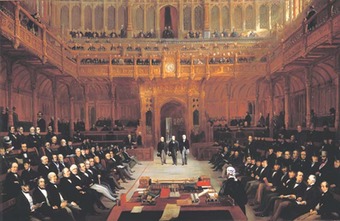
Parliament
Lionel Nathan de Rothschild (1808–1879) being introduced in the House of Commons, the lower house of Parliament, on 26 July 1858.
2.1.2: British Taxes and Colonial Grievances
The expenses from the French and Indian War caused the British to impose taxes on the American colonies.
Learning Objective
Discuss the nature of the grievances over the British empire’s taxes on the colonies
Key Points
- Parliament’s first idea repay to war debts was to charge smugglers who were violating various shipping acts.
- The Stamp Act and Sugar Act caused much protest in the colonies. The Stamp Act was repealed due to this protest.
- When Parliament refused to repeal the Tea Tax and made the colonists buy tea from the East India company, the Sons and Daughters of Liberty staged the Boston Tea Party.
Key Term
- Boston Tea Party
-
The Boston Tea Party (referred to in its time simply as “the destruction of the tea” or other informal names) was a political protest by the Sons of Liberty in Boston, a city in the British colony of Massachusetts. The Tea Party was held to protest the tax policy of the British government and the East India Company that controlled all the tea imported into the colonies.
After the French and Indian War, the British needed to find a way to repay war debt. They imposed new taxes and penalties to increase revenue for the kingdom. In 1764, George Grenville became the British Chancellor of the Exchequer. He allowed customs officers to obtain general writs of assistance, which allowed officers to search random houses for smuggled goods. Grenville thought that if profits from smuggled goods could be directed towards Britain, the money could help pay off debts. Colonists were horrified that they could be searched without warrant at any given moment. With persuasion from Grenville, Parliament also began to impose several new taxes on the colonists in 1764.
The Sugar Act of 1764 reduced the taxes imposed by the Molasses Act, but at the same time strengthened the collection of the tax. It also stipulated that British judges—not juries—would try Sugar Act cases. In 1765, Parliament passed the Quartering Act, which required the colonies to provide room and board for British soldiers stationed in North America. The soldiers’ main purpose was to enforce the previous acts passed by Parliament. Following the Quartering Act, Parliament passed one of the most infamous pieces of legislation: the Stamp Act.
Prior to the Stamp Act, Parliament imposed only external taxes on imports. The Stamp Act provided the first internal tax on the colonists, requiring that a tax stamp be applied to books, newspapers, pamphlets, legal documents, playing cards, and dice. The legislature of Massachusetts requested to hold a conference concerning the Stamp Act. The Stamp Act Congress met in October 1765, petitioning the King and Parliament to repeal the act before it went into effect at the end of the month. The act faced vehement opposition throughout the colonies. Merchants threatened to boycott British products. Thousands of New Yorkers rioted near the location where the stamps were stored. In Boston, the Sons of Liberty, a group led by radical statesman Samuel Adams, destroyed the home of Lieutenant Governor Thomas Hutchinson. Parliament repealed the Stamp Act but passed the Declaratory Act in its wake. The Declaratory Act stated that Great Britain retained the power to tax the colonists without substantive representation.
Believing that the colonists only objected to internal taxes, Chancellor of the Exchequer Charles Townshend proposed bills that would later become the Townshend Acts. The Townshend Acts, passed in 1767, taxed imports of tea, glass, paint, lead, and even paper. Again, colonial merchants threatened to boycott taxed products. Boycotts reduced the profits of British merchants, who, in turn, petitioned Parliament to repeal the Townshend Acts. Parliament eventually agreed to repeal much of the Townshend legislation, but they refused to remove the tax on tea, maintaining that the British government retained the authority to tax the colonies.
In 1773, Parliament passed the Tea Act, which exempted the British East India Company from the Townshend taxes. Thus, the East India Company gained a great advantage over other companies when selling tea in the colonies. The colonists who resented the advantages given to British companies dumped British tea overboard in the Boston Tea Party in December of 1773 .
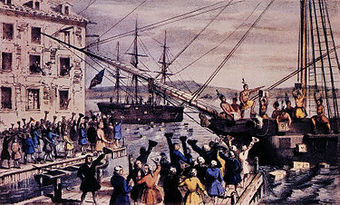
Boston Tea Party
The Boston Tea Party was orchestrated by the Sons and Daughters of Liberty, who fiercely protested the British-imposed taxes.
2.1.3: Taxation Without Representation
“No Taxation without Representation” was the rallying cry of the colonists who were forced to pay the stamp, sugar, and tea taxes.
Learning Objective
Explain the meaning of the slogan “No Taxation without Representation”
Key Points
- “No Taxation without Representation” is an expression that revealed the colonists’ anger at paying taxes without direct representation in the British Parliament.
- The phrase was inspired by John Hampden during the English Civil War in response to the taxes of King Charles II.
- In modern day, the expression is used by United States citizens responding to the government’s taxes.
Key Term
- representation
-
The ability to elect a representative to speak on one’s behalf in government; the role of this representative in government.
Taxation without Representation
“No taxation without representation,” a slogan originating during the 1750s and 1760s that summarized a primary grievance of the British Colonists in the 13 colonies, was one of the major causes of the American Revolution . In short, many of these colonists believed that as they were not directly represented in the British Parliament, any laws it passed taxing the colonists (such as the Sugar Act and the Stamp Act) were illegal under the English Bill of Rights of 1689, and were a denial of their rights as Englishmen.
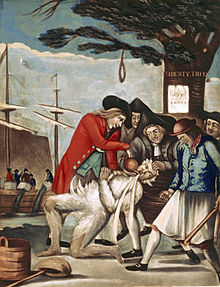
Sons of Liberty Propaganda
The colonists released much propaganda during this time in protest of what they said were unconstitutional policies. Here, Sons of Liberty are tarring and feathering a tax collector.
However, during the time of the American Revolution, only 1 in 20 British citizens had representation in parliament, none of whom resided in the colonies. In recent times, it has been used by several other groups in several different countries over similar disputes, including currently in some parts of the United States (see below). The phrase captures a sentiment central to the cause of the English Civil War, as articulated by John Hampden, who said, “What an English King has no right to demand, an English subject has a right to refuse.” This tax, which was only applied to coastal towns during a time of war, was intended to offset the cost of defending that part of the coast and could be paid in actual ships or the equivalent value. It was one of the causes of the English Civil War, and many British colonists in the 1750s, 1760s, and 1770s felt that it was related to their current situation.
2.1.4: The First Continental Congress
The first Continental Congress was held between 1774 and 1775 to discuss the future of the American colonies.
Learning Objective
Identify the historical role played by the Correspondence Committees during the American Revolutionary War
Key Points
- The first Continental Congress was brought together by the Virginia and Massachusetts assemblies. It was inspired by the popular Committees of Correspondence movement.
- The Congress’ first goal was neither war nor independence. It convened to to restore the union between Great Britain and the American colonies.
- In 1794, the first Congress issued a Declaration of Rights and Grievances, a precursor to the Declaration of Independence.
Key Term
- correspondence committee
-
The Committees of Correspondence were shadow governments organized by the Patriot leaders of the Thirteen Colonies on the eve of the American Revolution.
The first Continental Congress was influenced by Correspondence Committees. These served an important role in the Revolution by disseminating the colonial interpretation of British actions to the colonies and foreign governments. The Committees of Correspondence rallied opposition on common causes and established plans for collective action. The group of committees was the beginning of what later became a formal political union among the colonies. About seven to eight thousand patriots served on these committees at the colonial and local levels. These patriots comprised most of the leadership in colonial communities while the loyalists were excluded. Committee members became the leaders of the American resistance to the British. When Congress decided to boycott British products, the colonial and local Committees took charge by examining merchant records and publishing the names of merchants who attempted to defy the boycott. The Committees promoted patriotism and home manufacturing by advising Americans to avoid luxuries. The committees gradually extended their influence to many aspects of American public life.
In June 1774, the Virginia and Massachusetts assemblies independently proposed an intercolonial meeting of delegates from the several colonies to restore the union between Great Britain and the American colonies. In September, the first Continental Congress, composed of delegates from twelve of the thirteen colonies—all except Georgia—met in Philadelphia The assembly adopted what has become to be known as the Declaration and Resolves of the First Continental Congress. The document, addressed to his Majesty and to the people of Great Britain, included a statement of rights and principles, many of which were later incorporated into the Declaration of Independence and Federal Constitution. When the first Congress adjourned, it stipulated another Congress would meet if King George III did not acquiesce to the demands set forth in the Declaration of Resolves.
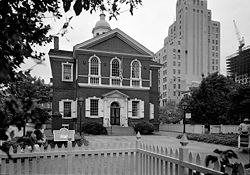
Carpenter’s Hall
The first Continental Congress met in Carpenter’s Hall in Philadelphia, PA.
By the time the second Congress met, the Revolutionary War had already begun, and the issue of independence, rather than a redress of grievances, dominated the debates.
2.1.5: The Second Continental Congress
The Second Continental Congress was ushered in at the beginning of the Revolution and eventually decided American independence.
Learning Objective
Discuss the role of the Second Continental Congress during the American Revolutionary war
Key Points
- The American Revolution had already begun before the Second Continental Congress met. The Second Continental Congress was a continuation of the first, with the discussion focusing on how the colonies should respond to the king.
- By the summer of 1775, the Continental Congress began raising an army for war against Britain.
- While the Congress was not an official governing body, it took similar functions as one, such as establishing diplomats and issuing money.
Key Term
- continental congress
-
The Second Continental Congress was a convention of delegates from the Thirteen Colonies that started meeting on May 10, 1775, in Philadelphia, Pennsylvania, soon after warfare in the American Revolutionary War had begun.
When the Second Continental Congress came together on May 10, 1775 it was, in effect, a reconvening of the First Continental Congress . Many of the same 56 delegates who attended the first meeting were in attendance at the second, and the delegates appointed the same president, Peyton Randolph, and secretary, Charles Thomson. Notable new arrivals included Benjamin Franklin of Pennsylvania and John Hancock of Massachusetts. Within two weeks, Randolph was summoned back to Virginia to preside over the House of Burgesses; he was replaced in the Virginia delegation by Thomas Jefferson , who arrived several weeks later. Henry Middleton was elected as president to replace Randolph, but he declined, and Hancock was elected president on May 24.
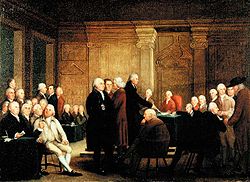
Second Continental Congress
The Congress signing the Declaration of Independence.
By the time the Second Continental Congress met, the American Revolutionary War had already started with the battles of Lexington and Concord. The Congress was to take charge of the war effort. For the first few months of the struggle, the Patriots had carried on their struggle in an ad hoc and uncoordinated manner. They had seized arsenals, driven out royal officials, and besieged the British army in the city of Boston. On June 14, 1775, the Congress voted to create the Continental Army out of the militia units around Boston and quickly appointed Congressman George Washington of Virginia as commanding general of the Continental Army. On July 6, 1775, Congress approved a Declaration of Causes outlining the rationale and necessity for taking up arms in the thirteen colonies. On July 8, Congress extended the Olive Branch Petition to the British Crown as a final attempt at reconciliation. However, it was received too late to do any good. Silas Deane was sent to France as a minister (ambassador) of the Congress. American ports were reopened in defiance of the British Navigation Acts. Although it had no explicit legal authority to govern, it assumed all the functions of a national government, such as appointing ambassadors, signing treaties, raising armies, appointing generals, obtaining loans from Europe, issuing paper money (called “Continentals”), and disbursing funds. The Congress had no authority to levy taxes, and was required to request money, supplies, and troops from the states to support the war effort. Individual states frequently ignored these requests.
2.1.6: Political Strife and American Independence
The new congress faced many roadblocks in establishing the new nation.
Learning Objective
Describe the steps taken by the Continental Congress after declaring independence from the British Empire
Key Points
- The Declaration of Independence officially cut American ties with Britain in 1776.
- The new congress initially struggled with obtaining support from the individual colonies.
- In 1776 the government went from Philadelphia to Lancaster, Pa., because of British invasion.
Key Term
- resolution
-
A statement of intent, a vow
The new Congress faced many issues during the American Revolution, including tensions with home governments, establishing legitimacy overseas, and funding a revolution without the ability to create money or tax citizens . War was also in the backdrop of the new government, and it had to move in the autumn of 1777 because the British invaded Philadelphia.
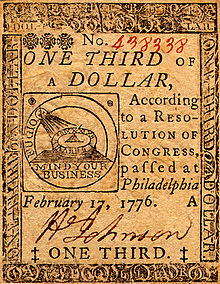
The Continental Currency
The Continental was a bill issued by Congress to fund the Revolutionary War. Over a very short period of time, the Continental became worthless.
Congress was moving towards declaring independence from the British Empire in 1776, but many delegates lacked the authority from their home governments to take such an action. Advocates of independence in Congress moved to have reluctant colonial governments revise instructions to their delegations, or even replace those governments which would not authorize independence. On May 10, 1776, Congress passed a resolution recommending that any colony lacking a proper (i.e. a revolutionary) government should form such. On May 15, Congress adopted a more radical preamble to this resolution, drafted by John Adams, in which it advised throwing off oaths of allegiance and suppressing the authority of the Crown in any colonial government that still derived its authority from the Crown. That same day the Virginia Convention instructed its delegation in Philadelphia to propose a resolution that called for a declaration of independence, the formation of foreign alliances, and a confederation of the states. The resolution of independence was delayed for several weeks as revolutionaries consolidated support for independence in their home governments.
The records of the Continental Congress confirm that the need for a declaration of independence was intimately linked with the demands of international relations. On June 7, 1776, Richard Henry Lee tabled a resolution before the Continental Congress declaring the colonies independent. He also urged Congress to resolve “to take the most effectual measures for forming foreign Alliances” and to prepare a plan of confederation for the newly independent states. Lee argued that independence was the only way to ensure a foreign alliance, since no European monarchs would deal with America if they remained Britain’s colonists. American leaders had rejected the divine right of kings in the New World, but recognized the necessity of proving their credibility in the Old World. Congress would formally adopt the resolution of independence, but only after creating three overlapping committees to draft the Declaration, a Model Treaty, and the Articles of Confederation. The Declaration announced the states’ entry into the international system; the model treaty was designed to establish amity and commerce with other states; and the Articles of Confederation established “a firm league” among the thirteen free and independent states. Together these constituted an international agreement to set up central institutions for the conduct of vital domestic and foreign affairs. Congress finally approved the resolution of independence on July 2, 1776. Congress next turned its attention to a formal explanation of this decision, the United States Declaration of Independence, which was approved on July 4 and published soon thereafter. The Continental Congress was forced to flee Philadelphia at the end of September 1777, as British troops occupied the city. The Congress moved to York, Pennsylvania, and continued their work.
2.1.7: The Declaration of Independence
The Declaration of Independence was a letter to the king explaining why the colonies were separating from Britain.
Learning Objective
Explain the major themes and ideas espoused by Jefferson in the Declaration of Independence
Key Points
- After the hostilities had begun, the colonies no longer believed they were a part of Britain.
- John Adams convinced the committee that Thomas Jefferson should write the final draft of the declaration.
- After the states ratified the declaration, it was widely publicized.
Key Terms
- Declaration of Independence
-
The Declaration of Independence was a statement adopted by the Continental Congress on July 4, 1776, which announced that the thirteen American colonies, then at war with Great Britain, regarded themselves as independent states, and no longer a part of the British Empire.
- state
-
A political division of a federation retaining a degree of autonomy, for example one of the fifty United States. See also Province.
One of the first essential acts of the second Continental Congress, once it determined it would seek independence, was to issue a declaration to King George III confirming its separation. Each state in the congress had drafted some form of a declaration of independence, but ultimately, Thomas Jefferson was asked to write a final one which would represent all the American colonies.
The Declaration of Independence was a statement adopted by the Continental Congress on July 4, 1776, which announced that the thirteen American colonies, then at war with Great Britain, regarded themselves as independent states, and no longer a part of the British Empire . John Adams had put forth a resolution earlier in the year, making a subsequent formal declaration inevitable. A committee was assembled to draft the formal declaration, to be ready when congress voted on independence. Adams persuaded the committee to select Thomas Jefferson to compose the original draft of the document, which congress would edit to produce the final version. The Declaration was ultimately a formal explanation of why Congress had voted on July 2 to declare independence from Great Britain, more than a year after the outbreak of the American Revolutionary War. The Independence Day of the United States of America is celebrated on July 4, the day Congress approved the wording of the Declaration.
After ratifying the text on July 4, Congress issued the Declaration of Independence in several forms. It was initially published as a printed broadside that was widely distributed and read to the public. The most famous version of the Declaration, a signed copy that is usually regarded as the Declaration of Independence, is displayed at the National Archives in Washington, D.C. Although the wording of the Declaration was approved on July 4, the date of its signing was August 2. The original July 4 United States Declaration of Independence manuscript was lost while all other copies have been derived from this original document.

Declaration of Independence
The final declaration was drafted by Thomas Jefferson.
2.1.8: The Articles of Confederation
The Articles of Confederation established a confederacy-type government among the new American states.
Learning Objective
Explain the historical origins and purpose of The Articles of Confederation
Key Points
- The Articles of Confederation gave little power to the central government, essentially leaving it ineffective.
- The states feared a near-tyrannical government such as the one they suffered when they were under British rule, so the head of state had only administrative power, and congress could not get money to fund the Revolutionary War from the states.
- The articles also suffered from not being able to change the articles without a unanimous vote from the states. This often was a time-consuming process during which very little was changed.
Key Term
- confederation
-
A union or alliance of states or political organizations.
The Articles of Confederation were established in 1777 by the Second Continental Congress . The Articles accomplished certain things, but without a good leader, they were bad. First, they expressly provided that the states were sovereign. (A sovereign state is a state that is both self-governing and independent. ) The United States as a Confederation was much like the present-day European Union. Each member was able to make its own laws; the entire Union was merely for the purposes of common defense.The reason for the independence of the colonies is clear–the colonies were afraid of the power of a central government such as the one in the State of Great Britain. The Articles provided that a Congress, consisting of two to seven members per state, would hold legislative power. The states, regardless of the number of Congress members representing them, each had one total vote. The Congress was empowered to settle boundary and other disputes between states. It could also establish courts with jurisdiction overseas. Also, it could tax the states, even though it did not possess the power to require the collection of these taxes by law.
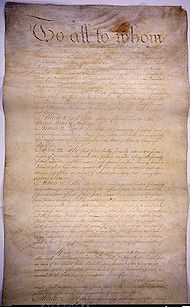
Articles of Confederation
These articles outlined the new government of the United States.
The Congress, overall, was absolutely ineffectual. The Congress had to rely on the states for its funding. Since it could not forcibly collect taxes, the states could grant or withhold money and force Congress to accept their demands. Because it could not collect taxes, Congress printed paper dollars. This policy, however, absolutely wrecked the economy because of an overabundance of paper dollars, which had lost almost all value. Several states also printed their own currency. This led to much confusion relating to exchange rates and trade; some states accepted the currency of others, while other states refused to honor bills issued by their counterparts. Furthermore, the Articles included certain fallacies. For instance, it suggested that the approval of nine states was required to make certain laws. However, it made no provision for additional states. Thus, it would appear that the number nine would be in effect even if that number would actually be a minority of states. Also, the Articles required the approval of all states for certain important decisions such as making Amendments. As the number of States would grow, securing this approval would become more and more difficult.
2.1.9: Powers of the American Government Under the Articles of Confederation
The Articles of confederation gave few but important powers of diplomacy to the American government.
Learning Objective
Discuss how power was distributed and enforced under the Articles of Confederation
Key Points
- War-making and diplomacy were the key functions of the new government.
- The Northwest Ordinance was an important agreement the government used to establish territory in the west.
- The articles allotted for a small peacetime force. Generally, however, the states had the stronger, better coordinated militias.
Key Terms
- taxation
-
The act of imposing taxes and the fact of being taxed
- ordinance
-
a local law or regulation.
Powers of the American Government under the Articles of Confederation
The Articles supported the Congressional direction of the Continental Army, and allowed the 13 states to present a unified front when dealing with the European powers. As a tool to build a centralized war-making government, they were largely a failure, but since guerrilla warfare was a correct strategy in a war against the British Empire’s army, this failure succeeded in winning independence.
Congress could make decisions under the articles but had no power to enforce them. There was a requirement for unanimous approval before any modifications could be made to the Articles. Because the majority of lawmaking rested with the states, the central government was also kept limited. Congress was denied the power of taxation: it could only request money from the states. The states did not generally comply with the requests in full, leaving the confederation chronically short of funds.
Congress was also denied the power to regulate commerce, and as a result, the states fought over trade as well. The states and the national congress had both incurred debts during the war, and how to pay the debts became a major issue. Some states paid off their debts; however, the centralizers favored federal assumption of states’ debts. Nevertheless, the Congress of the Confederation did take two actions with lasting impact. The Land Ordinance of 1785 established the general land survey and ownership provisions used throughout later American expansion. The Northwest Ordinance of 1787 noted the agreement of the original states to give up western land claims and cleared the way for the entry of new states .
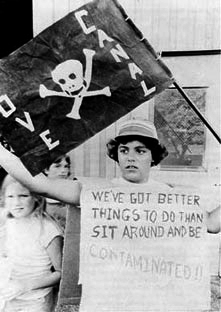
Love Canal
This 1978 protest at Love Canal was one of the early events in the environmental justice movement.
Once the war was won, the Continental Army was largely disbanded. A very small national force was maintained to man frontier forts and protect against Indian attacks. Meanwhile, each of the states had an army (or militia), and 11 of them had navies. The wartime promises of bounties and land grants to be paid for service were not being met. In 1783, Washington defused the Newburgh conspiracy, but riots by unpaid Pennsylvania veterans forced the Congress to temporarily leave Philadelphia.
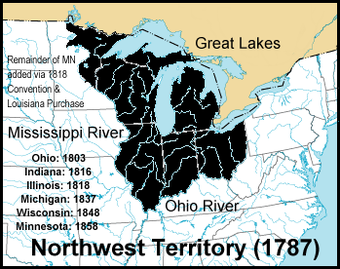
Northwest Ordinance
The Northwest Ordinance was one of the few accomplishments under the Articles of Confederation.
2.1.10: Impact of the Articles of Confederation
The Articles of Confederation, while riddled with problems, did have lasting effects.
Learning Objective
Identify the strengths and weaknesses of the Articles of Confederation
Key Points
- The Land Ordinance of 1785 and the Northwest Ordinance were land-planning orders, and they helped expand the Untied States westward.
- The government under the articles were ineffective diplomatically: It took months before the government could plan the Paris peace talks to end the Revolutionary War.
- The government also could not tax the states or make the states pay their war debts. It also could not regulate inter-state commerce.
Key Term
- imperial colonization
-
The policy of forcefully extending a nation’s authority by territorial gain or by the establishment of economic and political dominance over other nations.
The Confederation Congress did take two actions with long-lasting impact. The Land Ordinance of 1785 and Northwest Ordinance created a territorial government, set up protocols for the admission of new states and the division of land into useful units and set aside land in each township for public use. This system represented a sharp break from imperial colonization, as in Europe, and provided the basis for the rest of American continental expansion throughout the nineteenth century.
The Land Ordinance of 1785 established both the general practices of land surveying in the west and northwest and the land ownership provisions used throughout the later westward expansion beyond the Mississippi River. The Northwest Ordinance of 1787 noted the agreement of the original states to give up northwestern land claims and organized the Northwest Territory, thereby clearing the way for the entry of five new states and part of a sixth to the Union. The Northwest Ordinance of 1787 also made great advances in the abolition of slavery. New states admitted to the Union in said territory would never be slave states.To be specific, these states gave up all of their claims to land north of the Ohio River and west of the (present) western border of Pennsylvania: Massachusetts, Connecticut, New York, Pennsylvania, and Virginia. From this land, over several decades, new states were formed: Ohio, Indiana, Illinois, Michigan, Wisconsin, and the part of Minnesota east of the Mississippi River. By the Land Ordinance of 1785, these were surveyed into the now familiar squares of land called the “township” (36 square miles), the “section” (one square mile), and the “quarter section” (160 acres) . This system was carried forward to most of the states west of the Mississippi (excluding areas of Texas and California that had already been surveyed and divided up by the Spanish Empire). Then, when the Homestead Act was enacted in 1867, the quarter section became the basic unit of land that was granted to new settler farmers.

Public interest groups
Public interest groups advocate for issues that impact the general public, such as education.
The Treaty of Paris (1783), which ended hostilities with Great Britain, languished in Congress for months because state representatives failed to attend sessions of the national legislature. Yet, Congress had no power to enforce attendance. Also, the Confederation faced several difficulties in its early years. Firstly, Congress became extremely dependent on the states for income. Also, states refused to require its citizens to pay debts to British merchants, straining relations with Great Britain. France prohibited Americans from using the important port of New Orleans, crippling American trade down the Mississippi river.
Under the Articles of Confederation, the central government’s power was kept quite limited. The Confederation Congress could make decisions but lacked enforcement powers. Implementation of most decisions, including modifications to the articles, required unanimous approval of all 13 state legislatures. Congress was denied any powers of taxation. It only could request money from the states. The states often failed to meet these requests in full, leaving both Congress and the Continental Army chronically short of money. As more money was printed by Congress, the continental dollars depreciated. In 1779, George Washington wrote to John Jay, who was serving as the president of the Continental Congress, “that a wagon load of money will scarcely purchase a wagon load of provisions. ” Mr. Jay and the Congress responded in May by requesting $45 million from the states. In an appeal to the states to comply, Jay wrote that the taxes were “the price of liberty, the peace, and the safety of yourselves and posterity. ” He argued that Americans should avoid having it said “that America had no sooner become independent than she became insolvent” or that “her infant glories and growing fame were obscured and tarnished by broken contracts and violated faith. ” The states did not respond with any of the money requested from them. Congress also had been denied the power to regulate either foreign trade or interstate commerce and, as a result, all of the states maintained control over their own trade policies. The states and the Confederation Congress both incurred large debts during the Revolutionary War, and how to repay those debts became a major issue of debate following the war. Some states paid off their war debts and others did not.
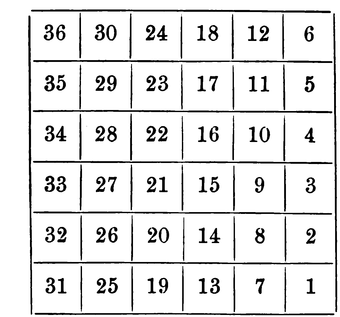
Land Ordinance, 1785
These units were the basis for separating land. By the Land Ordinance of 1785, these were surveyed into the now familiar squares of land called the “township” (36 square miles), the “section” (one square mile), and the “quarter section” (160 acres).
2.1.11: Shay’s Rebellion and the Revision of the Articles of Confederation
Shays’ rebellion prompted the Boston elite and members of the central government to question the strength of the American government.
Learning Objective
Discuss the historical conditions that prompted Shay’s Rebellion and its impact on the Articles of Confederation
Key Points
- Shay was a farmer who led a rebellion after he was put in jail because he could not pay state taxes. He and a group of supporters protested. The federal government could not stop these mass protests and had to beg the Massachusetts militia to do so.
- Many figuredheads of the time debated the revolution. Thomas Jefferson supported it, while Henry Knox and George Washington were appalled by Shays’ actions.
- Elites began to think that a convention discussing the Articles should be held, though others worried such conventions would undermine the government.
Key Term
- inflation
-
An increase in the general level of prices or in the cost of living.
Shays’ Rebellion and the Revision of the Articles
Due to the post-revolution economic woes and agitated by inflation, many worried about social instability. This was especially true for those in Massachusetts. The legislature’s response to the shaky economy was to put emphasis on maintaining a sound currency by paying off the state debt through levying massive taxes. The tax burden hit those with moderate incomes dramatically. The average farmer paid a third of their annual income to these taxes from 1780 to 1786. Those who couldn’t pay had their property foreclosed and they were thrown into crowded prisons filled with other debtors.
In the summer of 1786, a Revolutionary War veteran named Daniel Shays began to organize western communities in Massachusetts to forcibly stop foreclosures by prohibiting the courts from holding their proceedings. Later that fall, Shays marched the newly formed “rebellion” into Springfield to stop the state supreme court from gathering . The state responded with troops sent to suppress the rebellion. After a failed attempt by the rebels to attack the Springfield arsenal, and the failure of other small skirmishes, the rebels retreated and then uprising collapsed.
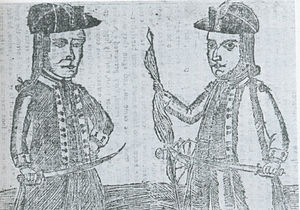
Daniel Shays
Shays and colleague Job Shattuck
Shays retreated to Vermont by 1787. While Daniel Shays was in hiding, the government condemned him to death on the charge of treason. Shays pleaded for his life in a petition that was finally granted by John Hancock on June 17, 1788. Thomas Jefferson, who was serving as ambassador to France at the time, refused to be alarmed by Shays’ Rebellion. In a letter to a friend, he argued that a little rebellion now and then is a good thing. “The tree of liberty must be refreshed from time to time with the blood of patriots and tyrants. It is its natural manure. “
In contrast to Jefferson’s sentiments George Washington, who had been calling for constitutional reform for many years, wrote in a letter to Henry Lee, “You talk, my good sir, of employing influence to appease the present tumults in Massachusetts. I know not where that influence is to be found, or, if attainable, that it would be a proper remedy for the disorders. Influence is not government. Let us have a government by which our lives, liberties, and properties will be secured, or let us know the worst at once. “
At the time of the rebellion, the weaknesses of the federal government as constituted under the Articles of Confederation were apparent to many. A vigorous debate was going on throughout the states on the need for a stronger central government with Federalists arguing for the idea, and anti-Federalists opposing them. Historical opinion is divided on what sort of role the rebellion played in the formation and later ratification of the United States Constitution, although most scholars agree it played some role, at least temporarily drawing some anti-Federalists to the strong government side. By early 1785, many influential merchants and political leaders were already agreed that a stronger central government was needed.
Delegates from five states held a convention in Annapolis, Maryland in September 1786. They concluded that vigorous steps needed to be taken to reform the federal government, but it disbanded because of a lack of full representation. The delegates called for a convention consisting of all the states to be held in Philadelphia in May 1787. Historian Robert Feer notes that several prominent figures had hoped the convention would fail, requiring a larger-scale convention. French diplomat Louis-Guillaume Otto thought the convention was intentionally broken off early to achieve this end.
In early 1787 John Jay wrote that the rural disturbances and the inability of the central government to fund troops in response made “the inefficiency of the Federal government [become] more and more manifest. ” Henry Knox observed that the uprising in Massachusetts clearly influenced local leaders who had previously opposed a strong federal government.
Historian David Szatmary writes that the timing of the rebellion “convinced the elites of sovereign states that the proposed gathering at Philadelphia must take place. ” Some states, Massachusetts among them, delayed choosing delegates to the proposed convention partly because in some ways it resembled the “extra-legal” conventions organized by the protestors before the rebellion became violent.
2.1.12: The Annapolis Convention
The Annapolis Convention, led by Alexander Hamilton, was one of two conventions that met to amend the Articles of Confederation.
Learning Objective
Discuss the impact of the Annapolis Convention on the U.S. Constitution
Key Points
- Alexander Hamilton called delegates to Annapolis, Maryland to discuss ways to amend the Articles of Confederation so the government would run more effectively.
- Of the thirteen states, only five send representatives. The representatives met in September of 1786 but did not proceed because of the low representation. Instead, they suggested that a group of delegates meet in Philadelphia that following May.
- At the Philadelphia Convention in May 1787, the delegates created the United States Constitution.
Key Term
- Annapolis Convention
-
The Annapolis Convention was a meeting in 1786 in Annapolis, Maryland, where twelve delegates from five states (New Jersey, New York, Pennsylvania, Delaware, and Virginia) met and unanimously called for a constitutional convention.
Long dissatisfied with the weak Articles of Confederation, Alexander Hamilton of New York played a major leadership role in drafting a resolution for a constitutional convention, which was later to be called the Annapolis Convention. Hamilton’s efforts brought his desire to have a more powerful, more financially independent federal government one step closer to reality .
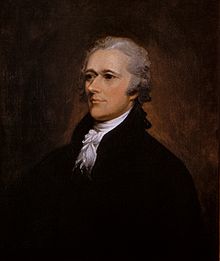
Alexander Hamilton
Hamilton called the Annapolis Convention together and played a prominent role in the Philadelphia Convention the following year.
The defects that the convention was to remedy were those barriers that limited trade or commerce between the largely independent states under the Articles of Confederation. The convention, named A Meeting of Commissioners to Remedy Defects of the Federal Government, met from September 11 to September 14, 1786. “New Hampshire, Massachusetts, Rhode Island, and North Carolina had appointed commissioners who failed to arrive in Annapolis in time to attend the meeting, while Connecticut, Maryland, South Carolina and Georgia had taken no action at all. Because of the small representation, the Annapolis Convention did not deem “it advisable to proceed on the business of their mission. ” After an exchange of views, the Annapolis delegates unanimously submitted a report to their respective States in which they suggested that a convention of representatives from all the States meet at Philadelphia on the second Monday in May, 1787. The report expressed the hope that more states would be represented and that their delegates or deputies would be authorized to examine areas broader than simply commercial trade. At the resulting Philadelphia Convention of 1787, delegates produced the United States Constitution.
2.2: The Constitutional Convention
2.2.1: The Constitutional Convention
The Constitutional Convention was established in 1787 to replace the Articles of Confederation with a national constitution for all states.
Learning Objective
Discuss the circumstances leading to the Constitutional Convention and the replacement of the Articles of Confederation
Key Points
- The Constitutional Convention took place from May 14 to September 17, 1787, in Philadelphia, Pennsylvania to address problems in governing the United States of America, which had been operating under the Articles of Confederation following independence from Great Britain.
- The Articles of Confederation was an agreement among the 13 founding states that established the United States of America as a confederation of sovereign states. It soon become evident to nearly all that it was inadequate for managing the various conflicts that arose among the states.
- Several plans were introduced at the Constitutional Convention. The Virginia Plan, inspired by James Madison, proposed that both houses of the legislature would be determined proportionately. The lower house would be elected by the people, and the upper house would be elected by the lower house.
- In contrast to the Virginia Plan, the New Jersey Plan proposed a unicameral legislature with one vote per state. Inherited from the Articles of Confederation, this position reflected the belief that the states were independent entities.
- To resolve this stalemate, the Connecticut Compromise blended the Virginia and New Jersey proposals. Ultimately, its main contribution was in determining the apportionment of the Senate. What was ultimately included in the Constitution was a modified form of this plan.
- Among the most controversial issues confronting the delegates was that of slavery. The Three-Fifths Compromise established that three-fifths of the population of slaves would be counted in relation to the distribution of taxes and the apportionment of the members of the House of Representatives.
Key Terms
- new jersey plan
-
Under the New Jersey Plan, the unicameral legislature with one vote per state was inherited from the Articles of Confederation. This position reflected the belief that the states were independent entities and as they entered the United States of America freely and individually, so they remained.
- virginia plan
-
Virginia Plan was a proposal by Virginia delegates for a bicameral legislative branch. Prior to the start of the Convention, the Virginian delegates met and, drawing largely from Madison’s suggestions, drafted a plan.
- constitutional convention
-
The Constitutional Convention took place from May 14 to September 17, 1787, in Philadelphia, Pennsylvania, to address problems in governing the United States of America, which had been operating under the Articles of Confederation following independence from Great Britain.
Introduction
The Constitutional Convention took place from May 14 to September 17, 1787, in Philadelphia, Pennsylvania. The convention was held to address problems in governing the United States, which had been operating under the Articles of Confederation following independence from Great Britain. Although the convention was intended to revise the Articles of Confederation, the intention from the outset of many of its proponents, chief among them James Madison and Alexander Hamilton, was to create a new government rather than fix the existing one. The delegates elected George Washington to preside over the convention. The result of the convention was the United States Constitution, placing the convention among the most significant events in the history of the United States .
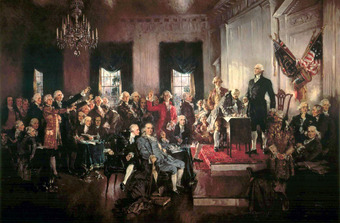
Constitutional Convention in Philadelphia
“Scene at the Signing of the Constitution of the United States,” by Howard Chandler Christy (1940).
The Convention
At the Convention, several plans were introduced. James Madison’s plan, known as the Virginia Plan, was the most important plan. The Virginia Plan was a proposal by Virginia delegates for a bicameral legislative branch. Prior to the start of the Convention, the Virginian delegates met and, drawing largely from Madison’s suggestions, drafted a plan . In its proposal, both houses of the legislature would be determined proportionately. The lower house would be elected by the people, and the upper house would be elected by the lower house. The executive branch would exist solely to ensure that the will of the legislature was carried out and, therefore, would be selected by the legislature.
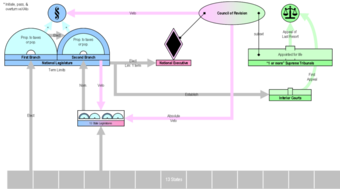
Virginia Plan
Visual representation of the structure of James Madison’s Virginia Plan.
After the Virginia Plan was introduced, New Jersey delegate William Paterson asked for an adjournment to contemplate the plan. Under the Articles of Confederation, each state had equal representation in Congress, exercising one vote each. Paterson’s New Jersey Plan was ultimately a rebuttal to the Virginia Plan. Under the New Jersey Plan, the unicameral legislature with one vote per state was inherited from the Articles of Confederation . This position reflected the belief that the states were independent entities and as they entered the United States of America freely and individually, so they remained.
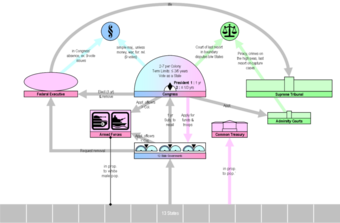
New Jersey Plan
Visual representation of the structure of the New Jersey Plan.
To resolve this stalemate, the Connecticut Compromise, forged by Roger Sherman from Connecticut, was proposed on June 11. In a sense, it blended the Virginia (large-state) and New Jersey (small-state) proposals. Ultimately, however, its main contribution was in determining the apportionment of the Senate and, thus, retaining a federal character in the constitution. What was ultimately included in the constitution was a modified form of this plan.
Slavery
Among the most controversial issues confronting the delegates was that of slavery. Slavery was widespread in the states at the time of the Convention. Twenty-five of the Convention’s 55 delegates owned slaves, including all of the delegates from Virginia and South Carolina. Whether slavery was to be regulated under the new Constitution was a matter of such intense conflict between the North and South that several Southern states refused to join the Union if slavery were not to be allowed.
Whether slavery was to be regulated under the new Constitution was a matter of such intense conflict between the North and South that several Southern states refused to join the Union if slavery were not to be allowed. Delegates opposed to slavery were forced to yield in their demands that slavery practiced within the confines of the new nation be completely outlawed. However, they continued to argue that the Constitution should prohibit the states from participating in the international slave trade, including in the importation of new slaves from Africa and the export of slaves to other countries. The Convention postponed making a final decision on the international slave trade until late in the deliberations because of the contentious nature of the issue. Once the Convention had finished amending the first draft from the Committee of Detail, a new set of unresolved questions were sent to several different committees for resolution.
During the Convention’s late July recess, the Committee of Detail had inserted language that would prohibit the federal government from attempting to ban international slave trading, and from imposing taxes on the purchase or sale of slaves. This committee helped work out a compromise: In exchange for this concession, the federal government’s power to regulate foreign commerce would be strengthened by provisions that allowed for taxation of slave trades in the international market and that reduced the requirement for passage of navigation acts from two-thirds majorities of both houses of Congress to simple majority.
The Three-Fifths Compromise was a compromise between Southern and Northern states reached during the Philadelphia Convention of 1787 in which three-fifths of the enumerated population of slaves would be counted for representation purposes regarding both the distribution of taxes and the apportionment of the members of the United States House of Representatives. It was proposed by delegates James Wilson and Roger Sherman. This was eventually adopted by the Convention.
2.2.2: The Framers of the Constitution
The Framers of the Constitution were delegates to the Constitutional Convention who took part in drafting the proposed U.S. Constitution.
Learning Objective
Describe the composition of the delegates to the Constitutional Convention
Key Points
- The Founding Fathers of the United States of America were political leaders and statesmen who participated in the American Revolution by signing the United States Declaration of Independence, taking part in the American Revolutionary War, and establishing the United States Constitution.
- In 1973, historian Richard B. Morris identified seven key Founding Fathers: John Adams, Benjamin Franklin, Alexander Hamilton, John Jay, Thomas Jefferson, James Madison, and George Washington.
- In the winter and spring of 1786–1787, twelve of the thirteen states chose a total of seventy-four delegates to attend what is now known as the Constitutional Convention. Of these seventy-four delegates, only fifty-five helped to draft what would become the Constitution of the United States.
- More than half of the delegates had trained as lawyers, although only about a quarter practiced law as their principal means of business. Other professions included merchants, manufacturers, shippers, land speculators, bankers or financiers, three physicians, a minister, and several small farmers.
- Several notable founders did not participate in the Constitutional Convention. Thomas Jefferson, John Adams, Patrick Henry, John Hancock and Samuel Adams did not attend the Convention.
Key Terms
- founding fathers
-
The Founding Fathers of the United States of America were political leaders and statesmen who participated in the American Revolution by signing the United States Declaration of Independence, taking part in the American Revolutionary War, and establishing the United States Constitution.
- constitutional convention
-
The Constitutional Convention took place from May 14 to September 17, 1787, in Philadelphia, Pennsylvania, to address problems in governing the United States of America, which had been operating under the Articles of Confederation following independence from Great Britain.
- last of the romans
-
Term used to refer to the last remaining founders who lived well into the nineteenth century.
Introduction
The Founding Fathers of the United States of America were political leaders who participated in the American Revolution. They signed the Declaration of Independence, took part in the Revolutionary War, and established the Constitution. The “Founding Fathers” included two major groups. The Signers of the Declaration of Independence signed the United States Declaration of Independence in 1776. The Framers of the Constitution were delegates to the Constitutional Convention and helped draft the Constitution of the United States .
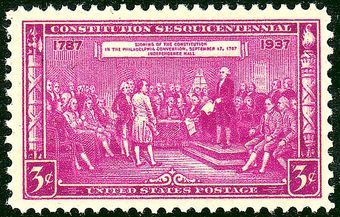
Framers of the Constitution Stamp (1937)
US Postage Stamp depicting delegates at the signing of the US Constitution.
Some historians consider the “Founding Fathers” to be a larger group, which includes not only the Signers and the Framers but also ordinary citizens who took part in winning American independence and creating the United States of America. In 1973, historian Richard B. Morris identified seven figures as the main Founding Fathers: John Adams, Benjamin Franklin, Alexander Hamilton, John Jay, Thomas Jefferson, James Madison, and George Washington.
Delegates to the Constitutional Convention
In 1786–1787, twelve of the thirteen states—all but Rhode Island—chose seventy-four delegates to attend what is now known as the Constitutional Convention in Philadelphia (). Nineteen of these delegates chose not to accept election or attend the debates. The states had originally appointed seventy representatives to the Convention, but a number of the appointees did not accept or could not attend, leaving fifty-five delegates to draft the Constitution. Almost all of these delegates had taken part in the Revolution. At least twenty-nine of the delegates served in the Continental forces. Most of the delegates had been members of the Confederation Congress, and many had been members of the Continental Congress.
Occupations and Experience
The framers of the Constitution had extensive political experience. By 1787, four-fifths of the delegates had been in the Continental Congress. Nearly all of the fifty-five delegates had experience in colonial and state government. Furthermore, the delegates practiced a wide range of high- and middle-status occupations. Many delegates pursued more than one career simultaneously. They did not differ dramatically from the Loyalists, except the delegates were generally younger in their professions.
More than half of the delegates had trained as lawyers, although only about a quarter had practiced law as their principal career. Other professions included merchants, manufacturers, shippers, land speculators, bankers or financiers, three physicians, a minister, and several small farmers. Of the twenty-five who owned slaves, sixteen depended on slave labor to run the plantations or other businesses that formed the mainstay of their income. Most of the delegates were landowners with substantial holdings, and most were comfortably wealthy. George Washington and Governor Morris were among the wealthiest men in the entire country.
The Founding Fathers had strong educational backgrounds at some of the colonial colleges or abroad. Some, like Franklin and Washington, were largely self-taught or learned through apprenticeship. Others had obtained instruction from private tutors or at academies. About half of the men had attended or graduated from college. Some men held medical degrees or advanced training in theology. Most delegates were educated in the colonies, but several were lawyers who had been trained at the Inns of Court in London.
Notable Absences and Post-Convention Careers
Several notable Founders did not participate in the Constitutional Convention. Thomas Jefferson was abroad, serving as the minister to France. John Adams was in Britain, serving as minister to that country, but he wrote home to encourage the delegates. Patrick Henry refused to participate because he “smelt a rat in Philadelphia, tending toward the monarchy. ” John Hancock and Samuel Adams were also absent. Many of the states’ older and more experienced leaders may have simply been too busy to attend the Convention.
Most were successful in subsequent careers, although seven suffered serious financial reverses that left them in or near bankruptcy. Most of the group continued to render public service, particularly to the new government they had helped to create. The last remaining founders, also called the “Last of the Romans”, lived well into the nineteenth century.
2.2.3: Constitutional Issues and Compromises
At the Constitutional Convention, the Virginia, Pinckney, New Jersey, and Hamilton plans gave way to the Connecticut Compromise.
Learning Objective
Compare and contrast the U.S. Constitution with the Articles of Confederation.
Key Points
- Inspired by proposals at the Constitutional Convention, The Virginia Plan proposed a legislative branch consisting of two chambers. Rotation in office and recall were two principles applied to the lower house of the national legislature.
- Under the Pinckney Plan, the House would have one member for every one thousand inhabitants. The House would also elect Senators who would serve by rotation for four years. Congress would meet in a joint session to elect a President, and it would also appoint members of the cabinet.
- Under the New Jersey Plan, the unicameral legislature with one vote per state was inherited from the Articles of Confederation. Unlike the Virginia Plan, this plan favored small states by giving one vote per state.
- Alexander Hamilton’s plan advocated doing away with much state sovereignty and consolidating the states into a single nation. The plan was perceived as a well-thought-out plan, but it was not considered because it resembled the British system too closely.
- The Connecticut Compromise blended the Virginia (large-state) and New Jersey (small-state) proposals. Its main contribution was in determining the method for apportionment of the Senate and retaining a federal character in the constitution.
Key Terms
- hamilton’s plan
-
Proposed by Alexander Hamilton to the Constitutional Convention, this plan advocated doing away with much state sovereignty and consolidating the states into a single nation. The plan was perceived as a well-thought-out plan, but it was not considered because it resembled the British system too closely.
- pinckney plan
-
The Pinckney Plan refers to the proposal by Charles Pinckney of South Carolina to the Constitutional Convention. It advanced a bicameral legislature made up of a Senate and a House of Delegates. The House would have one member for every one thousand inhabitants. The House would elect Senators who would serve by rotation for four years and represent one of four regions.
- virginia plan
-
Virginia Plan was a proposal by Virginia delegates for a bicameral legislative branch. Prior to the start of the Convention, the Virginian delegates met and, drawing largely from Madison’s suggestions, drafted a plan.
Introduction
At the Constitutional Convention, several plans were introduced. Debate topics included the composition of the Senate, how “proportional representation” was to be defined, whether the executive branch would be composed of one person or three, presidential term lengths and method of election, impeachable offenses, a fugitive slave clause, whether to abolish slave trade, and whether judges should be chosen by the legislature or executive.
The Virginia Plan
While waiting for the Convention to formally begin, James Madison sketched out his initial draft, which became known as the Virginia Plan. It also reflected his views as a strong nationalist . The Virginia Plan was a proposal by Virginia delegates for a bicameral legislative branch . Prior to the start of the Convention, the Virginian delegates met and, drawing largely from Madison’s suggestions, drafted a plan. The Virginia Plan proposed a legislative branch consisting of two chambers. Rotation in office and recall were two principles applied to the lower house of the national legislature. Each of the states would be represented in proportion to their “Quotas of contribution, or to the number of free inhabitants.” States with a large population, like Virginia, would thus have more representatives than smaller states.
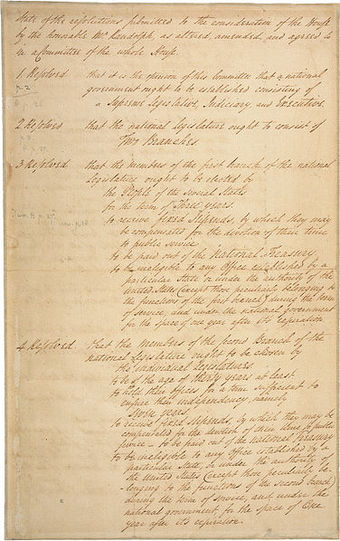
The Virginia Plan
The front page of the Virginia Plan document.
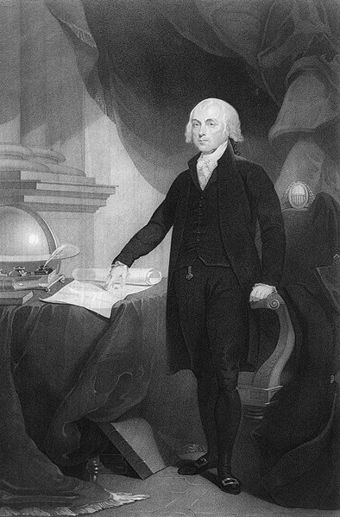
Portrait of James Madison
Stippling engraving of James Madison, President of the United States, done between 1809 and 1817.
The Plan of Charles Pinckney
Immediately after Randolph finished laying out the Virginia Plan, Charles Pinckney of South Carolina presented his own plan to the Convention . As Pinckney did not reduce it to writing, the only evidence we have are Madison’s notes, so the details are somewhat scarce. It was a confederation, or treaty, among the thirteen states. There was to be a bicameral legislature made up of a Senate and a House of Delegates. The House would have one member for every one thousand inhabitants. The House would elect Senators who would serve by rotation for four years and represent one of four regions. Congress would meet in a joint session to elect a President, and it would also appoint members of the cabinet. Congress, in joint session, would serve as the court of appeal of last resort in disputes between states. Pinckney did also provide for a supreme Federal Judicial Court. The Pinckney plan was not debated, but it may have been referred to by the Committee of Detail for early draft.
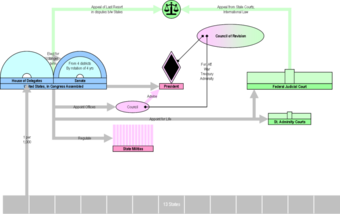
Pinckney Plan
The Pinckney Plan proposed a bicameral legislature made up of a Senate and a House of Delegates. The House would have one member for every one thousand inhabitants. The House would elect Senators who would serve by rotation for four years and represent one of four regions. Congress would meet in a joint session to elect a President, and would also appoint members of the cabinet. Congress, in joint session, would serve as the court of appeal of last resort in disputes between states.
New Jersey Plan
After the Virginia Plan was introduced, New Jersey delegate William Paterson asked for an adjournment to contemplate the plan. Under the Articles of Confederation, each state had equal representation in Congress—one vote per state. Paterson’s New Jersey Plan was ultimately a rebuttal to the Virginia Plan. Under the New Jersey Plan, the unicameral legislature with one vote per state was inherited from the Articles of Confederation. This position reflected the belief that the states were independent entities that could enter and leave the United States on their own volition.
Hamilton’s Plan
Unsatisfied with the New Jersey Plan and the Virginia Plan, Alexander Hamilton proposed his own plan. It also was known as the British Plan, because of its resemblance to the British system of strong centralized government. Hamilton’s plan advocated doing away with much state sovereignty and consolidating the states into a single nation. The plan featured a bicameral legislature, the lower house elected by the people for three years. The upper house would be elected by electors chosen by the people and would serve for life. The plan also gave the Governor, an executive elected by electors for a life-term of service, an absolute veto over bills. State governors would be appointed by the national legislature, and the national legislature had veto power over any state legislation.
Hamilton presented his plan to the Convention on June 18, 1787. The plan was perceived as a well-thought-out plan, but it was not considered because it resembled the British system too closely.
Connecticut Compromise
To resolve this stalemate, Roger Sherman, a delegate from Connecticut, forged the Connecticut Compromise. In a sense it blended the Virginia (large-state) and New Jersey (small-state) proposals. Ultimately, its main contribution was determining the method for apportionment of the Senate and retaining a federal character in the constitution.
What was ultimately included in the Constitution was a modified form of this plan. In the Committee of Detail, Benjamin Franklin added the requirement that revenue bills originate in the House. As such, the Senate would bring a federal character to the government, not because senators were elected by state legislatures, but because each state was equally represented.
2.2.4: The Virginia and New Jersey Plans
In the Constitutional Convention, the Virginia Plan favored large states while the New Jersey Plan favored small states.
Learning Objective
Compare and contrast the Virginia Plan, the New Jersey Plan, and the Connecticut Compromise regarding the revision of the Articles of Confederation.
Key Points
- The Virginia delegation took the initiative to frame the debate by immediately drawing up and presenting a proposal, for which delegate James Madison was given chief credit.
- The Virginia Plan proposed a bicameral legislature, a legislative branch with two chambers. This legislature would contain the dual principles of rotation in office and recall, applied to the lower house of the national legislature.
- According to the Virginia Plan, states with a large population would have more representatives than smaller states. Large states supported this plan, while smaller states generally opposed it.
- Under the New Jersey Plan, the unicameral legislature with one vote per state was inherited from the Articles of Confederation. This position reflected the belief that the states were independent entities.
- Ultimately, the New Jersey Plan was rejected as a basis for a new constitution. The Virginia Plan was used, but some ideas from the New Jersey Plan were added.
- The Connecticut Compromise established a bicameral legislature with the U.S. House of Representatives apportioned by population as desired by the Virginia Plan and the Senate granted equal votes per state as desired by the New Jersey Plan.
Key Terms
- recall
-
a procedure by which voters can remove an elected official from office through a direct vote before his or her term has ended
- Connecticut Compromise
-
The Connecticut Compromise was an agreement that both large and small states reached during the Constitutional Convention of 1787. The compromise defined, in part, the legislative structure and representation that each state would have under the United States Constitution. It retained the bicameral legislature as proposed by James Madison, along with proportional representation in the lower house, but required the upper house to be weighted equally between the states.
- new jersey plan
-
Under the New Jersey Plan, the unicameral legislature with one vote per state was inherited from the Articles of Confederation. This position reflected the belief that the states were independent entities and as they entered the United States of America freely and individually, so they remained.
- virginia plan
-
Virginia Plan was a proposal by Virginia delegates for a bicameral legislative branch. Prior to the start of the Convention, the Virginian delegates met and, drawing largely from Madison’s suggestions, drafted a plan.
Introduction
The Constitutional Convention gathered in Philadelphia to revise the Articles of Confederation. The Virginia delegation took the initiative to frame the debate by immediately drawing up and presenting a proposal, for which delegate James Madison is given chief credit. It was, however, Edmund Randolph, the Virginia governor at the time, who officially put it before the convention on May 29, 1787 in the form of 15 resolutions.
The scope of the resolutions, going well beyond tinkering with the Articles of Confederation, succeeded in broadening the debate to encompass fundamental revisions to the structure and powers of the national government. The resolutions proposed, for example, a new form of national government having three branches: legislative, executive, and judicial. One contentious issue facing the convention was the manner in which large and small states would be represented in the legislature. The contention was whether there would be equal representation for each state regardless of its size and population, or proportionate to population giving larger states more votes than less-populous states.
Virginia Plan
The Virginia Plan proposed a bicameral legislature, a legislative branch with two chambers. This legislature would contain the dual principles of rotation in office and recall, applied to the lower house of the national legislature . Each of the states would be represented in proportion to their “quotas of contribution, or to the number of free inhabitants.” States with a large population would thus have more representatives than smaller states. Large states supported this plan, while smaller states generally opposed it.
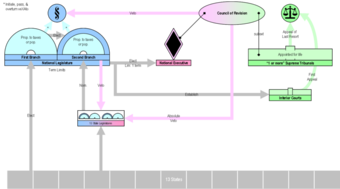
Virginia Plan
Visual representation of the structure of James Madison’s Virginia Plan.
In addition to dealing with legislative representation, the Virginia Plan addressed other issues as well, with many provisions that did not make it into the Constitution that emerged. It called for a national government of three branches: legislative, executive, and judicial. The people would elect members for one of the two legislative chambers. Members of that chamber would then elect the second chamber from nominations submitted by state legislatures. The legislative branch would then choose the executive branch.
The terms of office were unspecified, but the executive and members of the popularly elected legislative chamber could not be elected for an undetermined time afterward. The legislative branch would have the power to negate state laws if they were deemed incompatible with the articles of union. The concept of checks and balances was embodied in a provision that a council composed of the executive and selected members of the judicial branch could veto legislative acts. An unspecified legislative majority could override their veto.
New Jersey Plan
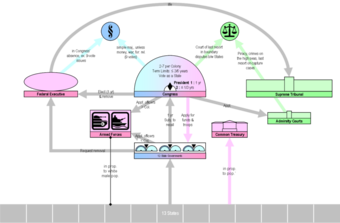
New Jersey Plan
Visual representation of the structure of the New Jersey Plan.
After the Virginia Plan was introduced, New Jersey delegate William Paterson asked for an adjournment to contemplate the Plan. Paterson’s New Jersey Plan was ultimately a rebuttal to the Virginia Plan . The less populous states were adamantly opposed to giving most of the control of the national government to the more populous states, and so proposed an alternative plan that would have kept the one-vote-per-state representation under one legislative body from the Articles of Confederation.
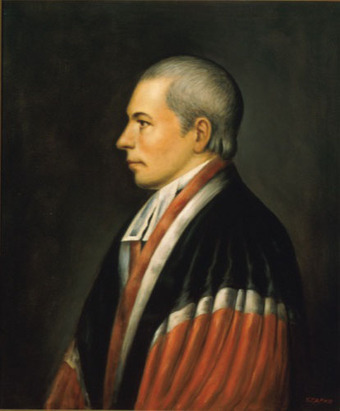
William Paterson
Portrait of William Paterson (1745–1806) when he was a Supreme Court Justice (1793–1806). Paterson was also known as the primary author of the New Jersey Plan during the Constitutional Convention in Philadelphia.
Under the New Jersey Plan, the unicameral legislature with one vote per state was inherited from the Articles of Confederation. This position reflected the belief that the states were independent entities, and as they entered the United States of America freely and individually, so they remained. The plan proposed that the Articles of Confederation should be amended as follows:
- Congress would gain authority to raise funds using tariffs and other measures;
- Congress would elect a federal executive who cannot be re-elected and subject to recall by Congress;
- The Articles of Confederation and treaties would be proclaimed as the supreme law of the land.
Connecticut Compromise
Ultimately, the New Jersey Plan was rejected as a basis for a new constitution. The Virginia Plan was used, but some ideas from the New Jersey Plan were added.
2.2.5: Debate over the Presidency and the Judiciary
During the Constitutional Convention, the most contentious disputes revolved around the composition of the Presidency and the Judiciary.
Learning Objective
Discuss the key debates of the Constitutional Convention
Key Points
- While waiting for the convention to formally begin, James Madison sketched out his initial draft, which became known as the “Virginia Plan” and which reflected his views as a strong nationalist.
- At the convention, some sided with Madison that the legislature should choose judges, while others believed the president should choose judges. A compromise was eventually reached that the president should choose judges and the Senate confirm them.
- The convention agreed that the house would elect the president if no candidate had an Electoral College majority, but that each state delegation would vote as a block, rather than individually.
- The Committee on Detail shortened the president’s term from seven years to four years, freed the president to seek re-election after an initial term, and moved impeachment trials from the courts to the Senate. They also created the office of the vice president.
Key Terms
- electoral college
-
A body of electors empowered to elect someone to a particular office
- presidency
-
The bureaucratic organization and governmental initiatives devolving directly from the president.
- James Madison
-
James Madison was an American statesman and political theorist, the fourth President of the United States (1809–1817). He is hailed as the “Father of the Constitution” for being instrumental in the drafting of the United States Constitution and as the key champion and author of the United States Bill of Rights.
Debate Over the Presidency and Judiciary
During the Constitutional Convention, the most contentious disputes revolved around the composition and election of the Senate, how “proportional representation” was to be defined, whether to divide the executive power between three people or invest the power into a single president, how to elect the president, how long his term was to be and whether he could stand for reelection, what offenses should be impeachable, the nature of a fugitive slave clause, whether to allow the abolition of the slave trade, and whether judges should be chosen by the legislature or executive. Most of the convention was spent deciding these issues, while the powers of legislature, executive, and judiciary were not heavily disputed .
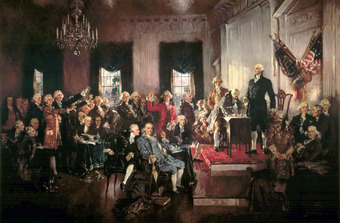
Constitutional Convention in Philadelphia
During the Constitutional Convention, some the most contentious disputes revolved around the composition of the Presidency and the Judiciary.
James Madison’s Influence
While waiting for the convention to formally begin, James Madison sketched out his initial draft, which became known as the “Virginia Plan” and which reflected his views as a strong nationalist . By the time the rest of the Virginia delegation arrived, most of the Pennsylvania delegation had arrived as well. The delegates agreed with Madison that the executive function had to be independent of the legislature. In their aversion to kingly power, American legislatures had created state governments where the executive was beholden to the legislature and by the late 1780s, this was widely seen as being a source of paralysis. The Confederation government was the ultimate example of this.
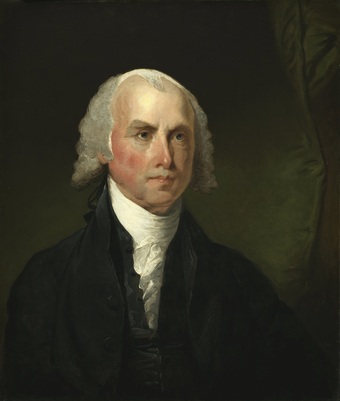
Portrait of James Madison
James Madison authored the Virginia Plan, which contained important provisions on the presidency and judiciary.
Madison believed that in the American states, this direct link between state executives and judges was a source of corruption through patronage and thought the link had to be severed between the two, thus creating the “third branch” of the judiciary which had been without any direct precedent before this point. Madison, however, did not believe that the judiciary should be truly independent, but rather be obligated to the legislature not the executive. By insisting on the independence of the judiciary, Madison stepped away from the Articles of Confederation to create something entirely new. At the convention, some sided with Madison that the legislature should choose judges, while others believed the president should choose judges. A compromise was eventually reached that the president should pick judges and the Senate confirm them.
The Early Debate
One of the most pressing issues during the early debate was the election of the president. Few agreed with Madison that the executive should be elected by the legislature. There was widespread concern with direct election, because information diffused so slowly in the late eighteenth century and because of concerns that people would only vote for candidates from their state or region. A vocal minority wanted the national executive to be chosen by the governors of the states.
This was one of the last major issues to be resolved and was done so in the Electoral College. At the time, before the formation of modern political parties, there was widespread concern that candidates would routinely fail to secure a majority of electors in the Electoral College. The method of resolving this problem, therefore, was a contested issue. Most thought that the house should then choose the president, since it most closely reflected the will of the people. To resolve this dispute, the convention agreed that the house would elect the president if no candidate had an Electoral College majority, but that each state delegation would vote as a block, rather than individually .

Electoral College 1800
The Constitutional Convention agreed that the house would elect the president if no candidate had an Electoral College majority, but that each state delegation would vote as a block, rather than individually.
Modifications
The Committee of Detail was a committee established by the United States Constitutional Convention on June 23, 1787 to put down a draft text reflecting the agreements made by the convention up to that point, including the Virginia Plan’s 15 resolutions. It was chaired by John Rutledge, and other members included Edmund Randolph, Oliver Ellsworth, James Wilson, and Nathaniel Gorham.
The committee shortened the president’s term from seven years to four years, freed the president to seek re-election after an initial term, and moved impeachment trials from the courts to the Senate. It also created the Office of the Vice President whose only roles were to succeed a president unable to complete a term of office and to preside over the Senate. The committee transferred important powers from the Senate to the president who now, for example, would be given the power to make treaties and appoint ambassadors. One controversial issue throughout much of the Convention had been the length of the president’s term and whether the president was to be term limited. The problem had resulted from the understanding that the president would be chosen by Congress; the decision to have the president be chosen instead by an electoral college reduced the chance of the president becoming beholden to Congress, so a shorter term with eligibility for re-election became a viable option.
2.2.6: Drafting the Final Document
The report from the Committee on Detail at the Constitutional Convention constituted the first draft of the United States Constitution.
Learning Objective
Summarize the editorial stages the Constitution went through
Key Points
- The Constitutional Convention took place from May 14 to September 17, 1787, in Philadelphia, Pennsylvania, to address problems in governing the United States of America.
- The Three-Fifths Compromise designated that three-fifths of the slave population would be counted as part of a state’s population.
- The Committee of Detail was a committee established by the United States Constitutional Convention on June 23, 1787 to put down a draft text reflecting the agreements made by the Convention up to that point, including the Virginia Plan’s fifteen resolutions.
- Once the final modifications had been made, the Committee of Style and Arrangement was appointed to revise the articles which had been agreed to by the house.
- George Washington signed the document first. Moving by state delegation from north to south, as had been the custom throughout the Convention, the delegates filed to the front of the room to sign their names.
- After the signing, the Constitution was submitted to the states for ratification, as stipulated by its own Article VII.
Key Terms
- committee of style and arrangement
-
Once the final modifications had been made, the Committee of Style and Arrangement was appointed “to revise the style of and arrange the articles which had been agreed to by the house. “
- Committee of Detail
-
The Committee of Detail was a committee established by the United States Constitutional Convention on June 23, 1787 to put down a draft text reflecting the agreements made by the Convention up to that point, including the Virginia Plan’s 15 resolutions.
Example
- Much of the Committee of Detail’s proposal would ultimately be incorporated into the final version of the Constitution without debate. Examples of these details included the Speech and Debate Clause, which grants members of Congress immunity for comments made in their jobs, and the rules for organizing the House of Representatives and the Senate.
Introduction
The Constitutional Convention took place in 1787, from May to September, in Philadelphia, Pennsylvania. It was convened to address problems in governing the United States of America following independence from Great Britain. Before the Constitution was drafted, the nearly four million inhabitants of the thirteen newly-independent states were governed under the Articles of Confederation, created by the Second Continental Congress. However, the chronically underfunded Confederation government, as originally organized, was inadequate for managing the various conflicts that arose among the states. Due to the difficulty of travel in the late 18th century, very few of the selected delegates were present on the designated day of May 14, 1787. It was not until May 25 that a quorum of seven states was secured.
The Early Debate
During the debates, each state was allowed to cast a single vote in accordance with the majority opinion of the state’s delegates. The first area of major dispute was the manner by which the lower house would be apportioned. A minority wanted all states would have equal weight. Most accepted the desire among the slave states to count slaves as part of the population, although their servile status was raised as a major objection against this. The Three-Fifths Compromise designated that three-fifths of the slave population would be counted as part of a state’s population.
The First Draft
The Convention adjourned from July 26 to August 6 to await the report of the Committee of Detail. The Committee of Detail drafted agreements made by the Convention up to that point, including the Virginia Plan’s fifteen resolutions. It was chaired by John Rutledge . Other members included Edmund Randolph, Oliver Ellsworth, James Wilson, and Nathaniel Gorham. This report constituted the first draft of the United States Constitution. Much of what was contained in the final document was present in this draft.
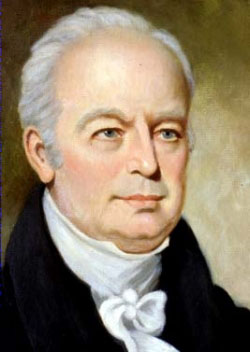
John Rutledge
The Constitutional Convention adjourned to await the report of the Committee of Detail, which was to produce a first draft of the Constitution. It was chaired by John Rutledge (nicknamed “Dictator John” as a reflection of the extraordinary power he had assumed as South Carolina’s governor during the early days of the Revolution).
Many details recorded by the Committee had never been discussed during the Convention, but the Committee viewed these details as uncontroversial and unlikely to be challenged. Much of the Committee’s proposal would ultimately be incorporated into the final version of the Constitution without debate. Examples of these details include the Speech and Debate Clause, which grants members of Congress immunity for comments made in their jobs and the rules for organizing the House of Representatives and the Senate.
Further Modifications
Another month of discussion and minor refinement followed. During this month, few attempts to alter the Rutledge draft were successful. Some delegates wanted to add property qualifications for people to hold office. Others wanted to prevent the national government from issuing paper money. James Madison wanted to push the Constitution back in the direction of his Virginia plan.
Drafting and Signing
Once the final modifications had been made, the Committee of Style and Arrangement was appointed “to revise the style of and arrange the articles which had been agreed to by the house.” Unlike other committees this final committee included no representatives from smaller states. Its members were mostly in favor of a strong national government and unsympathetic to calls for states’ rights.
For three days, the Convention compared this final version with the proceedings of the Convention. The Constitution was ordered engrossed on Saturday, September 15 by Jacob Shallus, and it was submitted for signing on September 17. George Washington signed the document first. Moving by state delegation from north to south, as had been the custom throughout the Convention, the delegates filed to the front of the room to sign their names . As the final delegates were signing the document, Benjamin Franklin commented on the painting of a sun behind Washington’s chair at the front of the room. He said he often looked at the painting, “without being able to tell, whether it was rising or setting. But now at length, I have the happiness to know it is a rising, and not a setting sun. ” The Constitution was then submitted to the states for ratification, as stipulated by Article VII.
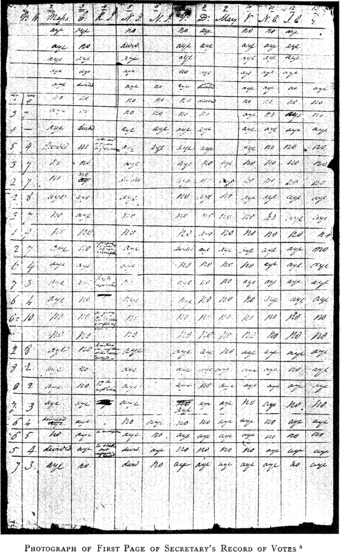
Delegates Voting
Reproduction of secretary’s handwritten records of votes conducted at the U.S. Constitutional Convention of 1787, as published in Farrand’s Records, Volume 1 (1911).
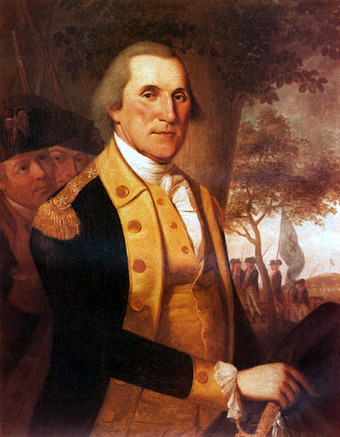
George Washington
George Washington; Oil on canvas, 361/2″ x 273/4″ (circa 1787-1790).
2.3: The Constitution
2.3.1: The Constitution
Adopted on September 17, 1787, the Constitution is the supreme law of the United States of America.
Learning Objective
Analyze the key historical documents and political theorists that shaped the contours of the Constitution
Key Points
- The Constitution was adopted on September 17, 1787 by the Constitutional Convention in Philadelphia, Pennsylvania. It was ratified by conventions in 11 states. It went into effect on March 4, 1789.
- The first 10 constitutional amendments ratified by three-fourths of the states in 1791 are known as the Bill of Rights. The Constitution has been amended 17 additional times – for a total of 27 amendments – and its principles are applied in courts of law by judicial review.
- The due process clause of the Constitution was partly based on common law and on Magna Carta (1215), which had become a foundation of English liberty against arbitrary power wielded by a tyrant.
- The philosophers John Locke, Thomas Hobbes, and Monstesquieu substantially influenced the underlying principles embodied by the Constitution, such as the notion that the government’s duty under a social contract among the sovereign people is to serve them by protecting their natural rights.
- There is a viewpoint that some Americans have come to see the documents of the Constitution, along with the Declaration of Independence and the Bill of Rights, as being a cornerstone of a type of civic religion.
- The United States Constitution has had a considerable influence worldwide on later constitutions. International leaders have followed it as a model within their own traditions.
Key Terms
- Magna Carta
-
The 1215 magna carta, also called charter, required King John of England to proclaim certain liberties and accept that his will was not arbitrary. For example, no “freeman” (in the sense of non-serf) could be punished except through the law of the land. This is a right that is still in existence today.
- United States Constitution
-
The Constitution is the supreme law of the United States of America.
- civic religion
-
Term used to refer to view that Americans view the documents of the Constitution, along with the Declaration of Independence and the Bill of Rights, as being a cornerstone of a type of civic religion.
Example
- Changing the “fundamental law” is a two-part process with three steps: amendments are proposed and then they must be ratified by the states. To date, all amendments, whether ratified or not, have been proposed by a two-thirds vote in each house of Congress. Over 10,000 constitutional amendments have been introduced in Congress since 1789. During the last several decades, between 100 and 200 amendments have been offered in a typical congressional year.
Introduction
The Constitution is the supreme law of the United States of America . The first three articles of the Constitution establish the rules and separate powers of the three branches of the federal government: a legislature, the bicameral Congress which is an executive branch led by the President, and a federal judiciary headed by the Supreme Court. The last four articles frame the principle of federalism. The 10th Amendment confirms its federal characteristics.
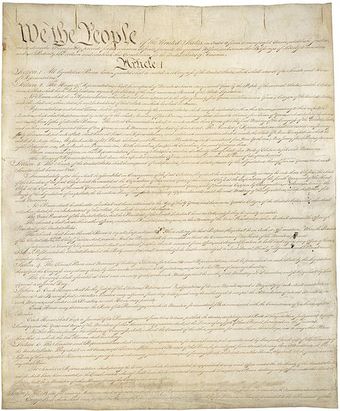
United States Constitution
In the U.S. Constitution, the Taxing and Spending clause gives the federal government of the United States its power of taxation.
The Constitution was adopted on September 17, 1787 by the Constitutional Convention in Philadelphia, Pennsylvania. It was ratified by conventions in 11 states. It went into effect on March 4, 1789. The first 10 constitutional amendments ratified by three-fourths of the states in 1791 are known as the Bill of Rights. The Constitution has been amended 17 additional times – for a total of 27 amendments – and its principles are applied in courts of law by judicial review.
The Constitution guides American society in law and political culture. It is the oldest written national constitution in continuous use. It influenced later international figures establishing national constitutions.
Historical Influences
Several ideas found in the Constitution were new. These were associated with the combination of consolidated government along with federal relationships with constituent states. The due process clause of the Constitution was partially based on common law and on Magna Carta (1215, ), which had become a foundation of English liberty against arbitrary power wielded by a tyrant. Both the influence of Edward Coke and William Blackstone were evident at the Convention. In his Institutes of the Laws of England, Edward Coke interpreted Magna Carta protections and rights to apply not just to nobles, but to all British subjects.
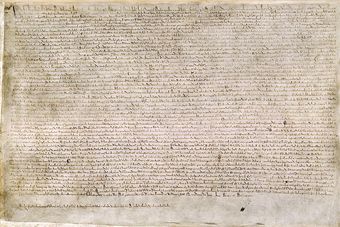
Magna Carta
The Magna Carta of 1215 was written in iron gall ink on parchment in medieval Latin using standard abbreviations of the period. It was authenticated with the Great Seal of King John. The original wax seal was lost over the centuries. This document is held at the British Library identified as The British Library, Cotton MS. Augustus II.
Following the Glorious Revolution, British political philosopher John Locke was a major influence expanding on the contract theory of government advanced by Thomas Hobbes . Locke advanced the principle of consent of the governed in his Two Treatises of Government. Government’s duty under a social contract among the sovereign people was to serve them by protecting their rights. These basic rights were life, liberty, and property. Montesquieu emphasized the need for balanced forces pushing against each other to prevent tyranny. In The Spirit of the Laws, Montesquieu argues that the separation of state powers should be by its service to the people’s liberty: legislative, executive, and judicial.
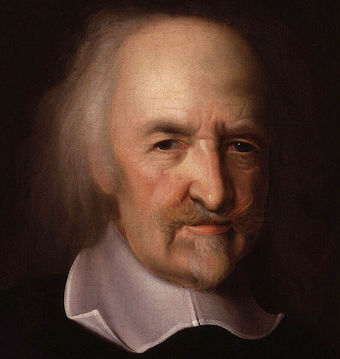
Thomas Hobbes
The English political theorist Thomas Hobbes was very influential to the Founding Fathers when the created the Constitution of the United States.
The Amendments
Changing the “fundamental law” is a two-part process with three steps: amendments are proposed, then they must be ratified by the states. An amendment can be proposed one of two ways. Both ways have two steps. It can be proposed by Congress and ratified by the states. Or it can be on demand of two-thirds of the state legislatures. Congress could call a constitutional convention to propose an amendment, then it would be ratified by the states. To date, all amendments, whether ratified or not, have been proposed by a two-thirds vote in each house of Congress. Over 10,000 constitutional amendments have been introduced in Congress since 1789. During the last several decades, between 100 and 200 amendments have been offered in a typical congressional year.
The Constitution has 27 amendments. The first 10, collectively known as the Bill of Rights, were ratified simultaneously by 1791. The next 17 were ratified separately over the next two centuries.
Civic Religion and Worldwide Influence
There is a viewpoint that some Americans have come to see the documents of the Constitution, along with the Declaration of Independence and the Bill of Rights, as being a cornerstone of a type of civic religion. This is suggested by the prominent display of the Constitution, along with the Declaration of Independence and the Bill of Rights. They are kept in massive, bronze-framed, bulletproof, moisture-controlled glass containers vacuum-sealed in a rotunda during the day. At night they are housed in the National Archives Building in multi-ton bomb-proof vaults.
The United States Constitution has had a considerable influence worldwide on later constitutions. International leaders have followed it as a model within their own traditions. These leaders include Benito Juarez of Mexico, Jose Rizal of the Philippines, and Sun Yat-sen of China.
2.3.2: The Bill of Rights
The Bill of Rights is a series of limitations on the power of the U.S. government, protecting the natural rights of liberty and property.
Learning Objective
Explain the philosophical ideas that influenced the Bill of Rights
Key Points
- The Bill of Rights is the collective name for the first ten amendments to the United States Constitution. They guarantee a number of personal freedoms, limit the government’s power in judicial and other proceedings, and reserve some powers to the states and the public.
- The Articles of Confederation was an agreement among the 13 founding states that established the United States of America as a confederation of sovereign states and served as its first constitution.
- Delegates to the Philadelphia Convention on September 12, 1787, debated whether to include a Bill of Rights in the body of the U.S. Constitution, and an agreement to create the Bill of Rights helped to secure ratification of the Constitution itself.
- The Bill of Rights incorporated the ideas of John Locke, who argued in his 1689 work Two Treatises of Government that civil society was created for the protection of property.
- The idea of adding a bill of rights to the Constitution was originally controversial. While originally authored by James Madison, the bill of rights was opposed by Alexander Hamilton on the grounds that they are unnecessary for the protection of liberties and property.
- Today, the Bill of Rights continues to play a key role in American law and government, and remains a vital symbol of the freedoms and culture of the nation.
Key Terms
- James Madison
-
James Madison was an American statesman and political theorist, the fourth President of the United States (1809–1817). He is hailed as the “Father of the Constitution” for being instrumental in the drafting of the United States Constitution and as the key champion and author of the United States Bill of Rights.
- John Locke
-
John Locke, widely known as the Father of Classical Liberalism, was an English philosopher and physician regarded as one of the most influential of Enlightenment thinkers.
- Articles of Confederation
-
The Articles of Confederation was an agreement among the 13 founding states that established the United States of America as a confederation of sovereign states and served as its first constitution
Example
- The Bill of Rights reserves for the people any rights not specifically mentioned in the Constitution and reserves all powers not specifically granted to the federal government to the people or the States. As the best-known example, the First Amendment states that “Congress shall make no law respecting an establishment of religion, or prohibiting the free exercise thereof; or abridging the freedom of speech, or of the press; or the right of the people peaceably to assemble, and to petition the Government for a redress of grievances. “
The Bill of Rights
The Bill of Rights is the collective name for the first ten amendments of the United States Constitution. It is a series of limitations on the power of the U.S. federal government, protecting the natural rights of liberty and property including freedom of religion, freedom of speech, a free press, free assembly, and free association, as well as the right to keep and bear arms . In federal criminal cases, the Bill of Rights requires indictment by a grand jury for any capital or “infamous crime”, guarantees a speedy, public trial with an impartial jury composed of members of the state or judicial district in which the crime occurred, and prohibits double jeopardy. In addition, the Bill of Rights reserves for the people any rights not specifically mentioned in the Constitution and reserves all powers not specifically granted to the federal government to the people or the States.
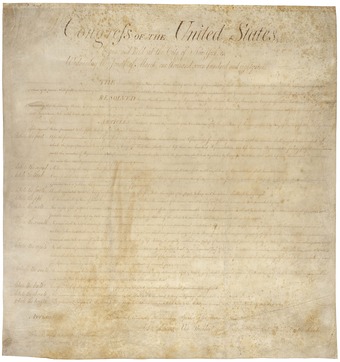
Bill of Rights
The First Amendment rights of free speech, freedom of association, and freedom of petition protect lobbying, including grassroots lobbying.
Articles of Confederation
Prior to the acceptance and implementation of the United States Constitution, the original 13 colonies followed the stipulations and agreements set forth in the Articles of Confederation, created by the Second Continental Congress and ratified in 1781. The Articles of Confederation established the United States of America as a confederation of sovereign states and served as its first constitution . The national government that operated under the Articles of Confederation was too weak however to adequately regulate the various conflicts that arose between the states. The Philadelphia Convention set out to correct weaknesses inherent in the Articles of Confederation. The newly constituted Federal government included a strong executive branch, a stronger legislative branch and an independent judiciary.
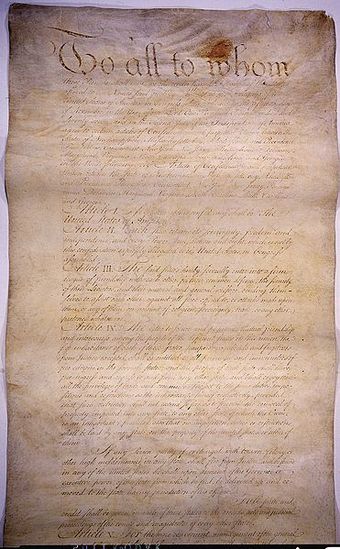
Articles of Confederation
The Articles of Confederation, ratified in 1781. This was the format for the United States government until the Constitution.
The Philadelphia Convention
Delegates arrived at the Philadelphia Convention on September 12, 1787, to debate whether to include a Bill of Rights in the body of the U.S. Constitution. An agreement to create the Bill of Rights helped secure ratification of the Constitution itself. Ideological conflict between Federalists and anti-Federalists threatened the final ratification of the new national Constitution. Thus, the Bill addressed the concerns of some of the Constitution’s influential opponents, who argued that the Constitution should not be ratified because it failed to protect the fundamental principles of human liberty.
Ideas Behind the Bill of Rights
To some degree, the Bill of Rights incorporated the ideas of John Locke, who argued in his 1689 work, Two Treatises of Government, that civil society was created for the protection of property . Locke also advanced the notion that each individual is free and equal in the state of nature. He expounded on the idea of natural rights that are inherent to all individuals.
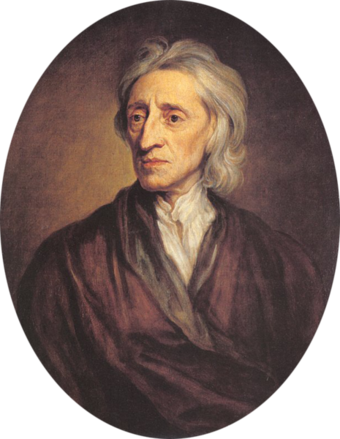
John Locke
Author of Two Treatises of Government (1689) which argued that civil society was created for the protection of property. This piece was influential in the creation of the Bill of Rights.
Locke’s political theory was founded on social contract theory. Unlike Thomas Hobbes, Locke believed that human nature is characterized by reason and tolerance. Like Hobbes, Locke believed that human nature allowed men to be selfish. Like Hobbes, Locke assumed that the sole right to defend in the state of nature was not enough, so people established a civil society to resolve conflicts in a civil way with help from government in a state of society. However, Locke never refers to Hobbes by name and may instead have been responding to other writers of the day. Locke also advocated governmental separation of powers and believed that revolution is not only a right but an obligation in some circumstances. These ideas would come to have profound influence on the Declaration of Independence and the Constitution of the United States.
Adoption and Ramification
As the author of the amendments, James Madison submitted his proposal for the ten amendments on June 8, 1789. Madison’s proposal was reworked and adopted as seventeen amendments by the House of Representatives on August 21, 1789, and forwarded to the Senate on August 24. The House version rejected Madison’s idea to incorporate the amendments into the body of the Constitution and instead submitted its seventeen articles to be attached separately “in addition to, and amendment of, the Constitution. ” The Senate edited the House’s proposed seventeen amendments and adopted a version with twelve amendments. The two versions went to the Joint Committee and the Senate’s version became the one adopted by joint resolution of Congress on September 25, 1789, to be forwarded to the states on September 28.
Legacy of the Bill of Rights
The Bill of Rights plays a key role in American law and government, and remains a vital symbol of the freedoms and culture of the nation. One of the first fourteen copies of the Bill of Rights is on public display at the National Archives in Washington, D.C. In 1991, the Bill of Rights toured the country in honor of its bicentennial, visiting the capitals of all fifty states.
2.3.3: The Legislative Branch
The legislative branch is represented by Congress, a bicameral chamber consisting of the House of Representatives and the Senate.
Learning Objective
Describe the powers accorded to the Legislative Branch under Article I
Key Points
- Article I of the United States Constitution describes the powers of Congress, the legislative branch of the federal government, which includes the House of Representatives and the Senate.
- Congress has authority over financial and budgetary policy through the enumerated power to lay and collect taxes, duties, imposts and excises, to pay the debts and provide for the common defense and general welfare of the United States.
- The United States House of Representatives passes federal legislation that affects the entire country. The House has several exclusive powers: the power to initiate revenue bills, to impeach officials, and to elect the U.S. President in case there is no majority in the Electoral College.
- Congress has an important role in national defense, including the exclusive power to declare war, to raise and maintain the armed forces, and to make rules for the military.
- The Senate, comprised of 100 senators, has several exclusive powers not granted to the House, including consenting to treaties as a precondition to their ratification and consenting or confirming appointments of officials in the executive branch.
- The terms of members of Congress vary: every representative must run for election every two years, whereas every senator must run for election every 6 years.
Key Terms
- senate
-
The composition and powers of the Senate are established in Article I of the U.S. Constitution. Each U.S. state is represented by two senators, regardless of population. Senators serve staggered six-year terms. The chamber of the United States Senate is located in the north wing of the Capitol, in Washington, D.C., the national capital.
- house of representatives
-
The United States House of Representatives is one of the two houses of the United States Congress. The major power of the House is to pass federal legislation that affects the entire country, although its bills must also be passed by the Senate and further agreed to by the U.S. President before becoming law.
- Congress
-
(often capitalized: Congress) A legislative body of a state, originally the bicameral legislature of the United States of America.
Example
- One of Congress’s foremost non-legislative functions is the power to investigate and oversee the executive branch. Congressional oversight is usually delegated to committees and is facilitated by Congress’s subpoena power. A good historical example of Congressional Oversight was the investigation of President Richard Nixon and Watergate.
The United States Constitution
The United States Constitution consists of a preamble, seven original articles, twenty-seven amendments, and a paragraph certifying its enactment by the constitutional convention. Article I of the United States Constitution describes the powers of Congress, the legislative branch of the federal government. To establish the powers of and limitations of the Congress, the Article addresses the creation of the House of Representatives, which is composed of Representatives from each state. The number of representatives for each state is dependent upon the size of the population. The Article also establishes that there will be two Senators from each state.
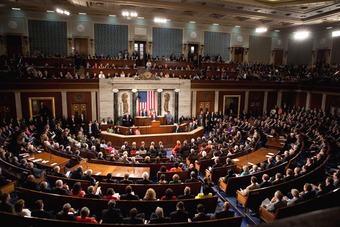
Joint Session of a Two-Party Congress
The United States Congress is an example of a two-party system of governance. In this picture, Obama’s Health Care Speech is being given to both the House and the Senate.
The House and Senate are equal partners in the legislative process—legislation cannot be enacted without the consent of both chambers. However, the Constitution grants each chamber some unique powers. The Senate ratifies treaties and approves presidential appointments, while the House of Representatives initiates revenue-raising bills. The House initiates impeachment cases, while the Senate decides impeachment cases. A two-thirds vote of the Senate is required before an impeached person can be forcibly removed from office.
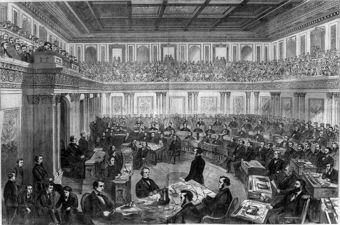
Johnson’s Impeachment
The Senate functioning as the Court of Impeachment for the Trial of Andrew Johnson.
Powers of Congress
Congress has authority over financial and budgetary policy through the enumerated power to lay and collect taxes, duties, imposts and excises, to pay the debts and provide for the common defense and general welfare of the United States. Moreover, Congress has an important role in national defense, including the exclusive power to declare war, to raise and maintain the armed forces, and to make rules for the military. Congress can establish post offices and post roads, issue patents and copyrights, fix standards of weights and measures, and establish Courts inferior to the Supreme Court.
One of Congress’ foremost non-legislative functions is the power to investigate and oversee the executive branch. Congressional oversight is usually delegated to committees and is facilitated by Congress’ subpoena power. A good historical example of Congressional Oversight was the investigation of President Richard Nixon and Watergate.
The Executive branch and political parties and major sources of legislation. For example, the President can use his power to hand a member of Congress the content of a major bill to introduce in the house. Another souce of legislation are Courts. Judges and Justies make law everytime they struckdown laws and provide the new precedent for future legislation. The only institutions that are not sources for legislative ideas are government departments and agencies.
The House of Representatives
The United States House of Representatives is one of the two houses in the United States Congress. The major power of the House is to pass federal legislation that affects the entire country, although its bills must also be passed by the Senate and further agreed to by the President before becoming law. The House has several exclusive powers: the power to initiate revenue bills, to impeach officials, and to elect the U.S. President in case there is no majority in the Electoral College.
Each state is represented in the House in proportion to its population, but is entitled to at least one representative. The most populous state, California, currently has 53 representatives. The total number of voting representatives is fixed by law at 435. Each representative serves for a two-year term. The Speaker of the United States House of Representatives, who presides over the chamber, is elected by the members of the House, and is therefore traditionally the leader of the House Democratic Caucus or the House Republican Conference, whichever of the two Congressional Membership Organizations has more voting members.
Elections for representatives are held in every even-numbered year, and on Election Day, the first Tuesday after the first Monday in November. By law, Representatives must be elected from single-member districts by plurality voting.
The Senate
The composition and powers of the Senate are established in Article I of the U.S. Constitution. Each state is represented by two senators, regardless of population. Senators serve staggered six-year terms. The chamber of the United States Senate is located in the north wing of the Capitol, in Washington, D.C., the national capital.
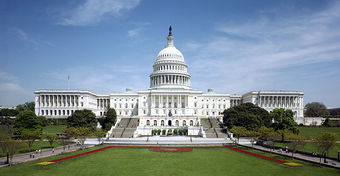
U.S. Capitol
This is an image of the western front of the United States Capitol. The Neoclassical style building is located in Washington, D.C., on top of Capitol Hill at the east end of the National Mall. The Capitol was designated a National Historic Landmark in 1960.
The Senate has several exclusive powers not granted to the House, including consenting to treaties as a precondition to their ratification. The Senate also confirms appointments of Cabinet secretaries, federal judges, other federal executive officials, military officers, regulatory officials, ambassadors, and other federal uniformed officers, as well as trial of federal officials impeached by the House. The Vice President of the United States is the ex officio President of the Senate, with authority to preside over the Senate’s sessions, although he can vote only to break a tie.
Senators are regarded as more prominent political figures than members of the House of Representatives because there are fewer of them, and because they serve for longer terms, usually represent larger constituencies.
2.3.4: The Executive Branch
The executive power in the government is vested in the President and Vice-President of the United States, the Cabinet and federal agencies.
Learning Objective
Summarize the structure of the Executive Branch
Key Points
- The Executive Branch of government is responsible for administering, implementing and enforcing the laws passed by the Legislative Branch of government.
- The President is both the head of state and government, as well as the military commander-in-chief and chief diplomat. The President is indirectly elected by the people through the Electoral College to a four-year term, and is one of only two nationally elected federal officers.
- If the President has already served two years or more of a term to which some other person was elected, he may only serve one more additional four-year term.
- The Vice President is the second-highest executive official in rank of the government. As first in the U.S. presidential line of succession, the Vice President becomes President upon the death, resignation, or removal of the President. The Vice-President is also the President of the Senate.
- The Cabinet of the United States is composed of the most senior appointed officers of the executive branch of the federal government of the United States, who are generally the heads of the federal executive departments.
- The day-to-day enforcement and administration of federal laws is in the hands of the various federal executive departments. The majority of the independent agencies of the United States government are also classified as executive agencies.
Key Terms
- cabinet of the united states
-
The Cabinet of the United States is composed of the most senior appointed officers of the executive branch of the federal government of the United States, who are generally the heads of the federal executive departments.
- president of the united states
-
As head of the Executive Branch of government, The President is both the head of state and government, as well as the military commander-in-chief and chief diplomat.
- executive branch
-
The branch of government that oversees the carrying out of the laws, led by the president.
Example
- The President presides over the executive branch of the federal government, an organization numbering about 5 million people, including 1 million active-duty military personnel and 600000 postal service employees. On January 20, 2009, Barack Obama became the 44th and current president.
Introduction
The executive power in the federal government is vested in the President of the United States, although power is often delegated to the Cabinet members and other officials. The head of the Executive Branch is the President of the United States. The President and the Vice President are elected every four years; they are elected as running mates by the Electoral College. Each state, as well as the District of Columbia, is allocated a number of seats in the Electoral College based on its representation in both houses of Congress. The President is limited to a maximum of two four-year terms. If the President has already served two years or more of a term to which some other person was elected, he may only serve one more additional four-year term.
President of the United States
The executive branch consists of the president and those to whom the President’s powers are delegated. The President is both the head of state and government, as well as the military commander-in-chief and chief diplomat. The President, according to the Constitution, must “take care that the laws be faithfully executed”, and “preserve, protect and defend the Constitution. ” The President presides over the executive branch of the federal government, an organization numbering about 5 million people, including 1 million active-duty military personnel and 600,000 postal service employees.
The people indirectly elect the President to a four-year term through the Electoral College; the president is one of only two nationally elected federal officers. The Twenty-second Amendment, adopted in 1951, prohibits anyone from being elected to the presidency for a third full term. It also prohibits anyone who has previously served as President for more than two years of another person’s presidential term, or who has acted as President, from being elected to the presidency more than once . In all, 43 individuals have served 55 four-year terms. On January 20, 2009, Barack Obama became our 44th President and current President .
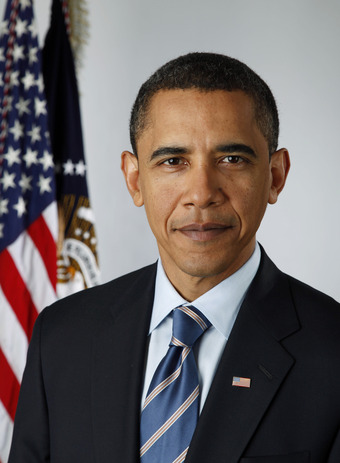
President Barack Obama
Official photographic portrait of US President Barack Obama (born 4 August 1961; assumed office 20 January 2009). Barack Obama’s presidential campaigns were successful partly as a result of youth participation.
Eligibility Criteria
In the United States, a person must be at least 35 to be President or Vice President, 30 to be a Senator, or 25 to be a Representative, as specified in the U.S. Constitution. Most states in the U.S. also have age requirements for the offices of Governor, State Senator, and State Representative. Some states have a minimum age requirement to hold any elected office (usually 21 or 18). Most states will not allow ballot access to people who do not meet the age requirement of the office they are running for.
Article II, Section 1, Clause 5 of the Constitution sets the requirements to hold office. A president must:
- be a natural-born citizen of the United States;
- be at least thirty-five years old;
- have been a permanent resident in the United States for at least fourteen years..
Vice-President of the United States
The vice president is the second-highest ranked executive official of the government. As first in the line of presidential succession in the U.S., the Vice President becomes President upon the death, resignation, or removal of the President. Transitions of this type have happened nine times in U.S. history.
Under the Constitution, the Vice President is President of the Senate. By virtue of this role, he or she is the head of the Senate. In that capacity, the Vice President is allowed to vote in the Senate, but only when necessary to break a tie vote. While the Vice President’s only constitutionally prescribed functions, aside from presidential succession, relate to his or her role as President of the Senate, the office is now commonly viewed as a member of the executive branch of the federal government. The current Vice President is Joseph Biden .
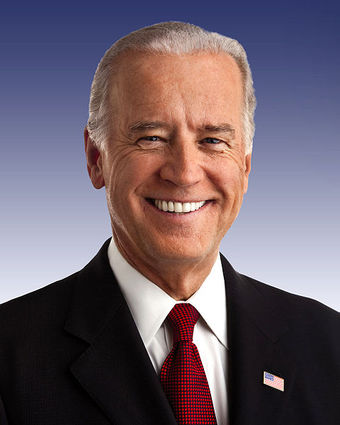
Official Portrait of Joe Biden
Official portrait of Vice President of the United States Joe Biden.
Cabinet of the United States
The Cabinet of the United States is composed of the most senior appointed officers of the executive branch of the federal government of the United States, who are generally the heads of the federal executive departments. All Cabinet officers are nominated by the President and then presented to the Senate for confirmation or rejection by a simple majority. If they are approved, they are sworn in and then begin their duties.
Aside from the Attorney General, and formerly the Postmaster General, they all receive the title of Secretary. Members of the Cabinet serve at the pleasure of the President, which means that the President may dismiss them or reappoint them (to other posts) at will. Positions in the Cabinet include Secretary of State, Secretary of Treasury, Secretary of Defense, Attorney General.
2.3.5: The Judicial Branch
Organized under the U.S. Constitution, the Supreme Court and federal courts make up the judiciary branch of the United States.
Learning Objective
Identify the different courts that comprise the Judicial Branch and their functions
Key Points
- The judiciary is the system of courts that interprets and applies the law in the name of the state. Under the doctrine of the separation of powers, the judiciary generally does not make law or enforce law, but rather interprets law and applies it to the facts of each case.
- The United States federal courts make up the judiciary branch of federal government of the United States. This branch includes the Supreme Court, the circuit courts, and federal courts.
- The Supreme Court of the United States is the highest court in the United States. It has ultimate appellate jurisdiction over all federal courts and state court cases involving issues of federal law.
- The Supreme Court consists of a chief justice and eight associate justices who are nominated by the President and confirmed by the United States Senate. Once appointed, justices have life tenure unless they resign, retire, or are removed after impeachment.
- The United States courts of appeals are the intermediate appellate courts of the United States federal court system. A court of appeals decides appeals from the district courts within its federal judicial circuit. There currently are thirteen United States courts of appeals.
- The United States district courts are the general trial courts of the United States federal court system. Both civil and criminal cases are filed in the district court. There is at least one judicial district for each state, the District of Columbia, and Puerto Rico.
Key Terms
- Supreme Court of the United States
-
The Supreme Court of the United States is the highest court in the United States. It has ultimate appellate jurisdiction over all federal courts and over state court cases involving issues of federal law.
- united states federal courts
-
The United States federal courts make up the judiciary branch of federal government of the United States. This includes the Supreme Court, the circuit courts, and the federal courts.
- court of appeals
-
A court of appeals decides appeals from the district courts within its federal judicial circuit. There currently are thirteen United States courts of appeals.
Example
- The nomination and confirmation of Supreme Court justices has increasingly become politicized. Before 1981, the approval process of justices was usually rapid. From the Truman through Nixon administrations, justices were typically approved within one month. From the Reagan administration through the present, the process has taken much longer. Some believe this is because Congress views justices as playing a more political role than in the past.
Introduction
The judiciary is the system of courts that interprets and applies the law in the name of the state. Under the doctrine of the separation of powers, the judiciary generally does not make law or enforce law, but rather it interprets law and applies it to the facts of each case. The judiciary also provides a mechanism for the resolution of disputes. The judiciary branch is often tasked with ensuring equal justice under law. It consists of a court of final appeal in addition to lower courts.
Judiciary Branch of the United States
The United States federal courts make up the judiciary branch of federal government. These courts are organized under the United States Constitution and laws of the federal government. In the United States court system, the Supreme Court is the final authority on the interpretation of the federal Constitution as well as the constitutionality of the various state laws. In the US federal court system, federal cases are tried in trial courts, known as the US district courts, followed by appellate courts and then the Supreme Court. State courts, which try 98% of litigation, are subject to the jurisdiction of each state. The judicial system begins with a court of first instance, is appealed to an appellate court, and then ends at the court of last resort.
Supreme Court of the United States
The U.S. Supreme Court is the highest court in the United States. It has ultimate appellate jurisdiction over all federal courts and over state court cases involving issues of federal law. It also has original jurisdiction over a small range of cases . The Court consists of a chief justice and eight associate justices who are nominated by the President and confirmed by the United States Senate. Once appointed, justices have life tenure unless they resign, retire, or are removed after impeachment.
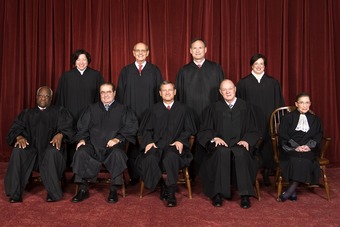
The U.S. Supreme Court
The United States Supreme Court, the highest court in the United States, in 2010. Top row (left to right): Associate Justice Sonia Sotomayor, Associate Justice Stephen G. Breyer, Associate Justice Samuel A. Alito, and Associate Justice Elena Kagan. Bottom row (left to right): Associate Justice Clarence Thomas, Associate Justice Antonin Scalia, Chief Justice John G. Roberts, Associate Justice Anthony Kennedy, and Associate Justice Ruth Bader Ginsburg.
Under the U.S. Constitution, the President of the United States appoints justices “by and with the advice and consent of the Senate. ” Most presidents nominate candidates who broadly share their ideological views, although a justice’s decisions may end up being contrary to a president’s expectations. Because the Constitution sets no qualifications for service as a justice, a president may nominate anyone to serve, subject to Senate confirmation.
Before 1981, the approval process of justices was usually rapid. From the Truman through Nixon administrations, justices were typically approved within one month. From the Reagan administration through the present, the process has taken much longer. Some believe this is because Congress views justices as playing a more political role than in the past.
United States Court of Appeals
The United States courts of appeals are the intermediate appellate courts of the United States federal court system . A court of appeals decides appeals from the district courts within its federal judicial circuit, and in some instances from other designated federal courts and administrative agencies. The United States Courts of Appeals are considered among the most powerful and influential courts in the United States. Because of their ability to set legal precedent in regions that cover millions of people, the United States Courts of Appeals have strong policy influence on U.S. law.

U.S Court of Appeals and District Courts map
Map of the geographic boundaries of the various United States Courts of Appeals and United States District Courts.
There currently are thirteen United States courts of appeals. The eleven “numbered” circuits and the D.C. Circuit are geographically defined. The thirteenth court of appeals is the United States Court of Appeals for the Federal Circuit, which has nationwide jurisdiction over certain appeals based on their subject matter. Currently, there are 179 judges on the United States Courts of Appeals authorized by Congress and Article III of the U.S. Constitution. These judges are nominated by the President of the United States, and if confirmed by the United States Senate, have lifetime tenure. They earn an annual salary of $184,500.
United States District Courts
The United States district courts are the general trial courts of the United States federal court system. Both civil and criminal cases are filed in the district court, which is a court of law, equity, and admiralty. There is a United States bankruptcy court associated with each United States district court. Each federal judicial district has at least one courthouse, and many districts have more than one. In contrast to the Supreme Court, which was established by Article III of the Constitution, the district courts were established by Congress. There is at least one judicial district for each state, the District of Columbia, and Puerto Rico. There are eighty-nine districts in the fifty states, with a total of ninety-four districts including territories.
2.3.6: Federalism
Federalism in the United States is the evolving relationship between U.S. state governments and the federal government of the United States.
Learning Objective
Summarize the history of federalism in the United States
Key Points
- Federalism refers to a system of government in which sovereignty is constitutionally divided between a central governing authority and constituent political units.
- Federalism in the United States is the evolving relationship between U.S. state governments and the federal government of the United States. Since the end of the American Civil War, power shifted away from the states and towards the national government.
- The Federalist Papers were a compilation of 85 anonymous essays published by Alexander Hamilton and James Madison to convince the people of the state to vote for ratification.
- The Tenth Amendment states the Constitution’s principle of federalism by providing that powers not granted to the federal government nor prohibited to the States by the Constitution are reserved to the States or the people.
- Dual federalism is a theory of federal constitutional law in the United States according to which governmental power is divided into two separate spheres. One sphere of power belongs to the federal government of the United States while the other severally belongs to each constituent state.
- New Federalism, which is characterized by a gradual return of power to the states, was initiated by President Ronald Reagan (1981–1989) with his “devolution revolution” in the early 1980s and lasted until 2001.
Key Terms
- dual federalism
-
Dual federalism is a theory of federal constitutional law in the United States according to which governmental power is divided into two separate spheres. One sphere of power belongs to the federal government of the United States while the other severally belongs to each constituent state.
- federalism
-
A political concept in which a group of members are bound together by covenant with a governing representative head.
- the tenth amendment
-
The Tenth Amendment states the Constitution’s principle of federalism by providing that powers not granted to the federal government nor prohibited to the States by the Constitution are reserved to the States or the people.
Example
- As part of New Federalism, the Reagan administration introduced a practice of giving block grants, freeing state governments to spend the money at their own discretion.
Introduction
Federalism is a political concept in which a group of members are bound together by covenant with a governing representative head. The term “federalism” is also used to describe a system of government in which sovereignty is constitutionally divided between a central governing authority and constituent political units. Federalism is a system based upon democratic rules and institutions in which the power to govern is shared between national and state governments, creating what is often called a federation. Proponents are often called federalists.

Federalism around the World
A map showing countries currently organized along federalist principles in green.
History of Federalism in the United States
Federalism in the United States is the evolving relationship between U.S. state governments and the federal government of the United States. Since the founding of the country, and particularly with the end of the American Civil War, power shifted away from the states and toward the national government.

Federalism in the United States
The United States is composed of fifty self-governing states and several territories.
Originally, federalism was the most influential political movement arising out of discontent with the Articles of Confederation, which focused on limiting the authority of the federal government. In 1787, fifty-five delegates met at a Constitutional convention in Philadelphia and generated ideas for a bicameral legislature, balanced representation of small and large states, and checks and balances. Once the convention concluded and released the Constitution for public consumption, the Federalist movement became focused on getting the Constitution ratified.
The most forceful defense of the new Constitution was The Federalist Papers, a compilation of eighty-five anonymous essays published in New York City to convince the people of the state to vote for ratification. These articles, written by Alexander Hamilton and James Madison, with some contributed by John Jay, examined the benefits of the new, proposed Constitution, and analyzed the political theory and function behind the various articles of the Constitution. The Federalist Papers remains one of the most important documents in American political science.
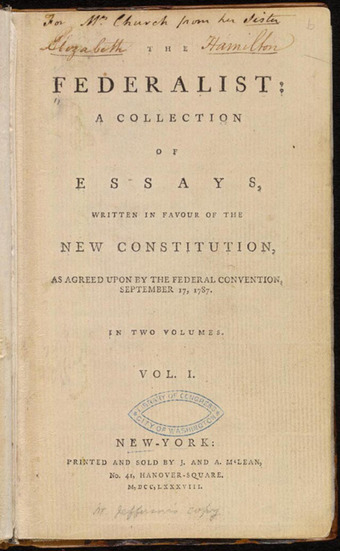
The Federalist Papers
Title page of the first printing of the Federalist Papers.
In 1789, Congress submitted twelve articles of amendment to the states. Ten of these articles, written by Madison, achieved passage on December 15, 1791 and became the Bill of Rights. The Tenth Amendment set the guidelines for federalism in the United States. The Tenth Amendment states the Constitution’s principle of federalism by providing that powers not granted to the federal government nor prohibited to the States by the Constitution are reserved to the States or the people.
Dual Federalism, Cooperative Federalism and New Federalism
Dual federalism is a theory of federal constitutional law in the United States according to which governmental power is divided into two separate spheres. One sphere of power belongs to the federal government of the United States while the other severally belongs to each constituent state. Each sphere is mutually equal, exclusive, and limiting upon the other sphere, and each entity is supreme within its own sphere. The theory originated within the Jacksonian democracy movement as backlash against the mercantilist American System and supported centralization of government under the Adams administration during the 1820s. With an emphasis on local autonomy and individual liberty, the theory served to unite the principles held by multiple sectional interests: the republican principles of northerners, the pro-slavery ideology of southern planters, and the laissez-faire entrepreneurialism of western interests.
The Great Depression marked an abrupt end to Dual Federalism and a dramatic shift to a strong national government. President Franklin D. Roosevelt’s New Deal policies reached into the lives of U.S. citizens like no other federal measure had. The national government was forced to cooperate with all levels of government to implement the New Deal policies; local government earned an equal standing with the other layers, as the federal government relied on political machines at a city level to bypass state legislatures. This became known as Cooperative Federalism.
Another movement calling itself “New Federalism” appeared in the late 20th century and early 21st century. New Federalism, which is characterized by a gradual return of power to the states, was initiated by President Ronald Reagan (1981–1989) with his “devolution revolution” in the early 1980s and lasted until 2001. . Previously, the federal government had granted money to the states categorically, limiting the states to use this funding for specific programs. Reagan’s administration, however, introduced a practice of giving block grants, freeing state governments to spend the money at their own discretion. New Federalism is sometimes called “states’ rights”, although its proponents usually eschew the latter term because of its associations with Jim Crow and segregation.
2.3.7: Constitutional Limits
The United States adheres to the principles of a constitutionally limited government in the three branches of government.
Learning Objective
Compare and contrast the variation of constitutional limits in democracies across the world
Key Points
- A constitutionally limited government is a system of government that is bound to certain principles of action by a state constitution.
- In the United States Constitution, several articles and sections describe and specify the limits set upon the federal and state governments in the Union.
- The Supreme Court has developed a system of doctrine and practice that self-limits is power of judicial review. The Court controls almost all of its business by choosing what cases to consider, writs of certiorari.
- Codified constitutions are often the product of some dramatic political change, such as a revolution. States that have codified constitutions normally give the constitution supremacy over ordinary statute law.
- Uncodified constitutions are the product of an “evolution” of laws and conventions over centuries. Examples of uncodified constitutions include England and New Zealand.
Key Terms
- twenty-fifth amendment
-
The Twenty-fifth Amendment (Amendment XXV) to the United States Constitution deals with succession to the Presidency and establishes procedures both for filling a vacancy in the office of the Vice President, as well as responding to Presidential disabilities.
- writs of certiorari
-
In the United States, the writ of certiorari is most often seen as the writ that the Supreme Court of the United States issues to a lower court to review the lower court’s judgment for legal error (reversible error) and review where no appeal is available as a matter of right.
- constitutionally limited government
-
A constitutionally limited government is a system of government that is bound to certain principles of action by a state constitution. The United States of America, a constitutionally limited republic, is an example of a constitutionally limited government.
Example
- Section 2 grants and limits the president’s appointment powers. For example, “The president may make treaties, with the advice and consent of the Senate, provided two-thirds of the senators who are present agree”; “With the advice and consent of the Senate, the President may appoint ambassadors, other public ministers and consuls, judges of the Supreme Court, and all other officers of the United States whose appointments are not otherwise described in the Constitution. “
Introduction
A constitutionally limited government is a system of government that is bound to certain principles of action by a state constitution. This system of government is dialectically opposed to pragmatism, on the basis that no state action can be made that conflicts with its constitution, regardless of the action’s possible consequences. An example of a constitutionally limited government is the United States of America, which is a constitutionally limited republic. Correspondingly, constitutionalism has a variety of meanings. Most generally, it is “a complex of ideas, attitudes, and patterns of behavior elaborating the principle that the authority of government derives from and is limited by a body of fundamental law.” In the United States Constitution , several articles and sections describe and specify the limits set upon the federal and state governments in the Union.
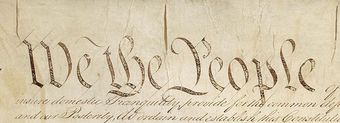
United States Constitution
“We the People”, as it appears in an original copy of the Constitution.
Legislature
Article I, Section 9 lists eight specific limits on congressional power. It includes sections such as “No Capitation, or other direct, Tax shall be laid, unless in Proportion to the Census or Enumeration herein before directed to be taken” and “No Title of Nobility shall be granted by the United States: And no Person holding any Office of Profit or Trust under them, shall, without the Consent of the Congress, accept of any present, Emolument, Office, or Title, of any kind whatever, from any King, Prince, or foreign State. “
Executive
Article II, Section 1 creates the presidency. The section vests the executive power in a President. The President and Vice President serve identical four-year terms. This section originally set the method of electing the President and Vice President, but this method has been superseded by the Twelfth Amendment. More importantly, Section 2 grants and limits the president’s appointment powers: “The president may make treaties, with the advice and consent of the Senate, provided two-thirds of the senators who are present agree;” “With the advice and consent of the Senate, the President may appoint ambassadors, other public ministers and consuls, judges of the Supreme Court, and all other officers of the United States whose appointments are not otherwise described in the Constitution;” and “Congress may give the power to appoint lower officers to the President alone, to the courts, or to the heads of departments. ” In addition, the Twenty-fifth Amendment limits the presidency to two terms .
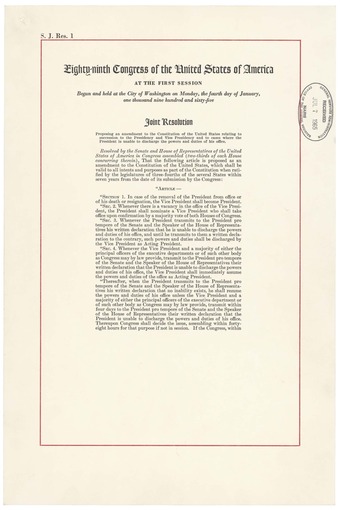
Twenty-Fifth Amendment
Joint Resolution Proposing the Twenty-fifth Amendment to the United States Constitution, page 1.
Self Restraint
The Supreme Court has developed a system of doctrine and practice that self-limits is power of judicial review. The Court controls almost all of its business by choosing what cases to consider, writs of certiorari. In this way it can avoid expressing an opinion if it sees an issue is currently embarrassing or difficult. The Supreme Court limits itself by defining for itself what is a “justiciable question. ” First, the Court is fairly consistent in refusing to make any “advisory opinions” in advance of actual cases. Second, “friendly suits” between those of the same legal interest are not considered. Third, the Court requires a “personal interest,” not one generally held, and a legally protected right must be immediately threatened by government action. Cases are not taken up if the litigant has no standing to sue. Having the money to sue or being injured by government action alone are not enough.
Codified and Uncodified Constitutions
A constitution is a set of fundamental principles or established precedents according to which a state or other organization is governed. These rules together make up, i.e. constitute, what the entity is. When these principles are written down into a single document or set of legal documents, those documents may be said to embody a written constitution; if they are written down in a single comprehensive document, it is said to embody a codified constitution.
Codified constitutions are often the product of some dramatic political change, such as a revolution. States that have codified constitutions normally give the constitution supremacy over ordinary statute law. Some constitutions are largely, but not wholly, codified. As of 2013, only two sovereign states have uncodified constitutions, namely New Zealand and the United Kingdom. Uncodified constitutions are the product of an “evolution” of laws and conventions over centuries. By contrast to codified constitutions (in the Westminster System that originated in England), uncodified constitutions include written sources.
2.3.8: Limited Government
In a limited government, the power of government to intervene in the exercise of civil liberties is restricted by constitutional law.
Learning Objective
Describe the particular species of limited government operative in the United States’ federal system.
Key Points
- Limited government is a principle of classical liberalism, free market libertarianism, and some tendencies of liberalism and conservatism in the United States.
- A constitutionally limited government is a system of government that is bound to certain principles of action by a state constitution. The United States of America, a constitutionally limited republic, is an example of a constitutionally limited government.
- In the United States, the idea of limited government originally implied the notion of a separation of powers and the system of checks and balances promoted by the U.S. Constitution.
- As part of the Bill of the Rights, the Ninth Amendment and the Tenth Amendment summarily spelled out the principle of limited government. Together, these amendments clarify the differences between the enumerated rights of the people versus the expressly delegated powers of the federal government.
- The Ninth Amendment codified that the rights of the people do not have to be expressly written in the Constitution to still be retained by the people. The Tenth Amendment codified that any delegated powers of the federal government are expressly delegated specifically by the Constitution.
- “Limited government” stands in contrast to the doctrine of the Divine Right of Kings. Under that doctrine, the king, and by extension his entire government, held unlimited sovereignty over its subjects. Limited government exists where some effective limits restrict governmental power.
Key Terms
- constitutionally limited government
-
A constitutionally limited government is a system of government that is bound to certain principles of action by a state constitution. The United States of America, a constitutionally limited republic, is an example of a constitutionally limited government.
- limited government
-
In a limited government, the power of government to intervene in the exercise of civil liberties is restricted by law, usually in a written constitution. It is a principle of classical liberalism, free market libertarianism, and some tendencies of liberalism and conservatism in the United States.
- divine right of kings
-
A political and religious doctrine of royal and political legitimacy that asserts that a monarch is subject to no earthly authority, deriving the right to rule directly from the will of God.
Example
- In Western civilization, the Magna Carta stands as the early exemplar of a document limiting the reach of the king’s sovereignty. While its limits protected only a small portion of the English population, it did state that the king’s barons possessed rights that they could assert against the king. In contrast, the United States Constitution of 1787 created a government limited by the terms of the written document itself, by the election of the legislators and the executive by the people, and by the checks and balances through which the three branches of government limit each other’s power.
Introduction
In a limited government, the power of government to intervene in the exercise of civil liberties is restricted by law, usually in a written constitution. It is a principle of classical liberalism, free market libertarianism, and some tendencies of liberalism and conservatism in the United States. The theory of limited government contrasts, for example, with the idea that government should intervene to promote equality and opportunity through regulation of property and wealth redistribution.
Limited Government in the United States
A constitutionally limited government is a system of government that is bound to certain principles of action by a state constitution. This system of government is dialectically opposed to pragmatism, on the basis that no state action can be made that conflicts with its constitution, regardless of the action’s possible consequence. The United States of America, a constitutionally limited republic, is an example of a constitutionally limited government.
In the United States, as discussed in the Federalist Papers , the idea of limited government originally implied the notion of a separation of powers and the system of checks and balances promoted by the U.S. Constitution. This understanding of limited government maintains that government is internally limited by the system of checks and balances (as well as the Constitution itself, which can be amended), and externally through the republican principle of electoral accountability. Such an understanding of limited government, as explained by James Madison, does not place arbitrary and ideologically biased parameters on the actions of a government, thus allowing government to change as time demands.
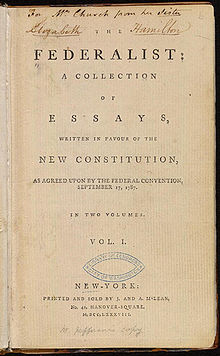
The Federalist Papers
Title page of the first printing of the Federalist Papers.
Ninth and Tenth Amendments
In 1789, James Madison presented to the First United States Congress a series of ten amendments to the United States Constitution, today known as the Bill of Rights . After enumerating specific rights retained by the people in the first eight amendments, the Ninth Amendment and the Tenth Amendment summarily spelled out the principle of limited government. Together, these two last amendments clarify the differences between the enumerated rights of the people versus the expressly codified delegated powers of the federal government. The Ninth Amendment codified that the rights of the people do not have to be expressly written in the Constitution to still be retained by the people. Reversely, though, the Tenth Amendment codified that any delegated powers of the federal government are only authorized to be performed so long as such delegated powers are expressly delegated to the federal government specifically by the Constitution. Government can do some things and not others.
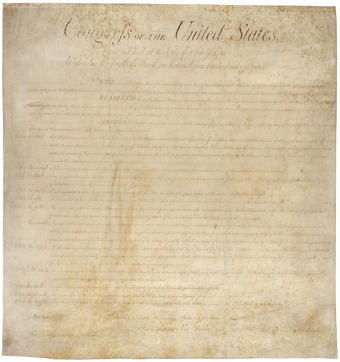
Bill of Rights
The First Amendment rights of free speech, freedom of association, and freedom of petition protect lobbying, including grassroots lobbying.
The Constitution limits the power of the government in several ways. It prohibits the government from directly interfering with certain key areas: conscience, expression, and association. Other actions are forbidden to the federal government and are reserved to state or local governments.
Differences with Other Doctrines
“Limited government” stands in contrast to the doctrine of the Divine Right of Kings, which states that the king, and by extension his entire government, held unlimited sovereignty over its subjects. Limited government exists where some effective limits restrict governmental power.
In Western civilization, the Magna Carta stands as the early exemplar of a document limiting the reach of the king’s sovereignty. While its limits protected only a small portion of the English population, it did state that the king’s barons possessed rights that they could assert against the king. The English Bill of Rights, associated with the Glorious Revolution of 1688, established limits of royal sovereignty. In contrast, and as stated above, the United States Constitution of 1787 created a government limited by the terms of the written document itself, by the election of the legislators and the executive by the people, and by the checks and balances through which the three branches of government limit each other’s power.
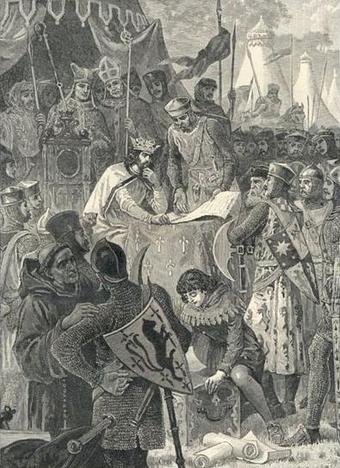
John of England signs Magna Carta, published ca. 1902
John of England signs Magna Carta. Illustration from Cassell’s History of England (1902).
2.3.9: Separation of Powers
Separation of powers is a doctrine in which each of the three branches of government have defined powers independent of each other.
Learning Objective
Compare and contrast the three branches of government
Key Points
- Separation of powers is a political doctrine originating in the writings of Montesquieu in The Spirit of the Laws in which he urges for a constitutional government with three separate branches of government.
- Congress has the sole power to legislate for the United States. Under the nondelegation doctrine, Congress may not delegate its lawmaking responsibilities to any other agency.
- The Constitution empowers the president to ensure the faithful execution of the laws made by Congress. Congress may itself terminate such appointments by impeachment, and restrict the president.
- Judicial power—the power to decide cases and controversies—is vested in the Supreme Court and inferior courts established by Congress. The judges must be appointed by the president with the advice and consent of the Senate.
Key Terms
- judicial power
-
Judicial power—the power to decide cases and controversies—is vested in the Supreme Court and inferior courts established by Congress.
- separation of powers
-
A theoretical model for governance, common in democratic states, which features the division of sovereign power into at least three (but sometimes up to six) organs of state in order to forestall tyranny, by preventing the acquisition of a monopoly of power by a monarch or oligarchy.
Example
- The president’s responsibility is to execute instructions given by the Congress. Bodies such as the War Claims Commission, the Interstate Commerce Commission, and the Federal Trade Commission all have direct Congressional oversight.
Introduction
Separation of powers is a political doctrine originating from the writings of Montesquieu in The Spirit of the Laws in which he urges for a constitutional government with three separate branches of government . Each of the three branches would have defined powers to check the powers of the other branches. This idea was called separation of powers. This philosophy heavily influenced the writing of the United States Constitution, according to which the legislative, executive, and judicial branches of the United States government are kept distinct in order to prevent abuse of power. This United States form of separation of powers is associated with a system of checks and balances.
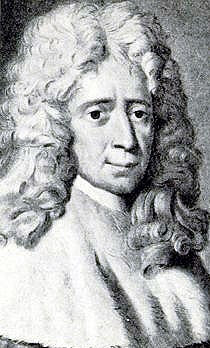
Montesquieu
Charles de Secondat, Baron de Montesquieu, who urged for a constitutional government with three separate branches of government.
Legislative Power
Congress has the sole power to legislate in the United States. Under the nondelegation doctrine, Congress may not delegate its lawmaking responsibilities to any other agency. One of the earliest cases involving the exact limits of non-delegation was Wayman v. Southard (1825). Congress had delegated to the courts the power to prescribe judicial procedure, and it was contended that in doing so Congress had unconstitutionally clothed the judiciary with legislative powers. While Chief Justice John Marshall conceded that the determination of rules of procedure was a legislative function, he distinguished between “important” subjects and mere details . Marshall wrote that “a general provision may be made, and power given to those who are to act under such general provisions, to fill up the details. “
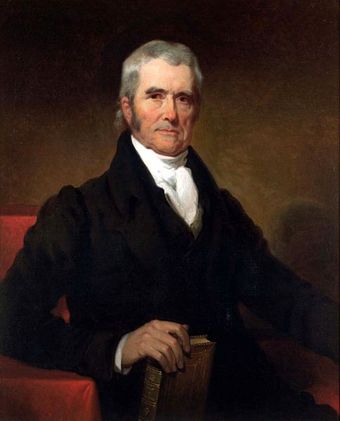
Portrait of John Marshall by Henry Inman (1832)
Henry Inman painted his original portrait of Chief Justice John Marshall in September 1831, when the jurist sat for Inman in Philadelphia. This painting is a copy of Inman’s original that he made in 1832 for an engraver. John Marshall bought the painting for his daughter who passed it to her daughters. Marshall’s granddaughters lent the portrait to the Virginia State Library in 1874 and the surviving granddaughter bequeathed it to the Library in 1920.
Executive Power
Executive power is vested, with exceptions and qualifications, in the President. By law, the president becomes the Commander in Chief of the Army, Navy, and Militia of several states when called into service, and has power to make treaties and appointments to office. The Constitution empowers the president to ensure the faithful execution of the laws made by Congress. Congress may terminate such appointments by impeachment, and restrict the president . The president’s responsibility is to execute instructions given by Congress. Bodies such as the War Claims Commission, the Interstate Commerce Commission, and the Federal Trade Commission all have direct Congressional oversight.
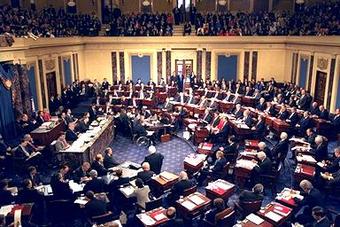
The impeachment trial of President Clinton
Floor proceedings of the U.S. Senate, in session during the impeachment trial of Bill Clinton.
Judicial Power
Judicial power—the power to decide cases and controversies—is vested in the Supreme Court and inferior courts established by Congress. The judges must be appointed by the president with the advice and consent of the Senate, hold office during good behavior, and receive compensations that may not be diminished during their continuance in office. If a court’s judges do not have such attributes, the court may not exercise the judicial power of the United States. Courts exercising the judicial power are called “constitutional courts. “
Alternative Model: The Parliamentary System
In a parliamentary system, the head of state is normally a different person from the head of government. This is in contrast to a presidential system in a democracy, where the head of state often is also the head of government, and most importantly: the executive branch does not derive its democratic legitimacy from the legislature. The Parliamentary system can be contrasted with a presidential system which operates under a stricter separation of powers, whereby the executive does not form part of, nor is appointed by, the parliamentary or legislative body. In such a system, congresses do not select or dismiss heads of governments, and governments cannot request an early dissolution as may be the case for parliaments. Since the legislative branch has more power over the executive branch in a parliamentary system, a notable amount of studies by political scientists have shown that parliamentary systems show lower levels of corruption than presidential systems of government.
2.3.10: Checks and Balances
To get the three branches of government to cooperate, a system of checks and balances was created to achieve a fair separation of powers.
Learning Objective
Discuss the details of the Constitution’s system of checks and balances
Key Points
- The concept of checks and balances is traced back to the political theory of Montesquieu.
- The legislative branch of the United States checks and monitors the other two branches of government, the executive and judicial, through broad taxing and spending power, budgetting, declaration of war, ratification of treaties and confirmation of judges.
- The President exercises a check over Congress through his power to veto bills. The president also appoints judges with the Senate’s advice and consent. He also has the power to issue pardons and reprieves, and as a Commander in Chief has the authority to command the U.S. armed forces.
- Judicial review in the United States refers to the power of a court to review the constitutionality of a statute or treaty, or to review an administrative regulation for consistency with either a statute, a treaty, or the Constitution itself.
Key Terms
- Judicial Review
-
Judicial review refers to the power of a court to review the constitutionality of a statute or treaty or to review an administrative regulation for consistency with a statute, a treaty, or the Constitution itself.
- veto
-
A political right to disapprove of (and thereby stop) the process of a decision, a law, etc.
- checks and balances
-
A system for multiple parties wherein each has some control over the actions of each of the others.
Example
- Many pardons have been controversial. Critics argue that pardons have been used more often for the sake of political expediency than to correct judicial error. One of the more famous recent pardons was granted by President Gerald Ford to former President Richard Nixon on September 8, 1974, for official misconduct which gave rise to the Watergate scandal. Polls showed a majority of Americans disapproved of the pardon, and Ford’s public-approval ratings tumbled afterward.
Introduction
To prevent one branch of government from becoming too powerful, protect the minority from the majority, and induce the branches to cooperate, governments often employ a system of “checks and balances. ” Like the concept of separation of powers, this idea is credited to Montesquieu. Through this system, each branch of government “checks,” or limits, the other two so that the power shared between them is balanced. An example of this is the president’s veto power: the president can limit Congress’s power by vetoing a bill. However, the legislative branch can overturn this veto with a two-thirds majority in both of the houses, thus maintaining the balance.
Legislative
The legislative branch of the United States checks and monitors the executive and judicial branches. The legislative passes bills, has broad taxing and spending power, controls the federal budget, and has power to borrow money on the credit of the United States. It has sole power to declare war, as well as to raise, support, and regulate the military. Further, the legislative branch is responsible for the ratification of treaties signed by the President and gives advice and consent to presidential appointments to the federal judiciary, federal executive departments, and other posts (Senate only). Lastly, the legislative has sole power of impeachment (House of Representatives) and trial of impeachments (Senate); it can also remove federal executive and judicial officers from office for high crimes and misdemeanors.
Executive
The President exercises a check over Congress through his power to veto bills, but Congress may override any veto by a two-thirds majority in each house. When the two houses of Congress cannot agree on a date for adjournment, the president may settle the dispute. Either house or both houses may be called into emergency session by the president. The Vice President serves as president of the Senate, but he may only vote to break a tie.
The president, as noted above, appoints judges with the Senate’s advice and consent. He also has the power to issue pardons and reprieves. Such pardons are not subject to confirmation by either the House of Representatives or the Senate, or even to acceptance by the recipient. Many pardons have been controversial. Critics argue that pardons have been used more often for the sake of political expediency than to correct judicial error. One of the more famous recent pardons was granted by President Gerald Ford to former President Richard Nixon on September 8, 1974, for official misconduct that gave rise to the Watergate scandal . Polls showed a majority of Americans disapproved of the pardon, and Ford’s public-approval ratings tumbled afterward.
The President is the civilian Commander in Chief of the Army and Navy of the United States. It is generally understood that he has the authority to command them to take appropriate military action in the event of a sudden crisis. However, only the Congress is explicitly granted the power to declare war, as well as to raise, fund, and maintain the armed forces. Congress also has the duty and authority to prescribe the laws and regulations under which the armed forces operate, such as the Uniform Code of Military Justice, and requires that all Generals and Admirals appointed by the president be confirmed by a majority vote of the Senate before they can assume their office.
Judiciary
Courts check both the executive branch and the legislative branch through judicial review. This concept is not written into the Constitution, but was envisioned by many of the Constitution’s Framers. Judicial review in the United States refers to the power of a court to review the constitutionality of a statute or treaty, or to review an administrative regulation for consistency with either a statute, a treaty, or the Constitution itself. The Supreme Court’s landmark decision on the issue of judicial review was Marbury v. Madison (1803, ), in which the Supreme Court ruled that the federal courts have the duty to review the constitutionality of acts of Congress and to declare them void when they are contrary to the Constitution. Marbury, written by Chief Justice John Marshall, was the first Supreme Court case to strike down an act of Congress as unconstitutional. Since that time, the federal courts have exercised the power of judicial review.
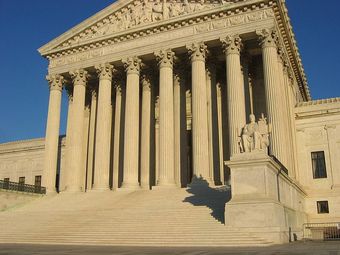
Supreme Court
The Supreme Court holds the power to overturn laws and executive actions they deem unlawful or unconstitutional.
The judiciary also has involvement in the impeachment process of a president. The Chief Justice presides in the Senate during a president’s impeachment trial. The rules of the Senate, however, generally do not grant much authority to the presiding officer. Thus, the Chief Justice’s role in this regard is limited.
2.4: Ratification of the Constitution
2.4.1: Federalists and Antifederalists
While the Constitutional Convention was held to revise the Articles of Confederation, an entirely new constitution was drafted.
Learning Objective
Explain the arguments made by the Federalists and Anti-Federalists over the new U.S. Constitution
Key Points
- A Constitutional Convention was called in the summer of 1787 to change the Articles of Confederation. During this time, many compromises were formed to appease regional factions.
- The Great Compromise brought together the New Jersey Plan and the Virginia Plan to create the Constitution’s legislative system. The Three-Fifths Compromise appeased Southern representatives by allowing them to count slaves for representation and taxation purposes.
- The Federalists wanted a strong government and strong executive branch, while the anti-Federalists wanted a weaker central government.
- The Federalists did not want a bill of rights—they thought the new constitution was sufficient. The anti-federalists demanded a bill of rights.
Key Terms
- Three-Fifths Compromise
-
an agreement between Southern and Northern states reached during the Philadelphia Convention of 1787, in which three-fifths of the population of freed slaves would be counted for representation purposes regarding both the distribution of taxes and the apportionment of the members of the United States House of Representatives
- Articles of Confederation
-
The Articles of Confederation, formally the Articles of Confederation and Perpetual Union, was an agreement among the thirteen founding states that established the United States of America as a confederation of sovereign states and served as its first constitution.
- delegate
-
A person authorized to act as representative for another; in politics, a party representative allocated to nominate a party candidate.
The Constitutional Convention
In 1787, a convention was called in Philadelphia with the declared purpose of revising the Articles of Confederation. However, many delegates intended to use this convention to draft a new constitution. All states except for Rhode Island sent delegates, though not all delegates attended the Convention. At the Convention, the primary issue was representation of the states. Under the Articles, each state had one vote in Congress. The more populous states wanted representation to be based on population (proportional representation). James Madison of Virginia crafted the Virginia Plan, which guaranteed proportional representation and granted wide powers to the Congress. The smaller states, on the other hand, supported equal representation through William Paterson’s New Jersey Plan. The New Jersey Plan also increased the Congress’ power, but it did not go nearly as far as the Virginia Plan. The conflict threatened to end the Convention, but Roger Sherman of Connecticut proposed the “Great Compromise” (or Connecticut Compromise) under which one house of Congress would be based on proportional representation, and the other house would be based on equal representation. Eventually, the Compromise was accepted, and the Convention was saved.
Compromises were important in settling other disputes at the Convention. The Three-Fifths Compromise designated that three-fifths of slave population would be counted toward representation in Congress. In another compromise, the Congress agreed to ban slave trade after 1808. Similarly, issues relating to the empowerment and election of the President were resolved. This led to the Electoral College system in choosing the Chief Executive of the nation.
Federalists vs. Anti-federalists
The Constitution required ratification by nine states in order to come into effect. The fight for ratification was long and difficult. The Constitution was to be ratified by special ratifying conventions, not by state legislature. Interested in retaining power, states were resistant to ratifying a new, stronger central government. Those who favored ratification were known as Federalists,while those who opposed it were considered Anti- Federalists.The Federalists attacked the weaknesses of the Articles of Confederation. On the other hand, the Anti-Federalists also supported a House of Representative with substantive power. They acknowledged that the Constitution was not perfect, but they said that it was much better than any other proposal. Three Federalists—Alexander Hamilton , James Madison, and John Jay—wrote a series of essays called The Federalist Papers. These essays explained the Constitution and defended its provisions. The documents were intended for the state of New York, though people from across the country read them. The Federalists defended the weakest point of the Constitution—a lack of a Bill of Rights—by suggesting that current protections were sufficient and that the Congress could always propose Amendments. Anti-Federalists such as Patrick Henry attacked the Constitution, suggesting that it would lead to a dangerously powerful national government. One of the Anti-Federalist’s strongest arguments was the Constitution’s lack of a Bill of Rights. Many Anti-Federalists were eventually persuaded by the Federalists’ arguments.
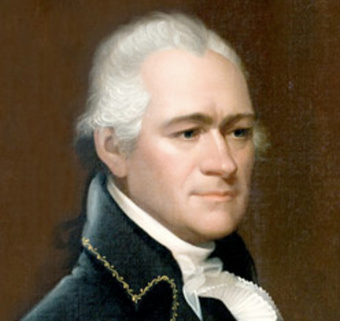
Alexander Hamilton
Alexander Hamilton was a key player at the Constitutional Convention.
2.4.2: The Federalist Papers
The Federalist Papers were written between 1788-9 and encouraged people to ask their representatives to ratify the Constitution.
Learning Objective
Identify the three authors of, the individual papers in, and the principal reasons behind the Federalist Papers.
Key Points
- Federalist Paper No. 10 said that the Constitution had a check and balance system so that no branch of government dominated the other.
- Federalist no. 51 said that a government like the U.S. naturally prevented factions from forming, thus protecting the peoples’–not the government’s–interests.
- The Anti-Federalists had several complaints with the Constitution. One of their biggest was that the Constitution did not provide for a Bill of Rights protecting the people.
Key Terms
- Alexander Hamilton
-
Alexander Hamilton (January 11, 1755 or 1757[1] – July 12, 1804) was a Founding Father,[2] soldier, economist, and political philosopher, one of America’s first constitutional lawyers and the first United States Secretary of the Treasury.
- Federalist Papers
-
The Federalist Papers are a series of 85 articles or essays promoting the ratification of the United States Constitution written by Alexander Hamilton, James Madison, and John Jay.
- James Madison
-
James Madison, Jr. (March 16, 1751 (O.S. March 5) – June 28, 1836) was an American statesman and political theorist, the fourth President of the United States (1809–1817). He is hailed as the “Father of the Constitution” for being instrumental in the drafting of the United States Constitution and as the key champion and author of the United States Bill of Rights.
- federalist
-
statesman or public figure supporting the proposed Constitution of the United States between 1787 and 1789
The Federalist Papers
During 1788 and 1789, there were 85 essays published in several New York State newspapers, designed to convince New York and Virginia voters to ratify the Constitution. The three people who are generally acknowledged for writing these essays are Alexander Hamilton, James Madison, and John Jay. Since Hamilton, Madison, and Jay were considered Federalists, this series of essays became known as The Federalist Papers. One of the most famous Federalist Papers is Federalist No. 10, which was written by Madison and argues that the checks and balances in the Constitution prevent the government from falling victim to factions. Anti-Federalists did not support ratification. Madison also wrote Federalist No. 51, under the name “Publius” or “Public. ” He argues here that each branch of government would not be dependent on other branches and, thus, forming factions within the national government. That way, the government can work in the best interests of the people and not each other.
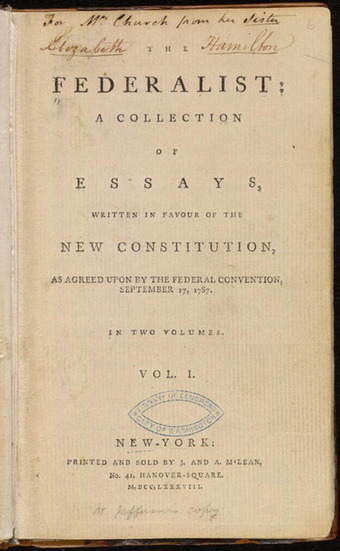
The Federalist Papers
Title page of the first printing of the Federalist Papers.
Many individuals, such as Patrick Henry, George Mason, and Richard Henry Lee, were Anti-Federalists. The Anti-Federalists had several complaints with the Constitution. One of their biggest was that the Constitution did not provide for a Bill of Rights protecting the people. They also thought the Constitution gave too much power to the federal government and too little to individual states. A third complaint of the Anti-Federalists was that senators and the president were not directly elected by the people, and the House of Representatives was elected every two years instead of annually. On December 7, 1787, Delaware was the first state to ratify the Constitution. The vote was unanimous, 30-0. Pennsylvania followed on December 12, and New Jersey ratified on December 18, also in a unanimous vote. By summer 1788, Georgia, Connecticut, Massachusetts, Maryland, South Carolina, New Hampshire, Virginia, and New York had ratified the Constitution, and it went into effect. On August 2, 1788, North Carolina refused to ratify the Constitution without amendments, but it relented and ratified it a year later.
2.4.3: Ratification of the Constitution
In order for all states to ratify, a compromise over a bill of rights had to be made.
Learning Objective
Discuss differences among the states on the question of ratifying the Constitution
Key Points
- Beginning with Delaware, many states ratified the new constitution Between 1787 and 1788. Some ratified because they were promised a bill of rights.
- All states except North Carolina ratified the new document and the Constitution went in effect by 1788. North Carolina demanded a bill of rights before ratifying it.
- On December 15, 1791, the Bill of Rights was added and listed natural liberties that the people had which could not be taken away by the federal government.
Key Terms
- Bill of Rights
-
The collective name for the first ten amendments to the United States Constitution.
- ratify
-
To give formal consent to; make officially valid.
Ratification of the Constitution
Delaware was the first state to ratify the Constitution on December 7, 1787. The vote was unanimous, 30-0. Pennsylvania followed on December 12 and New Jersey ratified on December 18, also in a unanimous vote. The Constitution went into effect by the summer of 1788 after the following states had ratified the Constitution: Georgia, Connecticut, Massachusetts, Maryland, South Carolina, New Hampshire, Virginia, and New York.
On August 2, 1788, North Carolina refused to ratify the Constitution without amendments, but relented and ratified it a year later. North Carolina was not the only state that wanted amendments. New York and Virginia ratified the Constitution under the condition that a Bill of Rights be added. On September 26, 1789, Congress sent a list of twelve amendments to the states for ratification. Ten of the amendments would become the Bill of Rights.
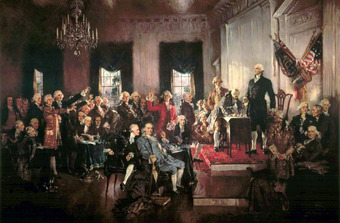
Congress of Confederation and the Constitution
The signing of the Constitution of the United States.
North Carolina ratified the Constitution in November of 1789, followed by Rhode Island in May 1790. Vermont became the last state to ratify the Constitution on January 10, 1791.
The Bill of Rights
The Bill of Rights was enacted on December 15, 1791. Here is a summary of the ten amendments ratified on that day:
- Amendment 1: Establishes freedom of religion, speech, the press, assembly, and petition.
- Amendment 2: Establishes the right to keep and bear arms.
- Amendment 3: Bans the forced quartering of soldiers.
- Amendment 4: Interdiction of unreasonable searches and seizures; a search warrant is required to search persons or property.
- Amendment 5: Details the concepts of indictments, due process, self-incrimination, double jeopardy, and rules for eminent domain.
- Amendment 6: Establishes rights to a fair and speedy public trial, to a notice of accusations, to confront the accuser, to subpoenas, and to counsel.
- Amendment 7: Provides for the right to trial by jury in civil cases.
- Amendment 8: Bans cruel and unusual punishment, and excessive fines or bail.
- Amendment 9: Lists unremunerated rights.
- Amendment 10: Limits the powers of the federal government to only those specifically granted by the constitution.
2.5: Amending the Constitution
2.5.1: Amending the Constitution
To protect the Constitution from hasty alteration, the framers of the Constitution wrote Article V.
Learning Objective
Describe the process for amending the Constitution
Key Points
- Article V specified how to amend the Constitution, showing that the Constitution could adapt to changing conditions with an understanding that such changes required deliberation.
- States or the federal government can propose a new amendment to the Constitution either through state conventions or a two-thirds majority vote in both the House and the Senate.
- To ratify an amendment to the Constitution, three-fourths of state legislatures or three-fourths of special state conventions must approve it.
- Article V establishes that no amendment that effects the representation of a state may be passed without that state’s consent.
Key Terms
- Article V of the US Constitution
-
The process whereby the Constitution may be altered. Altering the Constitution consists of proposing an amendment or amendments and subsequent ratification.
- Great Compromise
-
An agreement reached during the Constitutional Convention of 1787 that in part defined the legislative structure and representation that each state would have under the US Constitution. It called for a bicameral legislature, along with proportional representation in the lower house, but required the upper house to be weighted equally between the states.
- Article III
-
the section of the United States Constitution establishes the judicial branch of the federal government
- amendment
-
An addition to and/or alteration to the Constitution.
Article V of the US Constitution
The Articles of Confederation made amending the law very difficult, as all states had to agree to an amendment before it could pass. A unanimous vote had the potential to completely stall crucial change. However, the Framers of the Constitution worried that too many changes would harm the democratic process. To protect the Constitution from hasty alteration, the framers wrote Article V . This article specified how to amend the Constitution, showing that the Constitution could adapt to changing conditions with an understanding that such changes required deliberation.
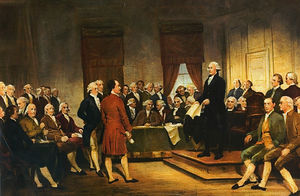
Constitutional Convention
The Framers supported a process that would allow the newly created constitution to change, but also made sure it could not be changed too quickly.
Proposing and Ratifying Amendments
There are two ways to propose amendments: First, states may call for a convention. This has never been used due to fears it would reopen the entire Constitution for revision. The other way is for Congress to pass amendments by a two-thirds majority in both the House and Senate.
There are two additional ways to approve an amendment: One is through ratification by three-fourths of state legislatures. Alternatively, an amendment can be ratified by three-fourths of specially convoked state convention. This process was used during the Prohibition era. Those in favor of ending Prohibition feared that the 21st Amendment (set to repeal the 18th Amendment prohibiting the sale and consumption of alcohol) would be blocked by conservative state legislatures. On December 5, 1933, these so-called “wets” asked for specially called state conventions and ratified repeal. Thus it was proved that a constitutional amendment can be stopped by one-third of either chamber of Congress or one-fourth of state legislatures.
Restrictions to the Amendment Process
The amendment process originally came with restrictions protecting some agreements that the Great Compromise had settled during the Constitutional Convention.
The Great Compromise (also called the Connecticut Compromise) was an agreement that large and small states reached during the Constitutional Convention of 1787. In part, the agreement defined the legislative structure and representation that each state would have under the US Constitution. It called for a bicameral legislature along with proportional representation in the lower house, but required the upper house to be weighted equally between the states.This agreement led to the Three-Fifths Compromise, which meant less populous Southern states were allowed to count three-fifths of all non-free people toward population counts and allocations.
Thus, Article V of the US Constitution, ratified in 1788, prohibited any constitutional amendments before 1808 which would affect the foreign slave trade, the tax on slave trade, or the direct taxation on provisions of the constitution. Also, no amendment may affect the equal representation of states in the Senate without a state’s consent.
2.5.2: Formal Methods of Amending the Constitution
The formal amendment processes are enumerated in Article V of the Constitution.
Learning Objective
Describe the formal procedure for amending the U.S. Constitution
Key Points
- Historically, the House and Senate have had a joint session suggesting the constitution should be amended. This has lead to several “codicils” or amendments that have been added to the body of the constitution.
- State legislatures may also call for conventions to propose these amendments. Scholars speculate that this process was intended to enforce the check-and-balance system.
- Sometimes amendments go through an extra process after they are passed: the states may amend them again after they become law for symbolic reasons.
Key Terms
- Proposal
-
That which is proposed, or propounded for consideration or acceptance; a scheme or design; terms or conditions proposed; offer; as, to make proposals for a treaty of peace; to offer proposals for erecting a building; to make proposals of marriage.
- ratify
-
To give formal consent to; make officially valid.
Formal Methods of Amending the Constitution
The formal processes of amending the constitution are the processes articulated in Article V of the Constitution. These are the Congressional method and the Constitutional Convention methods.
In theory the two houses first adopt a resolution indicating that they deem an amendment necessary. This procedure, however, has never actually been used. The U.S. Senate and the U.S. House of Representatives instead directly proceed to the adoption of a joint resolution; thus, they mutually propose the amendment with the implication that both bodies “deem” the amendment to be “necessary. ” All amendments presented so far have been proposed and implemented as codicils, appended to the main body of the Constitution .
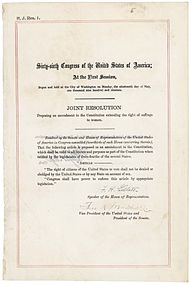
Amendment Proposal
Resolution proposing the nineteenth amendment.
If at least two-thirds of the legislatures of the states make the request, Congress is then required to call a convention for the purpose of proposing amendments. This provision, many scholars argue, allows for a check on the power of the Congress to limit potential constitutional amendments.The state legislatures have, in times past, used their power to apply for a national convention in order to pressure Congress into proposing a desired amendment.
A classic example of this was demonstrated starting in the late 1890s. During that period a movement to amend the Constitution to provide for the direct election of U.S. Senators caused such proposals to regularly pass the House of Representatives only to die in the Senate. As time went by, more and more state legislatures adopted resolutions demanding that a convention be called. In response to this pressure the Senate finally relented and approved what later became the Seventeenth Amendment for fear that such a convention—if permitted to assemble—might stray to include issues above and beyond the direct election of U.S. Senators.
The President has no formal role in the constitutional amendment process. Article One provides that “every order, resolution, or vote, to which the concurrence of the Senate and House of Representatives may be necessary (except on a question of adjournment) shall be presented to the President of the United States; and before the same shall take effect, shall be approved by him, or being disapproved by him, shall be repassed by two thirds of the Senate and House of Representatives. “
As previously stated, the Constitution requires that at least two-thirds of the members present of both the House of Representatives and the Senate the agree to a joint resolution which proposes a constitutional amendment. However, in Hollingsworth v. Virginia (1798), the Supreme Court held that it is not necessary to place constitutional amendments before the President for signature and that, by the same logic, the President is powerless to veto a proposed constitutional amendment.
Ratification
After being officially proposed, a constitutional amendment must then be ratified either by the legislatures of at least three-fourths of the states, or by conventions in the same proportion of states. Of the 27 amendments to the Constitution that have been ratified, Congress has specified the method of ratification through state conventions for only one: the 21st Amendment, which became part of the Constitution in 1933.
Most states hold elections specifically for the purpose of choosing delegates to such conventions. New Mexico state law provides that the members of its legislature be the delegates at such a state ratification convention. It is unclear whether this New Mexico state law violates the United States Constitution.
Although a proposed amendment is effective after three-fourths of the states ratify it, states have, in many instances, ratified an amendment that has already become law, often for symbolic reasons. The states unanimously ratified the Bill of Rights; the Thirteenth Amendment, abolishing slavery; the Fourteenth Amendment, providing for equal protection and due process; the Fifteenth Amendment, prohibiting racial discrimination in voting; and the Nineteenth Amendment, granting women a federal constitutional right to vote. In several cases, the ratification process took over a century.
2.5.3: Informal Methods of Amending the Constitution: Societal Change and Judicial Review
The formal amendment process is one of two major ways to amend the constitution.
Learning Objective
Describe the ways of “informally” amending the Constitution, such as societal change and judicial review.
Key Points
- Sometimes the U.S. constitution changes because society, judges, and lawmakers, reinterpret it over time. This is an informal amendment process.
- Circumstantial changes–such as those that propelled universal male suffrage–cause the constitution to change.
- Judicial review–a somewhat controversial process of having the courts decide if a law is constitutional–is another major informal amendment process. It was established in the case Marbury vs. Madison.
Key Term
- de facto
-
In fact or in practice; in actual use or existence, regardless of official or legal status. (Often opposed to . )
Introduction
The United States Constitution can be changed informally. Informal amendments mean that the Constitution does not specifically list these processes as forms of amending the Constitution, but because of change in society or judicial review changed the rule of law de facto. These methods depend on interpretations of what the constitution says and on interpretive understanding of the underlying intent. This type of change occurs in two major forms: through circumstantial change and through judicial review.
Societal Change
Sometimes society changes, leading to shifts in how constitutional rights are applied. For example, originally only land-holding white males could vote in federal elections. Due to a burgeoning middle class at the peak of the Industrial Revolution in the 1800s, society became focused on expanding rights for the middle and working classes. This led to the right to vote being extended to more and more people. However, formal recognition of the right of poor whites and black males, and later of women, was only fully secured in the Fifteenth Amendment (1870) and the Nineteenth Amendment (1920).
Judicial Review
In the United States, federal and state courts at all levels, both appellate and trial, are able to review and declare the constitutionality of legislation relevant to any case properly within their jurisdiction. This means that they evaluate whether a law is or is not in agreement with the Constitution and its intent. In American legal language, “judicial review” refers primarily to the adjudication of constitutionality of statutes, especially by the Supreme Court of the United States. This is commonly held to have been established by Chief Justice John Marshall in the case of Marbury vs. Madison, which was argued before the Supreme Court in 1803 . A number of other countries whose constitutions provide for such a review of constitutional compatibility of primary legislation have established special constitutional courts with authority to deal with this issue. In these systems, no other courts are competent to question the constitutionality of primary legislation.
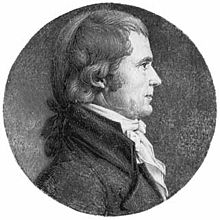
John Marshall
John Marshall established judicial review.
2.5.4: The Twenty-Seven Amendments of the U.S. Constitution
The twenty-seven amendments serve two purposes: to protect the liberties of the people and to change original codes from the constitution.
Learning Objective
Recall the number of amendments to the Constitution and their aims
Key Points
- The 27 Amendments are divided into two parts: the first ten, or, the Bill of Rights, and the final 16, amendments that add to the original constitution.
- The Bill of Rights is a list of natural rights each citizen has and the government is prohibited from infringing upon.
- The last sixteen establish changes to the constitution, such as abolishing slavery, presidential term limits, and payment of representatives.
Key Term
- Bill of Rights
-
The collective name for the first ten amendments to the United States Constitution.
There are 27 amendments to the constitution, the first 10 being the Bill of Rights . The Bill of Rights is the collective name for the first ten amendments to the United States Constitution. These limitations serve to protect the natural rights of liberty and property. They guarantee a number of personal freedoms, limit the government’s power in judicial and other proceedings, and reserve some powers to the states and the public. While originally the amendments applied only to the federal government, most of their provisions have since been held to apply to the states by way of the Fourteenth Amendment.
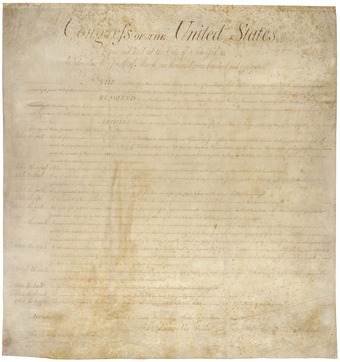
Bill of Rights
The Bill of Rights are the first 10 of 27 amendements to the Constitution, and serve to protect the natural rights of liberty and property.
The other amendments have been added over time, mostly via the processes mentioned in Article V of the Constitution. The 11th secures the right to sue a state. The 12th defines the election of President and Vice President and the fallback system if one should die in office. The 13th abolishes slavery. The 14th specifies the post-Civil War requirements and notes that freed slaves are citizens. The 15th specifically dictates that all races have full rights. The 16th modifies the tax system. The 17th lays out the system for replacement of senators. The 18th banned alcohol. The 19th gives women the right to vote. The 20th patches some basic government functions. The 21st makes the 18th amendment inactive, thereby un-banning alcohol. The 22nd amendment states that no one can be elected President more than 2 terms. The 23rd modifies the Electoral College. The 24th states that no one can be kept from voting because of tax status. The 25th reinforces the replacement system for the President and Vice President. The 26th moves the voting age to 18. The 27th deals with the payment of representatives.
